
* A Distributed Proofreaders Canada eBook *
This eBook is made available at no cost and with very few restrictions. These restrictions apply only if (1) you make a change in the eBook (other than alteration for different display devices), or (2) you are making commercial use of the eBook. If either of these conditions applies, please check with a https://www.fadedpage.com administrator before proceeding. Thousands more FREE eBooks are available at https://www.fadedpage.com.
This work is in the Canadian public domain, but may be under copyright in some countries. If you live outside Canada, check your country's copyright laws. If the book is under copyright in your country, do not download or redistribute this file.
Title: Facts for Everybody
Date of first publication: 1863
Author: Robert Kemp Philp (1819-1882)
Date first posted: June 6, 2020
Date last updated: June 6, 2020
Faded Page eBook #20200608
This eBook was produced by: Iona Vaughan, Ron McBeth, Howard Ross & the online Distributed Proofreaders Canada team at https://www.pgdpcanada.net


FACTS FOR EVERYBODY:
An Encyclopædia of Useful Knowledge.
BY THE EDITORS OF “THE FAMILY FRIEND.”
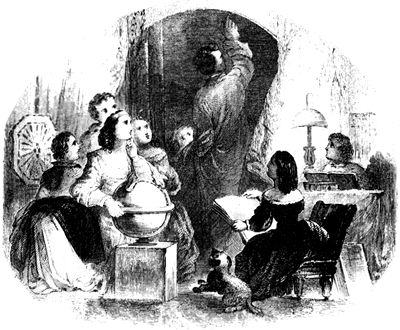
LONDON:
T. NELSON AND SONS, PATERNOSTER ROW;
Edinburgh; and New York.
1863.
“Is it a Fact?” Such is the question we daily ask of matters occurring or suggested. Is it a truth—a reality—a thing of which our senses or intellect can take firm grasp? Is there no delusion about it? Does it stand out clear of all shadows—a point of actual existence—in short, is it a Fact?
The importance of Facts cannot be overrated. Canning once said that he knew nothing so sublime as a Fact. They constitute our universe—our existence. They comprise all that we are, all that we have, and all that we can hope to be.
Knowledge is nothing more than the comprehension of Fact; well, therefore, may it be said that knowledge is power,—for he who knows the most of what is, must be able to make the best use of it. And knowledge is justly said to be “the solace and delight of the human mind;” for the mind was created for it. By knowledge man stands pre-eminently distinguished amidst creation, and to him alone is given the privilege of viewing all the beautiful varieties of nature, and all the works of human ingenuity and art.
But the realms of Fact are vast and limitless, and those things which conduce most to the usefulness and happiness of man’s daily life, are the things which concern him most.
Useful Facts, as they are commonly termed, are, therefore, most properly the demand of the age; and this demand it is the object of the present work to supply. Besides Facts about the Food we Consume, the Clothes we Wear, and the House we Live in, we have herein—
Facts from Arts, Sciences, and Literature: As,—The Liberal and Mechanical Arts—Philosophical and Musical Instruments—Chronological Divisions—Architectural Orders—Months and Days—Poetical and Literary Terms—Telegraphs and Railways—The Stereoscope and Photography—Drawing, Music, and Oil Painting. Our
Facts from Commerce and Manufactures, deal with Metals, Minerals, Woods and Alkalies—Gems and Precious Stones—Colours and Paints—Curious Trees—Silk, Flax and Cotton, Pottery, Glass, and Paper—Bleaching and Dyeing—Gold Ores and Manufactures—Weights and Measures. While our
Facts from Anatomy and Physiology, relate to the Bones, Muscles, Nerves, Arteries, and Blood—The Laws of Health: How to Preserve and How to Restore it—Ventilation and the Sanitary Laws, &c. We also present
Facts from the Garden and the Field:—As, the Culture and Management of the Favorite Flowers, Weeds, Grasses, Vegetables and Agricultural Operations. We have, indeed, gleaned
Facts from all Subjects and for Everybody; Including Etiquette—The Philosophy of Eating, Drinking, and Cooking—Popular Science of Common Things—Laws of Chess, Draughts, Billiards, Whist, Cribbage, and Cricket—Calendar of the Months—Domestic Natural History—Education—Police Regulations—Railway Signals—Signification of known Christian Names—In short, all those things which have the magic power of metamorphosing “bleak houses” into happy homes. And thus we claim for the work universality of scope as well as utility of aim; and present it, with confidence, as comprising in a pre-eminent degree—“Things not generally known; Things that ought to be known; and Things worth knowing;” the whole collated and condensed with most scrupulous anxiety for accuracy as well as originality.
In the treatment of our book, care has been taken to give the plainest and clearest definitions of whatever is described, or set before the reader, so as to be neither tedious in explanation, nor so compressed as not to be intelligible and practically useful.
Abacus, 22
Abattoir, 22
Abbreviations, 23
Ablution, 17
Aborigines, 21
Absolution, 25
Accounts, Method of Keeping, 37
Acorns, Germination of, 17
Acidulated Drops, 126
Acre, 72
Acrostic, 290
Adhesive Composition, 99
Adjective, 234
Adverbs, 235
Agate, or Achat, 326
Air, Change of, 313
Air, Elasticity of, 126
Air-Pump, 160
Alabaster, 340
Albert, Prince, 227
Alcohol, 313
Alder, 317
Ale and Beer Measure, 274
Aliquot Parts, 173
All-hallow Eve, 257
All Saints, 285
All Souls 285
Allspice, 77
Aloes, 160
„ , Wood, 317
Alphabet, 43
„ , Deaf and Dumb, 43
„ , Hebrew, 307
Altimetry, 157
Amazon, 65
Ambulance, 147
Amethyst, 326
Anagram, 128
Anatomy, 52
Anchovy, 203
Animals, Names of the Various Parts in, 66
Animalculæ, 80
Annatto, 322
Annealing, 117
Annunciation Day, 136
Antediluvian, 72
Anthracite, 68
Ants, White, 81
Apartments, to Perfume, 227
Aphorism, 291
Apophthegm, 291
Apothecary, 136
Apothecaries’ Weights and Measures, 136, 274
April, 165
April Fools’ Day, 51
Aquaria, Parlour, 355
Aquarius, 153
Aqueous, 304
Architecture, 52
Ariosto, 197
Arrow-root, 107
Arsenic, to Detect, 23
„ , Antidote for, 31
Artesian Wells, 216
Ascension Day, or Holy Thursday, 196
Ash, 317
Ashlar, 66
Aside, 66
Asp, 71
Aspect, 71
Aspen, 68
Athanasian Creed, 71
Athenæum, 61
Athwart, 52
Attraction, Electrical, 81
August, 226
Auscultation, 87
Auspices, 71
Autographs, to Preserve, 192
Avalanches, 312
Ave Maria, 71
Avoirdupois Weight, 274
Axles, 69
Azote, 62
Azure, 51
Backgammon, 349
Bagatelle, 374
Baking, 85
Balloon, 51
Balm of Gilead, 126
Banana, or Plantain Tree, 200
Bandages, 351
Bandanas, 130
Bank of England, 190
„ Note, 286
Banks, Sir Joseph, 197
Barbers’ Poles, Origin of, 34
Barley, 219
Barometers, Leech, 29
„ , how to Consult them, 21
Baron, 141
Baronetage, 184
Barons of the Exchequer, 194
Barons by Letters Patent, 184
Bassoon, 231
Baths, 127
Battering-Ram, 81
Beads, Glass, 168
Beans, 77
Beaver, 186
„ Hats, 171
Beds, 100
Beef-Eaters, 56
Beer Measure, 274
Bees, 287
„ , Sting of, 30
Beetle, 80
Beetle-Traps, 30
„ Truffle, 190
Beetroot Sugar, 160
Belles Lettres, 291
Beryl, 326
Billiards, 379
Billion, 306
Binding-knots, 16
Birch Tree, 317
Bird Stuffing, 146
Birds, Diseases of, 63
„ , Rapid Flight of, 273
Births, Registration of, 150
Bistre, 323
Bissextile, or Leap-Year, 130
Black, 323
Black Chalk, 323
Blackberry Bramble, 170
Blacklead Pencils, 67
Bleed, How to, 115
Bleeding at the Nose, 38
Blood, 52
„ Stone, 323
Blowpipe, 80
Blue, 319
Blue Stocking, 160
Blue Verditer, 320
Bodies, Regular, 46
Boiling, 82
Bomb Ketches, 42
Bomb Vessels, 42
Bonaparte, Napoleon, 227
Books, to Preserve, 125
Boots and Shoes, Waterproofing, 33
Bottles, to Extract Corks from, 103
Bouquets, 162
Bouts-Rimes, 56
Boxwood, 315
Brass Coins, 275
Brazil Wood, 315
Bread, Etymology of Word, 188
„ , Assize of, 167
Bread-Fruit Tree, 130
Breath, to Sweeten, 80
Bride Cake, 193
Brig, 42
Brigantine, 42
Britain, 151
Broiling, 84
Bronzing, 261
Bruises, and their Treatment, 34
Budding, 169
Bulbous Roots, 193
Bullfinch, the, 269
Burning, to Protect Children from, 41
Burns and Scalds, 41
Butter, 277
Butter, to Cure, 146
Buttercups and Daisies, 122
Butterfly, 85
Cage Birds, 63
Cake, Bride, 193
Calisthenic Exercises, 57
Cameleopard, 100
Camera Obscura, 22
Camomile, 161
Canaries, 94
Candles, Economy in, 91
„ , How to Make Good, 251
Candlemas Day, 105
Cannon, 65
Capillaire, 116
Capacity, Measures of, 276
Carbon, 202
Cardinal, 74
„ Points, 74
„ Virtues, 56
Cards, 56
Carmine, 320
Carnelian, 327
Carols, 287
Carpets, Management of, 79
Carving, 270
Casks, to Sweeten, 47
Catherine Wheel, 47
Cats’ Whiskers, Use of, 159
Cedar of Lebanon, 316
Celery, 143
Cements, Manufacture and Use of, 131
Centre of Gravity, 55
Ceres, 141
Chains, 161
Chalcedony, 327
Chameleon, 61
Champagne, 160
Charade, 128
Charcoal, 202
Charles I., 75
Chaplain, 56
Cheese, 277
Chemical Transmutations, 141
Cherries, 131
Chesnut Tree, 317
Chess, 179
Chicory, 129
Chimneys, Smoky, 366
China and Earthenware, to Clean, 74
China, Dresden, 123
China or Glass, to pack, 253
Chiromancy, 117
Chlorine, 203
Chocolate, 102
Christian Names, 187
Christmas Customs, 287
„ Day, 287
Christian Names, Signification of, 308
Chromatype, 365
Churching, 131
Churches and Chapels in England, 168
Chrysididæ, 216
Chrysolite, 325
Cinque Ports, 56
Cinnabar, 319
Clarion, 231
Clarionet, 231
Classes of Flowers, 188
Climate, 130
„ of England, 24
Clocks and Watches, 290
Cloth Measure, 274
Clothes, to Brush, 245
Clouds, 130
Clove Tree, 100
Cloves, Syrup of, 116
Clove-hitch Knot, 16
Coach Accidents, 41
Coal, 60
Coat, to Fold for Packing, 245
Coats of Arms, 155
Cochineal, 320
Cockatoos, 148
Cockroaches, to Destroy, 30
Cocoa, 102
Cocoa-nut Tree, 156
Cod Liver Oil, 38
Coffee, 102
„ , French Method of Preparing, 102
„ , Milk, 102
„ , Syrup of, 116
„ , To Make with Hot Water, 102
Coin, Gold and Silver, 305
Coins, to take Impressions from, 192
Cold Cream, 124
Colossus of Rhodes, 67
Colours and Paints, 319
Columbus, 196
Complexion, to Improve, 80
Copper Plate Printing, 246
Composite Order, 123
Conchology, 140
Condiments, 146
Cone, 92
Conjunction, 236
Consanguinity, 128
Conversation and Writing, Modes of Address in, 184
Convex Lens, 93
Cookery, Rudiments of, 81
Cooking in a House, to remove the Smell of, 72
Copernicus, 76
Coral, 99
Corinthian Order, 134
Cork, 181
Corns, Cure for, 74
Cornet à Piston, 231
Corundum, 326
Corrosive Sublimate, 32
Cosmetics, 124
Court Plaister, to Make, 259
Crescent, 163
Crests, 131
Cribbage, 372
Cricket, Laws of, 227
Cromwell, Oliver, 166
Crucifixes, 287
Cruth, 232
Cryophorus, 38
Crystal, 324
Cubic Measure, 274
Cuckoo, 314
Cucumbers, 131
Cups in Pies, 33
Cutter, 42
Cymbal, or Cymbalum, 282
Dahlia, Cultivation of the, 236
Daisies and Buttercups, 122
Damp Walls, 53
Dandelion, 35
Dante, 256
Day, Division of the, into Hours, 65
Days, Difference of, 177
Days of the Week, Roman names of, 351
Deaf, Axioms for the, 73
Deaf and Dumb Alphabet, 43
Death Watch, 33
Death’s-Head Hawk-Moth, 194
Decanters, Cleaning, 22
Decanting Liquids, 181
December, 45
Deck, 167
Diadelphia, 140
Diamonds, 32
Diamond Beetle, 164
Diana, 164
Diaphanie, 261
Dilettanti, 164
Disinfecting Liquid, 290
Dissolving Views, 242
Distilled Waters, 131
Distillation, 175
Dividing, Powdering, and Grinding, 50
Diving Bell, 163
Dog Days, 106
Dogs, Distemper in, 219
Domesday Book, 112
Door Mats, 34
Doric, 100
Draughts, 359
Drawing, Practical Lessons in, 292
Dresden China, 123
Dress, On Proper Taste in, 369
Dresses, to Preserve the Colours of, 253
Dromedary, 104
Drowning and Suffocation, 27
„ , Prevention of, 27
Drum, 232
Dun, 67
Dulcimer, 232
Dry Measure, 274
Dyeing, Art of, 54
Eagle, 284
Early Rising, 143
Earthenware and China, to Clean, 74
Earrings, 123
Earthquakes, 312
East India Company, 112
Easter Sunday, 165
Ebony, 315
Eclipses and Moons, 211
Eclogue, 290
Eggs, Ornamental, to make, 33
Eggs, to Preserve, 125
Egg Shells, Etching upon, 24
Egyptian Architecture, 101
Elder Flowers, 124
Electric Telegraph, 18
Electricity, 176
„ and Magnetism, 151
Electrotyping, 310
Election Ribbons, 155
Elgin Marbles, 154
Elm, 317
Elm destroying Scolytus, 166
Emblem, 290
Emerald, 325
Emery, 181
Enamels, 66
England, Climate of, 24
Enigma, 128
Epic Poem, 291
Epigram, 290
Epilogue, 291
Epitaph, 290
Epitome, 291
Epode, 291
Esquire, 185
Essence of Flowers, to Extract, 188
Et, 287
Etching upon Ivory, 24
„ Egg Shells, 24
„ Glass, 30
Evaporating Dishes, to Make, 156
Excelsior, 219
Exercises, Indoor, 24
Eye, Substances in the, 25
Eyes, Preservation of the, 282
Faith, 257
Falcon, 170
Farthing, 130
Feathers, to Dye Blue, 260
February, 105
Feet, to remove the Offensive Smell of, 220
Ferguson, James, 286
Ferns, 216
Fife, or Fiffars, 231
Fig tree, 187
Figs, 359
Filberts, 359
Filtering Liquids, 181
Filters, 22
Fir, 318
Fire, Precautions in, 25
Fire Ships, 42
Fires, how to Light them, 60
Fish Ponds, 34
Fish, to Carve, 270
Flannel Shirts, 161
Flea, 366
Flint, or Silex, 340
Flower, the, 258
Flowers, Classes of, 188
„ , Language of, 280
„ , Essence of, to Extract, 188
Flute, 232
Flying Fish, 167
Food in Season, 35
„ Nutritious, 273
Forces, the Resolution of, 157
Fountain Cheap, How to Make, 131
Fowls, How to Keep, 311
Fox and Geese, Game of, 260
Frankincense, 161
Freckles, to Remove, 101
French Horn, 231
Freestone or Sandstone, 340
Frieze, 314
Frigate, 42
Frog, 100
Frost and Snow, 114
Fruit, Best time for Eating, 38
„ , Syrups of, 116
„ , Digestive properties of, 137
„ to Pack for Carriage, 261
Frying, 84
Funnel, to make a, 157
Fur Clothing, 158
Furniture Polish, 254
Fustic, 322
Gall Nuts, 273
Galvanic Battery, 115
„ Coil, 53
Galvanism, 213
Gamboge, 322
Garnet, 326
Gas, 47
„ , Economy of, for Domestic Purposes, 191
Gasometer, 171
Gelatine, 134
Gems and Precious Stones, 324
Gendarmerie, 127
Gentleman, 186
Gipsies, 155
Glaciers, 155
Glass, 307
„ Ware, to Clean, 254
„ to Join, 260
„ or China, to Pack, 253
„ Etching upon, 30
„ Cracking by Hot Water, to Prevent, 168
„ Painting, Transparent, for Windows, 207
„ for using ordinary Engravings on, 263
Glowworm, 155
Glue, Rice, 261
„ , Common, 133
„ , Marine, 133
„ , Liquid, 133
„ , Mouth, 132
„ , to Resist Moisture, 129
Gnats, 31
Gobelin Tapestry, 129
Gold Coins, 275
Gold Wire Leaf, 161
Goldfinch, 109
Gold Fish, 113
Gordian Knot, 151
Grate Papers, Ornamental, to make, 263
Granite, 339
Grasshopper, 170
Gravity, Centre of, 55
Greenwich Observatory, 157
Guaiacum, 316
Guitar, 232
Guillotine, 126
Gum Arabic, 193
Gums and Loose Teeth, to Strengthen and Fasten, 77
Gun Barrels, to Brown, 192
„ , Varnish for, 192
Gunpowder Plot, 285
Gunnery, 171
Gutta-Percha Soles, 36
Haberdashers, 140
Hackney Coaches, 159
Hair Oil, 124
„ , Pomatum for the, 124
„ , Dyeing the, 124
„ , Black, to Dye, 125
„ , Brushes, to Wash, 129
„ , Structure of the, 278
„ , Management of the, 280
Hand, 104
Handel, George Frederick, 166
Handkerchief, to Perfume, 47
Hare, to Carve, 273
Harmonium, 230
Harp, 230
Harpsichord, 230
Harrow, 104
Harvey, William, 166
Hautboy, 232
Hay Measure, 274
Headache, Cure for, 61
Heat and Cold, 54
Hebrew Alphabet, 307
Heraldry, 67
Hermetic Sealing, 154
Herschel, Sir William, 227
Hidage, 159
Hieroglyphics, 354
Hives, Cottage, 24
„ , Fumigating, 24
Holy Thursday, 196
Holly, 318
Holyrood, Origin of, 146
Hone, 341
Honeymoon, 113
Honey Soap, 209
Horse, 306
Horse Power, 160
Hosiery, 143
Hotchpot, 114
Hotte, 224
Houses, Transposition of, 141
Hour Glass, 147
Hoy, 42
Hulks, 42
Hunter, John, 226
Hurricanes, 198
Hyacinth, 327
Hydrogen, 202
„ Gas, 224
Hygrometers, 29
Icebergs, 307
Impressions, to Copy, 81
Inclined Plane, 186
Indian-Ink, 251
„ Rubber, 324
Indigo, 113
Ink, Black, 125
„ , Blue, 125
„ , Green, 125
„ , Marking, 125
„ , Sympathetic, 88
„ , Invisible, 304
Inorganic, 305
Insect’s Wings, 159
„ , to Prepare for Cabinets, 116
Interest, 116
Interjection, 236
Iodine, 203
Ionic Order, 111
Isinglass, 169
Ivory, 323
„ , Black, 323
Ivory Etching upon, 24
Lac, 321
Lace, to Wash, 245
Lake or Lacca, 321
Lammas Day, 227
Lamp-Black, 323
„ , to Prevent the Smoking, 131
Land and Sea Breezes, 198
Larch Tree, 318
Laudanum, Antidote for, 31
Laurel, 287
Lavender Water, 221
Leaden Cisterns, to Neutralize the Effects of, 103
Leather, Morocco, 177
Leaves, Functions of, 222
Leech Barometers, 29
Leeches, to make Bite, 113
Lemon, 103
Length, Measures of, 276
Letters, 46
Leyden Jar, 106
Libra, or the Balance, 114
Light, 161
Light House, 187
Lightning Stroke, 23
„ Conductors, 23
Lip Salve, 197
Liquids, Decanting, Straining, and Filtering of, 181
Literary Terms, 290
Lithographic Stones, to Pack, 259
Liveries, 167
Logwood, 315
Long Measure, 274
„ Sight, 104
Lords, Spiritual and Temporal, 169
Lories, 149
Lotteries, 71
Lunar Month, 275
Luther, Martin, 286
Macaws, 148
Madder, 320
Madrigal, 291
Magic Lantern, 104
„ and Dissolving Views, 242
Magnetic Needle, 114
Magna Charta, 197
Magnitude, 365
Mahogany, 316
Mahogany, Artificial, 263
Mamalukes, 238
Mammalia, 177
Man-of-War, 42
Marble, 339
Marble Appearance to Plaster Figures, 100
Marbles, 114
March, 135
Masks, 163
Mast, 211
Massicot, 319
Matter, Divisibility of, 162
May, 195
May-Day Festivities, 195
Measures of Length, Roman, 276
„ Capacity, 276
Medallion Wafers, 151
Medicine, the Nauseous Taste of, Prevented, 51
Medicines, Aperient, 355
Meerschaum, 79
Mensuration, 190
Merchant Ships, 42
Mercury, 101
Metallic Trees, 35
„ Pens, to Prevent Ink Damaging, 210
Michaelmas Day, 256
Micrometer, 158
Microscope, 92
Microscope Glasses, to Clean, 354
Milk, 277
„ of Roses, 124
„ , to Prevent Turning Sour, 103
Mill Stones, 340
Milton, John, 286
Miniatures, to Prepare Ivory for, 160
Mistletoe, 72
Mists, 123
Mite, 216
Mitre, 200
Mnemonics, 219
Models, 189
Mohair, 142
Mole, 314
Monkey, 314
Monsoons, 198
Moon and Eclipses, 211
Month, 192
Morocco Leather, 177
Moss, Formation of, 145
Moth, 221
Mother-of-Pearl, 181
Mule, 284
Muses, the Nine, 140
Mushrooms, to Distinguish from Poisonous Fungi, 49
Music, an easy Method of Teaching the Rudiments of, 246
Musical Instruments, 229
„ to Stain, 265
Muslin, Painting upon, 262
„ in Water-Colours, 262
Musk, 142
Nails, Care of the, 85
Names, Christian, 187
Napkins, How to Fold, 173
National Debt, 305
Naval Officers, 48
„ Terms, 48
Necks, Support for Stiff, 25
„ , Swelling in the, 25
Neptune, 187
Net making, 284
Newspapers, 287
New Year’s Day, 75
Nile, Source of the, 128
Nitrogen, 202
Nose, Bleeding at the, 38
Noun, 234
November, 285
Numerals, 310
Nursery Pictures, to Preserve, 365
Nutmeg, 92
Nutritious Food, 273
Oatmeal, 142
Ochre, 323
Octahedron, 216
October, 256
Ode, 290
Oil Cloths, to Preserve, 103
Oil Paintings, to Clean, 26
Oleaginous, 304
Onyx, 327
Opal, 327
Optical Effects, 127
„ Illusion, 134
Orange Tree, 93
Organ, 229
„ , Mechanism of an, 204
Ornamental Eggs, 33
Osier, or Willow, 318
Ottoman Empire, the, 151
Ourang Outang, 254
Oxygen, 202
Oyster Grottoes, 117
Paint, to Remove Smell of, 47
„ , to Mix, 274
„ , White House, to make, 266
Paints and Colours, 319
Painting, Oil, 344
„ on Velvet, 143
Paintings, Oil, to Clean, 26
Palm Sunday, 165
Palms, 164
Pan, 284
Paper, 359
Paper Hangings, 189
„ , to Clean, 259
Paper Table, 275
„ , Transparent, 187
Paper into Parchment, How to Make, 314
Papier Maché, 314
Papyrus, 251
Parachute, 134
Parakeets, 149
Parcels in Paper, to Tie up, 16
Parrots, 148
Parts of Speech, 234
Passion Flower, 159
Passing Bell, 189
„ , Permanent, 132
Pastilles, 36
Pawnbrokers’ Signs, 286
Pea, the, 163
Pearl, 328
Peers, Spiritual, 186
Pencil Marks, to Preserve, 209
Pendulum, 169
Pens, Metallic, 177
Pepper, 126
Phonography, 354
Phosphorus, 203
Photography, 303
Pianoforte, 230
Pies, Cups in, 33
Pigeon Houses, 31
„ Law, 158
Pimples, 103
Pinchbeck, 355
Pindaric, 291
Pine, 318
Pin Money, 66
Plants, Nourishment of, 152
„ , Water for, 251
„ in Cultivation for the Use of Man and Cattle, 336
Plaster Casts, 34
Plate Glass, Discovery of, 307
Plated Ware, 146
Pliers, 254
Pluto, 104
Pneumatic Apparatus, 194
Poetical and Literary Terms, 290
Poisons, Accidents from, 31
Poisonous Vegetables, 31
Police, 378
Polished Iron, to Preserve, 253
Polypi, 93
Pomade for Baldness, 124
Pomatum, White, 124
„ , Colouring and Scenting, 125
Pope’s Hat, 106
Poplar, 317
Porcelain, 65
„ or Glass Ware, to Clean, 254
Pores of the Human Body, 305
Porphyry, 339
Post Office Rates, 39
Postage, Penny, 47
Potatoes, Mealy and Waxy, 181
Potichomanie, 86
Poultice, Bread-and-Water, 49
Poultry, to Carve, 271
Pound Sterling, 155
Pounds, Shillings, and Pence, 65
Practical Science, 156
Preposition, 235
Preserves, Covering for, 251
Prints, to transfer to Wood, 154
Prism, 221
Profiles in Black, Method of Taking, 283
Prologue, 291
Pronoun, 235
Proteinaceous, 305
Pulleys, 68
Pumice Stone, 341
Pump, 76
Punctuation, 76
Puzzle, 128
Pyramids, 374
Rabbits, 341
„ , to Carve, 271
Radiated Animals, 115
Railway Signals, 88
Rain, 67
„ Water, 163
Rainbow, 217
Raleigh, Sir Walter, 257
Reading Aloud, 140
Rebus, 128
Red, 320
„ Chalk, 321
„ Lead, 319
„ Sealing Wax, to Make, 111
Reef Knots, 15
Respiration, 73
„ , Agents which Increase, 115
Restoration Day, 196
Retort, 216
Reynolds, Sir Joshua, 226
Rice-Paper, to Model in, 146
Riddle, 128
Rigging, 212
Ring Fast on the Finger, 365
Roasting, 83
Rocks, Transition of, 284
Rogation Sunday, 195
Rolling Blinds, 351
Roman Money, Weights, and Measures, 275
Room Papers, to Clean, 259
Roots, 199
„ , Bulbous, 193
Rose of Wood Shavings, to Make, 311
„ Pink, or Rose Lake, 321
Roses, Propagation of, 212
„ , to Restore Faded, 254
Rotten Stone, 111
Royal Mottos, 128
Rubens, Paul, 197
Ruby, 325
Ruddle, or Blood Stone, 323
Sabbath, 77
Saccharine, 305
Sackbut, 233
Safety Lamp, 17
Saffron, 322
Sago, 108
Salamander, 254
Salt Water, to Make Fresh, 28
Sandal Wood, 316
Sap, the, 252
Sapphire, 326
Saturn, 76
Saucepans, Danger from Copper, 85
Savings’ Banks, 167
Scalds and Burns, 41
Scurf Skin on Face, 124
Scent Jar, 151
Scratching out Ink Marks, 365
Scripture, Tables of Weights and Measures mentioned in, 276
Scrubbing Floors, 73
Sealing Wax, Red, 111
Seasons, the, 210
Sea Water, to Make Fit for Washing Linen, 28
„ , to Make Artificial, 28
Sedan Chairs, 169
Seed, 258
September, 255
Serpent, 231
Serpentine, 339
Seven Wonders, the, 211
Shakspeare, William, 166
Shamrock, how it came to be the National Emblem of Ireland, 33
Shaving Soap, 263
Shells, to Polish, 253
Shilling, 142
Ships, Description of, 42
Shirts, to Fold, 284
Shoes, 365
Shop Tickets, Composition for, 131
Shorthand, 307
Shrove Tuesday, 106
Shuttle, 261
Sick-rooms, to Fumigate, 54
Silk, to Keep, 238
Silkworms and their Products, 239
Silkworms’ Eggs, 129
Silver Coins, 275
Silver Spoons, 365
Simple Bodies, 202
Skin, Olive, to Dye, 124
„ , to Clear a Tanned, 124
„ , Dark Colour of the, 188
Skylark, the, 177
Slate, 340
Sloop, or Shallop, 42
Smacks, 42
Smalt, 320
Snails, 188
Snakes, Bites of, 41
Snow and Frost, 114
Snuff-taking, 147
Soap Bubble, 193
„ , Shaving, 263
Sore Throats, 61
Sound, 93
South Sea Bubble, 74
Spanish Black, 323
„ Brown, 323
Spasms, 131
Spinnet, 230
Spirit Lamp, 156
Squadron, 43
Stains (To Remove From the Hands), 263
Stammering (Cure for), 146
Steam Navigation, 304
Steam-Engine, 166
Steel (To Preserve from Rust), 92
Steel-Yard, 254
Stems, 221
Stereoscope (The), 375
Stereotyping, 153
Sticking-Plaster, 254
Still, 56
Sting of Bees, 30
Stones, 339
Storm Glasses, 36
Stroke of Lightning, 23
Sub-Rosa, 172
Sumac, 322
Summer, 200
Sunbeams, 158
Sun-Dials, 29
Sunflower, 65
Sun-stroke (Protection Against), 25
Swimming (Safe and Easy Method of), 28
Swimming-Belts, 38
Symbol, 200
Syrups, 116
Tamarinds, 163
Tambourine, 232
Tape-Worms, 305
Tapioca, 108
Tea (Tea Cream), 102
Tea-Plant, 101
Teasel, 171
Teeth (To Make Them White), 80
Telescope, 62
Tetrahedron, 166
Thermometer, 54
Thermometers for Comparison, 147
Thimbles, 159
Thirst, 143
Thorns (How to Extract), 29
Tides (The), 201
Timber Trees, 317
Time, 62
Tivoli, or Chinese Billiards, 265
Toast and Water, 188
Toothache, 142
Topaz, 325
Tortoise, 261
Tortoiseshell (To Mend), 266
Tracing-Paper, 151
Trance, 187
Transfer Paper (To Make), 266
Transparent Paper, 187
Transplanter (The), 153
Triandria, 221
Triangle (musical instrument), 232
Triangle, 190
Truffle Beetle, 190
Trumpet, 230
Trustee, 284
Tulip (Cultivation of the), 266
Turmeric, 321
Turnpikes, 151
Turpentine, 142
Tuscan, 74
Tying up of Parcels in Paper, 16
Walking, 177
Wallflower, or Gilliflower, 117
Walnut, 317
Warts, 87
Watch, 191
Water (To Determine whether Hard or Soft), 28
Water, 189
Water Gleanings, 28
Water Louse, 251
Waterproofing Boots and Shoes, 33
Water-Wheel (Overshot), 74
Water-Wheel (Undershot), 224
Wax and Wafers, 193
Waxen Flowers and Fruit, 329
Wedding Ring, 161
Wedding Rings (Origin of), 142
Wedding-Ring Finger, 169
Wedge, 26
Weeds (Utility of), 365
Weights and Measures, 274
Weld, 322
Whey, 221
Whist, 361
White House-Paint (To Make Economical), 266
White Lead, 319
Wills, 46
Windlass, 73
Windmill, 194
Windows (To Paint to Resemble Stained Glass), 172
Winds, 197
Wine (How to Choose), 188
Winter, 200
Woad, 319
Wood (To Give a Fine Black Colour to), 253
Woods (Fine, etc.), 315
Writing, 224
Writing and Conversation (Modes of Address in), 184
KNOTS. The most simple purpose for which a knot is required, is the fastening together of two pieces of string or cord: the knot selected for this purpose should possess two important properties;—it should be secure from slipping, and of small size. Nothing is more common than to see two cords attached together in a manner similar to that shown in Fig. 1. It is scarcely possible to imagine a worse knot; it is large and clumsy, and as the cords do not mutually press each other, it is certain to slip if pulled with any great force.
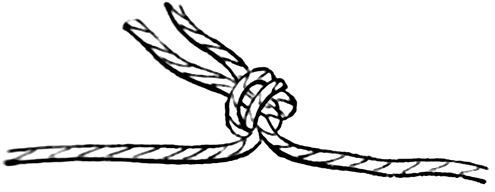
Fig. 1.
In striking contrast to this—the worst of all, we place one of the best; namely, the knot usually employed by netters, and which is called by sailors “the sheet-bend.” It is readily made by bending one of the pieces of cord into a loop (a b, Fig. 2),

Fig. 2.
which is to be held between the finger and thumb of the left hand; the other cord c is passed through the loop from the farther side, then round behind the two legs of the loop, and lastly, under itself, the loose end coming out at d. In the smallness of its size, and the firmness with which the various parts grip together, this knot surpasses every other: it can, moreover, be tied readily when one of the pieces, viz., a b, is exceedingly short, in common stout twine less than an inch being sufficient to form the loop. Of the knot, Fig. 2 is the simplest method to describe, although not the most rapid in practice; as it may be made in much less time by crossing the two ends of cord (a b, Fig. 3) on the tip of the forefinger of the left hand, and holding them firmly by the left thumb, which covers the crossing; then the part c is to be wound round the thumb in a loop, as shown in the figure, and passed between the two ends, behind a and before b; the knot is completed by turning the end b downwards in front of d, passing it through the loop, securing it under the left thumb, and tightening the whole by pulling d. As formed in this mode, it is more rapidly made than almost any other knot; and, as before stated, it excels all in security and compactness, so firmly do the various turns grip each other, that after having been tightly pulled, it is very difficult to untie.
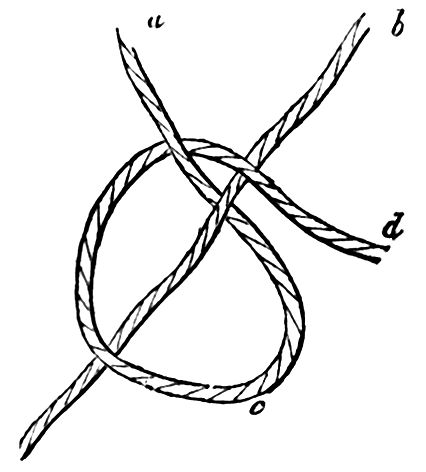
Fig. 3.
Reef-Knots. The only precaution necessary in making a reef-knot is, to observe that the two parts of each string are on the same side of the loop; if they are not, the ends (and the bows, if any are formed) are at right angles to the cords; the knot is less secure, and is termed by sailors a granny-knot. Other knots are occasionally used to connect two cords, but it is unnecessary here to describe them, as every useful purpose may be answered by those already mentioned.

Fig. 4.
The Binding-Knots (Figs. 5 and 6) are exceedingly useful in connecting broken sticks, rods, &c., but some difficulty is often experienced in fastening it at the finish; if, however, the string is placed over the part to be united, as shown in Fig. 5, and the long end b, used to bind around the rod, and finally passed through the loop a, as shown in Fig. 6, it is readily secured by pulling d, when the loop is drawn in, and fastens the end of the cord.
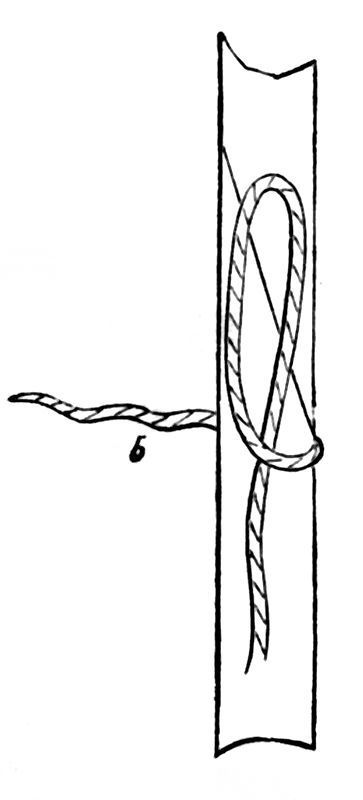
Fig. 5.
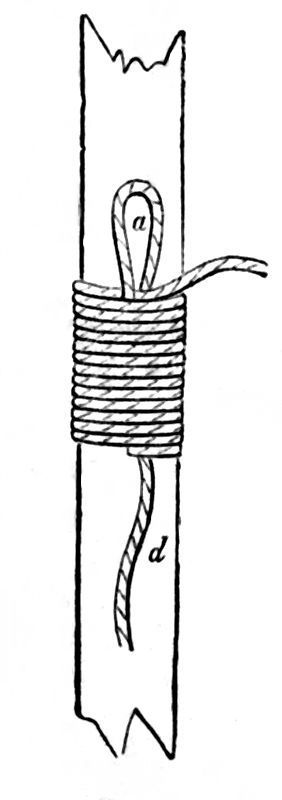
Fig. 6.
The Clove-Hitch Knot. For fastening a cord to any cylindrical object, one of the most useful knots is the clove hitch, which although exceedingly simple and most easily made, is one of the most puzzling knots to the uninitiated. There are several modes of forming it, the most simple being perhaps as follows:—make two loops, precisely similar in every respect as a and b, Fig. 7, then bring b in front of a, so as to make both loops correspond, and pass them over the object to be tied, tightening the ends; if this is properly done, the knot will not slip, although surrounding a tolerably smooth cylindrical object, as a pillar, pole, &c.
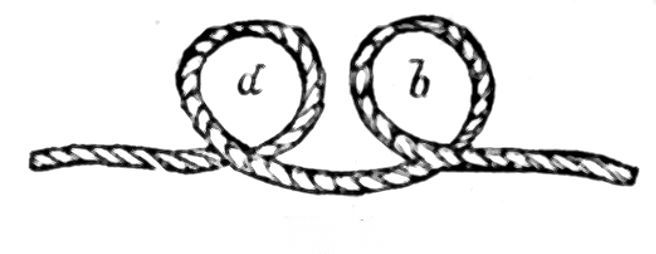
Fig. 7.
This knot is employed by surgeons in reducing dislocations of the last joint of the thumb, and by sailors in great part of the standing rigging. The loop which is formed when a cable is passed around a post or tree to secure a vessel near shore, is fastened by what sailors term two half hitches, which is simply a clove hitch made by the end of the rope which is passed around the post or tree, and then made to describe the clove hitch around that part of itself which is tightly strained.
The Tying Up of Parcels in Paper is an operation which is seldom neatly performed by persons whose occupations have not given them great facilities for constant practice. Whether the paper be wrapped round the objects, as is the case usually when it is much larger than sufficient to enclose them, or merely folded over itself, as is done by druggists, who cut the paper to the required size, it is important that the breadth of the paper should be no longer than sufficient to enable it to be folded over the ends of the object enclosed, without passing over the opposite side. It is impossible to make a neat or close parcel with paper which is too broad; excess in length can be readily disposed of by wrapping it round; the excess of breadth should be cut away. With regard to turning in the ends, the mode adopted by grocers is the best. The most common cause of failure in parcels is their being badly corded. We will therefore (however unnecessary the description of so simple a performance may appear to those already acquainted with it), describe the most readily acquired mode of cording.
Let a single knot be made in the end of the cord, which is then passed round the box or parcel. This knotted end is now tied by a single hitch round the middle of the cord (Fig. 8) and the whole pulled tight. The cord itself is then carried at right angles round the end of the parcel, and where it crosses the transverse cord on the bottom of the box (Fig. 9), it should (if the parcel is heavy and requires to be firmly secured) be passed over the cross cord, then back underneath it, and pulled tightly, then over itself; lastly, under the cross cord, and on around the other end of the box.
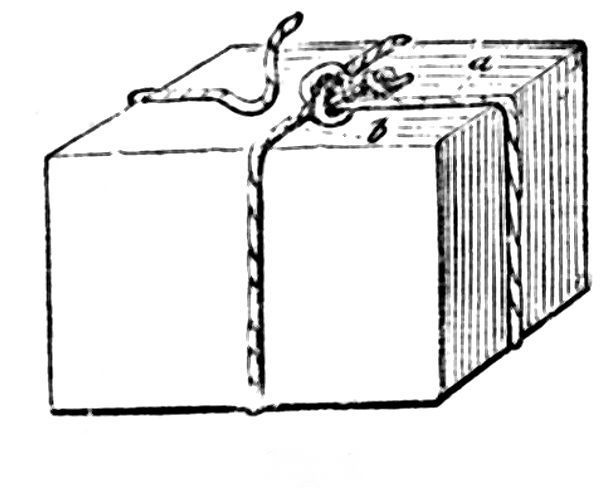
Fig. 8.
When it reaches the top it must be secured by passing it under that part of the cord which runs lengthways (a, Fig. 8) pulling it very tight, and fastening it by two half hitches round itself. The great cause of parcels becoming loose is the fact of the cord being often fastened to one of the transverse parts, (as b, Fig. 8) instead of the piece running lengthways, and in this case it invariably becomes loose.
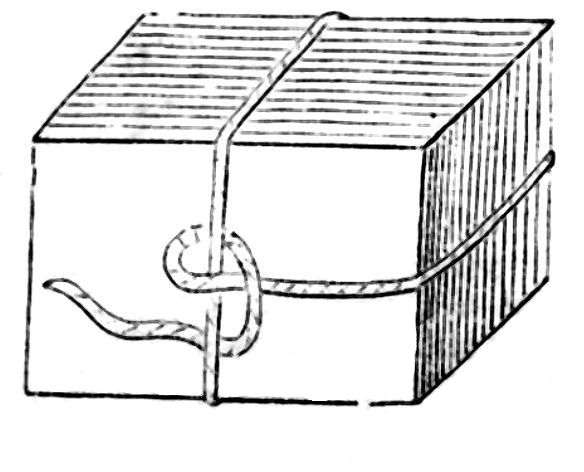
Fig. 9.
The description may perhaps be rendered clearer by the aid of the figures, which exhibit the top and bottom of a box corded as described. The cords, however, are shown in a loose state to allow their arrangements to be perceived more easily.
GERMINATION OF ACORNS. Take a hyacinth glass, or a broad-mouthed bottle, and fill it about-one-third with water. Cut a piece of stiff cardboard, or tin, to fit closely the opening of the glass or bottle, and from the centre thereof suspend an acorn by a piece of thread just long enough to let the acorn descend nearly to the water. It will be advantageous to drop the acorn until it touches the water, and then to draw it up very gently as far as may be done without overcoming the attraction which holds the water to the base of the acorn.
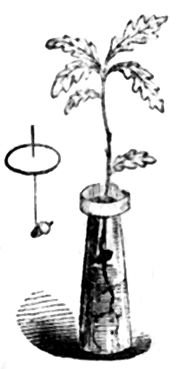
Keep it now on the mantel-piece over the fire, and in a few weeks the germ will burst the shell, and a little root will appear and descend to the water, where it will become more fully developed. Steep the acorn in water a day before suspending it. Soon afterwards, another germ will be seen to strike upwards until it reaches the covering of the glass, where a contrivance may easily be made for its escape, still keeping the acorn in the same relative position. And thus a sapling oak may be produced—a curiosity for the parlour.
THE SAFETY LAMP was invented by Sir Humphrey Davy, and was constructed so as to burn without any danger in an explosive atmosphere. It is merely a common oil-lamp, the frame of which is enclosed in a cylindrical cage of wire gauze, sometimes made double at the upper part where the hottest portion of the gas collects, and containing about 400 apertures to the square inch. The wick is trimmed by means of a bent wire, passing tightly through the body of the lamp, so that when the lamp has been supplied with oil, the wick may be kept burning for any length of time without unscrewing the cage.

When this lamp is immersed in an explosive mixture of marsh-gas or coal-gas and common air, the gauze cylinder becomes filled with a blue flame, arising from the combustion of the gas within; but the flame does not communicate to the outside, even though the gauze may be heated to less redness.
ABLUTION, or a Washing Away—a religious ceremony, which has been practised more or less by the followers of all creeds. The Mohammedans and Brahmins are very strict in their ablutions; and they occupy an important rank amongst other religions of India. The Ganges is considered by the natives as possessing a power of purification so great even, that if a votary cannot reach that river, and who calls upon it while bathing in another to cleanse him, he will be freed from all his sins.
ELECTRIC TELEGRAPH. In the description of the electric telegraph, we will lay aside all technical and scientific terms, and explain clearly this greatest wonder of our day. The source of the electricity used requires our first attention. This is what is called a voltaic, or galvanic battery; and it is so called from Volta and Galvani, its originators. We can make a very simple battery by means of two tumblers, a little salt and water, two small pieces of zinc, and two of copper, united in the following manner:—A and B are the tumblers, c c the pieces of copper, z z the pieces of zinc; the tumblers being partly filled with the salt and water, the battery is complete.
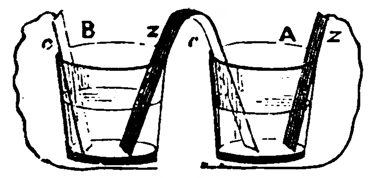
Fig. 1.
It may be observed that the metals used are dissimilar; that a plate of copper and one of zinc unite at e, and that there are wires fixed to the other two plates, which as yet are in no way connected. Whilst things are in this state, nothing will take place; the battery is at rest, and no electricity is evolved by it; but if we join the two wires, a current of electricity will immediately pass, and this current will continue till we again separate the wires. If two plates of metal are placed in a solution which will only dissolve one of them, and their upper edges are brought into contact, whilst the others are kept apart, a current will pass from one to the other through the solution, and, passing also from one to the other at the point of contact, will continue thus circulating, till either the soluble matter is consumed, or the liquid itself is saturated—that is, has dissolved as much metal as it is capable of dissolving. This is always the case; but often the effect is so slight, that it is rarely perceptible. Take a piece of silver, and a piece of zinc the size of a half-crown; place one upon the tip of the tongue, the other under it; bring their edges into contact, and what is called a shock will be perceptible; that is, the saliva acting upon the zinc and not upon the silver, a small battery is made, and the electricity passes from the zinc through the tongue to the silver, thence to the zinc again, and thus circulates till you part the edges of the metals. The shock is very slight, being chiefly known by an acid taste; nor would it be felt at all, but that the tongue is so acutely sensitive. We have called this a small battery, but it is scarcely a correct term; it is a single voltaic pair—a battery, in its proper sense, being made up by a union of two or more such pairs, as in the case of the one above. In practice, a battery consists of twelve or more such pairs; and the following sketch represents one commonly used in working the electric telegraph:—

Fig. 2.
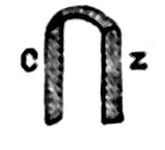
Fig. 3.
It contains twenty-four pairs of zinc and copper plates, about four inches square. Each pair are soldered together by means of a strap of metal, as in Fig. 3. To make it quite clear, we have drawn but twelve pairs in section, and lettered the alternate plates, z standing for zinc, and c for copper. The trough in which they are placed is either made of baked wood, glass, earthenware, or gutta percha; the only requisite being that it is a non-conductor of electricity—that is, such a substance as electricity will not readily pass through. The last plate at one end is zinc, and the other copper, and a wire is soldered to each. If these wires are joined, a current of electricity will pass from the zinc plate to which one is attached, through the exciting liquid, which is here sulphuric acid and water, to the copper plate in the same cell, thence by the metal strap to the zinc of the next cell, and thus through the whole series to the other single plate, whence it passes by the wires to the first zinc plate again. But as each pair of plates produce similar currents, their combined power is very great, and a large quantity of electricity passes through the terminal wires. So much for the battery. We will now go a step further, and learn an extraordinary effect which it is capable of producing. You know what a magnet is, and many of you have, we dare say, seen a mariner’s compass—if not, we must briefly tell you what it is. It consists of a flat piece of steel, of this shape, which is called a needle.

This is suspended on a point, by means of a small hole, or rather conical indention made in its centre. This needle being magnetised, and thus suspended, will always point in the same direction, one end being directed to the north, the other to the south; and it thus enables the sailor to go in any direction he may desire. For if he knows where these points are, he can tell the east and west; and if, as is always done, a card is placed below the needle, with the intermediate points carefully marked upon it, he has no difficulty in steering exactly to any place of which he knows the position; and thus the compass is to the sailor on the pathless deep just what the direction post is to the traveller. Now, if we take such a needle as we have described, and suspend it vertically on an axis passing through its centre, and then, by means of a wire, pass a current from our battery round it thus, the needle will take up a new position at right angles to that which it maintained before, indicated by the dotted lines.
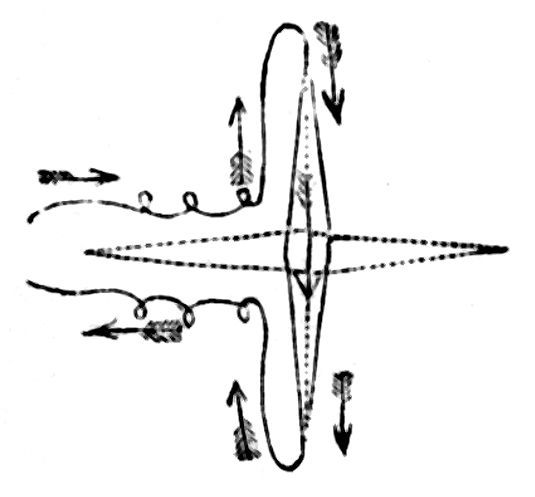
Fig. 5.
Whether the upper point, or north pole, of the needle moves to the right or left in order to attain this position depends on the direction of the current. Thus we have arrived at the principle of an electric telegraph. We have but to agree upon a set of signals that the deflection of the needle shall signify; and if we can contrive to send the current in the direction we wish, so as to move the north pole of the needle to the right or left at will, the apparatus will be complete. But, in practice, it is necessary that we should be able to move, as we please, a similar needle to our own, at the station to which we desire to send the message. In order to accomplish this, we have but to conduct the current from one station to the other by means of an insulated wire. This will be easily understood by the following diagram, where the battery is represented at A, and the different stations at B, at each of which the needles have their north poles upwards; and the wire conveying the current passes in the same direction round all, and lastly returns to the other pole of the battery; thus the current, leaving the battery by the copper or positive end, c, will traverse the wire in the direction of the arrows, deflect the needles in the same direction at the different stations, and return to the zinc or negative end of the battery by the same wire.
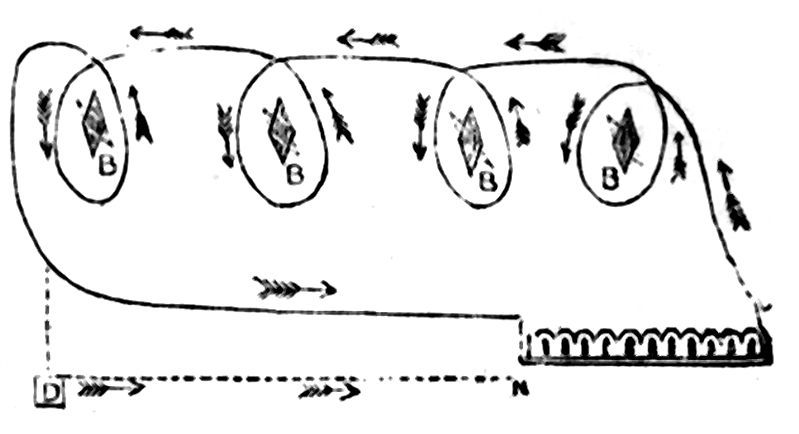
Fig. 6.
We will now tell you a very curious fact about the return of the current. The return wire is not necessary, nor is it now put in practice; for a man named Sternheil proved, in 1837, that if we buried deep in the ground the end of the wire, attaching it to a plate of metal, the earth itself would conduct the current back again, thus saving the cost of a return wire. Thus, in the figure above, we have represented this by dotted lines, and marked the direction of the return current by double arrows, N O being the plates of metal, and having the wires attached to them.
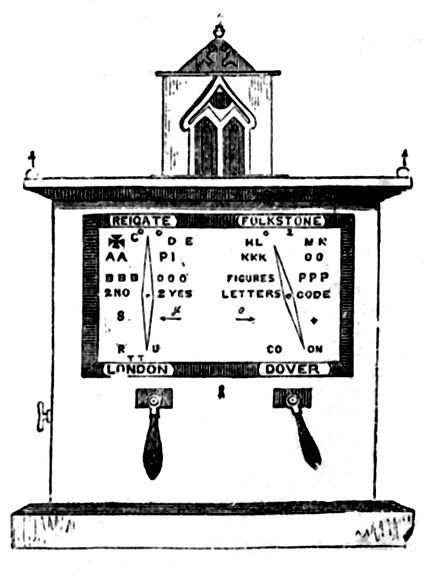
Fig. 7.
We will now explain the instrument by which communication is made with the battery, and which is qualified not only to send, but also to receive signals. It is represented by Figs. 7 and 8; Fig. 7 being the exterior, and Fig. 8 the interior. The needles in Fig. 7 (for there are usually two) are on the same axis as the ones on which the electric current acts, only their poles are reversed,—the north pole of the one being opposite the south pole of the other, by which the effect of the earth’s magnetism is annulled, and they are the more powerfully influenced by the electric current. It is by means of these outer needles that the signals are read: they are prevented from deflecting too far from their vertical or upright position by two ivory studs, one on each side; and thus the signalling is rendered more certain and rapid than if they were allowed to oscillate further. The handles at the lower part of the instrument are for moving the barrel in the interior, the one at the side for ringing a signal bell, which is also effected by electricity.
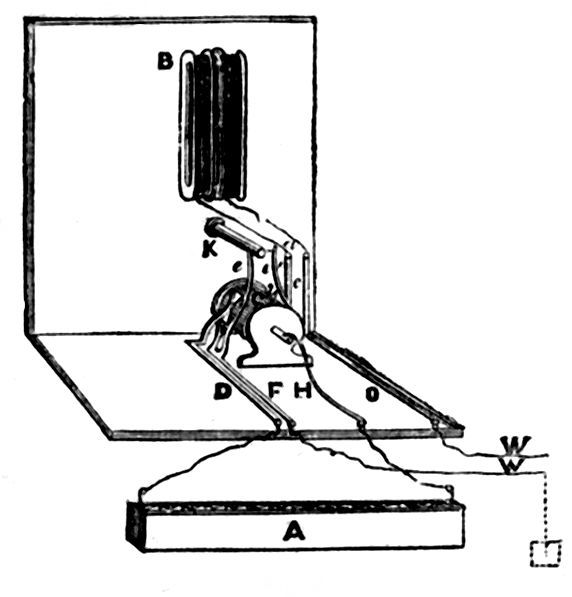
Fig. 8.
In Figure 8, we are looking at the back of the instrument, the case being removed. B is the coil of wire for passing a current of electricity round a magnetic needle suspended in it by its axis. In the former drawing, the wire passes but once round the needle; but by winding it round several times, as here shown, the effect is greatly increased. W, W, are the wires which transmit the current to and from the distant station. We will now see, first, how the instrument is calculated to receive signals. C is a cylinder of box-wood, capped at each end with brass; D, F, H, O, are slips of metal, the shape of which is seen clearly on the left side of the barrel; a piece of wood, K, projects from the front of the case, having a metal bar, about an inch in length, inserted through the end, standing across it, as in the figure. Now, if W, W″, are connected at the distant station with the two poles of a battery, a current will pass along one of these wires, W, and along the slip of metal, O, to the coil, B, having, in its passage round this, deflected the needle, thereby making a signal; it will descend by a, down the slip of metal, x, thence to the spring, e (which is a part of the same slip), through the metal bar to e, and thence by F to W″, and to the other pole of the battery. We have told you that this return wire, W″, is not used in practice: nor is it; but by supposing it to exist here, the direction of the current is more easily understood. We have, by the dotted lines, shown the buried plate attached to this wire. You should look well at the figure, and read this description of receiving signals several times, till you see it clearly; for though at first sight, the apparatus appears very complicated, it is not so; these slips of brass, so curiously shaped, being all that is required to receive signals; to send them, the cylinder C is added, the action of which we will now explain. The furthest end of it is joined to one of the handles seen in Fig. 7, by which it is made to revolve in either direction. Supposing, then, we move this handle so as to cause the small metal pin z to press against the spring e, we can thus remove the end of this spring from the short bar against which it rested, whilst the pin y at the other end of the cylinder will touch the curved end of the slip F (both these pins are fixed into the metal caps at the ends of the cylinder). The current will now pass from the battery by the spring H to the brass cap of the cylinder, thence by the pin z to é; é being removed from the short bar, and the current thus cut off in that direction, it will pass to x, which is a part of the same slip as é, thence round the coil deflecting the needle, and passing to the next station by the slip o, and wire W, will deflect the needle there, and return by the earth-current to W″. Although it is a crooked path, the electric current traverses it so quickly that no perceptible time elapses between the movement of the needle at our own instrument and the various needles of all the telegraphs on the line. Each handle has a separate cylinder, and each needle a separate coil, one only being represented for the sake of clearness. Every word of the message sent is spelt letter by letter, according to the number of times that each needle moves. The following is one of the usual alphabets, and (as in Fig. 7) this is commonly inscribed on the face of the instrument. It is the code of a single needle:—
A—One movement to the left.
B—Two left.
C—Three left.
D—Four left.
E—One left, one right.
F—One left, two right.
G—One left, three right.
H—Two left, one right.
I—Two left, two right.
J—Two left, three right.
K—Three left, one right.
L—Three left, two right.
M—Four left, one right.
N—One right.
O—Two right.
P—Three right.
Q—Four right.
R—One right, one left.
S—Two right, one left.
T—Three right, one left.
U—One right, two left.
V—Two right, two left.
W—Three right, two left.
X—One right, three left.
Y—Two right, three left.
Z—One right, four left.
With two needles the alphabet is somewhat different; but you will now understand how the movement of the needles can signify words; and we think you must now have a very good idea of the machinery of an electric telegraph. We shall now show you how the alarum is rung by electricity, to give the clerk at the instrument notice that a message is about to be sent to him, that he may be at his post, and ready to watch the needles, and read.
Wonderful as it may appear, an electric current passing round a piece of soft iron will instantly convert it into a magnet; but its magnetic properties cease as soon as the current stops. In the telegraph alarum this effect of electricity is thus applied:—A is a piece of soft iron, bent into the form of a horse-shoe; some covered copper wire is wound round it, the ends, B and C, being left loose for the purpose of connecting them with the battery. D is a piece of steel, connected with the lever, E; the other end of which forms a detent or catch, which falls into one of the notches in the wheel, F. This wheel, when the catch is removed, will revolve by a spring, and, like the movement in a common clock, acts on the hammer, H, which strikes the bell, G. B and C are connected with the distant station by a wire, as the needle apparatus. When the operator, therefore, at that station sends a current from his battery along this wire, A will become a magnet, and attract the keeper, D; this, by means of the levers, will release the wheel, F, and the clock-work will cause the hammer to strike the bell. This will call the attention of the operator, who will return the signal and watch the movement of the needles, read the message, and send the reply in the same manner.
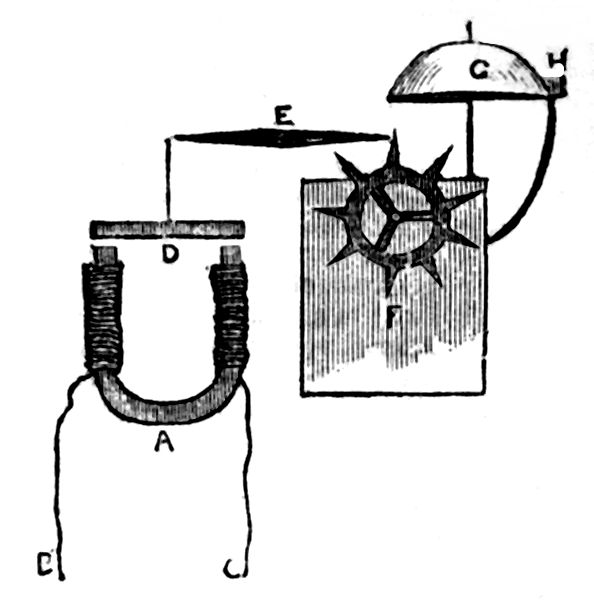
Fig. 9.
BAROMETERS, (HOW TO CONSULT THEM.) In very hot weather, the fall of the mercury denotes thunder. Otherwise, a sudden fall denotes high wind.
In frosty weather, the fall of the barometer denotes thaw.
If wet weather happens soon after the fall of the barometer, expect little of it.
In wet weather, if the barometer falls, expect much wet.
In fair weather, if the barometer falls much, and remains low, expect much wet in a few days, and probably wind.
N. B.—The barometer sinks lowest of all for wind and rain together; next to that for wind—(except it be an east or north-west wind.)
In winter, the rise of the barometer denotes frost.
In frosty weather the rise of the barometer indicates snow.
If fair weather happens soon after the rise of the barometer, expect but little of it.
In wet weather, if the barometer rises high, and remains so, expect continued fine weather in a day or two.
In wet weather, if the mercury rises suddenly very high, fine weather will not last long.
ABORIGINES. A term by which we denote the primitive inhabitants of a country.
FILTERS. The employment of a common flower-pot, of large dimensions, which may be suspended to a beam, or otherwise secured in an elevated situation, makes a good and inexpensive filter. Into this pot lay a mixture of clean sand, and some charcoal broken into bits about the size of peas, and into the hole of the flower-pot place a small plug, drilled through the centre, by which the filtered water may be conducted to the pitcher below. The water may be doubly filtered by employing two flower-pots, one suspended over the other, with a piece of sponge in the hole of the pot, the under one being prepared as directed. The sand and charcoal should occasionally be taken out and well washed, or be replaced by new materials.
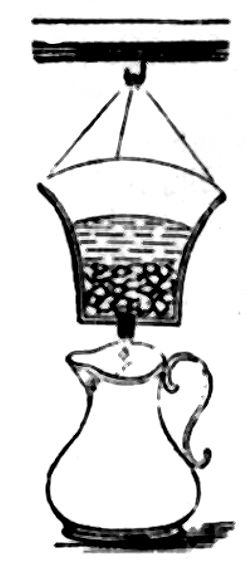
CAMERA OBSCURA. The simplest form of the Camera Obscura consists of a darkened room, with a round hole in the window-shutter, through which the light enters. Pictures of opposite objects will then be seen, inverted, on the wall, or on a white screen placed so as to receive the rays.
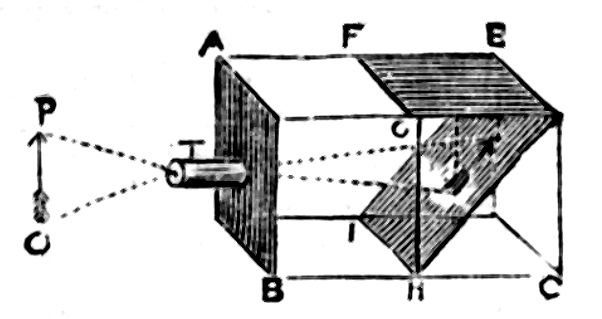
We give here a very simple form of Camera, which our readers may easily construct. A B C D is a small rectangular box, closed on all sides, except the space E F G D, which is covered with a piece of ground glass. In the other end is a moveable tube, T, with a proper lens; and in the body of the box is a mirror, E I H D, set to an angle of 45 deg. Upon this mirror the image of the object, P Q, falls, and is reflected upon the ground-glass plate.
CLEANING DECANTERS. Those encrusted with the dregs of port wine, will be readily freed from stain by washing them with the refuse of the tea-pot, leaves and all, whilst warm. Dip the decanter into a vessel containing warm water, to prevent the hot tea leaves from cracking the glass, then empty the tea-pot into the decanter, and a few strokes will clean it. The tannin of the tea has a chemical affinity for the crust on the glass.
TO CLEAN PAPER OF ROOMS. Few things can be devised better for this purpose than the old-fashioned one of rubbing the paper with stale bread; but where the paper is greasy, occasioned by persons reclining their heads against the wall, it is advisable to use a piece of flannel, wetted with spirits of wine, or Smith’s scouring drops, a mixture of turpentine and essence of lemon.
ABACUS. An instrument employed to facilitate arithmetical calculations. The name may be given with propriety to any machine for reckoning with counters, beads, &c., in which one line is made to stand for units, another for tens, and so on. We have here given the form of an abacus, such as we may recommend, for the purpose of teaching the first principles of arithmetic, the only use, as far as we know, to which such an instrument is put in this country. Its length should be about three times its breadth. It consists of a frame, traversed by stiff wires, on which beads or counters are strung so as to move easily. The beads on the first right hand row are units, those on the next tens, and so on. Thus, as it stands, the number 57048 is represented upon the lower part of it.
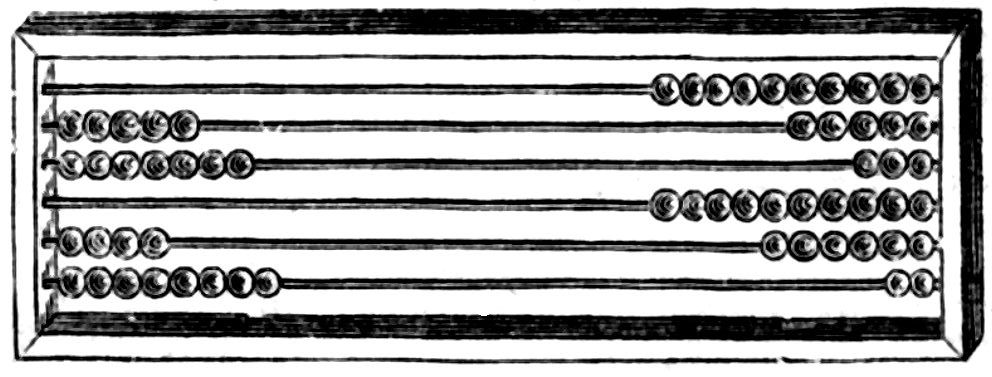
There is an instrument sold in the toy shops with twelve wires, and twelve beads on each wire, for teaching the multiplication table, and for this purpose much used in our National Infant Schools. The Russians are also much in the habit of performing calculations by strings of beads. In China, however, where the whole system is decimal, this instrument, called in Chinese shwanpan, is universally used. The word Abax was the Greek term for this instrument. Their abacus differs from that described in having only five beads on each line, one of which is distinguished by colour or size from the rest.
ABATTOIR. The name given by the French to the public slaughter-houses, which were established in Paris, by a decree of Napoleon, in 1810, and finished in 1818. These buildings, which are of very large dimensions, consist of slaughter-rooms, built of stone, with every arrangement for cleanliness, and with ample mechanical aids. An endeavour was made to establish them in England, but it failed.
ARSENIC (TO DETECT). Arsenic is not freely soluble in any organic mixtures, and may generally be found as a white sediment, which, when thrown upon a red-hot cinder, gives out a strong odour, like that of onions, and a thick white smoke. The best test is the following:—Pour two tablespoonsful of the suspected fluid into a six ounce bottle, and add seven tablespoonsful of water. Then pour in one tablespoonful of sulphuric acid. Having prepared a cork with a piece of tobacco-pipe run through it, drop into the bottle a few scraps of zinc. Hydrogen gas will be evolved, which, after waiting two or three minutes, may be lighted. If arsenic is present, the onion smell will be detected, and the flame will have a blueish-white colour. Upon holding a piece of glass, or a white saucer, over the point of the flame, black metallic arsenic, in fine crystals, and white arsenic, will be deposited. Common arsenic cannot be detected by the taste.
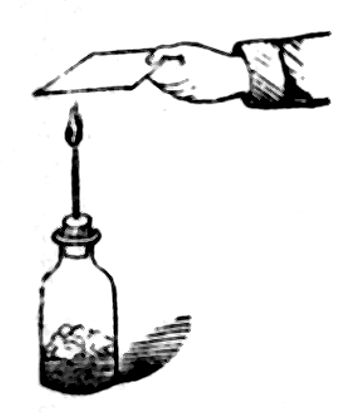
LIGHTNING. To avoid accidents from lightning during a thunder-storm, sit or stand as near the middle of the room as possible. Avoid going near the windows or walls, and put knives, scissors, and all kinds of steel utensils out of the way. Avoid standing near pipes, iron-railings, and metallic bodies, and if caught in a storm in the country, do not shelter yourself by any means under trees. On a wide and open heath, where no house shelter can be obtained, the safest plan is to lie down flat on the earth.
Stroke of Lightning. Throw cold water upon a person struck by lightning. It is said to be of very great benefit, if not a positive cure.
Lightning-Conductors should be made of copper, or preferably of iron; if of the latter metal, the pointed extremity should be gilded to prevent rust: they should be of sufficient diameter; should project some feet above the highest point of the building, and sink some feet into the ground, till they meet with moisture; and should be perfectly insulated from the building they are designed to protect, by being made to pass through glass rings wherever they come in contact with it.
ABBREVIATIONS are of two kinds; first, those which are used in familiar speech, by which two words are made one, as can’t for cannot, won’t for will not, and those which are employed in writing only. The Rabbins carried this practice to a great extent; thus for Rabbi Levi ben Gerson, they took the first letters, R. L. B. G. In the middle ages the practice of abbreviating increased, insomuch that many writings became unintelligible, and in matters of law and government the difficulties thus created demanded prompt legislative interposition; accordingly, in the fourth year of George II., an act was passed forbidding the use of abbreviations in legal documents. Within a year or two this act was so far modified as allowing the use of those of common occurrence, but the old practice was never completely revived. The most important are:—
titles.
A.M. Master of Arts.
Abp. Archbishop.
Bp. Bishop.
Bt. Baronet.
B.A. Bachelor of Arts.
B.C.L. Bachelor of Civil Law.
B.D. Bachelor of Divinity.
C.B. Companion of the Bath.
Dr. Doctor.
D.C.L. Doctor of Civil Law.
D.D. Doctor of Divinity.
Esq. Esquire.
F.G.S. Fellow of the Geological Society.
F.L.S. Fellow of the Linnæan Society.
F.R.S. Fellow of the Royal Society.
F.S.A. Fellow of the Society of Antiquaries.
G.C.B. Grand Cross of the Bath.
Kt. Knight.
K.B. Knight of the Bath.
K.C.B. Knight Commander of the Bath.
K.C.H. Knight Commander of Hanover.
K.G. Knight of the Garter.
K.G.H. Knight of Guelph of Hanover.
K.M. Knight of Malta.
K.P. Knight of St. Patrick.
K.T. Knight of the Thistle.
LL.D. Doctor of Laws.
Messrs. Gentlemen.
M.A. Master of Arts.
M.D. Doctor of Physic.
M.P. Member of Parliament.
R.A. Royal Academician.
Rt. Hon. Right Honorable.
R.E. Royal Engineers.
R.M. Royal Marines.
R.N. Royal Navy.
H.E.I.C. Honourable East India Company.
W.S. Writer to the Signet.
commercial.
Cr. Creditor.
Dr. Debtor.
Do. or ditto, the same.
No. Number.
Fo. Folio.
4to. Quarto.
8vo. Octavo.
L.S.D. Pounds, Shillings, and Pence.
A.R.P. Acres, Roods, and Poles.
Cwt. Qr. Lb. Oz. Hundredweights, Quarters, Pounds, and Ounces.
miscellaneous.
A.D. the year of our Lord.
A.M. the year of the world.
A.M. before noon.
B.C. before Christ.
i.e. that is to say.
ib. in the same place,
id. the same.
H.M.S. Her Majesty’s ship.
MS. Manuscript.
N.B. Observe.
N.S. New Style (after the year 1752).
O.S. Old Style (before 1752).
Nem. con. without contradiction.
P.M. Afternoon.
P.S. Postscript.
ult. the last month.
viz. namely.
F.D. Defender of the Faith.
D.G. By the grace of God.
EXERCISES, (INDOOR). Females much confined within doors often suffer ill health from the want of exercise. Nature demands it, and health cannot exist without it. The skipping-rope, dumb-bells, battledoor and shuttle cock, &c. are all aids to the required end. Dancing is one of the best preservatives of health, when enjoyed at proper hours, and not carried to excess. But this exercise can only be obtained upon particular occasions, when there are many to share it, and glad music contributes to heighten the enjoyment. Really the best indoor exercise for developing a graceful bearing, and for diffusing its healthful influence over the whole frame, is that of throwing balls dexterously, according to any of the contrivances of fancy. Persons who become expert in this practice may throw from one to eight balls with astonishing dexterity, the exercise being sufficiently stimulating to encourage its frequent repetition; quickening the eye, and imparting a healthful vigour to every muscle of the system. A few neat leather balls are all that are required, and a room of moderate size will afford sufficient space. Dumb-bells are cumbrous and inelegant things, and the exercise they afford is monotonous and wearisome; besides which, they exercise but one part of the body.
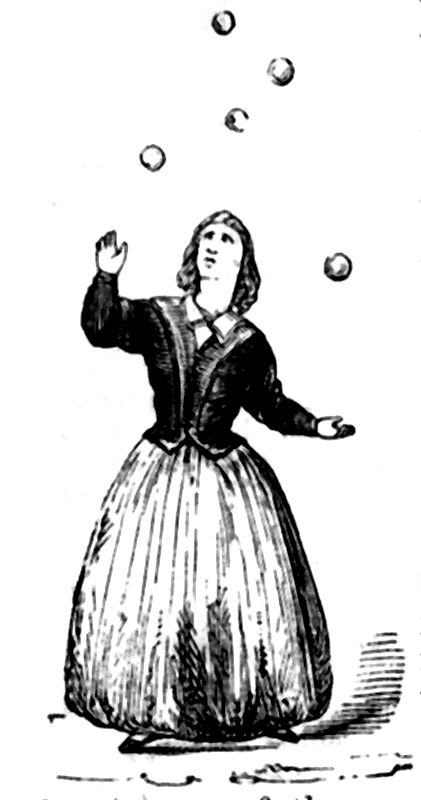
CLIMATE OF ENGLAND. The mortality of Great Britain, its cities, and its hospitals, is greatly inferior to that of any other country in Europe; it is also incontestable that Great Britain is at present the most healthy country with which we are acquainted; and that it has been gradually tending to that point for the last fifty years. It has been long the fashion, both abroad and at home, to exhaust every variety of reproach on the climate of our country, and particularly on the atmosphere of London; and yet we find that the most famed spots in Europe, the places which have been selected as the resorts of invalids, and as the fountains of health, are far more fatal to life than even this great metropolis.
ETCHING UPON IVORY. Cover the ivory with wax, hard varnished, or an etching ground, execute the required design, border with wax, and pour on sulphuric acid, hydrocloric acid, or a mixture of equal parts of both acids; when etched sufficiently, wash well, remove the wax, varnish, or etching ground with oil of turpentine, and rub well with old linen rag. Some persons rub a black varnish into the etched parts to give a greater effect. The varnish is made of lamp-black and common turpentine varnish, and the surface is rubbed clean off, leaving only the dark parts visible.
Etching (Upon Egg shells). Cover the shells with appropriate designs in tallow, or varnish, and immerse in strong acetic acid; they will then come out in strong relief.
HIVES, (COTTAGE). There are various descriptions of hives in general use. Without recommending any particular kind, we give a representation of one which is simple and effective. This is capped with a bell-glass; the small hive used as a cover for which is raised, and has part of the side cut away to show the bell-glass. The dome shape is preferable to a square or cylinder, as affording more perfect ventilation, and as being more in accordance with the clustering position of the bees themselves, either in winter or during swarming.
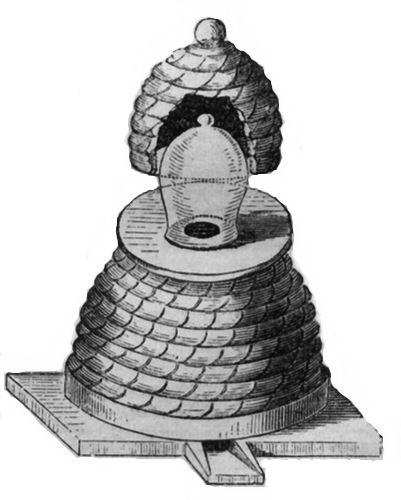
FUMIGATING BEE-HIVES. Fumigation is a word employed by bee-keepers to express the process in which, by the aid of certain intoxicating smoke, the insects become temporarily stupified in which state they are perfectly harmless, and may be deprived of their honey without any risk or trouble. They subsequently soon recover from their stupification, and are none the worse for it. Rags steeped in a solution of saltpetre, or a few tobacco leaves wrapped in brown paper, will do.

If, however, tobacco is used, care is necessary, lest the fumigation be carried to too great an extent, so as to cause the death of some of your stock. Persons not accustomed to deal with bees should wear an overall of thin gauze over the head and breast, and gloves on their hands. With this, and a little bottle of aqua-ammonia, or aqua-potassæ, to be used in case of their being stung, they have no cause for trepidation. For the process of fumigation, you should have a small tin box, with a tube extending from each of the two opposite ends; one end of this tube being so fashioned that it can readily be inserted into the hive, and the other so formed that it can readily be attached to the tube of an ordinary bellows, as in the annexed engraving.
EYE, (SUBSTANCES IN THE). To remove fine particles of gravel, lime, &c., the eye should be syringed with lukewarm water till free from them. Be particular not to worry the eye under the impression that the substance is still there, which the enlargement of some of the minute vessels makes the patient believe is actually the case.—Or, bathe the eye with a little weak vinegar and water, and carefully remove any little piece of lime which may be seen, with a feather. If any lime has got entangled in the eyelashes, carefully clear it away with a bit of soft linen soaked in vinegar and water. Inflammation is sure to follow; a smart purge must therefore be administered.
FIRE. The following are among the best Precautions in Cases of Fire. 1. Should a fire break out, send off to the nearest engine or police station. 2. Fill buckets with water, carry them as near the fire as possible, dip a mop into the water, and throw it in showers on the fire until assistance arrives, 3. If a fire is violent, wet a blanket and throw it on the part in flames. 4. Should a fire break out in a chimney, a blanket wetted should be nailed to the upper end of the mantel-piece, so as to cover the opening entirely, the fire will then go out of itself; for this purpose, two knobs should be permanently fixed in the upper ends of the mantel-piece, upon which the blanket may be hitched. 5. Should the bed or window-curtains be on fire, lay hold of any woollen garment, and beat it on to the flames until extinguished. 6. Avoid as much as possible leaving any door or window open in the room where the fire has broken out, as the current of air increases the force of the fire. 7. Should the staircase be burning so as to cut off all communication, endeavour to escape by means of a trap-door in the roof, a ladder leading to which should always be at hand. 8. Avoid hurry and confusion. 9. In case a lady’s dress takes fire, she should endeavour to roll herself in a rug, carpet, or the first woollen garment she meets with. 10. A solution of pearlash in water, thrown upon a fire, extinguishes it instantly; the proportion is a quarter of a pound dissolved in some hot water, and then poured into a bucket of common water.
STIFF NECKS, (SUPPORT FOR). This valuable support should be made of black moreen if it be worn with a black neckerchief; and of white ditto, (or mohair,) if with a light one. It is formed of a number of pieces, each one being bound with ribbon only, and being joined in the middle of each piece by a few stitches. The binding must be carried all along the top and bottom but must be sufficiently loose between the segments to give the neck a comfortable freedom.

SWELLING IN THE NECK, or Goitre, is a disease peculiar to the natives of some of the Pennine Alps, particularly Aosta and Martigny, and is allied to a species of idiotcy called cretenism.
ABSOLUTION, a religious ceremony in use in different Christian communities, by which the priest declares an individual, on repentance and submission to the requisite penance, to be absolved from his sin.
SUN-STROKE, (PROTECTION AGAINST.) A piece of silk, which is a non-conductor, worn as the lining of hat or bonnet, is a very safe protection against sun-stroke.
OIL PAINTINGS, (TO CLEAN). The art of cleaning oil paintings has been very much neglected, and several valuable pictures have been destroyed in consequence of the persons operating upon them employing the same means for removing all kinds of dirt, as they do for dust and varnish commingled, so that frequently a valuable painting has actually been scoured away.
Most paintings are varnished, and as the nature of the varnish differs, so also must the means by which they are removed. In some cases it is better to allow the varnish to remain untouched, than to interfere with it, as the painting might be damaged in the latter instance.
The materials required consist of water, olive oil, pearlashes, soap, spirits of wine, oil of turpentine; sponge, woollen and linen rags; essence of lemons, and stale bread crumbs.
Soluble Varnishes, such as sugar, glue, honey, gum arabic, isinglass, white of egg, and dirt generally, may be removed by employing hot water. To know when the painting is varnished or coated with such materials, moisten some part with water, which will become clammy to the touch. To clean the picture, lay it horizontally upon a table or some convenient place, and go over the whole surface with a sponge dipped in boiling water, which should be used freely until the coating begins to soften; then the heat must be lowered gradually as the varnish is removed. If, however, the coating is not easily removed, gentle friction with stale bread crumbs, a damp linen cloth, or the end of the forefinger, will generally effect it, or assist in doing so. White of an egg may be removed (if not coagulated by heat), by using an excess of albumen (white of egg), and cold water; but if coagulated, by employing a weak solution of a caustic alkali as potash.
Coated dirt is removed by washing with warm water, then covering with spirit of wine, renewed for ten minutes, and washing off with water, but without rubbing. The process is to be repeated until the whole is removed.
Spots should be washed with warm water dried with soft linen rags, and covered with olive oil warmed; after the oil has remained on the spots for twenty minutes, gentle friction with the finger should be used, the foul oil wiped off and fresh laid on, until the spot disappears. Should this fail, spirits of wine, essence of lemons or oil of turpentine may be carefully applied, observing that only such parts as are dirty must be covered with them; they are to be cleaned off first with water and then with olive oil. Sometimes even these means fail, and then strong soap-suds, applied directly to the spots, and retained there until they soften or disappear, will prove effectual. The spots must then be washed with water.
In employing these means, as indeed throughout the whole process of cleaning, the greatest care should be taken in removing any coating upon the surface of a painting, and it is therefore better to employ mild measures first, then if they fail, to use stronger; or in the event of these not succeeding, to very carefully apply the strongest. For our own part, we prefer leaving the painting in a half-cleaned state, as it sometimes happens that, with the most scrupulous care, under experienced persons, some of the fine touches or delicate tints of a painting are damaged by the process. When we state this, we mean only such pictures as are covered with insoluble varnishes—varnishes of gum-resins, or old oil varnishes, which cannot well be removed without injury to the painting.
Varnishes of long standing are very difficult to remove, as they generally consist of linseed oil combined with gum-resins, and if not easily taken off by the means given below, it is better to leave them as they were.
To remove these varnishes, use spirits of wine in the manner recommended for coated dirt; or, oil of turpentine, which requires greater care than the spirits of wine; or, warm olive oil: but if the varnish is very hard, the painting should be washed by means of a sponge, with a warm solution of pearlash (an ounce to a pint of water), until the coating is removed, when the surface must be washed well with fresh water frequently.
THE WEDGE. When the compression of a block of wood is completed by the means of driving in a wedge, it then splits, and it is on this principle that the action of the wedge is founded. In the annexed diagram the explanation of the law may be seen. The point of the engine has been inserted by the blow of a hammer into a block of wood, and the wood by compression, has been displaced, and the block is rending because it can suffer no more compression. All the various kinds of cutting and piercing tools, as axes, knives, scissors, nails, pins, awls, are modifications of the wedge. The angle, in these cases, is more or less acute, according to the purpose to which it is applied.
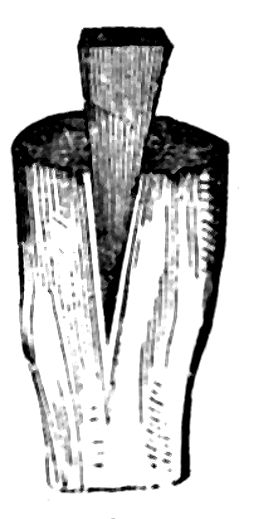
DROWNING and SUFFOCATION. Dr. Marshall Hall, after careful research, shews that to induce the act of breathing is the first thing to be attended to in drowning or suffocation. And the reason is: the lungs refuse to act, not so much because the common air with its oxygen cannot find entrance, but because the carbonic acid remains in the blood. Let us look at the mode of treatment which Dr. Marshall Hall recommends. Suppose the body to be taken from the water, it is to be at once laid on the face, not on the back, and in the open air, if houses be so far distant as to cause long delay in the removal. Every minute is precious. Being laid on the face, with the head towards the breeze, the arms are to be placed under the forehead, so as to keep the face and mouth clear of the ground. In this position the tongue falls forward, draws with it the epiglottis, and leaves the glottis open. In other words, the windpipe is open, and the throat is cleared by fluids or mucus flowing from the mouth.
The reason for placing the body in the prone position, on the face, will be better understood by noticing what takes place when it is on its back. The tongue then falls backwards, sinks, so to speak, into the throat, and closes up the windpipe, so that no air can possibly find its way to the lungs, except by force.
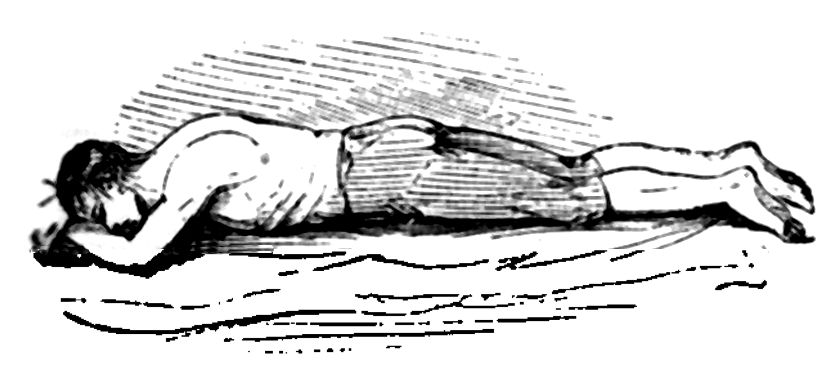
The body, therefore, being laid on its face, there is a natural pressure of the chest and abdomen which causes an expiration. This may be increased by some additional pressure. Then if the body be lifted by an attendant placing one hand under the shoulder, the other under the hip, and turning it partly on its left side, there will be an inspiration. The air will rush into the lungs with considerable violence. Then the expiration may be repeated by letting the body descend, and so on, up and down alternately. And thus, without instruments of any kind, and with the hands alone, if not too late, we accomplish that respiration which is the sole effective means of the elimination of blood poison. It is worthy of notice that by this means a really dead body may be made to breathe before it has become stiff—as experiment fully demonstrates.
About sixteen times a minute is the rate at which the body should be made to rise and fall in the endeavour to renew respiration. The clothes in the meantime should be changed for others dry and warm. Or, if in a warm room, four persons should seize the limbs with their hands, and rub them with firm pressure upwards. The warm bath is not to be compared with this mode of restoring warmth, and not warmth only, but the circulation, if it be pursued with energy. The blood is driven upwards, and though venous, may stimulate the heart.
The warm bath is on no account to be used until breathing has been restored. Dr. Hall says, it is “injurious;” and to place the patient in a sitting position in warm water, is “to renounce the only hope.” In France its use has been forbidden by authority.
DROWNING (PREVENTION OF). 1. As soon as you find yourself at the surface, whither you are raised by your buoyancy, let your body quickly take its level, when the water will reach a little above your chin. 2. Place one leg a little forward, and the other a little backward, and stretch out your arms on either side under water. By a slight paddling motion, you may regulate the position of your head, and keep the mouth and nose above the surface. Make no efforts, but wait tranquilly until succour arrives. You cannot sink. 3. Do not lay hold of your companion or assistant, or you will infallibly sink him without benefiting yourself. The best swimmer has no more natural buoyancy than you, and would be sunk by the exertion or very little force. 4. Remain perfectly passive till your helper seize you by the hair. Upon this, endeavour to second his efforts by throwing yourself upon your back. Hold your neck stiff, and let your hind head sink into the water. Try to propel yourself at this stage by regularly and slowly kicking against the water. 5. Be careful to keep every part of your body except your face under the water. 6. If two or more persons are immersed together, let them keep near to each other. By this means one boat may save the whole party at once; but if they are dispersed, one at a time can only be picked up.
Rules to Govern Persons Who Attempt to Rescue the Drowning. 1. In removing a body from the water, whether into a boat or drawing it along by your own efforts, always keep the face upwards. 2. Recollect that you have no more buoyancy than the person you are attempting to rescue. Therefore do not attempt to raise him out of the water, or you will sink. By a gentle traction, you may draw him towards the boat or landing-place without fatigue or danger. 3. Always aim at seizing the hind hair of the head, and keep the nape of the neck and your own arm under the water. Thus you will insure his face and your own above the surface. 4. Keep your most powerful arm disengaged for swimming, and maintain the other projected forward, having hold, as directed by the hair of the hind head. In this way you may advance side by side, he floating on his back, and you on your breast. 5. As you approach the person distressed, let him know by your voice; the prospect of his speedy succour will add to his confidence and strength. 6. Let all your movements be deliberate, firm, and gentle. 7. Hold the hat reversed in both hands, the arms and hands of course under water. If a person has presence of mind to accomplish this, the hat will by its buoyancy afford him great assistance, until it becomes saturated and admits the water.
SWIMMING (SAFE AND EASY METHOD OF). It may be premised, that corks of the ordinary form, and bladders, are dangerous and inconvenient in learning to swim. They impede the action of the arms, raise the body too high, and are apt to slip too low down, so as to keep the novice’s head under water. By this accident, many persons using corks have been drowned. The objection that it raises the body too high out of the water also applies to swimming-belts, which have the same peculiarity.
The following plan will enable any one to learn to swim, or those who cannot swim, to cross deep water safely. The directions, which are simple, require care:—
Take a piece of cork, or, for want of cork, light wood, such as deal, and form it into an oval shape, about eighteen inches in its utmost width. Cut a hole in the centre wide enough to admit your neck. Then divide it in two pieces, thus.
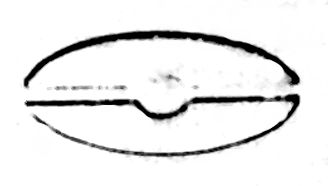
Then join the two parts on one side with a hinge of gutta percha, or caoutchouc, or leather, and on the other side of it with strings. The novice has only to put the two sides round his neck, tie the strings, and while he cannot sink, he has full use of his arms and legs in an upright position, which is the best of all for a beginner in the art of swimming.
The shape of the cork offers no impediment whatever to the progress of the swimmer, in the water.
This instrument made in cork, light wood, or bark, would be very convenient to travellers crossing rivers in America, Africa, or Australia, as they could carry a considerable weight packed upon their heads, thus—
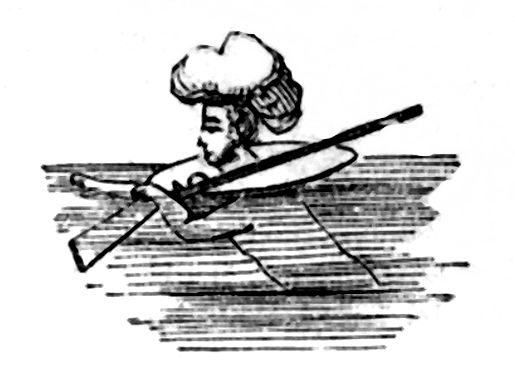
The swimmer carries his blankets and clothes on his head, and his gun over his shoulder, swimming with one hand in the greatest freedom.
For learning to swim, an India-rubber ring cushion, with an opening and string, answers well, but it is liable to get punctured.
WATER GLEANINGS. Hard water, if habitually drunk, is apt to injure the digestive organs, and the glandular and absorbent system. To this are attributed the goitres to which the inhabitants of mountainous districts are liable. That which runs over gravel is always hard.
To Determine whether Water be Hard or Soft; that is, fit or not fit for domestic purposes. To a glassful of the water add a few drops of solution of soap in alcohol; if the water be pure, it will continue limpid; if it be impure, white flakes will be formed.
To Make Salt Water Fresh. The distillation of palatable and fresh water at sea was effected by P. Nicole, at Dieppe, by simply causing the steam arising from boiling sea-water, in a still, to pass through a stratum of coarsely-powdered charcoal, in its way to the condenser, or worm-tube.
To Make Sea-Water Fit for Washing Linen at Sea. Soda put into sea-water renders it turbid; the lime and magnesia fall to the bottom. As much soda must be in as not only to effect a complete precipitation of these earths, but to render the sea-water sufficiently lixivial or alkaline. Soda should always be taken to sea for this purpose.
To Make Artificial Sea-Water.—Take common sea-salt, two pounds; bitter purging salt, two ounces; magnesia earth, half an ounce; dissolve all in six gallons of river-water. These, it is said, are the exact proportions and contents of sea-water, from an accurate analysation.
HYGROMETERS. These are instruments to determine the amount of moisture in the air. One much used is called the wet bulb hygrometer, and consists of two similar delicate mercurial thermometers, the bulb of one of which is covered with muslin, and is kept constantly wet by water, led on to it by a string from a tube in the centre. The evaporation of the water from the wet bulb reduces the temperature of that thermometer to which it is attached in proportion to the dryness of the air, and consequent rapidity of evaporation. The other thermometer indicates the actual temperature, and the difference being noted, a mathematical formula enables us to determine the dew point. But the most complete and beautiful instrument for this use is that of Mr. Daniell, which is here represented. The long limb ends in a bulb which is made of black glass, that the condensed vapour may be more easily seen on it. It contains a portion of ether, into which dips the ball of a small and delicate thermometer contained in the cavity of the tube. The whole instrument contains only the vapour of ether, air having been removed. The short limb carries an empty bulb, which is covered with muslin. On the support is another thermometer, by which we can observe the temperature of the air. When an observation is to be made by this instrument, a little ether is poured on the muslin: this evaporates rapidly, and the bulb becomes cooled. After a time, through the cooling agency, dew begins to deposit on the black glass, and the point at which this takes place is determined by the included thermometer.
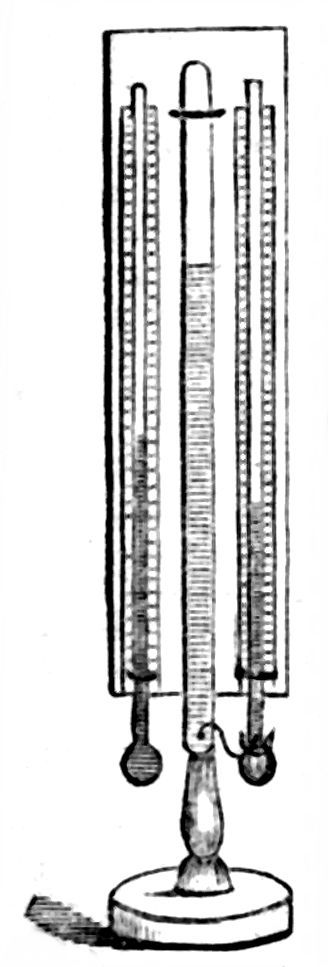
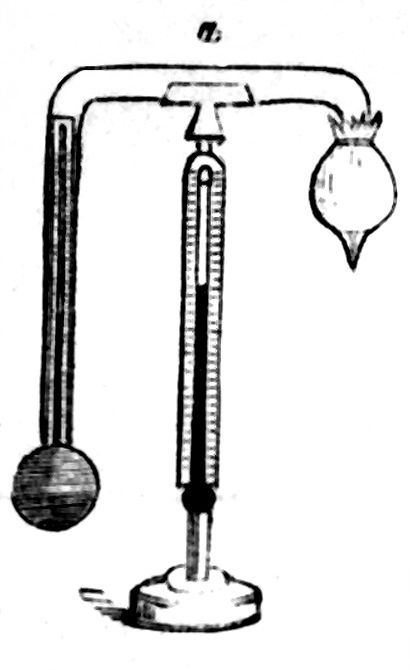
SUN-DIALS. Sun-dials of iron or brass may be purchased at very reasonable prices, or may be made of marble, slate, or freestone; and when set in an unshaded part of the garden, and mounted on a column, somewhat similar to our illustration, and around which some flowering plant has been trained to climb, it will form a very pleasing object. It is worth mentioning, that, in England, the sun-dial does not give the exact time of our reckoning, which is artificial, except at the equinoxes, being one portion of the year too fast, and another too slow, for our clocks. The French always regulate by the sun, and have, therefore, to be continually changing their timepieces.
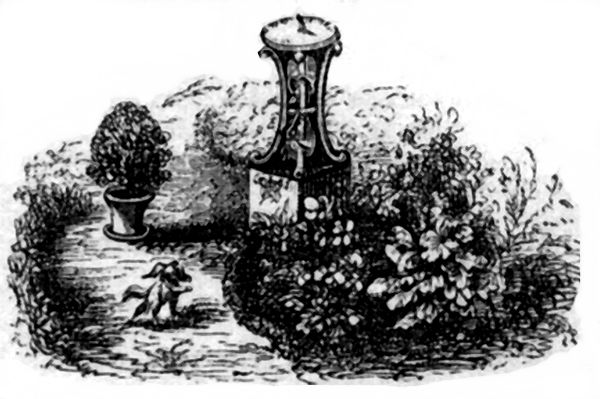
LEECH BAROMETERS. 1. If the weather proves serene and beautiful, the leech lies motionless at the bottom of the glass, rolled together in a spiral form.
2. If it rains, either before or after noon, it is found crept up to the top of its lodgings, and there it remains until the weather is settled.
3. If we are to have wind, the poor prisoner gallops through its limpid habitation with amazing swiftness, and seldom rests until it begins to blow hard.
4. If a remarkable storm of thunder and rain is to succeed, for some days before it lodges almost continually without water, and discovers uncommon uneasiness, in violent throes and convulsive-like motions.
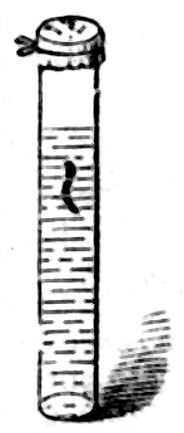
5. In the frost, as in the clear summer weather, it lies constantly at the bottom; and in snow, as in rainy weather, it pitches its dwelling upon the mouth of the phial.
The leech may be kept in a common two-ounce phial, about three-fourths filled with water, and covered with a bit of linen rag. In the summer the water should be changed once a week; and in the winter once a fortnight.
THORNS (How to Extract if the Flesh has Closed over Them). Apply shoemakers’ wax, and a poultice over that—to remain on for twelve hours, or till the wax draws out the end of the thorn.
STING OF BEES. Although the poison which a bee emits when it inserts its sting, is proved to be a highly concentrated acid, it does not follow, that the application of all alkalies will neutralize the acid. Ammonia, for example, we have known, in several instances, to produce distressing consequences—such as excessive local inflammation, temporary erysipelas, and general distress to the constitution. The more gentle alkalies—chalk, or the “blue bag,” are much more likely to effect a cure, and cannot injure. The same person will be variously affected by the sting of a bee; at one time, scarcely any inconvenience will attend it; at another, much swelling; again, but little enlargement, although great pain, &c. The eye suffers considerably, though in general the uneasiness is local; but if the back of the ear be stung, there is frequently a general affection of the system; sickness, giddiness, numbness, nervous trembling, &c. &c., which will sometimes continue for hours. A draught of camphor julap, and total repose, we have known to be beneficial in this latter case; and would earnestly recommend it to our readers, should they be placed in circumstances to require assistance.
Common whitening is an effectual remedy against the effects of the sting of a bee or wasp. The whitening must be moistened with a little cold water and immediately applied; it may be washed off in a few minutes, when neither pain or swelling will ensue.
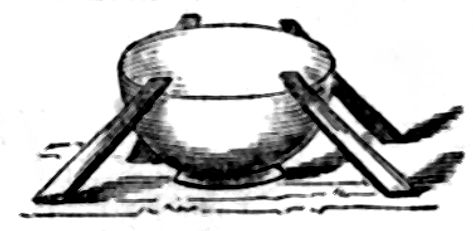
BEETLE TRAPS. A very simple and inexpensive snare may be constructed at home in the following manner:—Cut four or five pieces of pasteboard, or strips of wood, and lay them slanting against the sides of an ordinary basin, as in the figure. Pour into the basin (taking care not to soil the sides, which must be perfectly clean and bright) a mixture of treacle and water, or beer and sugar. The cockroaches will be attracted by the syrup, and walking up the roadways made for them, fall headlong into the basin. Several of these traps being set night after night will ultimately put the whole of the insects in the housewife’s power. Another plan, which may be pursued simultaneously with the above, is to place a few lumps of quicklime where the cockroaches frequent—about the hearth. Care must be taken, however, that children and ignorant persons do not burn their fingers with this substance. The beetle-wafers sold in the shops to poison “black-beetles” are made by mixing equal weights of flour, sugar, and red-lead; but these wafers are liable to be picked up and sucked by children, and are therefore objectionable.
COCKROACHES (TO DESTROY). Cucumber peelings are said to destroy cockroaches. Strew the floor in that part of the house most infested with the vermin with the green peel cut pretty thick. Try it for several nights, and it will not fail to rid the house of their not very agreeable presence.
ETCHING UPON GLASS. Procure several thick pieces of clear crown glass, and immerse them in melted wax, so that each may receive a perfect coating. When quite cold, draw on them with a fine etching-needle any designs, such as landscapes, crests, initials, &c., taking care to remove every particle of wax from such parts of the designs as are intended to be corroded.
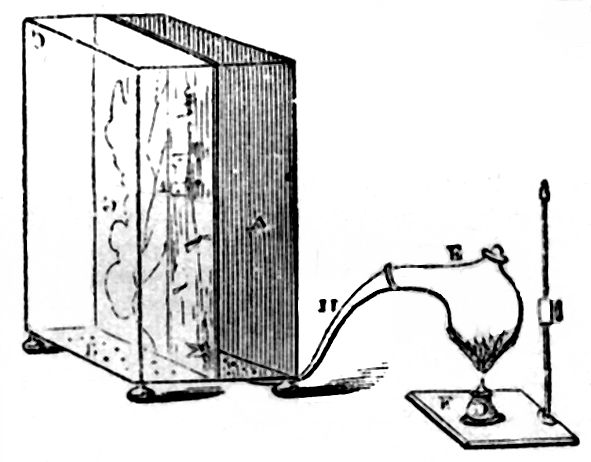
When all the drawings are finished, the pieces of glass should be placed one by one (G) in a square leaden box (A), which has one side made of glass (C), carefully coated with hard etching varnish, or what is better, melted wax, or mastic varnish, and luted into the frame with bordering wax. The glass side allows the progress of the etching to be observed. The leaden box (A) should be made to drop into a leaden trough with a perforated false bottom (B), but in such a manner that the edge may be surrounded with water, and also the bottom covered with water to absorb the superabundant gas. To the bottom of the receiver or box should be carefully luted a leaden pipe (H), which is attached to the beak of a leaden retort (E) resting in the stand (F), with a spirit lamp (D) under it. When sufficiently corroded, the glass plate may be removed, but it is necessary to have gloves on, and the hands covered with grease, to prevent the acid attacking the flesh. Those parts that are bit in enough, must be stopped out, as in common etchings (the plate being previously washed and dried), and the corrosive process combined until the several gradations of shade are obtained.
POISONS, (ACCIDENTS FROM). When you have reason to suppose that you have swallowed poison, and proper medical advice is not at hand, take an emetic. This may be done almost instantaneously by swallowing a cupful of warm water mixed with a teaspoonful of mustard. As mustard may thus prove of so much use, it should be never wanting in any house; but even should there be no mustard at hand, warm water by itself forms a tolerably efficacious emetic. The following is a good emetic in case of Vegetable Poisons.—Twenty grains of sulphate of zinc dissolved in a little water, the whole to be taken; or sulphate of zinc, one scruple, made into a bolus with confection of roses, and taken with infusion of camomile flowers.
Poisonous Vegetables. Everybody who has observed wild plants or weeds must have been struck with the resemblance many bear to parsley. Parents and nurses of children should be careful not to allow them to pick any parsley-like wild plants, as they are for the most part poisonous. Should it appear that a child has swallowed a portion of a plant of this nature, it is important to know what to give before the arrival of a medical man. Every ten minutes, therefore, administer a large dose of olive or salad oil, with warm water, till free sickness is produced. A teaspoonful or two of vinegar, given after vomiting has been fully excited, has been found beneficial.
Antidote for Laudanum. Give twenty grains of white vitriol dissolved in water, and assist vomiting by irritating the fauces with a feather; after the stomach is emptied, give large draughts of vinegar and water, and other vegetable acids, with coffee, brandy, &c., constantly rousing the attention of the sufferer, until the effects of the poison subside. Recourse may be had to this until the attendance of a medical man can be procured.
Antidote to Arsenic. Magnesia is an antidote to arsenic, equally efficacious with peroxide of iron, and preferable to it, inasmuch as it is completely innocuous in almost any quantity, and can be procured in any form.
Vitriol Accidents are not uncommon in kitchens, as when oil of vitriol (improperly used for cleaning copper vessels) is let fall upon the hands, &c. Let a little soda or potash be dissolved in water, or some fresh soap-boilers’ lees, and instantly applied; no injury whatever will occur to the person or clothes.
PIGEON HOUSES. Dovecots, or pigeon-houses, are of several kinds. If it is intended to keep a large number, the upper floor of a stable, or other building may be removed from the walls, and stepping-tiles fixed. The holes should not be too large, or too numerous, and should always have a southern aspect. Small dovecots may be made of a cask, or boarded box, placed upon a pole, or against the wall, taking care to prevent the entrance or approach of rats.
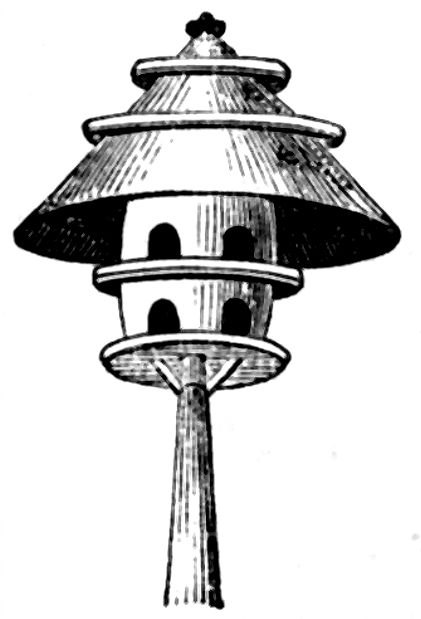
The top should be covered with thatch, so contrived as to shelter the sides from the heat of the sun, and the coldness of the wind. On the sides and top should be resting-boards, on which the birds may bask in the sun. The rearing and training of pigeons require great care, for the domesticated and fancy birds are very delicate. Cleanliness, and a plentiful supply of fresh water is, as with other tamed animals, the first requisite.
GNATS. The common gnat (culex pipieus) is a near relation to the musquito, but is not usually so troublesome to the human species. They both belong to the section Nemocera of the Dipterous insects, whose mouths are furnished with bristly stings, included in flexile sheaths. They pierce the skin by means of the proboscis, in order to feed upon the blood, and, at the same time, inject a poisonous fluid, producing considerable inflammation and swelling, of varying intensity in different persons. Their activity usually commences towards evening, or after sun-set. The Laplanders appear to be the greatest sufferers from their attacks; but all latitudes are, more or less, troubled with the species. The Laplanders use tar-cream to prevent the insects biting them, but that could scarcely be used in this country. The common Goulard water, scented with Eau de Cologne, is the best application we know, and is useful in allaying the irritation, as also preventing the attacks. We have observed that gnats seldom or never frequent rooms or houses where chloride of lime has been exposed. We recommend those who are much troubled by gnats to try this remedy.
CORROSIVE SUBLIMATE, OR STONE MERCURY. The bichloride of mercury (or quicksilver) is so called on account of its peculiarly pernicious effects upon animal tissues, and the masses in which it is sold. It is used, in small quantities, in lotions for diseases of the skin, and, in a very diluted state, in cosmetics. Taken internally it is powerfully poisonous. The following tests will be found available to discover this substance. 1. If it is in a solid state it may be mixed with potash, and heated in a test tube. If the corrosive sublimate is present, metallic globules will be found to condense on the upper part of the tube. 2. If it is in solution, and mixed with solid matters, the solution should be filtered before any tests are applied. If portions of the suspected fluid be put into test tubes, they will form precipitates of various colours with the reagents indicated:—lime water, brick red; solution of caustic potass, orange; prussiate of potass, white. 3. The best and readiest test is the following, to which the engraving refers, viz.:—Drop the suspected solution on a clean gold or copper coin, and apply a bright key so that it may at the same time touch the edge of the coin and the globule of fluid. A galvanic current is thus produced, which decomposes the corrosive sublimate, leaving a white spot of reduced metallic mercury on the surface of the coin.
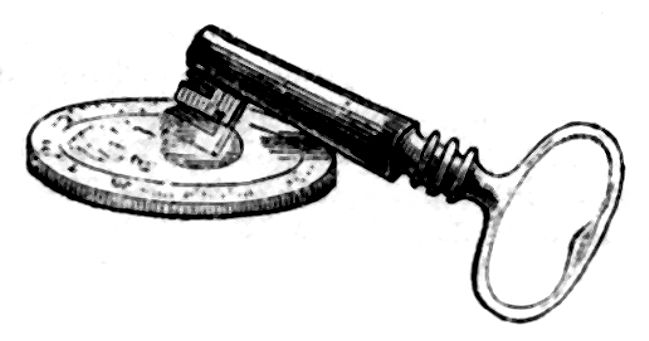
DIAMONDS. The diamond is found mostly in the East Indies and South America. Its chief feature consists in its excessive hardness, which far exceeds all other bodies, and by which, and its colour and brilliancy, it may be easily known from all other stones; for whilst it possesses the property of scratching or cutting all known substances, there has been none found capable of acting in a similar manner on it. It is rather more than three times and a half as heavy as water; it is neither volatile nor fusible, and will not dissolve in any liquid. It is generally devoid of colour; but sometimes occurs tinted of a bluish, yellow, or rose colour—these colours add to its value according to the beauty of the tint. In its rough state, as when found, it is of a milky or brownish colour, and of an irregular rounded form, and sometimes crystallized. The diamond has been known from the earliest ages, and held in high estimation, not on account of its brilliancy (as the ancients were ignorant of the art of cutting them, and wore them in the rough state), but because so few were found in nature. The art of cutting and polishing diamonds was not discovered until 1476. Up to this time no substance had been found that would grind them. But, by accident, two diamonds having been rubbed together, it was found that they polished each other—[this is the origin of the saying, “Diamond cut diamond”]—and upon this depends the whole art of cutting them. Two diamonds are secured in handles, and rubbed against each other to grind them to the shape required, and the dust that falls is used, mixed with oil, to polish them. The Romans used to pound small diamonds to powder, to cut and polish other stones; but this does not seem to have suggested to them its use to polish itself. Diamonds are often called “rose diamonds,” “table diamonds,” and “brilliants;” but this only refers to the manner in which they are cut, as there is but one kind of real diamond. When two diamonds are rubbed together, the point of contact forms a little flat surface; this is called a “facet.”
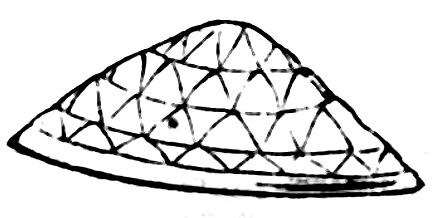
Fig. 1.
Rose diamonds have all these facets tending to a point on the sides and top of the stone, as in Fig. 1, and the under side perfectly plain. Table-diamonds have a flat, oblong top, with the sides cut in very large facets, and the under side brought to a point, also, with large facets. The brilliant, which is the most valuable form, is somewhat of the same shape, but has the flat face on top very much smaller, and nearly round; and the sides and bottom are cut into a greater number of smaller facets, which, also, are made to reflect into each other—it thus emits the greatest light, and the most variegated colours; (see Fig. 2.)
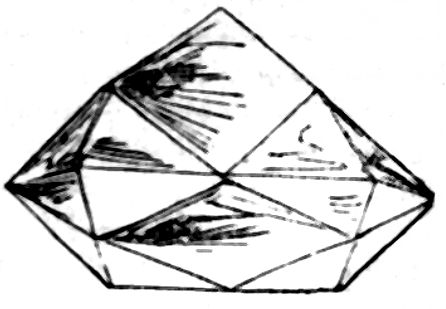
Fig. 2.
The dust that comes from the cutting of diamonds is used for cutting cameos, crests, and letters on cornelians, and other stones, and for polishing the pebbles used for spectacles; without it they could not be worked.
The finest diamond ever known, except the gem recently brought to England, belonged to the king of Portugal; it weighed 1,680 carats, and was valued at £224,000,000, though it was not cut or polished. That in the Russian sceptre weighs 779 carats, and is valued at £4,000,000. The Pitt diamond weighed 136 carats, and cost Louis XIV. £130,000. These gems are brought from Borneo, Golconda, Bengal, the East Indies, West Indies, and Brazil. They are cut and polished with their own substance. The different kinds of diamonds are as follows:—Rough diamond is the stone as it comes from the mine; rose diamond is one which is flat at the base, terminating in a point above; the table diamond has a square face at the top encompassed with four lesser facets; the brilliant is that which is cut into flat faces at top and bottom, and whose table, or principal face, is parallel with a line through the broadest part of the stone. The diamonds used by glaziers are usually only fragments of badly-coloured stones.
ORNAMENTAL EGGS. The ornamental eggs, made and sold by the German peasantry, are manufactured as follows:—Take any large egg, and after puncturing each end, blow out the contents, until the interior is quite clean. Then take some rushes, and splitting open their green bark, extract the pith by running the thumb-nail along the rush; a little practice will be required. Paste circular, or sexagonal, octagonal, or oval pieces of coloured silk, velvet, or paper, upon different parts of the egg, and then work the pith or the rushes around these, in any fanciful design. All that is required to make the pith adhere, is a little gum, or thin paste. The eggs look very pretty and supply neat household ornaments. Boxes, &c., may be covered in the same way.
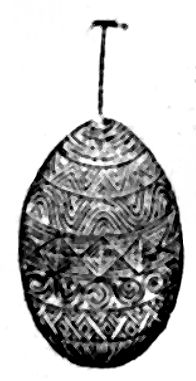
CUPS IN PIES. The cup which is placed upside down in meat and fruit pies is only filled with air when it is put into the pie. When the heat of the oven begins to act this air expands, and forces its way under the edge of the cup at the bottom of the pie. In this action it produces a somewhat similar effect to stirring with a spoon. When the whole substance of the pie has attained the boiling heat, the air in the cup expands no more; or the contrary, as soon as the pie is removed from the heat, the air in its interior begins to contract, and the pressure of the atmosphere without drives the gravy into the cup. It is a mistake to suppose that the cup prevents the syrup or gravy boiling over while the dish is in the oven; but it is useful in many ways—to support the crust, &c.
THE DEATH-WATCH. Superstitions have been associated with various insects from the earliest times, and in all countries. The death’s-head moth has been regarded as an unwelcome omen to the homes visited by it; and the noise of the death-watch has been affirmed to “click the hour of death.” Swift ridicules the absurd superstition in the following manner:—
“A wood worm
That lies in old wood, like a hare in her form
With teeth or with claws it will bite, it will scratch,
And chamber-maids christen this worm a death-watch.—
Because, like a watch, it will always cry click.
Then woe be to those in the house that are sick!
For, sure as a gun, they will give up the ghost
If the maggot cries click when it scratches the post.
But a kettle of scalding hot water injected,
Infallibly cures the timber affected;
The omen is broken, the danger is over,
The maggot will die, and the sick will recover!”
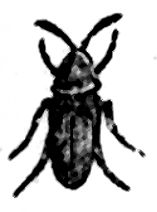
The noise is produced by a species of small beetle, of the timber-boring genus, Anobium. In the spring these insects commence their ticking, as a call to each other. They beat with their heads, and though they are very “head-strong,” they are less (in the common acceptation of the term) than the people who cling to the stupid belief that their sound is a token of coming calamity.
SHAMROCK (HOW IT CAME TO BE THE NATIONAL EMBLEM OF IRELAND). According to tradition, when Saint Patrick landed near Wicklow, to convert the Irish, in 433, the pagan inhabitants were about to stone him; but having obtained a hearing, he endeavoured to explain to them the Trinity in Unity; but they could not understand him till, plucking a shamrock—three-leaved grass, or trefoil—from the ground, he said, “Is it not as possible for the Father, Son, and Holy Ghost, as for three leaves to grow upon a single stalk?” Upon which, says the legend, the Irish were immediately convinced.
WATERPROOFING BOOTS AND SHOES. To half a pint of drying oil add one ounce of turpentine and half an ounce of Burgundy pitch; mix carefully together in a glazed pipkin, over a slow fire; lay the mixture over the boot or shoe with a sponge or soft brush, while yet warm, and when dry, repeat the process, until the leather will hold no more; the shoes must then be put away, and not worn till they are perfectly dry and elastic.
BRUISES AND THEIR TREATMENT. The best application for a bruise, be it large or small, is moist warmth; therefore, a warm bread-and-water poultice in hot moist flannels should be put on, as they supple the skin. If the bruise be very severe, and in the neighbourhood of a joint, it will be well to apply ten or a dozen leeches over the whole bruised part, and afterwards a poultice. But leeches should not be put on young children. If the bruised part be the knee or the ankle, walking should not be attempted till it can be performed without pain. Inattention to this point often lays the foundation for serious mischief in these joints, especially in the case of scrofulous persons. Some consider that Tincture of Arnica is the best cure for bruises and contusions: a few drops are to be dropped into a wineglassful of water, and the part affected bathed often with a piece of soft cambric. Caution is necessary not to make the dilution too strong, as in that case an eruption might arise on the skin, and the prevention might become worse than the cure.
DOOR MATS. One of the most useful mats for cottage and other doors is that termed the “chain mat,” which is commonly made of rope, or of cocoa-nut fibre. These mats are found very durable, and it is sufficiently obvious from their structure that they do not become clogged with dirt, which falls into the interstices, and may easily be swept away when the mat is lifted up. We call the attention of cottagers to the fact that hay-bands, or twisted or plaited straw, may easily be converted into mats of this description.
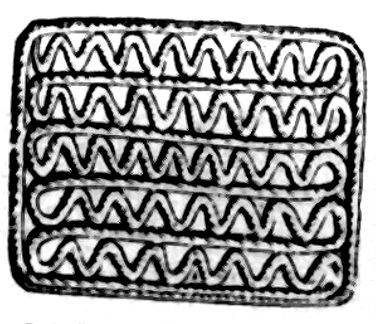
BARBERS’ POLES (ORIGIN OF). In the reign of Henry VIII., who confirmed the charter of the College of Surgeons, there were few surgeons—in fact, only ten in number—who confined themselves entirely to the profession of surgery, and whose portraits have been handed down to us in one of the finest efforts of Holbein’s pencil, where these ten worthies are represented on their knees before the king. This celebrated painting is now in the possession of the Barbers’ Company. Up to this time a co-partnership existed between barbers and surgeons; and we find a branch of the fraternity at Newcastle, in 1742, ordaining that “no brother should shave on a Sunday;” and, moreover, that “no one should shave John Robinson till he pays what he owes to John Shafto.” The sign, or signal, announcing the residence of one of this fraternity was a long pole affixed to the door-post, as may be seen in many places in the metropolis at this hour. According to the historic account of this sign, it had its origin in “ancient Rome,” where—
“ ’Twas ordered that a huge long pole,
With bason decked, should grace the hole,
To guide the wounded.”
“But when they ended all their wars.
And men grew out of love with scars—
Their trade decaying: to keep swimming
They joyn’d the other trade of trimming;
And to their poles to publish either,
Thus twisted both their trades together.”
FISH PONDS. It is necessary, in making an artificial fish-pond, where the earth is of that nature that it will not hold water, to take an equal quantity of gravel, sand, and clay; let these be spread over the proposed pond, and tempered with water, cutting the materials with a spade, and treading it well with the feet, in two courses or layers, each eight inches in thickness. The pool, after this is done, cover the whole surface with dry soil, four inches in thickness. The pool, after this process, will be perfectly retentive, and the water may be turned into it as soon as it is completed. On the opposite side of the pool to where the water flows in, should be made a sort of waste weir with a few bricks level with the surface water in the pond, to take away the overflow, and prevent the water in the pool becoming stagnant.
PLASTER CASTS. Take some fine wax, and melt carefully in a covered pot. Next dry your cast in an oven, or on the hob; then take the wax, and drop it with a camel’s-hair pencil on the heated cast, until it will absorb no more. This will give it the appearance of alabaster or ivory, especially if you carefully burnish it with a piece of leather. We have seen some beautiful plaster heads which, eighteen years ago, were prepared according to the following directions. They were mounted on a black satin cushion, framed and glazed; and hung as ornaments in the drawing-room, deceiving the most curious eye. Break the edge off a plaster of Paris head [medallion], as near as you can without damaging the subject. Lay it in a soup plate, well covered with the very best sperm oil, for twelve hours. Take it out and lay it in the sun till quite dry. The drying will require about two days. Then, with a penknife, cut it round till the face only remains. Polish it with a cold, clean hand. This must be well done, but not till quite dry.
FOOD IN SEASON. January. Meats.—Beef, mutton, veal, pork, house-lamb. Poultry.—Pheasants, partridges, hares, rabbits, woodcocks, snipes, turkeys, pullets, capons, fowls, and pigeons. Fish.—Oysters, prawns, crabs, lobsters, crayfish, whitings, smelts, sturgeon, skate, turbot, plaice, thornback, flounders, perch, tench, and carp. Vegetables.—Cabbages and sprouts, sorrel, endive, spinach, beet-root, celery, scorzanera, potatoes, parsnips, turnips, broccoli, shalots, lettuces, cresses, salsify, cucumbers, and asparagus; mushrooms all the year. Fruit.—Pears, apples, nuts, grapes, medlars, and walnuts.
February and March. All meats and game as in the former month, with the addition of chickens and ducklings. Fish.—Exactly as last month, excepting cod, which is not supposed to be quite so good up to July. Vegetables.—Just the same as the previous month, only now you have kidney beans. Fruits.—Apples and pears, and forced strawberries.
April, May, and June. Meats.—Beef, mutton, veal, lamb, and in June venison. Poultry.—Pullets, fowls, chickens, ducklings, pigeons, rabbits, and leverets. Vegetables as before, only in May early potatoes, peas, radishes, French beans, early cabbages, carrots and turnips, cauliflowers, asparagus, artichokes, and all kinds of salad, but this is forced. Fruits.—In June, strawberries, cherries, melons, green apricots, currants, and gooseberries for tarts only. Fish.—Carp, soles, tench, smelts, eels, trout, turbot, lobsters, chub, salmon, herrings, crayfish, mackerel, crabs, prawns, and shrimps.
July, August, and September. Meats.—These are not different from the former months, except pork, which commences in September. Poultry.—Pullets, fowls, chickens, and rabbits, pigeons and green geese, leverets, turkeys, poults, the two former months; wheat-ears and geese in September. Fish.—Cod, haddocks, flounders, skate, thornback, mullet, pike and carp, eels and shell-fish, but no oysters; mackerel in July, it is not so good in August. Vegetables.—As all the previous months; peas and beans. Fruits.—July, strawberries, gooseberries, pine-apples, plums of all kinds, cherries, apricots, raspberries, melons, damsons, white and red currants, pears, apples, grapes, nectarines and peaches. In August and September, peaches, plums, filberts, figs, mulberries, cherries, apples and pears, nectarines, grapes, pines and melons, strawberries.
October. Meats do not differ; this is the season for good doe venison. Poultry and Game.—Fowls of all kinds as the former quarter, pheasants from the 1st October, partridges, larks, hares, wild ducks late in the month, teal, snipes, widgeon, and grouse. Fish.—Dories, smelts, pike, perch, halibuts, brills, carp, salmon, trout, barbel, gudgeon, tench, all shell-fish. Vegetables are now as in January month. Fruits.—Peaches, pears, figs, bullaces, grapes, apples, medlars, damsons, filberts, walnuts, nuts, quinces.
November. Meats. Beef, mutton, veal, pork, house-lamb, doe venison.—Poultry, Game, Fish, Vegetables, and Fruits.—As the last month.
December. Meats as the former month. Poultry.—Geese, turkeys, pullets, pigeons, capons, fowls, rabbits, hares, snipes, woodcocks, larks, pheasants, sea-fowls, Guinea fowls, wild ducks, teal, widgeon, grouse, and dunbirds. Vegetables.—As in the last month. Fish.—Turbot, gurnets, soles, sturgeon, carp, gudgeon, eels, codlings, dories, and shell-fish of all kinds. [It is only a Fact to say that we are indebted for this information to the Family Friend, a cheap and cleverly conducted Domestic Magazine.]
DANDELION. The name is derived from the French “Dent de lion” or “lion’s tooth,” from the likeness supposed to be observed between the canine tooth of the lord of the forest, and the strap-shaped florets of the dandelion, or from the tooth-like margins of the leaves. The flower is peculiarly sensitive to atmospheric changes. In spring the leaves are used as salad, and in France the blanched leaves are eaten with bread and butter. The root dried and roasted makes excellent chicory, and much resembles coffee.
METALLIC TREES. The Lead Tree is produced as follows:—Put into a glass bottle about half an ounce of sugar of lead, and fill up to the neck with distilled or rain water; then fasten to the cork or stopper a piece of zinc wire, so that it may hang in the centre; then place the bottle where it may remain undisturbed. The wire will soon be covered with crystals of lead, precipitated from the solution, and assuming a tree-like form, very pleasing to the eye.
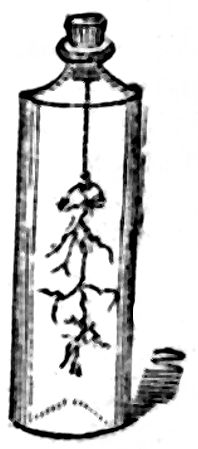
For the Tin Tree, proceed as before, and put in three drachms of muriate of tin, and about ten drops of nitric acid. The tin tree has a more lustrous appearance than the lead tree. The Silver Tree is prepared by a solution of four drachms of nitrate of silver, in distilled or rain-water, as before; to which add about an ounce of quicksilver. These experiments are easy and interesting.
AN ÆOLIAN HARP, (TO CONSTRUCT.) Length thirty-two inches by six; depth one and three-quarter inches. The strings are attached to the small hooks at the end, corresponding to the pegs.

The strings must be about the thickness of the first string of the violin. These strings answer well, but if too expensive, the small gut used by whip manufacturers may be used. The bottom plank of the harp should be oak, three-quarters of an inch thick, length three feet, breadth ten inches. The bridges may be any sonorous wood, (but steel will give the best sound), half an inch in height, cut angular to a blunt point; they must not be flattened down, but must be made to fit very flat to the bottom board, or it will jar, and never play well. This is the great defect in all harps made by amateurs. The ends of the harp should be oak, one inch thick, and must be fixed very firmly to the bottom board, but not with metal screws or glue; and in these the pins are fixed for tightening the strings. Use fiddle-pins, half at each end. The top should be half an inch thick, and sycamore wood is the best, and may be polished—it should be very slightly fastened on, for it has to be removed every time to tune. Common catgut does nearly as well as German. Get as thick a string as you can for one side, and a thin one for the other; then graduate them from the thick to the thin, so as not to have two alike. They are in general tuned to 𝄞C, but it is preferable to tune to low C, and then each string an octave higher. This is easily altered, if desirable. The instruments should be made very strong in all respects, for the strings exert almost incredible strength. The position for placing the harp at the window to be with the upper surface inclined towards the draft of air.
STORM GLASSES. The following directions may serve for a storm-glass.—Take two drachms of camphor, half a drachm of pure nitrate of potash, and half a drachm of muriate of ammonia. Triturate them together until they are thoroughly pulverised. Put these ingredients into a bottle of about ten inches in length, and one inch in diameter; half fill it with the best alcohol, and add distilled water, until you obtain as heavy a precipitate as you consider necessary. Cork the bottle, not cover it with perforated bladder, as recommended sometimes. The instrument should be kept in the shade, as solar light deranges it. The indications given by these glasses are as follow:—If the weather promise to be fine, the solid matter of the composition will settle at the bottom of the glass, while the liquid will remain transparent; but previous to a change for rain, the compound will gradually rise, the fluid continue pellucid, and small stars will be observed moving or floating about within the vessel. Twenty-four hours before a storm, or very high wind, the substance will be partly on the surface of the liquid, apparently in the form of a leaf; the fluid in such case will be in a state resembling fermentation.
PASTILLES. There are various modes of making pastilles. The following are approved recipes:—1. Take of powdered gum benzoin 16 parts; balsam of tolu, and powdered sandal wood, of each 4 parts; linden charcoal 48 parts; powdered tragacanth, and true labdanum, of each 1 part; powdered saltpetre, and gum Arabic, of each 2 parts; cinnamon water 12 parts. Beat into the consistence of thick paste, and having made into shape, dry in the air.—2. Gum benzoin, olibanum, storax, of each 12 oz.; saltpetre 9 oz.; charcoal 4 lbs.; powder of pale roses 1 lb; essence of roses 1 oz. Mix with 2 oz. of gum tragacanth dissolved in a quart of rose-water.—3. The same formula may be varied, by the substitution of pure orange powder for the roses, and oil of neroli for the essence of roses.—4. By adding a few grains of camphor to the first recipe, a pastille suited to an invalid’s chamber is prepared. If the scent of the above seems too powerful, the proportions of saltpetre and charcoal may be increased. Never use musk and civet in pastilles.
GUTTA-PERCHA SOLES, (HOW TO PUT ON). Dry the old sole, and rough it with a rasp; after which, put on a thin coat of warm solution with the finger, rub it well in; let it dry, then hold it to the fire, and, whilst warm, put on a second coat of solution thicker than the first, let it dry. Then take the gutta-percha sole, and put it in hot water until it is soft; take it out, wipe it, and hold the sole in one hand and the shoe in the other to the fire, and they will become sticky; immediately lay the sole on, beginning at the toe, and proceed gradually. In half an hour, take a knife and pare it. The solution should be warmed by putting as much as you want to use in a cup, and placing it in hot water, taking care that no water mixes with the solution.
ACCOUNTS. It is incumbent on every housekeeper to keep an account of his income and expenditure. We cannot too emphatically speak of the importance of observing this rule, and submit the following as a model for keeping domestic accounts:—
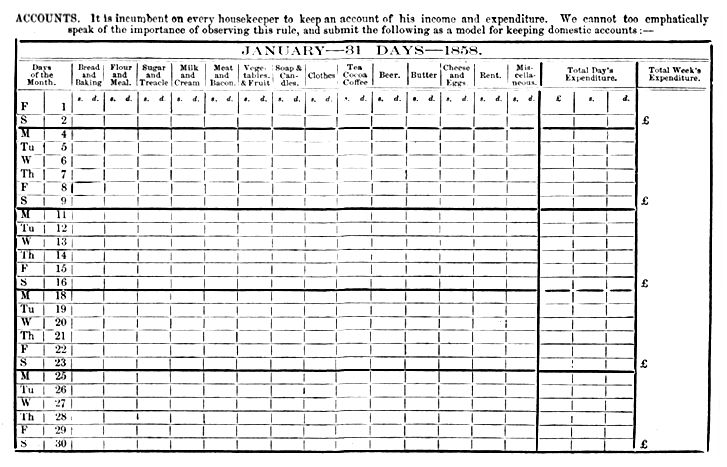
CRYOPHORUS. The cryophorus, or frost-bearer, is a pleasing philosophical toy, sometimes known as a pulse glass. This instrument consists of two small glass globes united by a tube, one of which is partly filled with water. The end of the tube is hermetically sealed while the water is boiling, and thus it is constructed perfectly free from air. The part of the apparatus (A) unoccupied by the water, though apparently empty, is, in reality, filled with aqueous vapour, which checks evaporation from the surface of the water (B).

If the pressure of this vapour be removed, by plunging the empty ball into a freezing mixture (which condenses the vapour), so rapid an evaporation takes place, that the water in B is frozen in two or three minutes. The notion that this glass can indicate the actual state of the pulse, is erroneous: it only indicates the warmth of the hand, and then acts as a differential thermometer, i.e. indicating the difference between the heat of the globes A and B.
SWIMMING-BELTS. The largest portion of the entrail of the ox, when nicely cleaned, forms an excellent material out of which to form a swimming-belt. Procure two of them from the butcher, and having washed them in soap and water, turn them inside out, and soak in a strong solution of alum water. Then tie up one end tightly with waxed string, blow full of air and secure the other end in a similar manner. The two guts having been thus treated should be hung up to dry, and in a few days varnished. The ends where they are tied should be covered with a solution of sealing wax in spirit. If, however, in this form the belt is not considered sufficiently portable, the last direction may be omitted, and the air let out after each time of using. It will be liable, however, to get out of repair upon this plan.
COD LIVER OIL. This imported oil is prepared by exposing the livers to the heat of the sun in tubs till putrefaction takes place; drawing off the oil, and boiling the livers to obtain more oil. In this country the bland pale straw-coloured variety is obtained by heating the livers over a slow fire, and stirring till they break down into a pulp. When the temperature has risen to 159 Fahr., the pulp is placed in canvas bags, and in 24 hours the oil which drains out is separated from the watery liquor which accompanies it. Obtained in this way, the oil has been found to produce all the therapeutic effects ascribed to the more offensive kinds, and is less liable to disagree with the stomach. It is used in scrofula, consumption, rheumatism, debility, &c. The dose is a tablespoonful or two, three times a-day for two or three months. It may be taken in water or with a little salt. The Americans take the nauseous draught in porter. It appears to be highly nutritive as well as alterative. It contains iodine and bromine.
BLEEDING AT THE NOSE. When bleeding at the nose occurs otherwise than as the result of violence, it is usually in consequence of the over-fulness of some of the vessels about the brain, and is the consequence of an effort of nature to relieve the congestion. When, however, it is the result of violence, or is continued beyond a few minutes, or takes place in excessive quantity, it should be checked as soon as possible. Of the various methods, the following is perhaps the most useful:—Let the patient sit and hold the head back while cold water is dashed over the face. Let him also sniff aromatic vinegar, or smelling salts. May be sometimes checked by the person sitting upright and bathing the nose externally with cold water, or vinegar and water, and sniffing it up the nostrils. Should it continue, a moderate pinch of powdered alum may be put into a couple of tablespoonfuls of water and thrown up with a squirt, or a plug of lint dipped in this wash and placed up the nostril, taking care to fasten a strong thread securely round it.
FRUIT, (THE BEST TIME FOR EATING). The question is of some importance, and deserves a few remarks. Fruit is digestible in proportion to its perfection, and hence the care to be observed with regard to ripeness. The drier fruits are adapted to cool and dry weather; the moister ones to the hotter. Thus the less juicy sorts of cherries, pears, and peaches, are not only most grateful but most salutary when the weather is excessively hot; while the currant, and melon, and the moist peach, are best adapted to the hottest weather. The same may be said of the different hours of the day. If fruits are eaten at all late in the day, especially after mid-day, they should be the more watery, as the melon. Fruit should generally be eaten in the early part of the day, and seldom late in the evening. The morning is, on the whole, best, and next to that, perhaps, the middle of the day. The worst time is the hour just before going to bed.
POST-OFFICE RATES, RULES AND REGULATIONS. 1. Rates of Inland Postage. Inland Letters are those which pass between places in the United Kingdom, including the Isle of Man, the Orkney, Shetland, Scilly, and Channel Islands. The rate of postage on all inland letters is regulated by weight, irrespective of distance, and (with the exceptions afterwards mentioned) is as follows:—
If paid in advance—
| Letter weighing not more than ½ oz. | 1d. |
| Letter„weighing„ more than ½ oz., not exceeding 1 oz. | 2d. |
| Letter„weighing„ more than 1 oz., not exceeding„ 2 oz. | 4d. |
| Letter„weighing„ more than 2 oz., not exceeding„ 3 oz. | 6d. |
and so on; twopence being charged for every additional ounce.
2. As a general rule, the postage, if not paid in advance, is double the foregoing; and if the payment in advance be insufficient, double the deficiency is charged. An inland letter, for example, weighing more than half an ounce, and not exceeding one ounce, if bearing a penny stamp only, is, on delivery, charged twopence. The unpaid additional postage on re-directed letters, however, is not doubled, being the same as if such postage were prepaid. Unless three quarters, at least, of the postage of a letter weighing more than 4 oz. be prepaid, the letter is not forwarded, but a notice of its detention is forwarded to the sender, or failing him, to the person to whom it is addressed.
Newspapers and other periodical Publications bearing the Newspaper Stamp.
3. All periodical publications, including newspapers published in the United Kingdom, at intervals not exceeding thirty-one days, and which bear an impressed stamp or stamps denoting the stamp duty (of the kind formerly confined chiefly to newspapers), may be transmitted and re-transmitted through the post within the United Kingdom free of postage under the following regulations, viz:—
No publication, or portion thereof, can pass through the post unless the impressed stamp which it bears be a stamp of the value at least of one penny.
The publication must be folded in such a manner that the whole of the stamp or stamps, denoting the full duty, shall be exposed to view, and be distinctly visible on the outside, except that where there are more than two publications in the same cover it will be considered sufficient if the stamps be so arranged that they can readily be examined.
It must be posted within fifteen days from the printed date of issue.
It must have either no cover or a cover open at the ends.
It must contain no enclosure.
It must have no writing or other mark thereon, but the name and address of the person to whom it is sent, nor anything on the cover but such name and address, the printed title of the publication, and the printed name and address of the publisher or vendor who sends it.
If the publication be addressed to any person within the free delivery (three miles of the General Post-office) of the place where it is posted, it will become liable to a postage of one penny, which must be prepaid by affixing a postage stamp.
When a newspaper, &c., is so folded as not to expose the stamps, a postage of one penny is charged in addition to any other postage to which the publication, if properly folded, would be liable; and if the newspaper, &c., be addressed to any person within the free delivery of the place where it is posted, and do not bear a penny postage label, it will be charged 2d.
4. Book Post. At the following charges, and on the subjoined conditions, book packets may be sent by the post to any place within the United Kingdom:—
| Weighing not more than 4 oz. | 1d. |
| Weighing„ more than 4 oz., not exceeding 8 oz. | 2d. |
| Weighing„ more than 8 oz., not exceeding„ 16 oz. | 4d. |
| Weighing„ more than 1 lb., not exceeding„ 1½ lb. | 6d. |
and so on, twopence being charged for every additional half-pound or any less weight.
The postage must be prepaid in full, by means of postage stamps affixed outside the packet or its cover.
Every packet must be sent either without a cover, or in a cover open at the ends or sides; so as to admit of the enclosures being removed for examination. For the greater security of its contents, the packet may be tied at the ends with a string; but in such case the Postmaster is authorized to cut the string, although he is required to re-fasten the packet.
A book-packet may contain any number of separate books or other publications, prints, or maps, and any quantity of paper, parchment, or vellum; to the exclusion, however, of written letters, whether sealed or open. And the books or other publications, prints, maps, &c., may be either printed, written or plain, or any mixture of the three. Further, all legitimate binding, mounting, or covering of a book, publication, &c., or of a portion thereof, will be allowed, whether such binding, &c., be loose or attached; as also rollers, in the case of prints or maps; markers (whether of paper or otherwise), in the case of books; and, in short, whatever is necessary for the safe transmission of literary or artistic matter, or usually appertains thereto; but no patterns, or books of patterns (unless these consist merely of paper) can be allowed.
No book-packet may contain any written letter, closed or open, or any enclosure sealed or otherwise closed against inspection; nor must there be any letter, nor any communication of the nature of a letter written in any such packet or in or upon its cover. Entries, however, merely stating who sends the book, &c., or to whom it is given, are not regarded as a letter. Indeed as respects the name and address of the sender, not only is the writing permitted but recommended; so that if the cover comes off or for any other reason the packet cannot be forwarded, it may be returned.
No book-packet can be received, if it exceeds two feet in length, width or depth.
Any packet which shall not be open at the ends or sides, or shall have any written letter or any communication of the nature of a letter written in it, or upon its cover, will be charged with the “unpaid” or double letter postage.
If a packet be found to contain any written letter, whether closed or open, or any enclosure sealed or otherwise closed against inspection, or any other unauthorized enclosure, the letter or enclosure will be taken out and forwarded to the address on the packet, charged with the full postage, as an unpaid letter, together with an additional rate of 1d.; and the remainder of the packet, if duly prepaid with stamps, will then be forwarded to its address.
If a packet be not sufficiently prepaid with stamps, but nevertheless bear a stamp of the value of 1d., it is forwarded, charged with the deficient book-postage, together with an additional rate of 1d.; but any packet which bears no postage stamp is charged with the “unpaid” or double letter postage.
In every case in which the postage chargeable under these regulations is greater than the letter rate, the letter postage is substituted.
5. Registration. By the prepayment of a fee of fourpence (which fee, in the case of a letter addressed to a place abroad, may be paid either in money or stamps; but in all other cases it must be paid in stamps) any letter, book, or other packet on which the postage has been prepaid in stamps, may be registered in any place within the United Kingdom. Book-packets and newspapers can also be registered to the colonies. To foreign countries letters only can be registered. The registration of a packet makes its transmission more secure by rendering it practicable to trace it, when inland, from its receipt to its delivery; and when colonial, if not to its delivery, at least to the port of despatch. The Post Office does not guarantee the safe delivery of the letter, &c., though the officers are of course responsible to the Postmaster-General, who will call to strict account any one neglecting his duty on this point, and, if his Grace think proper, will require him to make good any loss that may be sustained thereby.
6. The postage of registered letters must be prepaid; and if the letter be inland, it must be prepaid in stamps.
7. Every letter to be registered should be presented at the window, and a receipt obtained for it, and must on no account be dropped into the letter-box. If, contrary to this rule, a letter marked “Registered” be dropped into the letter-box, it will be liable to a registration fee of one shilling, instead of the ordinary fee of sixpence. No Letter Carrier or Rural Messenger is required to take letters from the public for the purpose of registering them.
8. Postage Stamps.—Every Postmaster and Letter Receiver is required to have on hand a sufficient stock of postage labels and penny stamped envelopes, and to sell them to the public at the following prices:—
Stamped Labels.
| Penny labels | 1d. each. |
| Twopenny do. | 2d. each. |
| Fourpenny do. | 4d. each. |
| Sixpenny labels | 6d. each. |
| Shilling do. | 1s. each. |
Stamped Penny Envelopes.
| 12 | to be sold for | 1s. | 1½d. |
| 8 | to be sold for„ | 0s. | 9d. |
| 6 | to be sold for„ | 0s. | 6¾d. |
| 4 | to be sold for„ | 0s. | 4½d. |
| 2 | to be sold for„ | 0s. | 2¼d. |
| 1 | to be sold for„ | 0s. | 1¼d. |
9. When adhesive stamps are used they should be examined to see that they firmly adhere, since if they fall off, the letters, &c., will be charged with postage, which, in the case of inland letters and of some foreign letters, is double the prepaid rate. The stamps should be placed on the front of the letter, and upon the right-hand corner of the upper side.
10. Money Orders. The commission on a Money Order not exceeding £2 is threepence, and on one above £2 it is sixpence; no order being granted for more than £10.
11. No order is allowed to contain a fractional part of a penny.
12. Money Orders do not require a receipt stamp. The public are therefore strictly cautioned,—
To guard against the loss of the money order.
Never to send the money in the same letter with the information required on payment thereof.
To be careful on applying for a money order to state correctly the surname and at least the initial of the Christian name of the person in whose favour it is to be drawn.
To see that the name of the person taking out the money order is correctly known to the person in whose favour it is drawn.
Under no circumstances can payment of an order be demanded on the day of issue; and, as respects orders granted at minor offices, time must be allowed for the advice to pass through the metropolitan office.
BITES (Of Snakes). The bites of the different kinds of snakes do not all act alike, but affect people in different ways.—Treatment of the part bitten: A pocket handkerchief, a piece of tape or cord, or, in fact, of anything that is at hand, should be tied tightly round the part of the body bitten; if it be the leg or arm, immediately above the bite, and between it and the heart. The bite should then be sucked several times by anyone who is near. There is no danger in this, provided the person who does it has not got the skin taken off any part of his mouth. What has been sucked into the mouth should be immediately spat out again. But if those who are near have sufficient nerve for the operation, and a suitable instrument, they should cut out the central part bitten, and then bathe the wound for some time with warm water, to make it bleed freely. The wound should afterwards be rubbed with a stick of lunar caustic, or, what is better a solution of this—60 grains of lunar caustic dissolved in an ounce of water—should be dropped into it. The band should be kept on the part during the whole of the time that these means are being adopted. The wound should afterwards be covered with lint dipped in cold water. Constitutional Treatment: There is mostly at first great depression of strength in these cases, and it is therefore requisite to give some stimulant; a glass of hot brandy and water, or twenty drops of sal-volatile, is the best that can be given. When the strength has returned, and if the patient has not already been sick, a little mustard in hot water should be given, to make him so. If on the other hand, as is often the case, the vomiting is excessive, a large mustard poultice should be placed over the stomach, and a grain of solid opium swallowed in the form of a pill, for the purpose of stopping it. Only one of these pills, should be given by a non-professional person. In all cases of bites from snakes, send for a surgeon as quickly as possible, and act according to the above directions until he arrives.
Bites of Dogs. The treatment is the same as that for snake bites, more especially that of the bitten part. The majority of writers on the subject are in favour of keeping the wound open as long as possible. This may be done by putting a few beans on it, and then by applying a large linseed-meal poultice over them.
Bites of Gnats. To cure the bite of gnats, the best remedy is to smear the part with olive oil.
BURNS AND SCALDS. Dissolve in boiling water as much Epsom salts as they will take up. Let it get cool, bottle off, and keep in readiness for use. It will be well to label the bottle—“Solution for Scalds and Burns.” When an accident of this kind occurs, wet a cloth with this solution, and place it on the scalded (or burned) place. Do not remove the cloth when the moisture is exhausted, but keep it wet while still on. Continue this treatment for four or five hours; and if the accident is not very severe, a cure will then be effected. It is of the utmost value, however, in the severest cases.—Or, mix one part of lime water with two parts of oil, and stir round quickly with the hand. Soak a piece of linen thoroughly in this, then wring it out lightly and wrap round the part injured. No cold application should ever be applied.—A little spirit of turpentine applied to recent burns will mitigate the pain, if not wholly remove it.—Apply black ink.
BURNING, (TO PROTECT CHILDREN FROM). Add one ounce of alum to the last water used to rinse children’s dresses, and they will be rendered uninflammable, or so slightly combustible that they would take fire very slowly, if at all, and would not flame. This is a simple precaution, which may be adopted in families of children. Bed-curtains, and linen in general, may also be treated in the same way.
COACH ACCIDENTS. Should the horses run off, in defiance of all restraint, while you are in a coach, sit perfectly still, and, in anticipation of the possible overturn, keep your legs and arms from straggling. Sit easily and compactly, so that, when upset, you will gently roll over in the direction you are thrown. We have seen ladies in these circumstances scream wildly, and throw their arms out of the windows, thus exposing themselves to the chance of broken limbs. If run away with in a gig, either sit still collectedly, or drop out at the back, so as to fall on your hands. Never jump from a rapidly moving vehicle.
SHIP is a general name for all great vessels with sails, fit for navigating the sea, except galleys, which go with oars and smack sails. The invention of ships is very ancient, but the time uncertain. Some look on Noah as the first ship-builder. Ships are usually divided into three classes, ships of war, merchants’ ship, and an intermediate kind, half war, half merchant; being such as though built for merchandise yet take commissions for war. Ships of war are again divided into several orders, called rates: thus, a three-decked ship is called a first and second rate; a frigate, or two-decked ship, third, fourth, and fifth rate; a one-decked ship, sixth rate; a bomb-vessel, a fire ship, a ketch, a machine vessel, a smoker.
Merchant Ships are estimated by their burthen, that is, by the number of tons they bear, each ton reckoned 20 cwt. The estimate is made by gauging the hold, which is the proper place of loading. A vessel is said to draw ten or fifteen feet of water, when it sinks so deep under water, being loaded. A vessel is said to be of 300 or 400 tons when it will carry that weight, or when immersed in water it passes the space of 300 or 400 tons of water.
A Man-of-War, first-rate, has its gun-deck from 159 to 174 feet in length, and from forty-four to fifty feet broad; contains from 1,313 to 1,882 tons; has from 706 to 800 men; and carries from ninety-six to 110 guns.
A Frigate is a two-decked ship, of the third, fourth, and fifth rate. Third rates have their gun-decks from 153 to 165 feet long; and from thirty-seven to forty broad; they contain from 871 to 1,262 tons, carry from 389 to 476 men; and from sixty-four to eighty guns. The other rates are proportionably less. The sixth rates have their gun-decks from eighty-seven to ninety-five feet long and from twenty-two to twenty-five feet broad; they contain from 152 to 256 tons, carry from fifty to 110 men, and from sixteen to twenty-four guns. New built ships are much larger and better than the old ones of the same rate; whence, in the double numbers, the larger express the proportions of the new-built ships; the less those of the old ones.
Yacht, or Yatch, from the Dutch, Iatcht, (signifying hunting,) a kind of vessel commodiously contrived and adorned, to suit it to State passengers, &c. It is furnished with masts and sails, has one deck, carrying from four to twelve guns, with from twenty to forty men; burthen from thirty to 160 tons. They are used for running and making short trips. The Dutch yachts are chiefly used on their rivers and canals.
Brigantine, a small, flat, open vessel, goes with sails and oars; and is either for fighting or giving chase. Brigantines are principally used by the Corsairs, all the hands on board being soldiers, and each having his musket ready under his oar. There are usually twelve or fifteen benches on a side for the rowers, a man and an oar to each bench. Corsairs are pirates, particularly in the Mediterranean, who plunder merchants’ vessels without commission from any prince. Among British seamen this vessel is distinguished by having her main sails set nearly in the plane of her keel; whereas the mainsails of larger ships are hung athwart, &c.
Brig is a vessel with two masts, chiefly used in commerce, and carrying from 100 to 200 or even 300 tons burthen.
Sloops, or Shallops, are tenders on the men of war, burthen about sixty tons, and carrying about thirty men. They are light, small vessels, with only a small mainmast, foremast, and lug-sails to haul up and let down, on occasion. They are commonly good sailors.
Fire-Ships are filled with artificial fireworks and sent in amongst the enemy’s ships.
Bomb-Vessels have sometimes three masts and square sails, but also often ketch fashion, with one mast and mizen.
Bomb-Ketch is for the use of mortars at sea; it is a small vessel strengthened with large beams.
Cutter, a small vessel, commonly met with in the British Channel, carrying one mast, and rigged like a sloop. These vessels are very swift, and are used by the revenue in pursuit of smugglers, while the same craft is used in the illicit trade.
Hulks are large vessels, having their gun-decks from 113 to 150 feet long, and from thirty to forty feet broad; they will carry from 400 to 500 tons. A hulk is an old ship cut down to the gun-deck, and fitted with a large wheel for careening.
Hoy; a small vessel or bark, whose yards are not across, nor the sails square, like those of ships, but the sails like a mizen, so that she can sail nearer the wind than a vessel with cross sails can do.
Smacks are vessels with but one mast, and sometimes are employed as tenders on a man-of-war; they are also used for fishing upon the coasts.
Cartel, an agreement between two States, for the exchange of their prisoners of war. Cartel-ship is one commissioned in time of war to exchange the prisoners of any two hostile powers, &c. The officer who commands her carries no cargo, ammunition, nor implements of war, except a single gun for firing signals.
Galley is a low-built vessel, going with oars and sails, chiefly used by the States bordering on the Mediterranean. Galleys have usually twenty-five or thirty benches of oars on each side, and four or five galley-slaves on each bench. The galley carries a large gun, two bastard pieces, and two small pieces. It is usually from twenty to twenty-two fathoms long, three broad, and one deep, and has two masts, which may be struck or lowered at pleasure.
Convoy signifies one or more vessels of war, appointed to conduct a fleet of merchants’ ships, serving as a watch and shelter from the insults of enemies; though sometimes by a convoy is implied the fleet of merchant ships bound to any particular part or place of rendezvous.
Squadron of Ships, a division or part of a fleet commanded by a commodore, or by a rear or vice-admiral. The number that forms a squadron is not fixed. A small number in a body and under one commander may make a squadron. If the ships are numerous they are sometimes divided into three squadrons, and each squadron may be again divided into three divisions.
Privateers are a kind of private ships of war fitted out by private persons at their own expense, who have leave granted them to keep what they can take from the enemy, allowing the admiral his share.
Barge, a kind of state or pleasure boat, or for the purposes of merchandise, used chiefly in the navigation of rivers. Barges have various names, according to their particular uses; as a company’s barge; a royal barge; a Severn trow; and a Ware-barge.
ALPHABET. The most important invention of man, ascribed to a Phœnician, by means of which sounds are represented, and language made visible to the eye by a few simple characters. Previous to this invention, pictures, or hieroglyphics, were used to record events; and letters were, probably, a generalization of these. At this day, the Chinese have no letters, but have 214 keys to classes of words, distinguished by the number of strokes combined in each, The English language has 26 letters; the French 23; Hebrew 22; Greek 24; the Latin 22; the Arabic 28. The figures used in arithmetic are an universal character, and many attempts have been made by the learned to introduce an universal character into language, but at present there are 200 or 300 various alphabets.
Deaf and Dumb Alphabet. Persons who, born deaf, and consequently not hearing sounds, are incapable of imitating them, are therefore dumb also. This calamity has been remedied by excellent institutions in Paris and London; and, as the understanding of such persons is generally good, so they readily acquire many arts, and may be taught to read, write, &c. They also learn to converse with their fingers, and often with great rapidity; and, as these signs are curious, and even useful, they are given beneath:—
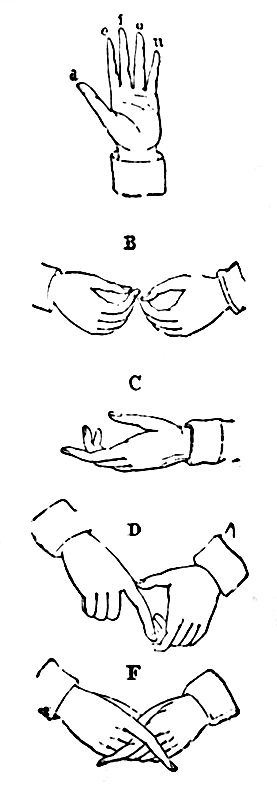


DECEMBER. According to the calendar of Romulus, this was the tenth month, as the word implies; but by the Julian calendar it was made the twelfth. Among the Romans this month was devoted to various festivals. On the 5th they kept the Faunalia; on the 17th the Saturnalia; on the 22nd, the Lararia; and on the last, the Juveniles Ludi. The peasants also kept the feast of the goddess Vacuna, after having got in the fruits and sown their corn. During this time all orders of the community were devoted to mirth and festivity.
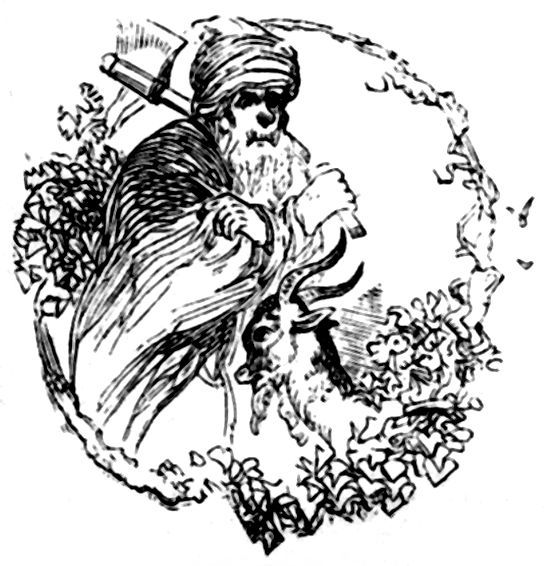
Masters and slaves were all on an equal footing. Friends sent presents to one another, and feasted together at the same table. The schools kept a vacation, and nothing was to be seen in the city but mirth and freedom.
Our Saxon ancestors called the month Winter Monath, but after their conversion to Christianity they called it Heligh Monath, or Holy month, in commemoration of the Nativity, which is always celebrated in this month. It was also called guil-erra, or the first guil; the feast of Thor, which was held at the winter solstice, being called guil from iol, or ol, which signified ale. This feast was even continued into January, and has been corrupted into yule.
Synonymes.—In Latin, December; French Decembre; Italian, Dicembre; Spanish, Diciembre; and in Portuguese, Dezembro.
As in our engraving, this month was represented by the ancients as an old man, with a severe and fearful countenance, clothed in a coarse frieze rug, girt upon him; his hands encased in fur gloves, and holding a hatchet, emblematical of the season, it being the time for felling timber. Instead of his head being surrounded by a garland, it appeared to be wrapped in three or four nightcaps, with a Turkish turban over them; his mouth and beard were clogged with icicles, and at his back was a bundle of ivy, holly and mistletoe, and at his side the sign of Capricornus, the goat, symbolical of the sun entering that constellation on the 21st.
The chronology of the month, replete with interesting records of past events, is subjoined.
1. Dr. Warren died, 1835.
2. Flaxman died, 1826.
3. Richelieu died, 1642.
4. Galvanism discovered, 1790—Mozart d. 1792.
5. Black died, 1799.
6. Nicholas.—General Monk born, 1608.
7. Dr. Aikin died, 1822.
8. Zimmerman, b., 1728.
9. Scheele born, 1742.
10. Royal Academy of Arts instituted, 1768.
11. Grouse shooting ends—Charles XII. k. 1718.
12. Sir J. Brunel, d. 1849.
13. Lucy.—Dr. S. Johnson died, 1784.
14. Washington, d., 1799.
15. Brera born, 1772.
16. Leopold, King of Belgium, born, 1790.
17. Sir H. Davy b., 1778.
18. Rubens born, 1577.
19. Tycho Brahe, b. 1588.
20. Gray born, 1716.
21. St. Thomas; Shortest Day.
22. Pott died, 1788.
23. Sir R. Arkwright, b. 1732.
24. Christmas Eve.
25. Christmas Day.
26. St. Stephens, Peyer born, 1653.
27. St. John.—Munro died, 1791.
28. Innocents.—Peter Bayle died, 1706.
29. John Wycliffe d., 1381.
30. R. Boyle, died, 1691.
31. St. Silvester.—Boerhaave born, 1668.
The East India Company incorporated, 1600.
The Red Letter Days of the month are as follow:—
6th.—“St. Nicholas.” He was Archbishop of Myra, in Greece, a.d. 302, and is regarded as the patron saint of children and mariners, and consequently churches built near to the sea are generally dedicated to this saint.
13th.—“St. Lucia” was a young lady of Syracuse, who died in the year 304, and was remarkable for the devout and charitable life she led.
21st.—“St. Thomas” is said to have travelled and promulgated Christianity among the Persians, Medes, Parthians, and Armenians, and that he met with his death by being stoned, and having darts thrown at him by the Brahmins, who were incensed at his preaching.
25th.—“Christmas Day.” This is kept as a solemn festival by our Church, and many curious customs prevail, which we have neither time nor space to describe, particularly as they are generally well known.
26th.—“St. Stephen.” This feast is held, according to Brady, “in consequence of St. Stephen having been the first who suffered for his steady adherence to the faith of Christ, so that his anniversary has been fixed immediately following the day held by the Church in commemoration of the Nativity of our Saviour.”
27th.—“St. John the Evangelist.” This feast is observed in commemoration of this evangelist, because he drank poison without dying in consequence.
28th.—“Childermas,” or “Holy Innocents’ Day,” is held in commemoration of the slaughter of the innocents by Herod, and is celebrated by the Church of Rome with masses. It is considered unlucky to begin any work upon this day.
31st.—“St. Silvester” was a pope, and is said to have been the author of several rites and ceremonies of the Romish Church, as unctions, palls, asylums, &c. He died in 334.
BODIES (REGULAR). The name of five solids, as the tetrahedron, or pyramid, with four triangular faces; the hexahedron, or cube, with six square faces; the octahedron, with eight faces; the dodecahedron, with twelve; and the icosahedron, with twenty faces.
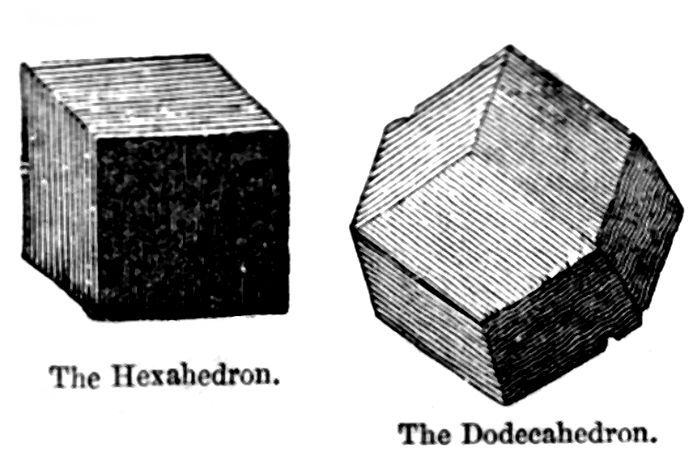
WILLS. Persons going to Doctor’s Commons to peruse wills are obliged to give their names, &c.: no questions whatever are asked—nor does the length of the will, or the time occupied in reading it, make any difference in the charge. Beyond the shilling paid on entering, there is no other demand whatever, unless for copying the whole, or a portion of the will. It may be as well to state, that there are many wills which are not lodged in Doctor’s Commons. Some are proved in the courts of the several bishops—Gloucester, York, Chester, for instance; and there they remain. The wills of all who resided in London or the neighbourhood, or who were possessed of money in the Funds, are proved in Doctor’s Commons; the wills of the wealthier classes are mostly proved there. In the country, and with small properties, the executors usually resort to the bishop of the diocese. Most of the wills, for instance, of shopkeepers, &c., who reside in Manchester, are proved in Chester. The same rules are observed in the country as in London with regard to examination, &c. The fee, one shilling, is the same in all. Having ascertained that the deceased left a will, and that it has been proved, the next inquiry is “Where was it proved?” The above explanation and remarks apply also to the administrations granted of the effects of those who died without wills.
In Doctors’ Commons the applicant will have before him the indexes of all the wills and administrations proved and granted for the last fifty years and more; and no one will interrupt his searching in any one or all of them. In the other courts in the country he would have to name a series of years—say from 1805 to 1815; and probably for a very long search there would be a small extra charge. As to the absence of the Christian name, there might be a slight difficulty; some registrars are more courteous than others. The best way will be to guess, if you can, at the right Christian name;—say that you are not certain about it, but you think it may be “William,” or “Ann,” or any other that you think. You will, however, have a right to search, whether you know or can guess at the Christian name or not; but your shilling will only give you permission to look at two wills. If, on looking at these, you find that neither of them is the one you wished for, you must, on asking to see a third will, pay another shilling.
LETTERS. The etiquette of letter-writing, should, as much as possible, be influenced by principles of truth. The superscription and the subscription should alike be in accordance with the tone of the communication, and the domestic or social relation of those between whom it passes. Communications upon professional or business matters, where no acquaintance exists to modify the circumstances, should be written thus:—“Mr. Gillot will feel obliged by Mr. Slack’s sending by the bearer,” &c. It is an absurdity for a man who writes a challenge, or an offensive letter, to another, to subscribe himself “Your obedient Servant.” We dislike this form of subscription, also, when employed by persons of equal rank. It is perfectly becoming when addressed by a servant to an employer. But in other cases, “Yours truly,” “Yours very truly,” “Your Friend,” “Your sincere Friend,” “Your Well-wisher,” “Your grateful Friend,” “Your affectionate Friend,” &c. &c., appear to us to be much more truthful, and to be more in keeping with the legitimate expression of good feeling. It is impossible to lay down a set of rules that shall govern all cases. But as a principle, it may be urged, that no person should address another as “Dear Sir,” or “Dear Madam,” without feelings and relations that justify the use of the adjective. These compliments are mockeries. No one who entertains a desire to write another as “dear,” need feel afraid of giving offence by familiarity; for all mankind prize the esteem even of their humblest fellows too much to be annoyed by it. And in proportion as the integrity of the forms of correspondence increase, so will these expressions of good feeling be more appreciated.
POSTAGE (PENNY). The uniform rate of one penny per half-ounce for letters came into operation on the 10th of January, 1840. The use of stamps, which formed one of the means suggested by Mr. Rowland Hill for facilitating the despatch of letters, was introduced on the 6th of May following.
CATHERINE WHEELS. In fireworks, an arrangement of tubes in the periphery of a circle, the reaction of the burning of which, against the air, occasions the wheel to revolve with a pleasing effect.
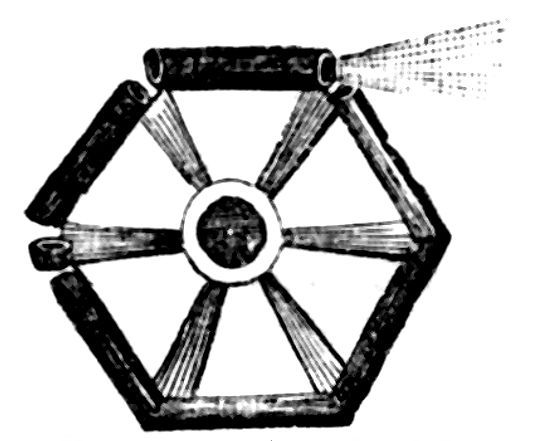
GAS. Gas was first evolved from coal by Dr. Clayton, in 1739. Its application to purposes of illumination was first tried by Mr. Murdoch, in Cornwall, in 1792. Sir Humphrey Davy, also a Cornishman, stated his opinion before a committee of the House of Commons, that it would be impracticable to light London with gas. We see his error. The first display of gas-lights was made at Boulton and Watt’s foundry, in Birmingham, on the occasion of the rejoicings for peace, in 1802. In 1805, gas was permanently used, to the exclusion of lamps and candles, at the cotton mills of Phillips and Lee, Manchester, where 1,000 burners were lighted, 1805. Gas lights were first introduced into London, at Golden Lane, August 16th, 1807; Pall Mall, 1809; and were general throughout London in 1814. The gas pipes in and around London extended to 1,100 miles.
PAINT (TO REMOVE THE SMELL OF). 1. Take three or four broad tubs (such, for instance, as hold about eight gallons), fill them with cold water; and put into each an ounce of vitriolic acid, which you can obtain from a druggist. Place these tubs near the wainscot, in a newly painted room. This water will absorb and retain the effluvium of the paint. Next day fill the tubs with fresh water, and add to each another ounce of vitriolic acid. Repeat this a third day, and on the fourth the smell of the paint will not be perceptible. 2. Another Method:—A bundle of old dry hay, wetted and spread about, presents a multifarious absorbing surface for this, especially if not on the floor only, but over pieces of furniture which allow circulation of air, as chairs laid upon their faces, &c. Large vessels of water, as trays and pans, are not uncommonly used with good effect; but the multiplied surfaces of the loose hay give it great advantage. It must be kept wet, however, or at least damp, for the oily vapour does not seem to be readily absorbed unless the air is kept moist by evaporation.
HANDKERCHIEF PERFUME. Grate to fine powder half a nutmeg; crush one quarter of an ounce of cloves; put these together into half a pint of the best pale rum, brandy, or spirits of wine. After three or four days’ maceration, add two drachms of oil of lavender, two drachms of essential oil of bergamot, one drachm of essential oil of lemons, half a drachm of otto of roses; then strain through a small piece of wadding placed in a funnel, or through blotting-paper folded to fit the funnel, and the mixture is ready for use. This “bouquet” will cost about four shillings, but is equal to any purchased from the perfumers at three times the price.
CASKS (TO SWEETEN). 1. When musty it is best to unhead large casks and white-wash them with quicklime. Or they may be matched with sulphur mixed with a little nitrate of potash, and afterwards well washed. Small casks may be sweetened by washing them first with sulphuric acid and then with clean water: afterwards let them be well swilled, until the foul smell disappears. Or, 2. Having first scalded it well with boiling water (letting the water stand in it till cold), fill it with cold water, and throw in a large quantity of live coals from a wood fire, leaving the cask uncovered. By repeating this, the cask may be made perfectly sweet, provided that it has at no time contained fish. A fish barrel can never be used for any other purpose, as it is impossible to expel the taste and smell of the fish. Scalding an old cask repeatedly in strong lye, and then with clear water, will generally sweeten it; so will boiling water in which potash and lime have been dissolved.
NAVAL OFFICERS & NAVAL TERMS. Lord High Admiral of England was an officer of such great trust, that it was deemed imprudent to appoint any subject to this station. The Board of Admiralty takes cognizance of every thing transacted at sea, the management of all maritime affairs, direction of the Royal Navy, and both civil and criminal offences committed on the high seas.
Admiral, a great officer, or magistrate, who has the government of a navy, and the hearing of all maritime causes. Though there is some doubt as to the origin of this officer, the most probable opinion is that of Sir Henry Spelman, who thinks that both the name and dignity were derived from the Saracens, and by the holy wars, brought amongst us; for admiral, in the Arabic languages, signifies a prince or chief ruler. Du Cango says that the Sicilians were the first, and the Genoese the next, who gave the denomination of admiral to the commanders of their naval armaments. Some think it was introduced amongst us in the reign of Edward I., or according to others of Henry III. Before the use of the word admiral was known, the title of custos maris was made use of. The admiral carries his flag at the main-topmast head.
Vice-Admiral commands the second squadron, and carries his flag at the fore-topmast head.
Rear-Admiral is the commander of the third squadron, and carries his flag at the mizen-topmast head. The ranks and station of these admirals are also distinguished by the colour of their flags: hence there are admirals, vice-admirals, and rear-admirals of the white, the blue, and the red, the colour indicating the seniority in the respective ranks.
Captain of a Ship of War is the officer who commands a ship of the line of battle, or a frigate carrying twenty or more cannons. The charge of a captain in her Majesty’s navy is very comprehensive, as he is not only answerable for any bad conduct in the military government and equipment of the ship he commands, but also for any neglect of duty, or ill-management in his inferior officers, whose several charges he is appointed to superintend and regulate.
Captain of a ship, either of war, or of a trading vessel, is the commanding officer. In a merchant’s ship the officer to whom the direction is committed is sometimes called master, and in the Mediterranean the master is frequently called patron. The master of a ship of the line is properly the sailing captain, who takes cognizance of everything respecting steering, keeping the ship’s log, taking the sun’s altitude, &c. &c.
Pilot, from prorita, is he who governs the prow or head, or from the old French pile, ship, as some suppose. A person who conducts a ship into a road, harbour, or through intricate channels. He is the second person in the ship. There are two kinds: the one an officer who takes altitudes at sea, uses the quadrant, and watches the compass. The other is a coasting pilot, and is occasionally called in on coasts and shores unknown to the master.
Midshipman is appointed by the captain of a ship of war, to second the orders of the superior officers, and assist in the necessary business of the vessel, either aboard or ashore. A first-rate man-of-war has twenty-four midshipmen, and the inferior rates, a suitable number in proportion. No person can be appointed lieutenant, without having served two years in the Royal Navy in this capacity, or in that of mate, besides having been at least four years in actual service at sea, either in merchant ships or in the Royal Navy.
Purser, is an officer on board a man of war, who receives her victuals from the victualler, and is to take care that it be in good condition and well laid up. He also keeps a list of the men and boys belonging to the ship, and sets down exactly the day of each man’s admittance into pay, that the paymaster or treasurer of the navy may issue out his disbursements, and pay off the men according to the purser’s book.
The Steward receives all the victuals from the purser, sees it well stowed in the hold; all things belonging to the ship’s use are in his custody; he looks after the bread, and distributes out the several messes of victuals in the ship.
The Victualler is he who furnishes the ship with victuals or provisions. For furnishing her Majesty’s navy with victuals there is a victualling office on Tower-hill, managed by seven commissioners, who have their inferior officers or secretaries, clerks, &c. besides agents in different parts of the kingdom.
Clerk of a merchant ship, is an officer appointed to take care that nothing be squandered needlessly: he is obliged to keep a journal and an inventory of every thing in the loading of the vessel; as the rigging, apparel, arms, provision, merchandises, the names of the passengers, the freight agreed on, a list of the crew, their age, wages, &c. The bargains, purchases, and sales the ship makes from its departure; the consumption of provision, and, in short, every thing relating to the expense of the voyage. In small vessels the master or pilot does the office of clerk. In ships of war, the captain’s clerk is appointed to keep the ship’s accounts, with the captain’s letters, &c.
Corporal of a ship, or, as he is more generally called, “Ship’s Corporal,” is a second class working petty officer, and is under the Master-at-Arms; the latter is also a petty officer, and is chief of the police in a vessel of war.
Marines having nothing to do in working the ship, their duty is merely to defend it in war, and attack the enemy when fighting. There is generally a company on board each ship, about forty in number, under a captain and two lieutenants. And there are seventy companies of marines in the whole. In a sea-fight their small arms are of very great advantage in scouring the decks of the enemy, and when they have been long enough at sea, to stand firm when the ship rocks, they must be infinitely preferable to seamen, if the enemy attempts to board, by raising a battalion with their fixed bayonets to oppose them.
Officers of the navy are, the Treasurer who receives moneys out of the exchequer, to pay all the charges of the navy. The Comptroller who attends and comptrols all payments of wages, knows all the rates of stores, examines and audits all accounts. The Surveyor knows the state of all stores, sees all wants supplied, estimates repairs, &c. and at the end of each voyage, audits and states all accounts. The Clerk of the Acts records all orders, contracts, bills, warrants, &c. There are also several Commissioners of the navy.
Navy-Bills, or victualling bills or orders for the payment of money issued by the commissioners of the navy on the treasury of the navy, for stores purchased at the rate of 4½ per cent, after six months from the date of their being registered at the respective offices: and they have generally been paid off within eighteen months or two years from the time of their being issued.
The privileges conferred on sailors are much the same as on soldiers, with regard to relief, when maimed, wounded, or superannuated. The Greenwich hospital receives such seamen as are disabled from further service, and provides for the widows and children of such as are killed. The hospital is supported by Government, and by sixpence a month out of every seaman’s wages. No seamen on board her Majesty’s ship can be arrested for any debt unless the same be sworn to amount to at least twenty pounds, though a soldier may be arrested for a debt which extends to half the sum.
POULTICE (BREAD-AND-WATER, OR EVAPORATING). Scald out a basin, for you can never make a good poultice unless you have perfectly boiling water; then having put some into the basin, throw in coarsely-crumbled bread, and cover it with a plate. When the bread has soaked up as much of the water as it will imbibe, drain off the remaining water, and there will be left a light pulp. Spread it a third of an inch thick on folded linen, and apply it when of the temperature of a warm bath. It may be said that this poultice will be very inconvenient if there be no lard in it, for it will soon get dry; but this is the very thing you want, and it can easily be moistened by dropping warm water on it, whilst a greasy poultice will be moist, but not wet.
A poultice thus made is, to the surgeon, what well-made stock is to the cooks, a foundation to be seasoned or medicined with laudanum, or poppy-water, with carrot or horse-radish juice, or with decoctions of herbs, with which the patient or the doctor may be inclined to medicate it, instead of loading an already irritable and very sensitive part with a heap of hard poppy-shells, or scraped carrots, or horse-radish, called poppy, carrot, and horse-radish poultices, but which increase rather than allay the sufferer’s pains.
When vegetables are used to medicate poultices, they should be bruised, put into a pot, covered with water, and simmered for about half an hour. The liquid is then to be strained off, and mixed with bread-and-water or linseed to the consistence of a poultice.
MUSHROOMS, (TO DISTINGUISH FROM POISONOUS FUNGI). 1. Sprinkle a little salt on the spongy part or gills of the sample to be tried. If they turn yellow, they are poisonous,—if black, they are wholesome. Allow the salt to act before you decide on the question. 2. False Mushrooms have a warty cap, or else fragments of membrane, adhering to the upper surface, are heavy, and emerge from a vulva or bag: they grow in tufts or clusters in woods, on the stumps of trees, &c., whereas the true mushrooms grow in pastures. 3. False mushrooms have an astringent, styptic, and disagreeable taste. 4. When cut they turn blue. 5. They are moist on the surface, and generally—6. Of a rose or orange colour. 7. The gills of the true mushroom are of a pinky red, changing to a liver colour. 8. The flesh is white. 9. The stem is white, solid, and cylindrical.
DIVIDING, POWDERING, GRINDING. The operations of chopping, powdering, grinding, &c., are so frequently required in cooking, and the other branches of domestic economy, as to render any description of their utility wholly unnecessary; and we may therefore confine ourselves to describing the best means of accomplishing the object desired. Powdering is usually performed by the aid of the pestle and mortar. By far the best material for the purpose is the Wedgewood ware; mortars made of it are cheaper, cleaner in use, and stronger than those of marble, and are not corroded by acids or alkalies—their pre-eminence is so great, that they are invariably used by druggists.
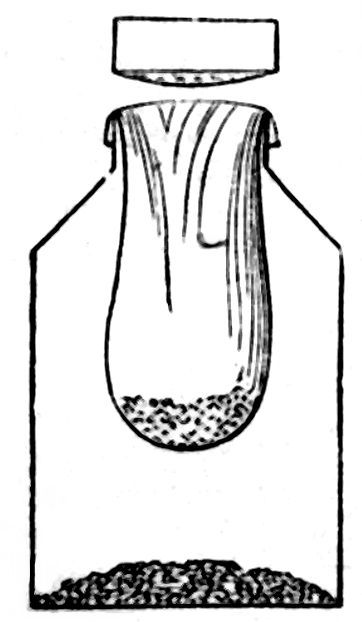
The act of powdering requires great tact and practice to perform it neatly and rapidly. After the object has been broken into small pieces by blows from the pestle, a grinding action is required; this should at first be given by striking the fragments, not in the centre of the mortar, but towards the side furthest from the operator; the pestle, by this means, grinds over them in its descent to the centre, and much more rapidly accomplishes their division than if mere blows are given. After the object has been divided to a certain extent, blows are entirely useless, and a grinding in circles becomes requisite; if the circle is confined to one part of the mortar, the same portions get rubbed over and over again, the others escaping; this is avoided by constantly and regularly altering the size of the circles. If they are commenced in the centre, they should gradually increase in size until the sides are reached, and then contract again, and so on. By this means, the whole of the powder is brought under the action of the pestle, and the operation is thus much quicker than if performed at random. One great fault usually committed in powdering, is the endeavour to operate on too large a quantity of material at one time. The operation is much more rapidly conducted if small portions are taken; and if the material is tough, and contains much fibrous matter, the process may be very much shortened by removing those parts which are sufficiently powdered, by sifting from time to time through a sieve. This may be objectionable, however, from the fine powder escaping into the air. In this case, the following contrivance will be found useful:—A cylindrical tea-canister of the requisite size is taken, with a loosely-fitting lid (or if tight, the lid may be enlarged by four slits being made partly up the sides); a bag of lawn is dropped into the canister, the top being turned over the edge; the powder to be sifted is put in the bag, the lid put on, and, by tapping and shaking, the finest portions pass into the canister without any escaping into the air.
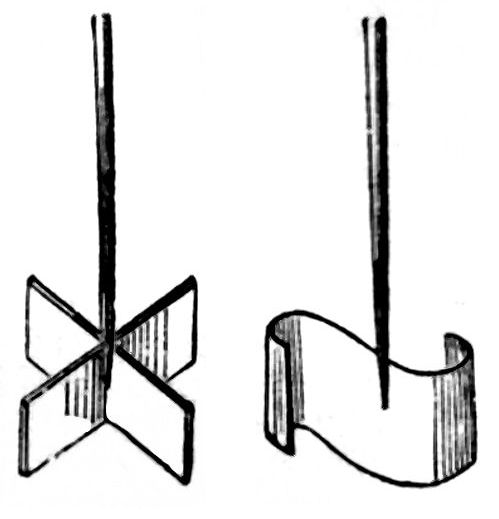
Chopping is usually performed in the kitchen, with a large common knife; but is more speedily done by some of the improved contrivances similar to the following:—The chopping-board should be made of hard wood, with the grain at right angles to the surface of the board, by which it is rendered much more durable than if they are parallel to it. The chopping-knives should be fixed at right angles to the handles, and may be either of the following patterns. If a large quantity of material has to be acted on, we would recommend a board as above, not less than three inches thick, and smooth on both sides, so that either may be used, of the requisite size—say, eighteen inches or two feet in diameter. On this should stand a loose bottomless tub, to confine the materials, and the whole resting on the floor, should be used with a knife, sufficiently long in the handle to be employed by a person standing erect, and it should have a small cross-bar for the hands, as shown in the figure below.
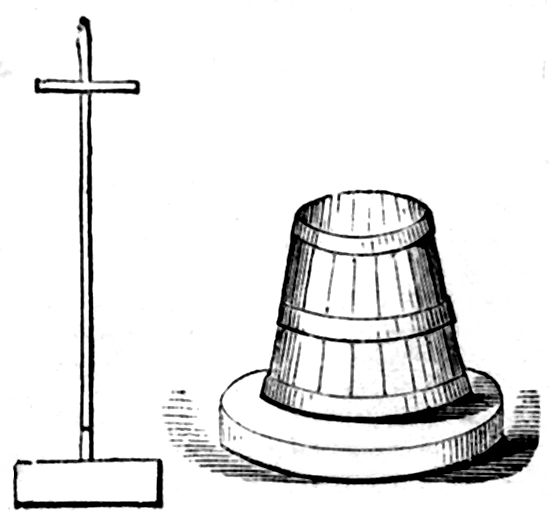
Small chopping-knives are sold, consisting of three blades rivetted together, and a very convenient one is made by fastening, at convenient distances a number of flat circular discs, sharpened at the edges, on to a central axis with a handle at each end.
Many substances, such as stale bread, dried herbs, &c., may be very conveniently powdered by rubbing them through a wire sieve, of the requisite degree of fineness. Herbs intended for use in this way, should be dried as rapidly as possible, without being scorched, in small heaps, before the fire; parsley and others done this way, may be powdered, retaining their bright green colour, and flavour, both of which are preserved, if they are corked tightly in bottles, and kept in a dry dark cupboard. The use of waxed paper to preserve dried powders in, or for tying them down in jars, or generally as a very good substitute for bladder, will often be found convenient. It is readily made by laying a sheet of smooth stout paper on a warm iron plate, as the top of a kitchen oven; on this place the thin tissue or other paper to be waxed; put a piece of wax on it, and as it melts rub it over, spreading it evenly. One end of a cork, covered with two thicknesses of linen, answers very well for a rubber. If a hot plate is not at hand, the sheet of paper may be held before the fire, and rubbed over, as it warms, with the cut edge of a cake of white wax; but this requires the co-operation of two persons.
FOOLS’ DAY. The 1st of April is termed All Fools’ Day in consequence of the almost universally prevalent custom of people trying to make fools of each other on that day. This ridiculous custom prevails, not only in England, but also in Scotland, Germany, Sweden, and France: in the latter country the “fools” are called poissons d’Avril, or April fishes. No satisfactory origin has been assigned for this ancient custom, although many conjectures have been offered; such as, that it alludes to the mockery of the Saviour by the Jews: that it arose from the stratagem practised by the Romans to obtain wives from the Sabines, when Romulus invited the latter to the celebration of certain games in honour of Neptune, at the beginning of April, and the Romans seized and carried off the Sabine damsels, who had been imposed upon by being invited with a mere pretence: that the ancient feast of the vernal equinox, the 1st of April, was formerly celebrated, equally in India and Britain, as a high festival in which unbounded mirth prevailed: that as great festivals were wont to continue eight days, the 1st of April, being the octave of the Feast of the Annunciation, may be supposed to have been employed in fool-making, all other sports having been exhausted in the preceding seven days: and that it is derived “from the mistake of Noah sending the dove out of the ark before the water had abated, on the first of the month among the Hebrews answering to our 1st of April; and to perpetuate the memory of this deliverance, it was thought proper, whoever forgot so remarkable a circumstance, to punish them by sending them upon some sleeveless errand similar to that ineffectual message upon which the bird was sent by that patriarch.”
BALLOON. A globe made of silk, and rendered air-tight by gum, which, when filled with hydrogen gas, from 10 to 13 times lighter than atmospherical air, ascends into the atmosphere, and will convey heavy bodies suspended to it. The ascent in a balloon is a magnificent spectacle; but, owing to mismanagement, they have often produced fatal accidents. The first balloon ascended at Paris, in 1782; and in London, in 1784.
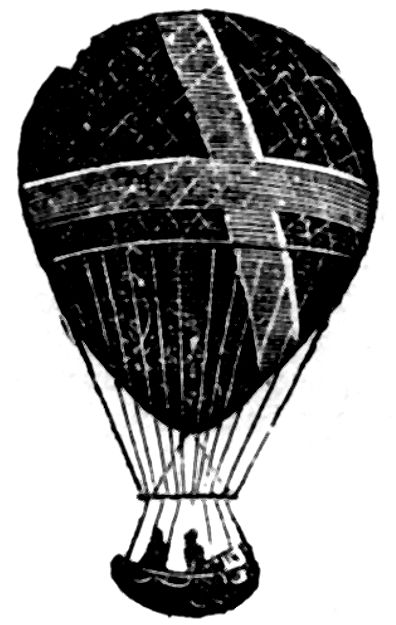
AZURE. In heraldry the blue colour used in coats of arms, expressed in engraving by horizontal lines.
MEDICINE, (THE NAUSEOUS TASTE OF, PREVENTED). By chewing aromatic substances, such as orange or lemon peel, cloves or other spice, before taking medicine, little or no taste will be perceived. The mouth can also be thus prepared beforehand by a peppermint lozenge, or even a lump of sugar. 2. Dr. Polli recommends a means, founded on the physiological fact that a strong impression on the nerves (whether of vision, hearing, or taste), renders that which follows less perceptible. Instead of applying to the mouth, therefore, agreeable substances after swallowing nauseous medicines, we should prepare it before, in order that the taste of the medicine may not be perceived.—Aromatic substances, chewed just before, or orange or lemon peel, effectually prevent castor oil from being tasted. In preparing the mouth for bitters, liquorice is the only sweet that should be used, the others creating a peculiarly disagreeable compound taste.
ANATOMY. The art of dissecting a body, and examining the parts of which it is composed. It is generally applied to the examination of animals, and it has discovered the following circumstances of their structure.
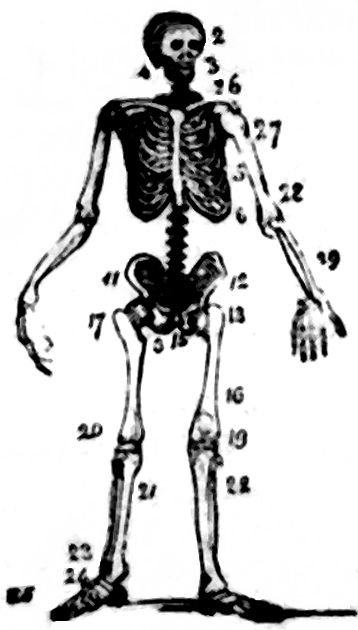
1st. A system of bones, displayed in the engraving, which in the human subject amount to 240; 2. Cartilages or gristles, which unite the bones, and contribute to their motion, assisted by ligaments, membranes, and bundles of muscles, called flesh, all relating to the strength and motion of the animal. Anatomy also discovers nerves, or white threads, which extend from the brain and the spinal marrow through all the organs, and are the means of sensation, and instruments of the will. It appears, also, that the body is sustained and warmed by means of blood flowing from the heart through the arteries, to every part of the body, and brought back by veins. There is also a stomach for digestion, and glands for separating and assimilating the element; and intestines to carry off what is not appropriated. The whole is a wonderful system, and a most interesting object of study.
1. The cranium.
2. The os frontis.
3. The orbits of the eyes.
4. The superior maxilla.
5. The inferior ditto.
6. The true ribs.
7. The false ribs.
8. The sternum.
9. The unciform cartilage.
10. The lumbar vertebræ.
11. The ilium.
12. The os pubis.
13. The os sacrum.
14. The symphysis pubis.
15. The femur.
16. The head of the femur.
17. The trochantes major.
18. The patella or kneepan.
19. The condyles of the femur.
20. The tibia.
21. The fibula.
22. The tarsus.
23. The metatarsus.
24. The foot.
25. The clavicle.
26. The scapula.
27. The humerus.
28. The radius.
29. The ulnus.
30. The carpus.
ATMOSPHERE. The fluid or gas which we feel on passing our hand through it, and whose force is visible in a high wind. It is 820 times less dense than water, but its elastic pressure or reaction is equal to 15 lbs. to the square inch, which is also the weight or action downward; and it is composed of about one part oxygen, and four parts nitrogen or azote. All space is filled with gas, but the passage of the earth through it, and its rotation at the same time, condenses the rare gas of space into an atmosphere, which at the surface of the earth is such as we find it, but is rarer and rarer as we ascend, till at the height of forty-five miles, it no longer reflects light; nor is it capable of keeping clouds in suspension above two or three miles. The energy of the oxygenous part of the atmosphere transferred is the cause of fire, combustion, animal heat, and life. In volume the atmosphere consists of 79 parts of azote or nitrogen; of 21 of oxygen, of 1.33 of aqueous vapour, and of 0.1 of carbonic acid. In weight, 76.6 of azote; 23.3 of oxygen; 0.83 of aqueous vapour; and 0.15 of carbonic acid gas.
ARCHITECTURE. The art of proportionally erecting buildings according to plans and models supplied by rules of science, uniting outward ornaments with interior conveniences. It embraces erections for civil, military, and naval purposes. Civil architecture has various modes of decoration, derived from the practice of various nations and different ages, called styles of architecture. Of these the Roman or Italian has been reduced to a system of decoration by columns, called orders.
1. The Tuscan, (from Tuscany,) or most simple.
2. The Doric, (from Dorians, Greece,) durable and noble.
3. The Ionic, (from Ionia,) a mean between the plainness of the Doric and the elegance of the Corinthian.
4. The Corinthian, (from Corinth,) most noble, rich, and delicate.
5. The Composite, (compounded of parts of the other,) is much like the Corinthian.
The style called Gothic was most extensively used after the decline of the Romans, and first adopted in the erection of churches about the tenth or twelfth century, and distinguished by its pointed arch.
BLOOD. The blood takes its origin from the chyle, which is produced by the digestion of food in the stomach. It may take from three to seven hours to convert elementary substances into blood. As the blood circulates, it deposits nourishing particles in its course, and thus repairs the tissues to which it is supplied. It also removes those matters resulting from decomposition consequent upon vital action. Every particle of the body has a life and death independent of the life and death of the general system. And the body of man really lives and dies many times in the course of what is termed a life. Such is the rapidity of the circulation, that if the blood flowed at an equal rate in a straight line, it would run through one hundred and fifty feet in one minute.
ATHWART. A sea phrase, signifying across a ship or the line of her course.
GALVANIC COILS. A cheap and effective galvanic coil for invalids may be constructed as follows:—AB is a rectangular piece of board, upon which is fixed vertically a hollow cylinder of wood, CD, wider at the bottom, like a reel, but not quite so wide at the top. Inside this cylinder is dropped a piece of bar iron, E, which rises slightly above its surface. On one side is a brass upright, F, from which proceeds a piece of watch-spring, H, having at its end a small cone of iron which nearly touches the bar, E. On the opposite side is an upright of brass, G, from which proceeds a flat piece of brass, I, through which passes a brass screw, J. having at its extremity a small piece of platinum, which comes in contact with another small piece of platinum fixed on the watch-spring, H. Round the wooden cylinder, CD, is wound some covered copper wire (No. 12 or 14) nine times (more or less as the number of powers required) at right angles to its axis, so as to constitute nine helices, which are connected, and together form one helix continued within itself. The interior is the first, the exterior the last helix.
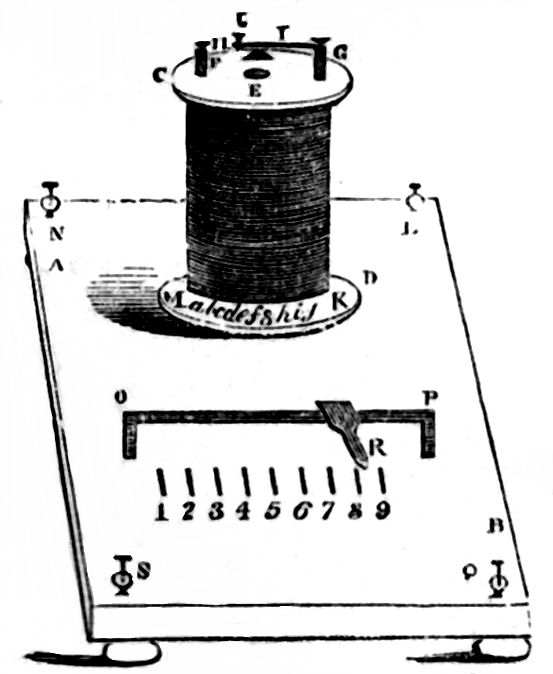
The winding of the wire should proceed from the top of the cylinder, leaving a piece about one foot in length, which, passing down laterally between the interior of the first helix and the wooden cylinder, and emerging at bottom, is pushed through a hole at K, passed under the board, and connected with the bottom of a binding screw, L. The last coil of the first helix is then laid bare, by removing the covering away a little at each side; and to this is fixed a piece of uncovered copper wire, which is pushed through a hole at a, and connected under the board with an upright piece of brass wire, 1. The top of the second helix is next laid bare, and connected in a similar manner with the upright piece of brass, or power, 2, by a piece of copper wire passing downwards between its interior and the exterior of the first helix, and through a hole at b. And so from top and bottom alternately, are the remaining helices connected with the other powers; thus, the bottom of the third helix through the hole at c, with the 3rd power; the top of the fourth, &c.; until the top of the eighth is connected with the 8th power. Then the exterior end of the continued helix, which is the bottom coil of the ninth helix, is passed through a hole at i, and connected with the bottom of power 9; which power is also connected, by a wire passed upwards through a hole at j, then along the outside of the helix and through the top of the cylinder, with the bottom of the upright G. The binding screw N is similarly connected, through a hole at M, with the upright F. The wire which passes under the board from N to M is joined in the middle to another piece of wire connected with the bottom of the binding screw S. Between the cylinder and the powers is fixed a piece of brass wire, OP, bent twice at right angles, the bottom of which is connected with the binding screw Q. This brass wire has a moveable piece of brass, R, which may glide along it, and rest on either of the powers required. The coil should be covered with leather, the bottom of the board with baize. Care should be taken that there be no metallic contact any where, except in the parts mentioned. The coil is then complete; its expense is 16s. L and N are screws for battery, S and Q for patients. In galvanizing invalids it is a matter of primary importance that the cross current should have the same direction as the nervous fluid. It is a forgetfulness of this which renders futile the attempts of many galvanists. Again, the instruments sold by philosophical instrument makers have generally two continued helices, in one of which the voltaic circuit is completed, in the other a current is induced, which is utterly useless as a remedial agent.
DAMP WALLS. When damp walls proceed from diliquescence in the case of muriate of soda in intimate combination with the sand used for the mortar, it is merely necessary to wash the wall with a strong solution of alum. This converts the diliquescent salt into an efflorescent one, and the cure is complete; or alum may be added to the plaster in the first instance.
SICK ROOMS (TO FUMIGATE). The chlorine fumigation is generally considered the best for fumigating the apartments of the sick. To prepare it, mix together equal parts of powdered oxide of manganese and common salt; put one ounce of this powder into a basin, and pour on it a large teaspoonful of water; then drop into the vessel about thirty or forty drops of oil of vitriol, which may be repeated at intervals for about three or four times. This will be sufficient for the perfect exhaustion of the powder.
DYEING (ART OF). The discovery of it is attributed to the Tyrians. In dyeing and dipping their own clothes, the English were so little skilled, that their manufactures were usually sent white to Holland, and returned to England for sale. The art of dyeing woollens was brought from the Low Countries in 1608. “Two dyers of Exeter were flogged for teaching their art in the north” (of England) 1628. A statute against abuses and dyeing was passed in 1783.
HEAT AND COLD. Cold is the absence of heat; and heat is a peculiar influence of which we can only judge by its effect.
There are two states in which we find heat. In the one case we recognize it by the touch, in the other we cannot find it out by such means. The air has a very large quantity of heat hidden in it, even when it seems coolest to you. It contains so much heat, even in the depth of winter, that the quantity contained in a few square inches, if squeezed out, is sufficient to light a piece of tinder.
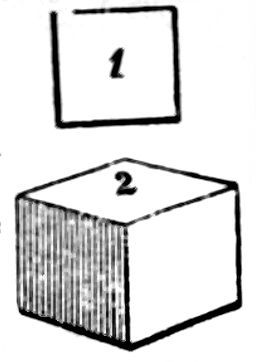
We have drawn here a figure of a solid square, or cube, that we may be fully understood. Each face has four edges, as in fig. 1, and there are six faces to the solid square, as in fig. 2. Now if you had a vessel which would hold about twelve square inches or cubes of air, and could so manage as to squeeze it into the size of one square inch, so much heat would be given out that a piece of tinder would be set on fire by it.
If you procure a piece of thick iron wire, and hammer the end of it on an anvil or hard stone, you will find that after a few blows it has become very hot. You have compressed the particles of the iron, and the latent, or hidden, heat, has become sensible to the touch. The heat kept the particles or atoms of iron apart from each other; but when you have hammered them close, your hammering will produce no more heat. There is only a certain quantity of juice to be squeezed out of an orange, and so the quantity of heat in the iron is limited. You have learned by this experiment, which any one may perform with a piece of soft iron wire, that heat has a tendency to separate the particles of which bodies are composed, and make them larger. This separation is called expansion. A bar of iron, when heated, becomes longer; and hence, if the iron pieces or plates upon which the wheels of the railway engines run were to be placed in winter with their ends close against each other, they would be so expanded by the warmth of the sun in summer, that they would become crooked, and the line would be unsafe to travel upon. This expansion of bodies by heat is taken advantage of by persons who wish to measure sensible heat.

Thermometers are constructed of bodies which are readily expansible by heat. Those commonly in use are made of quicksilver shut up in glass. The glass tube is mounted on a piece of bone or ivory, which bears the marks of degrees, so that the amount of expansion or contraction of the quicksilver can be stated or registered. There are various forms of heat measurers or thermometers, and I will explain to you how to construct a simple one. Take a wide-mouthed bottle, pour into it a teaspoonful of ink, and two tablespoonfuls of water, and set it upon the table. Having procured a glass tube, which has been blown into a bulb at one end, warm it thoroughly before the fire, and then rapidly place it in the bottle, so that the open end is plunged into the ink and water at the bottom.
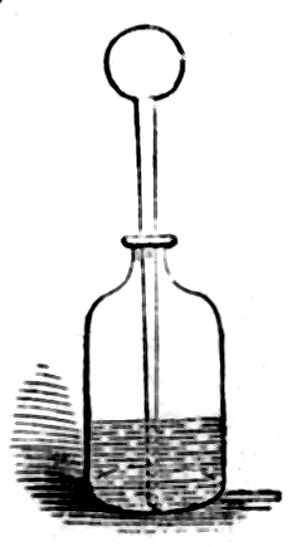
In a second or two the air in the round bulb of the tube will begin to contract, and the inky water will ascend the tube, and perhaps rush into the bulb. When all upward motion in the water has ceased, place your hand upon the bulb, and you will then, by warming the air inside, cause it to expand, and the water in the tube will again descend. Pure water would answer as well as the mixture of ink, but the latter is more easily seen as it ascends and descends the tube.
If you place the bulb and bottle near the fire, the air in the bulb will be expanded still further. Your thermometer just shows that heat has been taken from the fire and combined with the air in the bulb. But how was the heat conveyed from the fire to the bulb? By what means was it communicated?
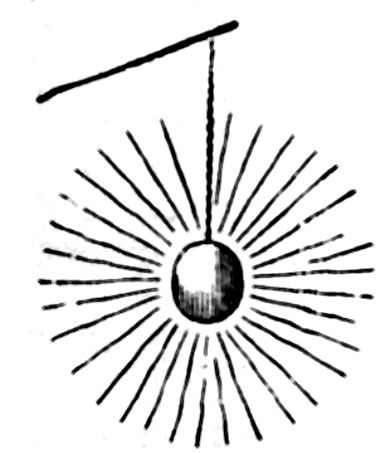
Heat is conveyed in two different manners. A heated globe of iron, if suspended in the air, would send out rays, or straight lines of heat, in every direction, as in this diagram. When heat is given off and conveyed to another body by rays in this manner, it is said to be by radiation. To illustrate the other mode in which heat travels, hold the end of a piece of iron wire, of three inches in length, in the flame of a small taper. The radiated heat from the flame you will scarcely feel, but the heat will be speedily conducted to your fingers along the wire, which will become so hot that you will scarcely be able to hold it. When heat is thus conveyed by a metal or other solid body from a fire or flame to any other body, it is said to be by conduction.
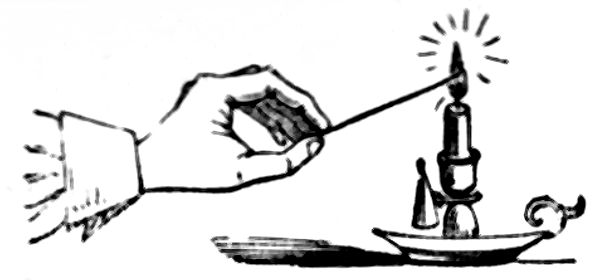
Metals conduct heat rapidly, and hence metal tools which require to be used while hot have the handles covered with wood, which does not allow the warmth to pass from the iron to the hand of the workman. You could hold a piece of wood of much shorter length than the wire, in the taper’s flame, and feel no inconvenience. These circumstances prove that wood does not conduct or convey heat as rapidly as iron; it is therefore said to be a bad conductor; in other words, its power of transmitting warmth is small. Woollen cloth is a still worse conductor; and for that reason, when the flat iron is used by the laundress, she protects her fingers with a piece of folded flannel, which does not allow the heat from the handle of the iron to burn her hand.
You have seen how the air is expanded by heat, and contracted by cold; it is important, moreover, to understand, that in a cubic inch of cold air there are more particles than in a cubic inch of heated air.
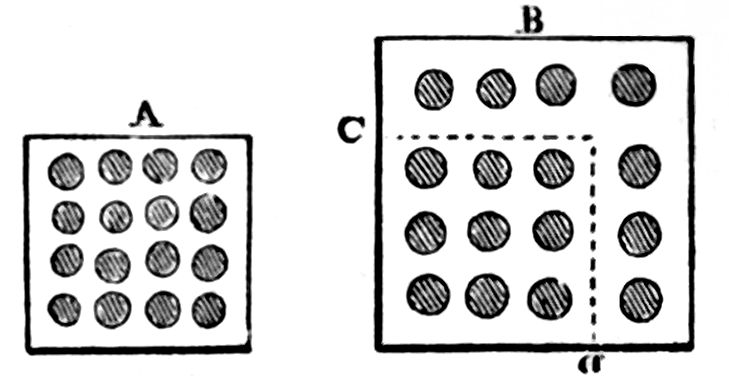
The figure A represents a cold cubic inch of air, which we will suppose contains sixteen atoms or particles, of air. If to this be applied a very small quantity of heat, it would expand to the size of B, without any increase of the number of particles, or in its weight. A cubic inch (as indicated by the dotted lines C and D), would then only contain nine atoms or particles of air.
If the cold cubic inch weighed sixteen grains, the hot cubic inch would only weigh nine. If bodies are expanded by heat, they contain fewer particles in a given space; if they are contracted by the removal of that heat, they contain more particles in the same space. Some of these particles would be oxygen and some nitrogen, always bearing the same proportion.
CENTRE OF GRAVITY. As the reaction of every body to every force is directed from the centre of the masses, so bodies subject to centripetal force re-act from their centres, and, if these are not supported, the body yields or falls. Hence, as in the engraving, when the centre of the mass is within the perpendicular of the wheels, it does not yield; but if so inclined as that the perpendicular from the centre falls beyond the wheels, then the centre falls, and the carriage is overset. In cases of danger, therefore, as in a boat or carriage, the object should be to lower the centre of the mass by lying down.
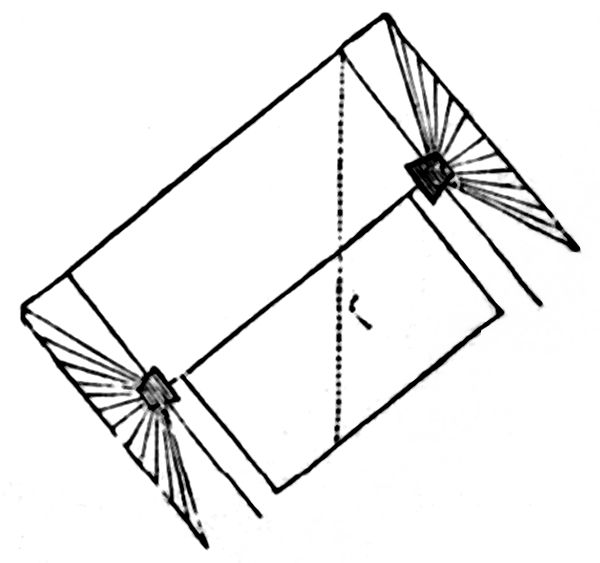
CARDINAL VIRTUES. Industry, Perseverance, Benevolence, Temperance.
CARDS. Toys with which many games of chance are played, there being four kinds, and 13 of each kind, so as to cause by shuffling and dealing, an infinite variety of combinations, and afford inexhaustible amusement; which, if not abused by large stakes, is, at least, an innocent mode of passing time among idle persons, and of relaxation among others of serious pursuits. They were invented in the age of Edward III. and their costume and mode of manufacturing by block-printing are continued to this day. In truth, the making of them must have suggested the art of block-printing to the first printers, the one being but a slight variation of the other.
CHAPLAIN. A person in holy orders who does the duty of a chapel; for his own chapels, the king has 72 chaplains, and by law, an archbishop may have 8; duke or bishop 6; a marquis or earl 5; a viscount 4; a baron 3; and a peeress 2; each of whom, as such, enjoys certain clerical privileges.
STILL. An apparatus for vaporising compound fluids, and re-condensing the vapours of each of the component parts as they are successively raised by heat; it consists of an alembic, a worm, a refrigerator, and a receiver.
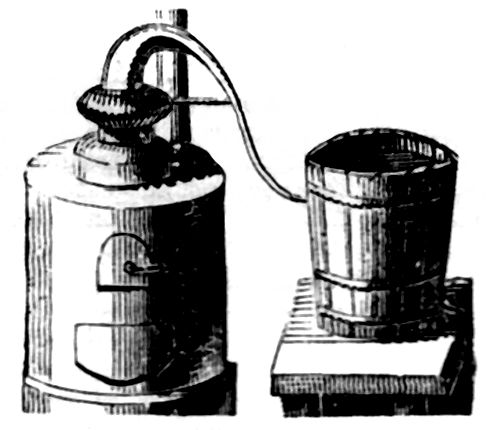
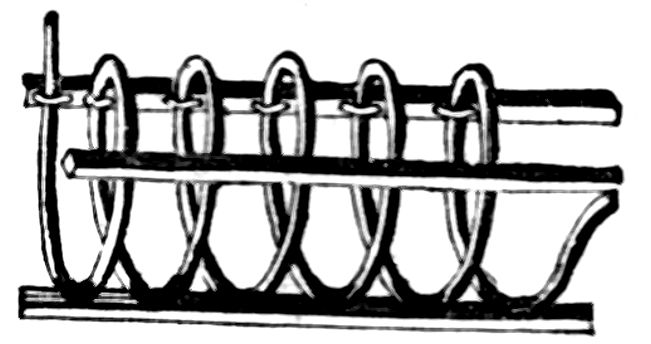
Worm of a Still.
CINQUE PORTS. Five ancient ports of England endowed with privileges, as Dover, Hastings, Romney, Hythe, and Sandwich with Winchelsea and Rye.
BEEF-EATERS. The term “Beef-eaters” is a corruption of the French buffetiers, (from buffet, meaning sideboard.) The French buffetiers were guards who stood around the sovereign at dinner; and the word has been corrupted gradually to “Beef-eaters,” which is now applied to the yeomen of the guard of the Queen of Great Britain. They are stationed by the sideboard at great royal dinners, and are dressed after the fashion of the time of Henry VIII.
BOUTS-RIMES. This is a species of amusement generally known in France. It is pronounced “boo-rema.” A number of words that rhyme are given to a composer, who is to fill up the verse, producing good sense, and keeping the words in their stated order. Thus:—
| dark. | where. |
| around. | strife. |
| hark. | drear. |
| sound. | life. |
| shrill. | bright. |
| still. | night. |
Now, it would require considerable skill for any one to take the above and present them, in their present order, in a perfect composition. Yet it may be done:—
’Tis night; the mourning vest of nature—dark
And gloomy is the starless sky; around
A melancholy stillness reigns; but hark!
’Tis but the hooting owl. A sound
Again breaks on the silence: ’tis a shrill
Cry from some churchyard; all again is still.
Where now the grandeur of creation! Where
The crowds that mingle in the busy strife?
All’s now a dismal chaos, lone and drear,
Rayless and black. And thus it is with life—
Awhile the scene is beautiful and bright;
Then comes one deep, and dark, and cheerless night.
KNIVES AND FORKS. Handles of ebony should be cleaned with a soft cloth dipped in a little sweet oil; and after resting awhile with the oil on them, let them be well wiped with a clean towel. Ivory or bone handles ought to be washed with a soaped flannel and lukewarm water, and then wiped with a dry towel. To preserve or restore their whiteness, soak them occasionally in alum-water that has been boiled and then grown cold. Let them lie for an hour in a vessel of this alum-water. Then take them out, and brush them well with a small brush (a tooth-brush will do), and afterwards take a clean linen towel, dip it in cold water, squeeze it out, and while wet wrap it round the handles, leaving them in it to dry gradually,—as, if dried too fast out of the alum-water, they will be injured. If properly managed, this process will make them very white.
CALISTHENIC EXERCISES. Use of Calisthenics. It is an admitted physiological fact, that imperfections in the female form originate, for the most part, in defective or irregular muscular action. The calisthenic exercises are calculated to cure deformities of the figure, especially of the chest, to invigorate the system, and conduce to elegant deportment and symmetry of form.
Preliminary Cautions. 1st, that they should not be performed after a full meal; 2nd, that there should not be any ligatures or tight strings, straps, &c., on any part of the body, but that the clothes should fit easily and loosely; 3rd, that the body should not be too warmly clothed during the exercises, but that an additional wrapper should be provided, to cover the body as soon as they are finished; by this means cold will be avoided; 4th, that the exercises should generally be performed in a room, in preference to the open air; 5th, that due regard must be paid to the health, age, and strength of the pupils exercised.
Necessary Apparatus. The first things to be attended to are the cautions we have given above; and then the necessary apparatus, consisting of dumb-bells, back-board, clubs, wands or poles, triangles, and elastic cord, must be procured.
The Dumb-Bells we advise are constructed as follows. To the staff a (which is made of oak or ash, six inches long, and one and a quarter inches in diameter), is fixed a hemisphere (b), with a male screw (e); and to this part is attached at both ends another hemisphere (c), fitted with a female screw, so that when these hemispheres are screwed together they form a complete sphere as represented by d, in fig. 1.
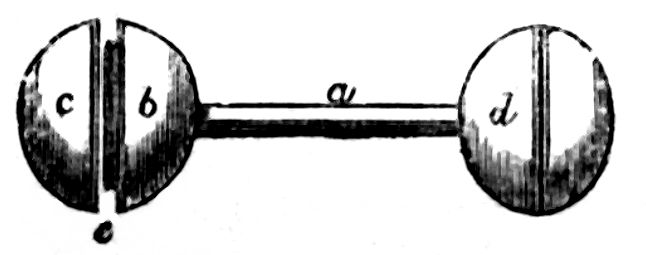
Fig. 1.
Back-Boards should be fitted to the person requiring them, unless they are used for the back-board exercise, in which case they will be as represented in fig. 2. When not used for this exercise, they are fastened to the back and shoulders by means of straps (a b, c d,) which pass round the shoulders and are made to buckle in front. These straps can be lengthened or shortened by passing them through holes in the board (g, g, g, g), left for that purpose. The lower part of the board is fastened round the waist by a strap (e f), which buckles in front.
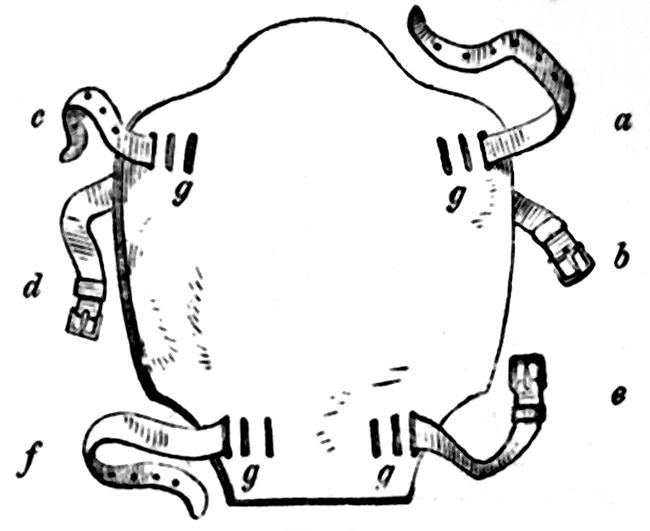
Fig. 2.
The dimensions of the short back-board are as follow, for a large size: length twelve or thirteen inches, breadth ten inches, lower part five inches, and upper part four inches. These measurements can be reduced according to circumstances, age, &c.
The Long Back-Board should be broad in the centre, as in fig. 3, so that the flat part may reach across the back of the shoulders, and the handles (a b) be long enough to hold in the hands when the arms are extended. Some of these back-boards vary from six feet in length to only three feet eight inches.

Fig. 3.
The Clubs for calisthenics should be made hollow, as in the annexed figure (fig. 4) varying from twenty to twenty-eight inches in length, and be of a proportionate width. The top is made to screw on, so that the inside may be loaded as recommended for the dumb-bells. By this means, the weight to be forced through the air can be proportioned to the strength or power of the individual to propel it.

Fig. 4.
The Wands, or Poles, should be light, smooth, and sufficiently thick not to bend. They vary in length according to the person’s height that is to use them, the rule being, that the poles shall be of the same length as the height of the person requiring them.
The Triangle is a bar of wood attached to a cord at each end; the two cords meet above, as shown in fig. 5, so as to form two sides of a triangle, of which the bar forms the third. A cord is attached to the upper part of the triangle, and this, passing over a pulley, enables the teacher to lower or raise the bar so as to suit the height of the pupil.
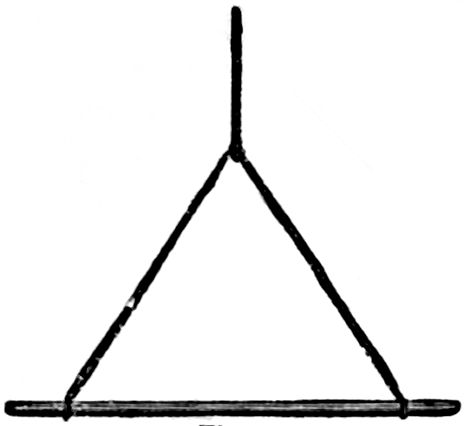
Fig. 5.
The Elastic Cord is one of the latest improvements in calisthenic exercises. It consists of two handles (a b), of a triangular form, to which is attached an elastic cord, made of vulcanized india-rubber. They may be obtained at most toy-shops, and vary in price from two to five shillings, according to the size.
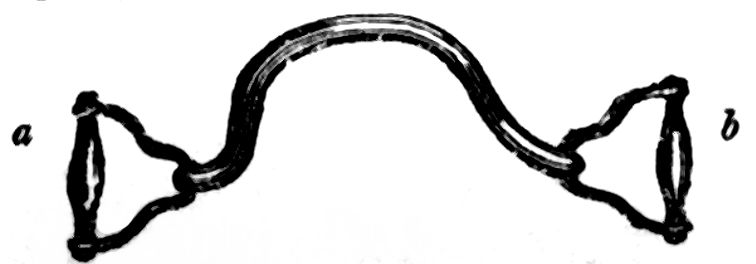
Fig. 6.
The pupil should commence the exercises with the dumb-bell practice.
The Dumb-Bell Practice. The dumb-bells are not to be used at first; but when the pupil has become proficient in the following exercises, then the dumb-bells are to be held firmly in the hands, which are to perform the same motions directed below.
Position of Attention. When the word attention is given by the teacher, the pupil is to draw back the shoulders, so as to make them square; the heels are to be placed in a line, and closed; the knees straight, the toes turned out an angle of 60 degrees, the arms hanging close to the body, the elbows turned in close to the side, the hands open to the front, the little finger lightly touching the dress, and the thumb close to the forefinger. The abdomen is to be slightly drawn in, and the chest advanced, but without constraint; the body upright, inclining a little forward, so that the weight of it may be principally on the fore-part of the feet; the head erect, and the eye looking straight to the front, as in fig. 7.
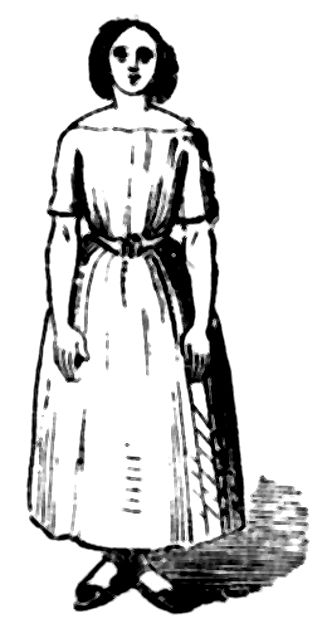
Fig. 7.
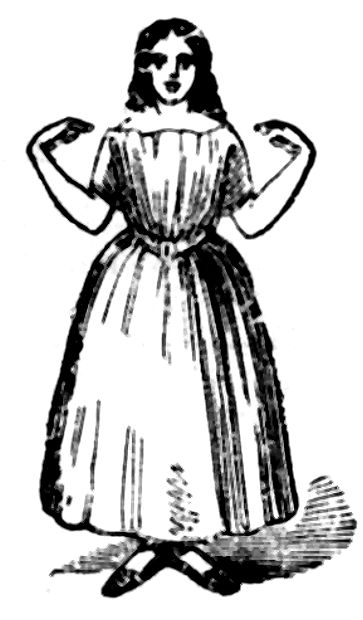
Fig. 8.
First Practice. One.—At the word one, raise the hands and bring the tips of the fingers in a line with, and pointing towards the shoulders, the body inclining forward, the head erect, and shoulders kept well back, with the elbows close to the side, as in fig. 8.
Two.—Dart the hands straight to the front, with straight arms, the palms of the hands close together, the thumbs close to the forefinger, nearly in a line with the chin, as in fig. 9.
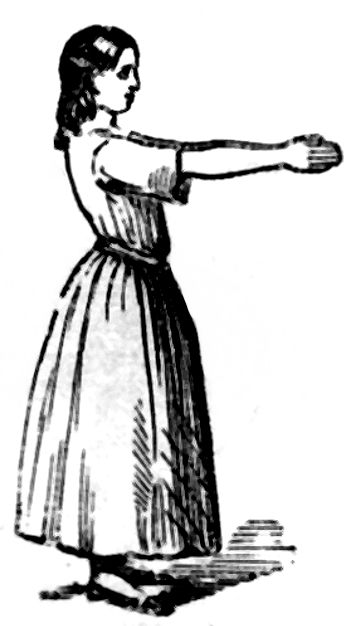
Fig. 9.
These two motions are to be repeated from two to one, and again from one to two, several times before commencing three.
Three.—The hands are thrown back with straight arms in a line with the shoulders the palms of the hands to the front, the thumbs close to the forefingers, the head erect, and shoulders kept well back, the body inclining forward, the heels raised off the ground, so that the weight of the body rests on the fore-part of the feet, as in fig. 10.
These motions are to be repeated from three to two, and from two to three several times before commencing four.
Four.—The arms are to be brought gradually by the side to the first position, (fig. 7).
Second Practice. One.—The hands are to be brought smartly up with the palms of the hands to the front, the tips of the fingers in a line with the shoulder, pointing upwards, the elbows to be kept close to the side and well back, so as to square the shoulders; the head is to be held erect, and the body slightly inclined forward, as in fig. 11.
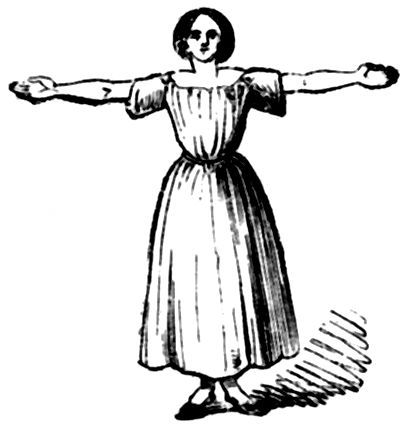
Fig. 10.
Two.—Raise the elbows a little so as to draw them upwards and backwards; then bring the hands smartly down to the side, as in fig. 12, and assume the position of attention (fig. 7).
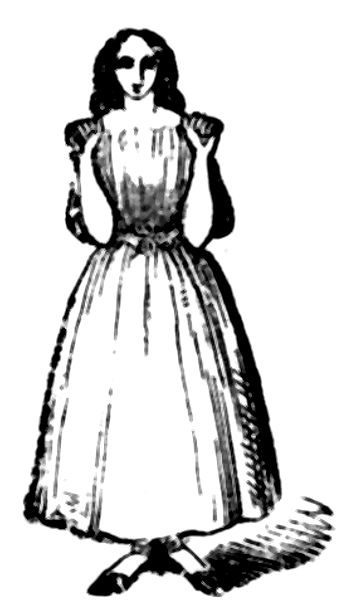
Fig. 11.
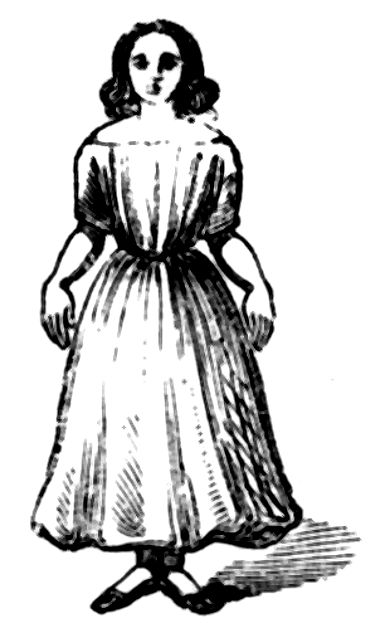
Fig. 12.
Long Back-Board Exercises. The long back-boards (fig. 3.), are to be held by the handle with the left hand, and the right hand is to be placed on the top of the back-board, while the other end rests upon the ground between the feet, as in fig. 13.
Attention. When this word is given the heels are to be brought in a line, and the back-board brought across in front of the thighs at the full extent of the arms, holding it by the handles with both hands (the backs of the hands to the front), as in fig. 14.
One.—The back-board is to be gradually raised from the position of attention, with the arms straight, until the flat part of it is horizontal and over the head, the tips of the fingers in front, and the knuckles behind; the body is to be kept well forward on the fore-part of the feet, and the head erect, as will be seen in fig. 15.
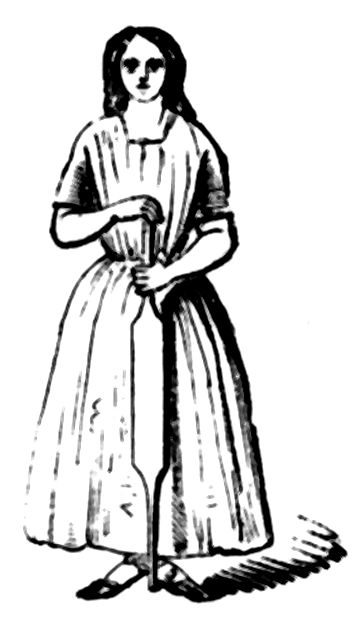
Fig. 13.
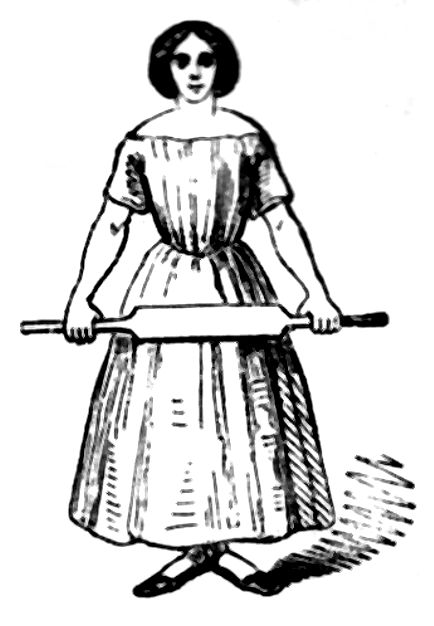
Fig. 14.
Two.—At this word the back-board is to be lowered from position one (the arms being contracted), and it is to be brought across the back part of the shoulders (as in fig. 16), still keeping the body well forward, and the head erect.
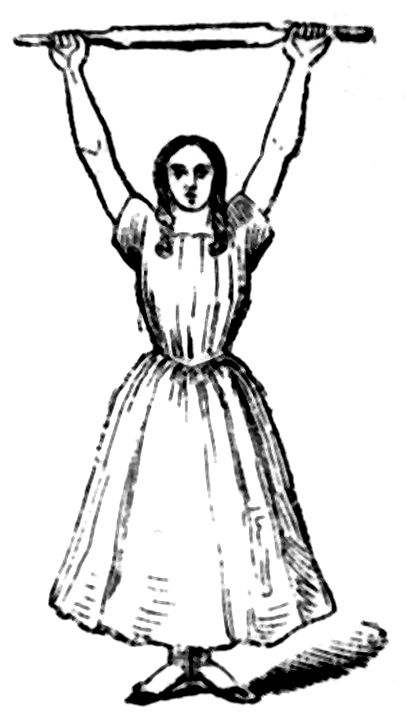
Fig. 15.
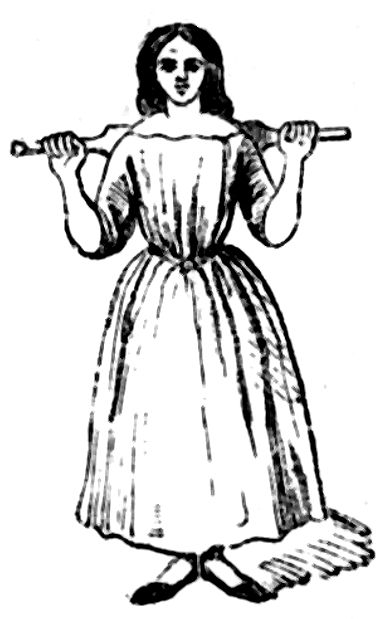
Fig. 16.
In the last position, the pupil will then be required to walk slowly round the room, quickly, and to practise the balance-step without gaining ground.
When the various exercises have been frequently repeated, the word “steady” will be given, when the position of attention (fig. 14) is to be resumed, and at the command “stand at ease,” that position (fig. 13), with the back-board, is at once to be taken.
COALS. All coal is essentially composed of carbon, oxygen, hydrogen, and nitrogen. The quality of any coal depends upon the proportions which it contains of these four elementary ingredients.
1. Dry or Cubical Coal.—This species is very black and shining. It generally comes from the pit in large masses; and it burns freely, with much flame and heat. This is by far the best coal for blast-furnaces, but is not so desirable for domestic use.
2. Steam Coal, sometimes called Smithy Coal. This species, which ignites readily, and produces comparatively little smoke, is much valued for its excellence in the furnaces of steam-boilers. It contains more carbon than bituminous coal, and more hydrogen than anthracite.
3. Cannel, or Gas-Coal. This species does not shine, but has, on the contrary, rather a dull appearance before it is ignited. When burning, it emits a most brilliant flame. As the roots of fir are used instead of candles in the winter nights, by the peasantry in some parts of Scotland, so this coal is made to answer the same end in some districts of England, and also in the south of Scotland. Hence its name, Cannel, the Lancashire word for candle.
4. Bituminous Coal. This species swells and cakes when heated. It is more abundant than other kinds, and is well adapted for household use. Bituminous coal, in a raw state, is not suitable for the blast-furnace.
5. Anthracite Coal. This species is very black, very brittle, and very shining. When sold, it is generally broken up into small pieces, but there is not much dust. It produces almost no smoke, and scarcely any ashes. Where it can be obtained at the same price as bituminous coal, it is more economical for domestic purposes. Anthracite coal is abundant in Wales and Ireland. In Ireland, it is called Kilkenny coal, in Scotland, blind coal, and in England, stone coal.
FIRES (HOW TO LIGHT THEM). When about to make a fire, let the grate be first half filled with common Newcastle coal. Above these place some shavings or waste paper, and then a few dry sticks or splinters, or bits of charcoal or broken peat. Lay on the top a few of yesterday’s cinders, and, lastly, some lumps of coal. These must not be shovelled in at random, but laid on carefully by hand. Apply a match to the shavings or paper, and in fifteen minutes you will have a cheerful fire.
After the fire has been made in the manner described, let it be replenished during the day with anthracite, not bituminous coal. Anthracite yields no smoke, and burns with such an intense heat that it consumes any smoke which rises from the pitchy Newcastle coal at the bottom of the grate.
Abolish poker and tongs. These time-honoured implements are worse than useless when a fire has been made on the smoke-consuming principle. Allow no poking, unless you are willing to have your coal wasted and your fire spoiled. Instead of the burnished, clumsy, steel biped, which is always in the way, get a blacksmith to make for you a light instrument like a sugar-tongs, about a foot long, and without hinge or joint.
Whatever kind of coal you use, never put on much at a time when replenishing the fire. Even with Newcastle coal, you will have comparatively little smoke, if you put on only a thin layer about once in half an hour or so. When a large shovelful of bituminous coal has been thrown on the fire, there is always a dense smoke for some time; but when only a thin sprinkling is put on, if the fire below is good, the gases emitted will produce flame and heat.
Preserve the coal-ashes which are usually thrown away as worthless. When you have a sufficient quantity, add to them an equal bulk of small coal or coal-dust from your cellar, and then pour a little water on the mixture. Use this compost at the back of the fire. It will burn brightly and pleasantly; only a little dust will remain unconsumed; and thus the trouble of sifting will be saved besides.
If a tolerably good fire be required—one nearly filling the grate—having first cleared out the ashes, fill up with coal, or coal and cinders, to nearly the top of the grate, then place pieces of coal round the ends and back of the grate, making a sort of wall about four inches high on three sides of the grate, open in front,—this will leave a space about the size of half a brick in the centre; in this space place the shavings, and over these very carefully the sticks, or wood,—(there is no material for lighting fires better or cheaper than the London firewood at a half-penny per bundle, one bundle making four fires,)—place the bits of wood about half an inch apart in one direction, the ends resting upon the walls of coal at each end of the grate, place little pieces of good unburnt coal, about the size of walnuts, between the pieces of wood about half an inch apart; over this lay another row of wood crosswise and bits of coal as before, another bit or two of rather thicker pieces of wood crossing these, and bits of coal over all, and over these some good cinders, and rather larger coal; light the shavings, and in a very short time there will be a good fire down to the bottom of the grate, without poking or blowing, or any further trouble. The coal wall round the three sides prevents the wood and coal from tumbling over, gives an open space in the centre for the air to enter all parts of the grate—and is, to use a military phrase, the key to the position. When a smaller fire is required, do not fill up the grate so high with coal before lighting, but let the fire be made nearer the bottom, or if you please, quite at the bottom of the grate.
WHEAT. The valuable species of grain which in Europe is what rice is in Southern Asia. Its nutritious quality arises from the quantity of gluten, or glue-like substance which it contains. Its flour, mixed with water, and excited by yeast (a substance already fermenting) ferments, and baked in an oven, constitutes bread, a wholesome food, if not whitened by alum, one-third of which is sulphuric acid, which destroys the stomach. A bushel weighs 56 lbs. and every pound yields 1½ lbs. of bread; a sack of flour of 280 lbs. producing 348 lbs. of bread. One pound of wheat yields 10 ozs. of starch, ½ oz. gluten and sugar, and 3 ozs. bran; but other analyses give the proportion of the starch to the gluten, as 3 or 4 to 1. The cut represents a wheat-sheaf as set up and tied together after reaping. It is then lodged in a barn, threshed, winnowed, and ground into flour.
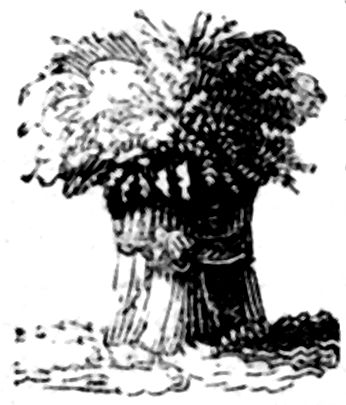
CHILBLAINS. Get a saucer half full of good vinegar, with a handful of salt in it; cover the saucer and let it stand till hot over a saucepan of water on the fire; the steam rising from the boiling water will soon heat the vinegar and salt; when hot lift the whole off the fire and fix it so that spots of chilblain can be dipped into the saucer. This must be used as hot as can be borne, even to smarting, and when the liquid cools a little, the toe or other part affected most be kept immersed for a few minutes, then wipe gently with a soft towel. Keep the feet always warm. If the chilblains are broken, the best cure is tincture of myrrh (the best and strongest), which entirely heals the spot in three days. Wrap the sore in soft old linen doubled, which tie on with a worsted thread, not to be removed till the chilblain is healed; saturate this linen by dropping the tincture of myrrh over the sore till it smarts violently, this will subside in about half a minute; then bandage it up, and repeat morning and evening.
CHAMELEON. An animal about ten inches long, which feeds on insects, and which, from the capacity of its lungs, is enabled to expand its skin, and thereby varying the angle of reflected light, changes its colour to a spectator, whose eyes are fixed.
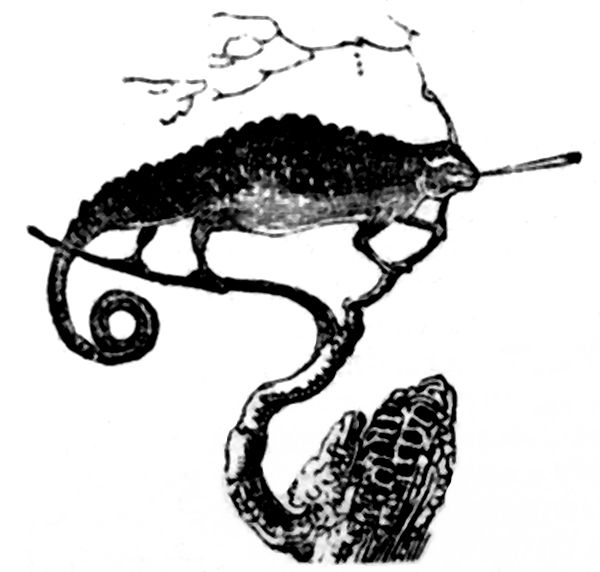
HEADACHE (CURES FOR THE). This complaint very often proceeds from a disordered stomach; a gentle emetic often gives relief, but some laxative medicine should be taken, such as rhubarb, Gregory’s mixture, or castor oil. For periodical headache, after the bowels have been sufficiently cleared, chalybeate waters, and such bitters as strengthen the stomach, will be necessary. A periodical headache has often been cured by wearing a piece of flannel over the forehead during the night. A little ether dropped in the palm of the hand and applied to the forehead will sometimes remove a violent headache. Care should be taken to keep the feet and legs warm.
SORE THROATS. For the habitual sore throat or quinsy, which is the torment of many people half their lives, and is generally mistaken for a violent cold because it occasions a tickling in the throat, the consequence of which is coughing—take of powdered galls, three drachms; of boiling rose-water, three ounces. Infuse for three hours. Then filter and pour off the liquor, and add of alum three drachms; of spirits of nutmeg or any other spirit, three ounces. Hold a little of this frequently against the very bottom of your mouth.
ATHENÆUM. A literary school at Rome, said to be founded by the Emperor Hadrian; now generally applied to institutions for the encouragement of letters.
AZOTE. The gas of which the atmosphere contains nearly four-fifths in bulk, and three-fourths in weight; the other fifth and fourth being oxygen, without which the air will support neither life nor combustion. It is also called nitrogen, and is generally considered as a compound. It converts blues into greens, and in the atmosphere may be regarded as a diluter of oxygen.
TELESCOPE. An optical instrument, which enables us to dispose of the rays which proceed from distant objects, that we may see the image or spectrum formed in the focus of the object-glass, very near, or under an increased angle. The angle of the image is as the focal length, or the distance from the object-glass to the image, and the angle at the eye-glass is as its distance from the image; the magnifying power is, therefore, in the proportion of those angles. The glass nearest the object makes an image or picture by crossing and subsequently diverging rays, which a convex eye-glass of short focus renders parallel for vision; or which a concave eye-glass intercepts while converging, and the image then proceeds directly to the eye with parallel rays. In the figure annexed the arrow is the object, the rays of which cross at the object-glass, and form an image which is viewed through a convex glass by the eye.

In the following figure O R is the object, rays from which cross at G, in the object-glass A D, forming an image, which is viewed by E Y, the eye-glass, by the eye at H.

D object-glass, E concave eye-glass, carrying parallel rays to the eye.
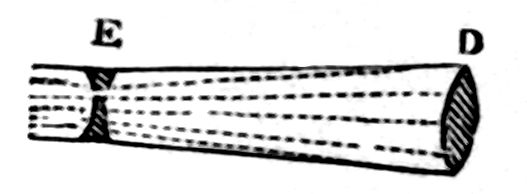
The first and second are the common telescope and microscope, the eye-glass being usually compounded of three eye-glasses to set the object erect; and the third is the Galilean or primitive telescope, and also the opera-glass.
The following represents a mounted telescope with rack-work for vertical and horizontal motions.
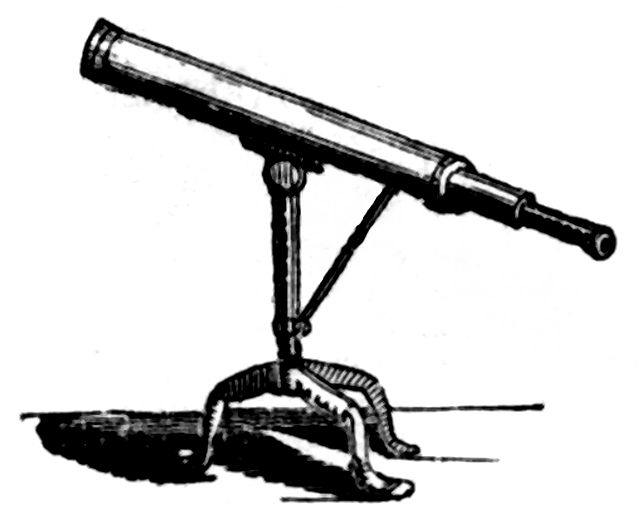
The following is a section of the tubes with the position of the object and eye-glasses.

TIME. The measure of motion, and of the succession of thoughts, determined on our globe by the phenomena of light and darkness, and returning seasons of heat and cold; the earth’s motion round its axis being a day, and its motion round the sun a year; while the period from new moon to new moon determines the month. Longer periods are the moon’s cycle of recurring phenomena in nineteen years; the earth’s cycle, or the retrocession of the equinoctial points round the ecliptic in 25,600 years; or the revolution of the line of apsides in 20,900 years. These are periods of duration relative to our globe and to us; but different to different systems, and even to different animals and states on the same planet; yet all are included in a totality of simple duration, common to the whole universe, and which totality is necessarily without measure, parts, beginning, or ending.
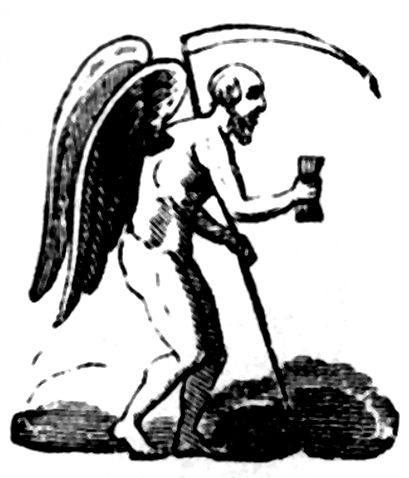
Time is, therefore, an acquired plan or mode of considering motions or events, and our views can have no exact relation to its absolute properties as an universal totality. Everything is relative which is not infinite; and all are evolved and absorbed by the totalities of infinite time and space. Time in the ancient mythology was drawn as an old man, with a scythe and hour-glass.
CAGE BIRDS (DISEASES OF). Like all tame animals, birds that are kept in confinement are exposed to more maladies than those that live at large; and especially as they are frequently so closely confined in cages that they have scarcely room to move. These maladies are, however, considerably increased by their having all kinds of delicacies, and pastry, sugar, &c., given them, which spoil their stomachs, and usually produces a slow consumption.
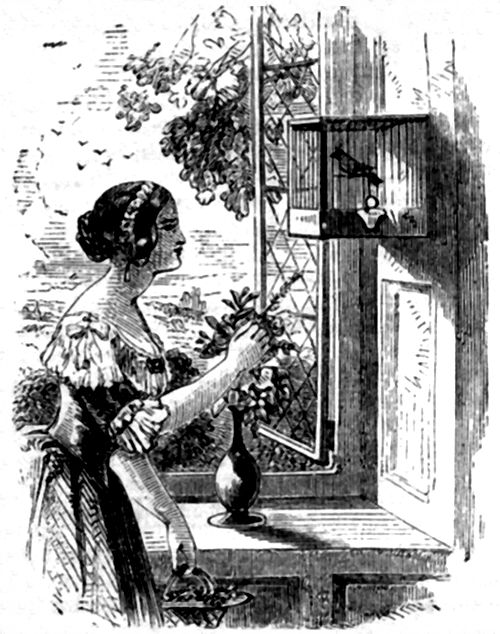
The following are the chief maladies which affect birds, and their remedies, the efficiency of which we have proved upon our own. Indeed the variety of birds, as well as the variety of their food, require also a difference of treatment in their maladies; and in speaking of each species, we shall have occasion to notice how their peculiar diseases may be cured, when the general remedies are not suitable to their nature.
1. The Pip. This is properly a cold, in which the upper skin of the tongue becomes hardened by fever, and the orifices of the nose are stopped. In large birds, therefore, this skin is separated from the tongue, and in doing this, it must be commenced beneath and behind. Thus the pores of the tongue are re-opened, and the secretion requisite for digestion can be reproduced, and taste and appetite made to return. A pill, consisting of butter, pepper, and garlic, generally frees them from this complaint. They may also be made to drink pectoral tea made of speedwell. To remove the stoppage of the orifices of the nose, a small feather is drawn through them.
This malady may be detected by the yellow colour at the root of the beak, the ruffled feathers of the head, the frequent opening of the beak, and the dryness of the tongue.
2. For Rheum, which is indicated by frequent sneezing and shaking the head, we have found no better remedy, especially when the bird has been valuable to us, and we have not desired nature to work alone, than giving it some drops of pectoral elixir in pectoral tea; or, when it would not drink of its own accord, to drench it with it. To a sick chicken we have given twenty drops in half a pint of tea.
3. Consumption. It is usually the result of unnatural food which interrupts the functions of digestion, and it is recognised by the bird inflating and distending itself. The feathers are ruffled, and their flesh dwindles. As yet we know no better remedy than to give to such birds a common spider, which purges them, and to lay in their water a rusted nail, which strengthens the stomach. They must, at the same time, be fed with the best description of their appropriate food. In birds which will eat vegetables, we have always found this, and especially water-cresses, the surest remedy against consumption, or waste. Usually, birds suffering from this malady have a voracious appetite for green food. We fed a Siskin, which had already wasted, for three successive days with nothing but water-cresses, and on the fourth it recommenced singing.
4. Constipation. This malady is detected by observing the birds every moment bending the venter to evacuate, and being unable to do so. If a spider does not cure, the smooth head of a pin must be dipped in linseed oil, and gently thrust into the rectum; such a clyster is usually effective. In birds which eat meal worms, constipation is removed by squeezing the inside of a meal worm and filling it with linseed oil and saffron; the bird thus willingly swallows the laxative, and the effect is certain.
5. Dysentery. Birds frequently suffer from this before they become accustomed to the food of the aviary, and then generally die. They evacuate every instant a chalky substance, which usually hangs about the feathers of the vent, and is so acrid that it inflames the rectum and anus. In such cases, occasionally, the internal application of the rust of iron, by placing it in the drinking vessel, and a linseed oil clyster, have been serviceable. But we know no positive remedy yet, and have only found that ailing birds may sometimes be saved when food is supplied them which is most appropriate to their nature. Many persons pluck away the feathers of the tail and vent, and rub their hinder parts with fresh butter, and mix the hard boiled yolk of eggs with their food. But this remedy we have found rarely followed by a successful result.
6. The Stoppage of the Fat-glands, or the Pimples. Every bird has above the rump a gland, which secretes the oil required by the bird to smear its plumage, to retain them supple, and to prevent moisture passing through. In confinement, birds neglect the frequent pressure of this gland, as they are more rarely exposed to getting wet than when at liberty, and it consequently becomes hardened or inflamed. If the bird is seen sitting and drooping, the tail bending downwards, or if the feathers upon the rump are observed to be ruffled, and that the bird frequently pecks at it, it must be examined to see if the swollen gland be not the cause. This may frequently be softened by the application of very fresh butter, mixed up with a good deal of sugar, the aperture being enlarged by gently distending it with a needle, or a small knife; but a lead salve, or rather a salve of litharge of silver, white lead, wax, and olive oil, which must be ordered at the apothecary’s, opens it best. The usual remedy is to pierce it with a needle, or to cut off the hardened gland. But this process, whilst it removes the stoppage, destroys the gland, and birds thus healed usually die at moulting, from wanting the oil requisite to smear their feathers. Tscheiner has the following observations upon this malady:—“If this evil have not yet too severely affected the health of the bird, it may be sought to be remedied by puncturing the gland, compressing it frequently, bathing the bird with a syringe, and plucking out some of the feathers of the tail. The accumulated fat is absorbed in the renewal of the feathers, when the gland resumes its natural functions.”
7. Epilepsy. A very usual malady of birds. The abundance and goodness of food, and the want of exercise, whereby much and thick blood is produced, are the chief causes of this. We have found no better remedy than to dip birds, when thus suffering, frequently into ice-cold water, and to pare their nails so closely that some drops of blood start. Also a few drops of olive-oil given internally have been serviceable. Large birds may be bled in the veins at the side of the feet. But usually birds which suffer from this sickness die eventually of it.
8. Moulting is also a malady. At this period it is requisite to attend to them very carefully, and to change their diet without giving them delicacies.
9. Birds in confinement also suffer much in their feet. These must be constantly so carefully cleansed that the skin is not at all ruptured. The large thick scales in front of the legs must also be removed once a year, but with great precaution.
10. Tympany. At one part of the body, or frequently all over it, the skin is puffed up as tense often as a drum. A small puncture must be made with a needle, whereby the air escapes, and the bird usually becomes sound again. We have had Skylarks which suffered from this malady, and in the next quarter of an hour, when freed from the air, resumed singing, although previously they had been sick to death.
11. Twirling. This is properly no sickness, but yet a very general evil, and a habit acquired by seed-eating birds in cages, where they turn and twist their head and neck so far back as to overbalance themselves. There is no better mode of breaking them of this evil habit than, as soon as it is detected, to put a cover over the cage, and so prevent their seeing anything above them; as this is the cause of their twirling themselves.
12. Parasites. If birds are sometimes restless, especially of a night, and if they are observed to be frequently feeling with their beak about the abdomen, back, or wings, they must be examined to see if no small yellow insects (lice or mites) may be discovered upon the body, or between the feathers. If this be the case, they must be sprinkled by means of a small syringe with water, in which quicksilver has been steeped, or with a greatly diluted infusion of tobacco, for several successive days, whereby the vermin are destroyed, or chased away. Another mode of getting rid of the lice is to bathe the birds frequently, and to give them daily fresh or dry sand, and to be very particular in keeping them exceedingly clean.
13. If it be found that the birds become unnaturally fat, which is often the case, especially during autumn, in some species of warblers, their too nutritious food must be changed, and Swedish turnips be mixed in it, and dry ants’ eggs put into their drink, which much checks their corpulency.
14. Birds in confinement are subject to another malady which we may call the amatory fever. It occurs usually in the month of May, when the sexual impulse is strongest. Birds that are attacked by it usually cease to sing about this time, droop, raise their feathers, waste away, and die. Birds that are confined in cages are first attacked by this malady. The cause appears to us to be the uniformity and tediousness of confinement, as well as their desire for a female. We cured several suffering thus, merely by hanging them frequently at the window. They were almost immediately cheered, and seemed to forget their sorrow, as well as their desire for freedom and pairing, in the general hilarity peculiar to singing birds.
CANNON. An arrangement of iron or brass, with a hollow tube, at the bottom of which gunpowder is lodged, and exploded by hot iron at a touch-hole; and the explosion being directed by the tube, balls and missiles are carried to great distances with destructive force. According to the sized ball which they will explode, they are called 6, 12, and 48 pounders. In a field of battle they are dragged by horses on light carriages, called field or flying artillery; and, in other ways, called heavy ordnance.
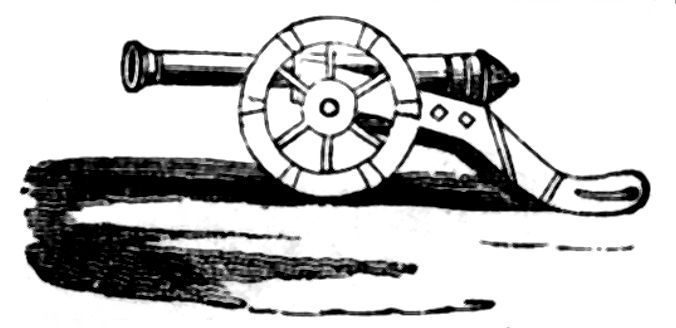
SUNFLOWER (THE). The value of this plant, which is easily cultivated, and ornamental to the garden, is scarcely known in most parts of the kingdom. The seed forms a most excellent and convenient food for poultry, and it is only necessary to cut off the heads of the plant when ripe, tie them in bunches, and hang them up in a dry situation, to be used as wanted. They not only fatten every kind of poultry, but greatly increase the quantity of eggs they lay. When cultivated to a considerable extent, they are also capital food for sheep and pigs, and for pheasants. The leaves when dried form a good powder for cattle; the dry stalks burn well, and form an abundance of alkali; and when in bloom, the flower is most attractive to bees.
POUNDS, SHILLINGS, AND PENCE. The etymology of these very necessary articles of exchange may be thus stated:—“Pound” is derived from the Anglo-Saxon pund or pond, which was generally a weight; it was then applied to a specific weight, consisting of a certain number of equal parts; to a certain number of pieces of money amounting to such a weight; and to a coin equalling such number of pieces in value. “Shilling” is of doubtful etymology; but derived probably from scilling, the appellation for a piece of money amongst our Anglo-Saxon predecessors. “Penny” is also of doubtful origin; but the name as applied to a coin is of great antiquity.
PORCELAIN. Porcelaine, said to be derived from Pour cent années it being formerly believed that the materials of porcelain were matured under ground one hundred years. It is not known who first discovered the art of making porcelain, nor is the date recorded; but the manufacture has been carried on in China, at King-te-ching, at least since a.d. 442, and here still the finest porcelain is made. It is first mentioned in Europe in 1581, shortly after which time it was known in England. The fine porcelain ware known as Dresden china was discovered by M. Boeticher, who was at the time only an apothecary’s boy, 1700. Services of this ware have cost many thousands of pounds each. A costly service, each piece exquisitely painted, and the battles represented, and subjects all different, was presented to the duke of Wellington, by the king of Prussia, in 1816, and is the finest in England.
AMAZONS. The Amazons are said to have been the descendants of Scythians inhabiting Cappadocia, when their husbands, having made incursions, were all slain, being surprised in ambuscade by their enemies. Their widows, excited to action by the sorrows they underwent on account of their husbands, resolved to form a female state, and having firmly established themselves, they decreed that matrimony was a shameful servitude. They were constantly engaged in wars. They were conquered by Theseus, about 1231 b.c.
DAY (DIVISION OF THE, INTO HOURS). The day began to be divided into hours from the year 293 b.c., when L. Papirius Cursor erected a sun-dial in the temple of Quirinus at Rome. Previous to the invention of water-clocks, 158 b.c., the time was called at Rome by public criers. The Chinese divide the day into twelve parts of two hours each. The Italians reckon twenty-four hours round, instead of two divisions of twelve hours each as we do. In England, the measurement of time was alike uncertain and difficult; one expedient was by wax candles, three inches burning an hour, and six wax candles burning twenty-four hours; these candles were invented by Alfred, clocks and hour-glasses not being then known in England, a.d. 886.
ASHLAR. A description of masonry where the stones are built in parallel beds with square joints, and dressed smooth upon the surface.
ASIDE. A term used in plays to mark sentences which do not form a part of the dialogue, being supposed to be inaudible to all but the speaker.
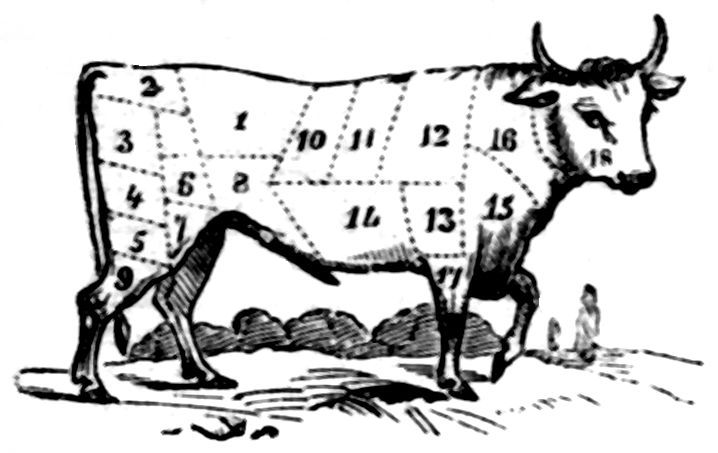
| Hind Quarter. | Fore Quarter. | ||
| 1. | Sirloin. | 11. | Middle-Rib (4 ribs). |
| 2. | Rump. | 12. | Chuck (3 ribs). |
| 3. | Aitch-Bone. | 13. | Shoulder, or Leg of Mutton Piece. |
| 4. | Buttock. | 14. | Brisket. |
| 5. | Mouse-Buttock. | 15. | Clod. |
| 6. | Veiny Piece. | 16. | Neck or Sticking Piece. |
| 7. | Thick Flank. | 17. | Shin. |
| 8. | Thin Flank. | 18. | Cheek. |
| 9. | Leg. | ||
| 10. | Fore-Ribs (5 ribs). |
2.—Mutton or Lamb.
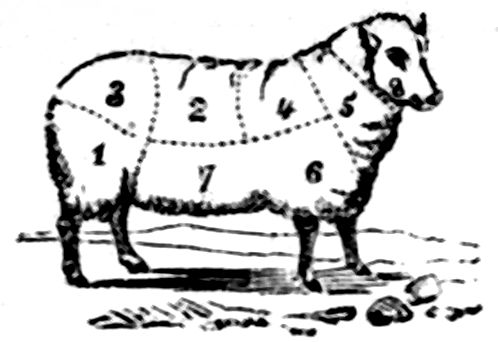
| 1. | Leg. | 6. | Shoulder. |
| 2. | Loin (best end). | 7. | Breast. |
| 3. | Loin (chump end). | 8. | Head. |
| 4. | Neck (best end). | A Chine is two Necks. | |
| 5. | Neck (scrag end). | A Saddle is two Loins. | |
3.—Pork.
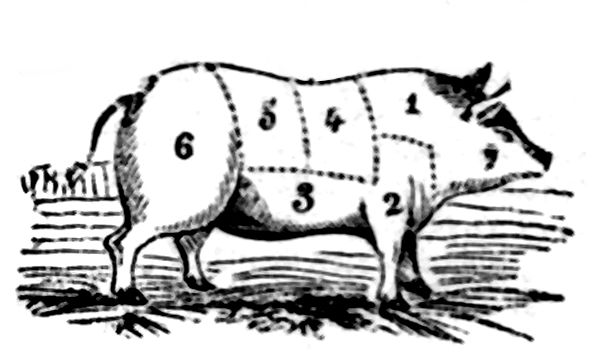
| 1. | The Spare-Rib. | 5. | Hind-Loin. |
| 2. | The Hand. | 6. | Leg. |
| 3. | The Belly or Spring. | 7. | Head. |
| 4. | Fore-Loin. |
4.—Veal.
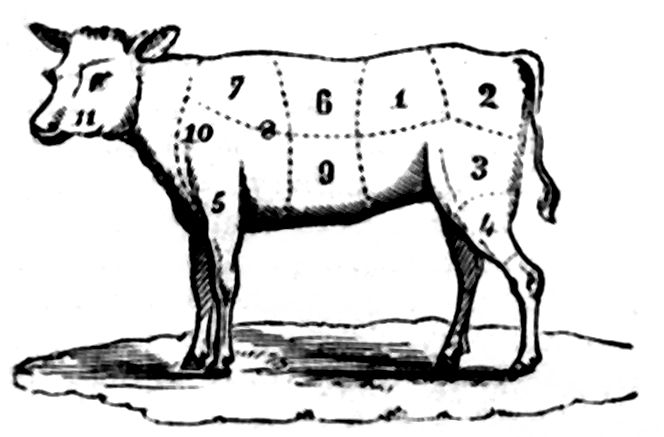
| 1. | Loin (best end). | 7. | Neck (scrag end). |
| 2. | Loin (chump end). | 8. | Blade-Bone. |
| 3. | Fillet. | 9. | Breast (best end). |
| 4. | Hind-Knuckle. | 10. | Breast (brisket end). |
| 5. | Fore-Knuckle. | 11. | Head. |
| 6. | Neck (best end). |
5.—Venison.
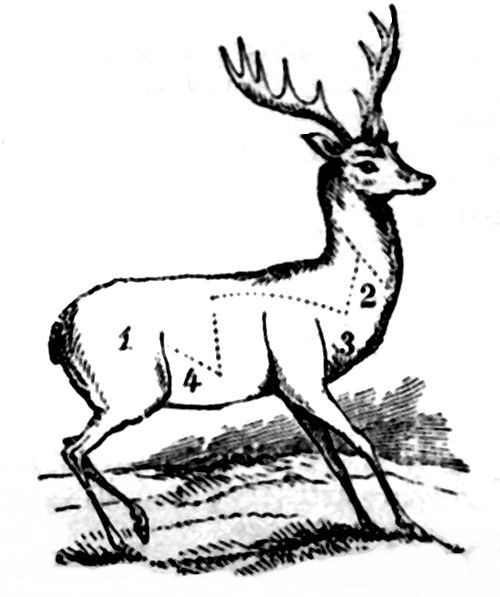
| 1. | Haunch. | 3. | Shoulder. |
| 2. | Neck. | 4. | Breast. |
ENAMELS. White enamels are composed by melting the oxide of tin with glass, and adding a small quantity of manganese, to increase the brilliancy of the colour. The addition of oxide of lead or antimony produces a yellow enamel; but a more beautiful yellow may be obtained from the oxide of silver. Reds are formed by an intermixture of the oxides of gold and iron, that composed of the former being the most beautiful and permanent. Greens, violets, and blues, are formed from the oxides of copper, cobalt, and iron; and these, when intermixed in different proportions, afford a great variety of intermediate colours.
PIN MONEY (ORIGIN OF). This term seems to have been derived from an ancient tax in France for providing the Queen with pins, whence it has been applied by us to that provision for married women, with which the husband is not to interfere.
HERALDRY. For ourselves we look upon heraldry as simply one of those branches of knowledge which is useful in its proper place. The origin of the science—if it may properly be called a science—is intimately interwoven in the origin of history. When men became distinguished, and felt themselves animated by those natural feelings of pride and ambition which distinction generates, they sought some method of marking to the eye their position; and, as the first means of distinction were military talents and courage, no readier method presented itself than that of placing a distinguishing sign or symbol on the shield, as the most conspicuous of the warrior’s accoutrements. During long and glorious ages of the history of the world, such symbols were adopted amongst almost all peoples, and there can be no doubt that they constituted heraldry in the simplest acceptation of the word. But each armorial bearing was the badge of the individual, and spoke of himself but not of his family. It was under the feudalism of the middle ages only that heraldry was, or perhaps could be, reduced to a system such as it presents in our days. As far as we can trace it, the adoption of armorial bearings as family badges began in the latter half of the twelfth century. This is a fact which we believe is generally acknowledged, but we doubt much whether, as some suppose, the Crusades had anything to do with it, or whether it was anything more than a natural accompaniment of the peculiar progress of society in that age.
BLACKLEAD PENCILS. The easiest way of producing, not only blacklead, but all sorts of pencils, is by the following process, which combines simplicity, cheapness, and quality. Take white or pipe-clay; put it into a tub of clean water, to soak for twelve hours, then agitate the whole, until it resembles milk; let it rest two or three minutes, and pour off the supernatant milky liquor into a second vessel; allow it to settle, pour off the clear and dry the residue on a filter. Then add blacklead any quantity. Powder it and calcine it at a white heat in a loosely-covered crucible; cool and carefully re-pulverize, then add prepared clay, prepared plumbago, equal parts. Water to mix. Make them into a paste, and put it into oiled moulds of the size required; dry very gradually, and apply sufficient heat to give the required degree of hardness; lastly, the pieces should be taken carefully from the moulds and placed in the grooves of the cedar. The more clay and heat employed, the harder the crayon; less clay and heat of course produces a contrary effect. The shade of black may also be varied in the same way. Each mould must be made of four pieces of wood nicely fitted together.
COLOSSUS OF RHODES (THE). This celebrated statue was considered one of the wonders of the world, and was erected in honour of Apollo. It was made of brass, and was 70 cubits, or about 105 feet in height, being proportionably big in every part. It stood astride over the haven, so that ships could sail in and out between the legs. In one hand it held a light-house, in the other a sceptre: and its head represented a golden sun. The distance between the two feet was 1,000 yards, and two men could scarcely embrace its thumb, when their arms were extended. This extraordinary statue was made by Chares, a Rhodian, who was engaged 12 years in its perfection. After it had stood for 66 years, an earthquake displaced it, and the money collected by the Rhodians from the various Grecian states being embezzled, the statue was never replaced or repaired, as intended; but the image was allowed to remain 894 years upon the ground, when the Saracens having taken the city, sold the “world’s wonder,” to a Jew as old brass; its weight being 720,000 lbs. avoirdupois. The Jew broke it into pieces, and loaded 900 camels with them. At the present time there is a castle erected on one side, and a town on the other, to mark the places where the feet of the far-famed Colossus were placed.
RAIN. Rain falls in drops, because the vapoury particles attract each other in their descent, and those which are sufficiently near unite and form into drops. These drops are sometimes larger than at other times, because the rain-cloud is floating nearer the earth; when this is the case the drops are large, because such a cloud is more dense than one more elevated. The size of the drop is also increased according to the rapidity with which the vapours are condensed. Wind may sometimes increase the size of the drops by blowing two into one.
DUN. Some persons imagine this word to be derived from the French donnez—give me, implying a demand for something new; but the true origin of this expression is supposed to be due to one John Dun, a famous bailiff of the town of Lincoln, so extremely active in his business, that it became a proverb when a man refused to pay his debts, to say, “Why don’t you Dun him?” that is, “Why don’t you send Dun to arrest him?” Hence it grew into a custom, and is as old as the days of Henry VII.
ASPEN. A kind of poplar tree, the leaves of which have a tremulous motion which seems incessant, and has become proverbial.
ANTHRACITE. A variety of coal consisting of vegetable carbon, and difficult to burn on account of the want of the bitumen found in the common sorts of coal. It is found in Wales and in America.
PULLEYS. The pulley is a wheel, round the rim of which a groove is cut, in which a cord can work, and the centre of which moves on pivots in a block. The wheel sometimes passes under the name of a sheave.
By a fixed pulley, we mean one which merely revolves on its axis, but does not change its place. The power is applied to one end of the cord and the weight to the other.
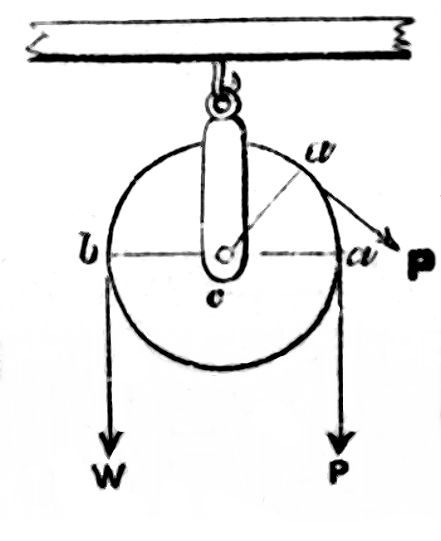
Fig. 1.
The action of the pulley may be readily understood from that of the lever. Let c, fig. 1 be the axis of the pulley, b the point to which the weight is attached; a the point of application of the power; draw the lines, c b, c a—they represent the arms of a lever—and the law of the equilibrium of a lever, therefore, applies in this case also; and as these are necessarily equal to each other, the pulley will be in equilibrio when the weight and power are equal.
If the direction in which the power is applied, instead of being P a, is P′ a, the same reasoning holds good. For, on drawing C a, as before, it is obvious that b c a represent a bent lever of equal arms. The condition of equilibrium is, therefore, the same.
The fixed pulley does not increase the power, but it renders it more available, by permitting us to apply it in any desired direction.
To prove the properties of the pulley experimentally, hang to the ends of its cord equal weights; they will remain in equilibrio. Or, if the power be increased, so as to make the weight ascend, the vertical distances passed over are equal.
The moveable pulley is represented at fig. 2. Its peculiarity is that, besides the motion on its own axis, it also has a progressive one. Let b be the axis of the pulley, and to it the weight, W, is attached the power as applied at a. Draw the diameter, a c, then c is the fulcrum of a c, which is in reality a lever of the third order in which distance, a c, of the power is twice that, b c, of the weight. Consequently “the moveable pulley doubles the effect of the power,” and the distance traversed by the power is twice that traversed by the weight.
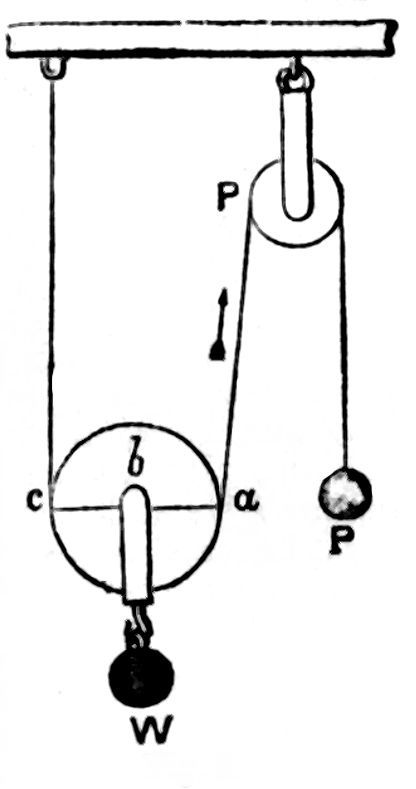
Fig. 2.
A moveable pulley is sometimes called “a runner;” and as it would be often inconvenient to apply the power in the upward direction, as at a, there is commonly associated with the runner a fixed pulley, which without changing the value of the power, enables us to vary the direction of its action.
Systems of pulleys are arrangements of sheaves, moveable and fixed.
When one fixed pulley acts on a number of moveable ones, equilibrium is maintained, when the power and weight are to each other as 1 to that power of 2 which equals the number of the moveable pulleys. Thus, if there be, as in fig. 3, three moveable pulleys, the power is to the weight as 1:2′ that is 1:8; consequently, on such a system, a given power will support an eightfold weight.
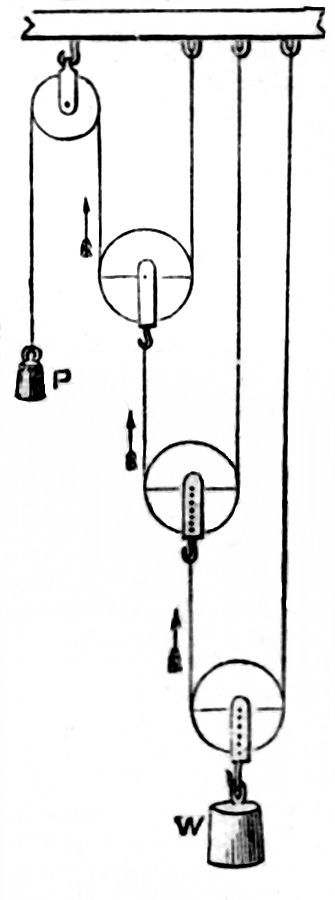
Fig. 3.
When several moveable and fixed pulleys are employed, as in fig. 4, equilibrium is obtained when the power equals the weight divided by twice the number of moveable pulleys. The weight being equally divided between the six lines, it follows that each is drawn by one-sixth of the weight, W. consequently, if sixty pounds weight is suspended to the bottom, each line would be drawn upon by a force of 10 pounds. If we wish to keep this machine in a state of equilibrium, we must attach a weight, P, of ten pounds to the end of the line.

Fig. 4.
In such systems of pulleys there is a great loss of power arising from the friction of the sheaves against the sides of the blocks, and on their axles. In White’s pulley this is to a considerable extent avoided. This contrivance is represented in fig. 5. It consists of several sheaves of unequal diameters, all turned on one common mass, and working on one common axis. The diameters of these, in the upper blocks, are as the numbers 2, 4, 6, &c., and in the lower 1, 3, 5, &c.; consequently, they all revolve in equal times and the rope passes without sliding or scraping upon the grooves.
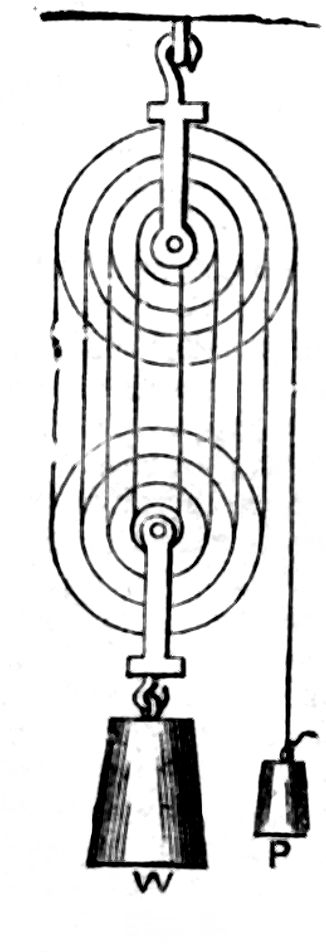
Fig. 5.
Wheels and Axles. The wheel and axle consists of a cylinder revolving upon an axis, and having a wheel of larger diameter immoveably affixed to it. The power is applied to the circumference of the wheel, the weight to that of the axle.
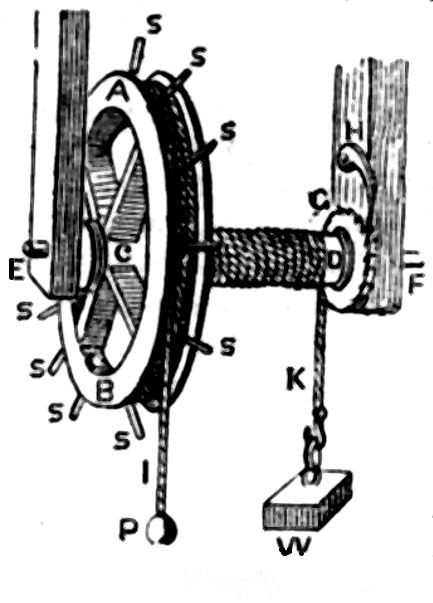
Fig. 6.
Let a b, be a wheel, c d, fig. 6, its axle, and suppose the circumference of the wheel to be eight times as great as the circumference of the axle; then a power, P, equal to one pound, hanging by the cord I, which goes round the wheel, will balance a weight, W, of eight pounds, hanging by the rope K, which goes round the axle; and as the friction on the pivots, E F, or gudgeons of the axle is but small, a small addition to the power, will cause it to descend, and raise the weight; but the weight will rise with only an eighth part of the velocity wherewith the power descends, and, consequently, through no more than an eighth part of an equal space in the same time. If the wheel be pulled round by the handles, S S, the power will be increased in proportion to their length. G, is a ratchet-wheel on one end of the axle, with a catch H, to fall in its teeth.
The law of equilibrium is, that “the power must be to the weight as the radius of the axle is to that of the wheel.”
This instrument is, evidently, nothing but a modification of the lever; it may be regarded as a continuously acting lever, in fact, it is sometimes called “the perpetual lever.” In its mode of action, the common lever operates in an intermitting way, and, as it were, by small steps at a time. A mass which is forced up by a lever a short distance must be temporarily propped, and the lever re-adjusted before it can be brought into action again; but the wheel and axle continues its operation constantly in the same direction.
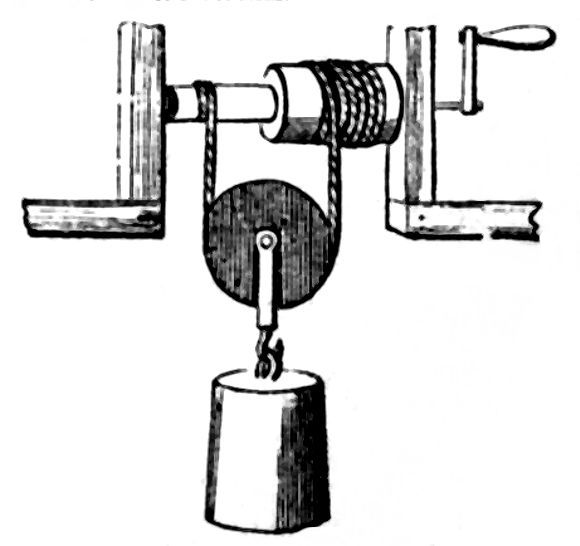
Fig. 7.
The inconvenience of having a large wheel and very slender axle may be avoided, without lessening the mechanical advantage, by employing a machine called the “Chinese wheel and axle,” which consists of two cylinders, one larger than the other, turning about the same axis. The weight is attached to a pulley, which plays on a long cord, which is coiled round both axles in contrary directions. When the winch is turned, one end of the cord uncoils from the smaller cylinder, and is wound round the larger; thus the weight is elevated at each turn, through a space equal to half of the difference between the circumference of the two cylinders. Therefore the advantage of this machine, with its pulley, is in the ratio of the diameter of the larger cylinder to half its excess above that of the lesser one. (Fig. 7.)
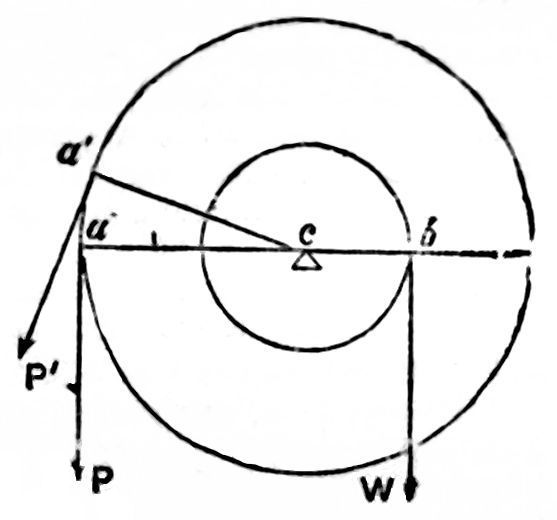
Fig. 8.
That this is its mode of action may be understood from considering fig. 8, in which let c be the common centre of the axle, c b, and of the wheel c a, a the point of application of the power P, and b that of the weight, W. Draw the line a c b; it evidently represents a lever of the first order, of which the fulcrum is c, and from the principles of the lever, it is easy to demonstrate the law of equilibrium of this machine, as just given. Further, it is immaterial in what direction the power be applied, as P′ at the point a′ for a c b still forms a bent lever, and the same principle still holds good.
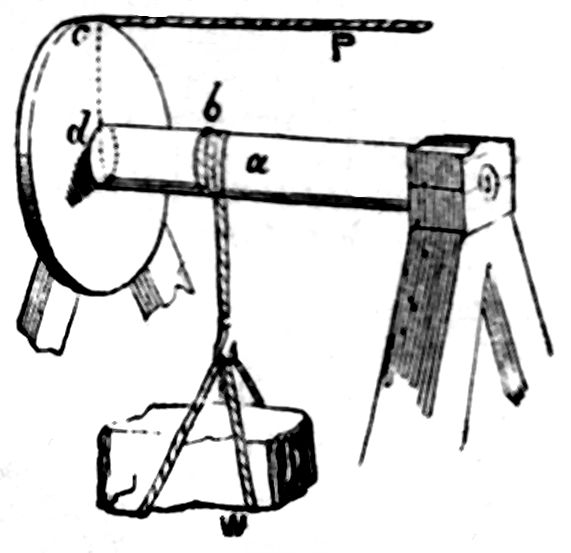
Fig. 9.
The effect of the wheel depends upon the superiority of the radius, or diameter of the wheel, to that of the axle. In fig. 9 we see that the weight, W, corresponds to the counteracting force, P, in an inverse ratio to the arms of the lever; that is, inversely to the radii, a b, and d c, of the wheel. Let us suppose that the radius, a b, of the axle, is four times less than the radius, d c, of the wheel, we may equipoise a weight of eighty pounds by a force of twenty pounds.
Sometimes the wheel is replaced by a winch, as in fig. 10; it is then called a “windlass,” if the motion is vertical; but if it be horizontal, as in fig. 11, the machine is called a “capstan,” which differs from the windlass in having its revolving axis placed vertically. The circumference is pierced with holes which receive long levers, called capstan-bars, by which it is worked by men, who walk round the capstan and make it revolve by pressing the ends of the levers forward.
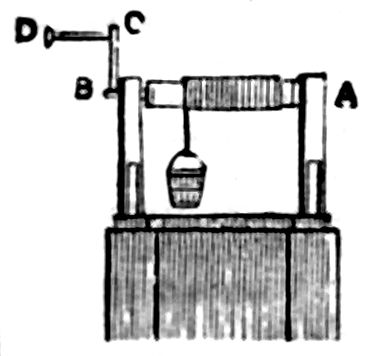
Fig. 10.
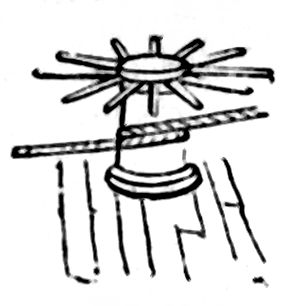
Fig. 11.
The tread-mill is another variety. In this case the weight of several people treading on the circumference of a long wheel causes it to revolve. The paddle-wheel of a steam-boat acts on the same principle; the water, which offers a resistance to the motion of the paddle-boards, is the power.
Wheels and axles are often made to act upon one another by the aid of cogs, as in clock-work and mill machinery. In these cases the cogs on the periphery of the wheel take the name of teeth, those on the axle the name of leaves, and the axle itself is called a pinion.
The law of equilibrium of such machines may be easily demonstrated to be, that the power multiplied by the product of the number of teeth, in all the wheels, is equal to the weight multiplied by the product of the number of leaves in all the pinions.
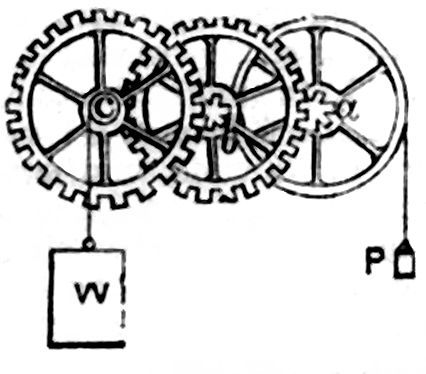
Fig. 12.
A system of wheel and pinion work is represented at fig. 12. It is scarcely necessary to observe, that in it, as in all other cases, the law of virtual velocities holds good—the power multiplied by the velocity of the power is equal to the weight multiplied by the velocity of the weight.
In the construction of such machinery, attention has to be paid to the form of the teeth, so that they may not scrape or jolt upon one another. Several of them should be in contact at once, to diminish the risk of fracture and the wear.
If the teeth of a wheel be in the direction of radii from its centre it is called a spur-wheel.
If the teeth are parallel to the axis of the wheel it is called a crown-wheel.
If the teeth are oblique to the axis of the wheel it is called a beveled wheel.
By combining these different forms of wheels suitably together, the resulting motion can be transferred to any required plane. Thus, by a pair of beveled-wheels motion round a vertical axis may be transferred to a horizontal one, or, indeed, one in any other direction.
When a pinion is made to work on a toothed-bar, it constitutes a rack. This contrivance is under the same law as the wheel and axle.
GLOVES. With regard to the period in which the use of gloves was first introduced, we have, perhaps, no better authority than that of Xenophon, who, in speaking of the Persians, mentions as a proof of their effeminacy, that not content with covering their head and feet, they also wore thick gloves to guard their hands from the effect of cold; but some ascribe to them a much earlier origin, even as far back as the time of Ruth, as in the 4th chapter and 7th verse we read, that it was the custom for a man to take off his shoe and give it to his neighbour, as a token of redeeming anything. The word, they say, which is translated shoe, is by the Chaldean Paraphrast rendered glove. The royal Psalmist also uses the same word in the 108th Psalm, where it is likewise rendered shoe; but for the same reason as above it should have been glove: “I will cast my shoe over Edom.” Yet there is good reason to suppose that the Chaldean Paraphrast has taken an unwarrantable liberty in his version of the text. Casaubon also conjectures that gloves were in use among the Chaldeans, because, in the Talmud Lexicon, the meaning given to the word here mentioned, is “Clothing of the hands.” Varro, an ancient writer of repute, fully proves their antiquity among the Romans, observing in the 2nd book, 55th chapter “De Re Rustica,” that olives gathered with the naked hand are preferable to those gathered with gloves. Homer represents Laertes working in his garden with gloves on, to secure his hands from the thorns. A famous glutton is mentioned by Athenæus as coming to table with gloves on, that, being thereby enabled to handle the meat while hot, he might devour more than any one else. But though these examples show that the use of gloves was not unknown to the ancients, yet we cannot for a moment suppose that they were at all so commonly worn as now; and we may, moreover, infer that their use met with some opposition even a century after the establishment of Christianity; for Musonius, the philosopher, in attacking the corruption of the age, says that it is a shame for persons in health to clothe their hands and feet in soft and hairy coverings. We may, however, conclude that their convenience soon rendered their use pretty general, for Pliny the younger, in his account of his uncle’s journey to Vesuvius, states that his secretary, who sat by him ready to write down whatever occurred remarkable, had gloves on his hands; that the coldness of the weather might not impede his employment. We then find them gradually become more common; and in the ninth century their use was so universal, that the Church thought it necessary to make some regulations with regard to that part of dress.
LOTTERIES. The first lottery in England was drawn in the year 1569. It consisted of 40,000 lots, at 10s. a lot; the prizes were plate, and the profits were to go towards repairing the havens of the kingdom. It was drawn at the west door of St. Paul’s cathedral. The drawing began on the 11th of January, and continued night and day till the 6th of May following.
ASP. A small kind of poisonous serpent found in Africa, whose venom is said to be fatal; celebrated in history as the means taken by Cleopatra to commit suicide.
ASPECT. An astronomical term denoting the situations of the heavenly bodies with regard to each other.
AUSPICES. Among the Romans a mode by which the Augurs sought to ascertain future events, principally by the inspection of the entrails of animals slain for sacrifice.
AVE MARIA. The name given to the angel Gabriel’s salutation to the Virgin Mary at the incarnation of Jesus: the chaplets and rosaries of the Romish church are divided into ave-marias and pater-nosters.
ATHANASIAN CREED. Ascribed to Athanasius, bishop of Alexandria, and also to Hilary, bishop of Arles. It was used in France about the year 850, and first sung in our churches about 950.
ACRE. A port-town of Syria, famous for several destructive sieges.
ACRE. Four square roods, or 160 square poles, of 5½ yards, or 4,840 square yards, i.e. 69.6 yards by 69.6 yards. The French acre is to the English, as 54 to 43; and the Irish acre is 1½ English.
MISTLETOE is a parasitic plant, found wild in England, very rarely in Scotland, and nowhere in Ireland; and is a production of great interest to the phytologist. The seeds in germination offer an exception to a general law, that the radicle of the embryo shoots downwards, and the plumula upwards. Thus, if a cannon-ball, to which mistletoe-seeds are glued on all sides, be suspended by a cord some distance from the earth, both the upper and under seeds, as well as those at the sides, all direct their radicle to the surface of the ball. This property ensures their growing upon the branches of trees, to whatever side they happen to stick.
The fruit, which is covered with a viscid pulp, is made by the Italians, and even in Herefordshire, into a kind of birdlime; and, as it is a favourite food of the large or missel thrush, it is thought to have given rise to the proverb, “Turdus malus sibi cacat,” applied to such as are authors of their own misfortunes. Mistletoe grows luxuriantly upon the apple or pear tribe of trees, and the oak; and Mr. Jessie describes it as flourishing upon some lime-trees in Datchet Mead, just as Shakspeare described it in his day.
The mystic uses of the mistletoe are traced to the pagan ages; it has been identified with the golden branch referred to by Virgil, in infernis; and it is affirmed to have been used in the religious ceremonies of the Greeks and Romans.
The Druids and Celtic nations called it all-heal and guidhel. They had an extraordinary veneration for the number three, says Vallancey, and they chose the mistletoe, because not only its berries, but its leaves also, grow in clusters of three united to one stalk; but the leaves grow in pairs only. The Druids celebrated a grand festival on the annual cutting of the mistletoe, which was held on the sixth day of the moon nearest their new year. Many ceremonies were observed: the officiating Druid being clad in white, cut the plant with a golden sickle, and received it in a white cloth.
Kissing a fair one under the mistletoe, and wishing her a happy new year as you present her with one of the berries for luck, is the Christmas custom of our times; and in some places persons try lots, for the bough with most berries, by the crackling of leaves and berries in the fire.
But at what period came mistletoe to be recognised as a Christmas evergreen? We have Christmas carols in praise of holly and ivy of even earlier date than the fifteenth century; but allusion to mistletoe can scarcely be found for two centuries later, or before the time of Herrick:
“Down with the rosemary, and so,
Down with the baies and mistletoe;
Down with the holly, ivie, all,
Wherewith ye dressed the Christmas hall.”
Shakspeare describes:
“The trees, though summer, yet forlorn and lean,
O’ercome with moss and baleful mistletoe.”
Tusser directs:
“Get ivye and hull (holly), woman, deck up thine house;”
And thus refers to the plant:
“If snowe do continue, sheepe hardly that fare
Crave mistle and ivie for them for to spare.”
The seeds of mistletoe ripen late, between February and April, and birds do not willingly feed upon them as long as they can procure the berries of hawthorn, hollies, ivy, and other winter food. No sooner, however, does a late frost set in, and the ground become covered with snow in the spring, as is often the case, than birds flock to the mistletoe, and find a ready resource thus left them when all others have failed. If the ripe berries are rubbed upon the branches of trees, between February and April, they may be readily cultivated; and mistletoe has thus been found to germinate on the oak, several of the pine tribe, cherry, common laurel, Portugal laurel, holly, lime, elm, hornbeam, birch, sycamore, ash, chesnut, hazel, and acacia, as well as the apple, pear, and whitethorn tribe; but on all, except the apple and pear, the seeds soon sicken and die.
ANTEDILUVIAN. A term applied to any animal or thing which existed in the world previous to the deluge.
COOKING IN A HOUSE (TO REMOVE THE SMELL OF). Smell may be avoided by making in the tunnel of the chimney a little door on a level with the ceiling of the kitchen, through which the smell will escape. If the top of the door is lower than the ceiling, it should be connected with an iron tube running up to the same height in the chimney, by which means it will be secure from the effect of sudden changes of weather, &c.; or a distinct tunnel may be built up for the same purpose.
SCRUBBING FLOORS. After the white-washing, paint-cleaning, and window-washing of each room has been completed, let the floor be scrubbed; first seeing that it has been well swept. For this purpose have a small tub or bucket of warm water; an old saucer to hold a piece of brown soap, a large thick tow-linen floor-cloth, and a long-handled scrubbing brush. Dip the whole of the floor-cloth into the water, and with it wet a portion of the floor. Next, rub some soap on the bristles of the brush, and scrub hard all over the wet place. Then dip your cloth into the water, and with it wash the suds off the floor. Wring the cloth, wet it again, and wipe the floor with it a second time. Lastly, wash the cloth about in the water, wring it as dry as possible, and give the floor a last and hard wiping with it. Afterwards go on to the next part of the floor, wet it, scrub it, wipe it three times, and proceed in the same manner, a piece at a time, till you have gone over the whole; change the dirty water for clean, whenever you find it necessary. For a large room, fresh warm water will be required four or five times in the course of the scrubbing. When the floor has been scrubbed, leave the sashes raised while it is drying. For scouring common floors that are very dirty, have by you an old tin pan with some grey sand in it; and after soaping the brush, rub on it some sand also.
RESPIRATION. The lungs, the organs of respiration, may be described as fleshy sponges. In human beings there are two; one on each side the heart, fitted within the chest, and reaching from top to bottom of the ribs. These sponges are full of little holes or cells; the number of them is calculated at 174 millions, and each one of these takes in air as it comes down the throat or windpipe. This large number is required for the air to act upon. A man inspires from one to two pints each time he breathes. The air enters into all the cells of the lungs, where one part of it is absorbed or taken up by the blood as it rushes through, and the remainder is breathed out again, mingled with carbonic acid gas and vapour. A man breathes from fifteen to twenty times in a minute. Thus, about 1,000 pints of air enter the lungs every hour, or 3,000 gallons every twenty-four hours.
DEAF (AXIOMS FOR THE). 1. Never syringe your ears, nor allow it to be done by others, unless for the removal of an accumulation of wax. 2. Be sure that such accumulation forms an obstacle to the transmission of sound, otherwise it had better remain where it is; for it should always be borne in mind that the wax is a natural secretion, placed in the passage of the ear for a specific purpose. Its presence, in moderate quantity, indicates a healthy condition of the outer passages of the ear. Its absence is the effect, and not, as is generally supposed, the cause of the disease which produces the deafness. Like deafness, the want of wax is only a symptom of ear disease; hence the absurdity of attempting its restoration by stimulating drops and ointments. 3. Never pick the ears. 4. Never wet the hair, nor wash the hair with cold water—a most pernicious practice. 5. Never bathe, or use a shower-bath, without carefully protecting the head and ears; even then I question its propriety. 6. Never attempt to stop a discharge from the ears, but under proper advice; for it may be that the drum or your ear is open, and then the employment of a stimulating or astringent injection will risk some fatal consequence. 7. Never apply, nor suffer to be applied, anything to the outer passages of the ears, which causes heat or pain. Such applications may prove of temporary benefit, but when the stimulus has subsided you will be left worse than before. 8. Be strict in diet. Stomachic derangements are a most prolific cause of deafness. 9. Never expose yourself to wet or wintry weather. 10. Never consult an aurist, who is not an educated and diplomatised surgeon, and who does not admit that deafness is an infirmity, often difficult of removal, and, very often, incurable.
WINDLASS. A common mechanical power, by which weights are raised, and water generally drawn out of a well. As power is as velocity, and as the hand at the winch makes a larger circle than the cylinder round which the rope coils, so the power is proportionally increased. Thus, if the hand performs a circle of six feet while the cylinder performs but one foot, so the power of the hand, friction excepted, is increased six times.
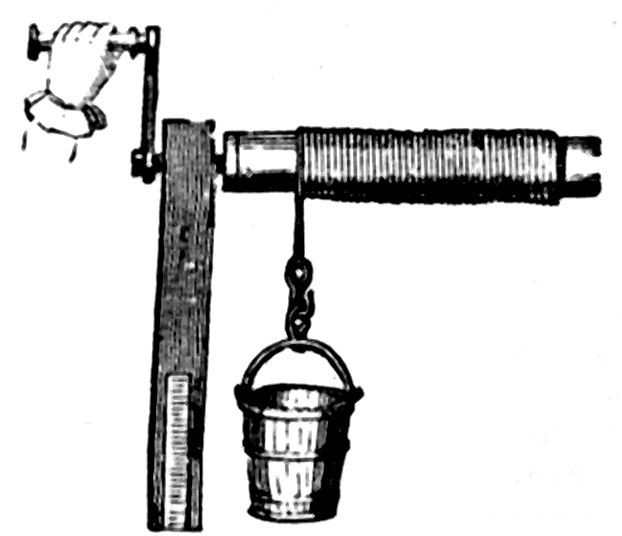
TUSCAN. The simplest order of architecture, like the Doric, but stronger.
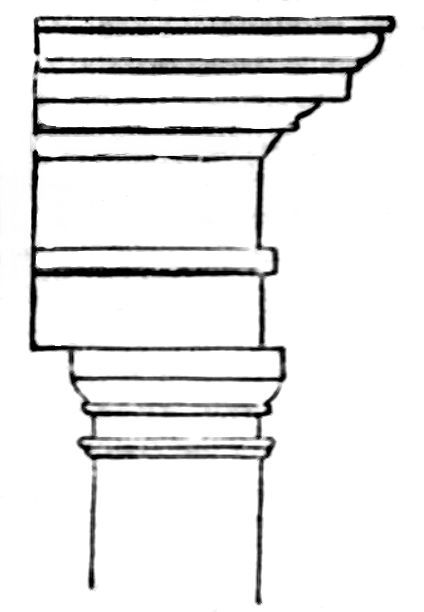
WATER-WHEEL (OVERSHOT). A variety of water-wheel, by which water falling on its upper periphery, carries it round, not only by its force, but by its accumulated weight; for, it is so constructed as to catch and hold the water in descending, part with it at the bottom, and ascend on the other side empty, and it is a very convenient and powerful structure when the nature of the ground permits.
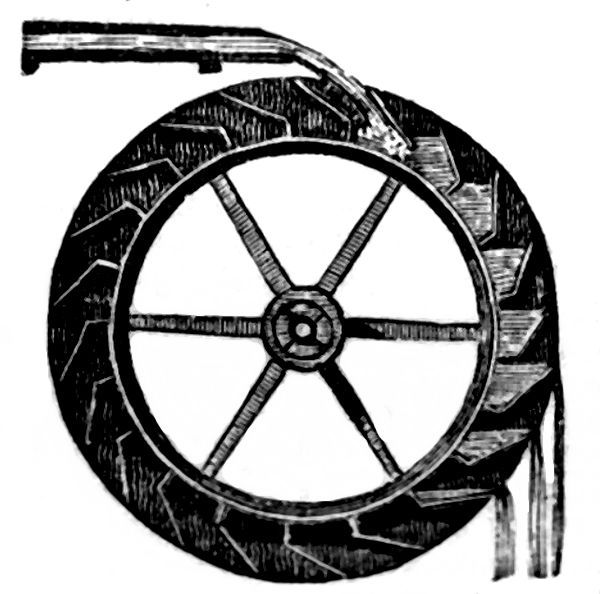
SOUTH-SEA BUBBLE. This term is applied to a company instituted in 1710, and incorporated in 1716. Under cover of its legality, enormous frauds were carried on. Thousands of persons were ruined by it. The cunning of the directors had raised shares originally valued at £100, to the enormous price of £1000. The scheme exploded in 1720; when the directors’ estates, to the value of £2,014,000 were seized. Mr. Knight, the cashier, absconded with £100,000, but he compounded the fraud for £10,000, and returned to England in 1743. Such was the mania at the time, that a great many wealthy persons in the kingdom became stock-jobbers and speculators in this ruinous scheme.
CARDINAL. The highest order in the Romish Church, from which the Pope is elected. He wears a red hat, of the form represented in the engraving.
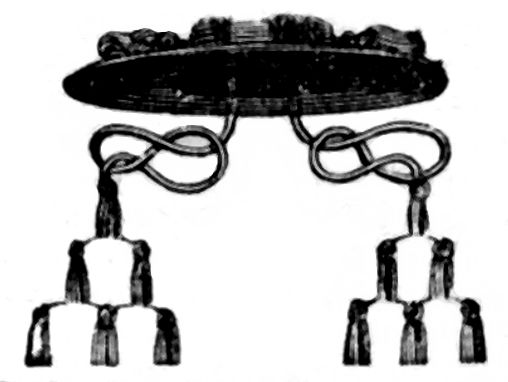
CARDINAL POINTS. North, south, east and west; subdivided into intermediate parts, as N.E. north-east; N.W. north-west, &c.; to the number of thirty-two points of the compass, each 11½ degrees.
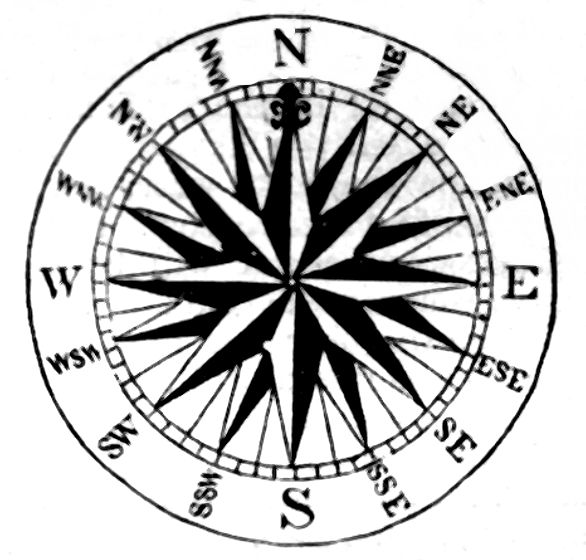
CLEANING CHINA AND EARTHENWARE. They should be washed in plenty of soap and warm water, rinsed clean in a second bowl of water alone, either warm or cold; should be then turned down to drain, and afterwards wiped dry with linen tea-cloths. Settlings of any liquid which have been suffered to dry up at the bottom of earthen vessels may be dissolved by a little pearlash and water, or with soda instead of pearlash.
CORNS (CURES FOR). 1. Place the feet for half an hour, two or three nights successively, into a pretty strong solution of common soda. The alkali dissolves the indurated cuticle, and the corn comes away; leaving a little cavity, which, however, soon fills up. 2. Soak ivy-leaves in vinegar during the space of fifteen days; then place a leaf, or part of one, over the corn; renew it every morning, and scrape off, with pumice-stone dipped in vinegar each time, the portion of hard skin which is detached. The vinegar acts by stimulating the absorbents; and the friction hastens their action. The pumice-stone and vinegar will equally answer the purpose if used every morning.
JANUARY. This month received the name of January from the ancient Romans. It was adopted and retained by the early Christians, and has ever since been computed as the first month of the year in all the calendars and almanacks of Christendom. It was not originally in the calendar of Romulus, but introduced into it by Numa Pompilius, in the place which had been previously assigned to March. It was so called from a double-faced deity, called Janus, who was presumed to look both into the old and new year, and in this month a great festival was held in his honour. At this period the Romans laid aside all old grudges. Clients and freedmen sent presents to their patrons, slaves to their masters, and friends and acquaintances to each other; whence the custom of New Year’s Gifts, still retained among us, was originally derived.
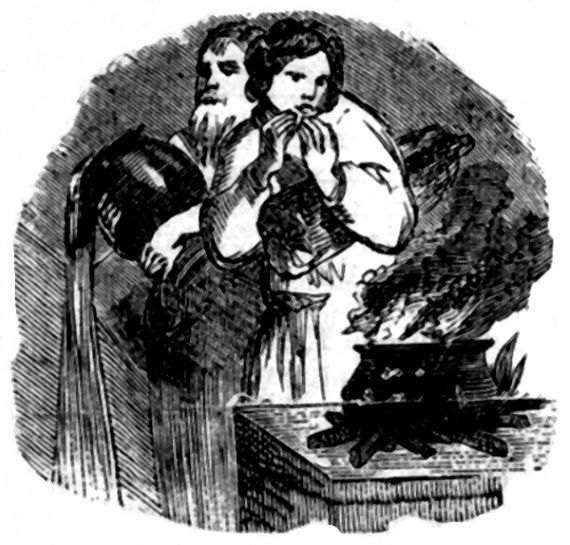
Among our Saxon ancestors the month of January was called Giulu aftera, which signified the second Goul, Giul, or Yule; or as we should say, the Second Christmas, on account of the month commencing during the joyous season of Christmas festivity, which, as Sir Roger de Coverley good-naturedly observed, could not have been contrived to take place at a happier period.
New Year’s Day. In most parts of England New-Year’s Day, like New-Year’s Eve, is celebrated with great festivity; while social enjoyment and friendly congratulations appear to be the order of the day. In some places, the Wassail Bowl is carried from door to door, in the manner of our Saxon ancestors, with singing and merriment. According to Brand, who quotes Thomas de la Moore and old Havillan, the terms was-haile and drinc-heil were the usual phrases of quaffing among the early English, and synonymous with the toast—“Come, here’s to you,” “I’ll pledge you,” etc.
The most perfect fragment of the “wassail” exists in the usage of certain domestic banquets and corporation festivals. The person presiding stands up at the conclusion of the dinner, and drinks from a flagon, usually of silver, with a handle on each side, by which he holds it; and the toast-maker announces him as drinking “the health of his brethren out of the loving cup.” This cup, which is the ancient wassail bowl, is then passed to the guest on his left hand, and by him to his next left-hand neighbour; and as the loving cup thus passes round to all the guests in their turn, so each stands up and drinks to the president. The ceremony was formerly accompanied with a wassail song—
“Here’s to ——, let sadness disappear,
God send our master a happy new year—
A happy new year, as e’er he did see—
With my wassailing bowl I drink to thee,” etc.
Twelfth Day, or Epiphany, which falls on the 6th January, or the twelfth from Christmas day, is usually kept up with great spirit in family parties, as it is usually presumed that with this night the general Christmas festivities are terminated.
The “Twelfth Night,” is the time when the ancient amusement of “choosing king and queen,” and other pleasantries are practised.
“The bean found out, and monarch crown’d.
He dubs a fool and sends him round
To raise the frolic when it’s low—
Himself commands the wine to flow;
Each watches for the king to quaff,
When all at once, upsprings the laugh;
They cry, ‘the king drinks!’ and away
They shout a long and loud huzza!”
Of the distinguished individuals born in the month of January, we subjoin the following:—
Joan of Arc, commonly called “the Maid of Orleans,” was born of humble parents at Domremi, a village on the borders of Lorraine, in 1402; but by her extraordinary talents and enthusiastic courage she was enabled to take the command of the French forces, and repeatedly defeated the English armies, which had previously been considered as invincible. After repeated victories she was at length taken prisoner in a sally, and cruelly burnt alive by the English, on the charge of sorcery, in the twenty-ninth year of her age.
Charles I. of England is generally styled “the Martyr,” from the melancholy end of his political career. He was the second son of James VI. of Scotland and I. of England, by Anne, daughter of the King of Denmark. On the death of his father, in 1612, he ascended the British throne; but his reign was a series of contests with the Parliament of England, until at length his regal authority was entirely overthrown, when he was condemned to death, and executed at Whitehall, on the 30th of January, 1649.
Copernicus was one of the most celebrated mathematicians and astronomers of the age in which he lived. He was born at Thorn, in Prussia, in 1473, and died in 1543. His greatest work was a Latin treatise “On the Revolutions of the Celestial Orbs,” in which, though strongly opposed to the prejudices of the age, he represented the sun as occupying a centre, round which the earth and the other planets revolve.
The name of James Watt is so intimately connected with our railway system, as the great improver if not the inventor of the steam-engine, that any lengthened notice of him would be supererogatory. He was born at Greenock, in Scotland, in 1736; and in 1774 entered into partnership with Mr. Bolton, of Birmingham, a firm which now stands pre-eminent as one of the largest and most important manufactories in the empire. He died in 1819.
RHUBARB. A valuable medicinal root, growing in China, Turkey, and Russian Tartary, of which that from Turkey is the most esteemed. Rhubarb is also cultivated in English gardens, and makes delicious spring tarts.
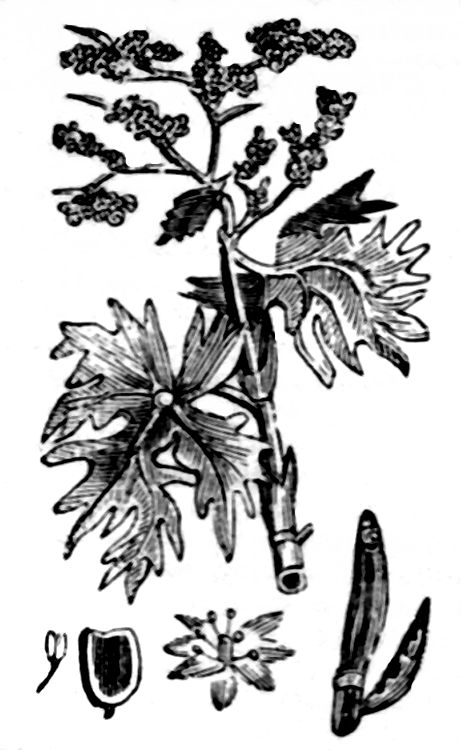
SATURN. A planet, 900,000 millions of miles from the sun, 79,000 miles in diameter, and period 30 years, or 10,746 days. Saturn has seven moons, and is also surrounded by a double ring, 205,000 miles in diameter, visible with moderate telescopes, and very beautiful. Saturn used to be considered as the outermost planet, but the Herschel has since been discovered at double the distance; and, considering the middle distance of the sun to the nearest fixed star, as fifteen millions of millions of miles, there are, probably, hundreds of planets undiscovered; for Herschel is not 2,000 millions of miles distant, so that the space beyond Herschel to the middle distance is 80 times as great as the distance of Herschel from the Sun.
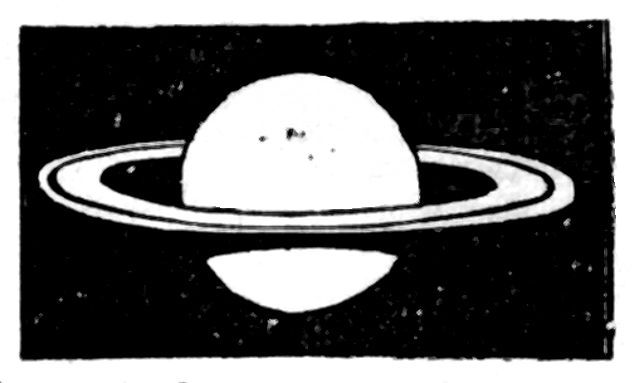
Saturn, in heathen mythology, the most celebrated of the Titans, and father of Jupiter, Neptune, Pluto, Juno, and Ceres. The reign of Saturn was called the golden age—because the age of agriculture; but it was followed by arts, refinement, ambition, wars, money, commerce, &c.
PUMP. An important machine for extracting the air from a pipe placed in water, which, by pressure of the air, rises 33 feet in the vacuum. The same principle is applied to extract air from a closed glass vessel, and it is then called an air-pump; a is a solid fitting piece drawn up from b, and leaving a vacuum from b to a, owing to which the air presses the water through the rising valve b, and the water rushing into the vacuum escapes at an orifice; a is then pushed down again when b closes, and on being raised again makes a new vacuum.
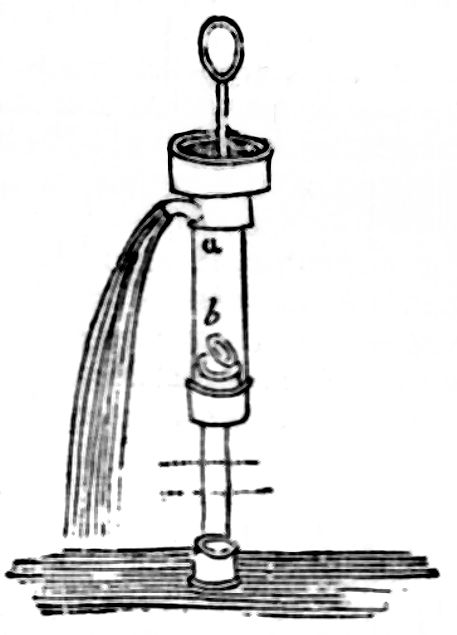
PUNCTUATION. The discriminating use of certain marks adopted to distinguish the clauses of a period, sometimes with reference to the sense, and at others to the grammatical construction. Thus, a full point (.) closes a perfect sentence; a colon (:) indicates an adjunct; a semicolon (;) distinguishes its principal part, and a comma (,) parts subordinate to the semicolon. A sentence, which may include several periods, terminates a branch of the subject or argument. A dash (—) within a period, calls for attention to what follows, and a series of dashes indicates the energetic feeling of the writer. A question is indicated by (?); an exclamation by (!); and it is sometimes convenient to include a collateral circumstance in a parenthesis ().
ALLSPICE, OR PIMENTO TREE. A native of Mexico and the West Indies. The flavour and fruit have an highly aromatic fragrance, and the tree is about 30 feet in height, and two in circumference.
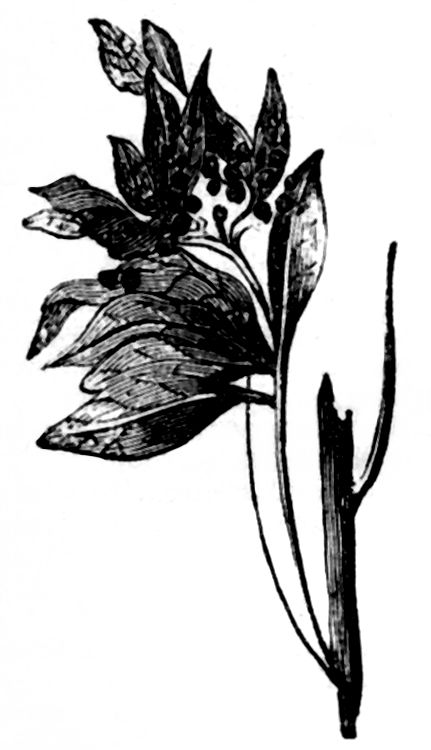
SABBATH. The seventh day, or Saturday, kept by the Jews as a day of rest, in conformity to the fourth commandment of God, commencing on Friday at sun-set, and ending on Saturday at sun-set. Christians, in general, disregard the Sabbath of the seventh day, and keep Sunday, or the first day of the week, as a festival, in most countries, because Christ rose on that day, and in continuance of the practice of the early Christian Church. A sabbath, or weekly day of rest, is an institution, on whichever day it is kept, highly conducive to the happiness and comfort of mankind, and ought by all good men to be respected.
GUMS AND LOOSE TEETH (TO STRENGTHEN AND FASTEN). Dissolve an ounce of myrrh as much as possible in a pint of port wine, and the same quantity of oil of almonds; wash the mouth with this fluid every morning. This is an excellent remedy against worms in the teeth.
BAGPIPE. A musical instrument, consisting of a leathern bag, and pipes for admitting and ejecting the air. It is an instrument of great force, not pleasing to those who are unused to it, but much esteemed by the Scots and Irish.
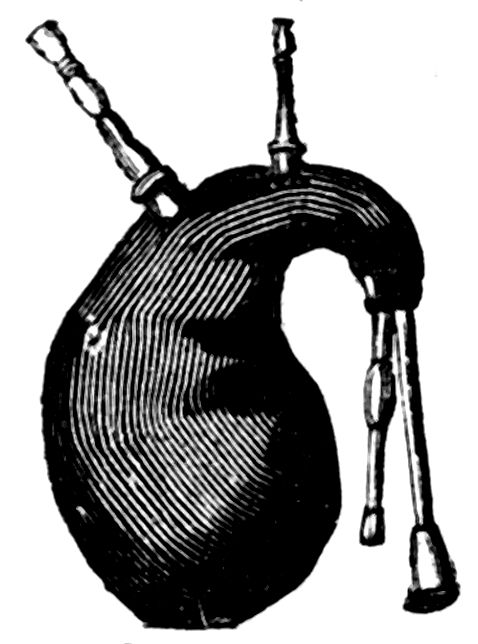
The bass part never varies its tone, and, therefore, is called the drone, and the compass of the treble part, or chanter, is very limited.
BEANS. This engraving is introduced to show the seed of vegetables. The left-hand figure is the seed whole, and the right hand is a section displaying the germ of the future plant within the seed. The substance of the seed is its first means of nutriment, till it burst through the skin or arillus, and finds nourishment in the soil and air.
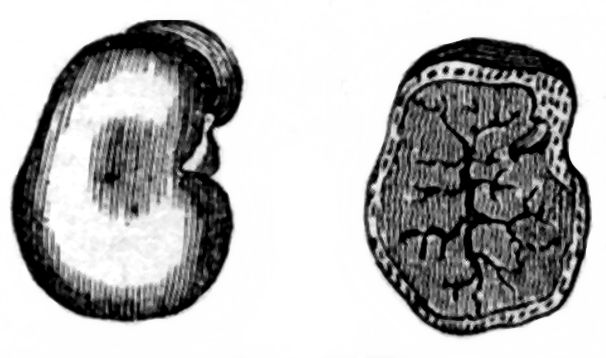
The black spot, or hilum, on a bean, is merely the part by which it was attached to the pericardium or pod. The germ is called corculum, or heart; the side lobes are the cotyledons, or first leaves. When the seed has a downy appendage it is called the coronula.
CHILBLAINS consist of a peculiar inflammation of the skin of parts exposed to sudden alternations of temperature. They occur on the nose, ears, hands, but most frequently on the feet. The reason why they occur more frequently on the hands and feet is, because persons are apt, directly they come in from the frosty air, to warm those parts at the fire. The face does not got warmed in the same manner, or its skin would be equally liable to chilblains.
In this inflammation, which constitutes chilblains, the sides of the small blood-vessels become paralyzed, and losing their contractility, are dilated by the pressure of the blood within them. If the inflammation be not abated, that is to say, if the little blood-vessels are not restored to their original size, and to their natural contractility, they burst, and matter will be formed, or mortification may ensue. This contractility depends upon proper nervous action in those small fibres which give life to the sides of the hair-like vessels, or small blood pipes. Any sudden shock of cold or heat deprives these nerves of their power, and induces a local paralysis. The change from cold to heat oftener produces this shock than that from heat to cold; but either sudden alternation will produce chilblain. It need hardly be said that the nerves of persons in low states of health, persons of scrofulous habits, and young persons in whom the tissues are delicate, are more liable to be locally paralyzed, in the manner described, than those persons of robust constitution having a large quantity of vitality to resist such attacks. Hence we find such invalids, scrofulous persons, and children, more liable to chilblains than others. The liability to chilblain is often an indication of a low state of health, and want of healthy vital action in the system.
When the nature of chilblain is understood, the mode of prevention will be at once perceived, viz.,—1st, to protect the parts most liable to the attack (hands and feet) from sudden alternations, either from cold to heat, or from heat to cold. 2ndly. To keep the constitution in such a healthy state as to make all parts possess such vitality as to be able to resist slight alternations in temperature.
1. Protection of the Parts. Those substances which are good non-conductors of heat are the best coverings. Woollen stockings or socks, and warm boots and shoes, come under this category. Light shoes and stockings should be worn in the house, or the feet will become so accustomed to a high temperature that they will be more sensitive to cold. Warm leather gloves, being impervious to wind, are better for the hands than woollen ones, through which the dry frosty air is apt to pierce and chap the hands. Tight wristbands, tight garters, and boots which lace or button tightly about the ankles, must be avoided, because, by preventing the proper circulation of the blood in the hands or feet, they diminish the vitality of the part, and produce an unnatural pressure on the coats or walls of the small blood-vessels. The most frequent cause of chilblain is the warming of numbed hands or feet at the fire. This habit must, of course, be relinquished entirely. Gutta-percha soles, by preventing the wearers from warming their feet at the fire, have saved hundreds from the attacks of chilblains; but such soles should not be worn in the house. After walking in the snow, or in frosty weather, the coverings of the hands and feet should be removed. Dry stockings should be put on after gently rubbing the feet with the pair which has been taken off. The fresh pair must not be warmed. It is well to wear woollen stockings when out, and cotton stockings when indoors. The use of excessively hot water when the feet are cold, has produced mortification; but the frequent washing of the feet in tepid water and soap, restores the powers of the nerves in the parts, and renders them less likely to be affected by those alternations of temperature to which they are liable to be exposed.
2. Constitutional Means of Prevention. Persons in robust health are less liable to take infection, suffer less from injuries, and when wounded, are possessed of greater powers of nature for reparation than partial or confirmed invalids. The cold of winter ought to stimulate us to exertion; and exercise is especially necessary to health in winter. Too warm clothing of the body enervates and debilitates; only sufficient clothing, therefore, should be worn. Rooms in winter are often made hotter than the air of summer; this, and bad ventilation, is another blow to constitutional strength. Enough, however, has been said on this subject to indicate the necessity of general attention to the health in persons who are excessively liable to chilblains.
3. Treatment. When the inflammation called chilblain has attacked any part, it should be considered whether it is a mere local affection, or whether it shows a constitutional state, which renders the hands or feet, or both, more liable to the attack than those parts ought to be. If hands and feet are both attacked in several spots at the same time, and this without any very evident cause, constitutional treatment is pointed out, in addition to the use of remedial agents locally; where, however, there is only a single spot on the hands or feet, and a cause (such as warming the feet at the fire) is remembered, only local treatment is necessary. The hands and feet enjoy different conditions, however, and require slightly different management. The treatment, therefore, resolves itself into three parts:—
A. Constitutional.
B. Of the hands.
C. Of the feet.
(A.) Constitutional Treatment. Aperient medicines may be used to relieve the overloaded blood-vessels, and lessen the pressure upon the coats of the capillaries, or hair-like blood pipes of the parts affected. After this has been done, small doses of tartrate of antimony wine (which seems to constringe the enlarged vessels) may be taken with advantage. This treatment (without local means) acts as a sort of charm, and relieves full crops of chilblains on hands and feet. A drachm of the wine may be added to half a pint of water, in which a drachm of saltpetre has been dissolved. Dose: for an adult, one or two tablespoonfuls every four hours; for a child, one or two teaspoonfuls three times a-day. It should not be given in such doses as to produce vomiting. The head, neck, and chest, should be washed in cold water every morning, and brisk exercise taken at regular hours. Persons of a scrofulous habit should be particularly attentive to their general health in winter. The addition of salt to the washing water is recommended in their cases. It is not an uncommon practice for persons, after exposure to cold, to drink hot elder wine, or hot negus, or warm spirits and water; all such measures, having a tendency to produce rapid and violent reaction, are likely to render persons liable to chilblain.
(B.) Treatment of the Hands. Wash in cold water every three hours, and lather well with Windsor soap. When the hands are nearly dried with the towel, pour a little eau-de-Cologne, or milk of roses, into the palm of one hand, and rub it over the whole of both; lastly, polish with the towel till every part glows with warmth, and is so completely dry, that the lint from the towel does not stick to the skin.
(C.) Treatment of the Feet. All the plans for prevention are curative. Chilblain in the feet often assumes a more serious form than in the hands, and the application of cold water is inadmissible, especially in the case of females. The three degrees of chilblains in the feet are:—1st. The skin is red in patches, and slightly swelled, with more or less itching or tingling, with slight tenderness. 2nd. Small blisters appear, surrounded by a livid skin. 3rd. Ulceration and mortification take place. For the first two cases, which are most common, the frequent application of tepid water, (using plenty of soap,) gives relief. A leech is a useful remedy to unload the overcharged blood-vessels; or the part may be pricked with a needle, or punctured with a lancet; in such cases a soft bread-and-water poultice should be kept on during the night, applied warm, so as to encourage the flow of blood.
If this plan is objected to, the application of the following liniment is likely to be beneficial. Take of common soap liniment, or opodeldoc, six drachms; of compound tincture of camphor, and tincture of cantharides, each one drachm. If there are no blisters, a little of this must be rubbed in sharply with the hand; but where vesications appear, it must be applied with a feather, and care must be taken not to break the skin.
MEERSCHAUM. The appearance of this substance, before its manufacture, somewhat resembles foam. It is stated to be found floating in the sea of Azof, and on the shores of Samos, and Negropont. From either of these circumstances its name, meaning “sea-foam,” may have been derived. It consists of hydrate of magnesia, with silex, carbonic acid, and water. It is dug from the earth in several places in Turkey, where it is used as soap. The tobacco-pipes are made in Turkey by a process analogous to that for making potteryware, and imported into Germany, where they are prepared for sale by soaking them first in wax, then in tallow, and finally polishing them with shave-grass, or crape. The latter is used to remove scratches or imperfections from those injured in packing. Artificial meerschaum is made with fine plaster of Paris baked for a few hours, and thrown, while warm, into melted wax, or linseed oil.
CARPETS (MANAGEMENT OF). Previous to laying down a carpet, cover the joints of the floor with stripes of brown paper; this will prevent the dust from rising between the boards. Take up your carpets frequently, and have them shaken and afterwards drawn along the surface of a lawn or meadow, to remove the dust. If a carpet is kept down too long the dust passes through it, and assists to wear it out by grinding the under surface. If you want to clean a carpet well, put one-third of a bullock’s gall into a pint of water, and scrub the carpet with it, after it is nailed down; if the carpet is not nailed down it will shrink. If you are not particular about the pattern of your carpet, or, in fact, more disposed to study its durability than ornamentation, choose one with small figures in it, because the two webs are closer interwoven than in the large patterned carpets.
ANIMALCULÆ. Animals so small as not to be immediately perceptible to the naked eye. Their origin is unknown, for they rise in substances which did not previously contain them, and their numbers and varieties are infinite. Their existence is generally, perhaps always, preceded by that process of atoms called fermentation. Some have been discovered, not the 10,000th part of an inch long, so that a million of them might be contained in a cubic inch, yet perfect in their parts, and depending on air.
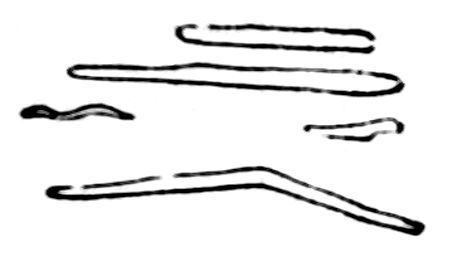
Vinegar Eels.
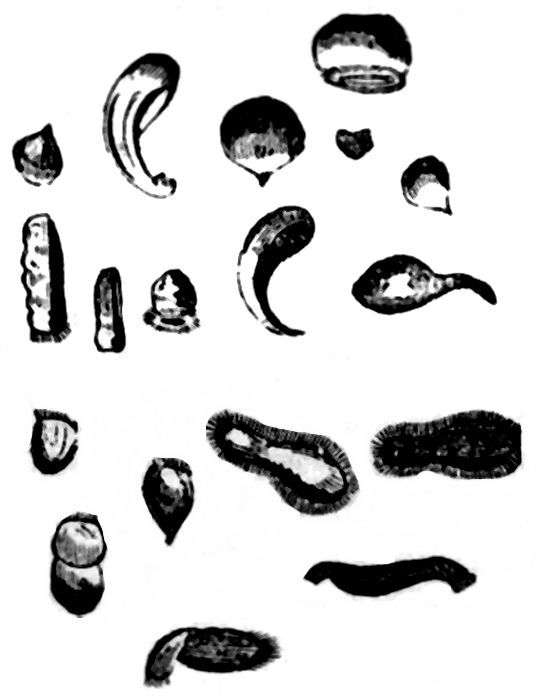
Hay-tea Eels.
HAIR BRUSHES. The use of a moderately hard brush for the head keeps up a healthy circulation, and is on every account to be preferred to the employment of a comb. The scurf, as it is called, which collects on the head from neglect, arises not from, at least only in a very small degree, the dead cells or scales of the scalp being thrown off, but from the evaporation and hardening of the secretions which are poured out on the scalp. Washing is much less effectual in removing this incrustation, in consequence of its greasy nature, than brushing.
PENCIL-MARKS (TO PRESERVE). Pencil-marks may easily be prevented from rubbing out by dipping the paper into a dish of skimmed milk; then dry, and iron it on the wrong side. In ironing paper, do not let the iron rest a moment, as it will leave a crease, or mark, but go over it as rapidly as possible.
BEETLE, OR SCHARABÆUS. A genus of insects furnished with shelly wing-cases, and of which there are several species, all perfectly harmless, and in general very timid and sagacious.
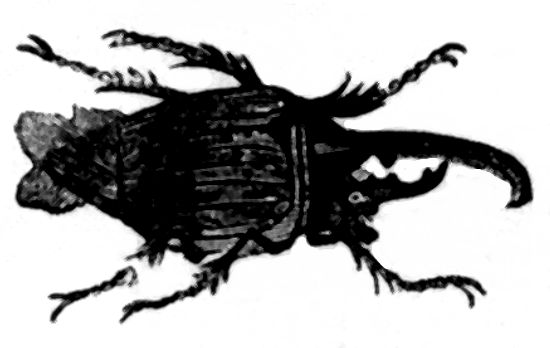
COMPLEXION (TO IMPROVE THE). Infuse wheat-bran, well sifted, for three or four hours in white wine vinegar; add to this five yolks of eggs and a grain or two of ambergris, and distil the whole. When the bottle is carefully corked, keep it for twelve or fifteen days before you make use of it.
Or,—Dissolve flowers of sulphur in milk, and strain clean. When used, take care not to disturb any sediment of the sulphur that may remain.
TEETH (TO MAKE THEM WHITE). Take gum tragacanth one ounce; pumice-stone, two drachms, gum arabic, half an ounce; and crystals of tartar finely powdered, one ounce; dissolve the gums in rose-water, and add to it the powders; form the whole into little sticks, which are to be dried slowly in the shade, and afterwards kept for use.
BREATH (TO SWEETEN THE). Chew every night and morning a clove, a piece of Florentine orris-root, about the size of a small bean, or the same quantity of burnt alum.
Or,—Roll up a little ball of gum tragacanth, scent it with some odoriferous essence or oil, and hold it in the mouth. A little musk may be added to the ball while rolling up, where that perfume is not disagreeable.
BLOWPIPE. A tube through which air is blown, and more oxygen brought in contact with flame; and, latterly, it has been contrived to pass a jet of oxygen and hydrogen through it, when it is called the gas blow-pipe, the heat of which disperses and melts the most refractory substances.

BATTERING-RAM. A machine made use of by the ancients to effect breaches in fortifications. Sometimes they were swung on ropes, and at others driven by men, who were protected from the besieged by suitable coverings.
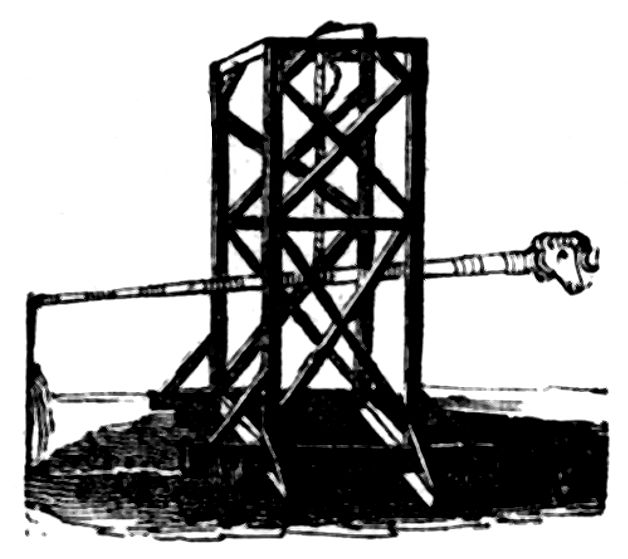
IMPRESSIONS (TO COPY.) To take an exact mould of any coin, medal, embossed or stamped paper, or in fact, of any device, raised or imprinted (that is, sunk on paper), cut a piece of cardboard, say to the breadth of half an inch, with which form a ring just the dimension of the impression to be taken; then pour within the said ring, which surrounds the spot, melted fusible metal; the carding will prevent the metal from running away, and in a few minutes it will cool and take the impression, without the slightest injury to the paper from which it was taken. The impression, &c., taken will be the same as the original but reversed. Fusible metal is a compound of eight parts of bismuth, five of lead, and three of tin, which liquefies at 212 degrees, or the same temperature as boiling water, and below that if one part of quicksilver be added.
ATTRACTION (ELECTRICAL). A term used to express the phenomena by which light bodies leap towards an electrified body; and the principle has been applied to effect the amusing experiment represented in the engraving.
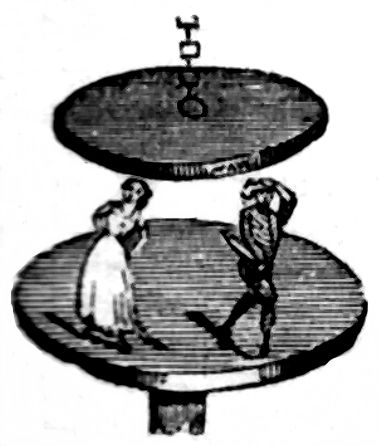
The upper plate has been electrified, and two light figures have been placed between that plate and another plate; and for some time they jump and dance from one plate to another in a very surprising manner. The cause is not any principle of attraction or repulsion, but arises from the atoms of air which lie between the two plates being disturbed by what was done, when the upper plate was what was called electrified; whereas, in truth, it was the stratum of air lying between the two plates which was then disturbed, the plates themselves being mere boundaries of that stratum; and the effort of the atoms on the two sides of the stratum to return to their regular natural position, being greater than the weight of the light bodies, the light bodies yield to the force, and jump from side to side of the stratum, till the original natural position of the atoms of the stratum of air is restored.
ANTS (WHITE) inhabitants of East India, Africa, and South America, far exceeding in wisdom and policy, the bee, the ant, or beaver. They build pyramidal structures, divided into chambers, magazines, &c., as represented in the annexed engraving. These hills, or houses, are so strong, as to bear four men to stand upon them, and in the plains of Senegal they appear like villages. Their social economy is of the most regular kind, and large masses of them act as soldiers, trained for offence and defence, and their assault is so vigorous, that even men and large quadrupeds often become their victims.
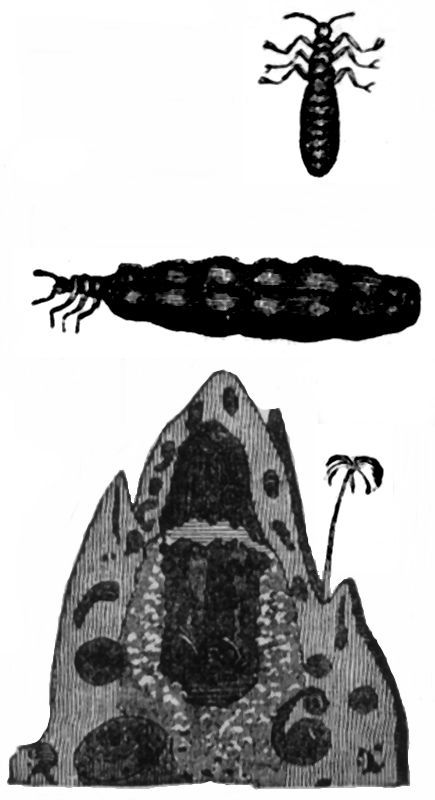
Nests of the Termites, or White Ants.
COOKERY (RUDIMENTS OF). The foundation of all good cookery consists in preparing the meat so as to render it tender in substance, without extracting from it those juices which constitute its true flavour; in doing which, the main point in the art of making soups, and made dishes of every sort, which should form so large a portion in every well-ordered dinner, as well, also, as of cooking many of the plain family joints, is boiling, or rather stewing, which ought always to be performed over a slow fire. There is, in fact, no error so common among English people as that of boiling meat over a strong fire, which renders joints hard and partly tasteless; while, if simmered during nearly double the time, with less than half the quantity of fuel and water, and never allowed to “boil up,” the meat, without being too much done, will be found both pliant to the tooth and savoury to the palate.
For instance: the most common and almost universal dish throughout France is a large piece of plainly-boiled fresh beef, from which the soup—or “potage,” as it is there called—has been partly made, and which is separately served up as “bouilli,” accompanied by strong gravy and minced vegetables, or stewed cabbage. Now this, as constantly dressed in the French mode, is ever delicate both in fibre and flavour; while, in the English manner of boiling it, it is almost always hard and insipid. The reason of which, as explained by that celebrated cook, Carême, who superintended the kitchen of his Majesty George IV., is this:—“The meat, instead of being put down to boil, as in the English method, is in France put in the pot with the usual quantity of cold water, and placed at the corner of the fire-place, where, slowly becoming hot, the heat gradually swells the muscular fibres of the beef, dissolving the gelatinous substances therein contained, and disengaging that portion which chemists term ‘osmazome,’ and which imparts savour to the flesh—thus both rendering the meat tender and palatable, and the broth relishing and nutritive; whilst, on the contrary, if the pot be inconsiderately put upon too quick a fire, the boiling is precipitated, the fibre coagulates and hardens, the osmazome is hindered from disengaging itself, and thus nothing is obtained but a piece of tough meat, and a broth without taste or succulence.”
Meat loses, by cooking, from one-fifth to one-third of its whole weight. More is lost by roasting than by boiling meat.
The use of skewers in joints should be avoided as much as possible, as they let out the gravy; twine will answer better.
To Remove the Taint of Meat, wash it several times in cold water; then put it into plenty of cold water, into which throw several pieces of red-hot charcoal. If you fear meat will not keep till the time it is wanted, par-roast or parboil it, that is, partly cook it; it will then keep two days longer, when it may be dressed as usual, but in rather less time.
When Meat is Frozen, it should be brought into the kitchen, and laid at some distance from the fire, early in the morning; or soak the meat in cold water two or three hours before it is used: putting it near the fire, or into warm water, till thawed, should be avoided.
Meats become tenderer and more digestible, as well as better flavoured, by hanging. In summer, two days is enough for lamb and veal, and from three to four for beef and mutton. In cold weather, the latter may be kept for double that time.
Legs and shoulders should be hung knuckle downwards.
Articles that are likely to spoil should not be kept in, or laid upon wood.
Warm, moist weather, is the worst for keeping meat; the south wind is very unfavourable, and lightning very destructive; so that after their occurrence meat should be especially examined.
Boiling. Boiling is the most simple of all processes of cooking. Regularity and attention to time are the main secrets—indeed, these are the main secrets of all successes.
Much less heat is requisite to keep liquids boiling in copper and iron saucepans than in those made of tin.
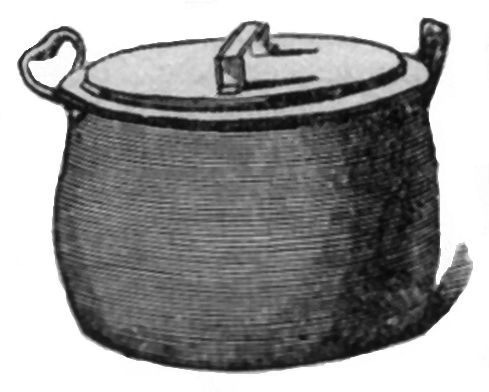
Boiling Pot.
There is frequently a great waste of fuel in cooking, which arises from making liquids boil fast, when they only require to be kept slowly boiling. Count Rumford (the inventor of the Rumford stove) states that more than half the fuel used in kitchens is wasted in the above manner.
It is a sad waste to put fuel under a boiling pot. There is a degree of heat in water called the boiling point; and all the coal or wood in the world cannot make water hotter in an open vessel: it can but boil. By this waste, the cook not only loses time, but spoils the cookery.
The average time for boiling fresh meat is from eighteen to twenty minutes for every pound; thus, a joint weighing six pounds will require from one hour and three-quarter to two hours boiling. Salted meat requires rather more boiling and water; fresh killed meat longer time; and all meats longer in cold than in warm weather.
It is, however, better to be guided for time, by the thickness of the joint, than by its weight.
Dried or salted fish and meats require soaking in cold water before boiling.
Meat and poultry will lose their flavour and firmness, if left in the water after they are done; as will also fish, which will break to pieces.
The water in which fish, meat, or poultry has been boiled should be saved; this pot-liquor, as it is called, may be made into soup.
Slow boiling is very important for all meats to ensure their tenderness; fast boiling always makes them hard and tough, less plump, and of darker colour, than when they are boiled gradually.
Skimming the pot will alone ensure the good colour and sweetness of the meat; a little cold water and salt will aid in throwing up the scum: milk put into the pot does good in few cases only; and wrapping in a cloth is unnecessary, if the scum be carefully removed.
The lid of the saucepan should only be removed for skimming; and before taking off the lid, be careful to blow from it any dust or blacks from the fire or chimney.
The joint should always be covered with water; above this quantity, the less water the more savoury will be the meat.
In some few instances, however, it may be necessary to boil the articles in a much larger quantity of water; a quart of water is mostly a good proportion to a pound of meat.
If meat be put into cold water, it should be heated gradually, so as not to cause it to boil in less than forty minutes; if it boil much sooner, the meat will shrink and be hardened, and not so freely throw up the scum.
Four skewers, or a plate, inside downwards, should be laid on the bottom of the saucepan, especially for large joints and puddings; so that they may be equally done, and escape burning or adhering to the saucepan.
When a pot boils, remove it nearly off the fire, but let the lid remain on: a very little heat will then keep up the boiling.
The time of boiling should be reckoned from the time bubbles begin to rise on the surface of the liquid. As the boiling continues, the water will evaporate, and in some cases it may be requisite to fill up the saucepan with boiling water.
Roasting. No success can be achieved in cookery without good management of the kitchen fire: roasting especially requires a brisk, clear, and steady fire, if made up close to the bars of the grate.
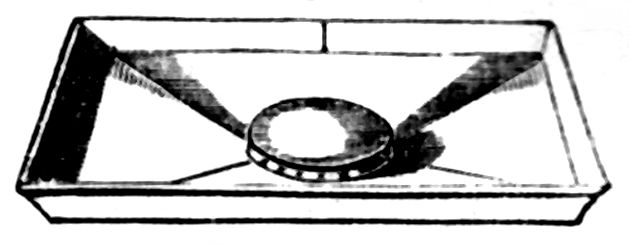
Dripping Pan.
The spit being wiped clean, the joint to be roasted should be carefully spitted even, and tied tight; and if it will not turn round well, balance-skewers, with leaden heads, should be used; for if the meat be not evenly spitted, it will probably be burned on one side, and not done on the other. Avoid running the spit through the prime parts of joints.
A leg of mutton should never be spitted, as the spit lets out the gravy, and leaves an unsightly perforation just as you are cutting into the pope’s eye.
Make up the roasting-fire three or four inches longer than the joint, else the ends of the meat will not be done.
In stirring the fire, be careful to remove the dripping pan, else dust and ashes may fall in. On no account let the fire get dull and low, as a strong heat is requisite to brown the meat.
A thin joint requires a brisk fire; a large joint, a strong, sound, and even fire. When steam rises from the meat, it is done.
Large joints should be put at a moderate distance from the fire, and gradually brought nearer; else the meat will be overdone halfway through the joint, and be nearly raw at the bone.
Such meat as is not very fat should have paper placed over it, to prevent it from being scorched.
Do not sprinkle the meat with salt when first put down, as the salt draws out the gravy.
Old meats require more cooking than young. The longer the meat has been killed, the less time is required to roast it. Very fat meat requires more time than usual.
The general rule is to allow fifteen minutes to a pound for roasting with a good fire, and ten or twenty minutes over, as the family like it well done or not.

Basting Ladle.
Baste the meat first with fresh dripping, and then with its own fat or dripping: and within the last hour of roasting, take off the paper, and sprinkle the meat with salt and flour, to brown and froth it; but some cooks dredge the meat with flour earlier, so that it may imbibe the gravy, a practice which should be specially avoided.
The spit should be wiped dry immediately after it is drawn from the meat, and washed and scoured every time it is used.
Perfection in roasting is very difficult, and no certain rules can be given for it, as success depends on many circumstances which are continually changing: the age and size (especially the thickness) of the pieces, the quality of the coal, the weather, the currents of air in the kitchen, the more or less attention of the cook, and the time of serving, are all to be considered. Hence, epicures say of a well-roasted joint, “It is done to a turn.”
Roast meats should be sent to table the moment they are ready, if they are to be eaten in perfection.
Broiling. To broil well requires a brisk, clear fire, proportioned to the article to be broiled; for example, mutton chops require a clear rather than a brisk fire, else the fat will be wasted before the lean is warmed through; but for a beef steak, the fire can neither be too brisk nor clear, if the gridiron be placed at the proper distance. Fish requires a steady fire; as also does underdone meat.
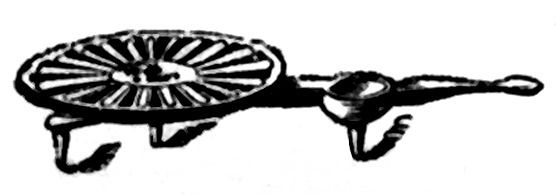
Revolving Gridiron.
Much, however, depends on the substance of the article to be broiled: if it be thick, it must be placed at a greater distance, at first, to warm it through; if thin, the fire must be brisk, to ensure a good colour.
The gridiron should be wiped clean after it has been used, so that the bars may be kept bright on the top; they should be allowed to get hot before the article is laid on them, but not too hot, else they will burn the meat or fish: the latter especially. To prevent this, the bars should be rubbed with fat.
A charcoal fire is best for broiling.
To prevent the fat dripping into the fire, set the gridiron aslant.

Beef Steak Tongs.
For turning the broiling article use tongs, as a fork will let out the gravy. When the article is done, it will feel firm if touched with the tongs: by no means cut the meat to ascertain if it be done, as that will let out the gravy.
Frying. Frying is, “to scorch something solid in fat, or oil,” or butter. Lard, clarified suet, or dripping, is well adapted for fish, eggs, potatoes, and meat generally. Olive oil is much used for fish; and the same oil will serve for more than one frying. Butter is used, but it is not as well adapted for frying as either of the other articles.
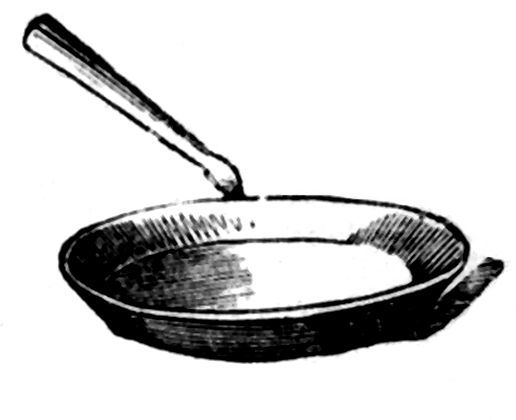
Frying Pan.
Be careful that the fat or oil is fresh, clean, and free from salt, else what you fry in it will be of bad colour and flavour; salt will prevent it from browning.
Fat or oil, to be used again, should be strained through a sieve before it is set aside.
Fat becomes richer from having meat fried into it, and may be used repeatedly; but the fat that has been used for fish cannot be used again for meat.
The fat must have left off bubbling and be quite still before you put in the articles.
To prepare crumbs for frying, dry thoroughly in a warm oven, or before the fire, any waste pieces of bread; then pound them in a mortar and sift them, and put them away till wanted. This is much better than grating bread as it is needed, or using oatmeal, &c.
When you wish fried things to look as well as possible, do them twice over with egg and crumbs.
If eggs be very dear, a little flour and water may be substituted for them in preparing fish to fry.
In frying use a slice to lift the articles in and out of the pan, and drain them.
To make batter for frying: melt two ounces of butter in a little warm water, and pour it upon half-a-pound of flour; stir it, and add water enough to form a batter, thick enough to adhere to whatever is put into it; but it should run freely; add some salt and the beaten whites of two eggs.
A small shallow frying pan is very useful to fry articles to be stewed: this method differs from common frying, as it only requires butter enough to keep the article from sticking to the pan and burning.
The fire for frying should be free from smoky coal, and be sharp and even. Charcoal makes the best frying fire.
The fat should be carefully drained from all fried articles; indeed, they should be so dry as scarcely to soil a cloth. Fish is best drained by wrapping it in soft whitey-brown paper, by which it will so dry as not to soil the napkin upon which it is served.
Stewing. All articles to be stewed should first be boiled gently, then skimmed and set aside in an even heat: on this account charcoal makes the best fire for stewing. All stews, or meat dressed a second time, should be only simmered, as the meat should only be made hot through.
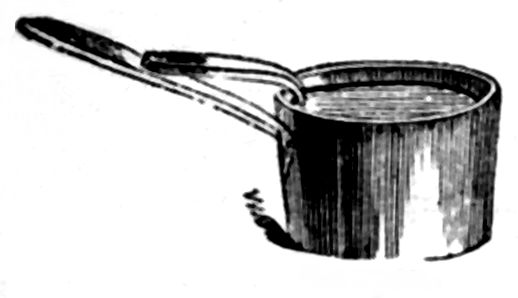
Stewpan.
A stewpan is the most advantageous vessel in which stews, hashes, soups, or gravies can be made; indeed, for all purposes of boiling, a stewpan is preferable to a deep saucepan, as, in the former, the articles are exposed to more even heat than when they are placed one upon another in the saucepan, and are likely to be broken in stirring.
Danger from Copper Saucepans. The precise danger from the use of copper saucepans, or stewpans, imperfectly tinned, is far from rightly understood. It appears that the acid contained in stews and other made dishes, as lemon-juice, though it does not dissolve copper by being merely boiled in it a few minutes, nevertheless, if allowed to cool and stand in it for some time, will acquire poisonous matter, as verdigris, in the form of a green band, or crust, inside the vessel. It has likewise been proved that weak solutions of common salt, such as are daily made by adding a little salt to boiling vegetables, fish, or meat, act powerfully on copper vessels, although strong solutions or brine would not affect them. It is, however, in vain to hope that cooks will attend to the nice distinctions by which copper stewpans may be rendered safe; the general advice given by prudent physicians is, therefore, against their use at all.
The kettles in which the soups are made should be well tinned, and kept particularly clean, by being washed in hot water and rubbed dry before they are put away. If they are not kept well tinned, the taste as well as the colour of the soup will be liable to be affected by the iron; and if the soup-kettle be made of copper, and the tinning not quite perfect, everything cooked in it will be more or less poisonous, as everything which is sweet, salt, or sour, extracts verdigris from copper.
Baking. Baking is the least advantageous mode of cookery; for by it meat loses about one-third of its weight.
Iron ovens are ill-adapted for baking meat or meat-pies; fruit-pies, pastry, and puddings, may, however, be baked in them.
BUTTERFLY, OR PAPILIO. A genus of insects, of which there are many hundred species. Curious and elegant as they are, this is the last state of the varied existence of the same creature; first in the grub, or caterpillar form, in which it emerges from the eggs laid by a former generation: the grub then passes into an insensible state, called the chrysalis or aurelia, in which it continues some weeks or months, having neither legs, wings, nor motion: at length the case is burst, and moths and butterflies emerge, which pass a short and fluttering existence, during which they lay eggs for future successions of the same kind.
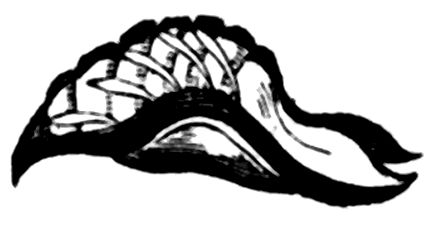
Grub of the Butterfly.
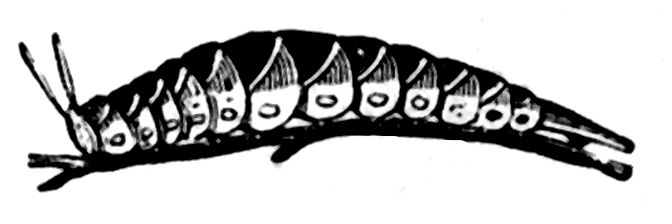
Chrysalis of the Butterfly.
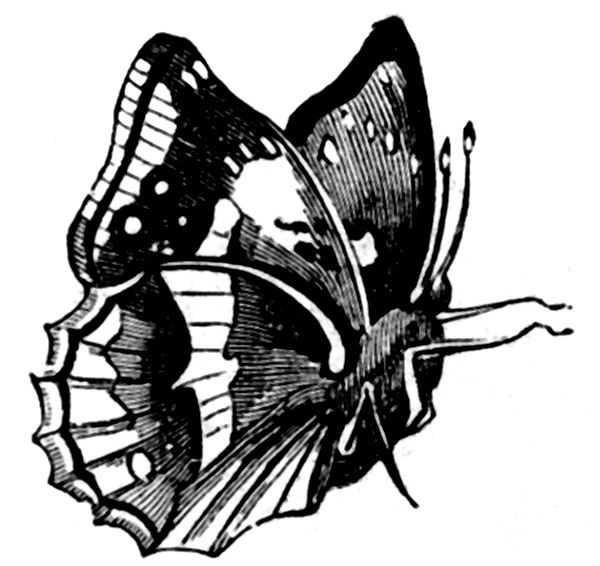
Butterfly.
NAILS (CARE OF). The care of the nails adds greatly to the beauty of the hand. The white spots you complain of are occasioned by injury, a blow, &c., and will gradually disappear at the end. The nails should be well brushed with soap and water, and, when quite dry, with lemon-juice, to be washed off again with clean water. Pare back the scarf-skin at the root, but never cut it, or you will have nail springs, as they are called,—an untidy, and sometimes very painful appendage to the root of the nail.
POTICHOMANIE; OR IMITATION PORCELAIN. The art of imitating old china and porcelain of various descriptions is one which has recently been introduced into Paris.
The result of this work is, what it professes to be, an excellent imitation of every sort of porcelain—Sèvres, Etruscan, Japanese, Assyrian.
The work, when properly performed, is extremely beautiful, and wonderfully simple. No one can fail to succeed in it who studiously follows the rules we shall lay down.
The Materials required for Potichomanie are—
Glass Vases.
Sheets of paper printed in various designs.
Varnish.
Dissolved gum-arabic.
Prepared colours.
Paint brushes.
A packet of gold powder.
Essence of lavender, or turpentine; and
Fine scissors.
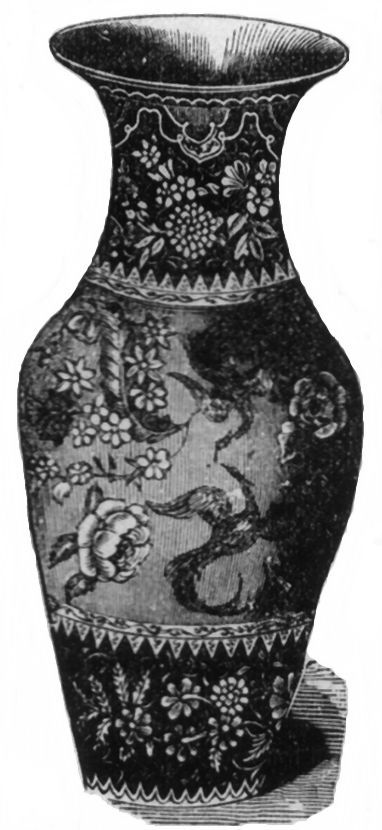
The vases are of plain glass, in various forms, some with and some without lids. At present these vases are too often inelegant in shape, as from the nature of the work it is necessary to have the neck large enough to admit the hand. Thus the graceful shape of the Etruscan vase is not yet achieved in Potichomanie. We think, however, that ere long we shall be able to devise some plan to remedy what we cannot help regarding as a great defect.
The vases are of various shapes and sizes, as seen in our engraving.
The sheets of paper are coloured and printed in various designs. Some have figures and other subjects in the graceful Etruscan style; others exhibit dragons, trees, flowers, birds, and similar things in Chinese design; the researches of Mr. Layard have furnished us with eccentric Assyrian figures and decorations, and again there are medallions, and other subjects exclusively French, besides borders of all these different sorts.
The first operation is to cut out the figures, birds, &c., with extreme care; and we may observe, en passant, that beginners should always select such subjects as are tolerably compact. Running patterns with the various parts connected only by long stems, and flowers, with the pistil and stamens projecting, are considerably more difficult to arrange than simpler patterns. Every part of the ground of the paper must be cut out, such as the space between the body and the bended arm, in any figure where that occurs; so that, in fact, nothing is left but what would be done by the brush, were the vase to be a painted one.
Now lay all the materials on the table, including a clean towel, some soft old linen, and a small basin of warm water.
Fold a sheet or two of blotting-paper into several thicknesses, lay one of the subjects on it, and, with one of the brushes cover the painted side of it with gum in every part. Of course, your vases have been previously thoroughly washed, and well-dried. Put the paper inside the glass, rubbing down every part with your nail, so that no air may be left between the paper and the glass, as this would ruin the work. Proceed in this way with each figure, flower, or other design, until sufficient patterns are placed on the glass; borders may be added or not, according to the fancy, but they must always be of a character to harmonize with the rest of the design.
When all these are perfectly dry, examine them to see that no air-bubble is left. Then add a coating of gum at the back of the figures, without touching the glass. Let this also dry. Then a coat of varnish must be added, and this also must be done without touching the glass.
After thoroughly drying this, remove with a wet cloth any spots of gum or varnish that may have fallen on the vase, and mix the colouring with sufficient essence of lavender to make it run freely. Pour the liquid into the vase, which you will twist round and round until it has adhered to and completely coloured every part. Pour the remainder out, let it dry, and then add another coat of varnish. The vase is then completed.
It is asserted that a vase so prepared will hold water. It may be; but we do not counsel the trial. An inner vessel, filled with water, might readily be placed in the larger one, for flowers.
In the large vase, of our engravings, it will be observed that the ground of the upper and lower part is black, and of the centre only a light colour. When this effect is to be produced, the colour must be applied with brushes, and not poured in as we have before directed. Each part should also dry before the next band is applied.
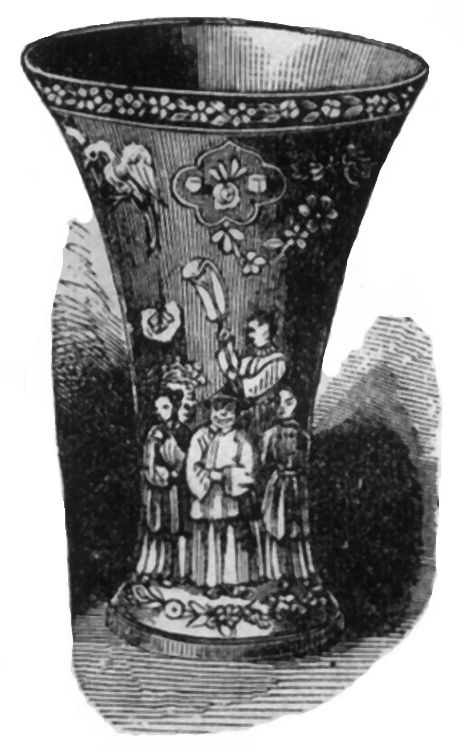
The choice of the ground is always a matter for much consideration, as on it greatly depends the truthful hue of the china. A peculiar blue and green are frequently seen in Oriental china; black and a soft salmon are common for the grounds of Etruscan subjects; the Bleu de Sèvres is too well known to need comment. We saw a vase that pleased us greatly, with a running floral design in grey, edged with gold, on a soft pink ground. It was most chaste and beautiful.
Nothing but attention to these directions is required to enable any one to work in Potichomanie; and from the admirable effect produced, and the facility afforded to those to whom handsome vases and other similar decorations have been impossible, we confidently predict that this work will have as great success with the English ladies as with their continental sisters. But care and cleanliness are indispensable to success; and loose hanging sleeves or dresses being spoiled by a spot of gum or paint are far from desirable.
The price of materials varies, according to the elaborateness of the subjects, the gilding, &c., of the paper, and also the size of the vases. Unless these latter are very large, one sheet of paper will give more subjects than will be required for a pair, The entire materials may be had from 10s. to 15s., according to the size of the vases.
WARTS. Mr. Lawrence, surgeon of St. Bartholomew’s, says, the easiest way to get rid of warts is to pare off the thickened skin which covers the prominent wart, cut it off by successive layers; shave it till you come to the surface of the skin, and till you draw blood in two or three places. When you have thus denuded the surface of the skin, rub the part thoroughly over with lunar caustic, and one effective operation of this kind will generally destroy the wart; if not, cut off the black spot which has been occasioned by the caustic, and apply it again; or you may apply acetic acid, and thus you will get rid of it. Eisenberg says, in his “Advice on the Hand,” that the hydrochlorate of lime is the most certain means of destroying warts; the process, however, is very slow, and demands perseverance; for if discontinued before the proper time, no advantage is gained. The following is a simple cure:—On breaking the stalk of the crow-foot plant in two, a drop of milky juice will be observed to hang on the upper part of the stem; if this be allowed to drop on a wart, so that it be well saturated with the juice, in about three or four dressings the wart will die, and may be taken off with the fingers. They may be removed by the above means from the teats of cows, where they are sometimes very troublesome, and prevent them standing quiet to be milked.
AUSCULTATION. The art of distinguishing, by the sense of hearing, whether the lungs or heart are acting in a healthy manner, the instrument used for this purpose is called a stethoscope.
INK (SYMPATHETIC). Dissolve a small quantity of starch in a saucer with soft water, and use the liquid like common ink; when dry, no trace of the writing will appear upon the paper, and the letters can be developed only by a weak solution of iodine in alcohol, when they will appear of a deep purple colour, which will not be effaced until after long exposure to the atmosphere. So permanent are the traces left by the starch, that they cannot (when dry) be effaced by india-rubber.
RAILWAY SIGNALS. Description of Signals. There are three principal signals in use; which are shewn differently by day and night.—“Danger” to Stop, “Caution” to Go Slowly, “All Right,” to Go On.
Fixed signals are placed at stations, tunnels, junctions, and level crossings, and other places where caution is required, &c., and are shown as follows:—
Fixed Day Signals. Danger, to Stop, is shewn by turning the cross-bar of the mast signal full upon the line, so that it can be well seen from an approaching train, thus—
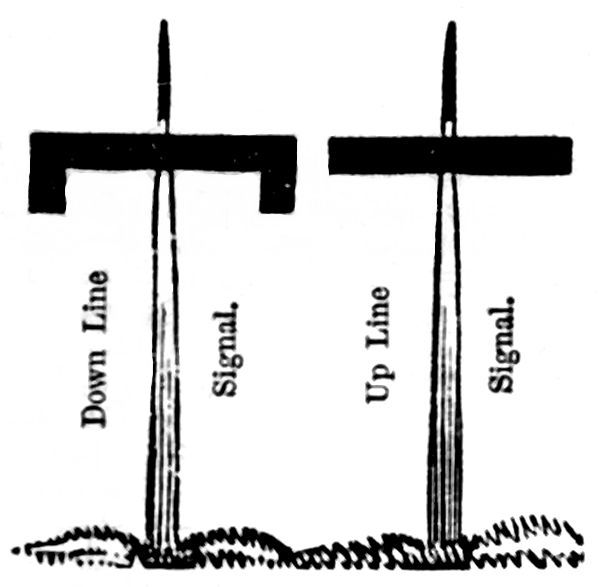
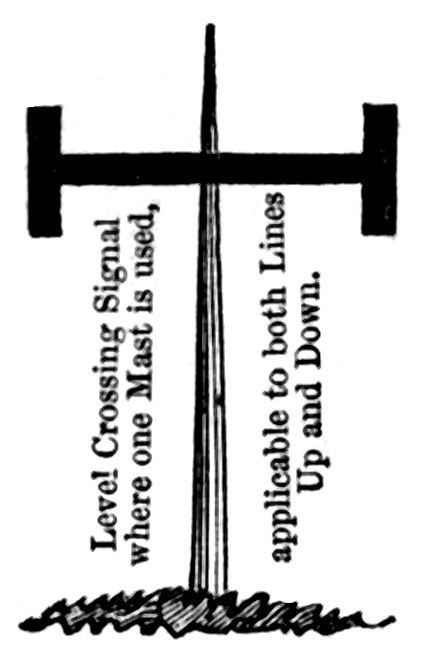
And by a red board pointing to the rails, thus—
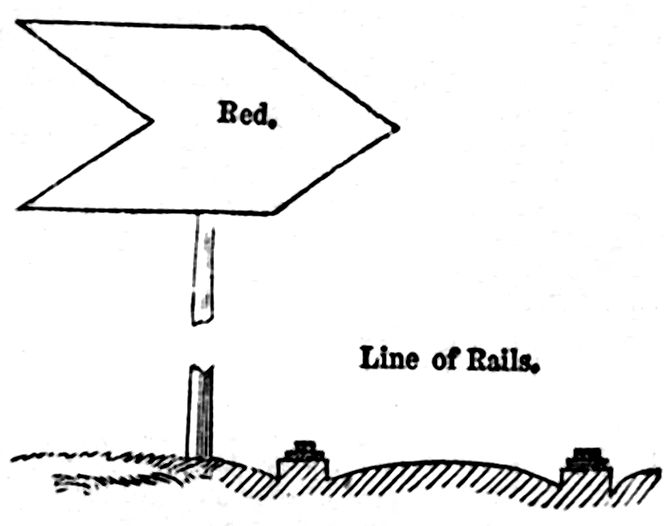
Caution, to Go Slowly, is shewn by a green board pointing from the rails, thus—
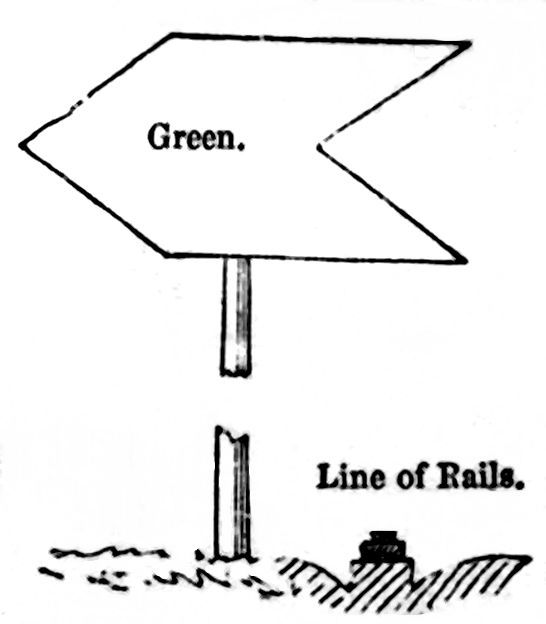
All Right, to Go On, is shewn by turning the disc of the mast signal full upon the line, so that it can be well seen from an approaching train, thus—
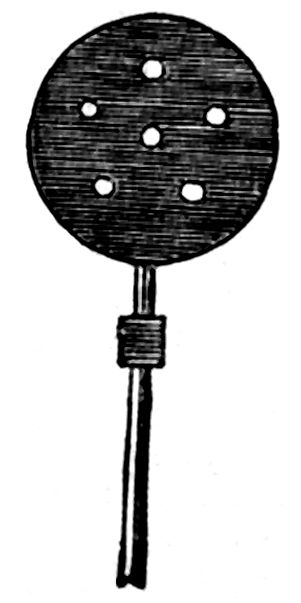
Fixed Night Signals. Danger, to Stop, is shewn by a red light fixed upon a pole, being turned full upon the line, so that it can be seen from an approaching train.
Caution, to Go Slowly, is shewn in the same way, by a green light.
All Right, to Go On, is shewn in the same way, by a white light.
Hand Signals by Day. Danger, to Stop, is shewn by holding both arms above the head, as below—or by a red flag.
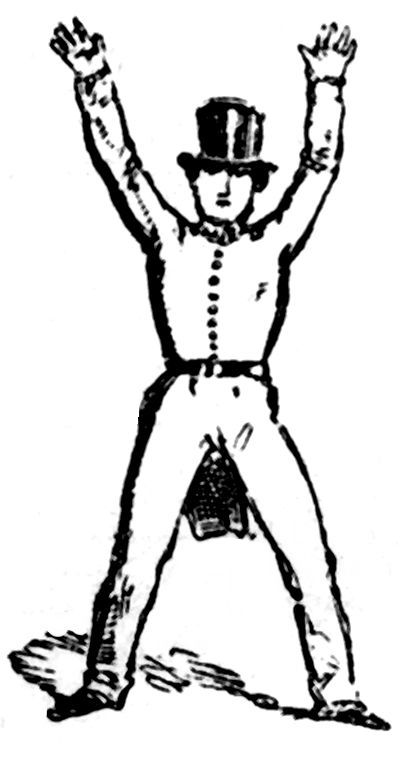
Caution, to Go Slowly, is shewn by holding the right arm above the head, as below—or by a green flag.
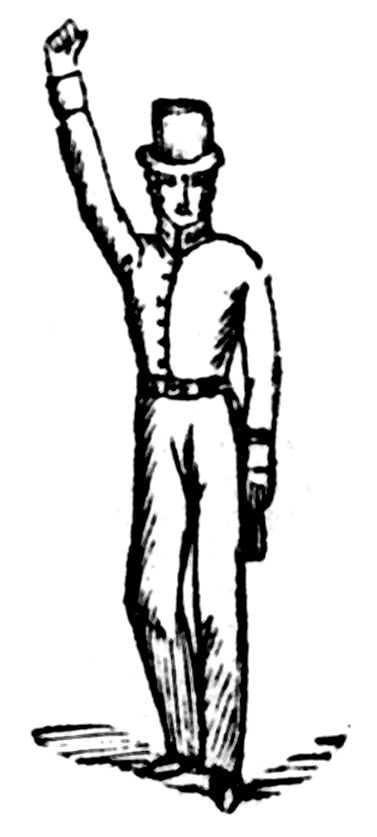
All Right, to Go On, is shewn by holding the right arm straight out, and pointing across the rails, thus—
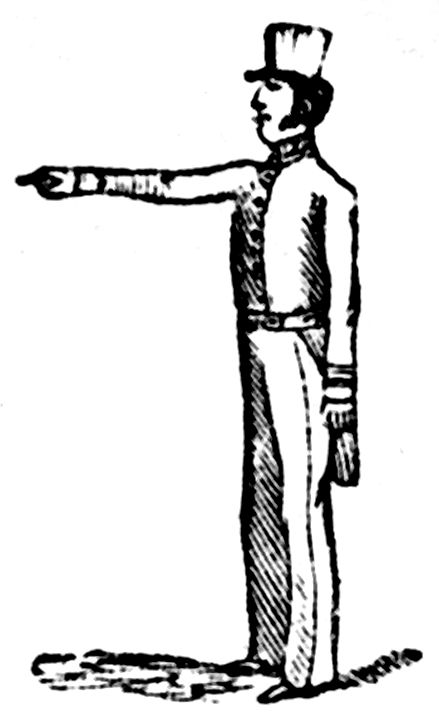
Hand Signals by Night are made by hand lamps with different coloured lights, thus—
1. Danger, to Stop, by a red light shewn steadily towards the approaching train.
2. Caution, to Go Slowly, by a green light, held towards the train.
3. All Right, to Go On, by a white light held towards the train.
Junction Signals. At the junctions of a branch with the main lines, in addition to the ordinary signals, double discs, and cross-bars by day, and double lamps by night, are fixed for signalling the branch trains, thus—
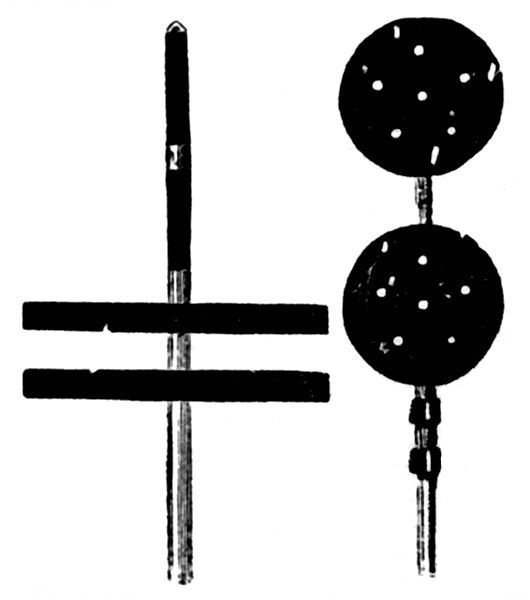
In giving the above signals, the police face the approaching train, standing on the outer side of the opposite line of rails, and well clear of it.
The violent waving of any object by day, or of any light by night, denotes danger.
When the Day or Night Signals are to be used. The danger signal must be shewn whenever it may be necessary to stop an approaching train; and for five minutes after the passing of a passenger train; and eight minutes after the passing of a goods, mineral, cattle, or any other train.
The caution signal must be shewn whenever it may be necessary, from any cause, to reduce the ordinary speed of an approaching train; and after the turning off of the danger signal, for a further period of five minutes after a passenger train, and for seven minutes after a goods, mineral, cattle, or any other train shall have passed.
The all right must only be shewn, when the line is perfectly clear of obstructions—and when no passenger train has passed within ten minutes, and no goods, mineral, cattle, or any other train within fifteen minutes.
N.B. After dark, or in foggy weather, no passenger train may follow a goods, cattle, or mineral train from a station until fifteen minutes have elapsed: the danger signal must therefore be kept shewn for this period, and after it has been turned off the caution signal must be shewn for a further space of five minutes.
Special Instructions for Signals.—As a general rule, all fixed signals must, when the line is perfectly clear, be kept shewing “all right.”
Signal lamps must be lighted as soon as it commences to be dusk; and during the interval between light and dark both day and night signals are to be used. The lamps must not be put out until broad daylight.
All fixed signals within sight of each other, and auxiliary signals, must be made to repeat the same signal. In case of danger being shewn by any auxiliary signal, the engineman must pull up so as to stop at such signal, but if he then sees the line clear ahead, he must take his train slowly on towards the station, and must in all cases be admitted within any fixed signals if possible.
No signal may be altered, without the sanction of the person in charge of it, except in cases of great emergency.
In the event of any fixed signal being damaged or destroyed, or in the event of its being from any cause rendered incapable of exhibiting the proper signal, it will be the duty of the person in charge of such signal to take immediate steps to have the line cleared and the signal repaired and put in proper working condition; and in the mean time the usual hand signals will be used for signalling the trains; and, in the event of there being any obstruction on the line, the signalman must adopt every precaution by detonators, &c., to stop a coming train.
The most implicit obedience is to be given to all signals, and any neglect of them must be immediately reported to the resident superintendent.
At every terminal station, or at a junction with a branch line, the danger signal is always to be kept shewn until an engine or train comes distinctly within sight: and no engine or train may be admitted into the station until the signalman has satisfied himself that the line is clear.
Detonating Signals. The detonator is a signal of danger, and must be used in addition to the ordinary day and night signals, in foggy weather, and when unforeseen obstructions have occurred which render it necessary to stop approaching trains.
It is fixed upon the rail (label upwards), by bending down the leaden clips attached to it for that purpose, and upon being run over by an engine or train, it explodes with a loud report, upon hearing which the engineman and guards must use every exertion to stop the train. One signifies caution; two, danger—stop.
After the removal of the obstruction which was the cause of its being placed there, every detonator should be taken off the rails.
A stock of detonators are placed in possession of assistant-engineers and station clerks; and they are kept under lock and key.
Guards, enginemen, police, and head porters, are provided with a supply in a tin case, which they carry with them when on duty, so that they may be in readiness in case of emergency. All these persons are held responsible for having at least six in their possession; and it is their duty when any have been used to make immediate application to the proper officers for a renewal of their stock.
Detonators must be carefully handled, as they are liable to explode if roughly treated. It is necessary to keep them well protected from damp. At intervals of three months, one from each person’s stock, is tested, to ensure that they are in good condition.
Fusee Signals are to be used in conjunction with detonators.
They are fixed in the ballast between the rails, and upon being smartly struck, ignite and burn fifteen minutes, and can be seen at a considerable distance from an approaching train.
They are signals of caution, and indicate that a train has moved on from the spot where they are burning within fifteen minutes.
Train Signals. After sun-set and until full daylight, every passenger train should carry upon the first and last carriages two side lamps, showing white lights to the front, and red lights to the rear of the train; and behind the last vehicle in the train one tail lamp shewing a red light; and every goods train, behind the last vehicle in the train, two tail lamps (one on either side).
Special Train Signals. Whenever it is possible to do so, due written notice of special trains is given to all stations and to the engineering department, and special trains of which such notice has been given, carry the usual train signals.
But when a special train is started of which no previous notice has been given, it carries by day the red and green disc, and by night the red and green lamp provided for that purpose; and where it is possible, the train immediately preceding such special train must be provided with the double red disc by day and the double red lamps by night to indicate to all persons on the line and at the station that a special train is about to follow. The first portion of a divided train will be considered as a special train, of which no notice has been given, and will therefore carry the red and green signals.
Special Instructions for Junctions. All junctions where trains pass direct from one line to another must be passed at a speed not exceeding eight miles per hour.
Note.—Whereas the figure signals in the preceding are common to all the lines, the semaphore signals are only used on the Broad Gauge Lines, namely—the Great Western, South Wales, South Devon, Vale of Neath, Hereford, Ross and Gloucester; Wilts, Somerset, and Weymouth; Birmingham and Oxford, and their numerous feeders and branches. The semaphore signals on the Narrow Gauge lines are simply an upright post, with a moveable arm painted red; thus:—
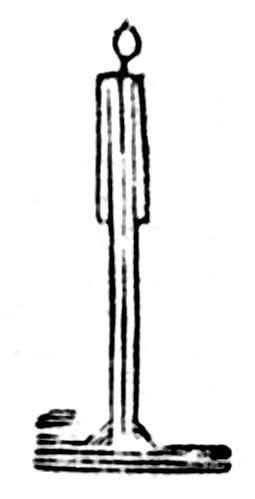
The Caution signal, to Slacken Speed, is shown by the arm on the left hand side being raised halfway to the horizontal position; thus:—
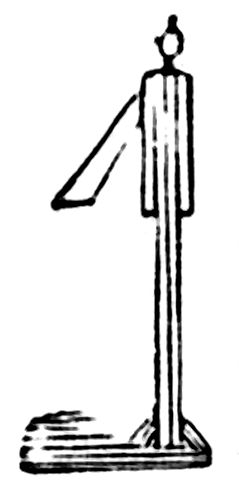
The Danger signal, Always to Stop, is shown by the arm on the left hand side being raised to the horizontal position; thus:—
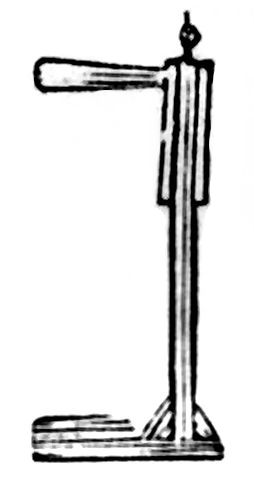
Night Signals are represented by lights, as follows:—All right, by an ordinary white light; Caution, by a green light; and Danger, by a red light. The light in front of a train is white; and at the rear, red. Flags are also used as day signals, particularly where there are no fixed signals—such as level crossings, &c. A white flag signifies all right; green, Caution; and red, Danger, Stop!
CANDLES (ECONOMY IN). If you are without a rushlight, and would burn a candle all night, unless you use the following precaution it is ten to one an ordinary candle will gutter away in an hour or two, sometimes to the endangering the safety of a house. This may be avoided by placing as much common salt, finely powdered, as will reach from the tallow to the bottom of the black part of the wick of a partly-burnt candle, when, if the same be lit, it will burn very slowly, yielding sufficient light for a bed-chamber; the salt will gradually sink as the tallow is consumed, the melted tallow being drawn through the salt, and consumed in the wick.
NUTMEG. The kernel of a fruit like the peach, which flourishes in the Moluccas, invested with a rind or coat, which is mace. In four years, from 1814 to 1817, 1,800,000 lbs. of nutmegs were imported into Great Britain, and also during the same years, 480,000 lbs. of mace, the principal portion of which were re-exported.
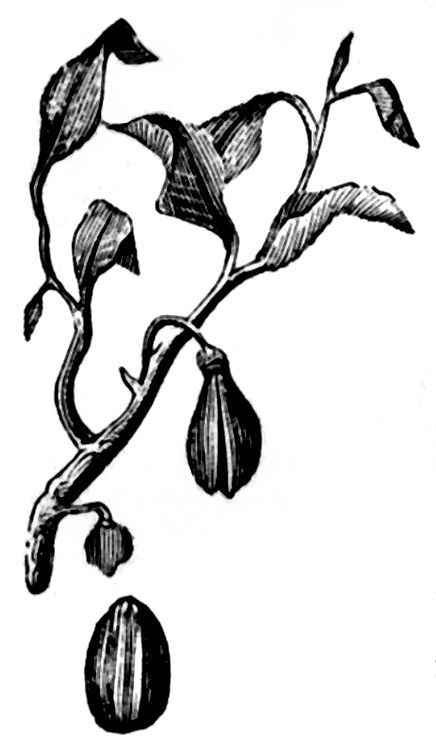
The annual sale or consumption of each in the United Kingdom, on an average of the 27 years 1797 to 1823, was of mace only 10,500 lbs., and of nutmegs but 25,000 lbs.; the annual average importation for and during the same period of time having been 35,390 lbs. of mace, and 128,500 lbs. of nutmegs. In 1806, mace sold for three guineas per lb., and nutmegs at 30s. per lb., and in 1826, for only 4s. and 2s. 3d. per lb. respectively, exclusive of duty, which, prior to 1821, was 9s. 2d. per lb. on mace, and 5s. 5d. on nutmegs. In the year 1851, 358,000 lbs. of nutmegs were imported, yielding a revenue of £21,000.
CONE. A solid, whose base is a circle, the sides approaching and terminating in a point, by cutting which, in different directions, the ellipsis, parabola, and hyperbola, are produced.
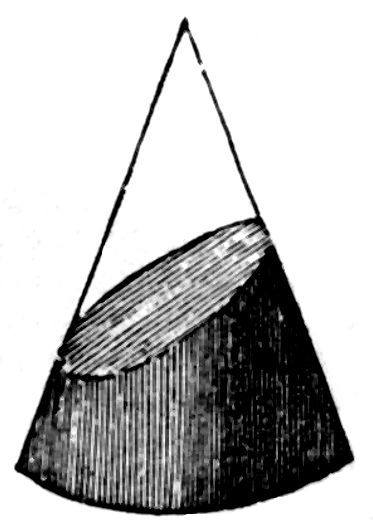
MICROSCOPE. An arrangement of lenses which enables the observer to see an object, or its true image, nearer than with the naked eye, and magnified accordingly. The simplest microscope is a small hole made with a needle in a sheet of paper. The microscope is the most instructive of all instruments, and no family or school should be without one. It displays our own merely relative size, and shows that there are as many wonders which our vision does not reach, as it does. We see by it perfect animals, in all forms and habits, hundreds of which move with freedom in a drop of water, and enjoy themselves like larger species. It displays the perfect mechanism of every part of every thing, and affords a moral lesson to pride and the arrogant assumptions of man. It proves that nature is an evolution from the smallest—the indefinitely smallest—to the great; and that to understand the great, it is necessary to understand the small which produce the great.
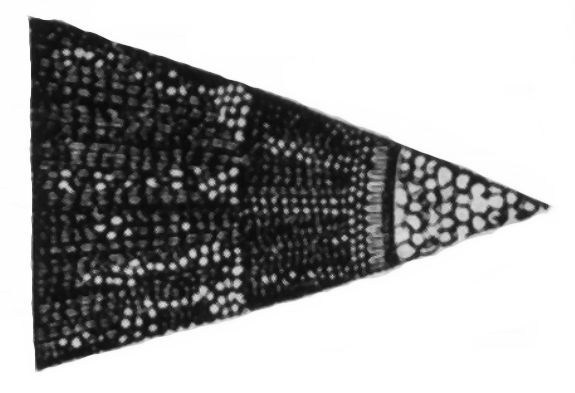
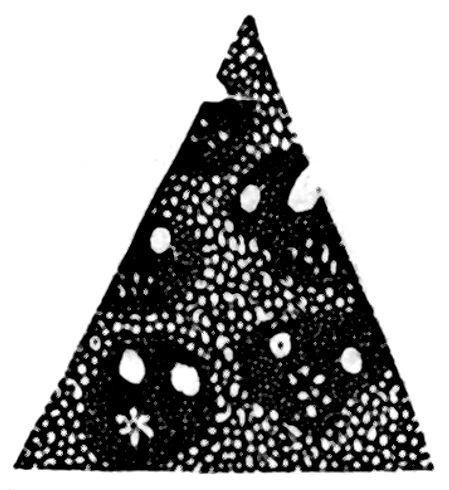
In experimenting with the microscope, cruelty to sensitive objects of curiosity should be avoided; for if your own life and comfort are desirable to you, so are they to others, and compassion should not be limited by the fears of the law. The engravings represent a section of a tree as viewed through a microscope.
STEEL (TO PRESERVE FROM RUST). The following has been found very useful:—Half an ounce of emery powder, one ounce of soft soap, mixed, and well rubbed in.
POLISHED STEEL FROM RUSTING. After cleaning, and when not in use, take a cloth with a very little sweet oil on it, and wipe the articles over so as to slightly, but evenly, oil the surface. Let steel knives, &c. be rubbed with a little unguentum, which may be procured at a chemist’s. One or two pennyworth will last a long time.
POLYPE. A species of zoophytes, whose chief animal property consists of having a stomach which is so constituted that it acts equally well if the animal is turned inside out. They propagate by stems or buds, and, when cut into parts, each part becomes a perfect animal, living in water, fixed at one end; but myriads of them reside in small cells of corals, madrepores, &c. in forms like plants, and their multiplication and industry create rocks and whole islands in many seas.
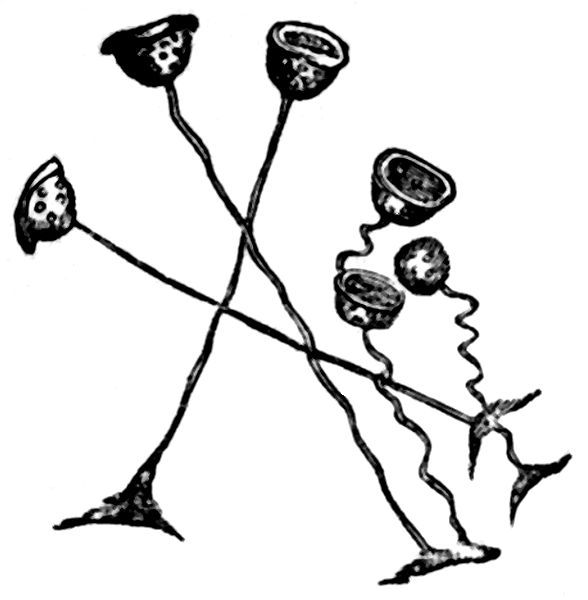
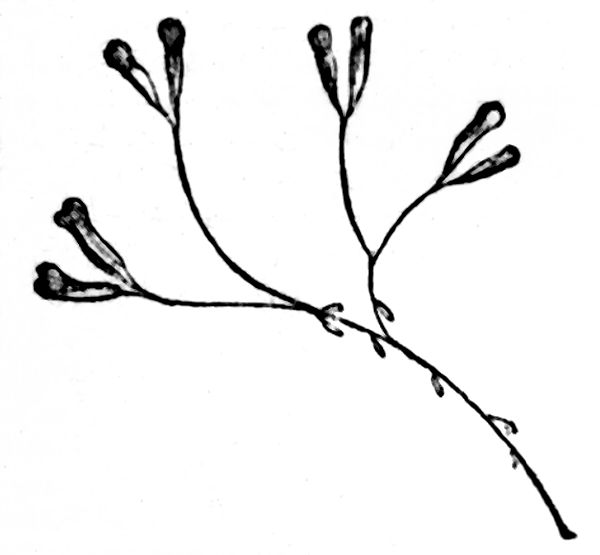
SOUND. An affection of the medium in which we live, by vibrations like those which are produced in water, when a stone is thrown into it. It travels at the rate of 1,142 feet in a second, and different vibrations affect the different gases which constitute the atmosphere, and hence their various simultaneous tones. But the same gas may be variously affected, and, hence, different pitches of tone, or octaves. If a string perform 100 vibrations in a second, the ear receives 100 strokes, which we call sound; and, if another makes 200 vibrations, the first is lower or flatter, and the latter higher and sharper, but according every other time, so that in flat sounds there are fewer vibrations than in sharp sounds. Every key of the pianoforte contains a determinate number of vibrations, which accord at regular intervals, and are completed in a second. The note marked C makes 100 vibrations in a second; but the note C, three octaves higher, makes 1,600 vibrations in the same time. It appears, by experiment, that we cannot determine the sound of a string which makes less than 30 vibrations in a second, because it is too low, nor of one which makes more than 7,552 vibrations in a second, because too high. These limits determine the power of the human ear. The eight notes of an octave are in length as follow;—128-144-160-180-192-216-240-256—and these are the proportions of strings which sound the diatonic scale, in which, at certain intervals of 2, 3, and 5, the vibrations correspond.
CONVEX LENS, by means of which, light proceeding from its focus is reconverged on the other side, and there makes a picture of the object on the other side.
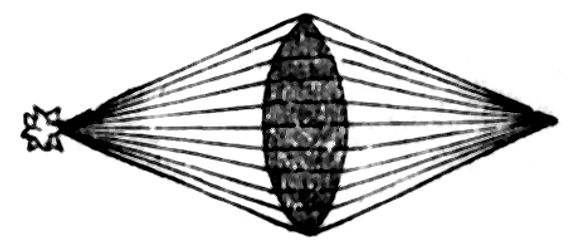
ORANGE-TREE. A native of the tropics, where it produces fruit throughout the year, the average annual crop of each tree being from 6,000 to 8,000. The orange-tree was transplanted from China (hence the term of China orange) into Europe by the Portuguese, about 1650, and now flourishes in Portugal and Spain, as well as the south of France, and on the shores and islands of the Mediterranean. In the year 1851, 451,000 chests or boxes of oranges and lemons were imported into Great Britain, yielding to the Customs about £81,000.
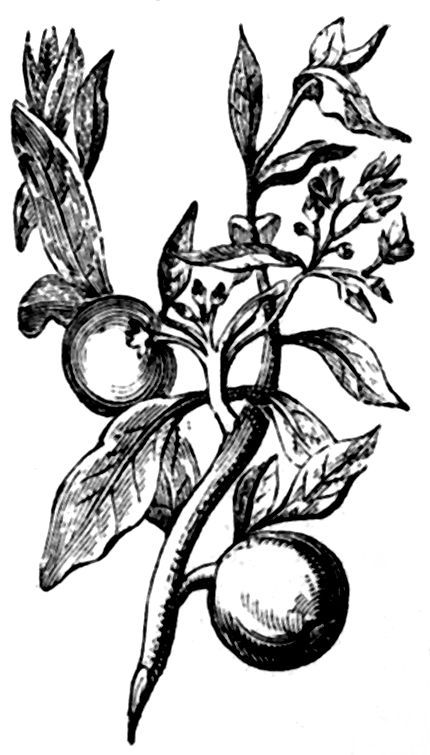
CANARIES, (THEIR HISTORY AND MANAGEMENT). This most highly and deservedly valued of all cage songsters is not a native bird; although from its long domestication and breeding amongst us we have become accustomed to consider it as such. It is said to have been brought originally from the Canary Isles; and the manner of its introduction into Europe at the commencement of the sixteenth century is thus related—A ship, bound for Leghorn, having on board a number of these beautiful finches, then first made an article of merchandise, was wrecked near the island of Elba, on which island the released birds found the climate so congenial to their nature, that they settled and bred there, and would probably have become completely naturalized, had not their beauty and powers of song attracted the attention of bird-catchers, who hunted them so assiduously, that after a while, not a single specimen was left on the island. It was natural that the birds thus caught should be sent first into Italy; and from that country, accordingly, we have the earliest accounts of tame canaries. There, and in Germany, they are still bred in greater numbers than in any other part of the European continent. It is from the Rhineland, and about Thuringia especially, that we now derive our principal supply of imported birds; but some of the choicest canaries are those bred in this country, chiefly by small tradesmen and mechanics.
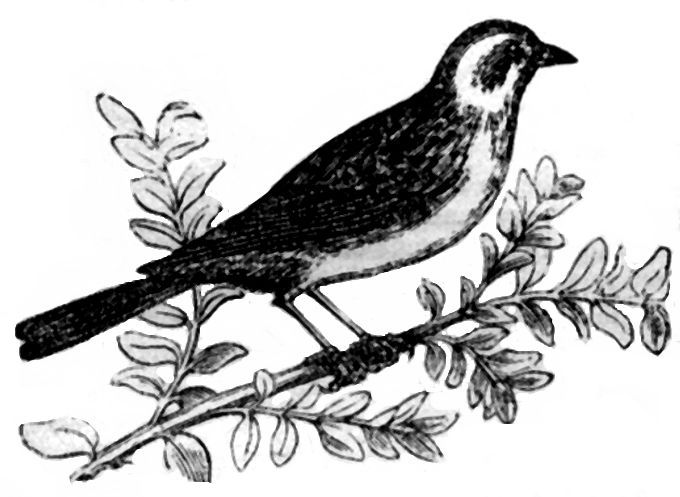
In its wild or native state, the canary is a little greyish-brown bird, with a tinge of olive-green pervading its plumage, melting off into greenish yellow on the under parts. Some of the domesticated varieties do not depart much from this original type, and such are generally considered to be the stronger and healthier birds—delicacy of tint too frequently indicates delicacy of constitution. The jonquills, or jonques—as the golden-coloured canaries are called—are indeed lovely creatures, and lovely, too, is the cheek on which the hectic of consumption plays. If you want a good, strong canary, especially if it be for breeding purposes, do not choose a pure jonque, but one in whose plumage there is a due admixture of brown or greenish gray.
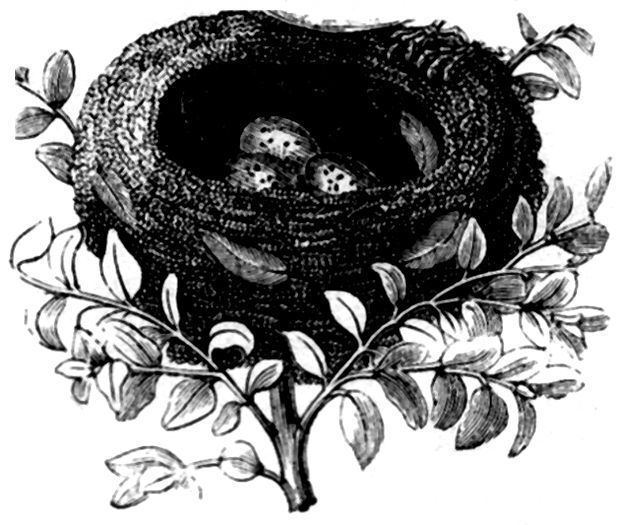
They pair in February, and have five, sometimes six, broods in a season. They frequent the gardens near to human habitations; and even their untaught melody is very delightful, having in it many notes like both the nightingale and skylark, from neither of which birds could they have acquired them, from their not being natives of the island. They moult in August and September.
Varieties of Colour, etc. The size of the canary is about the same as that of the linnet, being in length five inches, including the tail, which is two inches and a quarter long; the beak, that characteristic feature of all birds, is finch-like—that is, short, stout, and sharply-pointed; in colour, whitish; the legs are flesh-coloured, rather long and slender. The whole shape of the bird is extremely elegant, and its motions, when in health, full of vivacity. There is not much in the female to distinguish her from the male; her body is generally somewhat more slender, although she has a longer and thicker head; the colours of her plumage, too, are generally brighter; and the yellow around the eyes and upon the temples is always so, in comparison with the rest of her own plumage.
Perhaps the most esteemed of all the varieties, as far as colour is concerned, are those birds in which the body is a clear yellow, or white, and the wings, tail, and head, which should be crested, a rich, golden, dun colour; the pinion and tail feathers, and also those of the back, may be marked with black, but these markings must be regular, and flow into each other like the ripple of waves, or connoisseurs will not look at the bird. A golden variety, with a dark gray head, wings and tail, is also much admired, as is one which has a gray or yellow head or collar, and the rest of the plumage nearly black; or that has a yellow breast, a white head and tail, and a gray or blackish head, wings, and body.
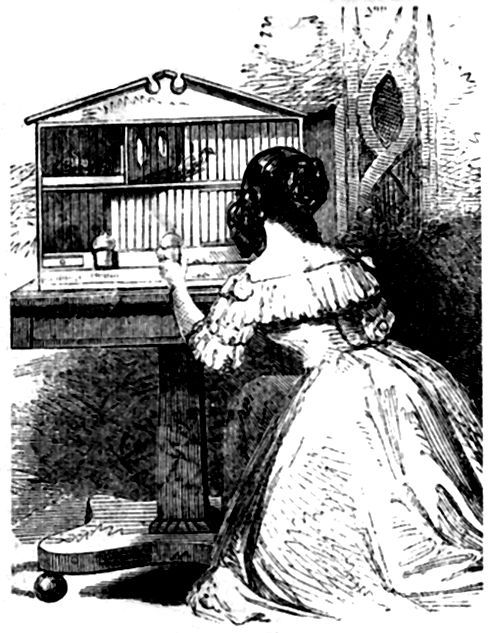
Breeding. Canaries should not be allowed to pair before the beginning of April, as the cold weather of a backward spring frequently kills the young birds. If they are loose in a room together, or in a cage where the cocks and hens can have access to each other, they will be most likely to obey the call of St. Valentine, and make up their matches very early; it is therefore best, as soon as you see an inclination to pair, to shut up in separate cages such males and females as you intend to breed from; these, however, should have passed the winter in each other’s society; or, when the happy time does come, it is quite likely that they will refuse all intercourse. Male birds for pairing should be at least two years old, and if these are put with hens older than themselves, the majority of the progeny will be males. It requires some judgment to choose good breeding birds. Particular attention should be paid to temper and temperament. Some cocks are melancholy and phlegmatic; some fiery and passionate, so much so as to fight with the hen bird, and kill their offspring; others, again, are so ardent in their love-making as to teaze and annoy the female while she is sitting, to tear the nest and break the eggs. The hens, too, have their faults; some are impatient, and will not wait long for results of their labours, forsaking their eggs almost as soon as laid, and beginning to build and pair again; some break their eggs or destroy their young through awkwardness; some are careless, and let them die for want of attention; others are spiteful, and bite their young and pull out their feathers, so that they die miserably; and it sometimes happens that the hens are too weak to bear the exhausting pains and cares of maternity; they lay their eggs with difficulty and at long intervals, and are unable to bestow the requisite attention on family matters, so that everything goes wrong, as our fair readers know it must do when the presiding genius of the house is sick or indolent.
In selecting your birds for pairing, take it as an invariable rule that the cock and hen must not both be crested; if they are, you will most likely have the progeny bald, or with some disfigurement about the head. With regard to the matching of colours, let it be observed that the union of opposites produces the most beautiful and harmonious results. All late experience goes to prove this; although some of the older authorities say, put together birds of the same colour; but if you do this, you will have, not increase of beauty, but deterioration. The great secret of fancy breeding seems to consist in this—not apposition, but opposition of colours; thus, for instance, a fine, full, richly-tinted jonque cock, should be matched with a good mealy or variegated hen, and vice versa. A spangle-marked cock with a mealy hen will produce a more full-toned and regularly spangled back than if both parents had been like the father. Innumerable instances might be cited to show how this principle operates; but enough has been said, we trust, for the guidance of the breeders, whose stock, at first, should consist of about three cocks, carefully selected, and half a dozen hens; these, deducting largely for casualties, will produce twenty or thirty young birds in a season, quite as many as can well be managed without extraordinary facilities.
The following directions will be of service to those who breed canaries in cages:—When the proper time arrives, place your birds, a cock and one or two hens, together in a breeding-cage, so constructed that you can, if necessary, separate the birds. At one end, near the top, should be hung two nest-bags, or boxes, as far apart as the width of the cage will allow, and behind each of these let there be a square door opening outwards, by which you can at any time watch the progress of affairs without disturbing the sitters.
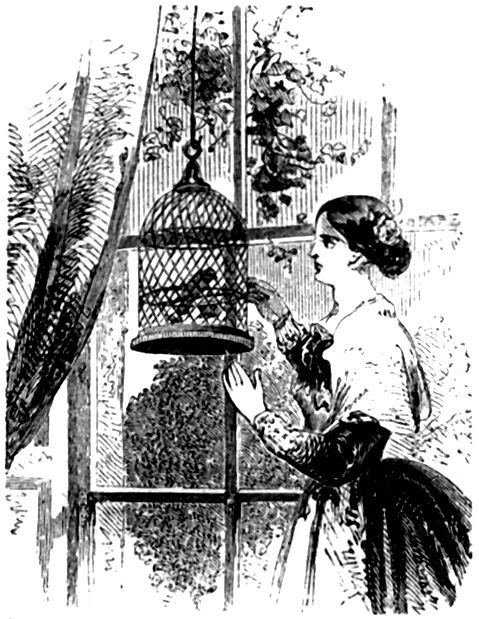
If you find a coldness and disinclination to pair in the birds, place the hen or hens in one division of the cage and the cock in the other, and let them remain so that they can see each other without being able to come together; or else put the cock in a smaller cage, and hang it up near to, without touching, that in which the hens are. In a few days, probably, the male bird will begin to sing with extraordinary loudness and energy, and peck at the bars which confine him; he may then be placed again with the hens, and the desired results will no doubt follow. You will soon see one of the hens, whichever happens to be the favourite, busy in the construction of her nest, and in about a week the first egg will be laid, and each day it will be followed by another, until there are five or six. It sometimes happens that the attentions of the male are bestowed wholly upon one hen; if this is the case, as soon as the favourite begins to lay, shut up the cock with the other hen in the separate division of the cage, and do not open the door until you see symptoms of an amicable understanding between the prisoners, or at all events, until a reasonable time has elapsed. Sometimes this second pairing does not take place, and the neglected hen has to be sent about her business. It is customary with some breeders to remove the eggs as they are laid, and replace them with ivory imitations, putting the whole back together when the number is completed; but we do not think this is a good plan; and the end in view, that of having the young birds all hatched together, is of questionable advantage. In these simple operations of nature the birds should be left to themselves as much as possible. Watch them without appearing to do so; and if all is going on right, by no means interfere with them. If on the thirteenth day of sitting the young birds do not begin to make their appearance, you had better take the eggs very carefully, one at a time, and hold them for a minute or so in lukewarm water, replacing them under the hen directly they come out of the bath. The same operation may be performed on young birds, when, as is sometimes the case in cold seasons, the feathers are not developed so quickly as they should be. Great care, however, should be taken that they do not get a chill. To obviate the danger of this, it has been recommended to syringe the young birds in the nest with warm water, discharged from such a distance that it falls in a gentle spray. When the fledgelings are from twelve to fourteen days old they begin to feed themselves, and the hen commences her preparations for another brood; somewhat recruited in strength by the rest she has enjoyed; for on the cock has devolved the principle charge of attending to the young family, which by this time are scarcely fully fledged. A strong hen canary, paired with a chosen cock, will produce four broods in the season—that is, from April to September—sometimes five; but this is too exhausting, and should not be allowed.
Food. Canaries, like all other finches, are seed-eating birds. Rape and canary seed are the best kinds to give them as a general diet; the summer rape is to be preferred, not being so hot and oily as that sown in the autumn, which is larger and blacker than the other. When they require rich stimulating food, as during the moulting and breeding seasons, a small proportion of hemp seed should be mixed with the others, and also a little hard-boiled yolk of egg chopped small; at such times, too, a little raw lean meat, scraped fine, may be given occasionally. And in some measure to neutralize the heating effects of this rich diet, let them have some green food, such as salad, water-cresses, groundsel, &c.; something of this kind is good for them all through the hottest part of the year; and while it can be had, the cage or aviary: should never be without groundsel, of which they are very fond, both green or in the ripe state. A special treat now and then, as you would give a plumcake to your children, is to mix up some millet, summer cabbage, and canary seed, with bruised oats or oatmeal, and place it in their feeding vessels; they will enjoy it greatly, as they will a little stale bun or sponge-cake, with a small proportion of seed of one or more of the above kinds. As a general rule, however, it is best to keep to plain diet. It is mistaken kindness to over-feed with delicacies a feathered pet. Many are killed by such treatment. The practice of keeping a piece of sugar constantly between the wires is a bad one; for although some birds will only peck it occasionally, others are immoderately fond of sweets, and will take so much as to cloy the stomach, and indispose them for food of a more healthful kind. It is bad for canaries as for children to have too many sweets; they are sure to end in sours. Various recipes for canary paste have been given, but we can scarcely recommend any of them. Pastes and powders are apt to turn sour, or become musty, in which state they act like poison on the birds. Moist food should never be kept more than twenty-four hours; in hot weather give it fresh twice a-day, and wash out the vessels carefully each time. If you put into the seed vessels more than sufficient for twenty-four hours’ consumption, the birds will be likely to take on the first day more than is good for them, and afterwards feed on the husks, and thus injure and weaken their digestive organs. To young birds, if you have to feed them by hand, give wheaten bread crumbled, or biscuit grated fine, and mixed with bruised rape seed and yolk of hard-boiled egg; this should be moistened with a little water, so as to make it into a stiff paste, and about four quillfuls given to each bird ten or twelve times a-day. If fed by the parents, the same preparation may be used, only put the seed, previously boiled to take away its pungency, in a separate vessel. As the young birds grow up and become able to feed themselves, gradually decrease the quantity of the paste, and increase that of the seed, mixing with it canary and a little linseed occasionally; the latter is good for the voice.
Diseases. The diseases to which the canary is especially liable are not numerous; it is by no means so delicate a bird as is generally considered; and, if properly fed and cared for, will live many years in confinement without falling ill, or manifesting any decline of strength and vigour.
Surfeit or Rupture. This disease most commonly attacks young birds; it is an inflammatory state of the bowels, caused generally either by an excess of highly nutritious food which cannot be digested, or by food in a stale or otherwise improper condition. Its most marked symptom is a great distention of the skin of the body, which appears full of small red veins; through this the intestines may be seen, more particularly at the lower part, in knotty lumps, looking black and turgid. The mode of treatment will depend greatly upon whether the motions of the bird are frequent and watery, or unfrequent and hard. In the former case it should have Embden groats or oatmeal, mixed with a little bruised hemp seed, which indeed are of a binding nature, and a small, very small quantity, once or twice a-day, of stale sponge-cake, soaked in white wine: a little piece of alum in the water is also good. In the latter case, give mixed with the seed a few whole groats, a blade or two of saffron in the water, in which for two or three mornings also put as much magnesia as will lie upon a sixpence; bread and milk, with a sprinkle of hemp seed, may be given once or twice a-day with advantage. In both cases the patients should be kept warm and quiet. In old birds surfeit sometimes shows itself in scabs about the head, eyes, and bill, out of which flows a humour so acrid as to destroy the surrounding feathers, and sometimes to produce total blindness. The only chance for the bird now lies in a spare, cooling diet; let it now eat rape seed with some bruised groats, and put salt in its water. When it has been well purged and got quite thin, if the malady seems somewhat subdued, you may gradually mix canary seed with the rape, and render its diet more nourishing; but this should be done very carefully. Anoint the sores and places where the feathers come off with fresh butter, or oil of sweet almonds, and bathe them with warm milk; a weak solution of salt or alum is sometimes useful to dry up the humour and cleanse the sores.
Egg Rupture. Suffering under this disease, which of course attacks female birds only, a bird is said to be egg-bound; there is some obstruction in the passage which prevents the extrusion of the ova. You will probably find your canary crouched down in a corner of the cage, or perhaps brooding over an empty nest under the impression that she has laid. Take her up very gently, and anoint the abdominal parts with warm salad oil; this will frequently afford relief in a few hours. If it does not, administer, by means of a quill passed into the gullet, a few drops of castor-oil. Should that fail the case is hopeless. A warm bath may be tried as a last resource, but most likely the patient will die.
Yellow Gall, or Scab, in the head and eyes may be cured by light cooling foods, such as lettuce and rape seed, and a little bread and milk, to nourish without heating the system.
Sweating. This is a disease to which sitting hens are liable; it is an indication of weakness, and will sometimes destroy the brood. Let the body of the patient be first washed with salt and water, and then with fresh spring water to remove the saline particles; dry her rapidly in the sun, or before a good fire; repeat this every day until she is better; give her good, nourishing food, and lighten her duties as much as possible; remove her mate if he is at all troublesome, and every cause of annoyance and anxiety. See that the breeding place be not too close and ill-ventilated, and you will no doubt effect a cure.
Sneezing is generally caused by some obstruction of the nostril, which may be removed by putting a small feather up it. This should do done very carefully, or you may injure the bird; hold it in a firm yet gentle manner, that you may not give it unnecessary alarm or pain. The same directions will apply to the cutting of
Overgrown Claws and Beak, which, on account of their bad effects upon the health and spirits of a cage bird, may well be classed among diseases. The consciousness of having these an undue length, rendering it liable to be entangled in the bars of its cage, or whatever it comes in contact with, will cause a bird to mope and refuse its food; and if not relieved from its awkward state of embarrassment, it will be very likely to pine and die. In both bill and claws, if held up to the light, you may see by the termination of the red lines how far the veins extend. Nearly up to this point; you may safely cut.
Huskiness and Loss of Voice generally proceeds from a cold; it sometimes comes on after moulting. If not speedily attended to and cured, it will most likely become chronic. Many a fine songster has been thus rendered mute and comparatively valueless. The bird suffering under this disease should be kept in a warm room, and fed upon rape and canary mixed with linseed. Ripe plantain should also be given, and every morning about a teaspoonful of boiled bread and milk, with raw seed sprinkled over it. Sponge-cake soaked in sherry wine is also good, and a little white sugar-candy or extract of liquorice dissolved in the water.
Constipation may be cured by giving the birds plenty of green food, such as lettuce, water-cress, chickweed, &c.
Epilepsy is commonly the result of fear acting upon a constitution enervated by too delicate a mode of treatment. At the slightest alarm, and often when agitated or excited in any way, the bird will drop from its perch as if dead. The quickest remedy is to plunge it in a bath of cold water, and when it begins to recover, drop a little sherry wine down its throat. The bath, if repeated every morning, will strengthen the bird, as will a few drops of spirits of nitre in its water. When in the fit, some pull a feather out of the tail of the patient, but we scarcely think this of much service.
Moulting Sickness. This is an inevitable visitation, which no amount of care and attention will prevent or delay beyond the appointed time. Every year, in or about the month of September, sometimes earlier, your bird sheds his old feathers and acquires new ones, and during the process, which lasts from three to six weeks, according to the strength of the bird, the state of the atmosphere, and other circumstances, it will be more or less indisposed. As the time for the annual change approaches, when you see your pet begin to lose his vivacity, and to drop his feathers, your first care must be to have it placed in a warm situation. Let the cage be partly muffled with baize or flannel so as to exclude all draughts, as well as disturbing sights and sounds. Give it bread and milk, a little beef, raw and lean, scraped fine, yolk of egg, and now and then a piece of sponge-cake, and some ripe chickweed. Put a rusty nail in the water, with occasionally a clove, or a few shreds of saffron, or a piece of refined liquorice. Should he moult with difficulty, let him have cake soaked in sherry wine, and blow a little of the wine over his feathers every day. This will invigorate him, and assist their development. If it be a hearty, strong bird, most likely matters will go on all right, and you will have no occasion to resort to this. With all birds, however, the moulting season is a critical time, and with weakly ones especially so. Then it is that coarse sand or gravel at the bottom of the cage is more than ever essential; and also, as there is generally a loss of appetite, such delicacies as we have described, to tempt the palate and support the strength. The first moult of young birds takes place when they are from six to twelve weeks old; they then exchange the soft down and loose feathers with which they are first covered, for the perfect adult plumage, which in the second moult undergoes considerable changes in colour.
Diseased Feet. Swollen feet and claws in a canary nearly always result from the want of opportunity to wash and bathe, or from a dirty state of the perches and bottom of its cage; consequently they convey a reproach, mute yet eloquent, on the neglect of its keeper. Let the bird have the required opportunities, and remove the exciting cause of the unsightly and disgraceful swellings, and they will soon disappear. Sometimes a little anointing with salad oil may be required to hasten the cure.
Cages. On this head we need scarcely trouble our readers with many special directions. Canary cages may be made of every conceivable variety of shape; and, provided the comforts of the little inmates are properly cared for, as highly ornamented as taste or fancy may dictate. Either mahogany, or some hard, close-grained wood, should be used in their construction—the former is best; fir should never be tolerated, nor anything of a soft and porous nature, which might afford a harbour for insects. Bell-shaped cages, chiefly of wire, have been a good deal used; they are light and pretty, and easily kept clean. Perforated zinc has lately come into use as a material for cages; some good examples of its application to this purpose were shown in the Zollverein department of the Great Exhibition. Very elegant effects might be produced with this metal in combination with glass. Of this latter material, or of porcelain, food and water vessels should always be made; and their proper place is on the outside of the cage, the interior space of which ought to be at least a foot in height, eight inches in length, and about the same in breadth—that is, for one bird. Every cage should have at least two perches, at different heights, and these should not be placed one under the other. Breeding cages we have already spoken of. [Condensed from “Bechstein’s Handbook of Cage and Chamber Birds,” published by Ward and Lock, price 2s. 6d. No bird-keeper who is anxious about the life and comfort of the little creature confided to his care should be without this cheap and valuable book.]
ADHESIVE COMPOSITION. Glue and water with a small admixture of sweet oil, make a good adhesive composition for labels. A little treacle, or sugar, mixed with gum, prevents the curling up and crispness of the latter. The postage labels are, we think, made adhesive by “dextrine.” This substance is frequently called British gum; it may be procured of chemists or oilmen.
COFFEE. An evergreen shrub, growing in Arabia, the island of Java, and the West Indies. It seldom rises more than 16 or 18 feet high; the flowers are of a pure white, and the berries grow in clusters, resembling cherries.
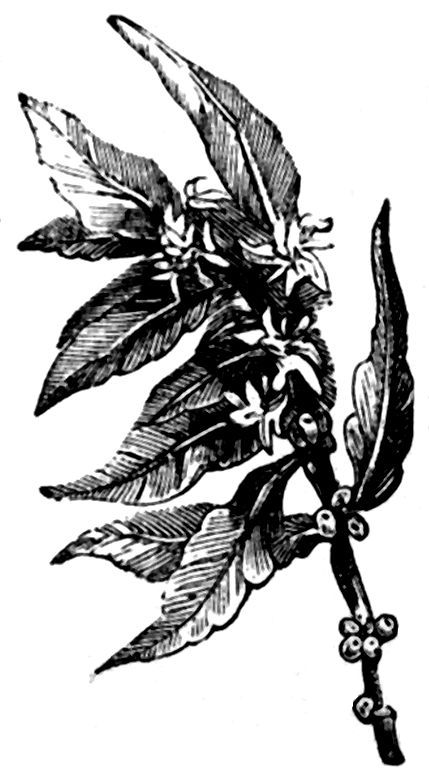
The total quantity which is annually imported into England averages about 45 millions of pounds, about two-fifths of which is the produce of Jamaica. During the year 1851, we imported from our colonial possessions and foreign countries 54,000,000 lbs. of coffee. Out of this we exported 22,000,000, while 32,000,000 were retained for home consumption. The Revenue netted £445,000 from this importation.
CORAL. A genus of zoophytæ found in the sea, attached to stones, bones, shells, &c. Corals were formerly believed to be vegetable substances, but are now ascertained to consist of animals. The islands in the South Seas are principally coral rocks covered with earth, which have been formed by them from the bottom of the ocean. These submarine works are still proceeding, which renders it more than probable that new islands may occasionally be produced. The branch represented in the engraving contains several cells or apertures, each of which is tenanted by insects, which were long mistaken for flowers. Broken branches of coral have been seen to attach themselves to other branches, and thus to continue to grow. The three varieties are red, white, and black.
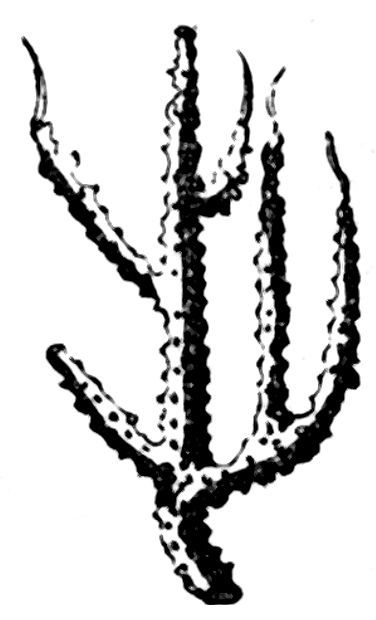
CAMELEOPARD, or GIRAFFE. A native of South Africa, usually 16 or 17 feet high, and named from its resemblance to a camel and a panther. These animals are exceedingly docile, and delicate in constitution. In 1827, the Bey of Tunis sent one each as presents to the kings of France and of England. The one in France was kept at the Jardin des Plantes at Paris, and attended with great care: the one to England was sent to Windsor, where the climate seemed unfavourable for it.
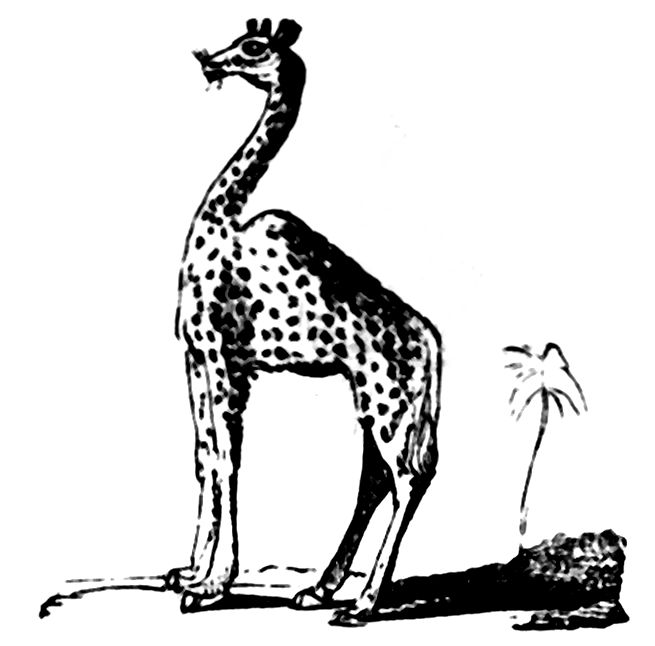
MARBLE APPEARANCE TO PLASTIC FIGURES. Dissolve an ounce of pure curd soap grated in water, and add one ounce of white wax, cut in thin slices. When the whole is incorporated it is fit for use. Having dried the figure before the fire, suspend it by a string and dip it in the mixture; when it has absorbed the varnish, dip it in a second time, and that generally suffices; cover it carefully from the dust for a week, then rub it gently with soft cotton wool, and you will have a brilliant shining gloss, exactly resembling polished marble.
DORIC. An order or architecture, in imitation of a wooden structure, resembling the trunks of trees in union.
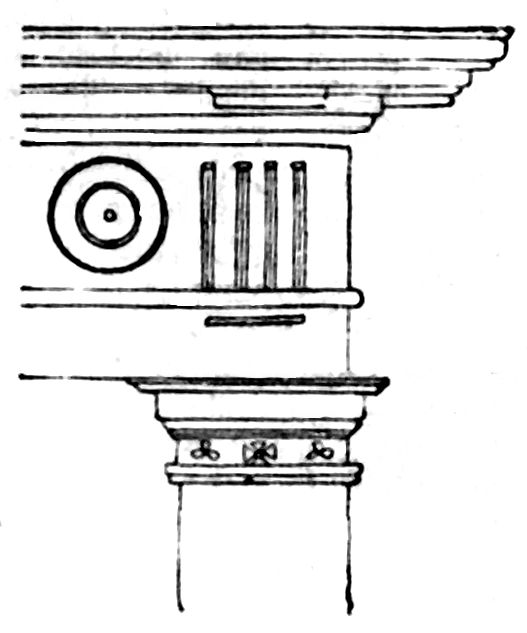
CLOVE-TREE. A native of the Moluccas. The blossoms are first white, then green, and at last red and hard, when they are cloves. When dried they turn yellow, and then dark brown. The clove is also cultivated to great extent at Cayenne, in South America, from whence more than 500,000 lbs. were imported into England, in 1815: the quantity imported from the East Indies in the five years 1823 & 1827 was 1,036,057 lbs. and in the latter year sold as low as 15d. per pound.
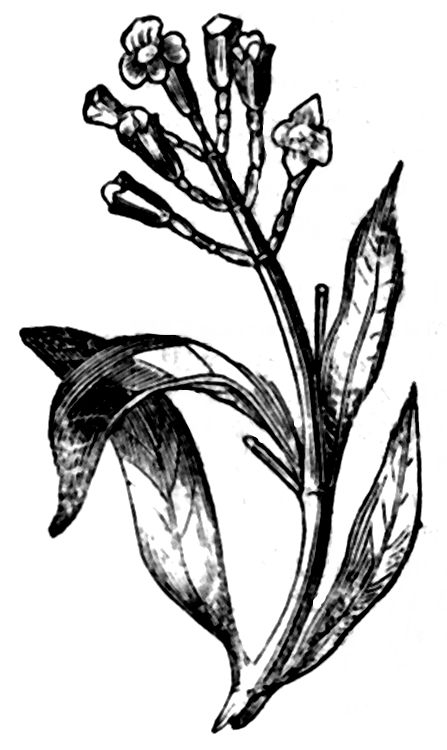
FROG. An amphibious animal, perfectly harmless, which continues growing for five years, and is very tenacious of life. Frogs are formed from tadpoles; the feet grow, and the tail is absorbed when they leave the ponds, after rain. They subsist on worms and insects; and certain parts of a green frog are eaten in France as a delicacy. Spallanzani kept some torpid in an ice-house for 3½ years, and they revived in the sun.
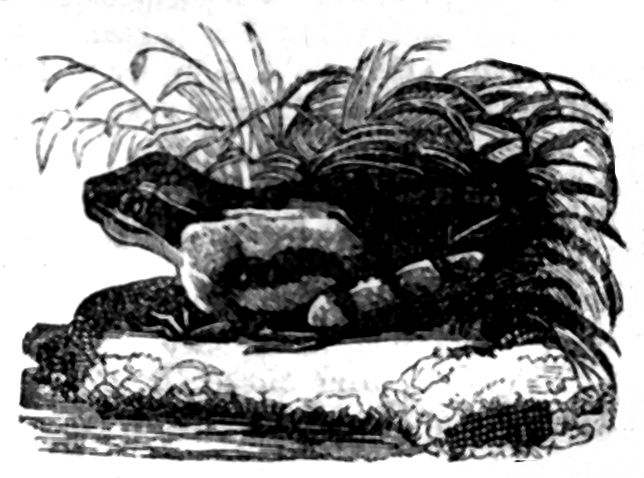
BEDS. In regard to the kind of beds most suitable for refreshing slumber, there are differences of opinion; some are advocates for soft and some for hard beds. The difference between the two is this—the weight of a body on a soft bed presses on a larger surface than on a hard bed, and consequently more comfort is enjoyed. Children should never be allowed to sleep on hard beds, and parents err who suppose that such beds contribute to health, hardening and developing the constitution of children. Eminent physicians, Dr. Darwin among the number, state that hard beds have frequently proved injurious to the shape of infants. Birds cover their offspring with the softest down or the most velvety moss. The softness of a bed is not evidence of its being unhealthy, and they have but a poor understanding of the laws of nature who think otherwise.
MERCURY. The planet nearest to the sun, in diameter 3200 miles, distance 37 millions, and period of revolution 88 days. It is seldom visible.
Mercury, in the heathen mythology, the inventor of letters, and the god of eloquence, and son of Jupiter and Maia, the daughter of Atlas. He was the messenger of Jupiter and the gods, and was furnished with a winged hat, and with wings to his feet.
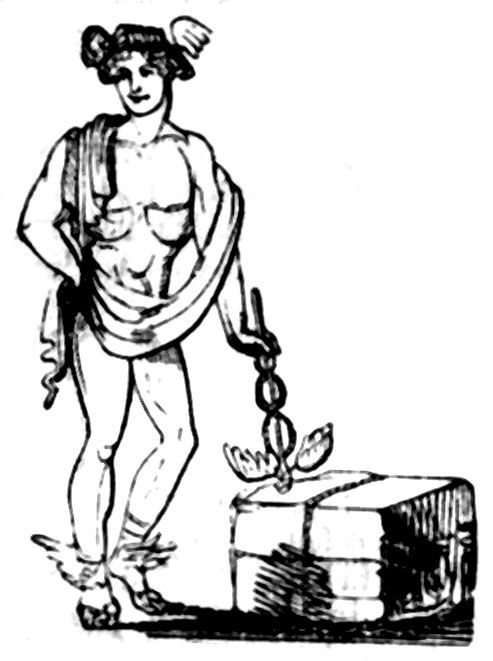
Mercury, or fluid of silver, a white fluid metal, the heaviest, except platina and gold. It freezes at 39° below the zero of Fahrenheit, when it is malleable, and boils at 660°. It readily combines with nearly all other metals, and is used in water-gilding, the manufacture of vermilion, the silvering of looking-glasses, the making of barometers and thermometers, and the preparation of several powerful medicines, some of which are deadly poisons.
TEA-PLANT. A small evergreen shrub, a native of Japan, China, and Tonquin. In seven years the shrub rises six feet, and being cut down to the stem produces fresh shoots, each of which bears as many leaves as a whole shrub. The refreshing beverage made by the infusion of the leaves was first used in England in 1660, when it was sold at 60s. per lb. till 1700; but is now so generally drank, that 25,000,000 lbs. are annually consumed in the British islands.
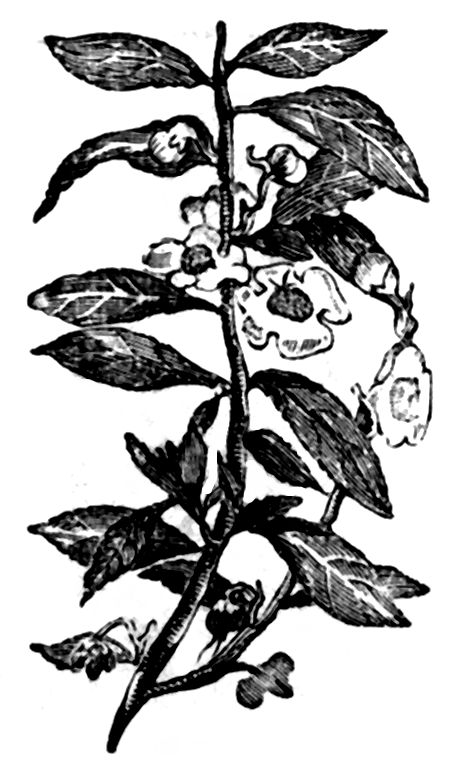
FRECKLES (TO REMOVE). Take of Venice soap an ounce, dissolve it in half an ounce of lemon-juice, to which add of oil of bitter almonds, and deliquated oil of tartar, each a quarter of an ounce. Let the mixture be placed in the sun till it acquires the consistence of ointment. When in this state add three drops of the oil of rhodium, and keep it for use. Apply it in the following manner:—Wash the face at night with elder-flower water, then anoint it with the above unction. In the morning, cleanse the skin from its oily adhesion by washing it copiously in rose-water.
EGYPTIAN ARCHITECTURE, distinguished by capitals like the engraving, and lately much introduced.
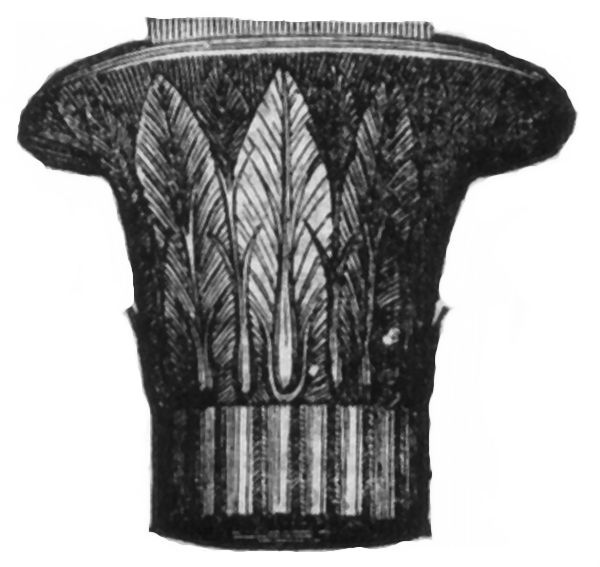
COFFEE, TEA, CHOCOLATE, AND COCOA. Coffee and tea have now become such universal beverages for the morning or after-dinner meal, that beyond a few general directions little remains for prefatory matter.
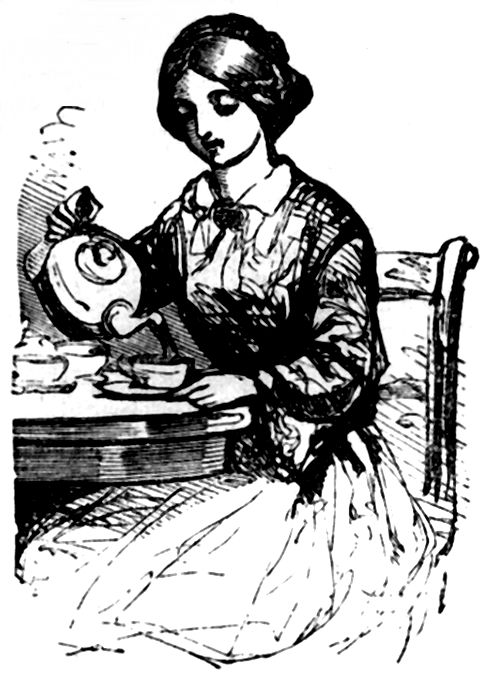
Coffee should be purchased in the berry, and fresh roasted, and it should always, when possible, be ground just previous to being made. After it is ground, it should not be exposed to the air, as the aroma speedily flies off. If more is ground than required for the meal, keep it in a closely-stopped glass bottle. Coffee, like tea, should be an infusion, not a decoction.
The best coffee is the Mocha, the next is the Java, and closely approximating is the Jamaica and Berbice.
Of Tea little need be said; almost every one knows the rules for making it. Boiling water should alone be used. Metal tea-pots in preference to earthenware. Silver is better than either. A spoonful of tea for each person. Heat the tea-pot first with some boiling water, then pour that into the tea-cups to warm them; put in your tea, and pour enough water on the tea to cover it; let it stand three or four minutes, then nearly fill the tea-pot with water; let it stand a few minutes and pour out, leaving some portion of tea in the pot when you replenish, that all the strength may not be poured away in the first cup.
Chocolate can only be obtained pure of a first-rate house; that commonly sold is most infamously adulterated; the best Spanish or Italian chocolate should be purchased; the Florence has a high reputation.
Cocoa is the foundation of chocolate; it may be pounded, and either boiled in milk, or boiling water may be poured upon it. It is very digestible, and of a fattening nature.
COFFEE (FRENCH METHOD OF PREPARING). Let your coffee be dry, not in the least mouldy or damaged; divide the quantity that is to be roasted into two parts; roast the first part in a coffee-roaster: the handle must be constantly turning until the coffee becomes of a dry almond colour or bread raspings, and has lost one-eighth of its weight; roast the second part until it becomes the fine brown colour of chesnuts, and has lost one-fifth of its weight; mix the two parts together, and grind them in a coffee mill; do not roast or make your coffee until the day it is wanted. To two ounces of ground coffee put four cups of cold water, then drain off this infusion and put it aside; put to the coffee which remains in the biggin three cups of boiling water, then drain it off and add it to that which has been put on one side; by this method you obtain three cups more; when your coffee is wanted, heat it quickly in a silver coffeepot, taking care not to let it boil, that the perfume may not be lost by undergoing any evaporation.
COFFEE (TO MAKE WITH HOT WATER). Instead of pouring cold water upon the coffee, boiling must be used, taking care the froth does not run over, which is to be prevented by pouring the water on the coffee by degrees.
COFFEE MILK. Boil a dessertspoonful of coffee in nearly a pint of milk a quarter of an hour, then put in a little isinglass and clear it, and let it boil a few minutes, and set it on the fire to grow fine.
CHOCOLATE. According as you intend to make this, either with milk or water, put a cup of one or the other of these liquids into a chocolate-pot with one ounce of cake chocolate; some persons dissolve the chocolate before they put it into the milk: as soon as the milk or water begins to boil, mill it; when the chocolate is dissolved and begins to bubble, take it off the fire, letting it stand near it for a quarter of an hour; then mill it again to make it frothy; afterwards serve it out in cups. The chocolate should not be milled unless it is prepared with cream; chocolate in cakes should always be made use of in ices and dragees.
TEA. (Tea Cream.) Infuse an ounce of the best green tea in half a pint of boiling milk, simmer it five minutes, then strain it through a tammy, pressing the leaves well; boil a pint of rich cream, add to it the yolks of four eggs beaten, and sufficient quantity of clarified sugar; pour this whilst hot to the milk, stir them together well, put in as much clarified isinglass as will set it, and pour the cream into the mould or glasses; place them on ice when cold, turn it out of the mould, or serve in the glasses.
LEMON. A fruit, the product of the south of Europe, of the genus citrus, from which citric acid, lemonade, punch, &c., are made. The engraving represents a branch of the Lemon-tree.
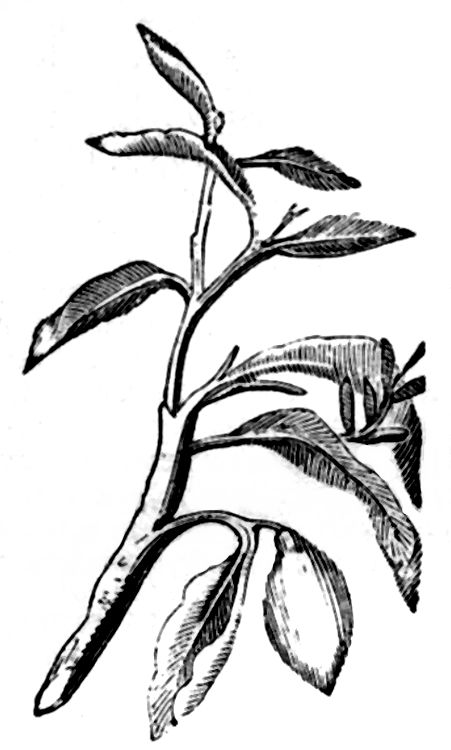
OIL CLOTHS (TO BUY AND PRESERVE). In buying an oil-cloth for a floor, endeavour to obtain one that was manufactured several years before; as the longer it has been made previous to use, the better it will wear, from the paint becoming hard and durable. An oil-cloth that has been made within the year is scarcely worth buying, as the paint will be defaced in a very little time, it requiring a long while to season. An oil-cloth should never be scrubbed with a brush; but, after being first swept, it should be cleaned by washing with a large soft cloth and lukewarm or cold water. On no account use soap, or take water that is hot; as either of them will certainly bring off the paint. When it has dried, you may sponge it with milk, which will brighten and preserve the colours; and then wipe it with a soft dry cloth.
LEADEN CISTERNS (TO NEUTRALIZE THE BAD EFFECTS OF). Sulphate of soda, or common Glauber’s salt, is as good as anything that could be employed. A few applications of this salt will be found sufficient; it will form with all the lead that may be contained in the water an insoluble precipitate, which, forming a crust on the surface of the cistern, will protect the latter from the further action of the water.
BOTTLES (TO EXTRACT CORKS FROM). A simple invention may exist unknown. This is illustrated in your case. You have “been greatly troubled by corks getting within bottles, and have wasted hours in endeavouring to extract them.”

The engraving illustrates a simple instrument formed of twisted wire, with a moveable ring (A), by which its four “fingers” may be closed. Move the ring down to the extremities of the fingers, and insert the latter into the neck of the bottle, still holding fast of the ring, and drawing it back as the instrument is pushed inward. When thus inserted, the fingers will open, as in the engraving; then turn the bottle upside down, and by shaking it, the cork will soon be brought within the open fingers; then draw the instrument out, the while sliding the ring again on the fingers to secure their hold of the cork. When fairly tightened, the cork may be drawn out without any difficulty. It will be observed that the points of the fingers, (B), are sharply bent, by which, when they once lay hold of the cork, they do not release it readily. The plan is very successful.
PIMPLES. The following is an ointment recommended by Sir M. Tierney:—Take of purified lard an ounce; of citron ointment, an ounce and a half; of finest almond oil, half an ounce; and mix all well together. The whole may be scented with oil of bergamot.
MILK (TO PREVENT FROM TURNING SOUR IN WARM WEATHER). In Paris the milkmen are in the habit of employing a little sub-carbonate of soda or of potash. This, by combining with and neutralising the acetic acid formed, has the desired effect, and keeps the milk from turning as soon as it otherwise would. The salt that is thus formed—viz., the acetate of soda or of potash—is not at all injurious; and as pure milk does contain a small quantity of this salt, it is difficult to pronounce upon the addition of any alkali, except there should be some in a free or uncombined state, which does not exist in milk. The addition of a little carbonate of potash will break down the curd that is beginning to form, in consequence of souring.
HAND. The numerous bones of the hand prove the wonderful structure of the animal frame. It is joined to the radius and ulna of the arm by the carpus, or wrist, which consists of eight small bones, in two rows; to these are attached four bones within the palm, called metacarpal, and each of the fingers and the thumb contains three bones, connected by cartilages: hence the hand contains twenty-seven bones. It is so important an instrument to man that without it his reason and speech would not have availed him against other animals.
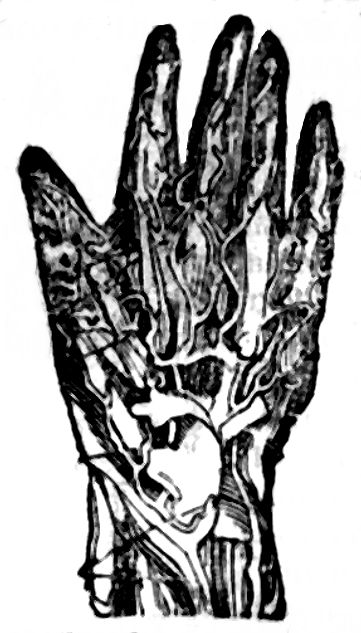
MAGIC LANTERN. An optical toy, by which light is diverged on a wall by a lens, and intercepted by coloured figures.
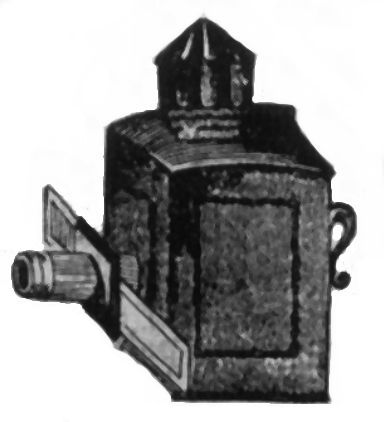
LONG SIGHT. This is a disease of age when the eye becomes too flat to converge rays of light to the distance of the optic nerve; but the light, as is shewn in the engraving, arrives at a focus beyond the nerve, and gives a confused picture at the nerve; nevertheless, if the object is carried further off, the convergency is then perfect, but the object at the increased distance becomes too small to be discerned distinctly, as for reading, &c., and hence it is, that such persons are called long-sighted.
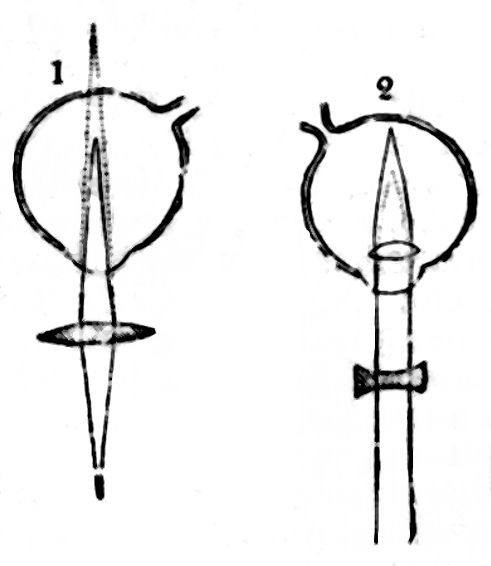
The defect is, however, corrected by means of a convex lens, by which the rays are made convergent before they reach the eye, and the eye, therefore, has less to perform. Fig. 1. explains long sight, and the use of a convex one; and fig. 2. short sight, and the use of a concave lens.
DROMEDARY. The Arabian camel, with a single hunch; a beast of burden in Western Asia, docile, patient, and hardy, but very uneasy to ride upon, though generally used for that purpose in long journeys. They are commonly about six feet high, but nine feet to the top of the head; and they are taught to kneel when they take up their load.
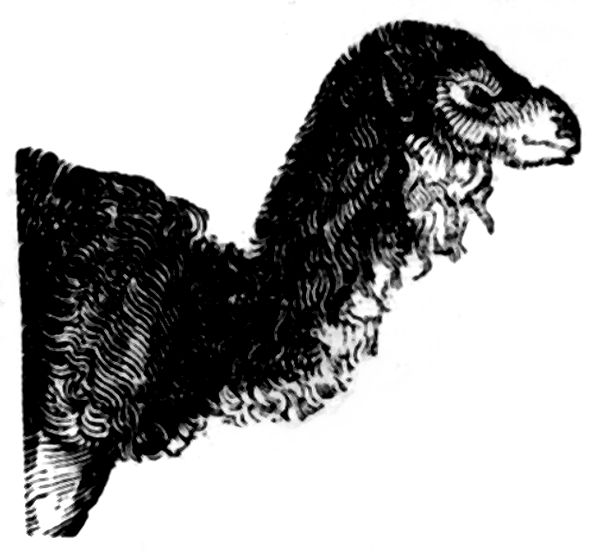
HARROW. The name of a very useful instrument of agriculture, employed to prepare ploughed land for the seed, and to mix the seed with the soil after it has been sown. The latter kind is expressed in the engraving, but their structure is different, according to their purpose.
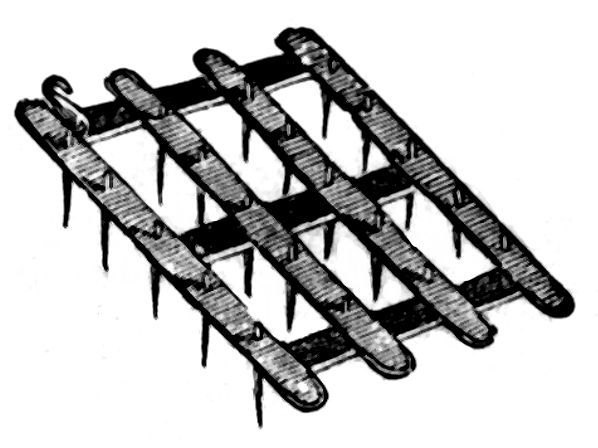
PLUTO. Brother of Jupiter, and god of the infernal regions.
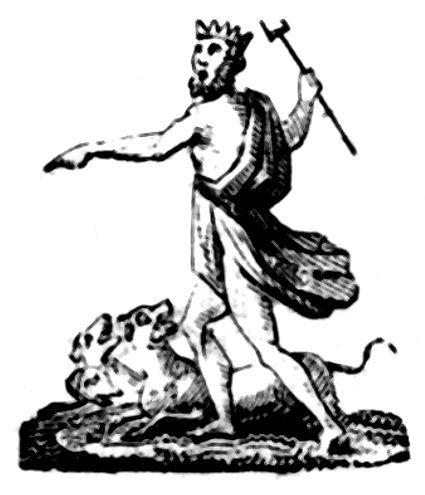
FEBRUARY. It is generally known that Numa Pompilius altered the Roman calendar, by adding two months (January and February) to the year, and, also, that he assigned twenty-nine days to the latter. Julius Cæsar did not make any alteration in the calendar of Numa, but Augustus Cæsar subtracted one day from February and added it to his own month of August. Every fourth year an additional or twenty-ninth day was intercalated between the twenty-third and twenty-fourth of this month, and was unnoticed; but now the intercalated day occurs every fourth or leap year, and is placed after the twenty-eighth; it is therefore the 29th or last day of February.
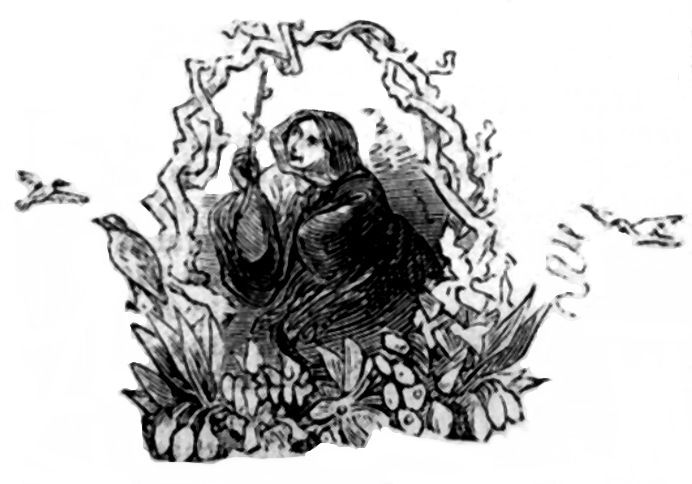
Every leap-year is readily discovered by dividing the year by four; and if there is no remainder, as in 1852, then February contains twenty-nine days, but if there is a remainder, as in 1854, the month only contains twenty-eight days.
The Saxons called this month Sprout Kale, or the month in which young coleworts or cabbages begin to sprout; but it was afterwards called Sol Monath, or sun month, because the sun returns and warns us of the approach of spring, with its fresh vegetation and balmy airs. In Latin, it is called Februarius; in French, Fevrier; in Italian, Febrajo; and in Portuguese, Fevereiro.
The usual allegorical representation of the month is a young man dressed in a dark or cloudy sky-coloured habit, symbolical of the frequent rain and gloomy sky. On his left is the astronomical sign of Pisces, or the fishes, to intimate that the sun enters that sign on the 19th of the month. February has been represented as a young man dressed in a white robe, with a wreath of snowdrops round his brows, and a burning candle in his right hand. Our Saxon ancestors painted this month as a vine-dresser pruning his trees; and, sometimes, as a man in a frieze-jacket buttoned close up to the throat, throwing his arms across his body, the same as we frequently observe cabmen and others at this time of the year, when the weather is very inclement.
The month of February, though generally of a cheerless and uninspiring character, has not been without its muse. The bard of the “Shepherd’s Calendar” thus pours forth his effusions:—
“The sunbeams on the hedges lie,
The south wind murmurs summer soft;
The maids hang out white clothes to dry
Around the elder-skirted croft;
A calm of pleasure listens round,
And almost whispers winterly;
While fancy dreams of summer’s sound,
And quiet rapture fills the eye.”
The red-letter days of February, or its feasts, fasts, and festivals, are tolerably numerous and remarkable. In addition, we have days rendered memorable by certain events chronicled by the antiquary and historian with due care.
The 1st day of this month is always remembered by sportsmen as the end of pheasant and partridge shooting; a happy time for part of the feathered tribe!
2nd. Candlemas Day.—This day is called thus on account of its being celebrated in this and Roman Catholic countries with processions by torchlight, and the performance of mass afterwards. It commemorates the attendance of the Virgin Mary in the temple, forty days after the birth of our Saviour, and it is in consequence frequently called the Day of the Purification of the Virgin Mary. The Germans say—the badger peeps out of his hole on Candlemas Day, and it he finds snow he walks abroad; if he sees the sun shining, he draws back again. Probably the saying, that “if Candlemas be a shining day, the winter is not half finished,” may have arisen from the notion of the Germans. In 1300, upon this day, Pope Boniface VIII. instituted the jubilees in the Romish Church. In 1461, Edward, Earl of March, defeated the forces of Henry VI., under the command of the Earl of Pembroke, at Mortimer’s Cross, near Ludlow, and Owen Tudor, Prince of Wales, was beheaded on the spot. In 1625, Charles I. was crowned in Westminster Abbey, with his queen, Henrietta Maria, by Abbot, Archbishop of Canterbury. On this day, Christopher Wordsworth, D.D., the celebrated poet died, leaving the British nation his beautiful compositions as a memento. The many varied and beautiful poems he composed rank foremost among the best productions of modern poets.
3rd. St. Blaise is the patron saint of the wool-combers. He was a bishop of Sebaste, in Armenia, who suffered martyrdom under Diocletian, 289.
5th. St. Agatha was a female martyr of Sicily, put to death by order of Decius, in 251.
16. In 1497, the celebrated divine, Philip Melanchthon, the coadjutor of Martin Luther in the great work of the Reformation of the Christian Church, was born in the small town of Brethen or Bretheim, in the Palatinate of the Rhine. He was appointed by the general body of the Reformers, in the early part of 1530, to draw up the exposition of their opinions, which was presented to the Emperor at Augsburg in March of the same year; and is well known as the “Confession of Augsburg.”
21st. In 1437, King James I. of Scotland was treacherously murdered at Perth, while taking supper in the convent of the Dominican Friars; and his wife Joan received two wounds while trying to prevent his assassination. In 1838, the celebrated oriental scholar, Sylvestre de Sacy, died at the age of 80; and in 1845 the Rev. S. Smith, author of the “Plymley Letters,” etc., at the age of 74.
24th. Saint Matthias the Apostle, who was chosen by lot after the crucifixion to fill the place of the traitor Judas Iscariot.
28th. Shrove Tuesday is the day previous to the beginning of Lent. In Venice and Rome, the carnival ceases on this day. The name is derived from the Anglo-Saxon Scrifan, to confess, and signifies the time of confessing sins; for which purpose this day was anciently set apart by the Church of Rome as a preparation for the austerities of Lent. After the people had confessed, they were permitted to indulge in festive amusements, and hence arose the custom, yet preserved, of eating pancakes and fritters at Shrovetide, which has given this day the vulgar appellation of Pancake Tuesday. To the pastimes of this day may be traced the nearly exploded diversions of cock-fighting and cock-throwing, whipping-tops, Jack of Lent, etc.
St. Valentine’s Day falls on the 14th of this month. St. Valentine was an ancient presbyter of the Church of Rome, who was beheaded in the Via Flaminia, about the year 278, during the reign of the Emperor Valerianus. This is the day for choosing patron saints in Rome, and lady loves in England. Well does the poor postman remember this day, and how eagerly the anonymous letters he bears are snatched from his hands and perused in the quiet chamber.
POPE’S HAT, or Papal Tiara, is a triple crown worn by the popes on state occasions.
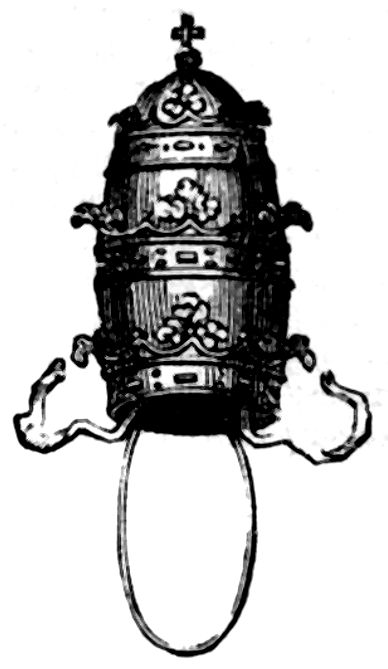
LEYDEN JAR. A mere plate of glass, in the jar form, for the convenience of handling; an electrical excitement is produced on one side, and this operates on the chemical elements within the substance of the glass, just as though it were a plate of air, or a plate of fluid in a galvanic combination; and the opposite side has a similarly opposite excitement, as acid and alkaline, called positive and negative; and the excitement continued by a metal surface, from side to side, produces, when within a small distance, an explosive restoration of the two disturbed sides, considered either as acid and alkaline, oxygen and hydrogen, or supporter and combustible.
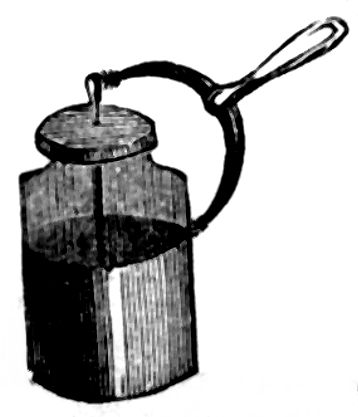
DOG DAYS. These days commence on the 3rd of July, and end on the 11th of August. Dr. Hutton says, that common opinion has been accustomed to regard the rising and setting of Sirius, or the “dog-star,” with the sun, as the cause of excessive heat, and of consequent calamities, instead of its being viewed as the sign when such effects might be expected. The star not only varies in its risings in every one year as the latitude varies, but is always later every succeeding year in all latitudes; so that in time the star may, by the same rule, come to be charged with bringing frost and snow.
STARCH. In the vegetable kingdom starch is a very widely-diffused body. In almost every growing cell granules of starch may be distinguished by means of the microscope. These granules are of various sizes, and assume a great variety of forms; some are round, others are flat, whilst others are even stellate. These granules are always found mixed with other substances, but they are easily made distinguishable by the application of a little iodine, which is one of the best tests for starch, and which, coming in contact with it, produces a beautiful blue colour.
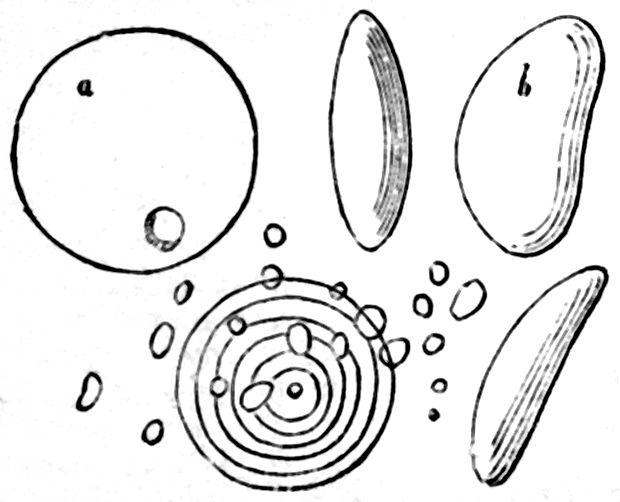
Granules of Starch. (A) From wheat and barley;
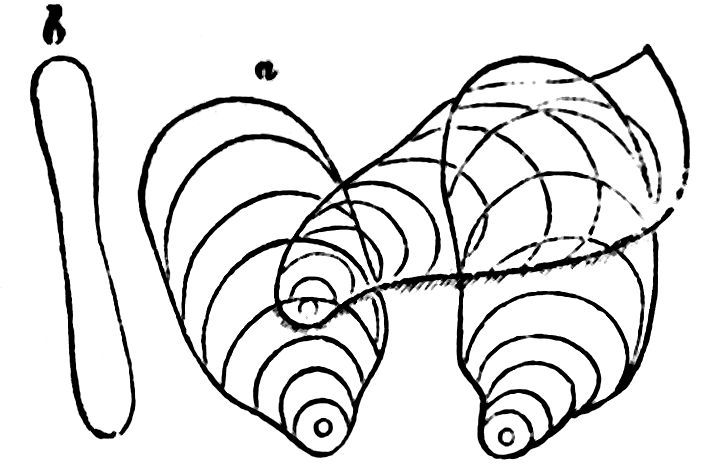
(B) from arrow-root;
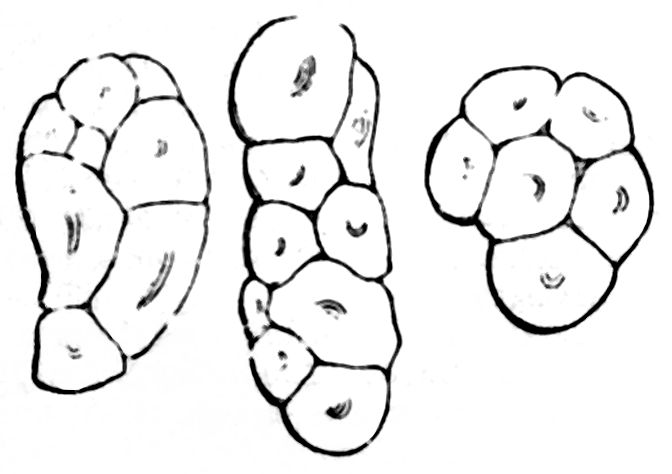
(C) From Portland sago.
Starch is found in some plants in greater quantities than in others; it is, however, very generally found in perennial roots and root-stocks, in the stems and in the seeds of plants. It seems stored up in these parts for the future growth of the developing organs of the plant. There are few or no vegetables or parts of plants that are eaten that do not contain starch. We find it in turnips, carrots, potatoes, cabbages, parsnips, beans, peas, wheat, barley, oats, and the rest of the Cerealia; in chesnuts, walnuts, hazelnuts, and all other seeds; in the apple, the pear, the plum, the cherry, and all other fruits. In many of these things, however, it is not the distinguishing alimentary ingredient, but it is often separated and used pure as an article of diet. The substances in which it exists in a tolerably pure form, and of which we wish now more particularly to speak, are arrow-root, sago, and tapioca.
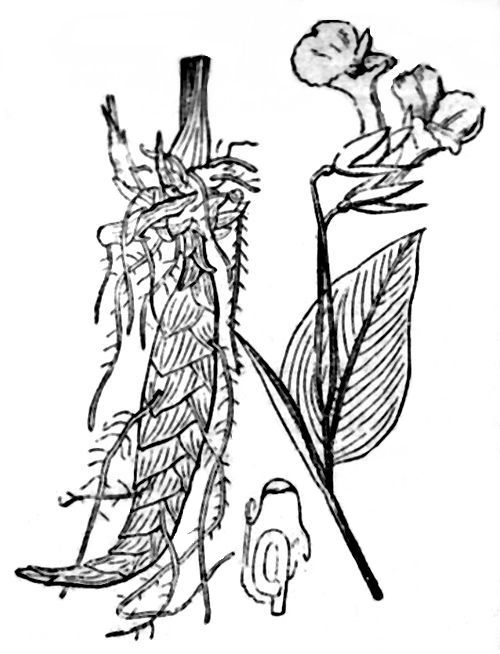
Maranta arundinacea—Arrow-root.
Arrow-Root. What is sold under this name in the shops, is a form of starch procured from the root-stocks of various species of plants belonging to the family Marantaceæ. There are three kinds of arrow-root known in the shops, the West Indian and the East Indian arrow-roots, and Tous les Mois. The West Indian is the produce of a species of Maranta, called M. arundinacea. The East Indian is produced by another species, the M. Indica. What is called Tous les Mois is obtained from another genus of Marantaceous plants, and is called Canna edulis. The part of the plant from which the starch is obtained is the same in all these cases, and the mode of preparation the same. Plants belonging to this family have what is called, botanically, a rhizoma or root-stock (a), an organ standing between the root and the stem. In this root-stock the starch is deposited, and it is separated in the following manner:—The root-stock is dug up, and then bruised and placed in water. The heavier parts, consisting of woody tissue and other matters, fall to the bottom of the water, but the starch is diffused through the water. The water, with the starch, is then separated, and allowed to stand, when at the end of some hours the starch falls to the bottom of the water; it is then collected and dried. This is the principle on which all starch is separated from the tissues in which it is developed. By the same process starch may be procured from potatoes, carrots, turnips, and the stems, leaves, and seeds of plants.
Although arrow-root, sago, tapioca, and potato starch, are all composed of the same constituent, their flavour is very different; hence the preference given to arrow-root as an article of diet. This flavour depends on some peculiar principle which is produced in the plant from which the starch is obtained, and by very careful preparing can be entirely got rid of. Arrow-root is used for making cakes, puddings, and a thick gelatinous fluid in great request in the sick room. It is a property of starch to combine with water at a temperature of 180° and form a gelatinous compound. This property of starch renders it very useful in cookery, and seems to increase the digestibility of the starch itself.
Arrow-root is frequently regarded as very nutritious; but if what we have stated above is correct, it will be seen that it is not nutritious in the proper sense of the word. Those foods can alone be called nutritious that contribute to the building up of the fabric of the body, by adding those materials to the tissues which are being constantly removed by the wear of the body. Now, starch does not perform this function, and is entirely consumed in the body in maintaining its animal heat. Arrow-root, however, and the other forms of starch, are frequently mixed with nutritious matters, such as milk and bread; and in this way the food into which they enter becomes nutritious.
Still, it may be said that children become fat when fed on arrow-root; and this is an undoubted fact. The explanation is, however, easy. When the carbonaceous substances are taken into the system in larger quantities than can be consumed in maintaining animal heat, they are changed in their characters, and become converted into oil, which being deposited in the tissues, produces fat. This oil is not a living part of the body; and a person may get fat even without having his frame nourished, or his strength increased. This is an important fact to bear in mind, as many persons get fat upon certain kinds of diet, without getting any stronger, or more able to perform the functions of the body.
Sago. Another form of starch sold in the shops of Europe is sago. It occurs in little round masses, and when very white and pure, is called pearl sago. When it is in larger and darker masses, it is called common sago. It is starch obtained from the inside of the trunks of palms, and other trees.
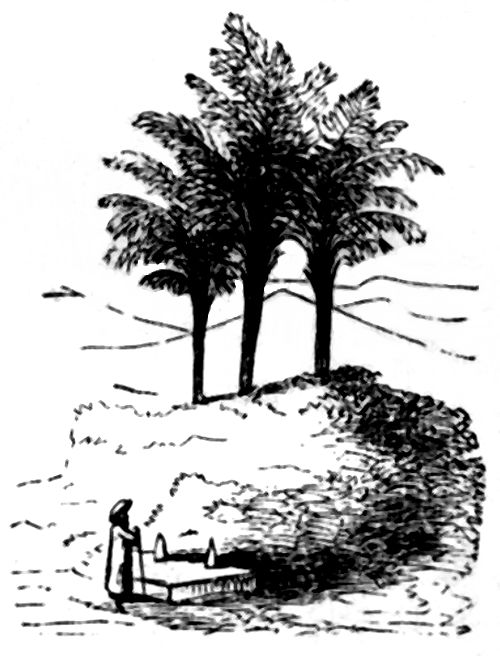
Sagus Rumphii—Prickly Sago Palm.
They are cut down, and the tissue containing the starch being scraped out, the sago is prepared in much the same way as arrow-root. Many plants yield starch in their stems, which, on being prepared, is called sago by Europeans. The sago which is sold in the shops in England is principally imported from the islands of the Indian Archipelago, and is the produce of a palm called the true sago palm, or Sagus lævis. There is, however, another palm belonging to the same genus, the Sagus Rumphii (the prickly sago palm) which yields the sago that is consumed by the natives of India.
Tapioca. This is another form of starch. It is brought to Europe from South America, and is the produce of a plant known to botanists by the name of Janipha manihot. It is a poisonous plant, and the Indians in the countries where it grows extract a poison from it, which they use to poison their arrows before they obtain the starch. The mode of preparing the tapioca is as follows:—The roots of the plant, after it is dug up, are bruised and placed in a bag, to allow the juice to drain out, which is collected in a vessel, into which the Indian plunges his arrow, so as to poison its point. After the root is drained it is taken out of the bag, and submitted to a process such as we have above described for preparing arrow-root. Cassava, which is eaten by the natives, is procured from the same plant, but is prepared in a different way from tapioca. The starch of tapioca does not differ in chemical composition from that of sago and arrow-root, and it is used in the same way, and for the same purposes.
There are many other well-known plants which owe their dietical properties to the starch they contain; amongst these we may mention the potato, the carrot, the turnip, the parsnip, the cabbage, the Jerusalem artichoke. From any of these starch might be prepared. There is a plant in our hedges, known to children in the spring of the year by the name of “lords and ladies,” and commonly called “cuckoo-pint.” This plant, the Arum maculatum of botanists, contains an acrid juice; but, nevertheless, its roots are full of starch. When cooked, the acridity of the plant is got rid of, and they are eaten with impunity. These roots are employed in making the substance called Portland sago; which is the starch separated from the rest of the matter of the plant. This sago is used for the same purposes as the other kinds of sago.
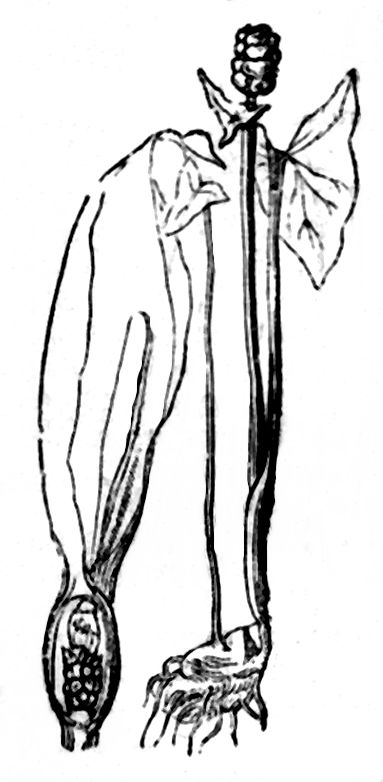
Arum maculatum—Cuckoo-pint.
GOLDFINCH (THE)—(Fringilla Carduelis). The scientific name of this beautiful and well-known bird is derived from the Latin words, Fringilla a finch, and Carduus a thistle, indicating the plant on which it often feeds. The British naturalist, Macgillivray, calls it the Red-fronted Thistle-finch, or Carduelis elegans; and the propriety of this latter title cannot be disputed, for a more sprightly and elegant songster does not exist. “Of all chamber-birds,” says Bechstein, “this is the most delightful, alike for the beauty of its plumage and the excellence of its song, its proved docility and remarkable cleverness.” In Scotland they term it Goldie and Goldspink. Thus Burns alludes to it as
“The goldspink, music’s gayest child.”
Others have called it “the dapper Finch.” and applied to it many endearing epithets; which our readers, we are sure, will be ready to echo, for a universal favourite is Master Goldie. If you want to see him in his glory you should go forth on a bright autumnal day to some common or other waste ground, where thistles grow abundantly; there he is feasting on the downy seeds, and flitting about in the sunshine from clump to clump, in his suit of silky brown, and black, and gold, and red, as happy as a bird can be; every now and then twittering out his lively song, as he scatters upon the gale the white flocculi, by means of which the thistle-seeds are wafted far and wide over the surrounding landscape.
In nearly all parts of Great Britain may the goldfinch be found wild; it is a permanent resident with us, and by no means a shy bird. Its song commences about the end of March, and continues till July or August; it is not powerful, but very sweet, and sufficiently varied to make it agreeable to the ear; for mellowness of tone and plaintiveness, it is considered by good judges to be second to few, if any, of our native songsters. Early in spring, and again in the autumn, goldfinches may commonly be met with in small flocks of from twenty to thirty; severe winters kill a great many of them.
In the breeding season they leave the open country, and resort to woods and thickets, orchards and groves, where they build their nests,—generally amid the higher branches of fruit and other trees; sometimes in tall thick hedges and evergreens. They are very neat builders, and use mosses, lichens, root-fibres, and grass-stalks, closely interwoven; for lining, they usually prefer wool, hair, and thistle or other vegetable down. The nest is perfectly hemispherical, like that of the chaffinch, by which only, perhaps, it is excelled in finish and compactness. Mudie well observes that “the nest of the goldfinch is literally a cradle, and the young are rocked by the winds in their hatching-place, nearly as much as they are to be afterwards on the tall and flexible stems on which they are to find their food.” And this is doubtless a wise ordination, in order that the birds may become early accustomed to the rocking motion, and acquire confidence thus to seek and to seize that which is necessary to their existence. Being frequently placed in such exposed situations, were the nest not very closely and compactly woven, and firmly fixed in its place, it would be liable to be torn in pieces, and scattered by the winds, or at least detached from the lofty bough on which it rests, to the destruction of its precious contents; but this seldom happens, and the little structure swings as safely in its apparently dangerous position, as the sailor-boy upon the mast, when the wild blasts howl and whistle fearfully around him.
The eggs, of which there is rarely more than one laying in a season, are from four to six in number, of a bluish gray colour, sometimes inclining to green; they are sparely marked with light and dark reddish spots and stripes. The young birds, if taken, should be fed on poppy or well-soaked rape seed, mixed with crumbs of white bread moistened with milk.
Wild goldfinches may be caught in spring by means of a decoy-bird, placed in a cage set round with limed twigs or nooses. In autumn and winter bundles of thistles will best attract them. If these are fastened to a tree, and armed with springes or limed twigs, they are most likely to be successful. They may also be taken in nets; as many as one hundred and fifty having been caught in this manner on a single morning.
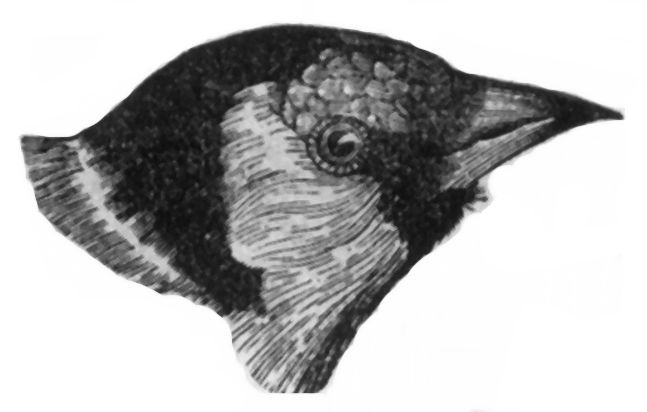
Male.
Some goldfinches are smaller than others; but the standard size may be stated at five inches and a half, the tail measuring about two inches. It is scarcely necessary, with so familiar a bird, to describe its peculiar conformation and markings; the bright scarlet in front of the head and round the base of the beak; the glossy black crown, vertex, wing-coverts, and tail-feathers, so beautifully relieved by the white and golden spots and interlacings, and contrasted by the soft brown of the back, all go to make up a picture at once striking and harmonious; and which, aided by the sprightly motions, sweet song, and engaging qualities of the bird, produce a powerful effect upon the mind and imagination. Bird-catchers tell us that the female may be distinguished from the male goldfinch by its smaller size, and deficiency of some of the white tips of the pinion-feathers; but this must by no means be taken as a distinctive mark. The hen bird is generally smaller altogether, the red about the beak is neither so broad nor so vivid, the beak is a deeper brown, and there is more of this latter colour diffused over various parts of the body. In shape, as well as in markings, the head somewhat varies, as will be seen by the engravings.
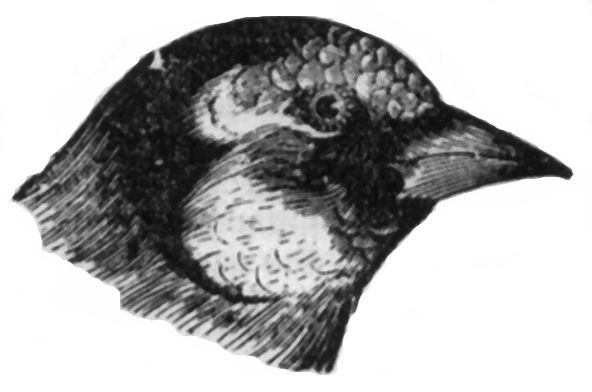
Female.
Although there is but one species, there are several distinctly marked varieties of the goldfinch, such as—1st, the yellow-breasted; 2nd, the white-headed; 3rd, the black-headed; 4th, the white; 5th, the black goldfinch. These latter are sometimes entirely black, or they retain a yellow spot upon the wing; age, or a too constant feeding upon hemp seed, will often cause the plumage to assume this sombre hue. It has also been produced in young birds, by a careful exclusion of light from them; but at the first moulting, after the cage was uncovered, they assumed their more natural colours. Dealers speak very learnedly about these several varieties, and recommend this or that for certain good qualities peculiar to itself; but it is all a matter of accident, and the dress is no indication whatever of disposition or ability, although it may be, in some cases, of age or state of health. If one goes to purchase a goldfinch, he will most likely hear of what are called “speckled birds,” which have a white spot under the throat; of “whitethroats,” or “cheverels,” and “bastard whitethroats,”—the former having a white streak entirely down the throat, and the latter about half way down. For these, high prices will be asked, as they are scarce birds; but they are no better, as songsters, than others. Young goldfinches, that have not moulted have no crimson about the head, and in this state are called “graypates.” When they have attained their full age and perfect plumage, “goldwings” is a term frequently applied to them. If you have a good teacher to put them under, it is well to get the younger birds, and, when the moulting season comes on, to cover the cage with flannel, so as to keep them very warm; they will then throw off their old and assume their new feathers quickly, and be fresh and vigorous for their educational fatigues. “Stopping,” “backing,” or, more properly, “pushing a bird on,” is the name given to the process above described. In the wild state the goldfinch feeds upon all kinds of seeds, more especially those of the cruciform plants; beetles and other insects it takes occasionally; like the pigeon, it prepares in the crop the food intended for its young. In confinement it should have canary, rape, maw, or poppy seed, and hemp seed now and then, especially when breeding or moulting. It should also be supplied with green food, and have plenty of water for bathing as well as drinking. It is a voracious eater, and when put with other birds will often mount guard over the feeding-trough, and drive away all comers; yet it is not quarrelsome, but lives in harmony with its companions, especially if they belong to its own genus. The health of the bird is very much promoted by an occasional treat of thistle-seed, which it likes to pick out itself. It is rather subject to epilepsy, and to bad and swollen eyes. The former should be treated according to the directions given for the canary, and the latter anointed with fresh butter. Captive goldfinches have been known to live to the age of twenty-four years. When old they lose the bright red and yellow of their plumage, and frequently become blind. A goldfinch’s cage should not be less than nine or ten inches long, by seven broad, and about the same in height; its breeding accommodations should be the same as those provided for the canary.
IONIC ORDER. Invented by the Ionians, and applied to the temple of Diana, at Ephesus, and the height of its column is nine times the diameter. Its capital is adorned with volutes, or ram’s horns, but it has no leaves of the acanthus, like the Composite.
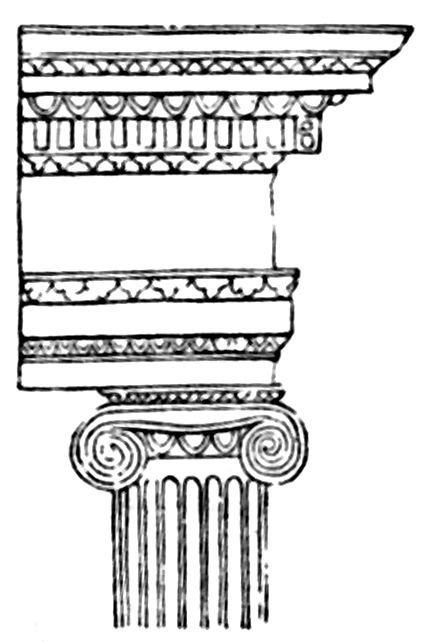
ROTTEN-STONE. Rotten-stone, or tripoli, is used in the arts for polishing metallic and other surfaces. It consists entirely of the remains of animals, whose bodies were covered with an envelope of earthy matter, and whose siliceous coverings have been preserved.
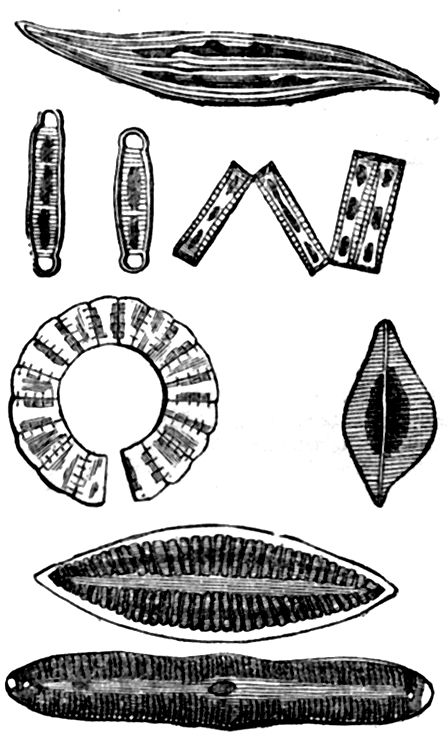
The following are sketches of the fossil remains of animalcules, and are drawn from a microscopic view of the particles of rotten-stone. The above are specimens of the Diatomacea still more highly magnified. With the siliceous shells has been entombed, in some instances, so much of animal matter, that, in the berg, or mountain meal of Sweden, there is nutritious quality in sufficient quantity to render the mineral production edible with bread and flour.
RED SEALING WAX (TO MAKE). Shell-lac, 4 oz.; cautiously melt in a bright copper pan over a clear charcoal fire, and when fused, add Venice turpentine, 1¼ oz.; mix, and add vermilion 3 oz.: remove the pan from the fire, cool a little, weigh it into thin pieces, and roll them into circular sticks on a warm marble slab; or pour into moulds while in a state of fusion. Fine wax is made by using the very best ingredients. The addition of a little camphor, or spirits of wine, makes it burn more readily.
DOMESDAY BOOK. This book is a register of the lands of England, framed by order of William the Conqueror. It was sometimes termed Rotulus Wiltoniœ, and was the book from which judgment was to be given upon the value, tenures, and services of the lands therein described. The original is comprised in two volumes, one a large folio, the other a quarto. The first begins with Kent and ends with Lincolnshire, and is written on three hundred and eighty-two double pages of vellum, in one and the same hand, in small but plain characters, each page having a double column. It contains thirty-one counties. After Lincolnshire the claims arising in the three Ridings of Yorkshire are taken notice of and settled; then follow the claims in Lincolnshire, and the determination of the jury upon them; lastly, there is a recapitulation of every wapentake or hundred in the three Ridings of Yorkshire, of the town in each hundred, what number of carncates and ox-gangs are in every town, and the names of the owners placed in very small characters above them. The second volume, in quarto, is written upon four hundred and fifty double pages of vellum, but in single column, and in a large fair character, and contains the counties of Essex, Norfolk, and Suffolk. In these counties the liberi homines are ranked separate; there is also a title of invasiones super regem. The two volumes are preserved, with other records of the Exchequer, in the Chapter House at Westminster; and at the end of the 2nd is the following memorial, in capital letters, of the time of its completion:—“Anno Millesimo Octogesimo Sexto ab incarnatione Domini, vigesimo vero regni Willielmi facta est ista descriptio, non solum per nostres comitatus, sed etiam per alios.” From internal evidence, there can be no doubt that the same year, 1086, is assignable as the date of the first volume.
EAST INDIA COMPANY. This association originated from the subscriptions (trifling in amount) of a few private individuals. It gradually became a commercial body, with gigantic means; and next, by the force of unforeseen circumstances, assumed the form of a sovereign power, while those by whom it was directed continued, in their individual capacities, to be without power or political influence, thus presenting an anomaly without a parallel in the history of the world. The company was formed in London, in 1599, when its capital, amounting to £30,000, was divided in one hundred and one shares. In 1600 the adventurers obtained a charter from the crown, under which they enjoyed certain privileges, and were formed into a corporation for fifteen years, with the title of “The Governor and Company of Merchants of London Trading to the East Indies.” Under this charter, the management of the company’s affairs was entrusted to twenty-four members of a committee, chosen by the proprietors from among their own body; and this committee was renewed by election every year. The first adventure of the association was commenced in 1601. In the month of May, in that year, five ships, with cargoes of merchandise and bullion, sailed from Torbay, to India. The result was encouraging; and between 1603 and 1613 eight other voyages were performed, all of which were highly profitable, with the exception of the one undertaken in the year 1607. In the other years the clear profits of the trade varied from one hundred to two hundred per cent. upon the capital employed. The charter of the company was renewed for an indefinite period in 1609, subject to dissolution, on the part of the government, on giving three years’ notice to that effect. In 1611, the company obtained permission from the Mogul to establish factories at Surat, Abmedabad, Cambaya, and Goga: in consideration of which permission it agreed to pay to that sovereign an export duty upon all his shipments at the rate of three-and-a-half per cent. The functions of government were first exercised by the company in 1624, when authority was given to it by the king, to punish its servants abroad, either by civil or martial law; and this authority was unlimited in extent, embracing even the power of taking life. A rival association was formed in 1636, but, after two years’ competition, was united with the former company, and the new company assumed the title of “The United Joint Stock.” In 1652 the company obtained license for carrying on unlimited trade throughout the province of Bengal, without payment of duties. The first factory of the English was at Bantam, in Java, established in 1602. At the close of the seventeenth century the three presidencies, Bengal, Madras, and Bombay, were distinguished, as they still are; but it was not till 1773 that Bengal became the seat of the supreme government. The first occasion on which the company was brought into hostile collision with any of the natives of India occurred in the beginning of 1664. A serious dispute arose in Parliament upon the powers of the company in 1666. In 1682-3 a project was set on foot for the establishment of a rival company, but it did not obtain the sanction of government. A new charter, to have effect for twenty-one years, was granted in 1693. The home government of the company consists of—first, the court of proprietors; second, the court of directors; and third, the board of control. The board of control consisted, formerly, of six privy councillors; and the chancellor of the exchequer, and principal secretaries of state, were, by virtue of their office, members of the board; but, by an act passed in 1793, this became no longer necessary. By an act of Anne’s Parliament, the company had the exclusive right of trading to all places eastward of the Cape of Good Hope, to the Straits of Magalhaens; and these privileges were confirmed by successive acts of Parliament till 1814, but were afterwards modified. In 1833, the charter was renewed for twenty years, but by an act which took away from the company the right of exclusive trading to its own territories, or to the dominions of any native power in India or China, and threw the whole open to the enterprise of individual merchants.
HONEYMOON. The word “honeymoon” is traceable to a Teutonic origin. Among the Teutones was a favourite drink called metheglin. It was made of mead of honey, was much like the mead of European countries. The same beverage was also in use among the Saxons, but flavoured with mulberries. These honeyed drinks were used more especially at marriage festivals and which were kept up among the nobility one lunar month; the festive board being well supplied with metheglin. “Honah Moon,” signified the moon or moonath of the marriage festival. Alaric the Goth, celebrated by Southey’s poem, died on his wedding-night, from a too free indulgence in the honeyed drink.
INDIGO. Indigo is obtained from an Asiatic and American plant, which is bruised and fermented in vats of water. During the process, a blue powder is deposited, which is collected and dried so as to form the cubic cakes in which it occurs in commerce. Indigo is quite insoluble in water; when heated it yields a purple vapour, which condenses in the form of deep blue acicular crystals. When it is exposed to the action of certain deoxidizing agents, it becomes soluble in alkaline solutions, losing its blue colour, and forming a green solution, from which it is precipitated white by the acids: but it becomes blue on exposure to air. This white indigo has been termed indigogene, and indigo appears to be its oxide. When indigo is dissolved in concentrated sulphuric acid it forms a deep blue liquid, known to the dyers under the name of Saxon blue. Bengal is the great mart for this drug.
GOLD FISH. Great care must be taken of gold fish, as they are very susceptible; and hence a loud noise, strong smell, violent or even slight shaking of the vessel, will oftimes destroy them. Small worms which are common to the water, suffice for their food in general: but the Chinese, who bring gold fish to great perfection, throw small balls of paste into the water, of which they are very fond; they give them also lean pork dried in the sun, and reduced to a very fine and delicate powder. Fresh river-water must be given them every day. Care must be taken to collect the spawn, when seen floating on the water, as otherwise it will be destroyed by the fish themselves. This spawn is put into a vessel, and exposed to the sun, until vivified by the heat. Gold fish, however, seldom deposit spawn when kept in vases. In order to procure a supply, they must be put into reservoirs of considerable depth, in some parts at least well-shaded at intervals with water-lilies, and constantly supplied with fresh water. At a certain time of the year numerous barks are seen in the great river of Yangst-se-Keang, which go thither to purchase the spawn of gold fish. This is obtained with no small care, for towards the month of May the inhabitants close the river in several places with mats and hurdles, which extend nine or ten leagues, and leave only a space in the middle sufficient for the passage of boats. The spawn is stopped by these hurdles, and the water being afterwards drawn up, and put into large vessels, is sold to merchants, who send it to all parts. Gold fish were introduced into England about the year 1691, but remained exceedingly scarce till 1728, when a great number were brought over, and presented to Sir Matthew Decker, by whom they were generally distributed round London.
LEECHES (TO MAKE THEM BITE). Leeches may usually be induced to take more readily than otherwise by rubbing the surface to which they are applied with a little milk. Previous to their application the skin should be carefully cleansed, not with soap, but with plain warm water. A wineglass is the best thing to keep them over the spot where they are to be applied. When they have performed their office, they may be made to disgorge the blood by putting a few grains of salt upon them. They are often killed by the application of too much salt. Probably, were they put into salt and water for a little time it would be better.
FROST AND SNOW. Occasionally in Lapland the phenomenon of the formation of snow is witnessed when the door of an apartment in which persons are assembled is suddenly opened and a blast of cold air admitted, the watery vapour exhaled by their respiration being instantly frozen into flakes. Snow is a bad conductor of heat, or cold, and therefore acts as a most valuable covering for vegetables and seeds; wheat continues to grow beneath its covering, though every blade would be cut off if exposed to the frosty air. Let us not forget how beautiful and varied are the forms of its flakes, when looked at through a magnifying glass, or microscope. (See Heat and Cold, p. 54).
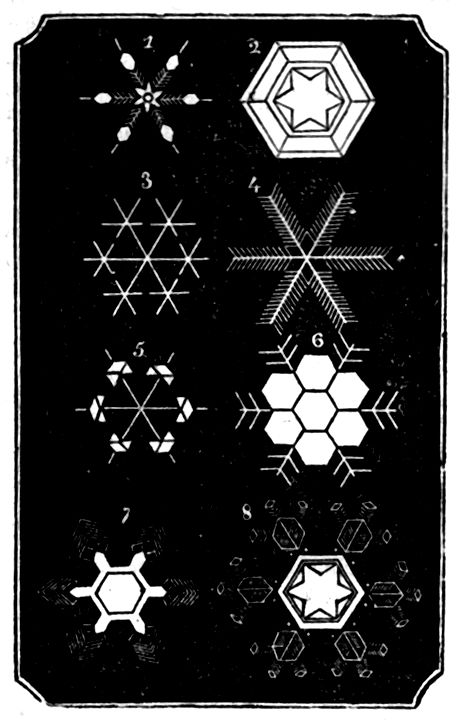
MARBLES. You may tell your boys that the marbles with which they play are mostly imported from Holland, where they are made by breaking various kinds of stone into pieces of a suitable size; these pieces are put into an iron mill, worked either by water or steam; there are several divisions in the mill, with rasps, which turn round with great swiftness; thus they are made round, and then they fall out of the mill. They are brought from Nuremburg to Rotterdam, down the Rhine, and from thence distributed over Europe. The “allies” are cut from superior marble.
MAGNETIC NEEDLE. A small bar of iron, to which, by artificial means, the peculiar arrangement of the magnet has been transferred, by which it points in the magnetic meridian; and, the direction of this meridian being known, the course of ships at sea is thereby determined.

It also dips or inclines from the plane of the horizon, pointing in the northern hemisphere downward at the North Pole of the magnet, and in the Southern hemisphere contrarily.
HOTCHPOT. The word has thus been quaintly explained by Littleton:—“It seemeth that this word hotchpot is, in English, a pudding, for in a pudding is not commonly put one thing alone, but one thing with other things together.” It was a rule of the common law, that where a daughter, to whom lands had been given in frank marriage, claimed a portion of the lands descending upon her together with her sisters from the father in fee simple, she should not take any share unless she mixed and blended the lands given to her in frank marriage with the descended estate, so that they might be equally divided among all the daughters. The statute 22 and 23 Chas. II. c. 10, s. 5 (the Statute of Distribution), provides that in making distribution of the personal estate of intestates, advancements made by them in their lives to their children shall be brought into hotchpot.
LIBRA, OR THE BALANCE. This is the first of the autumnal signs, and the seventh amongst its brethren. Emblematic of that equality which subsists between the day and night, its denotive character ♎ is aptly represented by a pair of scales in equilibrio, because the days and nights are nearly equal, except at the poles. In poetic fiction, the Balance belongs to the goddess Astræa, and is referred to by Homer, Virgil, and Milton.
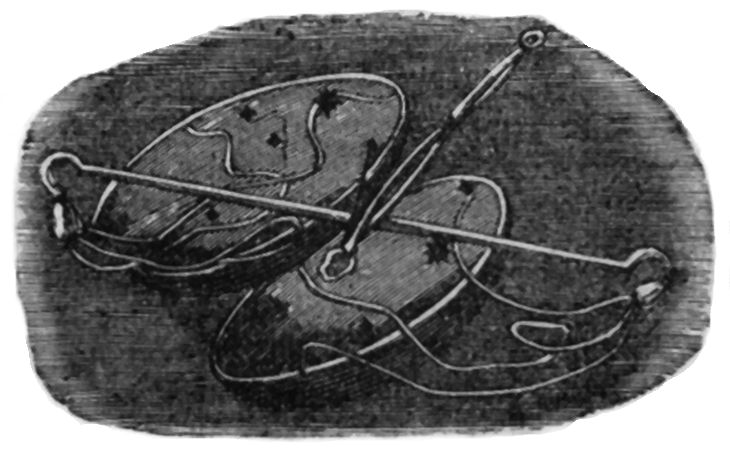
Libra, or the Balance.
RADIATED ANIMALS. Our illustration represents the figure of a common Starfish, or “Five-Fingers.”
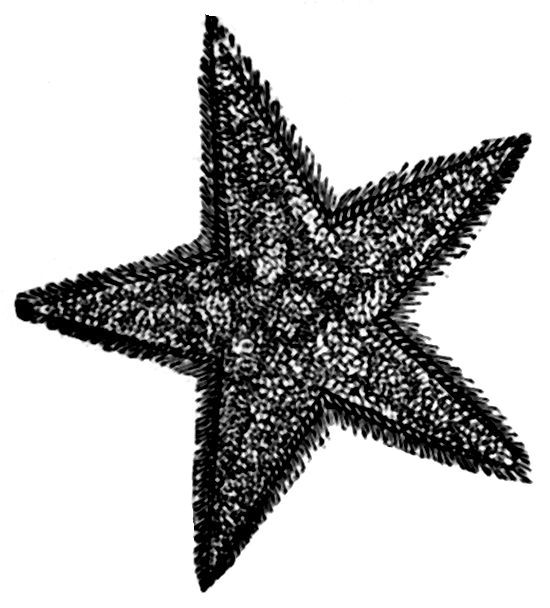
The limbs, or arms, are arranged like rays proceeding from a centre, and from this circumstance it is termed a “rayed,” or “radiated animal.” All with this rayed appearance have, of course, the same appellation, and, along with others, constitute class Radiata. The rayed appearance is not, however, so obvious in many of these animals as in the Starfish. Radiated animals are divided into four classes, viz—
Infusoria, or Infusory Animalcules.
Entozoa, or Internal Parasites.
Zoophyta, or Polypes.
Radiaria, or Rayed Animals.
HOW TO BLEED. In cases of great
emergency, such as the strong kind of
apoplexy, and when a surgeon cannot
possible be obtained for some considerable
time, the life of the patient depends almost
entirely upon the fact of his being bled or
not. We therefore give instructions how
the operation of bleeding is to be performed,
but caution the reader only to attempt it in
cases of the greatest emergency. Place a
handkerchief, or piece of tape, rather but not
too tightly round the arm, about three or
four inches above the elbow. This will
cause the veins below to swell, and become
very evident. If this is not sufficient, the
hand should be constantly and quickly
opened and shut for the same purpose.
There will now be seen, passing up the
middle of the fore-arm, a vein which, just
below the bend of the elbow, sends a branch
inwards and outwards, each branch shortly
joining another large vein. It is from the
outer branch that the person is to be bled.
The right arm is the one mostly operated on.
The operator should take the lancet in his
right hand, between the thumb and first
finger, place the thumb of his left hand on
the vein below the part where he is going
to bleed from, and then gently thrust the
tip of the lancet into the vein, and, taking
care not to push it too deeply, cut in a
gently curved direction, thus  and bring
it out, point upwards, at about half an inch
from the part of the vein into which he had
thrust it. The vein must be cut lengthways,
and not across. When sufficient
blood has been taken away, remove the
bandage from above the elbow, and place
the thumb of the left hand firmly over the
cut until all the bleeding ceases. A small
pad of lint is then to be put over the cut,
with a larger pad over it, and the two kept
in their places by means of a handkerchief
or linen roller bound pretty tightly over
them and round the arm. When a person
is bled, he should always be in the standing,
or at any rate in the sitting, position; for
if, as is often the case, he should happen to
faint, he can, in most cases at least, easily
be brought to again by the operator placing
him flat on his back, and stopping the
bleeding. This is of the greatest importance.
and bring
it out, point upwards, at about half an inch
from the part of the vein into which he had
thrust it. The vein must be cut lengthways,
and not across. When sufficient
blood has been taken away, remove the
bandage from above the elbow, and place
the thumb of the left hand firmly over the
cut until all the bleeding ceases. A small
pad of lint is then to be put over the cut,
with a larger pad over it, and the two kept
in their places by means of a handkerchief
or linen roller bound pretty tightly over
them and round the arm. When a person
is bled, he should always be in the standing,
or at any rate in the sitting, position; for
if, as is often the case, he should happen to
faint, he can, in most cases at least, easily
be brought to again by the operator placing
him flat on his back, and stopping the
bleeding. This is of the greatest importance.
GALVANIC BATTERY (TO FORM). For quickly forming a good, cheap, and powerful galvanic battery, we believe no method to be more available than that on Mr. Grove’s principle, first given by Dr. Goldingbird. “Procure the bowls of six tobacco-pipes, and stop up the holes, left by breaking off the pipes, with sealing wax. Place on the table six small glass tumblers, each an inch high, like those used by children as toys; place in each a cylinder of amalgamated zinc; let a pipe-bowl rest in each cylinder, and place in every one a slip of thin platinum foil, one and a quarter inches long and half an inch wide, connected at the zinc cylinder by platinum wire; fill the pipe-bowls with nitric acid, and the tumblers with dilute sulphuric acid, and an energetic current of electricity will be set free, capable of rapidly decomposing water, igniting wire, charcoal points, &c.”
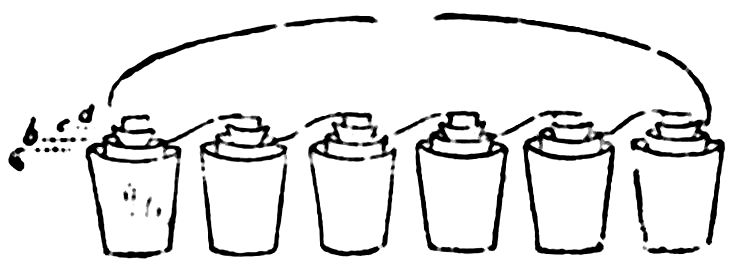
a, glass tumbler; b, zinc cylinder; c, pipe bowl; d, platinum foil.
RESPIRATION (AGENTS WHICH INCREASE). Walking and running at various amounts of speed, walking in the sea, riding on horseback in the various paces, riding in carriages and on the railway in different classes, and on the engine at various rates of speed, the labour of the tread-wheel, ascending and descending steps; rowing, swimming, (Marshall Hall’s ready method), reading and singing, carrying various weights at a certain speed, cold bathing, albumen (egg), gelatine, beef steak, oatmeal, wheaten bread, potatoes, milk, suet and milk, sugar, rum, tea, coffee, ether, sun-light, heat.
Agents which Decrease the Quantity of Air Breathed. Darkness, cold air inspired, all fats, as cod liver oil, olive oil, butter, beef fat, arrowroot, brandy, wine, kirchen-wasser, compound and fœtid spirits of ammonia, opium, morphia, hydrocyanic acid, tartar emetic, and salines, as chloride of sodium, and febrifuge medicines.
Agents which have a Mixed Effect. Chloroform, chloric ether, and amylene. Digitalis first increases and then decreases the quantity.
SYRUPS. Although these preparations are so little used in England, there is no reason why they should not become a regular article in the housekeeper’s store-room; they are easy to prepare, and are very agreeable to the palate; also economical, as they supersede the use of ardent spirits and wine. On the Continent it is a common practice to drink simple syrup (which is called eau sucrée, but which we term capillaire) diluted with water, to the taste of the drinker.
Capillaire is made thus:—Dissolve about two pounds of the best refined white sugar in one pint of water; boil the mixture for five or ten minutes, then strain it through lawn, or a hair sieve; when cold, it is fit for use.
Syrup of Cloves. Proceed in the same way as for making capillaire, but with the sugar add thirty or forty cloves that have been broken or ground.
All the syrups of spices, as cinnamon, nutmeg, ginger, &c., can be made in the same way.
Syrups of Fruit. These are prepared in a similar manner to capillaire, substituting the juices of the fruit in place of the water; in this way, it is very easy to make Syrup of Oranges. Before the oranges are squeezed, to express their juice, each orange should be well rubbed or grated with the lump sugar; by so doing the fine flavour of the rind is preserved. All these syrups are drank by diluting them with water; about a wineglassful of syrup to a tumbler of water will be found to make a pleasant draught.
Syrup of Coffee. Take about an ounce of the finest coffee, ground, and a pint of cold water; allow them to stand together for twelve or more hours, then strain, and add one pound and a half of sugar; boil for one or two minutes, not longer, and again strain.
Syrup of Tea. One pint of water, two pounds of sugar, an ounce of black tea; boil together for five minutes, or rather less; strain. A wineglassful to half a pint of cold water makes very good cold tea.
INSECTS (TO PREPARE FOR CABINETS). The mode adopted for killing insects for preservation in cabinets varies with the different tribes. Dark-coloured beetles may be plunged as captured into a bottle containing spirits of wine, and, on reaching home, they may be dipped for an instant into scalding water, dried on blotting-paper, and are ready for the cabinet. Those of delicate colours may be fixed in a tight tin box, which may be plunged for a few moments in boiling water. Butterflies, moths, and dragon-flies, may be killed by sharply pressing the thorax without injuring the wings, and then pinned; or the pin may be dipped in a strong solution of oxalic acid before being used. Large moths and dragon-flies, which are exceedingly tenacious of life, may be instantly killed by holding the wings above the back, and dipping merely the under surface of the body for an instant into scalding water; or they may be fixed to a cork, tightly wedged into the bottom of a gallipot, which is to be then inverted, and plunged mouth downwards into boiling water. By far the greater number of insects are killed immediately, if a few bruised laurel leaves, which exhale prussic acid, are kept in the collecting box. The fumes of burning sulphur should not be employed, as they injure the colours of insects considerably. Parasites, which infest birds, and others of small size, may be conveniently put into a quill, which, after corking, may be dipped into boiling water.
INTEREST. Interest is the money paid for the loan of a sum, denominated the principal, for a given time according to a fixed rate. Interest is distinguished as simple and compound. Simple interest is that which is paid for the principal, or sum lent, at a certain rate or allowance made by law or agreement of parties, whereby so much as £5, £6, or any other sum is paid for £100 lent out for a year; and the same amount of interest per cent. per annum for any longer time. Compound interest is that which accumulates when the simple interest is added to the principal, and the subsequent interest calculated on the constant accumulation. In this manner the principal nearly doubles every fourteen years. The accumulation of money when placed at compound interest, after a certain number of years, is exceedingly rapid, and, in some cases, truly astonishing. One penny put out at five per cent. compound interest, at the birth of Christ, would, in 1810, have amounted to a sum exceeding in value 357,000,000 of solid globes of standard gold, each in magnitude as large as this earth.
REFLECTING TELESCOPES. The refracting astronomical telescope is formed of two convex lenses in a tube, and is the simplest form of telescope. In the Galilean telescope a concave eye-piece is used. Refracting telescopes for land objects are a compound form of the first-named, and are so constructed as, by the use of different qualities of glass, to prevent the decomposition of the light rays at the edges of the picture presented to the eye. When this is accomplished perfectly, such instruments are called achromatic (without colouring). Telescopes are not difficult to construct, and some of the finest have been made by amateur opticians.
OYSTER GROTTOES. The grottoes of oyster-shells, built by children at the street sides, were formerly erected on the festival of St. James. They were originally set up by poor persons, who solicited alms from the pious persons that were unable to visit the celebrated shrine at Compostella.
WALLFLOWER, OR GILLIFLOWER. There has been a curious confusion with respect to the clove-pink and the wallflower. The former belongs to the natural order Caryophyllœ. the latter to Cruciferæ. The clove-pink (not the cultivated double flower of the garden) grows upon old walls and ruins, as at Norwich, and on the castles of Deal, Sandown, and Rochester, flowering in July; hence it was said to be a “wallflower,” and a “July-flower.” Chaucer calls it “clove-gilofre,” or, “clove-gilliflower.” Thus the clove-pink, Dianthus caryophyllus, came to be named “gilliflower” (July-flower), and “wallflower.” The true wallflower belongs to the same tribe of plants as the stock, mustard, cress, &c., which have their petals arranged in the form of a cross, and hence named Cruciferæ (cross-bearers). It grows on old walls, and begins flowering in April, having a delicious scent. It has been improperly called “gilliflower,” and “sweet-william,” neither of which it resembles.
ANNEALING. Annealing is a process by which the extreme brittleness common to glass and some metals, when cooled suddenly after melting, is avoided or removed. Such brittleness appears to be occasioned by some disturbance in the regular arrangement of the constituent particles in rapid cooling, and is remedied by cooling very slowly and regularly. Glass-houses are furnished with large annealing-ovens, in which this object may be attained by the gradual removal of the glass articles from a hotter to a cooler part, or by allowing the heat of the oven to subside slowly. Analogous operations are employed in the manufacture of cast-iron and other metals. Some malleable metals which crystallize on cooling are brittle in their crystalline state but are rendered tough by heating and rolling. Zinc, for example, though incapable of more than very slight extension under the hammer, without cracking, becomes almost as flexible and tough as copper after being rolled at a moderate heat.
CHIROMANCY. Chiromancy, or Palmistry, the art of foretelling future events, or deciphering a person’s disposition by the lines naturally impressed on the human hand, has, in all ages, received the implicit faith of numbers of mankind. Aristotle taught that the duration of life depended on the length of the lines on the hand; the Pythagoreans were of the same opinion; and in ancient Rome it was the most important branch of the Augur’s mysterious profession. In the credulous middle ages it was elevated to the dignity of a science; and such men as Cardan and Melanchthon were not ashamed to practise it.
We will now submit a conversation between a sceptic and a believer in the science of chiromancy, and leave our readers to form their own opinions as to the amount of truth involved in it:—
“Your last proposition,” I observed, “approaches very closely to the chiromancy of the ancients; if, indeed, it be not chiromancy itself.”
“It matters little by what term you designate a knowledge of the relations which exist between the hand of an individual, and his intelligence, temperament, passions, and diseases. It is sufficient for me to know that there are such relations, and that to learn them only requires patience and penetration. From the earliest antiquity, man has ever given his open hand to a friend, but presented it closed towards an enemy. The open hand has ever been the emblem of friendship; the closed hand, the symbol of hostility. I tell you that all physiology, all psychology, and even pathology is written in legible characters upon the human hand. Here,” he continued, taking some plaster casts out of a glass case, “is the cast of the hand of an intelligent man, of a philosopher (fig. 1).
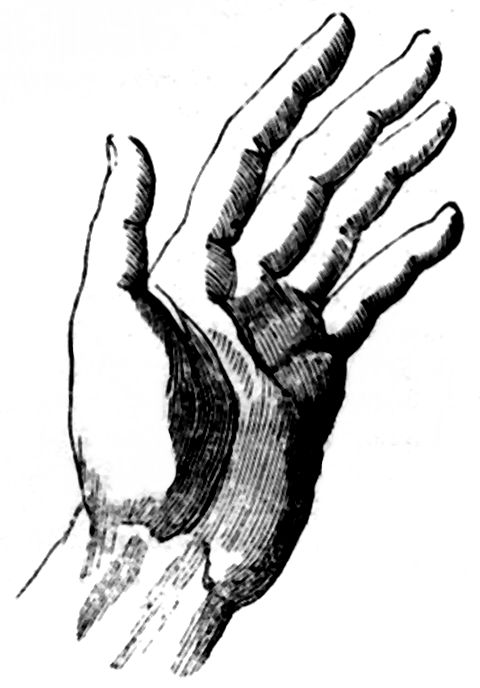
Fig. 1.
Observe the regularity of its form and the harmony of its lines. The disengagement of the thumb permits it to be opposed to all the fingers; and it rises in height to nearly the second joint of the forefinger. The fingers are all of different lengths; but close your fingers upon your palm, or grasp a cricket ball, and you will find that they all appear equal. Thus it is that the hand of an intelligent man can use the sword, pen, pencil, hammer, needle, graver, and other tools which the intelligent mind has invented.
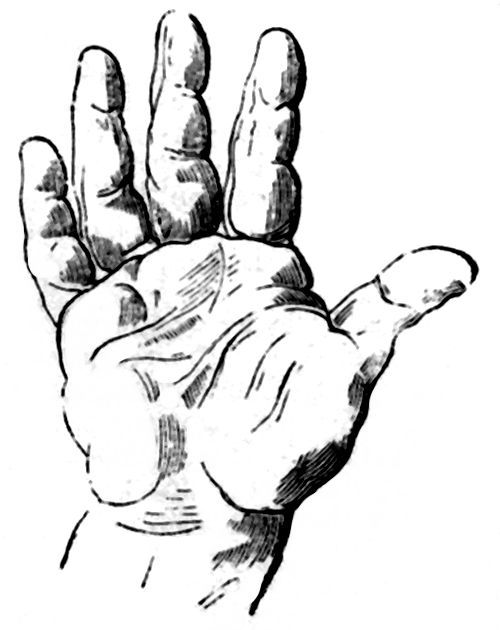
Fig. 2.
Observe, also, how few lines and creases there are in the palm—like the elevated intelligence it appertains to, it is neither empty nor broken. Compare this hand of an idiot (fig. 2) with the former. Observe its general thickness and clumsiness of form, and the great depth of its lines. The muscles of the thumb being rendered useless by callosities, it cannot be opposed to the fingers. Thus deprived of its principal function, that of prehension, this hand, incapable of grasping material objects, well represents the brain of an idiot incapable of sustaining an idea.
“If lunacy really be, as it is generally supposed, an undue elevation of the intellectual faculties, even to their perversion and overthrow, this hand of a lunatic (fig. 3) admirably exemplifies such a state of the mind.
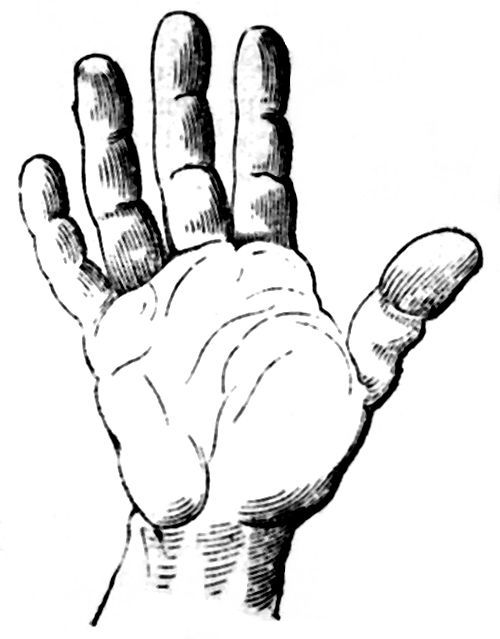
Fig. 3.
What confused and irregular lines cross each other in all directions! Do they not seem like the confused imaginations of a madman? Observe particularly the clumsy thickness of the hand, like that of the idiot, a sure token of the loss of the reasoning faculties.
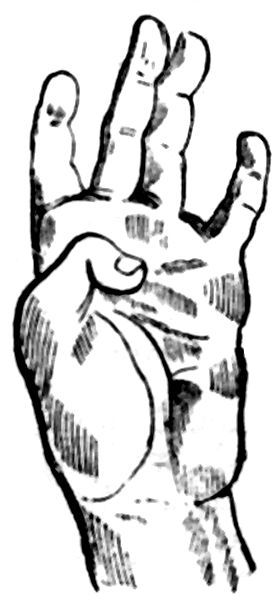
Fig. 4.
“Here, again, is the hand of a monomaniac (fig. 4), whose intelligence is not totally obscured, but whose every faculty is concentrated upon one single object. Observe how it is traversed by only one line, deeply marked, like the one predominating idea of the maniac. All the fingers are involuntarily inflected to that one line, as all the faculties of the maniac are towards the one object of his mania. But nature shows that this unhappy mind still retains a certain degree or sanity. We see none of the clumsy thickness which the hands of the idiot and lunatic exhibit; yet, at the same time, the shortness of the thumb and little finger proves that, like the mind of the maniac, his hand is abnormal and incomplete.
“As nature has marked the intellectual gradations from the intelligent man to the idiot, so she has established in the conformation of the hands of all men infinite shades of distinction, which faithfully represent the innumerable shades of mental energy that distinguish the characters of mankind one from another. It would be impossible for me to go farther into this subject at present, as it would occupy several hours to explain even a few of those nice shades of distinction. I shall therefore proceed to show you two more links in the chain of degradation. This brings me back to zoology,”—he continued, as he spread on the table a number of specimens,—“Between the first and second links of the animal chain—that is to say, between the intelligent man and the monkey tribe, nature has placed an intermediate race, whose forms resemble man, but whose savage instincts approach the inferior animals. This double similitude is portrayed in their hands. Here is a cast (fig. 5) from the hand of a Bosjesman. Compare it with this preserved hand of a Chimpanzee (fig. 6) and this other cast (fig. 1), the first I showed you of a civilized European. In the hands of the Bosjesman and Chimpanzee the thumbs are shorter than in the hand of an intelligent man.
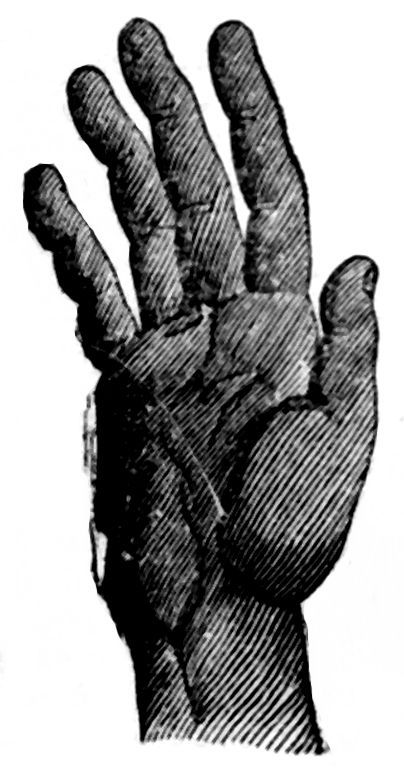
Fig. 5.
Observe, they barely reach to the first joint of the forefinger, an invariable sign of want of intelligence. The narrowness of these two hands also indicates an instinct of theft and rapine. Yet the Bosjesman, being more nearly allied to the intelligent man than to the Chimpanzee, the hand of the former does not present the rude energy of the latter, constructed to climb the loftiest trees of a tropical forest.
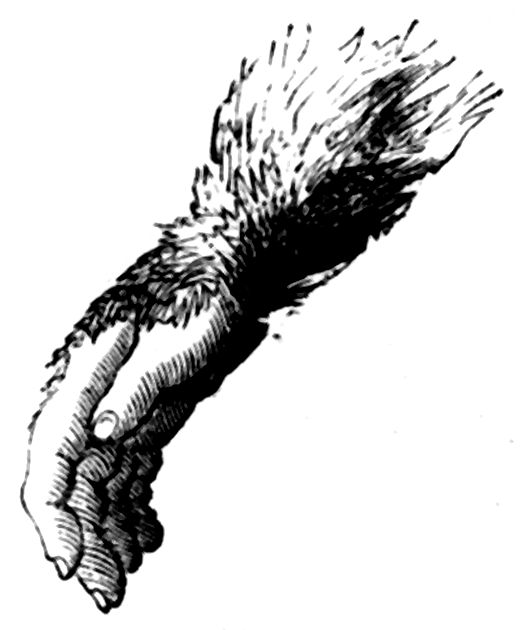
Fig. 6.
“The farther we penetrate into the study of animals, we shall find more and more of the irregularities of zoological classification. Here are five paws of animals placed by naturalists in the same order—the carnivorous. This order, which is considered one of the most natural, is at the same time full of contradictions. True, it has been subdivided into classes and families; but even in those subdivisions nature is not better respected. Even with the little knowledge we possess of the habits and instincts of animals, who can witness without astonishment such dissimilar creatures as the mole, lion, dog, bear, and cat, placed in the same order? How much more plainly than their teeth do the paws of those animals proclaim their proper classification?
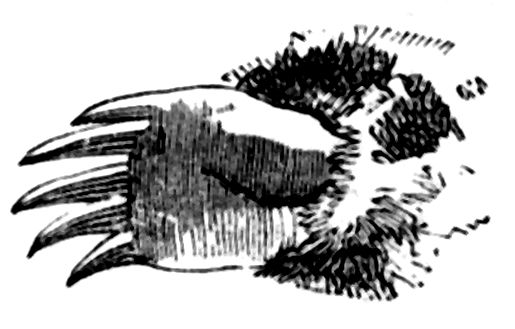
Fig. 7.
At the first sight of this paw (fig. 7), short an thick, with claws long and hooked, can you not read the history of the animal it belongs to? You require no book—no long, finely-worded description. You see that it is constructed to scrape and burrow in the earth, or to seek food and a shelter from its enemies. In short, the whole history of the mole is legibly inscribed on this one solitary claw. Again, examine these paws, belonging to the four best-known species of the carnivora, whom man has placed together in one family group, though nature has most distinctly separated them.
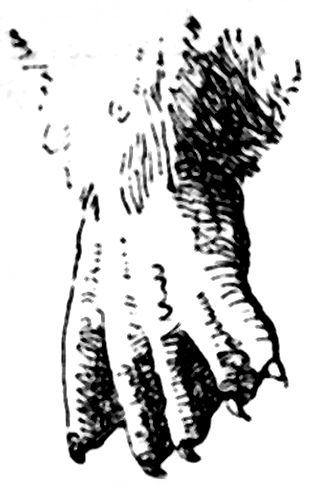
Fig. 8.
Admire, in this paw of a lion (fig. 8), the striking provision of nature, which applies a tendon to each claw to prevent them being blunted by contact with the earth. Does not this arrangement proclaim to us that the lion tears his prey before he devours it.
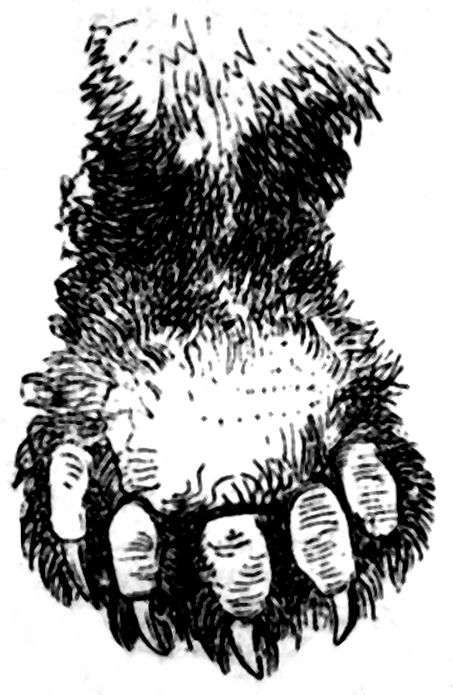
Fig. 9.
On the contrary, the claws of the bear (fig. 9) are sunk in a clumsy mass of flesh; decidedly that animal does not tear its prey. Observe this paw of a cat (fig. 10); the toes and claws are partly concealed by hair.
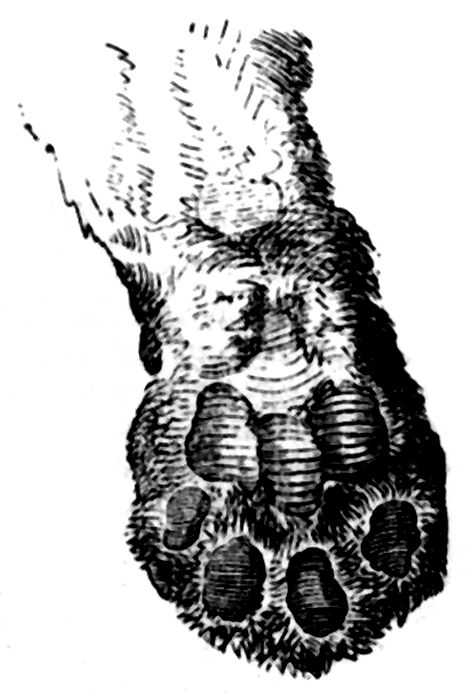
Fig. 10.
You know a cat has a velvet paw, but its claws are sharp and cutting—a significant proof of the dissimulation and cunning of the animal. In the paw of the dog (fig. 11), the friend and companion of man, the claws are blunt and harmless, and the length of the toes denote his docility and intelligence.
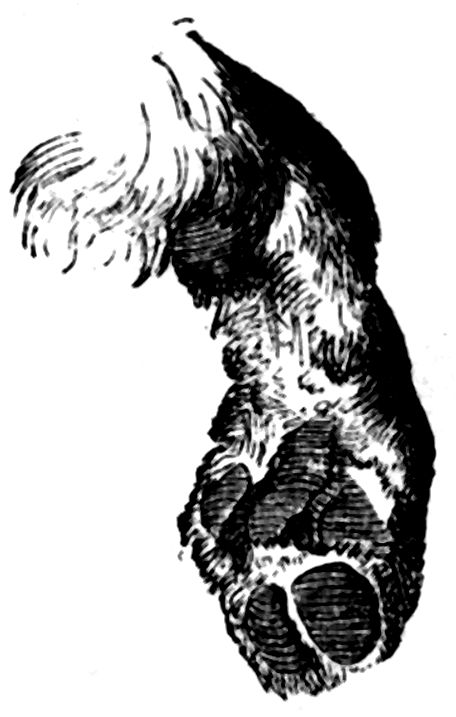
Fig. 11.
“If time permitted, I could detail a great many traits in the character of these animals, clearly pointed out in the forms of their fore-paws; but you must be satisfied with this hasty sketch at present, and I will pass on to the well-known order termed by naturalists, from the peculiar form of their incisor teeth, the rodents. All the animals of this order have four toes on their anterior paws, though some have as many as five, and others only three on their hind feet. This regularity of conformation in the fore-paws of so many animals is an evident proof of the importance attached by nature to those organs. Now, notice these three paws, and tell me if the animals to which they belong can have the same habits or the same intelligence? Decidedly not!
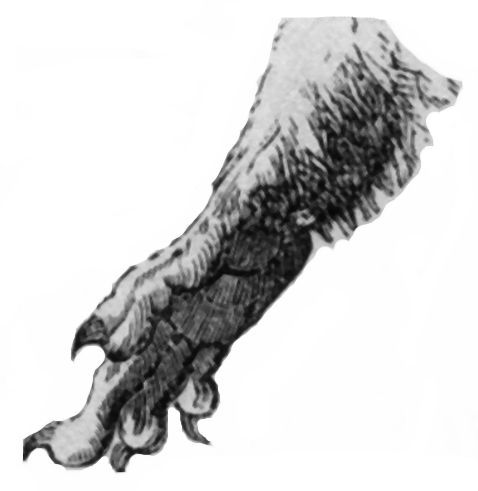
Fig. 12.
With the exception of some slight analogy in their teeth, naturalists have no grounds for placing the squirrel (fig. 12), the jerboa (fig. 13), and the marmot (fig. 14), in the same class. Destined to live in forests, to leap from bough to bough at a great height, the squirrel exhibits a paw admirably adapted for such a state of existence.
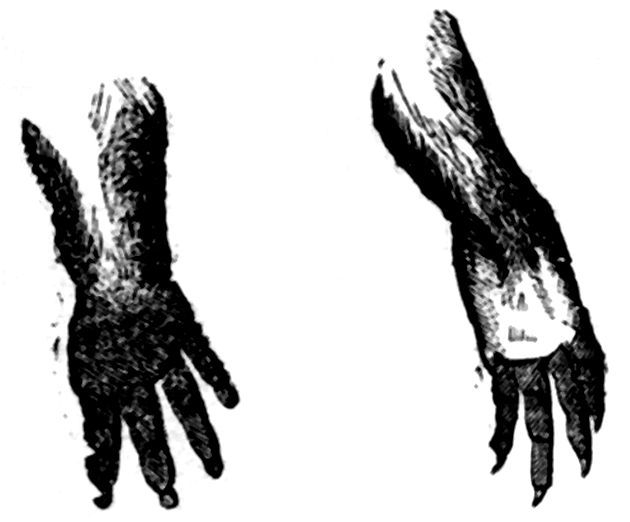
Fig. 13. Fig 14.
Its crooked claws can be easily inserted into the bark of the hardest tree; and the length of the hinder part of the paw permits the animal to suspend itself from the thickest branch. Moreover, as if nature wished to show that it was the most intelligent animal of its class, it is furnished with the rudiments of thumbs. No appearance of such organs can be detected on the paws of the jerboa or marmot, and their toes being united by a ligament, as far as the first joint, clearly indicates that their intelligence is likewise contracted.”
“Excuse me for a moment,” I said, interrupting him. “If the junction of the toes indicates a want of intelligence, pray, then, explain how the amphibious mammalia, with toes deeply impacted in a fleshy web, are so much superior to the rodents in intelligence?”
“Undoubtedly they are,” my friend triumphantly exclaimed; “but you must not overlook one essential circumstance in the study of the relations of the paw with the intelligence, and that is the number of the fingers. The seal, the walrus, and other amphibious mammalia, are certainly more intelligent than the rodents; and this superiority is plainly indicated by the number of their fingers, which is five.”
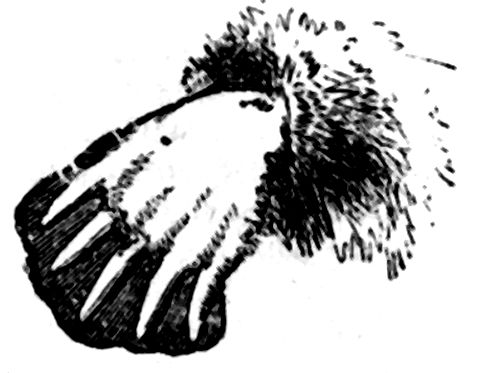
Fig. 15.
Here, with an air of triumphant pleasure, he counted the five toes, or fingers, as he termed them, of a preserved paddle of a seal (fig. 15) that lay upon the table.
“According to your doctrine, then,” I rejoined, pointing to some hoofs, “the elephant must be less intelligent than the seal, and the horse inferior to the cow and other ruminating animals, which is contrary to well-known facts.”
“I understand your objection,” he replied, with a smile; “and it is utterly worthless. Among all living beings, the organs are valued according to the functions they are called upon to fulfil. In the animals I brought under your notice, the functions of touch and prehension are executed by the extremities of the two fore limbs, and I attempted to demonstrate that the more or less imperfect state of those organs is in strict accordance with the more or less imperfect development of intelligence,—in other terms, that the functions of touch and prehension always correspond with the intellectual faculties. You object to my argument by referring me to the feet of hoofed animals. Remember, they are never termed paws, and, in this instance, the vulgar tongue is strictly in accordance with science; for the extremities of the anterior limbs of hoofed animals are not organs of touch and prehension,—they are merely organs of locomotion. As such, I have nothing to do with them, and seek elsewhere for the organs I require. In the elephant I find them in the trunk: in the horse, and the ruminating animals, I find them in the upper lip. Here, however, there is still the same general law. The elephant, whose sagacity is so remarkable, has, in its proboscis, an admirably-constructed instrument for its relations with the exterior world, to examine and take hold of any object it may desire. The horse, in its upper lip, has a less perfect organ, and consequently, its intelligence is inferior to that of the elephant. If we descend the scale of the hoofed animals, each step will more and more confirm the great truth that the sense of touch is intimately connected with the faculty of intelligence.”
“Yes,” he continued, after a moment’s pause, “the intelligence, habits, instincts, of all living creatures, are not the only things portrayed in the organs of touch and prehension; the temperament and diseases can also be read in them. You smile at my assertion; but if you were a medical man you would not do so. You would know that some physicians, from the form of the hand alone, can foretell consumption twenty years before the insidious disease appears in the lungs. Consumption is not the only disease that can be thus anticipated and guarded against. The lower animals have also the same privilege of indicating their diseases. Ah!” he abstractedly continued, “it is a new science, and has yet to be created; but its boundless horizons are worthy to tempt the ambition of the most venturous explorers of the most elevated minds.”
“And, pray, what do you term this new science?”
“It is Comparative Chiromancy.”
My friend then fell into a deep reverie, under cover of which I ventured to take my leave.
BUTTERCUPS AND DAISIES. Let us consider these two familiar friends attentively. In the buttercup the natural leaves consist of many divisions, while in the daisy the leaf is in one piece;
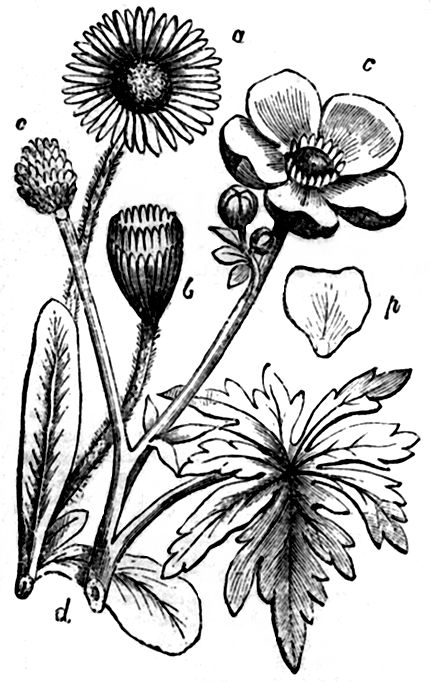
Fig. 1.
in both leaves, however, we find the veins, or fibres, of the leaf distributed upon a somewhat similar plan, viz., a central, or principal fibre, from which smaller fibres arise, and form a network of veins on either side. On cutting the stalks, moreover, and examining them with a magnifying glass, we discover a further similarity of structure; for we see that there are bundles of woody tissues symmetrically arranged around a central pith (d). Above the bracteas we find the blossom, which consists of the following parts:—1. Calyx; 2. Corolla; 3. Stamens; 4. Pistil. If we look at the base or back of the buttercup, we shall observe five small green leaves, as it were, supporting the yellow leaves of the blossom, (fig. 2, b).
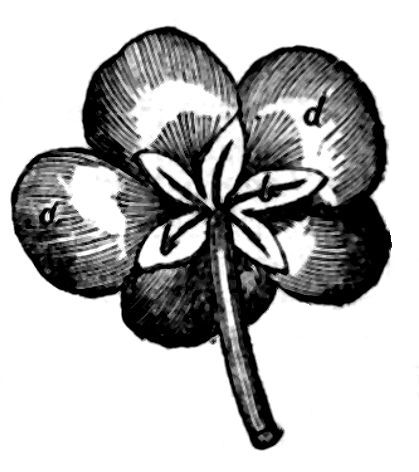
Fig. 2.
Each of these green leaves is called a sepal, and the five sepals together form what is called the calyx, because they are frequently united at their edges, and thus constitute a cup (calyx) for the flower. Within or above the calyx we have five yellow petals which together form the corolla, a word that signifies in Latin a little crown or garland, and has been applied to this part because the petals (the parts of the corolla) are usually of a brilliant colour, and give beauty to the flower. If we remove these yellow petals, we shall find at the base of each (fig. 1, p) a small scale, or gland, which was at one time called the nectary, from the idea that it was the organ which secreted honey. It may here be appropriately pointed out, that in nearly all plants with branched stems and reticulated (net-veined) leaves, there is a curious relation in the number of their parts. In the buttercup before us, we found a calyx consisting of five sepals, then a corolla of five petals; and in the section of the stem we count five bundles of woody tissue; in the other parts of the flower we shall find also the number five, or a multiple of it. In all such growths the numbers four and five, or their multiples, predominate. Within the corolla are smaller organs, which, though more difficult to distinguish, are more important agents in the production of fruit or seed. These will require the use of a lens to be minutely examined, but can be distinguished in their general outlines by the naked eye. Indeed, at first sight, the distinction between the stamens, which are outermost, and of a deeper yellow—and the pistils, which are the innermost, and have a greenish appearance—will be obvious. In the common wallflower, the cherry-blossom, and poppy, the difference between the stamens and the pistils is very remarkable. Let the stamens be removed, and the mode of their attachment to the stem noted; the pistils, with the ovaries, or unripe fruit, will then be seen. In the natural process of growth the petals and stamens fall from the flower, and the unripe fruit goes on increasing without them (fig. 1, o). In the daisy the parts of the flower are not so distinct as in the buttercup; but the blossom is a type of a large number of plants, amongst which are the dandelion, sunflower, china-aster, and other flowers having a central disc with white or coloured rays around. These are called composite flowers, because, in fact, a great many flowers compose each blossom. It was explained that the green leaflets at the back of the flower in the daisy were not sepals, but bracteas; and the pupil is therefore prepared to find calyx, corolla, stamens, and pistils, within and above them. Gently pull away one of the white leaves of the flower, in such a manner as to bring away with it all the parts attached to its base. Upon careful examination it will be found that a complete floret is thus removed; and by continuing the operation, it will be manifest that the whole of the head of the blossom consists of a series of flowers crowded together upon the expanded top of the flower-stalk, which is named the receptacle.
VIRGINIAN TOBACCO. A plant, the leaves of which, when dried and cut, or ground to powder, constitute superior tobacco and snuff.
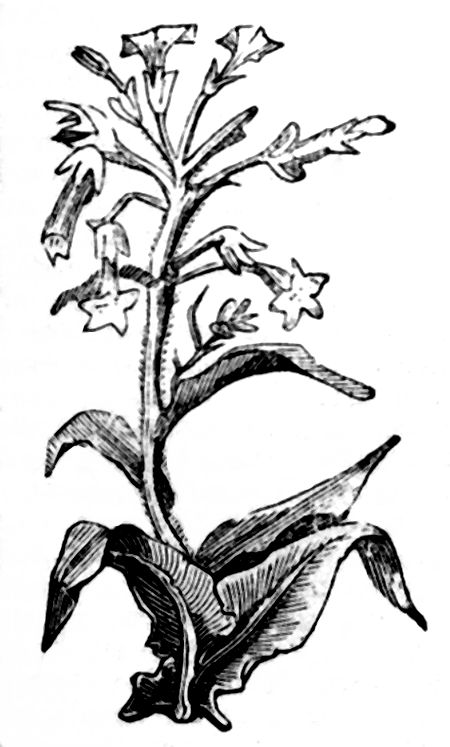
DRESDEN CHINA. The fine porcelain ware known as Dresden china was discovered by M. Boeticher, who was at the time only an apothecary’s boy—1700. Services of this ware have cost many thousands of pounds each. A costly service, each piece exquisitely painted, and the battles represented and subjects all different, was presented to the Duke of Wellington by the King of Prussia in 1816, and is the finest in England.
COMPOSITE ORDER. A rich combination of the other four orders of architecture, represented.
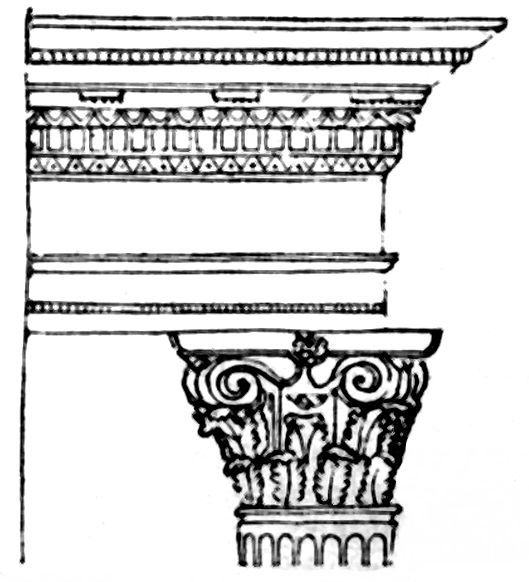
EAR RINGS. Among the Athenians the perforation of the ears was a mark of nobility; among the Hebrews and Romans it indicated servitude. Pendants from the ears are at this day sometimes used by the men in France, Italy, and other countries, even the most civilized in Europe.
VOICE LOZENGE. A little common sugar-candy dissolved in water is economical, and has proved efficacious in clearing the voice when singing. To strengthen the solution, a very small portion of gum arabic may be added. The white, or clarified sugar-candy, is not so efficacious.
MISTS. There is a certain quantity of water existing in a purely gaseous and invisible form in all states of the atmosphere. The higher the temperature of the air the more water in this form it is capable of holding in solution. If the air is fully saturated with moisture (which it always is over the course of a river), and the temperature be reduced, the water in it is condensed in the form of mist, which has been aptly, though quaintly, called “water-dust.” The radiation of heat from off the surface of water is almost always greater than off the surface of land. Thus, after sun-set, the water rapidly cooling, cools the air immediately in contact with it, in which the water hitherto gaseous becomes condensed, and visible as mist. This, in turn, cools the air above it.
COSMETICS. This term is usually applied to any article used in beautifying the complexion, hair, or teeth; or that in any way contributes to enhance personal appearance.
Milk of Roses, to Cool the Skin of the Face. Take sweet almonds, five ounces; bitter almonds, one ounce; rose-water, two pints and a half; white curd soap, half an ounce; oil of almonds, half an ounce; spermaceti, two ounces; white wax, half an ounce; English oil of lavender, twenty drops; otto of roses twenty drops; rectified spirit, a pint. Blanch the almonds, and beat them with the soap and a little of the rose-water. Melt together the oil of almonds, spermaceti, and white wax, and mix with the former into a cream, and strain it through fine muslin. Then add gradually the remaining rose-water, and, lastly, the spirit, with the essential oils dissolved therein.
Pomatum for the Hair. Soak half a pound of clear beef-marrow, and a pound of unsalted fresh lard, in water two or three days, changing and beating it every day. Put it into a sieve; and when dry, into a jar, and the jar into a saucepan of water. When melted, pour it into a basin, and beat it with two spoonfuls of brandy; drain off the brandy; and then add essence of lemon, bergamot, or any other scent that is liked.
White Pomatum. Take an ounce of Florentine orris-root, half an ounce of calamus aromaticus and as much gum benjamin, a quarter of an ounce of rosewood, and a quarter of an ounce of cloves. Bruise the whole into a gross powder, tie it up into a piece of linen, and simmer it in a jar placed in a saucepan with two pounds and a half of hog’s lard well washed. Add a couple of pippins, pared and cut into small bits; four ounces of rose-water; and two ounces of orange-flower water. After the ingredients have simmered together a little while, strain off the liquor gently, and let the pomatum stand till cold; then put it away for use in the same way as other pomatums.
Hair Oil. Melt together over the fire a pint of oil of sweet almonds, and an ounce of spermaceti. When cold, stir in a tablespoonful of oil of bergamot, and two grains of civet.
Cold Cream. Lard, six ounces; spermaceti, one ounce and a drachm and a half; white wax, three drachms; rose-water, three ounces; carbonate of potass, fifteen grains; spirits of wine, three-quarters of an ounce; essential oil of bergamot, three drachms. Melt the three first, then add the rose-water, carbonate of potass, and spirits of wine, stirring well, and when nearly cold add the perfume.
Or,—Take half an ounce of white wax, half an ounce of spermaceti, and three ounces of almond oil; put these into a basin, which place into hot water until melted; then gradually add three ounces of either rose-water, elder-water, or orange-flower water, stirring all the while with a fork or small whisk. Any perfume may be put in; but, medicinally, it is better without. When cold it is fit for use.
Elder-Flower Water is commonly prepared by distillation, using about one pound of flowers to every gallon of water required. As, however, this plan cannot be put into operation by the majority of our readers, we suggest the following more simple method. Take of elder-flower oil three ounces: rectified spirit, three ounces; place them together in a bottle, and shake well, twice a-day for a week. After standing, the spirit will rise and float on the oil, from which it may be poured off quite clear. One ounce of this spirit of elder-flowers, added to one quart of soft water (rain or distilled water is the best), will make very excellent elder-flower water.
Pomade, to prevent baldness, is made thus:—Beef suet, one ounce; tincture of cantharides, one teaspoonful; oil of origanum and bergamot, of each ten drops. Melt the suet, and, when nearly cold, stir in the rest of the ingredients until set.
To Dye the Skin Olive. Use walnut-juice mixed with a small quantity of Spanish anonatto. The tint required may be ascertained by dipping the finger into it.
To Clear a Tanned Skin. Take some unripe grapes and soak them in water, sprinkle them with alum and salt, then wrap them up in paper and roast them in hot ashes; squeeze out the juice, and wash the face with it every morning: it will soon remove the tan.
For Removing the Scurf-skin on Face and Hands. This appearance is often produced on delicate skins, by sudden changes of temperature. A good preventive is clarified honey rubbed well into the part affected after washing, and allowed to remain.
Dyeing the Hair. Dyeing the hair is pernicious, whatever the medium may be that is employed. In cases where cosmetics become necessary, from fashion or defect in the hair, the simplest and most harmless are always the best. The hygienic treatment of the hair consists in its cleanliness and that of the scalp, and especially, as Dr. Burgess says, in the strict observance of a precept, which applies to everything connected with the management of the human frame. We, however, give a receipt or two.
To Dye Hair Black. Take two drachms of silver, half an ounce of steel-filings, and an ounce of nitric acid, and eight ounces of rain-water. Pour off the supernatant liquor, which constitutes the dye. Apply by brushing with a close brush. Although there is a great objection to nitrate of silver as a dye, from its liability to darken the skin, nevertheless it is very far preferable to caustic earths, from their almost certainty to act as depilatories. One said to be free from any injurious effect and now in general use, is composed of the following:—Powder well in a mortar some litharge or vitrified oxide of lead, with some lime; these mix in water, in the proportion of eighty-five parts by weight of the former to fifteen parts of the latter. The manner of using it is as follows:—Wash the hair with warm water and soap to free it from grease, then dry it well. The hair is then to be covered with this mixture of the consistence of cream, beginning at the roots. Four folds of soft brown paper are then to be placed over the whole, and secured by an oil-skin cap. The hair must remain in this condition from three to six or eight hours, according to the depth of shade required; and the cap may then be removed. Some of the dye will fall out, and the rest must be combed and brushed out when the hair is dry. Do not wash the hair with water for three or four days after, as it irritates the skin. As the hair grows, the parts next the roots will be undyed, and will require the whole to be re-dyed every three or four months.
POMATUMS (Colouring and Scenting). Pomatums are seldom coloured of any other tint than red or pink; this is given by alkanet root, which has the peculiar property of imparting its colour to oils and melted fats, but not to water. Half a drachm of it may be coarsely powdered, and steeped in oil or melted fat until the colour is extracted; this quantity will be sufficient to tint a pound of pomatum.
INK (MARKING). Lunar caustic, two drachms; gum-arabic, half a drachm; distilled water, two drachms. To be well mixed, and kept in a small stopper-bottle, and in a dark place, as the lunar caustic loses its virtue by being exposed to the light. The linen to be marked must be previously prepared with the following mixture: sub-carbonate of soda, half an ounce; gum-arabic, one scruple; dissolved in one ounce of rain-water. With this mixture wet as much of the linen as is to be written on. Let it become perfectly dry; then write upon it, and dry the writing in the sunshine as rapidly as possible.
INK (BLACK). Take eight ounces of Aleppo galls in coarse powder; four ounces of logwood in their chips; four ounces of sulphate of iron; three ounces of gum-arabic in powder; one ounce of sulphate of copper; and one ounce of sugar-candy. Boil the galls and logwood together in twelve pounds of water for one hour, or until half the liquid has evaporated. Strain the decoction through a hair-sieve or cloth; then add the other ingredients; stir the mixture until the whole is dissolved, more especially the gum; after which leave it to parboil for twenty-four hours; then decant the ink, and preserve it in bottles of glass or stone ware, well corked.
INK (BLUE). Two drachms oxalic acid, two ditto Prussian blue, to be mixed in half a pint of water, make as good a blue ink as we have seen, and is very simple.
INK (GREEN). Dissolve six drachms of the crystals of verdigris in a pint of distilled water, and add five drachms of gum-arabic and two drachms of white sugar. A fine green ink may be made with a strong decoction of elm bark, to which green vitriol is added when cold.
EGGS (TO PRESERVE). Prepare a box or cask of a sufficient size to contain the eggs to be preserved. Let it be quite dry; spread a layer of wood-ashes about two inches in depth over the bottom, and upon this place the eggs on their side, as many as the space will admit, but be careful that they do not touch one another. Then throw in more ashes and form another bed, and lay down the eggs as before. In this way the cask or box may be filled, and if set by in a dry cool place, the eggs will keep sweet all through the scarce season.
BOOKS (TO PRESERVE). A few drops of any perfumed oil will secure libraries from the consuming effects of mould and damp. Russian leather, which is perfumed with the tar of the birch tree, never moulders; and merchants suffer large bales of this leather to remain in the London docks, knowing that it cannot sustain any injury from damp. This manner of preserving books with perfumed oil was known to the ancients. The Romans used oil of cedar to preserve valuable manuscripts. Hence the expression used by Horace, “digna cedro,” meaning any work worthy of being anointed with cedar-oil, or, in other words, of being preserved and remembered.
AIR (ELASTICITY OF). Suppose the two tight-bottomed hollow cylinders a and b, in the annexed figure, to be filled with air: if we fit a plug so tightly to the sides of both, that no air can pass between it and the sides of the cylinder, and then try to force down this plug by pressure on the stem, we shall find a resistance to its downward motion. The plug, or piston, as it is called, descends indeed, but with increasing resistance as it goes down; and if the pressure be removed, it returns to its former position, suddenly and with force. We have thus demonstrated not only that the air is a material substance, offering resistance; but also, that it is an elastic substance, capable of compression to an indefinite extent, and of restoration to its former condition on the withdrawal of the pressure.
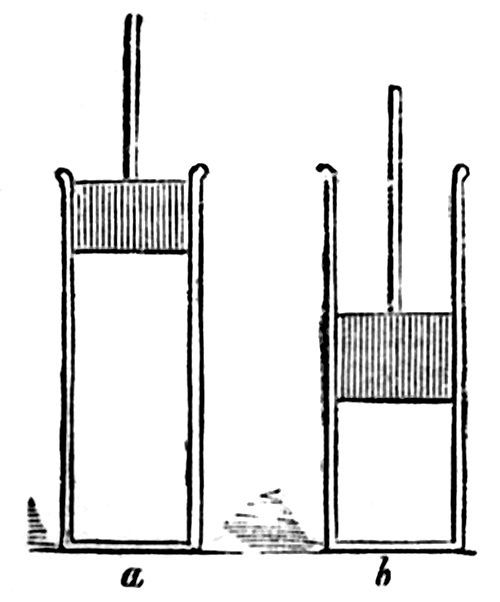
GUILLOTINE (THE). This instrument derives its name from a Dr. Guillotin, a distinguished physician in Paris, and a person who embraced with ardour the cause of the revolution, and was elected one of the deputies to the National Assembly. After it had been decided that crimes were personal, Guillotin proposed to substitute decapitation for other punishments, on the ground that, in the opinion of Frenchmen, that species of death did not attach infamy to the family of the criminal. The proposition was adopted: its author then pointed out a machine, which had been long known, as proper for the infliction of death without giving any pain to the sufferer. Unfortunately for Guillotin, some wags gave his name to the machine, of which he was not the inventor, and which he had only brought into notice. Still more unfortunately, this machine became, in the hands of the ruffians who were masters of France during two years—the duration of which was equivalent to more than two centuries—the instrument of the most horrible vengeance, of the most odious crimes: and Guillotin had a thousand times to grieve at seeing his name attached to the devastating axe with which the monsters had armed their executioners. After the termination of his political career, Guillotin resumed the functions of a physician, which it would have been better for his own repose if he had never quitted. He enjoyed, up to the last moments of his life, the esteem of all who knew him. Dr. Guillotin died on the 26th of May, 1814, aged seventy-six.
PEPPER. We have three kinds of pepper—the white, the black, and the long. Black pepper (piper nigrum) is the fruit of a shrub of the creeping kind, growing in Sumatra, Java, Ceylon, and other Asiatic countries. The berries are produced in clusters, and change as they ripen from green to red, and afterwards to black. White pepper differs from the black only in being stripped of its corticle, or covering. To strip them, the black berries are steeped in salt water, and after they have been exposed to the sun for several days, the chaff is rubbed off with the hands. In this operation the pepper loses much of its original warmth. The long pepper is a fruit of a different species, also from the East Indies, and consists of numerous grains attached to a common foot-stalk. Cayenne pepper is derived from an entirely different class of plants, called Capsicum.
BALM OF GILEAD. The Balm of Gilead, or Balsam of Mecca, is the dried juice of a small tree or shrub growing in Syria. It has a warm aromatic taste, and exquisitely aromatic smell. It is very scarce, and is seldom brought to this country except as a curiosity.
ACIDULATED DROPS. There are two methods of preparation. The first is the plan recommended in the Edinburgh Pharmacopœia; the second that adopted by confectioners.—1. Take of tartaric acid a quarter of an ounce, white sugar eight ounces, and beating them to a fine powder in a mortar, add oil of lemon ten drops, mix thoroughly, beating into a mass with strong gum water; then form into lozenges, which must be put aside to dry.—2. Pound and sift eight ounces of double refined sugar, and put it into a clean pan, and add gradually as much water as will render the sugar sufficiently moist not to stick to the stirring-spoon. The pan, which should not be more than three parts filled with the sugar-paste thus made, should be placed on a small stove or slow fire, and the contents carefully stirred with a bone spatula, or paper-knife, and watched till it nearly boils. The pan then being removed from the fire, a quarter of an ounce of tartaric acid may be stirred in, till a complete mixture is effected. Place it upon the fire again for half a minute, and then, with a spoon or wire dipping out small quantities from the pan, let them fall as drops upon a clean tin plate; in two hours the drops should be loosened with the blade of a knife, and will be ready for use in twenty-four hours.
OPTICAL EFFECTS. The following diagram will perhaps explain why the inside part of a spoon represents an inverted image, and the back being the reverse. G H is an object placed at some distance from a concave mirror A B, whose centre is C, and whose principal focus is E.
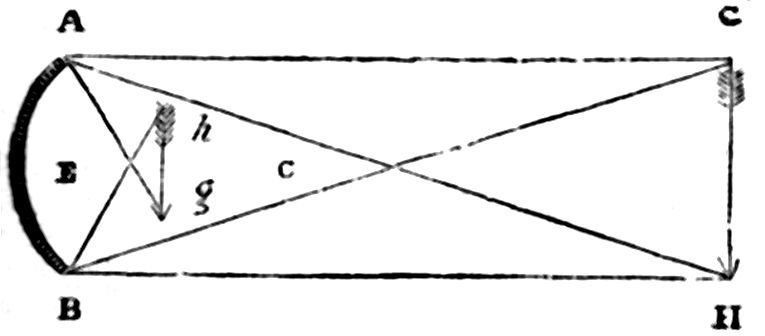
The rays from G fall diverging upon the mirror, and are reflected to a focus at g, where they form an image of the extremity at G; in the same way, a representation of the extremity H will be formed at h, so that a complete but inverted image of C H will be thus formed. The above will explain the inverted image formed in the hollow part of the spoon.
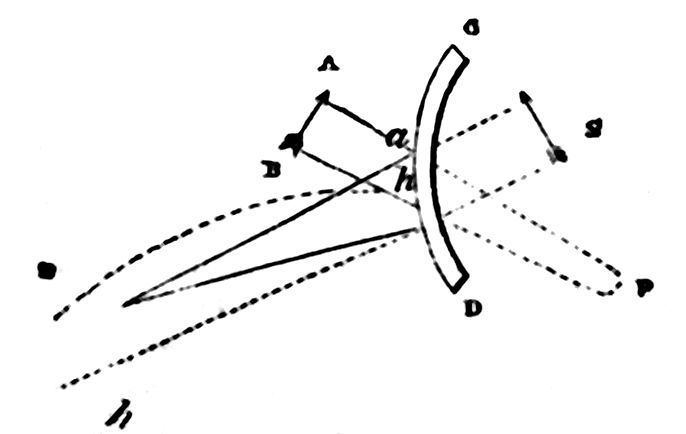
The rays from the external parts of the arrow A B flow convergingly along A a B h upon the mirror, and are reflected along a E and the ray B b along b E, and as the image of the object is always seen in the direction in which the rays approach the eye, the reflected image of A B is seen along the lines E A and E A behind the glass. E is supposed to be the eye of a spectator, and P is the point where the rays from A B would meet if the glass had not reflected them, or, properly, had not been there. Convex mirrors always form mirrors of diminished size, the rays from them coming convergent to the eye of the spectator; or, in other words, the rays from the object proceed to a virtual or imaginary focus behind the mirror; thence the image seems to be reflected to the eye; this will explain the reflection on the convex part of the spoon. Two images are seen upon the candlestick in consequence of the concavities and convexities of its surface, each part acting as a concave or convex mirror. Rays passing through a convex surface, diverge, or spread them, and a concave one converges them, or brings them to a point. When a ray of light falls upon any body, it is reflected so that the angle of incidence is equal to the angle of reflection; and this is a fundamental fact, upon which all the properties of mirrors depend. Let a ray of light, passing through a small hole in a dark room, be reflected upon a plain mirror at equal distances from the point of reflection, and the incident and reflected rays will be at the same height from the surface; the same will happen when the rays are reflected from a convex or concave surface. (See Optical Illusion, p. 134).
BATHS are arranged thus:—The very cold bath, when the temperature of the water is below 50 deg.; the cold bath, above 50 deg.; the cool bath, from 60 to 75 deg.; the temperate bath, from 75 to 85 deg.; the tepid bath, from 85 to 92 deg.; the warm bath, from 92 to 98 deg.; the hot bath, from 98 to 112 deg. The most useful bath is “the warm bath,” but the temperature must be varied in accordance with the different constitution of each patient.
GENDARMERIE. Gendarmerie (from Gens d’Armes, men-at-arms) was a chosen corps of cavalry under the old monarchy of France. The gendarmerie were afterwards formed into a body of soldiers entrusted with the police all over France; it furnishes patrols, arrests criminals, examines the passports of travellers, and contributes to the maintenance of good order. They are divided into foot and horse. They form a distinct corps in the army, under their own superior officers, who are under the orders of the ministers of the interior and of police; but, in case of war, they may be called into active service like the other corps of the army. The gendarmerie is mostly recruited from old and deserving soldiers of other regiments, who consider it as a promotion, as they have better pay and enjoy greater liberty. This explains why the gendarmes, generally speaking, are remarkably well-behaved and trusty men. The same description of troops exists in the Italian states, where they are called Carabineers.
NILE (SOURCE OF THE). This great river rises in the Mountains of the moon, in about ten degrees of N. lat., and in a known course of 1,250 miles receives no tributary streams. The travels of Bruce were undertaken to discover the source of the Nile; he set out from England in June, 1768; on the 14th November, 1770, he obtained the great object of his wishes, and returned home in 1773. The Nile overflows regularly every year, from the 15th of June to the 17th of September, when it begins to decrease, having given fertility to the land; and it must rise 16 cubits to ensure that fertility. In 1829 the inundation of the Nile rose to 26 instead of 22 cubits, by which 30,000 people were drowned, and immense property lost.
ENIGMA. Not necessarily given in the form of a query, though it may be so, and is written either in verse or prose. It is more complicated than a riddle, involving greater contrasts and more propositions, and is solved by one letter or word: not a sentence. For example:—
’Twas born in affliction, ’twas cradled with care,
And has lived ever since in the midst of despair.
It dwells in the valley, it glides on the wave,
And is highly respected by those who are brave.
It darkens, not brightens,—in sunshine it dies,
And far from the smile of enjoyment it flies.
In the rainbow it sits, in the stars it has birth,
And with angels descending it visits the earth.
With Adam it dwelt, and to Paradise came,
But Eve knew it not, tho’ it shared in her shame.
From the dream of our childhood it ne’er can depart,
Having fixed its abode in the core of our heart.
By the wandering peasant ’tis carried along,
And the nightingale loves it, though strange to her song.
From the joy of our mortal existence ’tis driven,
To find an enchanting asylum in heaven.
It mingles in war—as if bound by a spell,
And it comes to my lips as I utter—farewell!
[Ans.—The letter A.
CHARADE. This is quite distinct from a riddle or an enigma; and is made, or acted, as the case may be, by taking the several syllables of a given word, each having a different meaning, and describing them separately, and afterwards the whole word. As, per example:—
If you have watched the rolling seas, or gazed upon the sky,
My first cannot have failed to meet your ever-searching eye.
Beneath the brow—the noble brow—of yon stupendous tower,
My second’s seen—a warning true of night’s approaching hour.
My whole is found in wood and dale—a pretty littlegem,
That is, in my opinion, fit to grace a diadem.
[Ans.—Blue-bell.
RIDDLE. A complicated question, involving one or more ideas, which can, however, be solved by one reply. The oldest on record is in the book of Judges, chap. xiv. verse 18. We are told by Plutarch that the girls of his time worked at netting and sewing, while the most ingenious “made riddles.” The following is an example:—
Formed half beneath and half above the earth,
We sisters owe to art a second birth:
The smith’s and carpenter’s adopted daughters,
Made on the earth to travel o’er the waters.
Swifter we move as tighter we are bound,
Yet neither touch the water, air, nor ground.
We serve the poor for use, the rich for whim:
Sink when it rains, and when it freezes swim.
[Ans.—Pair of Skates.
REBUS. Not intended to be guessed or revealed in the same manner as the above; but is, on the contrary, as its name implies, a saying with its rejoinder; as the following example will bear out:—
One hundred and fifty, if rightly applied
To a place where the living did once all reside;
Or a consonant joined to a sweet singing bird,
Will give you a name that you’ve oftentimes heard.
And one which, I’ve no doubt, some friend of yours owns,—
’Tis the rival of Smith, and as common as Jones.
[Ans.—(Cl-ark, C-lark,) Clark.
ANAGRAM. The transposition of the letters of any particular word or name in such a manner as to form a striking contrast, or an apt commentary on the original word. For example:—
An article famous for lightness transpose,
And a substance of infinite weight ’twill disclose.
[Ans.—Cork, Rock.
PUZZLE. Anything intricate, embarrassing, or difficult to put right. The undermentioned will serve us an example:—
One-third of twelve if you divide
By just one-fifth of seven,
The true result—which has been tried—
Is sure to be eleven.
[Ans.—One-third of twelve is lv.
or 55; one-fifth of seven is
v, or 5; and 55 divided by 5,
gives 11.
CONSANGUINITY. Consanguinity is a term which implies the relation which subsists between persons who are sprung from the same stock or common ancestor, in distinction from affinity or relation by marriage. It terminates in the sixth or seventh degree, except in the succession to the crown, in which case it is continued to infinity. Marriage is prohibited by the ecclesiastical law to the fourth degree of consanguinity inclusive.
ROYAL MOTTOS. Dieu et mon Droit was first used by Richard I. a.d. 1193. The Bohemian crest, viz. three ostrich feathers, and the motto Ich Dien, “I serve,” was adopted by Edward the Black Prince at the battle of Cressy, the king of Bohemia being slain in the battle, 1346. Honi soit qui mal y pense, was made the motto of the Garter, 1349-50. Je maintiendrai, “I will maintain,” was adopted by William III., 1688. And Semper eadem was ordered by Queen Anne to be used as her motto.
CHICORY. Chicory is usually obtained from the roots of the wild endive (chicorium Intybus, Linn.) It is not the same plant as the common dandelion (taraxacum dens leonis), but belongs to the same family. The dandelion possesses similar properties, but its roots are not so large, and, consequently, not so well adapted for the uses to which chicory is applied. The wild endive may be found growing by the roadside, upon dry stony places. Its roots may be laid up in winter in a warm cellar, and if preserved from the frost, will soon send out a crop of blanched leaves, from which a salad for the table may be obtained. For this purpose it is often taken on ship-board; the roots are put into a cask, with sand, the sides of the cask being pierced with numerous holes, the leaves make their way through. A common, loosely-made hamper will do as well as a cask. This method of forcing is extensively carried on in France, where the salad is much esteemed.
SILKWORMS’ EGGS. Place the eggs in drawers made of wood, or strong paper; and when the leaves of the mulberry are full-grown, hatch them, either by the heat of the sun, or in a small room where there is a fire. In about six or seven days the silkworm will issue from the eggs, in the shape of a small black hairy caterpillar. In feeding them, take great care that the mulberry leaves are dry; for this purpose gather a quantity required for two or three days, if the weather looks showery, and lay them in an earthen vessel in a cool airy place, but not exposed to draught. Keep everything about silkworms as clean as possible, and remove all extraneous substances. When the silkworm refuses its food, and makes silky traces on the leaves, pin together papers in the shape of inverted cones, open at the top, and fix them against the wall. Place a worm in each, and leave them to spin.
GLUE THAT WILL RESIST MOISTURE. Dissolve gum sandarac and mastic, of each two ounces, in a pint of spirit of wine, adding about an ounce of clear turpentine. Then take equal parts of isinglass and parchment glue, and having beaten the isinglass into small bits, and reduced the glue to the same state, pour the solution of the gums upon them, and melt the whole in a vessel well covered, avoiding so great a heat as that of boiling water. When melted, strain the glue through a coarse linen cloth, and then put it again over the fire, adding about an ounce of powdered glass. This preparation may be best managed by hanging the vessel in boiling water, which will prevent the matter burning to the vessel, or the spirit of wine taking fire; and, indeed, it is better to use the same method for all the evaporations of nicer glues and sizes; but, in that case, less water than the proportion directed should be added to the materials.
GOBELIN TAPESTRY. Gobelin Tapestry is so called from a noted house in Paris, in the suburb of St. Marcel, formerly possessed by famous wool-dyers, whereof the chief, called Giles Gobelin, who lived in the reign of Francis I., is said to have found the secret of dyeing scarlet, which was from him called the scarlet of the Gobelins: the house and river that runs by it also took the same name. This house was purchased by Louis XIV. for a manufactory of all manner of curious works for adorning the royal palaces, under the direction of Mons. Colbert, especially tapestry, designs for which were drawn by the celebrated Le Brun, by appointment of the king, a.d. 1666.
AMETHYST. When this stone was first prized is not known; it was the ninth in place upon the breastplate of the Jewish high priests, and the name Issachar was engraved upon it. It is of a rich violet colour, and, according to Plutarch, takes its name from its colour, resembling wine mixed with water. One worth 200 rix-dollars having been rendered colourless, equalled a diamond in lustre, valued at 18,000 gold crowns.—De Boot Hist. Gemmarum. Amethysts were discovered at Kerry, in Ireland, in 1755.
KNIGHTHOOD. The institution of the “Order of the Bath” originated in the custom of the Franks, who, when they conferred knighthood, bathed before they performed the ceremony, and from this habit came the title of the “Knights of the Bath.” Henry IV. instituted a degree of knighthood of the Bath, and on his coronation, in the Tower, he conferred the order upon forty-six esquires, who had watched the night before, and had bathed.
HAIR-BRUSHES (TO WASH). Never use soap. Take a piece of soda, dissolve it in warm water, stand the brush in it, taking care that the water only covers the bristles: it will almost immediately become white and clean; stand it to dry in the open air with the bristles downwards, and it will be found to be as firm as a new brush.
BREAD-FRUIT TREE. A native of the South-Sea Islands. It grows to the thickness of a man and upwards of 40 feet high. The fruit is the size and shape of a child’s head, the surface reticulated, covered with a thin skin, with a core the size of a small knife-handle; the eatable part is between the skin and core, as white as snow, and of the consistence of new bread. When perfectly ripe, it is pulpy, sweetish, putrescent, and, by some, thought to be too laxative; but when green it is farinaceous, and esteemed very wholesome food, either baked under the coals, or roasted over them.
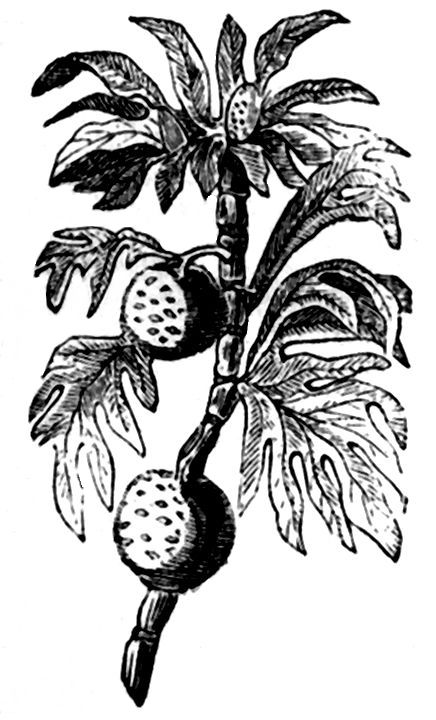
BANDANAS, OR BANDANNAS. This name, originally applied to a peculiar kind of silk handkerchief made by the Hindoos, is now given to silk and cotton handkerchiefs manufactured in this country decorated with patterns of similar character, though by a very different process. A bandana handkerchief has a dyed ground, usually of bright red or blue, ornamented with circular, lozenge-shaped, or other simple figures, either white, or, in some cases, of a yellow colour. These spots are said to be produced, in real Indian bandanas, by tying up the parts intended to be white or yellow with bits of thread before exposing the handkerchief to the action of the dye, and thus protecting them from it. In the process followed by British manufacturers, which was invented in 1810 by M. Köchlin, of Mulhausen, the whole surface of the handkerchief is dyed of one uniform colour; a number of pieces thus dyed are laid between two leaden plates, perforated with holes wherever white spots are intended to be, and while the several thicknesses of cloth are compressed in this manner by the power of an hydraulic press, a fluid capable of discharging the dye is caused to percolate through the holes in the leaden plates, removing, in its passage, the dye from such parts of the cloth as are exposed to its action. By varying the discharging fluid the spots may be made yellow instead of white; and arrangements are sometimes made for combining white and yellow spots in the same handkerchief.
BISSEXTILE, OR LEAP-YEAR. An intercalary day was thrown into every fourth year to adjust the calendar, and make it agree with the sun’s course. It originated with Julius Cæsar, who ordered a day to be counted before the 24th of February, which among the Romans was the sixth of the calends, and which was therefore reckoned twice, and called bissextile: this added day we name the 29th of February every fourth year, forty-five years b.c.
FARTHING. Farthings were one of the earliest of the English coins. Farthings in silver were coined by King John; the Irish farthing of his reign is of the date 1210, and is valuable and rare. Farthings were coined in England in silver by Henry VIII.; first coined in copper by Charles II. 1665; and again in 1672, when there was a large coinage of copper money. Half-farthings were first coined in the reign of Victoria, 1843.
CLOUDS. The varied forms of the clouds depend upon the modes of their formation—that is, whether they are condensed into visible forms in a quiet or a disturbed atmosphere. It is likely also that the electrical condition of the vapour itself may have an influence upon the shape it may assume. The cloud is a collection of vapours suspended in the atmosphere, and consists chiefly of water converted into the gaseous form by heat. The round massive cloud which looks like a distant mountain is called cumulus. The name is a Latin word, signifying a heap, and is the derivative of accumulation. The flat long cloud is called stratus, a layer (hence the word stratification, &c.) The feathery cloud, like a colt’s tail, is called cirrhus, a beard. When the stratus intersects the cumulus, the combined form is called nimbus (a shower), from it producing rain.
CLIMATE. Climate does not depend entirely upon latitude, though the poles are the coldest, the tropics the hottest, and the intermediate latitudes maybe said generally to be colder or hotter as they are near or distant from the ecliptic, or the equator. But the climate depends somewhat upon the difference of the internal heat of the earth; and England rejoices in a warmer climate than the sun-rays of its latitude could confer upon it. These differences of temperature have been mapped out, and are found to indicate curious but somewhat irregular lines of heat, named “thermal lines.” The moisture and state of cultivation of a country will, of course, affect the climate; while its geological peculiarities, and the irregularities of its surface, will give a character to it.
DISTILLED WATERS. These are made by introducing vegetables in a still with water, drawing off as much as is found to retain certain properties of the plants. These waters are often more efficacious, externally or internally applied, than the vegetables themselves, which might be unsuited for exhibition in their normal states.
CRESTS. Ancient warriors wore crests to terrify their enemies by an exhibition of some ferocious shapes emblematical of the foes they had conquered. Subsequently, the practice became modified, and crests were adopted as marks of family dignity and distinction.
CUCUMBERS. Cucumbers are certainly nutritious; but they are slightly so compared with other vegetables. They are difficult of digestion, especially when full-grown and seedy. They formerly grew in great abundance in Palestine and Egypt, where, it is said, they constituted a great part of the food of the poor and slaves. The plant was brought from the Netherlands about 1538.
SMOKING OF A LAMP (TO PREVENT). Soak the wick in strong vinegar, and dry well before you use it; it will then burn sweet and pleasant, and amply compensate for the trifling trouble of preparing it.
COMPOSITION FOR SHOP TICKETS. Gum-arabic powdered very fine, common writing ink, and a portion of Indian-ink, ground in water. The above preparation is often made and used. Isinglass dissolved in hot water, mixed with the ink, would give the glazed appearance as well as the gum; but the latter answers the purpose, and is cheaper.
CHERRIES.—Cherries were first planted in Britain one hundred years before Christ; and afterwards brought from Flanders, and planted in Kent with such success, that an orchard of thirty-two acres produced, in the year 1540, £1,000. Miller has enumerated a great variety; but since his time, their culture has much increased.
SPASMS. For these distressing and dangerous attacks, there is no better remedy than the following:—Take eight drops of laudanum, and eight drops of Hoffman’s æther; and in the morning one or two Seidlitz’s powders, or castor oil, or any other mild aperient. In the summer, saline draughts are best.
FOUNTAIN (HOW TO MAKE A CHEAP). The following is a plan adopted some time ago with perfect success:—First of all procure a good-sized water-butt, marked A, and place it behind a wall B, then carry a one-inch pipe C, underneath the ground (at a depth of two feet), to the fountain D. This costs £2 5s. The only trouble, if it be such, attending it, is the filling of the butt; although even this is easily done away with if you should chance to have a pump near at hand.
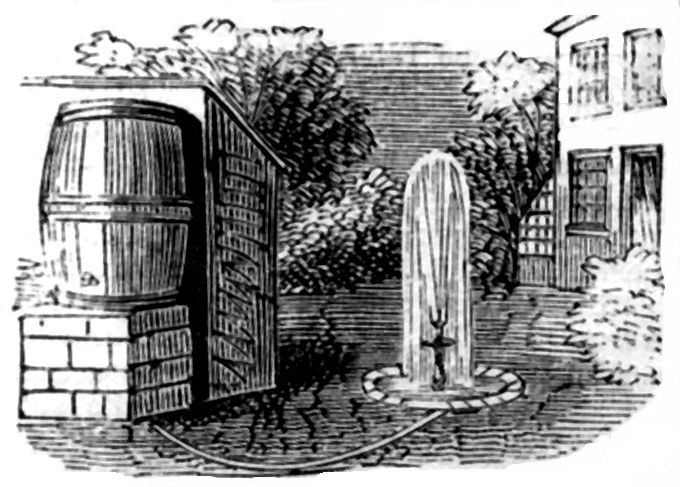
UNICORN. The unicorn is a fabulous beast. There is a fish with a horse-like head which is termed the sea-unicorn, having a horn in the middle of the forehead. The lion and the unicorn in the British arms are termed supporters. In this country none under the degree of Baronet are allowed the honour of supporters. King James introduced the royal unicorn as the supporter for Scotland, companion to the English lion.
CHURCHING. The usage of “Churching” originated in the Jewish rite of purification. Churching is the act of returning thanks in a place of worship for any great deliverance. It was a Jewish law that a woman should keep within her house forty days after confinement, if she had a son, and eighty if she had a daughter. At the expiration of that time, she was to go to the Temple and offer a lamb with a young pigeon or turtle, or, in case of poverty, two pigeons or two turtles.
CEMENTS (MANUFACTURE AND USE OF). The term cement includes all those substances employed for the purpose of causing the adhesion of two or more bodies, whether originally separate, or divided by an accidental fracture. As the substances that are required to be connected together are exceedingly various, and differ very much in their properties as to texture, &c. &c., and as the conditions under which they are placed, with regard to heat and moisture, are also exceedingly variable, a number of cements, possessed of very different properties, are required; for a cement that answers admirably under one set of circumstances may be perfectly useless in others. A vast number of cements are known and used in the various arts; but they may all be referred to a few classes, and our object in this paper will be to describe the manufacture and use of the best of each class, and also to state what are the general principles upon which the success or failure of cementing usually depends.—The different parts of a solid are held together by an attraction between their several particles, which is termed the attraction of cohesion, or cohesive attraction. The amount of this varies with the substances; thus, the cohesion of the particles of iron to one another is enormously great, whilst that between those of chalk is but small. This attraction acts only when the particles are in the closest possible contact; even air must not be between them. If, after breaking any substance, we could bring the particles into as close contact as before, and remove the air, they would reunite, and be as strongly connected as ever. But, in general, this is impossible; small particles of grit and dust get between them; the film of interposed air cannot be removed; and thus, however firmly we press the edges of a broken cup together, it remains cracked china still. Perfectly flat, clean surfaces, like those of freshly-ground plate-glass, may sometimes be made to cohere, so that the two pieces become one, and cannot be separated without breaking. The attraction of cohesion takes place between the parts of the same substance, and must not be confounded with that of adhesion, which is the attraction of different substances to one another; for example, the particles of a piece of wood are united by cohesive attraction, whilst the union of glue and wood to each other depends on adhesive attraction. And it is important that this distinction be borne in mind, for, in almost all cases, the cohesion between the particles of the cement is very much less than the adhesion of the cement to other bodies; and if torn apart, the connected joint gives way—not by the loosening of the adhesion—but by the layer of cement splitting down the centre. Hence the important rule, that, the less cement in a joint, the stronger it is. Domestic manipulators usually reverse this, by letting as much cement as possible remain in the joint, which is, therefore, necessarily a weak one. A thick, nearly solid cement, which cannot be pressed out of the joint, is always inferior to a thinner one, of which merely a connecting film remains between the united surfaces.
Mouth Glue affords a very convenient means of uniting papers, and other small light objects; it is made by dissolving, by the aid of heat, pure glue, as parchment glue, or gelatine, with about one-quarter or one-third of its weight of coarse brown sugar in as small a quantity of boiling water as possible; this, when perfectly liquid, should be cast into thin cakes on a flat surface very slightly oiled, and as it cools, cut up into pieces of a convenient size. When required for use one end may be moistened by the mouth, and is then ready to be rubbed on any substances it may be wished to join; a piece kept in the desk or work-box is exceedingly convenient.
Paste is usually made by rubbing up flour with cold water, and boiling; if a little alum is mixed before boiling it is much improved, being less clammy, working more freely in the brush and thinner; a less quantity is required, and it is therefore stronger. If required in large quantity, as for papering rooms, it may be made by mixing one quartern of flour, one quarter pound of alum, and a little warm water; when mixed, the requisite quantity of boiling water should be poured on whilst the mixture is being stirred. Paste is only adapted to cementing paper; when used it should be spread on one side of the paper, which should then be folded with the pasted side inwards, and allowed to remain a few minutes before being opened and used; this swells the paper, and permit its being more smoothly and securely attached. Kept for a few days, paste becomes mouldy, and after a short time putrid. This inconvenience may be obviated by using the
Permanent Paste, made by adding to each half-pint of flour paste, without alum, fifteen grains of corrosive sublimate, previously rubbed to powder in a mortar, the whole to be well mixed; this, if prevented from drying, by being kept in a covered pot, remains good any length of time, and is therefore convenient; but unfortunately it is extremely poisonous, though its excessively nauseous taste would prevent its being swallowed accidentally; it possesses the great advantage of not being liable to the attacks of insects.
Liquid Glue. Several preparations are much in vogue. The liquid glue of the shops, however, is a totally different preparation, being inodorous, and very much cheaper. It is made by dissolving shell-lac in water, by boiling it along with borax, which possesses the peculiar property of causing the solution of the resinous lac. This preparation is convenient for its cheapness and freedom from smell, but it gives way if exposed to long-continued damp, which that made with naphtha resists.
Common Glue should always be prepared in a glue-pot or double vessel to prevent its being burned, which injures it very materially; the objection to the use of this contrivance is, that it renders it impossible to heat the glue in the inner vessel to the boiling point; this inconvenience can be obviated by employing in the outer vessel some liquid, which boils at a higher temperature than pure water, such as saturated solution of salt, (made by adding one-third as much salt as water). This boils at 224° Fahr., 12° above the heat of boiling water, and enables the glue in the inner vessel to be heated to a much higher temperature than when pure water is employed. If a saturated solution of nitre is used, the temperature rises still higher.
Lime and Egg Cement is frequently made by moistening the edges to be united with white of egg, dusting on some lime from a piece of muslin, and bringing the edges into contact. A much better mode is to slake some freshly-burned lime with a small quantity of boiling water; this occasions it to fall into a very fine dry powder, if too much water has not been added. The white of egg used should be intimately and thoroughly mixed, by beating, with an equal bulk of water, and the slaked lime added to the mixture, so as to form a thin paste, which should be used speedily, as it soon sets. This is a valuable cement, possessed of great strength, and capable of withstanding boiling water. Cements made with lime and blood, scraped cheese, or curd, may be regarded as inferior varieties of it. Cracked vessels, of earthenware and glass may often be usefully, though not ornamentally repaired by white lead spread on strips of calico, and secured with bands of twine. But in point of strength, all ordinary cements yield the palm to
Jeffery’s Patented Marine Glue, a compound of Indian-rubber, shell-lac, and coal tar naphtha. Small quantities can be purchased at most of the tool warehouses, at cheaper rates than it can be made. When applied to china or glass, the substances should be cautiously made hot enough to melt the glue, which should be then rubbed on the edges so as to become fluid, and the parts brought into contact immediately. When well applied, the mended stem of a common tobacco-pipe will break at any other part in preference to the junction. The colour of the glue unfortunately prevents its being used.
Red Cement, which is employed by instrument makers for cementing glass to metals, and which is very cheap, and exceedingly useful for a variety of purposes, is made by melting five parts of black resin, one part of yellow wax, and then stirring in, gradually, one part of red ochre or Venetian red, in fine powder, and previously well dried. This cement requires to be melted before use, and it adheres better if the objects to which it is applied are warmed. A soft cement, of a somewhat similar character, may be found useful for covering the corks of preserved fruit, and other bottles, and it is made by melting yellow wax with an equal quantity of resin, or of common turpentine (not oil of turpentine, but the resin), using the latter for a very soft cement, and stirring in, as before, some dried Venetian red. Bearing in mind our introductory remarks, it will be seen that the uniting of broken substances with a thick cement is disadvantageous, the object being to bring the surfaces as closely together as possible. As an illustration of a right and a wrong way of mending, we will suppose a plaster of Paris figure broken; the wrong way to mend it is by a thick paste of plaster, which makes, not a joint, but a botch. The right way to mend it is by means of some well-made carpenter’s glue, which, being absorbed into the porous plaster, leaves merely a film covering the two surfaces, and, if well done, the figure is stronger there than elsewhere.
Mastic Cement is used for making a superior coating to inside walls, and which must not be confounded with the resin mastic. It is made by mixing twenty parts of well-washed and sifted sharp sand with two parts of litharge and one of freshly burned and slaked quicklime in fine dry powder. This is made into a putty, by mixing with linseed oil; it sets in a few hours, having the appearance of light stone; and we mention it, as it may be frequently employed with advantage in repairing broken stonework (as stairs) by filling up the missing parts.
OPTICAL ILLUSION. Ships floating in the air is an optical illusion, which may be thus explained:—On the 1st of August, 1798, Dr. Vince observed at Ramsgate a ship which appeared as in the subjoined illustration, the top-mast being the only part of it seen above the horizon. An inverted image of it was seen at B, immediately above the real ship at A, and an erect image at C, both of them being complete and well defined. The sea was distinctly seen between them, as at V W.
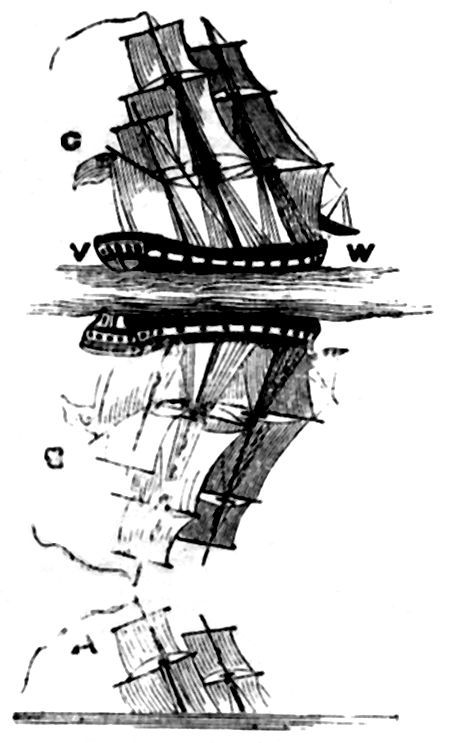
As the ship rose to the horizon, the image, C, gradually disappeared; and while this was going on, the image B descended, but the mainmast of B did not meet the mainmast of A. The two images, B C, were perfectly visible when the whole ship was actually below the horizon. These singular appearances, which have often given rise to superstitious legends, may be imitated artificially. Thus, if we take a long mass of hot iron, and, look along the upper surface of it at an object not too distant, we shall see not only the object itself, but also an inverted image of it below; the second image being caused by the refraction of the rays of light passing through the stratum of hot air, as is the case of the mirage. (See Optical Effects, p. 127).
GELATINE. This substance consists of that part of meat which, when extracted, forms a jelly when cold. It is found abundantly in the skins, flesh, and bones of all animals. Glue is a rough gelatine extracted from the skin, bones, and other parts of inferior animals—it is unsuited for food. The best gelatine for invalids is obtained from calves’ feet, &c. It is both nutritive and strengthening.
CORINTHIAN ORDER. The third of the five orders of architecture, the capital, as in the engraving, consisting of two rows of leaves, with stalks between, forming sixteen volutes, or ram’s horns.
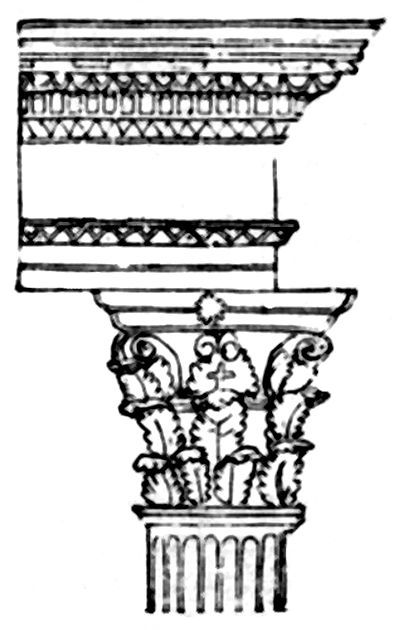
PARACHUTE (THE). A machine by which aëronauts may descend from a balloon to the ground in safety. It bears a general resemblance to an umbrella, and consists of a strong but light surface, a a, from which a car, b, is suspended. When it is detached from the balloon, it descends at first with an accelerated velocity; but this is soon checked by the resistance of the air, and the machine then falls at a rate nearly uniform, and very moderate. A very simple experiment will enable any person to illustrate the principle of the parachute. Take a piece of paper about three feet square, and attach a piece of thread to each corner of it; then fasten a proportionate weight to the lower part, and let it drop from a window, or even from your hand, held as high as you can. It will descend slowly to the ground.
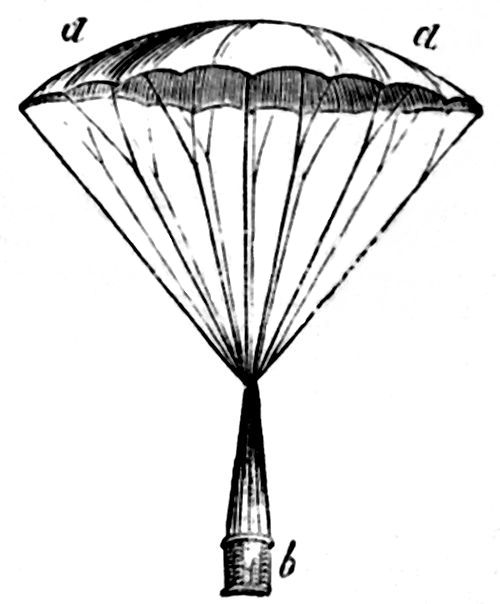
MARCH. This month was named by Romulus, in honour of his supposed father—Mars, the heathen God of War. Until January and February were added to the calendar, the Romans made it the first month of the year, and it was not even reckoned as the third month by the English until 1752.
“The Saxons,” says Verstegan, “called the month Rhede Rethe-Monath, to denote its general boisterousness of character, Rhede signifying, in their interpretation, rough or rugged. Many antiquaries contend that, the month having been dedicated to the idol Rheda before the conversion of the Saxons to Christianity, the etymology of it thus given is more correct. The name was afterwards changed to Lenet-Monat, or length month, because in this month the length of the day begins to exceed that of the night. It has been said that Lenet signifies spring, and that therefore it was called spring month. As our Saxon ancestors observed the custom of fasting after they embraced Christianity, and as the period of the observance of this custom usually fell in the Lenet-Monat, it was called the Lenet fast, and by corruption the word Lenet became converted into Lent.”
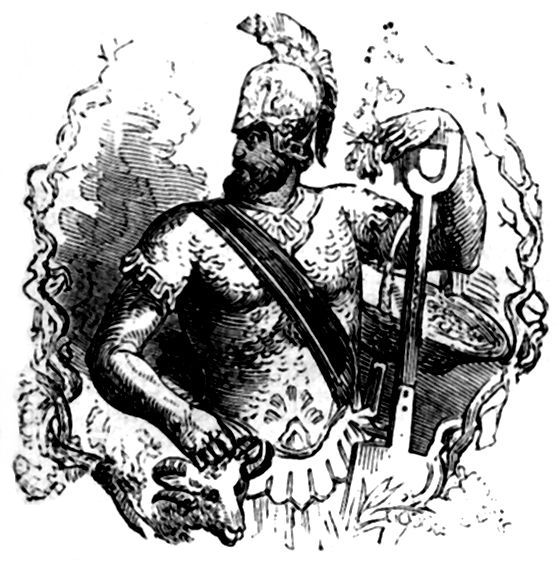
Symbol or Allegory of the Month.—A young man of a tawny colour and fierce aspect, with a helmet on his head, being intended for Mars, the God of War. In his right hand he holds a ram, typical of the sign of Aries, or the Ram, because the sun enters that constellation on the 20th of the month, when Spring commences. A basket of seeds hangs upon his left arm, the hand holding a bunch of almond blossoms, and resting upon a spade, allegorical of the preparation of the ground by the husbandman.
There are some proverbs relating to the month which are based upon its character. Thus it is sometimes said that “a bushel of March dust is worth a king’s ransom;” and “a dry March never begs its bread.” Both these proverbs signify that a dry March is favourable to the agriculturist and gardener; and this is borne out by another proverb, which says that “March grass never did good;” hence we infer that a wet March, which would be necessary for the grass to grow so early, is prejudicial to the farmer and florist.
Our Calendar contains many days of observance in March. The 1st is called St. David’s-day. St. David is the patron saint of Welsh men. He was Archbishop of Miney, and died in 544, his remains being placed in the church of St. Andrew, and afterwards removed to Glastonbury Abbey. The custom of Welshmen wearing leeks in their hats on St. David’s-day is said to owe its origin to their having gained a great victory over the Saxons, from whom they distinguished themselves by wearing leeks during the battle.
2nd. St. Chad was an English bishop, educated at the monastery of Lindisfarne, and was fifth bishop of the Mercians and third bishop of Lichfield, where he died in 673, being buried with great pomp in the cathedral, his shrine costing upwards of £2,000 for decorations.
7th. Perpetua was a Roman saint, martyred in 205, by order of the Emperor Serverus.
17th. St. Patrick’s-day.—St. Patrick is the tutelary saint of the Irish, who wear a bunch of trefoil, or shamrock, upon this day. Biographers do not agree with respect to the date and place of birth of Ireland’s saint. Usher and Tillemont stating that he was born in the year 372, while Moore, in his “History of Ireland,” states that he was born in the year 387. The same discrepancy occurs with regard to the date of his death, Usher fixing it on the 17th of March, 493; Tillemont, on the same day in 455, Nenius in 464, and Moore in 465. Most biographers maintain that St. Patrick was born in a village called Bonaven Taberniæ, supposed to be the town of Kilpatrick, at the mouth of the Clyde, between Dumbarton and Glasgow; but Mr. Moore states that the saint was born in the neighbourhood of Boulogne in the ancient Armoric Britain, and that the Irish monarch, Nial of the Nine Hostages, having ravaged some of the maritime districts of Gaul in the year 403, St. Patrick was taken prisoner and carried to Ireland, where he was sold to a person residing in Antrim, who employed him to tend sheep. Having continued in this place for six years, he made his escape in a vessel bound for Gaul, and afterwards entered a monastery at Tours. It is said that he constantly dreamed that he was invited to return to Ireland in the name of its people, and accordingly he set sail for that purpose, and landed at Dublin about the year 422. His adventures upon landing; his conversion of Dicho, a pagan chieftain; his performance of Divine service in a barn; his celebration of Easter, by lighting the Paschal fire on Easter-eve before the halls of Tara; his conversion of multitudes of King Logaire’s followers, and the destruction of the great Druidical god, are all points of interest in the life of this saint. St. Patrick erected several rude Christian churches, and occupied the see of Armagh, which was founded to organize his new system. The origin of the Irish wearing the shamrock on this day is said to be from St. Patrick having used some of this plant as an illustration of the Trinity, when he was endeavouring to convert the Irish, after his second landing, in 422.
21st. St. Benedict was born in Umbria, about 480, and sent to school at Rome. He founded the order of Monks of St. Benedict, and died 543, at the age of sixty-three, after having performed, according to the statements of his followers, a host of extraordinary wonders and cures.
25th. The Annunciation-day of the Virgin Mary, which is kept as a festival in the Church of England, in commemoration of the incarnation of our Saviour.
APOTHECARY (Greek apothekæ, a Shop, or Store-room). This term appears to come from the above root, although we now apply it chiefly to one who compounds or prescribes medicines, and not to the vendor or shopkeeper. The apothecary of our day is the regular “Family Doctor,” who, having obtained a licence to practice from a chartered incorporation, puts after his name the letters L.A.C., meaning Licentiate of the Apothecaries’ Company, of London, incorporated by James I., in 1606; the association was then united with the Grocers’ Company, but in 1617 it was formed into a separate company, with the exclusive right of dealing in and compounding drugs. At the close of the 17th century, the members of this association began to prescribe as well as dispense medicines; they soon after became the common medical attendants of the sick, and performed the functions both of the physicians and surgeons of our day. As their calling became gradually elevated into a profession, there arose a new class to supply their place, those called chemists and druggists, who now deal in drugs, and compound medicines, as the apothecaries used to do; of these we shall have to speak by and by. Several Acts of Parliament for restricting or extending the power of the Apothecaries’ Company have been passed at different times; the last was in 1815, and this, as every medical practitioner is to a certain extent an apothecary, gives the company a large amount of control over the profession throughout the kingdom. No person is legally qualified to practise unless he shall have served an apprenticeship with a licentiate of this company, passed before its board of examiners, and paid certain fees which they are empowered to demand for a licence. The French apothecaire, and the Latin apotheca, come very close to the Greek original in sound and signification: there is no Apothecaries’ Company across the channel, and the apothecary there is more of a medicine vendor and compounder than he is with us.
We may observe here that apothesia in Botany signifies a repository, and is applied to the cases in which the organs of reproduction of many of the algæ, or sea-weeds, are contained.
Apothecaries’ Weights and Measures, are those which are constantly used in the compounding and dispensing of medicines in this country. As a knowledge of them is essential to those who would attempt the domestic treatment of diseases, we give them in extenso.
Weights. One pound contains 12 ounces, or 5760 grains; one ounce 8 drachms, or 480 grains; one drachm 3 scruples, or 60 grains; one scruple 20 grains.
Measures. One gallon contains 8 pints, or 70,000 grains of water; one pint 20 ounces, or 8,750 grains; one ounce 8 drachms, or 437.5 grains; one drachm 60 minims, 54.7 grains.
Symbols and Characters. lb. represents a pound; ℥ an ounce; Ʒ a drachm; ℈ a scruple; gr. a grain; C. for congius, a gallon; O. for Octavius, a pint: the prefix fl before Ʒ or ℥, means a fluid drachm or ounce; ♏, a fluid minim; gtt. for gutte, a drop. The letters ss put after either of these characters signifies a half; thus, ℥ss is half an ounce. It should be borne in mind that minim and drop are not the same quantities, the former containing nearly half as much more as the latter, thus 10 minims of Tincture of Opium are equal to 15 drops; formerly it was customary to prescribe all medicines by drops as let fall from the mouth of a bottle; but the quantity in a certain number of these differed so considerably, according to the density of the fluid, or the vessel it was dropped from, that an alteration in the plan was found necessary, and that of admeasurement was adopted: we give here a cut of a minim measure, and also of one used for larger quantities.
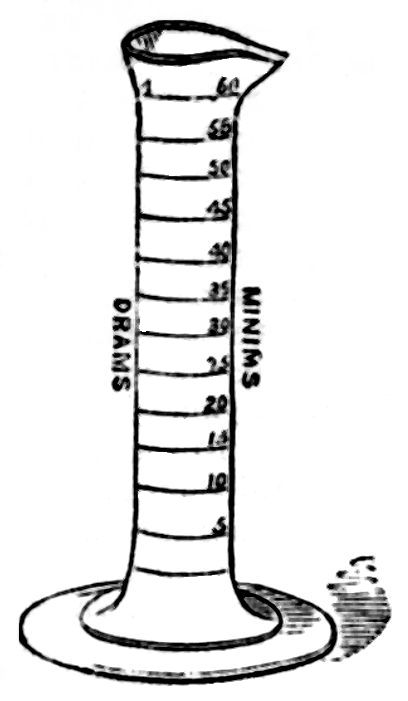
Minim Measure.
These may be purchased of any druggist, at a low price; they are made of glass, some are large enough to contain a pint.
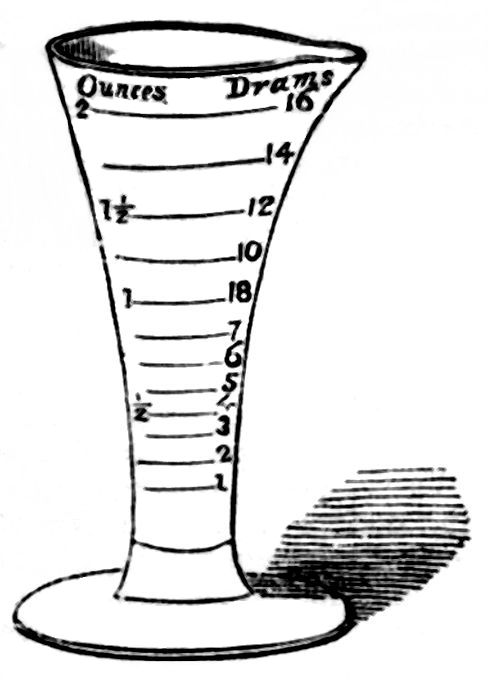
2 Ounce Measure.
We give also a cut of a graduated medicine glass which is a useful article in the nursery or sick chamber; it should be explained that a tablespoonful is considered to be half an ounce, a teaspoonful 1 drachm, a dessertspoonful is 2½ drachms, a wineglassful is 2 ounces. As spoons and glasses vary much in size it is best to use a measure like this in giving medicine. [From the “Family Doctor,” a publication that should find a place in every household, for its freedom from quackery, and the conscientious and enlightened manner in which the important subject of medicine has been treated. The work is beautifully illustrated, and is the cheapest of cheap books, being alike trustworthy and permanently useful. Published by Houlston and Wright, Paternoster Row, London.]
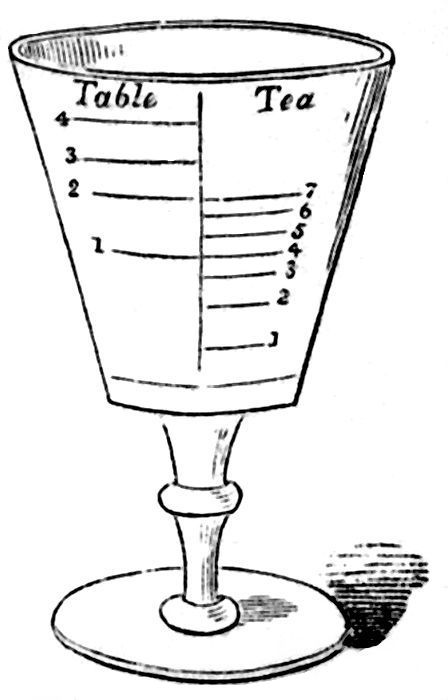
Graduated Medicine Glass.
FRUITS (DIGESTIVE PROPERTIES OF). With the exception of strawberries, there is no dessert fruit, produced in a wild state, easy of digestion. The crab-apple and the sloe, the parents of the cultivated apple and plum, are wholly unfit for use, except in the shape of jams or conserves, having a plentiful addition of sugar to correct their astringent nature.
Commencing with the Apple—the fruit in most general use, of which we have many varieties—the best being suitable for different purposes, but all containing more or less of saccharine, acid, mucilage, soft woody fibre, and water, the quality of the fruit being dependent upon the proportion in which one or other of these prevails. The aroma of apples, on which their flavour seems to depend, is supposed to act as a mild stimulant, and to assist digestion; therefore, those apples which have the finest flavour are the most esteemed. The American sorts and the rennets abound in this quality, and they also contain a greater than ordinary proportion of sugar and mucilage, consequently are more nutritive; while the pippins and all hard varieties possess much woody fibre, difficult of digestion. The dry mealy kinds, although not so much relished, are highly nutritive, while the watery sorts are generally crude, cold, and ill-adapted to weak stomachs in their raw state.
But apples of very inferior quality are made palatable and wholesome by the application of heat, and the fruit of apple pie, if not too much spiced, or even the roasted apple, is highly nutritive and digestible. Before this fruit is subjected to heat, it is composed of a very great number of little cells and vessels, containing the acid juice and the pulp—probably in a separate state. When heated, the juice expands and bursts through the cells, and as the temperature increases, the watery portion of the moisture is partly converted into steam, and evaporates through the rind.
When the acid and pulp of the apple are thus set free from their confinement, they enter into more intimate union, and the taste of the acid is mellowed by its mixture with the pulp, in the same manner as rum is mellowed by being mixed with milk: as the pulp also contains saccharine, this is disengaged by the heat, and mixes with the acid.
Ripe, sweet, and mealy apples, produce a laxative effect on the bowels, while those which are sour and astringent should be avoided by the sedentary, as they are apt to induce costiveness, griping, and flatulency, particularly when eaten after meals by persons indulging in wine or spirits.
Pears have but little of the acid usually found in apples, but they generally possess more saccharine, and also more woody fibre, which renders some kinds indigestible. Those which are not hard and solid contain, along with their sugar, a considerable proportion of mucilage, which—although nourishing—is apt to ferment in the stomach, and produce flatulence. The Maria Louisa and the Old Burgundy are easy of digestion, the former perhaps the best and handsomest pear produced, and these when ripe may be eaten freely, being sweet, mellow, and laxative, and very salutary to some constitutions, but heavy to cold stomachs when taken in excess. The very hard sorts should be prohibited to the weak, and moderately indulged in by the robust, having little nutriment, and their great quantity of woody fibre serving to overload and fatigue the stomach.
Strawberries. The strawberry was esteemed by the late Dr. Abernethy as the most wholesome of all fruits, “balsamic and refreshing, and one of the most precious gifts of Providence!” It is mildly acid, contains a medium proportion of sugar and mucilage, and the seeds act on the bowels similarly to those of the fig. In some cases the seeds are said to have accumulated in the stomach and produced alarming disease. The occurrence is rare, however, and need no more deter us from eating strawberries than the fact of a person being choked with a fish-bone should deter us from eating fish. According to Linnæus, strawberries are an excellent prevention of gout and gravel. Wine is supposed to be injurious to the beneficial action of strawberries when taken in connexion; and the usual appendage of cream and sugar, although highly nourishing to the robust, is not adapted to weak stomachs. The fruit should not be too freely indulged in after dinner, or any other full meal. In warm weather strawberries are very grateful for breakfast or lunch, and a foreign fashion of preparing them has lately been adopted: it is as follows:—Take off the stalks from as many berries as will form one layer at the bottom of a dish; sift some fine loaf-sugar over them, then place another layer, and sift again, each layer being smaller than the other, and the heap raised in a pyramidical form. When you have several layers, squeeze the juice of a fresh lemon over the whole. Before they are served out, they should be gently disturbed so as to receive the full benefit of the lemon-juice and sugar. They may be eaten of heartily when thus prepared, without danger.
Raspberries resemble strawberries in most of their qualities, and may be used in the same manner; but their flavour is too strong to be agreeable when eaten fresh: they are, therefore, mostly used for tarts or preserving. In picking, great care must be taken to abstract the small worm which will generally be found on withdrawing the stalk when quite ripe.
Gooseberries. According to Dr. John, an eminent continental chemist, the analysation of this fruit gave the following substances, but in what proportion he does not state:—Water, sugar, citrate of lime, ditto of potash, malate of lime, ditto of potash, resin, gum, fibrin, ammonia, phosphate of lime, and phosphate of magnesia. Next to the strawberry the gooseberry is esteemed as the most wholesome and digestible of our native fruits. Like that, it possesses a good mixture of sugar and acid, but abounds more in mucilage and hard seeds. The skin besides is astringent, acid, fibry, and indigestible; from the latter of which qualities it acts upon the bowels by irritation, and proves laxative; for which reason some have recommended the skins to be eaten. Of this we do not approve, for the seeds answer the purpose sufficiently well without loading the bowels with a mass of indigestible and irritable substances. Gooseberries are recommended in cutaneous diseases—being cooling to the blood—and also in deficiency of bile. Heat, whether applied to the stewing or baking, proves (as in the case of apples) an excellent corrector of the crude juices of unripe or inferior fruit, and the green shoots of rhubarb, which are likewise sub-acid and saccharine, make a wholesome addition to pies and puddings in the early part of summer.
Currants rank next in quality, and those, particularly the black, have a much stronger principle of astringency than any of the preceding fruits; consequently, though they contain sugar and mucilage, they prove less laxative than strawberries or gooseberries. The seeds and skin being nearly indigestible should not be swallowed, or if so eaten, with great moderation, and the black are considered the most wholesome.
Grapes can only be classed to a certain degree as a native fruit; for although vast quantities are grown against walls, they do not always ripen sufficiently for use in a raw state. The grape contains the same chemical principles as the fruits enumerated, with the addition of super-tartrate of potass, the substance which, according to Maculloch, makes the chief difference between grape wine and all others. It has also less of the malic acid than our native fruits, while it possesses a pleasant and wholesome aromatic flavour, and most sorts have also a principle of astringency which counteracts in some degree the laxative tendency. For this reason, ripe grapes may be eaten without reserve even by the sick and convalescent; for although the stones or seeds possess a very strong astringent principle, so long as they are unbroken it is not brought into action, and they pass through the bowels without producing any injurious effects. The large portion of sugar in grapes renders them nutritive, while the acidity facilitates their digestion; and for bilious complaints or dry temperaments they are found to have a very beneficial effect.
Cherries differ exceedingly in quality, some sorts containing much water and sugar, which, from being easily fermented, occasion colic and flatulence. Others contain a large portion of water and acid, which slightly stimulating the stomach, proves digestible and wholesome—but the most nutritive are the pulpy mucilaginous sorts. When cherries are quite ripe they may be eaten freely without danger, but care should be taken not to swallow the stones, which sometimes lodge in the bowels, and produce obstructions. The kernel yields a portion of that deadly poison prussic acid.
Plums, Peaches, Nectarines, and Apricots. These stone-fruits contain the elements of sugar, water, mucilage, acids, and woody fibre, varying in proportion according to their kind and quality. They are all highly injurious to the stomach in an unripe state, in consequence of their acid juices acting as astringents, and producing gripes and colic, therefore they should never be ventured on until the pulp can be easily separated from the stone. When quite ripe, they are wholesome and easy of digestion, acting on the bowels as a mild laxative. It sometimes happens that one-half the fruit—the sunny side—is ripe, the other not, in which case the unripe part should be rejected. It has been generally remarked that a plentiful year for plums is rife of fevers and dysenteries, which proceed doubtless from incautious indulgence. Heat, however applied, renders the fruit wholesome and digestible. Ripe apricots are considered refreshing and laxative, and peaches are best raw and stewed with sugar; or, for cold heavy stomachs, stewed peaches are found to be gratifying.
Oranges, Lemons, and Limes.—Unfortunately these delicious cooling productions of warmer climes come in season here during the winter, when their fragrant and refreshing qualities cannot be so well appreciated as in sultry weather. They all abound in water, acid, mucilage, and woody fibre, with a very variable proportion of saccharine. The peel, or rind, besides woody fibre, contains a strong indigestible oil, the basis apparently of their fine aroma. The inner, or white rind, as well as the outer, should be carefully removed before eating, for it is proved to be highly deleterious to weak stomachs. The acids of these fruits, properly corrected with sugar, are light, cooling, and wholesome. Like other acid and saccharine vegetables, they are also of a laxative nature. The weak stomach; however, may very readily be injured by too copious a use of them. When eaten in too great quantity after dinner, they impede and sometimes stop digestion. In fever, these fruits are very grateful and advantageous. In scorbutic cases they are good, and in the sea-scurvy invaluable, as a certain remedy. Oranges have been said to produce a cure in some case of consumption, when eaten in the proportion of at least half a dozen a-day, acting on the stomach as a mild tonic, when too weak to bear elixir of vitriol.
Raisins, Currants, Figs, French Plums, and other fruits, imported in a dry state, should be indulged in with moderation, and the skins invariably rejected, being highly indigestible, and producing flatulency.
Walnuts, Almonds, Nuts. The chemical elements of the various species of nuts differ considerably from that of other fruits. In these we have the farinaceous principle of the grains, with an oil which is rare in other vegetable productions. Both the farina and the oil, besides a small portion of saccharine, are nutritive; but the oil renders them hard of digestion, and fatal consequences occur from eating quantities of nuts. All nuts ought to be used as fresh as possible, for the oil becomes rancid by keeping. It is of great importance that the kernel should be well chewed, for the unbroken portion cannot be digested by the strongest stomach. Salt is a good condiment, and improves the flavour. The French use pepper and verjuice with new walnuts.
Almonds, more especially the bitter, and all nuts which possess the peach-blossom or bay-leaf flavour, contain a portion of that deadly poison prussic acid, and should therefore be eaten with extreme caution. In persons of weak digestion, they frequently produce griping, cramp, nausea, and sometimes fainting. Sugar taken with them is supposed to counteract this to a certain degree, but the best way is to avoid eating substances of so questionable a character.
Pine-Apple. The flavour of this fruit is confessedly exquisite, but its acidity and astringent qualities make it unfit for the delicate; although, on account of its rarity, most persons are tempted to eat it when attainable. Its acrid juices are mellowed by dipping the slices in wine or brandy, saturated with sugar; but it is generally eaten fresh, seasoned with the finest sugar en poudre.
CONCHOLOGY. The natural history of shells and mollusca, or zoophytes. A is a trochus, or top-shaped shell; B is a species of whelk.
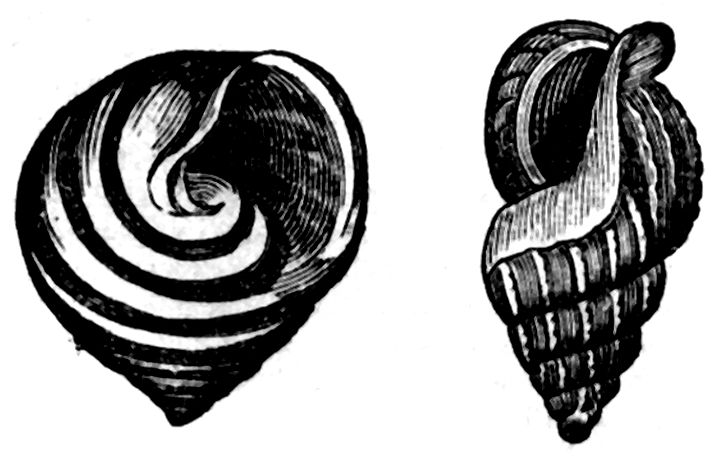
READING ALOUD. This is no doubt an excellent exercise, and it has been much recommended by the ancient physicians. To this also may be joined that of speaking. They are both of great advantage to those who have not sufficient leisure or opportunities for other kinds of exercise. To speak very loud, however, or exercise the voice immediately after a meal, is hurtful to the lungs, as well as to the organs of digestion. Singing, as by the vibratory motion of the air it shakes the lungs, promotes in a remarkable degree the circulation of the blood. Hence those sedentary mechanics who, from habit, almost constantly sing at their work, unintentionally contribute much to the preservation of their health.
DIADELPHIA. The 17th class of the Linnæan system of plants, containing three orders, Hexandria, Octandria, and Decandria, with the stamina united into two bodies by the filaments.
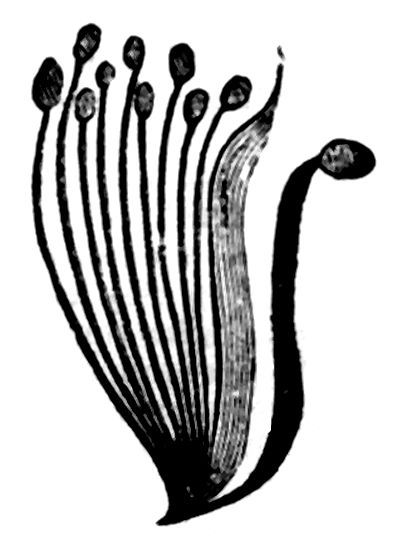
HABERDASHERS. The haberdashers (hurriers or cappers of old time so called), were originally a branch of the mercers. Haberdashers of small wares, such as ribands, laces, &c., were called millainers (milliners), an appellation derived from their dealing in merchandise chiefly imported from Milan, in Italy, such as brooches, agglets, spurs, capes, glasses, &c. Amongst other wares also which constituted a part of the haberdashery of the period, were pins, before the introduction of which the English ladies are stated to have used points or skewers made of thorns, to fasten their garments with; but long before the decease of Elizabeth they were manufactured in great numbers in England. In the reign of Henry VI. [1422-1461] there were not more than a dozen haberdashers’ shops in the whole city. The business of the haberdasher was not, however, confined to the lighter articles of a lady’s wardrobe, but extended to the sale of daggers, swords, knives, spurs, glasses, dials, tables, balls, cards, puppets, inkhorns, tooth-picks, fine earthen pots, salt-cellars, spoons, tin dishes; and even mouse-traps, bird-cages, shoeing-horns, lanterns, and jews’ harps.
MUSES (THE NINE). The Muses originally consisted of three in number: namely, Mnemosyne, memory; Melete, meditation; Aoide, song. They were augmented to nine, because the inhabitants of their ancient town, being desirous of placing in the Temple of Apollo the statues of the three muses, and these being of extraordinary beauty, they ordered three of the most skilful sculptors to execute, each, the statues of the three muses, which made up the number of nine, and from which it was proposed to select the three most perfect statues. But when the choice came to be made, they found the whole nine so beautiful, that it was agreed to take them all, and call them the “nine muses,” and place them in the Temple of Apollo as such. From this accident (it is thought) they derived their origin, and the six other attributes of poetry were given as additional sisters.
CERES, in heathen mythology, the goddess of corn, and daughter of Saturn and Cybele. Ceres is also a small planet which revolves round the sun in four years, seven months, and ten days, at the distance of 260,000,000 of miles.
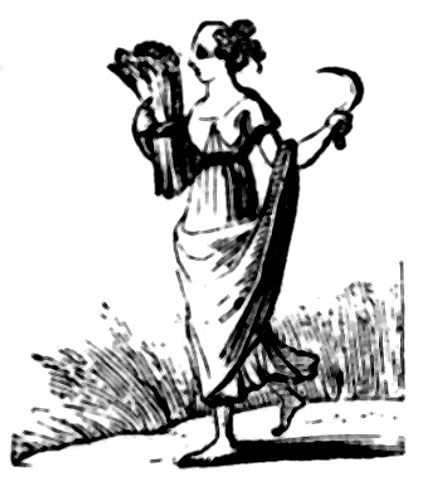
BARON. A title of honour granted by the king or queen, and secured to the receiver’s descendants; the lowest rank of the peerage. His wife is a baroness. In France, Germany, &c. the title of baron is only equivalent to the English baronet.
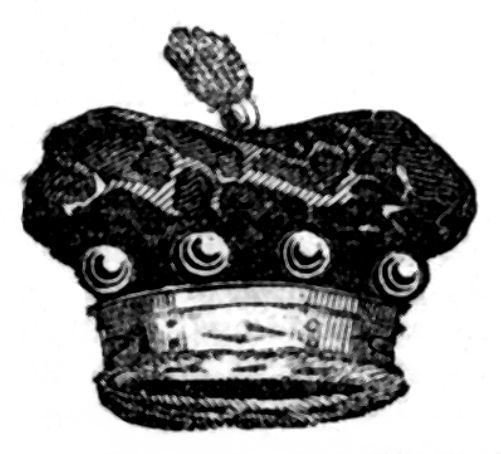
HOUSES (TRANSPOSITION OF). The annexed diagram will explain the method by which houses are removed. The building, of course, must be a detached one. Openings are made in the end walls, just above the ground, large enough to insert beams about fifteen inches square across the building (1); the end of each beam is supported on blocks of wood, fixed into the ground, and clear of the walls, and each beam made firm and tight by driving wedges between the beams and the upright block.
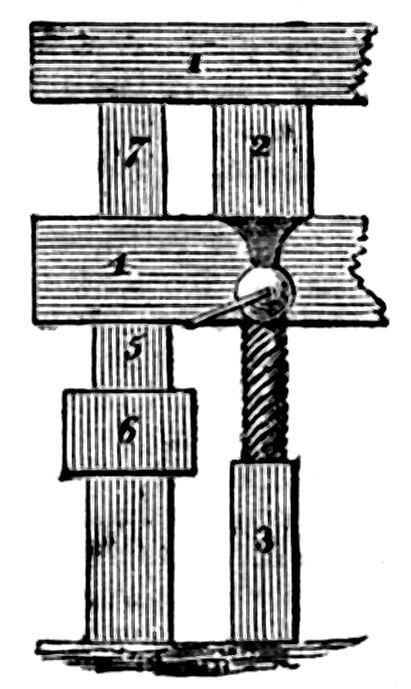
When this has been done, the foundation is cleared away, and a clear space left. Then other beams (2) are placed under the first, and resting like them on blocks of wood, and by this means the front and back walls are supported; and now the whole foundation is exposed. The screws (3) are placed under the ends of the second beams (2), which are forced upwards by their means, and the weight of the whole building sustained by them. The ground underneath being all removed, a set of grooved-ways, or beams (6), are placed where the end walls formerly stood, and the cradles (5), which are beams with a projection corresponding to the groove in the ways, are placed on them, both being previously well greased. Large beams (4) are placed over the cradles, between them and the beams (2) which support the ends of the house, and wedges driven in to render the whole tight and secure, which is also effected by additional blocks (7). The screws are now removed, and being placed horizontally, are made to act together against the cradles, and move them along the ways, at the rate of four feet a day, to the place the house is to occupy. Then, by inverting the operations, the beams are removed, and the house firmly fixed, without sustaining any injury, and often without even moving as much as a chair from the house.
CHEMICAL TRANSMUTATIONS. Linen can be converted into sugar; sugar into alcohol (spirits) and carbonic acid; alcohol can be changed into ether and water; sugar can also be converted into oxalic acid, also into pure charcoal (carbon) and water. Alcohol (spirits) will readily change into vinegar (acetic acid). Starch may be transmuted either into gum, alcohol, sugar, acetic or oxalic acid, as well as many other substances, to which, however, the chemists have given such hard names that we cannot find a pen strong enough to write them.
TOOTHACHE. The cause of toothache may be thus explained:—Within the tooth is a cavity filled with a nervous pulp—of course highly sensitive—and under the influence of injury, exposure, and disease, affords one of the sources of “toothache.” The roots of the tooth are surrounded by a membrane, a similar one to which lines the socket into which they are planted. Inflammation in these membranes is another source of toothache. They become filled with blood, but cannot expand, and consequently compress the nerve with the power, almost, of an hydraulic press, causing most severe agony.
SHILLING. This word is supposed by some to be derived from the Latin—silicus, which signifies a quarter of an ounce, or the forty-eighth part of a Roman pound. At the time of the Conquest, the shilling was worth fourpence. Afterwards, the French solidus of twelve-pence was called by the name of shilling, and the Saxon shilling of fourpence took the name of groat, or great coin, because it was the largest English coin then known.
MUSK. Of all odours the most intolerable to those who do not use it is musk. Many persons are inconvenienced by it to such a degree that they could not stay for five minutes in a room containing the minutest quantity of it. It is also the odour which adheres the longest. A coat upon which musk has been thrown will smell of it at the end of two years, though it may have been during the whole time exposed to the open air; but in apartments it will endure almost for ever. The Empress Josephine was very fond of perfumes, and, above all, of musk. Her dressing-room at Malmaison was filled with it, in spite of Napoleon’s frequent remonstrances. Twenty-five years after her death, M. Hagerman, who became the owner of Malmaison, had the walls of that dressing-room repeatedly washed and painted; but neither scrubbing, aquafortis, nor paint, were able to remove the smell of the good Empress’ musk.
WEDDING RINGS (ORIGIN OF). The singular custom of wearing wedding-rings appears to have taken its rise among the Romans. Before the celebration of their nuptials there was a meeting of friends at the house of the lady’s father, to settle articles of the marriage contract, when it was agreed that the dowry should be paid down on the wedding-day, or soon after. On this occasion there was commonly a feast, at the conclusion of which the man gave to the woman, as a pledge, a ring, which she put on the fourth finger.
TURPENTINE. Common turpentine is the natural resinous juice which exists in trees of the fir tribe. It is obtained in large quantities from the wild pine, or Scotch fir, but it is brought to us chiefly from the northern countries of Europe. To procure the turpentine, the trees are stripped of their outer bark in the month of May, to the extent of about six inches, so as to expose the inner smooth bark, near the foot of the tree, where an incision is made.
VENTRILOQUISM. The main secret of ventriloquism simply consists in first making a strong and deep inspiration, by which a considerable quantity of air is introduced into the lungs, to be afterwards acted upon by the flexible powers of the larynx, or cavity situated behind the tongue and the windpipe; thus prepared, the expiration should be slow and gradual. Any person, by practice, can, therefore, obtain more or less expertness in this exercise, in which, though not apparently, the voice is still modified by the mouth and tongue; and it is in the concealment of this aid that much of the perfection of ventriloquism lies.
PORCELAIN. The name of porcelain is derived from the Portuguese word porcelana, which signifies a cup. It was adopted from the circumstance that the Portuguese were the first importers of porcelain from China. In Great Britain the term chinaware is more commonly used.
OATMEAL. The oat, though not much cultivated in South Britain, as an article of food for man, still furnishes one of the most important and productive crops of the farm. Its scientific Latin name avena is of doubtful interpretation; from it the French derive their word l’avoine. The native country of the oat is also considered quite unknown; though it appears certain that all the cultivated species flourish most in cold climates. In Scotland, for example, it arrives at great perfection, as well as in the northern counties of England. To the Scots its meal is important: they use it in great quantities, not merely in the form of water-gruel, but in porridge and puddings. But Scotch oatmeal is a very different thing from the poor perishable article which is sold in England; the grain is dried and husked by a peculiar process; and then is ground to three degrees of fineness. It will keep and improve in quality during any length of time: and the more it is pressed the better.
MOHAIR. This is the hair of a variety of the common goat, famous for being as soft and fine as silk, and of a silvery whiteness. It is not produced anywhere but in the vicinity of Angora, in Asia Minor.
THIRST (CAUSE OF). Intense thirst is said to be caused by the extreme dryness of the air when the temperature is low. In this state it abstracts a large amount of moisture from the human body. The soft and extensive surface which the lungs expose twenty-five times or oftener every minute to nearly two hundred cubic inches of dry air, must yield a quantity of vapour which one can hardly spare with impunity. The human skin throughout its whole extent, even where it was brought to the hardness of horn, as well as the softest and most delicate parts, is continually exhaling vapour, and this exhalation creates in due proportion a demand for water. Let a person but examine the inside of his boots after a walk in the open air at a low temperature, and the accumulation of condensed vapour which he finds there will convince him of the active state of the skin. In cold countries, the stockings have been found adhering to the soles of the boots after a walk of a few hours. The hoar frost and snow which they contained could not have been there by any other means except exhalation from the skin.
CELERY. In earthing up celery the greatest care is necessary to prevent any portion of the earth from falling into the heart of the plant, which would prevent the upright growth of the inside leaves, and spoil its appearance for the table; nor should the earth be pressed too closely round the upper part of the plant, as frequently, when such is the case, it bulges out below. The best practice is to tie each plant up loosely with matting (having previously removed the suckers and small leaves), and then a little earth can be added every week, as the plant increases in height. Another common error arises from earthing celery up too soon. It should be allowed to grow to a considerable size before earthing up is attempted, and be frequently soaked with water, as but little rain will reach the roots afterwards; it should likewise never be touched when the plants are at all damp.
EARLY RISING. Dr. Wilson Philip, in his “Treatise on Indigestion,” says—“Although it is of consequence to the debilitated to go early to bed, there are few things more hurtful to them than remaining in it too long. Getting up an hour or two earlier often gives a degree of vigour which nothing else can procure. For those who are not much debilitated and sleep well, the best rule is to get out of bed soon after waking in the morning. This at first may appear too early, for the debilitated require more sleep than the healthy; but rising early will gradually prolong the sleep on the succeeding night, till the quantity the patient enjoys is equal to his demand for it. Lying late is not only hurtful by the relaxation it occasions, but also by occupying that part of the day at which exercise is most beneficial.”
HOSIERY. All hosiery is to be judged by the fineness of the thread and the closeness of the texture, which, in the case of stockings especially, may be partly appreciated by weighing, as it were, the articles in the hand. In ribbed stockings a deception is sometimes practised, against which it is necessary to guard. The spaces between the ribs, which ought to be formed by an inversion of the stitch, contains no stitch at all, but an open range of threads pervious to the weather, and utterly destitute of durability. As the ribs of stockings exposed to sale are necessarily almost in contact, the fault cannot be detected without introducing the hand and opening the tissue, when it will be instantly apparent; and, indeed, will exactly resemble the flaw caused by a dropped stitch in a stocking in wear. In cheap cotton stockings the feet are often cut out and sewed together, but these seams invariably hurt the foot.
PAINTING ON VELVET. Among the various accomplishments of the present day, no fancy-work is perhaps more elegant, produces a better effect, and is, at the same time, more easily and quickly performed, than painting on velvet. Possessing all the beauty of colour of a piece of wool-work, it is in every way superior, as the tints used in this style of painting do not fade; and an article which it would take a month, at least, to manufacture with the needle, may be completed in four or six hours on white velvet, with the softest and most finished effect imaginable.
The first thing necessary to be done, after obtaining the colours and the velvet (which should be cotton, or more properly velveteen, as most common cotton velvets are not sufficiently thick, and silk velvet, besides the expense, is not found to answer), is to prepare the formula for the group intended to be painted. Get a piece of tracing or silver-paper the size of the cushion, mat, or screen you wish to paint, then lay it carefully upon the group you wish to copy and trace through. Should the paper slip, the formula will be incorrect; it will be therefore well to use weights to keep all flat. Having traced your flowers, remove the thin paper, and laying it on a piece of cartridge paper the same size, go over the pencil-marks by pricking them out with a fine needle, inserted in a cedar stick. Now that you have your whole pattern pricked out clearly upon a stiff paper, take eight or nine more pieces of cartridge paper, of the same size as the first, and laying them, one by one, in turn, under the pricked pattern, shake a little powdered indigo over, and then rub with a roll of lint or any soft material. The indigo, falling through the punctures, will leave the pattern in blue spots on the sheet of paper beneath; then proceed in like manner with the remaining formulas until you have the self-same pattern neatly traced, in blue dots, on them all. Next, with a sharp penknife, you must cut out the leaves, petals, and calices of the group, taking care to form only a few on each formula, and those not too near together, lest there should not be sufficient room to rub between the spaces, and that, for instance, the green tint intended for the leaf should intrude on the azure or crimson of the nearest convolvulus; for in this sort of work erasure is impossible.
The following diagrams will show how the formulas should be cut, so as to leave proper spaces, as above-mentioned. The shading denotes the parts cut out.
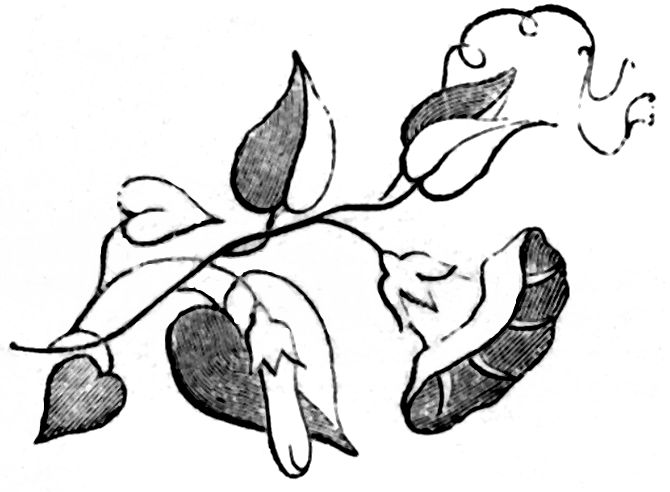
Formula 1.
Some leaves may be cut out in two halves, as the large ones in the pattern; others all in one, as the small leaf: but it is chiefly a matter of taste. The large leaves should, however, generally be divided. In each formula there should be two guides—one on the top of the left-hand side, the other at the bottom of the right-hand corner—to enable the formulas always to be placed on the same spot in the velvet.
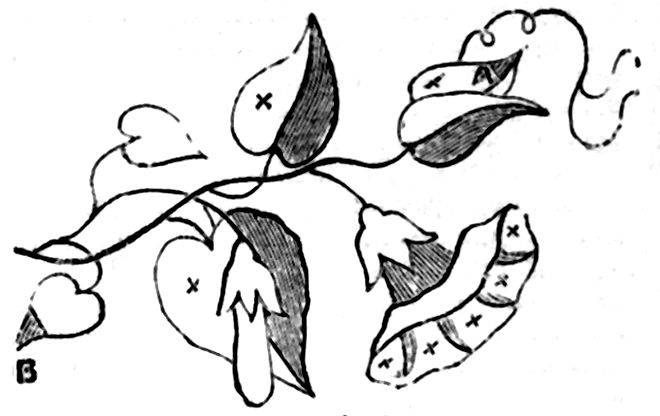
Formula 2.
For instance, as in Formula 2, A and B are the two guides, and are parts cut out, in Formula 2, of leaves, the whole of which were cut out in No. 1; and therefore, after No. 1 is painted, and No. 2 applied, the ends of the painted leaves will show through, if No. 2 be put on straight; if, when once right, the formula is kept down with weights at the corners, it cannot fail to match at all points. Care should, however, be taken never to put paint on the guides, as it would necessarily leave an abrupt line in the centre of the leaf. While cutting out the formulas, it is a good plan to mark with a cross or dot those leaves which you have already cut out on the formulas preceding, so that there will be no confusion. When your formulas are all cut, wash them over with a preparation made in this manner: put into a wide-mouthed bottle some resin and shell-lac—about two ounces of each are sufficient; on this pour enough spirits of wine or naphtha to cover it, and let it stand to dissolve, shaking it every now and then. If it is not quite dissolved as you wish it, add rather more spirits of wine; then wash the formulas all over on both sides with the preparation, and let them dry. Now taking Formula No. 1, lay it on the white velvet, and place weights on each corner to keep it steady; now pour into a little saucer a small quantity of the colour called Saxon green, shaking the bottle first, as there is apt to be a sediment; then take the smallest quantity possible on your brush (for if too much be taken, it runs, and flattens the pile of the velvet; the brush should have thick short bristles, not camel-hair, and there ought to be a separate brush for each tint: they are sold with the colours). Now begin on the darkest part of the leaf, and work lightly round and round in a circular motion, taking care to hold the brush upright, and to work more as it were on the formula than on the velvet. Should you find the velvet getting crushed down and rough, from having the brush too damp, continue to work lightly till it is drier, then brush the pile the right way of it, and it will be as smooth as before. Do all the green in each formula in the same manner, unless there be any blue-greens, when they should be grounded instead with the tint called grass-green. Next, if any of the leaves are to be tinted red, brown, or yellow, as autumn leaves, add the colour over the Saxon green before you shade with full green, which will be the next thing to be done; blue-green leaves to be shaded also with full green. Now, while the green is yet damp, with a small camel-hair pencil vein the leaves with ultramarine. The tendrils and stalks are also to be done with the small brush. You can now begin the flowers; take, for instance, the convolvulus in the pattern. It should be grounded with azure, and shaded with ultramarine (which colour, wherever used, should always be mixed with water, and rubbed on a palette with a knife); the stripes in it are rose-colour, and should be tinted from the rose saucer. White roses and camellias, lilies, &c., are only lightly shaded with white shading; and if surrounded by dark flowers and leaves so as to stand out well, will have a very good effect.
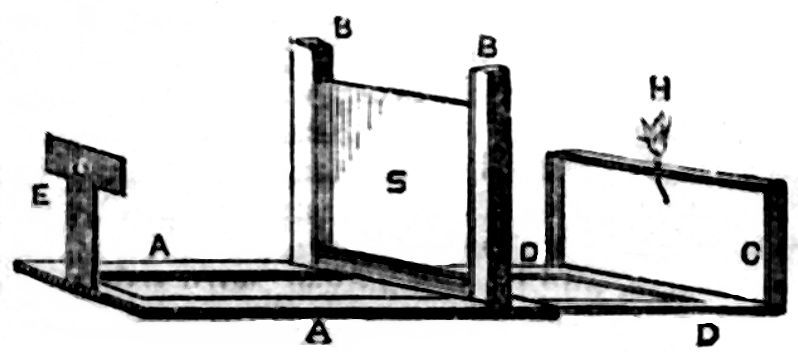
Flowers can easily be taken from nature in the following manner.—A A, D D, is a frame of deal, made light, and about two feet long, and eight or ten inches in width. The part D D is made to slide in a groove in A A, so that the frame may be lengthened or shortened at pleasure. A vertical frame, C, is fixed to the part D, and two grooved upright pieces, B B, fixed to the other part. These uprights should be about nine inches high, and C half that height. There is also a piece of wood at the end A of the frame, marked E, with a small hole for the eye, and there is a hole in the top C opposite to it. S is a piece of glass, sliding in the grooves in B B. In the hole H is placed the flower or flowers to be copied. If a group is wished, more holes should be made, and the flowers carefully arranged. The eye being directed to this through the hole in E, it can be sketched on the glass by means of a pencil of lithographic chalk. It is afterwards copied through by slipping the glass out, laying it on a table, and placing over it a piece of tracing-paper. When traced on the paper, proceed as before to make the formulas.
Of course, so delicate a thing as white velvet will be found at length to soil. When this is the case, it can be dyed without in any way injuring the painting. For this a dye is prepared by the manufacturer of the colours, and can be procured with them.
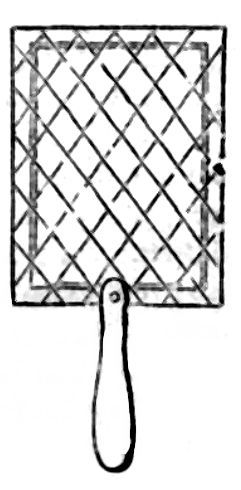
Dye thus:—Get an old slate-frame, or make a wire frame; add to it a handle, as in annexed figure; then tie over it a network of packthread; next cut a piece of cardboard the exact size of your group, so as to completely cover it, the edges of the cardboard being cut into all the ins and outs of the outer line of the group; then placing it carefully over the painting, so as to fit exactly, lay a weight on it to keep it in place. Then dip a large brush into the dye, hold the frame over the velvet (which should be stretched out flat—to nail the corners to a drawing-board is best), and by brushing across the network, a rain of dye will fall on the velvet beneath. Do not let the frame touch the velvet; it should be held some little way up. Then just brush the velvet itself with the brush of dye, to make all smooth, and leave the velvet nailed to the board till it is dry. Groups, whether freshly done, or dyed, are greatly improved, when perfectly dry, by being brushed all over with a clean and rather soft hat-brush, as it renders any little roughness, caused by putting on the paint too wet, completely smooth and even as before. Music-stools, the front of pianos, ottomans, banner-screens, pole-screens, and borders for table-cloths look very handsome done in this manner.
MOSS (FORMATION OF). In order that moss may be renovated, when dug, it is requisite that the pits be left full of water; that they be not too large nor deep, and that the water in them be stagnant. It appears that similar requisites are necessary to the original formation of that substance, either from ligneous or aquatic plants. Moisture seems to be absolutely requisite. Without it no moss is formed of these materials. Let a congeries of ligneous or aquatic plants be formed, however great they may be, if left dry, or not immersed in water, it never will be converted into peat. Such a moss indeed will, even in this case, undergo certain chemical changes, and form new combinations, but the result will be different from that substance. When exposed to the influences of the atmosphere, it will undergo the putrid fermentation, and be reduced to vegetable mould. In this form it will be destitute of the distinguishing qualities of moss, inflammability, tenacity, and others.
STAMMERING (CURE FOR). The philosophy of the cure is simple. Stammering is occasioned by the effort to speak while inhaling; and utterance is only obtained when the lungs become full of air, and the process of breathing out begins. The lesson given is, never to attempt to speak until after taking breath. So long as the individual can think of this law, and carefully apply it, no impediment would occur; but the habit of years is not to be overcome by a few days, or even weeks, of perseverance, and, in most cases, the stammerer returns in a little time to the old order of things. It is known that stammerers can sing without manifesting the slightest impediment; and the reason is plain—the chest has to be constantly supplied with air, like an organ, in order to produce the desired musical sounds. It is unquestionably true, that stammering may be prevented by carefully observing the directions above given. That the cure does not remain is not, we think, so much a defect in the means as a failure on the part of the individual to use them long enough. The habit of years is not to be overcome in a week or a month. There must be perseverance, and for many months, perhaps years.
BIRD-STUFFING. Bird-stuffers, in preparing and skinning a bird or other animal ready for preserving, use burnt alum to rub over any wet or bloody part, that it may not soil the rest. In this case its peculiar astringency assists in tanning or rather hardening the skin, so that it is not so liable to contract mouldiness, nor to become the prey of the moth and other destructive insects. All that is necessary is to put some powdered alum in a ladle or fire-shovel over the fire. It will soon melt, boil, and swell up. It is to be kept on the fire till all the water has evaporated, and until it becomes so brittle as to break easily into a fine powder.
BUTTER (TO CURE). Take two quarts of the best common salt, one ounce of sugar, and one ounce of common saltpetre; take one ounce of this composition for one pound of butter, work it well into the mass, and close it up for use. The butter cured with this mixture appears of a rich and marrowy consistence and fine colour, and never acquires a brittle hardness nor tastes salty. Dr. Anderson says: “I have eaten butter cured with the above composition that has been kept for three years, and it was as sweet as at first.” It must be noted, however, that butter thus cured requires to stand three weeks or a month before it is used. If it is sooner opened, the salts are not sufficiently blended with it, and sometimes the coolness of the nitre will be perceived, which totally disappears afterwards.
CONDIMENTS. The name of condiment is usually given to those substances which are taken with food for the immediate purpose of improving its flavour. But most of them serve other and much more important purposes in the animal economy than that of gratifying the palate. They are, in effect, mostly alimentary substances; as salt, sugar, oil or fat, and vegetable acids.
RICE-PAPER (TO MODEL IN). Rice-paper is principally applied to the formation of groups of flowers, either on cardboard, or affixed to small vases, baskets, &c., in festoons and clusters. The rice-paper may be procured in various colours, and intermediate tints may be made by colouring the white. Several pieces of rice-paper are laid on each other upon a tablet of lead, and the leaves and component parts of flowers are cut out with small steel punches, which may be procured in every variety of form at the fancy-tool warehouses. A sufficient quantity of the different leaves having been thus formed, and placed on separate trays, each leaf is to be held by a delicate pair of tweezers, and its end affixed, with stiff gum water, to the article requiring ornament. Thus, the heads of roses and thick clusters of flowers are formed, and fine delicate parts may be drawn in colours afterwards. Water-colour drawings are frequently made on leaves of rice-paper, for scrap-books, screens, &c. The effect of the colours, if properly managed, on this material, is very soft and delicate.
PLATED WARE. The manufacture of plated ware is peculiarly English. At all periods a thin sheeting of silver may have been used as an outer coating to inferior substances in order to save expense, but such coating did not intimately connect with the under material. In referring to Hunter’s “Hallamshire,” the part of Yorkshire in which Sheffield is situated, it appears that the first introduction of plating on copper was in the year 1742, by a Mr. Thomas Bolsover, of the body of the Corporation of Cutlers, at Sheffield, and, like most other ingenious arts, was discovered by accident. He was repairing a knife-handle, composed of silver and of copper, and was struck with the possibility of uniting the two metals so as to form a cheap substance presenting an exterior of silver, and which might be used in various articles in which silver only had before been employed.
HOLYROOD (ORIGIN OF). The story is thus stated:—King David I., being on a hunting match in the forest of Drumselch, near Edinburgh, on a rood-day, was attacked by a large hart, and his life was in the utmost danger. While he was endeavouring to defend himself with his hands against the furious assaults of the animal, a miraculous cross from heaven slipped into his hand, which so frightened the stag, that he retreated immediately. This wonderful circumstance having, of course, put an end to the chase, David repaired to the castle of Edinburgh, where, in a dream, he was instructed to erect an abbey, or house, for Canons Regular, on the place where the celestial cross was put into his hands. In obedience to this visionary command, the king erected an abbey for the said purpose, and dedicated it to the Holy-Rood, or Holy-Cross, and deposited the same therein, where it is said to have remained till the reign of David II.
THERMOMETERS FOR COMPARISON should all be placed at a certain height from the ground—they should all face the north (except those which are required to register the maximum temperature in the sunshine, which should face the south); they should not be influenced by radiated heat, by currents, by reflected heat (such as is communicated from an opposite wall) by absorption of heat from the wall, or wood-work to which the thermometer is attached; and, in short, they should be situated where there is a free passage of air. With regard to the height that a thermometer is placed above the ground, it is ascertained that an inch occasionally makes a difference of a few degrees.
JAMS (TO PRESERVE FROM MOULD). Cut a round circle of writing paper, the size of the interior of the pot, and one about an inch and a half larger. Take the white of an egg, and a pastebrush, and lay a coating of white of egg over the surface of the smaller circle, and then lay that piece on the top of the jam, with the untouched side of the paper next to the jam. Take the larger piece, and coat that on one side with white of egg, and let the surface thus coated be the one turned inwards. This circle is to cover the pot; and the white of egg renders it adhesive, and pastes it firmly down all round the edge of the crock.
HOUR-GLASS. An hour-glass may be made thus:—Procure a cork that will fit the necks of two oil-flasks, and make a neat hole through it with a round file. In the middle of this hole fasten a bead, or piece of tobacco-pipe, a quarter of an inch long. Dry some common house-sand in a ladle over the fire, and shake it through a fine sieve or muslin bag; fill one of the flasks with it, fit in the cork, and invert it over a jug or the neck of a wine-bottle; let it run for an hour; collect the sand that has passed through, pour the rest away; return the sand to the flask, and fit in the other. Place the whole in a wooden frame for support. Egg-glasses are to be made with two small phials, furnished with sand to run for three minutes. The flasks should be well dried by the fire, and the cork sealed in. If oily, they may be cleaned with a little hot water, sand, and salt of tartar.
AMBULANCE. A light caravan, furnished with surgeons’ assistants and orderlies for attending the wounded on the battle field. During the disastrous Crimean war, the readers of the illustrated papers had frequent opportunities of realizing the utility of these moveable field hospitals; several new ambulances were at that time invented and constructed, both by the English and French, some of them very complete in their arrangements and appointments; and the poor wounded soldiers had often cause to bless the humanity which planned, and the mechanical skill which constructed, these carriages for conveying their mutilated and agonized bodies to the more permanent hospital.
SNUFF-TAKING. Snuff is said to have originated with the French; and indeed it is very probable that no other nation in the world would have imagined so singular a mode of using the tobacco plant. During the last century it was indispensable for every French gentleman to carry a snuff-box, and the sale of snuff was found so advantageous, that the French Government created a monopoly of snuff manufacture in its own favour, which monopoly subsisted for many years. As to the use of snuff, it cannot but be pernicious, for it acts upon the brain, causing intoxication and sickness. Besides this, a full third of the powder taken into the nostrils enters the stomach, creating a truly distressing disturbance of that organ. As to breaking off the habit, half-resolution will not suffice; nothing but total abstinence will eradicate it.
QUAKER. This was a title applied in derision when George Fox, the first of this sect, was committed to Derby gaol for promulgating their opinions openly, by preaching the necessity of the life of God in the soul. When brought before the magistrate, he told him to tremble at the word of the Lord. The derision has long since passed away, and the term Quaker is become respectable.
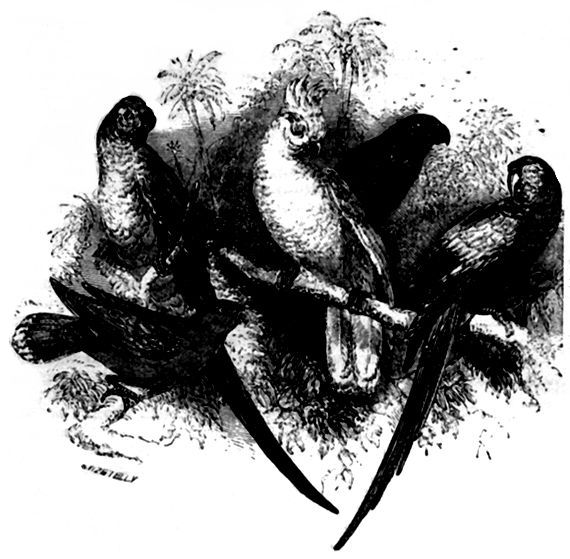
PARROTS. In works on natural history, we generally find the members of this family of levirostoes, or large billed birds, ranged under six divisions; but it will be sufficient to enumerate only those that are usually treated as household pets, viz. the Macaws, which include the Cockatoos and Toucans; the Parrots, which include the Parakeets; and the Lories, which have, perhaps, the most gorgeous plumage of any. Let us commence with the first-named division—
The Macaws, which, for gracefulness of form and richness of plumage, may vie with the most beautiful members of their tribe. They are distinguished from the true Parrots by having the cheeks bare of feathers and the tail very long, in which latter respect they resemble the Parakeets, than which, however, they are generally larger birds. They are usually more sedate and less given to mischievous practices, such as biting and tearing things to pieces, than other members of the family, although they are vivacious birds, and withal very noisy ones, occupying a great deal of their time in discordant screeching. There is much of grace in their motions, and the rich metallic reflections which play over their plumage renders them extremely ornamental in the hall or drawing-room. These Macaws are mostly natives of the tropical parts of America, where they nestle in the holes of decayed trees, which some are said to excavate in the same way as do our Woodpeckers. It is certain that one species burrows in the elevated banks of rivers and streams, and perhaps others may do the same, for of their habits in a wild state but little comparatively is known. With regard to food, they appear to prefer dry seeds to succulent berries; in the neighbourhood of cultivated lands they feed much on coffee. They can scarcely be called gregarious, being found mostly in pairs; sometimes two or three of these pairs form a little community, but there does not seem to be much sociability among them.
Cockatoos. These birds are among the largest of the Parrot tribe, and most of them are distinguished, in a greater or less degree, by the beautiful crest of feathers on the head, which they can elevate or depress at pleasure. The name of the group is derived from the loud and distinct call-note of some of the species belonging to it, sounding like the syllables cock-a-too very distinctly uttered. They are mostly natives of Australia and the Indian Isles, where they breed in the holes of decayed trees, like many Parrots and Macaws; they have short and powerful bills, remarkably deep at the base, and often nearly concealed by the projecting feathers of the face; the upper mandible, which is much arched, projects considerably over the lower, nearly enclosing it like a sheath; near the tip it becomes narrow and acute, the cutting edges are sinuated or toothed. The Cockatoos feed upon the seeds of various trees and plants, being able to crack the stones of the hardest fruits; they form a well-marked genus, distinguished from other groups of the Psitticinæ by the above-named characteristics, and also by their light and uniform colour, which is mostly white, tinged more or less, in different species, with sulphur-yellow, or rose-red. Like the true Parrots, they have a short and even tail; and the massive and powerful bill, and robust scansorial or climbing feet may be taken as typical marks of their scientific classification. They do not possess the imitative powers of the Parrots generally; their own peculiar name, or cry, being all that they are able to acquire or utter.
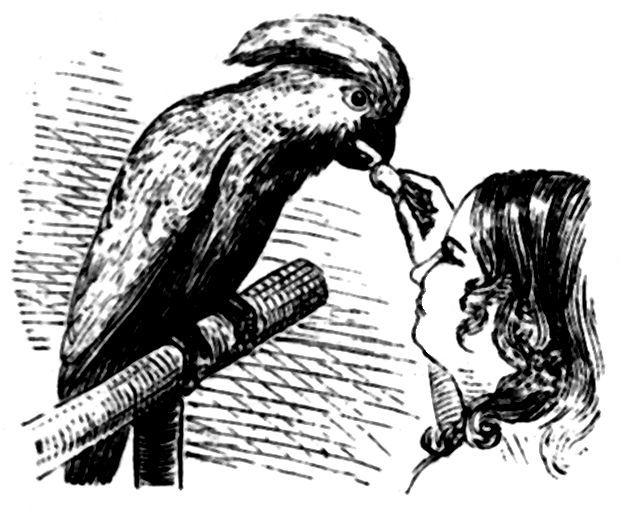
Toucans. These birds are all distinguished by their enormous bills, which are convex above, and much hooked towards the point; although very light, they are of great strength, and, being toothed at the edges, they are formidable instruments of destruction, when used, as they sometimes are, in attacking other birds, which the Toucans chase from their nests, in order to get at the eggs and young, which they devour in sight of the unhappy parents. During the season of incubation they are said to live chiefly on this kind of food, although at other times they eat fruits, insects, and the tender buds of plants. The Toucans are found chiefly in the warmer regions of America, where they go in little flocks of from six to ten; although heavy flyers, they reach the top of the highest trees, where they are fond of perching. They make their nests in the hollows of trees. The female lays but two eggs, like other Parrots. The young are easily reared and tamed; they will eat almost anything; their mode of eating solid food is very peculiar. When the morsel is presented, they take it on the point of the bill, throw it upward, and then catch it in the open mouth so dexterously that it goes at once into the aperture of the gullet, and is then swallowed without difficulty. The Toucans are so sensible to cold that they dread the night air, even in tropical countries; it is therefore necessary to keep them in a warm temperature. Their tongues are more hard and inflexible than those of other Parrots; consequently they do not shine as speakers—their utterance is usually confined to a kind of croak.
Parrots. We now come to the Parrot proper, forming what is called the typical group, or Psitticina, of the great Parrot family. In this group are included all the short and even-tinted species which are found distributed throughout all parts of the globe, but chiefly in the tropical countries, and especially those of America. Their general form may be described as rather strong and compact than elegant. The colours of their plumage are not so varied and brilliant as those of the Macaws and Lories, although some of the Parakeets, which are usually classed with them, may vie in this respect with the most superb of the tribe. But the true Parrots are chiefly valued on account of their aptitude for imitation and extraordinary power of articulating words and sentences, in which art they are the greatest proficients of any.
Parakeets. The term Parakeet, or, as it is sometimes spelled, Paroquet, is a kind of diminutive of Parrot, and is usually applied to the smaller species of those beautiful and interesting birds of which we are now treating; as a distinctive term, however, it is of little value, as some species which are called Parrots are of smaller size than others known as Parakeets. As a general rule, it may be understood that those known by the latter name are not only the smaller, but also the more slender and elegantly-proportioned birds, with long pointed tails; several of them are distinguished by rings round the necks, and these are mostly Asiatic and African species. The Parrots commonly—indeed, all the true Parrots—are stout, heavy birds, with short and even, or slightly rounded tails.
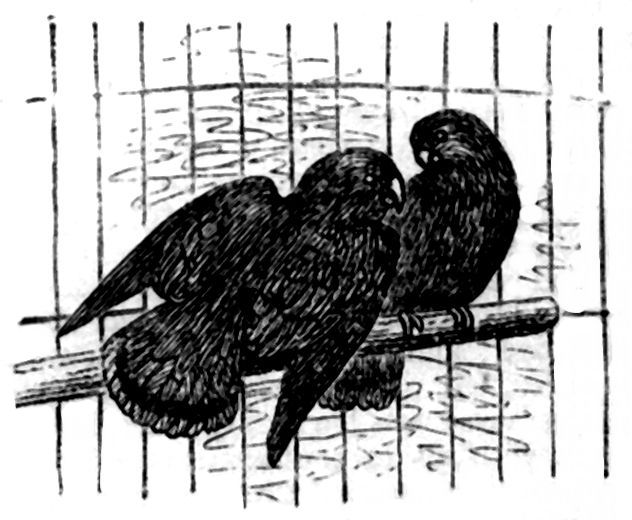
Lories. The name “Lory,” is, like “Cockatoo,” derived from the call-note of some of the species of birds to which it is applied. These are among the most gorgeous of the Parrot family; they are all natives of the East, and are, generally speaking, more delicate in their nature than the Macaws, Cockatoos, &c. Hence it is, that, although plentiful in their native climes, they are by no means common here, most attempts to bring them alive to Europe being failures. It will, therefore, be understood, that much care is necessary to their preservation when in confinement. In this group of birds the tongue is not so thick and fleshy as in other Parrots, and the tip, instead of being smooth and soft, is rough and horny, being thus better adapted for extracting the nectar of flowers, and sucking the juices of soft fruits, on which they chiefly feed in a wild state; the bill, too, is more weak and slender in its proportions. There are other structural differences, into which we need not here enter.
Food. Bread and milk should form the chief diet for these birds, and this is how it should be prepared:—take best white bread, moderately new, cut it into slices and place it in hot water: let it stand for a short time, then drain off the liquid, and pour over it as much boiling milk as it will absorb without being too moist; place this food in the feeding vessel, which should be of porcelain, or glass; and give it fresh twice a-day, taking care that the vessel is carefully washed each time before the food is put in. In the winter time a supply for the whole day may be made, but in hot weather it should not be more than ten or twelve hours old. This kind of soft food should not be exclusively employed, but have occasional variations in the shape of biscuit, broken small farinaceous grain, and nuts of any kind, fruit both soft and hard; if Indian corn is given, it should be first boiled, then drained dry, and suffered to cool: this is for the larger kinds of Parrots; to the smaller give, besides bread and milk, soft fruit, with hemp and canary seed, and millet. A cayenne pepper-pod, chopped small, is good occasionally for all kinds: but meat should be avoided; and so should pastry and sweets generally. It is a mistaken kindness to feed feathered pets too highly; the digestive organs of birds in confinement never have fair play, for want of that exercise which, in a wild state, they would take: therefore, let them have easily digestive food; do not overload their stomachs, and so engender diseases which will render their lives miserable, if they do not bring them to an untimely end.
Water.—Let them have plenty of this, both to drink and bathe in, and be sure that it is at all times clean and sweet.
Lodging. We need not say much upon this head; everybody knows what a Parrot requires—a good roomy cage, if he be kept in one (the bell-shape is the best), made of metal wire, not painted; a loose ring to swing on above, and a perch or two below, with proper eating and drinking vessels, not of zinc or pewter, but, as we said before, of glass or porcelain. Sprinkle the bottom with coarse sand, and in warm weather clean out every day; in cold, twice a week or so will do, or even once. Bear in mind that Parrots are mostly tropical birds, and carefully guard them from exposure to cold. Let them have as much sunshine as possible, and whenever the weather will permit, place them in the open air amid flowering shrubs: at other times, where a greenhouse is available, let them go there. An aviary with myrtles and other odoriferous plants about it, and the temperature well up, will make them think they are in their native spice isles of the Eastern Seas. For the larger kinds of Parrots, Macaws, and Cockatoos, the open perch is the thing; let the chain of attachment be of a good length, and as slight as is consistent with strength: no silken cord will do, for the strong mandibles of the bird will soon sever this, be it ever so thick; tin vessels for food and drink may be affixed to the perch; but take care that they do not get rusty and corroded.
Teaching and Training. Be patient, be gentle,—and if the pupil can learn, he will; repeat the lesson frequently, and give rewards for diligence and attention (some choice morsel), but never threaten or punish—no good is effected by this, but much harm. Never let your bird be teased or trifled with—many a good temper has been spoiled by such means—many a fond, affectionate creature rendered spiteful and morose. Think of the deprivations to which the poor captive is subjected for the pleasure of its possessor; of what he would enjoy if he were at liberty in his own home, of warm sunshine and luxuriant vegetation; and do all you can to make his prison-life pleasant and agreeable to him.
REGISTRATION OF BIRTHS. The Act requires that the father or mother of every child born in England (or in case of the death, illness, absence or inability of the father and mother, the occupier of the house in which they reside), shall, within forty-two days next after the day of such birth, give information to the registrar of the parish where the child was born, without the payment of any fee, providing it is done within forty-two days; but if neglected after that period, it can be registered within six months of the birth, by the payment of 7s. 6d.: after six months, it cannot be registered at all.
MEDALLION WAFERS. Colour the best and most transparent glue or gelatine with Brazil wood, tumeric, Prussian blue, sap green, or other colour. Fill up the hollow part of a seal with gum water, mixed with a powder, such as white-lead, red-lead, chrome yellow, lamp-black, &c. Leave the flat part of the seal clear; then pour as much of the melted coloured glue on the seal as will lie upon it; let it dry by a gentle heat. When used, wet the paper to which the wafer is to be applied, and place the wafer upon it.
DRAWING. The principle of light, shadow, and reflection, for solid objects, may be studied by a very simple process. Select a white globe,—a billiard-ball will answer the purpose,—place it in a room in which there is one window; then turn it in different lights, and it will be observed that there is only one part of it which can be represented perfectly white, the other rays falling obliquely upon a receding surface, it falls at last into perfect shadow, and is only relieved by the reflection of surrounding objects on the opposite side. An oval may be represented by an egg, a cone by rolling up paper in the form of an extinguisher. It is by these simple models that the pupil can readily study all the general principles of shadowing. The same principles of light and shade is applicable to each study of the art; simplicity is one of the leading characteristics of beauty in every object for the study of a young artist.
TRACING-PAPER. This is made of the refuse of the flax-mills, and being formed into a semi-transparent stuff, yields a transparent paper. The same material is used for the paper of bank-notes; but for this latter purpose it is bleached with chlorinated lime.
BRITAIN. The etymology of this word is the country of tin; as there were great quantities of lead and tin found on the adjacent islands. The Greeks called it Albion, which signifies, in the Phœnician tongue, either white or high mountains, from the whiteness of its shores, or the high rocks on the western coast.
OTTOMAN EMPIRE (THE). The total number of square miles belonging to this empire is 904,233, which is made up as follows—European Turkey contains 180,074 square miles; Asiatic Turkey, 447,679; and the African dominions, 276,480. Population is estimated at 24,690,000; of this number European Turkey has 9,700,000; Asiatic Turkey, 12,500,000, and Egypt 2,490,000.
SAFFRON. Saffron is produced in Sicily, France, and Spain, as well as in England. The Spanish is generally deteriorated by having been dipped in oil, to ensure its keeping. The Sicilian and French are better, but the English is superior to all. It is, however sometimes adulterated with the petals of the Carthamus tinctorius, or with the common marigold, calendula officinalis; this may be detected by infusing the cake in hot water, when the expanded stigmas will be easily distinguished from the petals of the other flowers.
TURNPIKES. Turnpikes were so called from poles or bars swung on a staple, which allowed them to turn any way when the dues were paid. A turnpike-road by law is twenty yards wide.
SCENT JAR (RECEIPT FOR A). Gum benjamin, storax, sweet orris, nutmeg and cloves, of each one ounce, all bruised in a mortar; throw in a handful of baysalt (at the bottom of a large jar), mixed with some of the spices; then lay in flowers, and upon every layer of flowers or herbs a handful of baysalt and the rest of the spices. No more spices need be added to the jar, but fresh salt as long as you put in fresh flowers; and as the flowers blow at different times of the year, you must collect them as they appear to have attained perfection, pick them clean from their stalks, and cut the herbs. The best for a jar are violets, roses, geranium flowers and leaves, sweet-scented verbena or lemon-plant, sweet-brier, thyme, lavender flowers, rosemary, clove-pinks, sweet-marjoram; keep it close shut for three months, and on opening it will require to be well stirred up with a small wooden spoon or a stick, and will be found to possess a delightful odour.
GORDIAN KNOT. This was a knot made by Gordian, in one of the cords of his yoke, or, as some have it, in the leathers of his chariot harness, which was so very intricately twisted, that it was impossible to discover where it began or ended. The oracle of Apollo having declared, that whosoever should untie the knot should be master of all Asia, many attempted it, but without success, till at last Alexander the Great, after attempting in vain to untie it, cut it asunder with his sword, and thus either eluded or fulfilled, the prediction.
ELECTRICITY AND MAGNETISM. The word electricity is derived from the Greek electron, which signifies “amber.” This name was given from the circumstance that the discoverer of electricity, Thales, of Miletus, found it to arise from the friction of amber. Magnetism comes from the Latin word magnes, which means “the loadstone,” or stone that attracts iron.
PLANTS (NOURISHMENT OF). Plants are not so much nourished by their roots as many persons suppose; indeed, many plants are rootless. The leaves, and the soft green covering of the stem, perform a much more important part in supplying the plant with food. Plants grow by the absorption of water and the fixation of carbon—of carbon and water plants are almost entirely composed; and unless these two substances are supplied, the plant will die. The leaves are the principal agents in the absorption and decomposition of carbonic acid and the retention of carbon, as a very simple experiment will prove. Gather a sprig of any succulent plant, and keep it in a dark place, while you prepare the materials for your experiment. Fill a tumbler glass three parts full of clear water, and with a clean tobacco-pipe breathe carbonic acid gas through it for four or five minutes at least; then fill up the glass carefully, without wetting the edges, and drop in the sprig you have gathered. The glass should be so full as to make the water stand a little above the edges.
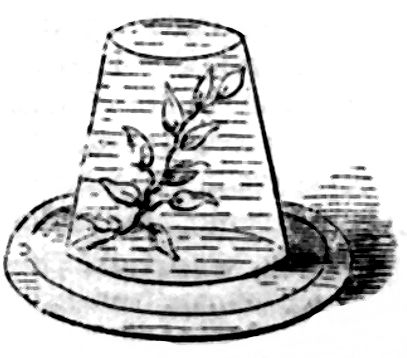
A flat piece of writing paper having been laid upon the top, and a flat plate above that, the whole should be turned upside down, as in the figure. If you now place your apparatus in the sunshine, you will see small bubbles form upon the leaves of the sprig, and rise to the upper part of the inside of the tumbler; this is pure oxygen gas. The carbonic acid, which the water absorbed, is undergoing decomposition; that is, the materials, oxygen and carbon, of which it is composed, are being separated or de-composed; the oxygen is set free, and the sprig having used the carbon would be found to be exactly so much heavier, in proportion to the oxygen set at liberty. This operation requires light, and in a natural condition only goes on during the day. This should be borne in mind with regard to flowers in sick rooms; in the day their presence has a purifying effect, but at night this ceases. Besides this chemical change, the leaves of plants take an active part in the function of perspiration while exposed to sunshine. The similarity between this function in plants and animals is singular. The quantity of water thrown out by plants may be proved by the simple experiment of placing a tumbler inverted upon the grass-plot on a fine sunny day. The sides of the glass will presently be covered with the condensed vapour of water, then drops will form, and presently run down in little streams. This fluid has, in most cases, been derived from the root. The nutritious fluid of the plant, like the blood of animals, needs exposure to the air before it is fit to take a place in the organized tissue of the body, and this contact with air is brought about in the leaf, the anatomy of which I will now endeavour to make plain to you.
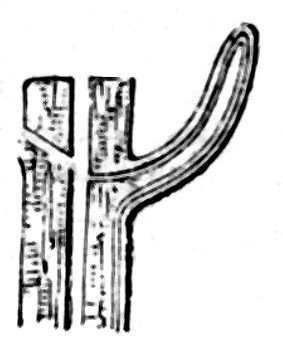
If you split a stem down carefully, exactly at the point where a leaf is attached, you will be able in many instances without a magnifying glass to detect that the stalk of the leaf is connected with the central pith or medulla. A leaf is composed of four layers of tissue, or two layers folded upon themselves, as these pieces of paper are folded.
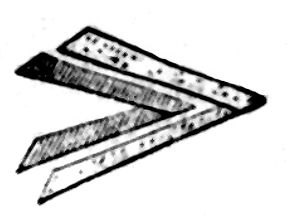
The outside represents the skin, or cuticle, of the stem, which is continued from the stem first along the upper surface, then turned over the edge, and so along the under surface to the stem again. This skin is colourless, or nearly so; and like our own, filled with pores.
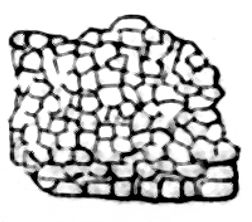
Viewed beneath a powerful magnifying glass, it is found to be composed of very small bags, or cells, pressed very closely together: hence it is said to be composed of cellular tissue. Our own bodies are chiefly composed of this tissue, and all growth is effected by means of the addition of these little cells. The skin, or cuticle of the leaf, is composed of compressed, or condensed, cellular tissue. Beneath it run the vessels which bring the sap up from the root, which, coming from the medulla, or pith, pass first over the upper surface of the leaf, and then, having been turned under towards the stem, deposit the new wood within the bark. Here we find, under the microscope, beautiful vessels with twisted or spiral fibres within them.
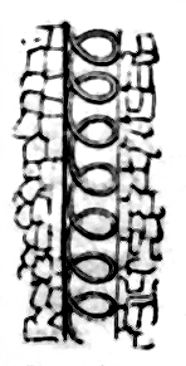
These tubes are called spiral vessels, and are the agents in bringing about that wonderful change before spoken of. All the juices of plants are the same, till they pass along these vessels in the leaf, where they undergo a change. After having been exposed to light and air, in the myriads of vessels which run along the leaf, the juice, passing downwards on the outside of the stem, deposits woody fibre in its downward course. This is chiefly composed of the carbon of the air, which has been taken from the air by the leaves, which have really much more to do with the nourishment of most plants than their roots. Here is a strong bough in the hedge, round which a piece of woodbine has been tightly bound, and which will illustrate this matter.
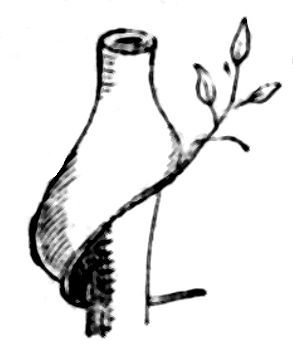
The stem is swelled above the woodbine, not below, proving that the growth of the tree takes place from above downwards. You may prove this also by a simple experiment, in which a piece of strong string may be substituted for the woodbine:—If round the stem of some rapidly-growing young tree you tie a piece of string, you will find, in a short time, that the fibres sent down from the leaves and buds will swell the stem above the ligature, while the portion of the stem below where you have tied the string will not have increased in size. Never, therefore, pluck the leaves from plants, with the idea that they have got more than their roots can nourish; for, on the contrary, the leaves are the support of the plant. The beautiful green colour of leaves depends upon the decomposition of carbonic acid in its vessels, and what we are breathing out of our lungs to-day will probably be incorporated with the tissues of a beautiful plant to-morrow; perhaps with some blade of grass; on that grass the cow will feed, and again appropriate the carbon, by absorbing it into its circulation, and forming the butter of milk; and of that butter, whose chief component part you breathed out from your lungs a week before, you may eat, digest, and again breathe out into the atmosphere. Such are the wonderful journeys of a particle of carbon.
DUKE. The highest rank of a British subject, with the title of lord, duke, and grace.
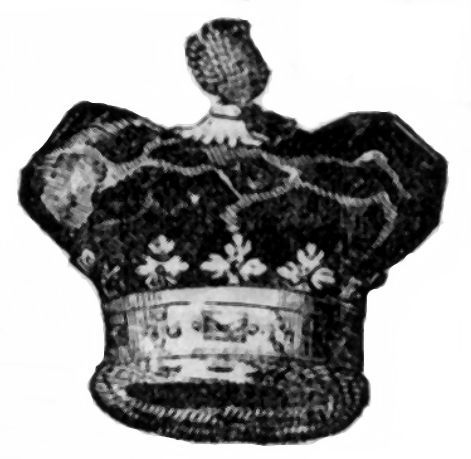
TRANSPLANTER (THE). This useful implement is perfectly cylindrical, open at both ends; about twelve inches in length, and six in diameter; made of the best tin plate, and furnished with two strong perpendicular iron handles, a a. It is first applied to the plant requiring to be taken from the bed, by being forced into the soil its full depth, and drawn up with the plant and surrounding earth enclosed in its iron grasp.
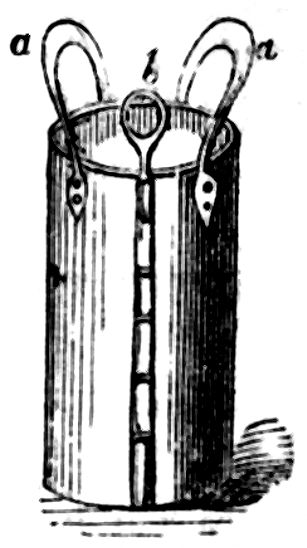
A hole being thus made in the bed for the reception of a better plant, the latter is lifted from the reserve bed in the same manner, and with the transplanter is inserted in the hole previously occupied by its less beautiful predecessor. It will be seen by the figure, that one side of the transplanter is held together by the pin b; now, when the flower is placed in its proper position, and this pin drawn out, the edges of the tube spring open a little, and allow the instrument to be withdrawn from the soil without disturbing the plant. Some, who do not use a transplanter, cut a flower from the reserve bed, and insert the end of its stalk in a phial of water, sunk out of ordinary vision in the grand bed; these cut flowers will keep in bloom several days, and can be renewed when requisite.
AQUARIUS. The form which Aquarius, or the Water-carrier, takes in the heavens, is best illustrated by the annexed diagram. It belongs to the month of January, and is believed to refer to the showery character of that month, from its being a derivative of the Latin word aqua, signifying water. However this may be, we have no reason to believe that the name assigned to it as a constellation symbolizes any benefactor of our species or any one who has signalised himself amongst mankind by the exertion of uncommon qualities. At least, on this point, the ages of the past have transmitted to us no light whatever.
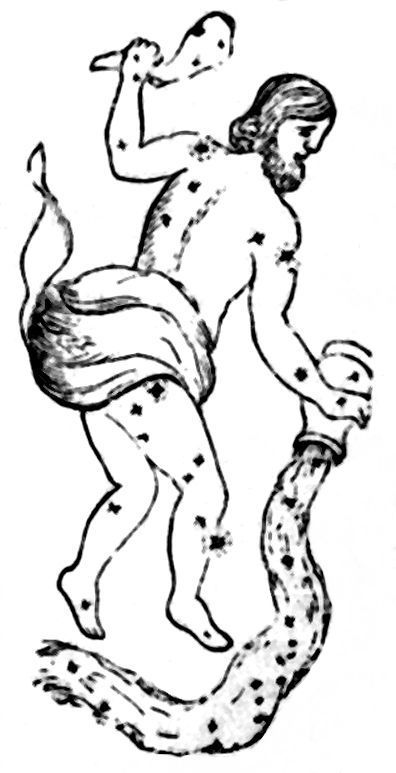
STEREOTYPING. The first idea of casting in metal plates emanated from one William Ged, a printer, of Edinburgh, in 1725. About fifty years afterwards it was revived by Tilloch; and was subsequently adopted by the celebrated Didot of Paris, and ultimately brought to perfection by Earl Stanhope. The convenience of this method is very great, as a reprint of a book can take place at any time, and any required number of copies, however small, can be taken off; and the expense of recomposition is thus saved.
PRINTS (TO TRANSFER TO WOOD). First varnish the wood once with white hard varnish, which facilitates the transferring; then cut off the margins of the print, which should be on unsized paper; that is, paper that absorbs like blotting-paper—and wet the back of it with a sponge and water, using enough water to saturate the paper, but not so as to be watery on the printed side. Then, with a flat camel-hair brush, give it a coat of transfer (spirits of wine) varnish on the printed side, and apply it immediately, varnished side downwards, on the wood-work, placing a sheet of paper on it and pressing it down with the hand till every part adheres. Then, gently rub away the back of the print with the fingers, till nothing but a thin pulp remains. It may require being wetted again, before all that will come (or rather ought to come) off is removed. Great care is required in this operation, that the design or printed side be not disturbed. When this is done, and quite dry, give the work a coat of white hard varnish, and it will appear as if printed on the wood.
HERMETIC SEALING. We cannot better explain this process than by showing how finely-divided lead may be got into a glass tube closed at both ends. This seems no easy matter at first glance, but it becomes easy, just as all other things come easy, when we know the way. We will suppose our readers universally to be well aware that the apple got into the dumpling when the crust was soft dough; which fact being known, they may easily comprehend how lead or anything else may be got into a crust of glass, provided only the glass can be reduced to a state of doughy consistence—a condition most easily effected by means of heat. To proceed, then, with our experiment. Procure some goulard-extract, and throw into it some tartaric acid, dissolved in water, until nothing more falls down, or, to use a chemical term, until all is precipitated. That which falls is tartrate of lead. Collect it on a filter of blotting-paper, and set it in a warm place to dry. Whilst it is drying, proceed as follows: Procure a piece of English flint glass tube (which is the sort that most readily melts), somewhat of this diameter and thickness.
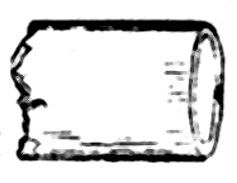
A thicker piece, or a tube of larger bore, a beginner in chemistry could not manage to work. Let the piece be about eight inches long. Next light the spirit lamp, having trimmed the wick in such a manner as to yield a good flame. Hold the tube in the flame and near its point, somewhat about three inches from one end of the tube.
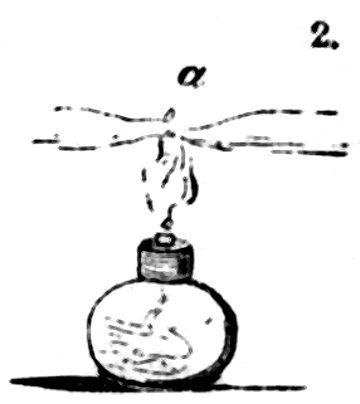
Whilst the tube is thus exposed to the heat, never allow it to rest for an instant, but keep revolving it, pulling at the same time. Very soon the tube will assume this appearance, which, when observed, the two pieces of the tube, 1 and 2 respectively, being twisted in reverse directions, and a final pull being given, No. 2 will separate like this—

That is to say, closed at one end, open at the other. Allow it to cool. When cold, put in the tartrate of lead (provided it be quite dry), and when in, carefully draw out the tube like this—

that is to say, permitting a very fine tube at the point (a). Next apply the spirit lamp flame to the tartrate as long as any smoke escapes, by which means the tartrate of lead is what chemists term decomposed, every portion of it except lead and charcoal resulting from the operation being evolved in the gaseous form. When this point is arrived at (known by the cessation of smoke), re-melt the fine tube at (a) and separate the two pieces of tube with a twist. The lead in a very fine state of subdivision, and intimately mixed with charcoal, will be now what is called hermetically sealed into the glass tube, and may be caused to inflame at pleasure by breaking off one end of the closed tube, and shaking it into the air.
ELGIN MARBLES. These precious relics of ancient art were named after Thomas, Earl of Elgin, who brought them from Athens, with incredible pains and toil, to England, when they were purchased by the Government, and deposited in the British Museum. These sculptures were imagined and directed by Phidias, and executed in part by his chisel.
THE POUND STERLING. So far as record goes, this term was first established by William the Conqueror. It then applied to a pound weight of fine silver, which was divided into 20 shillings and 240 pence; silver pieces, representing the latter denomination, and called pennies, were the only coin issued by that monarch and his successors for several years. Although the quantity of fine silver in these was progressively lessened, still they represented the same proportion of the pound sterling, which continued the term by which the value of all exchangeable property in the kingdom was regulated. Groats, or pieces equal to four pennies, were next coined; and at last shillings, or pieces equal to twelve pennies, were issued to pass for one-twentieth of the pound sterling. This these coins have continued to do, although the quantity of fine silver in them was gradually diminished until it became less than one-third of what was originally fixed. The proportion of fine silver equivalent to a penny has in consequence become so small that these coins have long been withdrawn from circulation, and their place supplied with copper pence.
ELECTION RIBBONS. It is said these badges took their rise from a Parliament held at Oxford in the beginning of 1681, on which occasion the representatives of the city of London assembled at Guildhall for the purpose of commencing their journey. Many of the citizens met them there, intending to accompany them part of their way, together with others who were deputed to go to Oxford as a sort of council to the city members. “Some of our ingenious London weavers,” says Smith’s “Protestant Intelligence,” “had against this day contrived a very fine fancy; that is, a blue satin ribbon, having these words plainly and legibly wrought upon it, ‘No Popery; No Slavery,’ which being tied up in knots, were worn in the hats of the horsemen who accompanied our members.”
COATS OF ARMS. Harry, surnamed the Fowler, Emperor of the West, who regulated the tournaments in Germany, was the first who introduced those marks of honour, armouries, or coats of arms. Before that time we find nothing upon ancient tombs but crosses, with gothic inscriptions, and decorations of persons entombed. The time of Clement IV. who died a.d. 1268, is the first whereon we find any arms; nor do they appear struck upon any coins before the year 1336. Camden refers the origin of hereditary arms in England to the time of the first Norman kings. Chronology says, coats of arms and heraldry were introduced in 1100, and that the arms of England and France were first quartered by Edward III. 1358.
GLACIERS. The ice of glaciers is entirely different from that of sea and river water, and is not formed in layers, but consists of little grains of congealed snow; hence though perfectly clear, and often smooth on the surface, it is not transparent. As glaciers in some positions, and in hot summers, decrease, they often also increase for a number of years, so as to render a valley uninhabitable. Their increase is caused partly by alternately thawing and freezing, their decrease by the mountain rivers, which often flow under them and thus form an arch of ice over the torrent. In the Tyrol, Switzerland, Piedmont, and Savoy, the glaciers are so numerous, that they have been calculated to form altogether a superficial extent of 1484 square miles.
GIPSIES. This peculiar race of people first appeared in Germany about the year 1517, having quitted Egypt when attacked by the Turks. They are the descendants of a great body of Egyptians, who revolted from the Turkish yoke, and being defeated, dispersed in small parties all over the world; while their supposed skill in the black art gave them a universal reception in that age of credulity and superstition. Although expelled from France in 1560, and from most countries soon after, they are yet found in every part of Europe as well as in Asia and Africa. Having recovered their footing, they have contrived to maintain it to this day. In England an act was made against their itinerancy in 1530; and in the reign of Charles I. thirteen persons were executed at one assize for having associated with gipsies for about a month, contrary to the statute. There were in Spain alone, previously to the year 1800, more than 120,000 gipsies, and many communities of them yet exist in England; and notwithstanding their intercourse with other nations, they are still, like the Jews, in their manners, customs, visage, and appearance wholly unchanged.
GLOW-WORM. It is said that the male glow-worm emits, in a slight degree, a phosphorescent light,—but it is chiefly the female from which the brilliant light proceeds, and which we so often see on banks, beneath hedges, and in various other situations. The light comes from the under part of the abdomen. It appears that the animal has the power of varying its intensity. Glow-worms will live a long time in vacuo, and in different kinds of gases,—the nitrous acid muriatic and sulphureous gases excepted, for in these they soon expire.
COCOA NUT-TREE. Common in Asia and the warm parts of America, rising 50 feet, with leaves or branches often 14 or 15 feet long, and producing a shelly fruit, which hangs in clusters. The natives draw from the tree a very agreeable liquor; the leaves are wrought into sacks, hammocks, &c., and the filaments of the outer coat of the nut are made into cables.
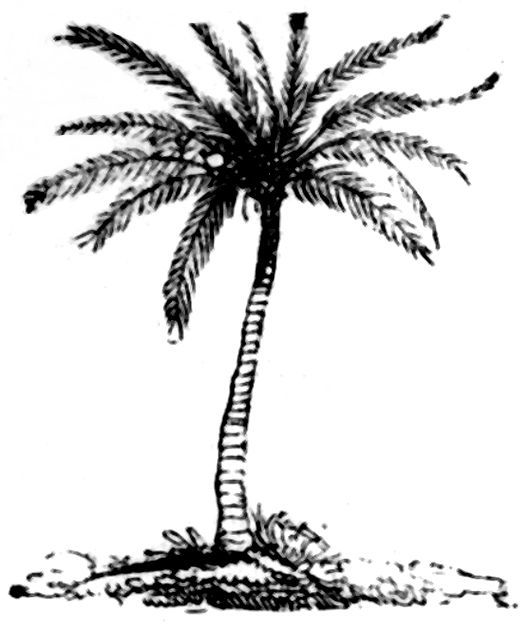
UTOPIA. This was the title of a work written by Sir Thomas More, describing an imaginary republic. The word has been adopted in the same sense to signify whatever is unreal or visionary.
PRACTICAL SCIENCE. 1.—Spirit Lamp (To Construct). Procure a wide-mouthed bottle, such as is shown in the accompanying figure (d), and fit the mouth with a good stout cork (b); now take out the cork and make a hole through the centre of it, by means of a red-hot wire, but be careful not to make it too large for the tube to be fitted to it.
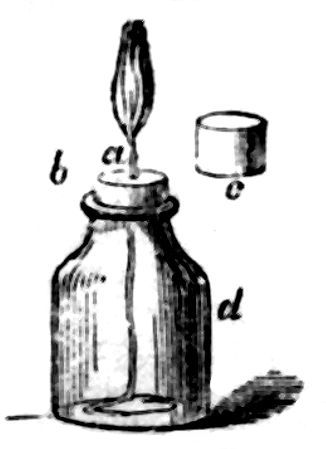
Cut off a piece of brass-tubing, one quarter of an inch in diameter, and of sufficient length to allow half an inch below the cork and three-quarters of an inch above it. Push the tube in (a) through the hole made in the cork by the red-hot wire, and be sure that it fits well. Pass a piece of cotton used for lamps through the tubing, and be sure that it is long enough to reach the bottom of the bottle. Fit a tin cap (c) to the cork so as to keep the spirit of wine or naphtha from evaporating, and your spirit lamp will be complete.
2.—Temporary Retort (To Make a). Procure a Florence flask, such as olive oil is usually sold in, and clean it out by washing the inside well, first with a strong solution of soda and small pieces of brown paper, and then with clean water; turn it up mouth downwards, and let it drain well. Fit the mouth with a sound cork and bore a hole in it with a red hot wire, as directed in section 1. This hole is intended to receive a bent tube, which we will now proceed to form.
3.—Bent Tubes for Chemical Experiments (To Construct). Take a piece of glass tubing one-third of an inch in diameter, and of the proper length—light your spirit lamp (section 1), and hold the tube diagonally in the flame, taking care to turn it round all the time, and to move it backwards and forwards, so as to heat about four inches of it in the part where it requires to be bent.
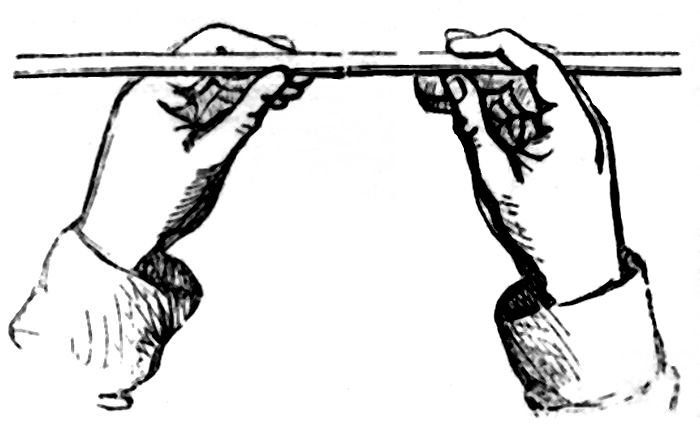
When the glass begins to get soft, place the two thumbs against the glass so as to form fulcra, as in the annexed figure, and bend it slowly backwards,—that is, towards your body, until it acquires the proper form. When the tube has been bent into the proper shape, heat each end of it in the flame of the spirit lamp for a minute, so as to round off the edges.
4.—Evaporating Dishes (To Make). Procure a Florence flask, clean it as directed in section 2, and be sure that it is thoroughly dry.
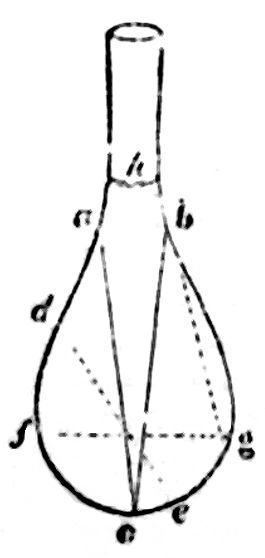
Take a triangular file, and slightly scratch the flask with the end of it, then run the point of a piece of heated wire in the required direction. Thus, if passed in the direction d e, or f g, in the annexed figure, you will have deep evaporating dishes; if in the directions a o and b o, you will have shallow ones with tips; if from b to g, you will have a very shallow one for evaporating small samples of fluid. Portions of a Florence flask will be quite as useful, or remnants of retorts, which may be cut into circular dishes by bending a piece of stout iron wire into the form given in the annexed diagram,

fitting it into a wooden handle, and then, making it hot, apply it suddenly to the portion of flask or retort, and then remove it. This will cause the glass to crack in a circular form (See Section 3).
5.—Funnel (To Make a). Scratch the flask in a line parallel to h (in the figure above), commencing at d, and proceed as directed for making evaporating dishes.
FORCES (THE RESOLUTION OF). The resolution of forces is the process by which we can find forces that will produce a motion equal to that of a single force; to illustrate which we refer you to the following diagram.
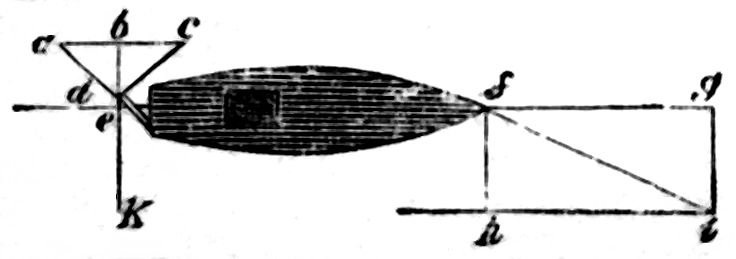
Let e f represent a boat, f i the rope by which it is drawn along, and also the force of draught. It may then be assumed that there are two forces acting, f g which draws the boat forward, and f h which would draw the head in the direction f h, were it not counteracted by the helm e d, which is parallel to the line f i. When the boat is moving, the resistance of the water acts upon the helm, which may be explained thus: If c a represents the resistance, it may be resolved into a d and e c. Now, as a d produces no effect upon the helm, it is evident that the pressure is in the line e c, which tends to turn the stern of the boat in the direction b e k, and thus counteracts the force of f h.
MARQUIS. A peer, in rank between an earl and a duke, and wearing a coronet on state occasions as beneath.
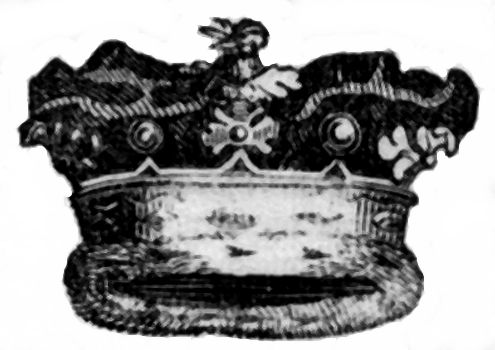
ALTIMETRY. The art of taking heights by means of a quadrant, and founded on the principle that the sides of triangles having equal angles are in exact proportion to one another. When the object is accessible, its height is considered as one of the sides of the triangle; but when it is inaccessible, then two observations are made in a right line, and the distance measured between them is the basis of the calculation.
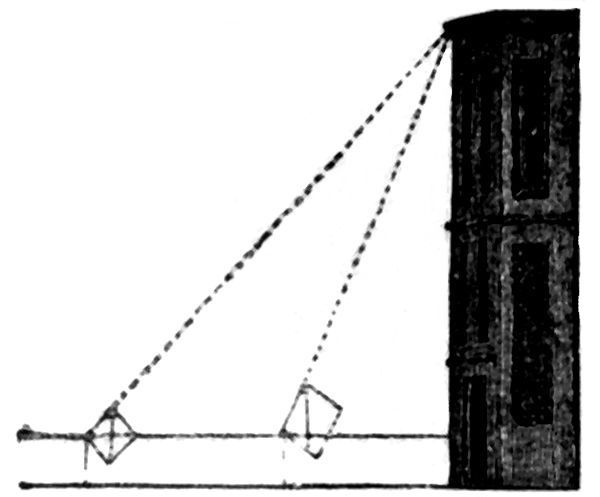
GREENWICH OBSERVATORY. The Royal Observatory at Greenwich was built in 1675. It may be seen by obtaining leave from the Lords of the Admiralty; but it must be obvious to any person that it is absolutely necessary to prohibit idlers lounging about this establishment at all times. The instruments are first-rate; but the building is badly contrived for the purposes to which it is applied.
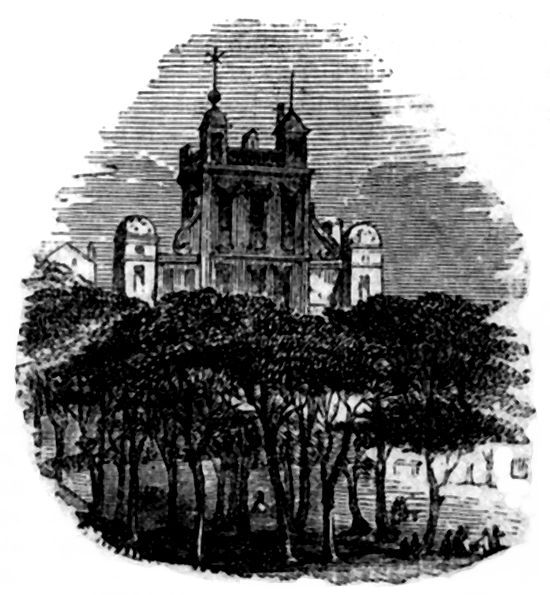
The salaries of the various officers at Greenwich Observatory are as follow:—the Astronomer Royal, £800 per annum; the first Assistant to ditto, £400; the second Assistant, £250; the third Assistant, £200; fourth, sixth, and seventh Assistants, each £100; and the fifth Assistant £120. The apparatus in use for denoting the exact time at which a heavenly body crosses the wire of the telescope consists of a cylinder, in circumference about three feet, and over which a covering of paper is to be placed. This cylinder will be made to revolve uniformly by means of a clock movement, governed by a centrifugal pendulum. The paper will travel a distance of about one-third of an inch in a second of time, but of course it can be made to travel a greater or less distance if desired. A pricker or marker, to be actuated by means of electricity, will be placed immediately over this paper. Wire will extend from this marker, and terminate in a key by the side of the observer at the telescope. On pressing down this key a mark will be made on the paper on the revolving cylinder, in the same way as marks are made by Morse’s telegraph. At the instant that the observer notices that a heavenly body is crossing one of the wires in his telescope, he will touch the key, and thus cause a mark to be made on the moving paper. Each second of time will, by clock-work mechanism, be also marked by dots upon the same piece of paper, so that, by measuring the distance of the dot made by the observer from the nearest second dot made by the clock-work, the exact instant of time at which the observer’s mark was made will be ascertained. By this means the observer will be enabled to record the exact period at which such heavenly body crosses the respective wires of his telescope, and that with a degree of nicety which can be measured to the fractional part of a second of time. Without such apparatus it would be almost impossible to denote the time of an observation to a degree much less than that of a whole second of time, but by its means it will be perfectly easy to ascertain the exact instant, even to the one-hundredth or one-thousandth part of a second.
SUNBEAMS. The sunbeam is composed of three distinct and separate rays, one of heat, one of light, and one called the chemical ray. These three agencies exist in different proportions in the sunbeam, in the spring, summer, and autumn. The blue or chemical ray is greater in the spring; the light greater in the summer. The chemical ray is less in autumn, and then the heating ray predominates. The proportion of these rays varies in different seasons of the year, in order that the growing plant may arrive at maturity. It has also been ascertained that the proportions of these agents vary in different climates.
FUR CLOTHING. It is very ancient. The method of manufacturing wool into articles of clothing seems to have been early transplanted into Greece, and thence to Italy, as we find the use of raw skins accounted by each of these nations a sign of barbarism. It appears that neither of them in the time of their prosperity, when the arts and sciences were cultivated among them, made much use of fur clothing. It was worn at that period only on certain festivals (the Bacchæ clothed themselves in fox-skins), and merely by the poorer classes and rustics; or employed in the time of war. The ancient physicians make no mention of furs; and Suetonius, in describing the winter clothing of Augustus, who was extremely sensible of cold, does not name any articles of fur. Pliny relates an unsuccessful attempt to manufacture the fur of the hare, which would scarcely have been made had the skin been used in its natural state. It is worthy of remark, that, in the 27th chapter of Ezekiel, where the merchandise of Tyre is so minutely described, no allusion is made to furs.
PIGEON LAW. The Act of Parliament 7th and 8th George IV., chap. 29, sec. 33, states that if any person shall unlawfully and wilfully kill, wound, or take any house-dove or pigeon, under such circumstances as shall not amount to larceny at common law, every such offender, being convicted thereof before a justice of the peace, shall forfeit and pay over and above the value of the bird any sum not exceeding two pounds. By the 67th section of the same Act, the magistrates may, in default of payment, commit for any term not exceeding two months.
MICROSCOPE AND MICROMETER. The size of objects is expressed usually in parts of an inch, as one-fifteenth, one-hundredth, or one-thousandth part of an inch. In order to ascertain this actual size, various modes are employed. The most simple is to place on the stage of the microscope a piece of glass which has fine lines ruled on it, perhaps an hundredth part of an inch apart, and comparing these divisions with a rule seen by the naked eye. In this way we may learn how much the microscope magnifies. If we compare the apparent size of an object on the stage with the rule as before, and divide that apparent size by the magnifying power of the instrument, we shall learn exactly how large it is. The piece of glass with the fine lines ruled on it is called a micrometer, which means an instrument to measure small things, as the word microscope means an instrument to observe small things. If we find by the micrometer that the microscope magnifies two hundred and fifty times, and a small object at which we are looking appears an inch in diameter, we know that it really is but the two hundred and fiftieth part of an inch in diameter.
CATS’ WHISKERS (USE OF). The whiskers on a cat’s upper lip are very important. They are organs of touch. They are attached to a bed of close glands under the skin, and each of these long hairs is connected with the nerve of the lip. The slightest contact of these whiskers with any surrounding object is thus felt most distinctly by the animal, although the hairs of themselves are insensible. They stand out on each side of the lion as well as in the common cat, so that, from point to point, they are equal to the width of the animal’s body. If we imagine, therefore, a lion stealing through a covert of wood, in an imperfect light, we shall at once see the use of these long hairs. They indicate to him, through the nicest feeling, any obstacle which may present itself to the passage of his body; they prevent the rustle of boughs and leaves, which would give warning to his prey if he were to attempt to pass through too close a bush; and thus, in conjunction with the soft cushions of his feet, and the fur upon which he treads (the retractile claws never come in contact with the ground), they enable him to move towards his victim with a stillness even greater than that of the snake, which creeps along the grass, and is not perceived until he is coiled around his prey.
INSECTS’ WINGS (RATE AT WHICH THEY MOVE). The buzzing and humming noises produced by winged insects are not as you suppose vocal sound. They result from sonorous undulations imparted to the air by the flapping of their wings. This may be rendered evident by observing that the noise always ceases when the insect alights on any object. The sirene has been ingeniously applied for the purpose of ascertaining the rate at which the wings of such creatures flap. The instrument being brought into unison with the sound produced by the insect, indicates, as in the case of any other musical sound, the rate of vibration. In this way it has been ascertained that the wings of a gnat flap at the rate of 15,000 times per second. The pitch of the note produced by this insect in the act of flying is, therefore, more than two octaves above the highest note of a seven-octave pianoforte.
HACKNEY COACHES. They are of French origin. In France a strong kind of cob-horse was let out on hire for short journeys. These were latterly harnesses, to accommodate several wayfarers at once, to a plain vehicle called coche-à-haquenée; hence the name. The legend that traces their origin to Hackney, near London, is a vulgar error. They were first licensed in 1662, and subjected to regulations during the reign of William and Mary. Cabriolets are also of French origin. It was, however, the aristocratic taste of Englishmen that suggested the propriety of obliging the driver to be seated on the outside of the vehicle.
PASSION-FLOWER. It derives its name from the idea that all the instruments of Christ’s passion are represented in it. Most of the passion-flowers are natives of the hottest part of America. The rose-coloured passion-flower is a native of Virginia, and is the species which was first known in Europe. It has since been, in a great measure, superseded by the blue passion-flower, which is hardy enough to flower in the open air, and makes an elegant tapestry for an unsightly wall. The leaves of this, in the autumn, are of the most brilliant crimson; and, when the sun is shining upon them, they seem to transport one to the gardens of fairy-land.
THIMBLES. They are a Dutch invention. The art of making them was brought to England by John Lofting, a mechanic, from Holland, who set up a workshop at Islington, near London, and practised the manufacture with profit and success about 1695.
HIDAGE. Hidage was a royal aid or tribute, raised in such a proportion on every hide of land. William the Conqueror imposed a hidage of six shillings upon every hide; William Rufus, four shillings; and King Henry I., three shillings. When the lord paid hidage to the king, the tenants paid a proportion to the lord of the manor. When the Danes landed at Sandwich, King Ethelred raised the hidage, so that every 310 hides of land found an armed ship, and every eight hides found a “jack and saddle.” The hide of land, or plough-land, was as much as one plough could cultivate in a year—for the quantity was never expressly determined; some fix it at 60, others 80, and some again at 100 acres. One hide of land at Chesterton, in the fifteenth year of the reign of Henry II., contained 64 acres; and in the thirty-fifth of Henry III., the yearly value of a hide of land at Blechesdon, in Oxfordshire, was forty shillings. Bede calls it Familiam—implying by it that it was as much as would maintain a family. The distribution of England by hides of land is very ancient, as we find mention made of it in the laws of King Ina (cap. 14); and Henry I., to marry his daughter, had three shillings from every hide of land.
AIR-PUMP. A machine which operates on the air just as a common pump operates on water; and by means of which a considerable portion of the air under a glass receiver may be extracted, and a number of amusing and instructive experiments performed, by which the uses of atmospheric air are discovered, and many phenomena shown to arise from its action and reaction.
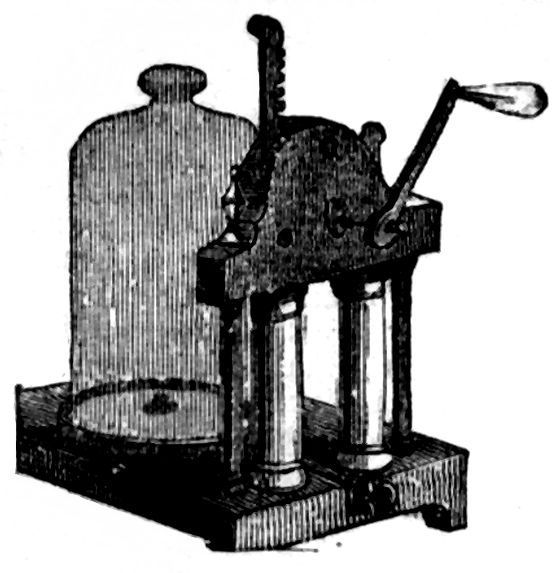
NUMERAL FIGURES. The learned, after many contests, have at length agreed that the numeral figures, 1 to 9, usually called Arabic, are of Indian origin. The numeral characters of the Bramins, the Persians, the Arabians, and other eastern nations, are similar. They appear afterwards to have been introduced into several European nations, by travellers who returned from the East.
MINIATURES (TO PREPARE IVORY FOR). Take the ivory leaves or tables on which the painting is to be made, and having cleansed them, rub them over with the juice of garlic. This takes off the greasiness which is so much complained of.
EARL. A title or nobility between a marquis and a viscount, authorised to wear and bear a coronet like that in the engraving.
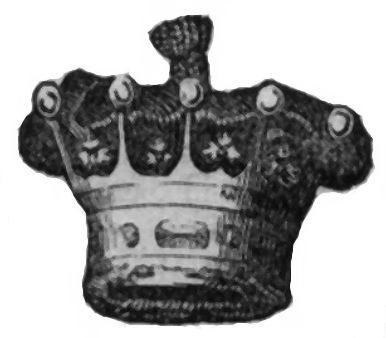
BEET-ROOT SUGAR. Marggraf, an eminent Prussian chemist, first drew the attention of the public to this subject, in 1747. He was successful in obtaining from the roots of the white and red beet a sugar nearly in the state of Muscovado, or raw cane sugar. Afterwards Chaptal, a celebrated French chemist, established a manufactory of beet-root sugar, and in 1826 there were twenty-five establishments in France.
BLUE STOCKING. The term blue stocking, applied to literary ladies, was conferred on a society which was called the Blue Stocking Club, in which females were admitted; and so called owing to a Mr. Benjamin Stillingfleet, one of its acting members, wearing blue stockings. We have seen an account, however, that ascribes the origin of the term to a beautiful lady of eminence who was a member of the club, but we believe the above is the correct origin.
CHAMPAGNE. Champagne contains least spirit, and contains more or less carbonic acid; the effect of which latter is to carry off quickly the effect of the spirit, and stimulate somewhat the system, without subsequent depression. It contains little mucilaginous matter, is essentially a thin wine, and therefore requires little digesting. As a gentle stimulus it is therefore preferable to all other wines; as a tonic, it ranks much lower than most of the others.
ALOES. A valuable and salutary medicine, distinguished by its pungent bitter flavour, and distilled from the leaves of the aloe-tree. That which grows in Socotora is used for the human constitution, and that which grows in Barbadoes is used for horses. In the East, the part of another species, called tambac, is a perfume highly valued. The American aloe is a plant which, when vigorous, rises upwards of twenty feet high, and branches out on every side, forming a kind of pyramid of greenish yellow flowers, erect, and in thick clusters at every joint.
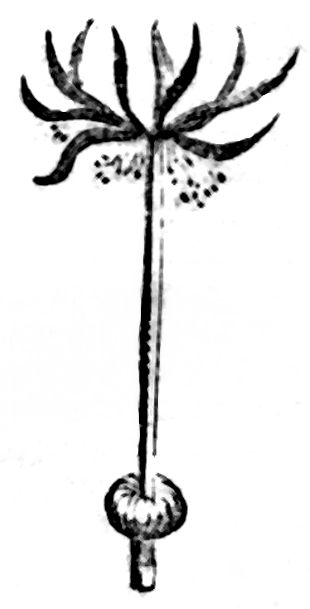
HORSE POWER. It is well known among engineers, that a horse is capable of raising a weight of about 150 lbs. 220 ft. high in a minute, and to continue exertions enabling him to do that for eight hours a day. Multiply the number of lbs. by the height to which they are raised in minute, 150 by 220, gives 33,000 lbs., and the power of a horse is generally expressed by a sum, varying from 30,000 lbs. to 36,000 lbs. raised one foot high in a minute. One horse can draw horizontally as much as seven men. In trains of machinery from one-fourth to one-third is allowed for friction in calculating its equivalent of horse power.
CAMOMILE. The dried flowers of the common camomile are sufficiently familiar to every one. They have stomachic and tonic properties, which render them very useful in dyspepsia and general debility. Camomile tea, as the infusion is generally called, is a most agreeable bitter, and is of almost universal use and acceptance. Taken warm it promotes the action of emetics. The flowers steeped in boiling water are frequently used as fomentations for abscesses and inflamed parts, to promote suppuration and relieve pain; flannels dipped in the hot decoction answer the same purpose.—Family Doctor.
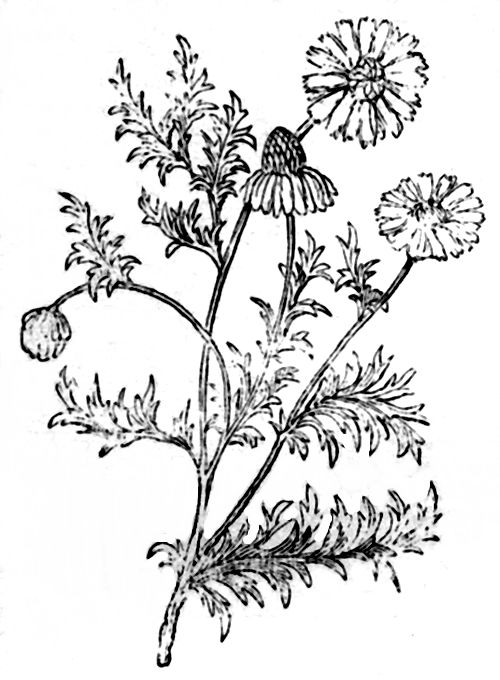
YEAR OF OUR LORD. The first sovereign who adopted this distinction was Charles III., Emperor of Germany, he adding “in the year of our Lord” to his reign a.d. 879. It was followed by the French kings, and afterwards by the English; and is the mode of designating the year from the birth of the Redeemer, in all Christian countries.
LIGHTS. At the religious assemblies of Christians, lights were first used, it is said, in order thereby to avoid the scandal of their meeting in the dark at night, during times of persecution. They were introduced into churches about the middle of the first century, and were continued afterwards in the Romish churches at noon-day. Lamps were in use previously to candles.
GOLD WIRE, LEAF, &c. Gold wire was first made in Italy, about a.d. 1350. An ounce of gold is sufficient to gild a silver wire above thirteen hundred miles in length; and such is its tenacity that a wire the one-eighteenth part of an inch thick will bear the weight of five hundred pounds without breaking. A single grain of gold may be extended into a leaf of fifty-six square inches, and gold leaf can be reduced to the 300,000th part of an inch, and gilding to the 10,000,000th part.
WEDDING-RING. The ring finger is the fourth one, or the finger next to the little one. In the ancient ritual of marriage, the ring was placed by the husband on the top of the thumb of the left hand while, repeating the words—“In the name of the Father;” he then removed it to the fourth finger, saying, “and of the Son;” then to the middle finger, adding, “and of the Holy Ghost;” and, finally, placed it on the fourth finger, with the closing word, “Amen.”
FRANKINCENSE. Frankincense, which was used in the worship of the true God, and on the altars of the heathen temples, was obtained from trees which grew in Arabia Felix. The incense trees grew only in that part of Arabia inhabited by the Sabæans; and so strict were their laws respecting them, that no persons were permitted even to see the trees, except those appointed to take care of them.
CHAINS. Links of iron formed within one another in different shapes, so as to produce the greatest strength of tension.
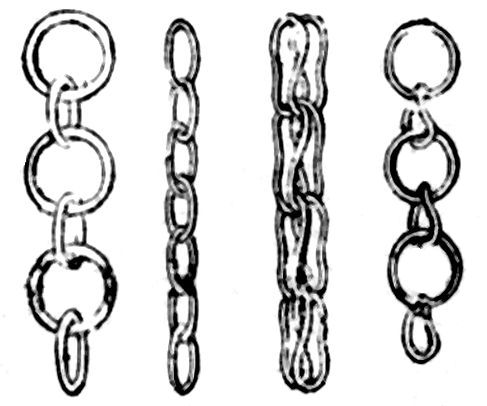
FLANNEL SHIRTS. Flannel has not been in general use until within the last sixty years. It was first used in Boston, as a dress next the skin, by Lord Percy’s regiment, which was encamped on the common, in October, 1774. There was hardly flannel enough then in the whole town for that one regiment. Some time after Lord Percy began with flannel shirting, Sir Benjamin Thompson (Count Rumford) published a pamphlet in America, assuming to have discovered the utility of this practice. He might, perhaps, have suggested the use of it to Lord Percy.
VENTILATION means the act of admitting air into any place, or of causing a draught or current of air to pass through it. When any one speaks of ventilating a room or building, it is understood to refer only to pure air. Unless we breathe pure air continually, our blood cannot be purified and invigorated; impure blood causes disease and death. The easiest and quickest way of ventilating ordinary rooms is to open the doors and windows, whereby the fresh air outside rushes through and purifies the place. But it is not always safe to ventilate in this way; for if a person is ill or heated it would be hurtful for him to feel a sudden rush of air from without; besides which, it is always more or less dangerous to sit in a draught. Unless in very warm weather, the door and window should only be opened now and then, and for a short time, and the persons in the room should take care to sit out of the draught. The best time for admitting air is in the morning, between eight and twelve, but earlier than this in dry sunshiny weather. People who have but one or two rooms to live in should make it a rule to ventilate their rooms thoroughly after every meal, because it is desirable to get rid of the smell of cooking as soon as possible. But the chief causes of impure air are the breath and perspiration of persons who live in the room, and the smoke and vapour of lamps and candles. Perspiration adds considerably to the impurity of apartments, for as it goes slowly away from the surface of the skin it mingles with the air and vitiates or spoils it. While in health, day or night, we are constantly perspiring. In hot weather, or after severe exertion, we can see it plainly; but besides this, there is an invisible or insensible perspiration; this perspiration spoils the air rapidly, but more rapidly in summer than in winter. If a man were sitting in a room which contained sixty feet of air, the insensible perspiration from his body would spoil the whole in ten minutes and render it unfit to be breathed a second time, if pure air were not admitted. But there are other methods of ventilating rooms besides those already described; a sheet of wire gauze or zinc pierced full of small holes may be put into the place of an upper pane in the window, so as to admit fresh air, or Arnot’s chimney-ventilator may be used. The latter is thus constructed: An opening of the size of one or two bricks is made from the room quite through the breast of the chimney, as near to the ceiling as possible; into this opening a metal frame is fitted, which has a balance-door that opens inwardly of itself, so that heated or foul air passes from the room through the opening, and goes away with the smoke of the chimney. Ventilators ought to be fixed at the top of a room, because it is the nature of warm or breathed air to rise; and they are therefore fixed in or near the ceiling, so that the air on its ascent may pass off without interruption. Ten feet of fresh air is required for each person every minute. One fact is certain—we cannot retain our health, nor have any enjoyment of life, unless we continually breath pure air.
UNION JACK. The etymology of the term Union Jack has never, it is presumed, been explained; for it does not occur in any lexicon or glossary. The word “union” obviously arose from the union of the three kingdoms in one great political power. As an alteration in the banner of St. George occurred in the reign of James I., it may, with great probability, be supposed to have been a corruption of the word “Jacques.” Such is the opinion of Sir Harris Nicholas, the eminent antiquary.
BOUQUETS. There are many ways of planting a flower-garden, and as many methods of arranging flowers in a large nosegay; but with the exception of wedding nosegays, which should always be made of the whitest flowers, the arrangement of the flowers may be reduced to three heads. First, to make choice of flowers all of one colour, or nearly so, and then using a small quantity of other flowers that will make a strong contrast with the ground-colour. Secondly, shading the flowers from the centre to the sides; and, thirdly, quartering the circle with four kinds of colours that harmonise well together, or with two colours in contrast—one quarter of the nosegay being of the same flowers as the quarter opposite to it—or, better still, the colours to be the same in each pair of quartering, but the flowers to be from two different kinds of plants. Thus, one quarter of some pea-flower of a given colour and the quarter opposite to it to be of pea-flowers also, but from a different plant. The size of the individual flowers to be as nearly alike as can be; then the other two quarters may be of composite flowers in the same way. This is the most difficult kind of nosegay to make well. When you have a choice and abundance of flowers, shading them is the easiest way; and when flowers are very scarce, the mixed nosegay is the safest to attempt; but it should never be without a ground-colour if artistic effect is at all attempted.
MATTER (DIVISIBILITY OF). It is scarcely credible, yet a slip of ivory, of an inch in length, may be divided into a hundred equal parts, each of which is distinctly visible, but by the application of a very fine screw, 5,000 equi-distant lines, in the space of a quarter of an inch, can be traced on a surface of steel, or glass, with the fine point of a diamond, producing delicate and varied colours, thereby proving that the beautiful hues of mother-of-pearl, peacock pearl, and the less delicate appearance of what are termed watered fabrics, are the effect of irregularity of surface, not, as might be supposed in the case of mother-of-pearl and peacock pearl, the result of variety of substance. A single pound of cotton has been spun into a thread seventy-six miles in length, and the same quantity of wool has been extended into a thread of ninety-five miles, the diameters of those threads being only the 350th and 400th parts of an inch.
TAMARINDS. This fruit is slightly nutritive, refrigerant, and gently laxative, and having an agreeable flavour will generally be eaten by children when they will not take other medicines. You need not be afraid to allow your children to partake of this fruit in moderation. The usual dose is from half an ounce to one ounce of the fruit; but a very pleasant drink, called tamarind whey, is made by boiling one ounce of tamarind pulp with a pint of milk, and then straining it. The common drink is made by dissolving one ounce of the pulp in a pint of warm water, allowing it to get cold, and then straining.
JACKDAWS. These birds may be easily tamed, and taught to say several words, or even sentences. They can be reared from the nest, and should be fed upon the crumbs of white bread soaked in cold water, and squeezed dry, and boiling milk added to it afterwards. Now and then you should give them a little raw meat chopped fine. The old birds will eat anything, and are very fond of picking a raw beef bone; they also enjoy a boiled potato. You should keep one wing cut for several months, and then pull out the feathers of the wing, so as to let others grow. If the bird you have is reared from the nest, there will not be any occasion to adopt this plan.
PEA (THE). The native country of the common pea is not known. France has been named with some probability, or it may have been brought to that country from Egypt or Syria. Neither do we know the exact period at which the common pea was first cultivated here, but most probably it was in the reign of Henry VIII., as Tusser names it as a dainty, and says it is “good for her purse and the pot.” Peas were still rare in the early part of Elizabeth’s reign, when Fuller observes they were seldom seen except those which were brought from Holland, which “were dainties for ladies;” but in the latter part of the same reign gardening made rapid progress in this country, and Gerard describes the runcival, the garden and field peas, the tufted or Scottish, the peas without skin in the pods, the wild pea and the everlasting pea.
CRESCENTS. The crescent was the symbol of the city of Byzantium, now Constantinople, which the Turks have adopted. This device of the Ottoman Empire is of great antiquity, as appears from several medals, and took its rise from an event related by Stephanus the Geographer, a native of Byzantium. He tells us that Philip, the father of Alexander the Great, meeting with mighty difficulties in carrying on the siege of that city, set the workmen in a very dark night to undermine the walls, that his troops might enter the place without being perceived; but luckily for the besieged, the moon appearing, discovered the design, which accordingly miscarried. “In acknowledgment of this deliverance,” says he, “the Byzantines erected a statue to Diana, and thus the crescent became their symbol.”
RAIN-WATER. Not only is rain-water the best for making tea, &c., but it is useful in culinary operations. The belief that it is unwholesome for this purpose is incorrect. The softer water is, the more adapted it is to all domestic uses, if we except that one which has been so much insisted on of late—its use as an habitual potation; even this is not an exception, so much on account of its unwholesomeness as its insipidity.
MASKS. Poppæa, the wife of Nero, is said to have invented the mask to guard her complexion from the sun. But theatrical masts were in use among the Greeks and Romans. Modern masks, muffs, fans, and false hair for women, were devised by the loose females of Italy, and brought to England from France in 1572.
THE DIVING-BELL. The oldest information we have respecting the use of the diving-bell in Europe is that of John Taisnier, quoted by Schott. The former, who was born at Hainault in 1509, had a place at court under Charles V., whom he attended on his voyage to Africa. He relates in what manner he saw at Toledo, in the presence of the emperor and several thousand spectators, two Greeks let themselves down under water, in a large inverted kettle, with a burning light, and rise up again without being wet. It appears that this art was then new to the emperor and the Spaniards, and that the Greeks were induced to make the experiment in order to prove the possibility of it.
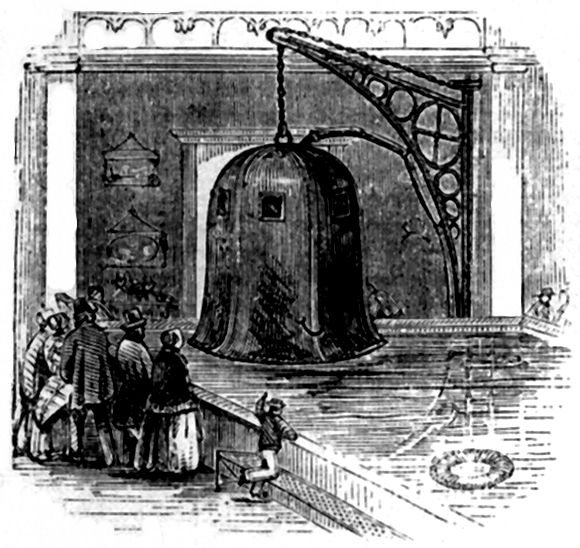
The principle of the diving-bell depends upon the impenetrability of atmospheric air, and may be explained by a very familiar experiment. Bring the edge of an inverted tumbler, or any close vessel, to the surface of water, and, keeping the mouth horizontal, press it down in the water. It will be seen that though some portion of the water ascends into the tumbler, the greater part of the space remains empty, or only filled with air; and any object placed in this space, though surrounded on all sides with water, would remain perfectly dry. In fact, the quantity of air remains the same, but it is compressed into a smaller volume, in proportion to the depth to which it is made to descend.
DILETTANTI. This is an Italian word, applied to an admirer or lover of the fine arts—one who delights in that pursuit. The word is almost synonymous with amateur, but does not imply so much practical knowledge.
DIAMOND BEETLE, (Curculio Imperialis). A most beautiful insect, decorated with golden, green, and black streaks. The abdomen is green, with silvery rings. This rich and curious insect forms a most splendid and dazzling object under the microscope.
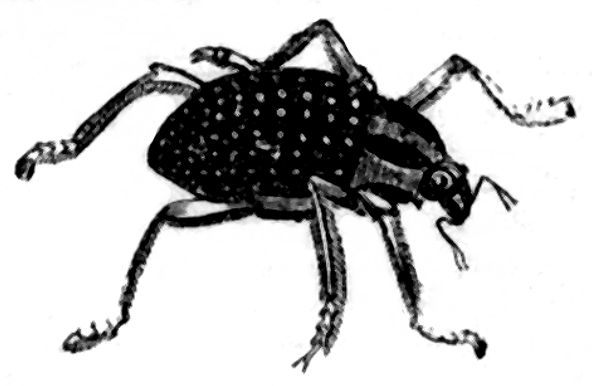
DIANA. In heathen mythology, the daughter of Jupiter and Latona, sister of Apollo, and goddess of hunting.
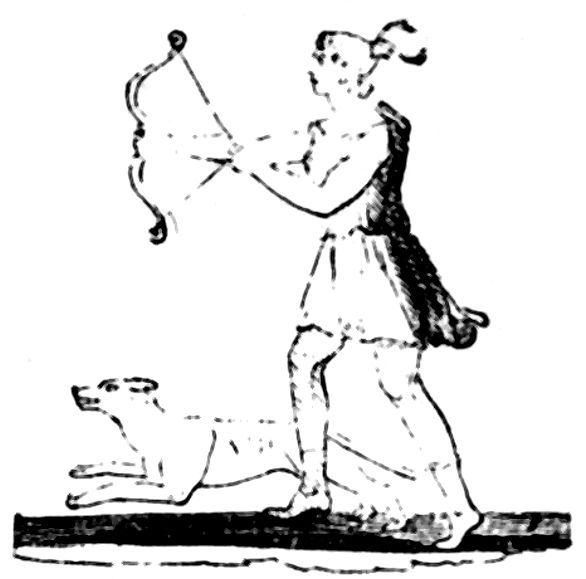
MENDING STOCKINGS. Worsted and lambswool stockings should never be mended with worsted or lambswool; because, the latter being new, it shrinks more than the stockings, and draws them up, till the toes become short and narrow, and the heels have no shape left. Soft coarse white cotton should be employed for white worsted stockings and socks, and coloured cotton to match those of other hues.
PALMS. Palms are the most useful productions of Ceylon. First the cocoa-nut, in universal use for food, drink, and the arts of life. The palmyra, nearly as valuable. The areca catechu, whose nuts, the betel and the chunan, are the universal luxury of Asiatics. A tree produces from 500 to 1,000 nuts.
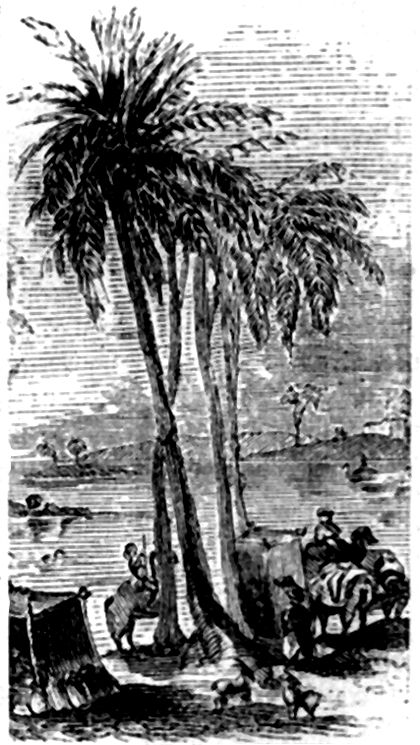
The sago palm, whose pith, dried and granulated, is in use through Europe, is also prolific in sugar. The talipot is famous for its large leaves, (one of which shelters from fifteen to twenty men,) and its fruit. The jack produces fruit as large as a man’s body, filled with delicious pulp, and with seeds as large as chesnuts, of which many dishes are made. A Cingalese family live at ease on the produce of a dozen cocoa-nuts and three or four jack-trees.
APRIL. Since the time of Numa Pompilius, this month has retained the same place in the calendar that it does now. Romulus assigned thirty days to the month, but Numa reduced it to twenty-nine. Julius Cæsar, however, restored it to its original length, which has not been altered since. The name of the month is derived from the Latin word Aperio (to open), and was no doubt bestowed in allusion to the season, for the earth opens her bosom, and sends forth her riches, and the young buds open under the influence of April showers.
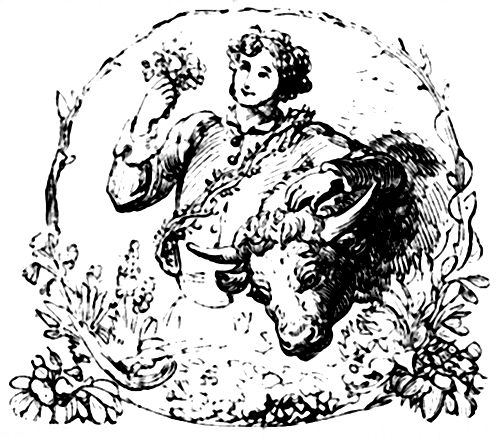
Symbol or Allegory of the Month.—A young man, with a cheerful and youthful face, clad in green, with a garland of myrtle and hawthorn in buds crossing his left shoulder, allegorical of the verdure at this period of the year. In his right-hand he holds a bunch of prize roses and violets, while his left hand rests upon a bull’s head, typical of the sign of Taurus, or the Bull, because the sun enters that constellation on the 19th of the month.
Synonymes.—In Latin, this month is called Aprilis; in French, Avril; in Italian, Aprile; in Portuguese, Abril; in ancient Cornish, Eprell; and in Saxon, Oster-Monath, or Easter month.
There are several remarkable days belonging to the month. The 1st day is called All Fools’-day. The well-known practice of making persons go on some foolish errand, such as to inquire for “pigeon’s-milk,” “strap-oil,” &c., or playing some practical joke upon them, has given rise to the name of All Fools’-day. The person so deceived is called an April fool in England, a gowk in Scotland, and un poisson d’Avril (an April fish) in France.
The 2nd day, in the present year, is Good Friday, being the day that is held in commemoration of our Saviour’s crucifixion. The oldest title given to this day is Holy Friday, or the Friday in Holy Week. The well-known “hot-cross buns,” which are so vigorously called about the streets early in the morning by itinerant vendors, are supposed to have originated in the desire to commemorate the Crucifixion, by marking the only food anciently sanctioned with the sign.
Palm-Sunday, or the Sunday before Easter, is so named because on that day it was customary to carry boughs of palm in procession, in commemoration of our Saviour riding into Jerusalem, when the multitude spread their garments; while “others cut down branches from the trees, and strewed them in the way.”
The 4th day, in this year, is Easter-Sunday, the day of our Saviour’s resurrection from the tomb. The observance of this festival is as ancient as the time of the apostles, but as it was kept upon different days by the Eastern and Western Churches, the Council of Nice (a.d. 325) directed that it should be held on the Sunday which falls next after the first full moon following the 21st of March, or Vernal Equinox. Hence this day is the great moveable festival of the year, which regulates the periods of all the other moveable feasts, as Sexagesima, Ash Wednesday, Good Friday, Ascension-day, &c.
10th. On this day, in 1736, died Prince Eugene, the celebrated commander, in conjunction with the great Duke of Marlborough, of the armies of the Continent allied against the French. He was so popular in England that a maiden lady bequeathed to him £2,500.
On the 14th day, in 1471, the battle of Barnet was fought, in the wars between the houses of York and Lancaster; when the Earl of Warwick, called the “King-maker,” was slain in the field.
21st. In the old almanacks this day is dedicated to St. Anselm, who was born at Aoust, in Piedmont, and created Archbishop of Canterbury in 1093, by William Rufus. He died on this day, 1109, aged seventy-six. In 1142, Peter Abelard, a learned doctor in the Church, died, aged sixty-three. He was the celebrated lover of the no less celebrated Heloise.
23rd. St. George’s-day. St. George is the patron saint of England, and is said to have been born in Cappadocia, of Christian parents. Every schoolboy has read the fabulous history of St. George rescuing the King of Beyrout’s daughter from a desperate dragon, and all that befell him in his sojourn in Palestine. He is represented on our old sovereigns and five-shilling pieces in the act of slaying the dragon. Historians agree that he was beheaded on this day, 290, after being drawn through the city of Lydda, for having openly avowed himself as the champion of the Christians. St. George was the ancient word of attack of England, as St. Andrew was that of Scotland, and the figure of this saint is attached to the Order of the Garter, which was instituted by Edward III., after the battle of Calais, in the year 1349.
25th. This day is dedicated to St. Mark, whose Gospel was written in the year 63. The order of Knights at Venice, taking his name, was instituted in 737; their motto was “Pax tibi, Marce, evangelista meus.” There were many peculiar customs kept upon this day, but they have now become obsolete. Among others was that of blessing the corn, and also watching in the church-porch on the eve of St. Mark, to see the ghosts of those who should die in the following year.
Four illustrious individuals were born in this month, viz., Handel, Harvey, Shakspeare, and Cromwell.
George Frederick Handel was one of the most distinguished musicians that ever lived. He composed “Israel in Egypt,” “The Messiah,” “Judas Maccabæus,” and several other oratorios, which have immortalized his name. He was born at Halle, in Saxony, and died on the 13th of April, 1759, in the seventy-fifth year of his age.
William Harvey was the celebrated discoverer of the circulation of the blood, and physician to James I. and Charles I. He was born at Folkestone, on the 1st of April, 1578, and died in 1658.
Of William Shakspeare, the immortal dramatist, it is unnecessary to say more than that he was born in 1564, and the entry of his baptism in the register of the parish church of Stratford-upon-Avon is upon the 26th of April, 1564; and the date of burial is registered as the 25th of April, 1616.
“Each change of many-coloured life he drew—
Exhausted worlds, and then imagined new.”
Oliver Cromwell, as a soldier and a statesman, was one of the most extraordinary characters in English history. He was born at Huntingdon, on the 25th of April, 1599, and died at Whitehall, 3rd September, 1658.
STEAM-ENGINE. An arrangement of mechanism, by which, by the alternate generation and condensation of steam, or by making it act above and below the forces of a piston, a lever is raised and depressed with any degree of power, from that of one horse to 300, every 19 cubic inches of water producing 20 feet of steam, which is equal in expansive force to the power of one horse, produced by less than a quarter of a pound of coal, with from 30 to 40 strokes per minute; and, in general, a chaldron of coal works 100 horse-power for four hours. Steam-engines are divided into low-pressure and high pressure; in the latter, the steam being excited by the heat of 212, that of boiling water, is re-condensed by cold, and a valve provides for its escape, when it raises the thermometer above 30 inches.
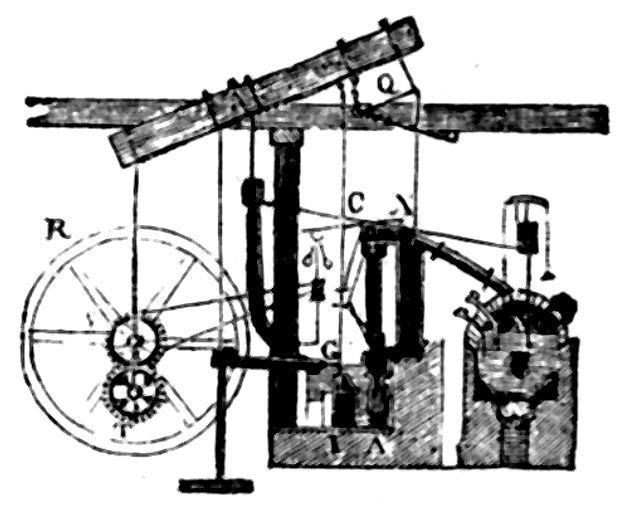
But if the valve is loaded with a second 15 lb., equal to another atmosphere, then the mercury will rise to 60, and the force be doubled, steam being 20 times its former bulk; if it be loaded with 28 lbs. it will be again doubled, and so on; but, of course, such augmentation of force tries the strength of the engine. Of course, the energy of the steam rises from the motion of the oxygen transferred to the combustible, and by it to the water, the atoms of which evolving, in consequence, form moving circles, and hence the expansive force. The boiler is on the right-hand, and communicates the steam to the piston O A, whence it rushes into X and G, and raises the rods X Q, and G C, which force up the beam; and the beam carries round a small wheel O, which works in the small one, S, connected with the large one, R, and with R the works are connected.
TETRAHEDRON. A triangular pyramid, with four faces.
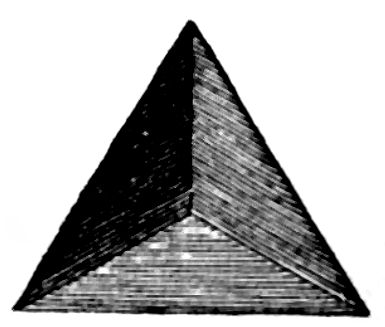
ELM-DESTROYING SCOLYTUS. Scarcely has the elm begun to leaf, than the Scolytus destructor, or elm-destroying Scolytus begins her operations; and most dexterously does she effect her purpose. She may be met with in dry weather, even amid the stir and hum of London; and wherever the tree whose name she bears lifts up its green head, in squares or gardens, there is she.
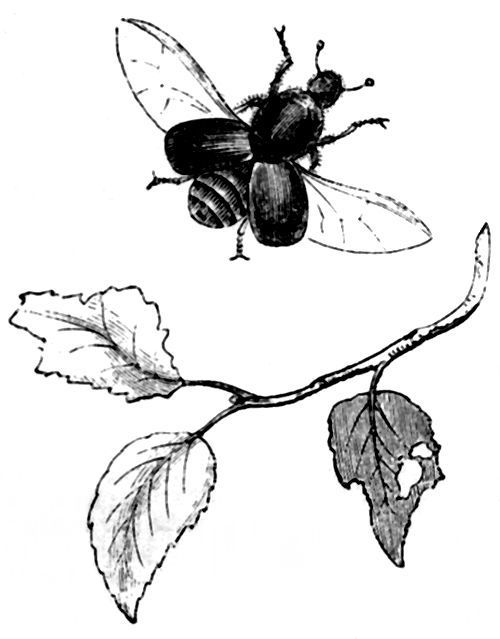
Fig. 1.
You may see this formidable little insect upon their trunks, making a passage through the bark, and then dexterously excavating a kind of tunnel between the bark and wood, wherein she deposits her eggs, thus forming a nest for her future progeny, and for herself a tomb; for she dies when her work is done, and is generally found at the extremity of her channel, as if conscious that her end was approaching, and unwilling to impede the future operations of her progeny. Scarcely, however, have the larvæ emerged from their eggs than they begin to feed, working nearly at right angles from the path formed by their careful parent, and proceeding almost parallel to one another. They may even be found alive in January; and it is therefore probable that they work during the whole winter, when, in consequence of the sap being down, the bark adheres less firmly, and the progress of the grub is consequently not impeded.
SAVINGS’ BANKS. The origin of these admirable institutions has been attributed to the Rev. Joseph Smith, of Wendover, who, in the year 1799, circulated proposals, in conjunction with two of his parishioners, in which they offered to receive from any inhabitant of the parish, any sum from twopence upwards, every Sunday evening during the summer months; to keep an exact account of the money deposited; and to repay at Christmas to each individual the amount of his deposit, with the addition of one-third to the sum. The next institution of this kind of which we have any account, was founded in 1804, at Tottenham, in Middlesex, by Mrs. Priscilla Wakefield.
FLYING-FISH. A species of fish, common in the Mediterranean and Atlantic seas, with very large fins, by which they are enabled to spring from 200 to 300 feet, or until their fins become dry.
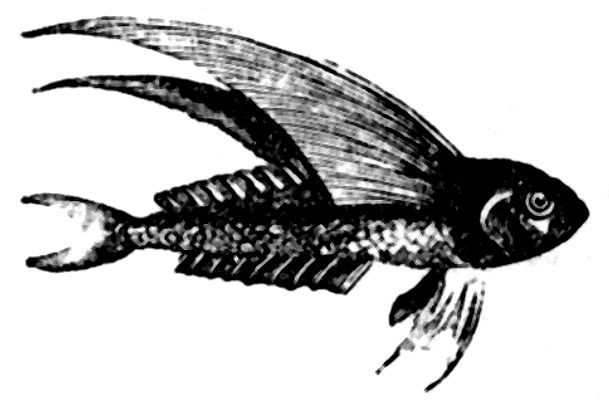
BREAD (ASSIZE OF). Ever since 1266, in the reign of Henry III., the price at which bread should be sold had been determined from time to time by the magistrates, according to the current price of corn, which was called “setting the assize.”
LIVERIES. The precise period when liveries were first worn by domestics is unknown. In olden times tradesmen as well as servants wore these badges. Anterior to Richard II., tradesmen who served a nobleman’s family wore his livery, and the placing of royal and noble arms over tradesmen’s shops to this day is a relic of such a custom. The livery of London, besides the dress of their companies, often wore on great occasions, from compliment, that of the king, noblemen, lord mayor. &c.
DECK. The floor of a ship, from stem to stern; half-deck, from the mainmast to the stern; and quarter-deck, that over the cabin and steerage, to the stern.
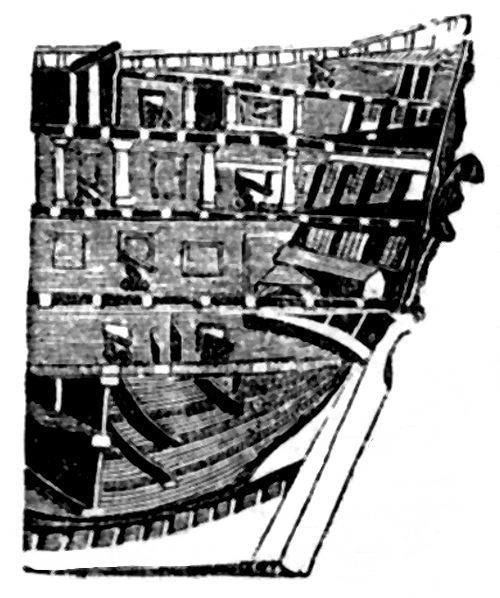
CHURCHES AND CHAPELS IN ENGLAND AND WALES. The whole number of churches and chapels in England and Wales is computed to be 28,290. Of these, the Established Church has 14,000, the Presbyterians 150, the Independents 2,572, the Baptists 1,943, the Wesleyan Connexion 4,450, the Wesleyan New Connexion 281, the Primitive Methodists 1,662, the Wesleyan Methodist Association 322, the Bible Christians 415, the Methodists 778, Lady Huntingdon’s Connexion 30, the Unitarians 260, the Quakers 330, various minor Protestant sects 500, Roman Catholics 697. According to this statement, it appears that places of worship belonging to Protestants are 97.89 per cent., and those belonging to Roman Catholics 2.11 per cent. of the whole number, and that of the former, a fraction more than half (viz. 50.55) belong to the Established Church, the rest to Protestant Dissenters. The increase of the churches and chapels of the Established Church, for the last quarter of a century, is 2,175, or 18.39 per cent.; the increase of the Independents has been 732, or 39.78 per cent.; the Baptists 742, or 61.77 per cent.; the Methodists 3,997, or 102.19 per cent.; the Roman Catholics 222, or 59.20. The number of Protestant places of worship which have been built since 1831, as compared with the Roman Catholic places of worship which have been built since 1826, is as 34 to 1. In addition to the above mentioned churches and chapels, which are exclusively devoted to purposes of Christian worship, there are 7,474 “stations,” that is to say, schools, or hired rooms, in which prayer-meetings are held, and the Gospel is preached by evangelical dissenters.
EBONY. This wood, which is extremely hard, and susceptible of a very fine polish, is much used in mosaic, inlaying, and other ornamental works. Its colour is red, black, or green. The black is most esteemed, and is imported principally from Madagascar and the Isle of France. Red ebony, so called, though its colour is brown, striped with black, is less compact, and is also brought from Madagascar. The green is softer than either of the preceding, yields a fine green tincture, which is employed in dyeing, and is brought from the West Indies, particularly from Tobago, as well as from the above-mentioned islands. The best is jet black, and free from knots or reddish veins. Ebony is imitated by subjecting the pear-tree to a hot decoction of galls, and when this is dry, applying ink with a stiff brush.
GLASS BREAKING (TO PREVENT BY HOT WATER). If hot water be poured into a glass with a round bottom, the expansion produced by the heat of the water will cause the bottom of the glass to enlarge; while the sides, which are not heated, retain their former dimensions, and, consequently, if the heat be sufficiently intense, the bottom will be forced from the sides, and a crack or flaw will surround that part of the glass by which the sides are united to the bottom. If, however, the glass be previously washed with a little warm water, so that the whole is gradually heated, and, therefore, gradually expanded, then the hot water may be poured in without danger; because, although the bottom will expand as before, yet the sides also enlarge, and the whole vessel undergoes a similar change of heat.
BEADS (GLASS). The small glass beads are fragments cut from pieces of glass tubing, the sharp edges of which are rounded by fusion. Glass tubes of the proper size are first drawn from one hundred to two hundred feet in length, and of all possible colours (in Venice they prepare two hundred different shades), and are broken into lengths of two feet. These are then cut, by the aid of a knife, into fragments of the same length as their diameters. They now present the form of beads, the edges of which, however, are so sharp that they would cut the thread on which they have to be strung. The edges have consequently to be rounded by fusion; and, as this operation must be performed upon a great number at once, and they must not be allowed to stick together, they are mixed in coal-dust and powdered clay previous to their being placed in the revolving cylinder in which they are heated. The finished beads are then passed through sieves sorted to their size, and strung upon thread by women. The glass beads made in imitation of pearl for toilet ornaments, the invention of which dates from the year 1656, are very different from the preceding, both as regards their application, mode of production, and origin. These are small, solid glass beads, of the same size as native pearls, which they are made to resemble by a coating of varnish, which gives them a peculiar pearly lustre and colour. A maker of rosaries, by the name of Jaquin, was the first to discover that the scales of a species of fish (Cyprinus albunus) communicates a pearly hue to water. Based upon this observation, glass globules were first covered on the outside, but at a later period on the inside, with this aqueous essence. The costly essence, however, of which only a quarter of a pound could be obtained from the scales of four thousand, was subjected to one great evil, that of decay. After trying alcohol without success, in consequence of its destroying the lustre of the substance, sal-ammoniac was at length found to be the best medium in which to apply the essence; a little isinglass is also mixed with it, which causes it to adhere better. The pearls are blown singly at the lamp; a drop of the essence is then blown into them through a thin tube, spread out by rolling; and the dried varnish is then covered in a similar manner by a layer of wax.
LORDS SPIRITUAL AND TEMPORAL. This term applies to the persons who sit in the House of Lords. The “Lords Spiritual” are the archbishops and bishops of the English Church, and one archbishop and three bishops of the Irish Church. Before the Reformation, superiors, priors, and abbots, sat in the House of Lords, and the “Lords Spiritual” at that time often exceeded in number the “Lords Temporal,” though they now form only about a thirteenth part. The “Lords Temporal” are all the peers of England of age and sane mind, sixteen peers of Scotland, and twenty-eight of Ireland. The number of peers of Ireland and Scotland is fixed, but that of England is variable, depending upon the casualties of minorities and the will of the Sovereign.
ISINGLASS. Isinglass is a preparation formerly made only from the great sturgeon; but is now obtained from the entrails of most other fishes. When good, it consists almost wholly of pure gelatine, or glue, which is nutritious. It is free from taste and smell, and is soluble in warm water. Being nothing more than the membraneous parts of fishes, it can probably be made from the fish on the coasts in this country. The sounds or air-bladders of fresh-water fish are generally preserved for this purpose, and it is best made in the warm season. It is sometimes used as a medicine; but boiled in milk it forms a nutritious jelly, and is the substance of blancmange. It is also used for refining coffee, vinous liquors, and cider.
PENDULUM. The pendulum is a timekeeper, because the times of the vibrations are very near equal, whether it be moving much or little; that is to say, whether the arc described by it be large or small. A common clock is merely a pendulum, with wheelwork attached to it, to record the number of the vibrations; and with a weight or spring, having force enough to counteract the retarding effects of friction and the resistance of the air. The wheels show how many swings or beats of the pendulum have taken place, because at every beat, a tooth of the last wheel is allowed to pass. Now, if this wheel has sixty teeth, as is common, it will just turn round once for sixty beats of the pendulum, or seconds; and a hand fixed on its axis, projecting through the dial-plate, will be the second-hand of the clock. The other wheels are so connected with this first, and the numbers of the teeth on them so proportioned, that one turns sixty times slower than the first, to fit its axis to carry a minute-hand; and another, by moving twelve times slower still, is fitted to carry the hour-hand.
WEDDING-RING FINGER. The origin of wearing the wedding-ring upon the fourth finger of the left hand has been much disputed. The most reasonable inference as to the origin of wearing the ring on the left hand, however, appears to be a matter of convenience. Macrobius, a Latin author of the fifth century, says:—“At first it was both free and usual to wear rings on either hand; but after that luxury increased, when precious gems and rich insculptures were added, the custom of wearing them on the right hand was translated unto the left; for, that hand being less employed, there they were best preserved. And for the same reason they placed them on this finger, for the thumb is too active a finger, and is too commonly employed with either of the rest.”
SEDAN-CHAIRS. These contrivances, formerly much in use among our ancestors, were not of English origin. As the name implies, they were introduced into this country from Sedan, a city in France, about 1634, Sir Saunders Duncombe, a traveller of some reputation at that period.
BUDDING. Is the insertion of a bud, taken from one tree, into the bark of another; and, as in grafting, the operation will not succeed unless the bud and the tree to which it is united are varieties of the same species, or genera of the same natural family. In fact, the only difference between grafting and budding—the principle of each being the same—is that in the former a shoot, or as it is technically termed a scion, is inserted into the stock or stem that is grafted; and in the latter a bud, which is simply a scion in embryo. The latter part of June, the month of July, and on to the middle of August, is the best season for budding. When you perceive the buds well formed in the axilla of the leaf, that is, between the foot-stalk of the leaf and the stem, and when the bark of the stalk can be freely and easily raised from the wood, then you have a sure criterion that you may safely commence to bud.
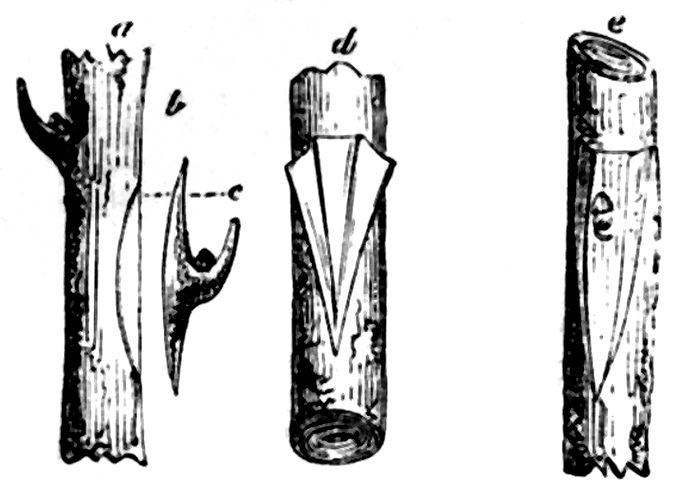
Select a smooth part of the stock at the height you wish, and the side least exposed to the sun; with your budding-knife make a horizontal cut across the bark through to the wood, but not deeper; from the centre of this cross-cut make another of a similar kind, perpendicularly downwards, about an inch, or rather more, in length—these two cuts will be in the form of a T. Then proceed to take off the bud—or as it is technically termed, the shield—first cutting off the leaf, but leaving a part of the leaf-stalk. The shield must be carefully sliced out of the stem at one cut. (Figures a and b represent the stem and shield after their separation). A portion of the wood must be taken off with, and attached to, the shield; the greater part of this wood must be carefully picked out, but it is essential that a portion should be left at the back of the bud—if you do not do so, but make a hole through the shield at the eye, or root of the bud, you may throw it away as useless. Then, with the handle of the budding-knife, separate and turn back the bark from the stock on each side of the perpendicular cut (it will then resemble figure d), and insert the shield close to the wood, and between it and the turned-back bark. Cut off the top part of the shield horizontally (in the direction of the dotted line c), and fit the remaining upper part of the shield accurately, and closely, to the cross-cut in the stock—on this close contact of the two barks the success of the operation principally depends. You must now lay down the turned-back bark over the shield, and with a worsted thread, or bit of bass, bind it down, leaving the point of the bud clear. (Figure e represents the bud in the stock previous to its being bound). A friend informs us that he uses common adhesive plaster for binding, and that it answers admirably. If the weather be very warm, a handful of damp moss should be loosely tied over all, leaving, as before, the point of the bud exposed. In about a month, or six weeks, the ties may be removed; and, to throw the whole strength of the plant into the bud, all shoots must be cut off, and suckers, whenever they make their appearance, carefully eradicated. By budding, you may produce several kinds of roses upon the same plant. The more tender exotic roses would scarcely exist in this country if they were not budded on our more hardy kinds. Indeed, it is now generally acknowledged that all roses bloom finer, and last longer, when budded on the common wild rose. Budding is also extremely useful for filling up the vacancies which so frequently occur in peach and apricot trees, when trained to walls, by branches dying. Variegated shrubs, as holly, &c., are propagated by budding on the plain kinds.
FALCON. A bird of prey, once much esteemed as an auxiliary of the savage arts of man in destroying the feathered race. Falcons were formerly tamed and trained, just as pointer-dogs are at present trained; and hawking, or falconry, was, to a certain class of minds, as interesting as shooting or hunting is to the same class in our day. They are carnivorous, the beak hooked, the head covered with feathers, and the legs and feet scaly.
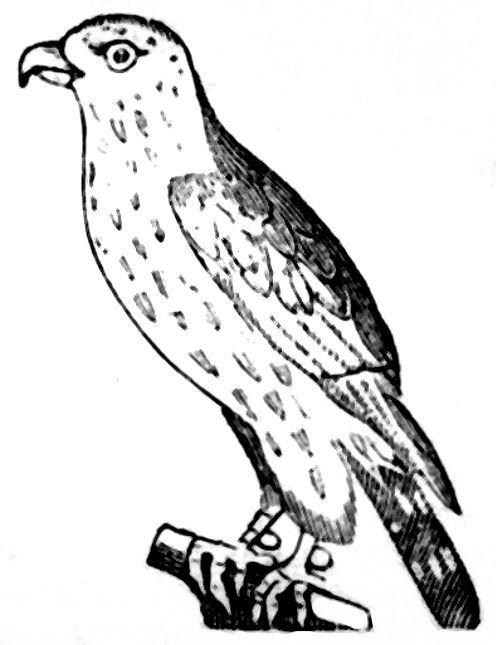
GRASSHOPPER. A species of the genus Gryllus, to which belong the locust and cricket. The grasshopper of our fields is innocent and harmless.
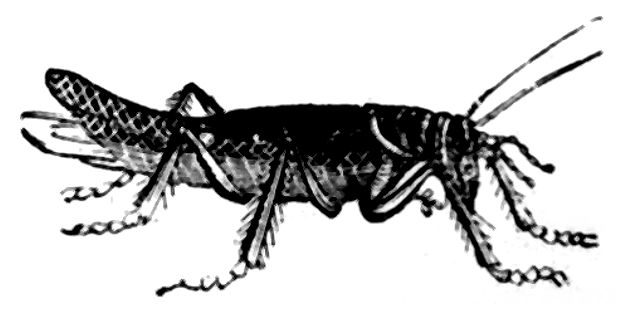
BLACKBERRY BRAMBLE. (Rubus fruticosus), whose rich black fruit attracts many a loitering urchin, yields abundantly a delicious fare for such birds as remain stationary through the winter. All children well know where the blackberry best flourishes. They love to go forth with their small baskets to gather the ripe clusters; and he who looks upon them, and hears their ringing laughter and merry voices, may scarcely deem that either sin or sorrow is abroad.
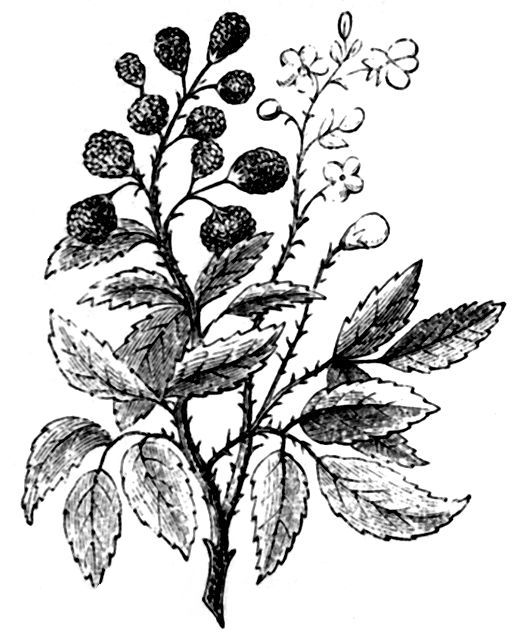
Yet, not only in woods and hedges, on village commons, and beside the road, grow wild brambles in abundance; for they are found on mountains, at an elevation of at least two thousand feet, and where, in order to give shelter to those small birds and quadrupeds which affect high places—as the grouse and Alpine hare—they become nearly evergreen.
GUNNERY. A science which directs the elevation in which a piece of cannon should be placed, so as to strike a certain object. The gun is elevated to a certain fixed angle, given in tables accurately calculated, and then the ball passes through a curve, and reaches the proposed spot.
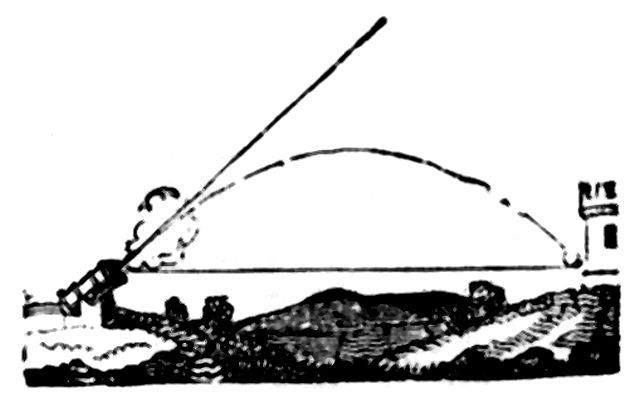
BEAVER HATS. The entire hat is now rarely made of so costly a material as beaver fur, which is only used to cover the outside. This fur is almost entirely brought from North America. It is gradually becoming scarce and dearer, being now obtainable only in inconsiderable quantities from the most northerly and inaccessible districts. The fur of the middle-aged or young animal, called cub-beaver, is most esteemed, it being the finest, most glossy, and taking the best dye. There are also used for hatting the furs of the musquash, or musk-rat, otter, neutria, hare, and rabbit.
GASOMETER. The capacious receptacle of gas, after it has been evolved in the retorts, and whence it is pressed into pipes for consumption. It consists of a vessel inverted in water, and the gas passes under it, and raises it up by its elasticity or momenta, till it is full, and when wanted, weights are placed upon it. D is the pipe from the retort, or furnace, A; F is the tank filled with water; G is the gasometer or vessel inverted; and V the pulleys by which the weight, W, regulates the gasometer in ascent and descent.
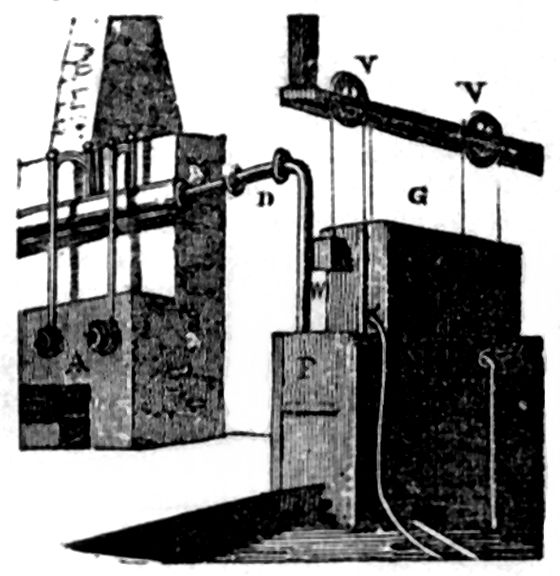
TEASEL. The vast woollen-clothing fabric materially depends on the fuller’s teasel, which is found in hedges and wild sterile spots, and is cultivated to a large extent in the stiff clay lands of Gloucestershire and Somersetshire, of Wiltshire and Essex.
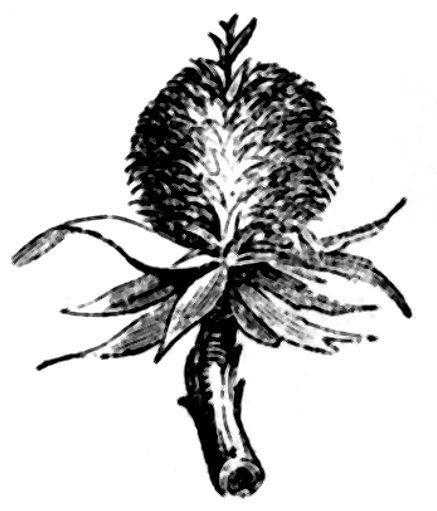
This plant, with the Dutch rush, or shave-grass, of which the stems have long been imported from Holland to polish cabinetwork, ivory, plaster casts, and even brass, are the only known instances of natural productions being applied to mechanical purposes. The teasel is alone available to raise the nap from woollen cloths, and for this purpose the heads are fixed round the circumference of a large broad wheel, which is made to turn in contact with the cloth; if a knot, or roughness, or projection, catch the hooks, they break immediately, without injury; but any mechanical invention, instead of yielding, tears them out, and materially injures the surface. Teasel crops require both labour and close attention, and are precarious in their returns; they suffer considerably from dripping seasons, and therefore cultivators who have heavy rents to pay seldom raise them. They consequently become the care of the more considerable cottagers; and as the members of a family unite in attending to them, they are frequently a source of considerable profit. Travellers who pass through districts where this plant is cultivated, relate that the teasel harvest is one of considerable interest. Some way-side cottage, with its garden and apple orchard, where also a small plot of ground is covered with teasels, presents a cheerful and animated scene when the labourer and his wife are busily employed in cutting the prickly heads from their tall angular stems with teasel-knives affixed to poles, and their children are seen joyfully running in all haste to place them in the sunbeams. The terminating heads, which ripen first, are called kings; they are large and coarse, and are adapted only for the strongest kind of cloth. The collateral heads then succeed, known by the name of middlings, and are used for the finest purposes. When dry, the older children pick and sort them into bundles—ten thousand of the best and smallest make a middling pack—nine thousand of the larger, the pack of kings. This valuable plant is known in almost every country throughout Europe by a name expressive of its use. Gerard tells us that its old English name was the carding teasel. The French call it cardon de foullon; the Danes and Swedes, carde tidsel; the Spaniards and Portuguese, cardo and cardencha; the Hollanders, caarden; and the Flemings, carden distel.
WINDOWS (TO PAINT TO RESEMBLE STAINED GLASS). 1. Draw the design upon paper the size required, then colour it, and affix by means of a little gum to the outside of the window, and paint the inside over the design with varnish colours. 2. By this method the same design may be multiplied as often as desired, and as the most brilliant hues are obtained, the whole being transparent, and possessing the same warmth of colouring as stained glass, it is to be preferred to the other methods. Procure a piece of cardboard, and give it three coats of fat copal varnish, allowing one to dry before the next is applied. When dry, draw the necessary figures on it, and cut out such parts as are intended to be painted red, and number the card 1; then do the same on another intended to be blue, number this 2; and continue to construct a pattern for each colour, until you have the number required. The object of affixing a number to each pattern, is to secure an orderly application of them in succession from No. 1, up to the highest number in the set. There are certain parts in each pattern marked with a dot, which is placed in the same part in each, so as to admit of the adjusture of the successive numbers; these may be termed the adjusting points, as pointing out the exact situation in which each pattern should be placed after No. 1 has been used, because it will accurately admit a part that has been painted by a preceding pattern to appear through, as each succeeding pattern is applied. A brush should be reserved for each colour, marked on the side with the name of the colour, and never used for any other colour, without first washing it well with oil of turpentine—especially green. Colours should not be laid on too thick, but if requisite, tempered with a little oil of turpentine until of the proper consistence, and when applied by means of the patterns, brushed through them lightly, and the patterns cleaned afterwards with a little cotton. As the lights and shades of the pictures are displayed, lay the lighter colours first on the lighter parts of the design, and the darker over the shaded parts; and having laid on the brighter colours, it is not of any consequence if the darker shades are laid a little over them. When finished, the glass should be placed in a warm dry place, free from dust, for three or four days, but if the glass is in the windows, they should be closed, and kept free from dust. Lake is better applied when previously ground with water impregnated with gum and salt, the shading being effected by applying successive coats of the pigment. Blue purple is formed by combining lake and indigo, as directed above. Green is made by adding sufficient gamboge to the above to give it the desired hue. Yellow is prepared by grinding gamboge with salt water alone. White.—Heighten the lights with the quill of a turkey (the nib unsplit), in the same manner as with crayons on blue paper.
SUB-ROSA. Under the rose—implying secresy, has been said to have originated from the many plots and conspiracies engendered during the wars of York and Lancaster; but it is much more probable that it arose from a custom—now fallen into disuse, but once very general amongst the nations of the north of Europe—of suspending a rose over the heads of the guests at feasts and banquets, to signify, that whatever transpired was of a confidential nature. Or it may be of a still earlier period, for the rose was dedicated to Harpocrates (the Egyptian Horus) the god of Silence. In former times—perhaps so still, for all that we know—the Roman pontiff, when he wished to confer particular distinction on a crowned head, consecrated a golden rose, and presented it to the fortunate monarch: both Henry VI. and Henry VIII. were honoured in this manner. It may be interesting to add, that a rose was the device on the seal of the great Reformer, Luther.
ALIQUOT PARTS. Numbers which will divide and measure a whole number exactly, without any remainder. For instance, two is an aliquot part of four, three of nine, and four of sixteen. (See Aliquant Parts, p. 180.)
NAPKINS (HOW TO FOLD). Dinner napkins should be about twenty-eight inches broad, and thirty long. They may be folded in a variety of ways, which impart a style to a table, without adding much to the expense, and may be readily accomplished with a little practice and attention to the following directions and diagrams:—
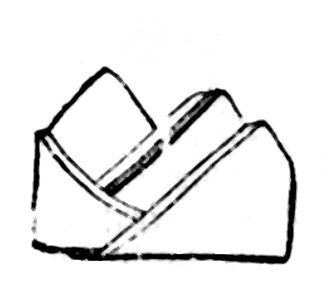
Fig. 1.
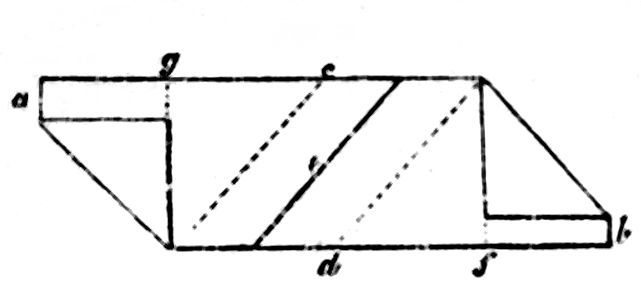
Fig. 2.
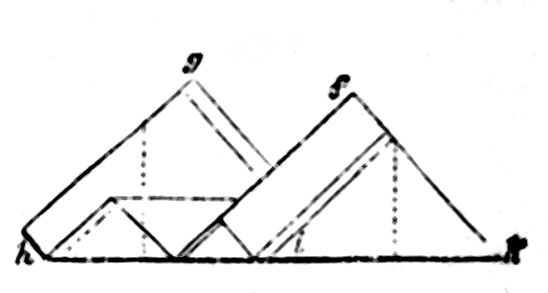
Fig. 3.
1. The Mitre—(Fig. 1). Fold the napkin into three parts longways; then turn down the right-hand corner, and turn up the left-hand one, as in fig. 2, A and B. Turn back the point A towards the right, so that it shall lie behind C; and B to the left, so as to be behind D. Double the napkin back at the line E, then turn up F from before and G from behind, when they will appear as in fig. 3. Bend the corner H towards the right, and tuck it behind I; and turn back the corner K towards the left, at the dotted line, and tuck it into a corresponding part at the back. The bread is placed under the mitre, or in the centre, at the top.
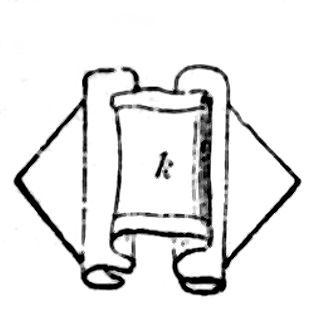
Fig. 4.
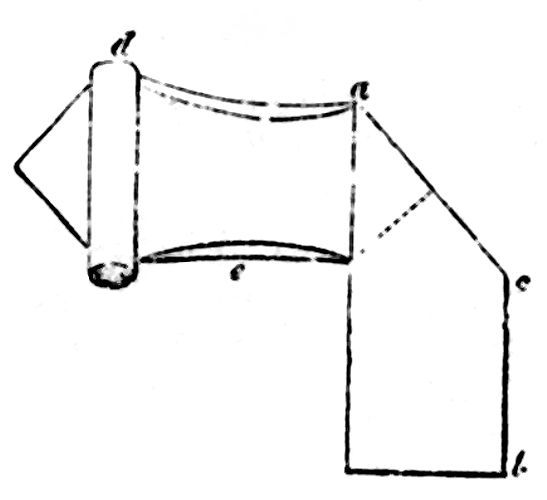
Fig. 5.
2. The Exquisite—(Fig. 4). Fold the napkin into three parts longways, then fold down two-fifths of the length from each side, as in fig. 5, at A; roll up the part B towards the back; repeat on the other side, then turn up the corner towards the corner A, and it will appear as D. The centre part E is now to be turned up at the bottom, and down at the top, and the two rolls brought under the centre-piece as in fig. 4. The bread is placed under the centre band, K, fig. 4.
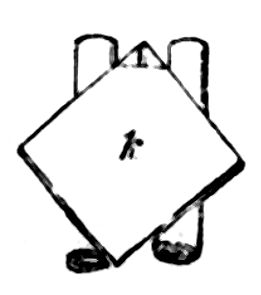
Fig. 6.
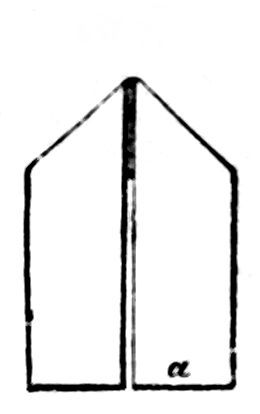
Fig. 7.
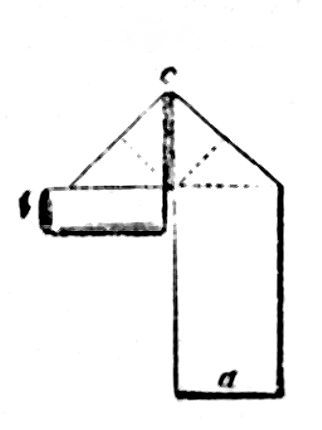
Fig. 8.
3. The Collegian—(Fig. 6). Fold the napkin into three parts longways, then turn down the two sides towards you, so that they shall appear as in fig. 7; then roll up the part A underneath until it looks like B, fig. 8. Now take the corner B and turn it up towards C, so that the edge of the rolled part shall be even with the central line; repeat the same on the other side, and turn the whole over, when it will appear as in fig. 6. The bread is placed underneath the part K.
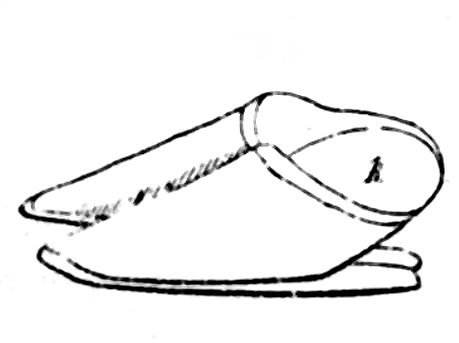
Fig. 9.
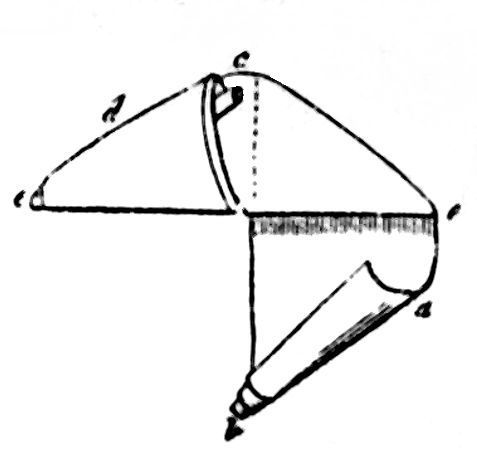
Fig. 10.
4. The Cinderella—(Fig. 9). Fold the napkin into three parts longways, then turn down the two sides as in fig. 7; turn the napkin over, and roll up the lower part as in fig. 10, A, B. Now turn the corner B upwards towards C, so that it shall appear as in D; repeat on the other side, and then bring the two parts E together, so that they shall bend at the dotted line; and the appearance will now be as at fig. 9. The bread is placed under the apron part, K, fig. 9.
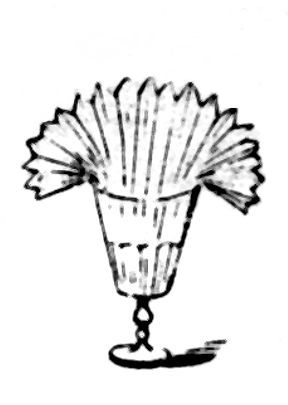
Fig. 11.
5. The Flirt—(Fig. 11). Fold the napkin into three parts longways; then fold across the breadth, commencing at one extremity, and continuing to fold from and to yourself in folds about two inches broad, until the whole is done; then place in a tumbler, and it will appear as in the illustration.
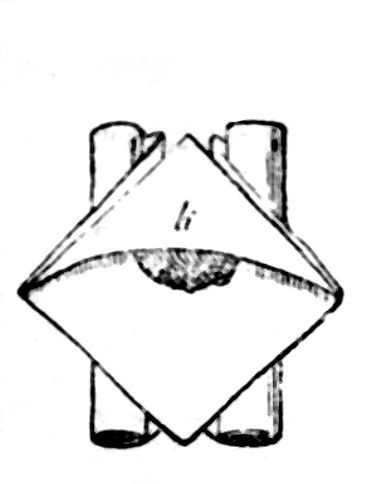
Fig. 12.
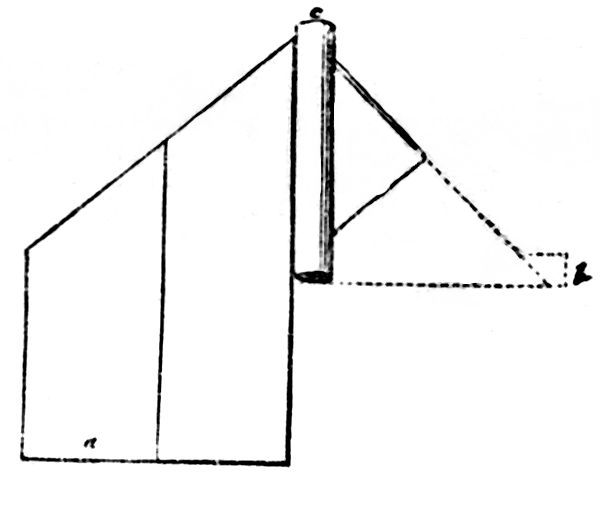
Fig. 13.
6. The Neapolitan—(Fig. 12). Fold the napkin into three parts longways, then fold one of the upper parts upon itself from you; turn over the cloth with the part having four folds from you, and fold down the two sides so as to appear as in fig. 7; then roll up the part A underneath, until it appears as in the dotted lines in fig. 13, at B. Now turn up the corner B towards C, so that the edge of the rolled part shall be even with the central line: repeat the same upon the opposite side, and turn the whole over, when it will appear as in fig. 14; the bread being placed underneath the part K, as represented in the illustration.
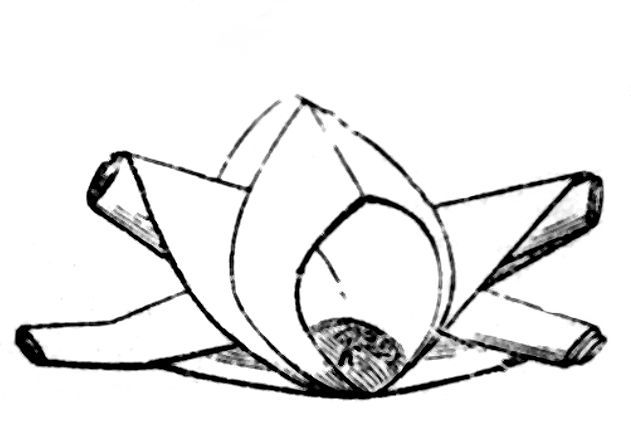
Fig. 14.
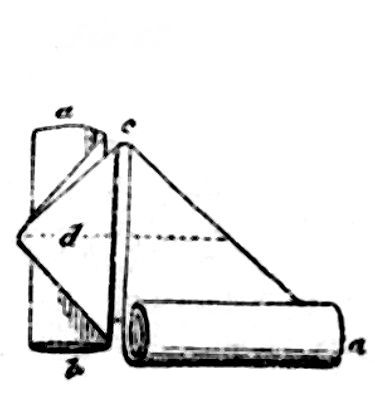
Fig. 15.
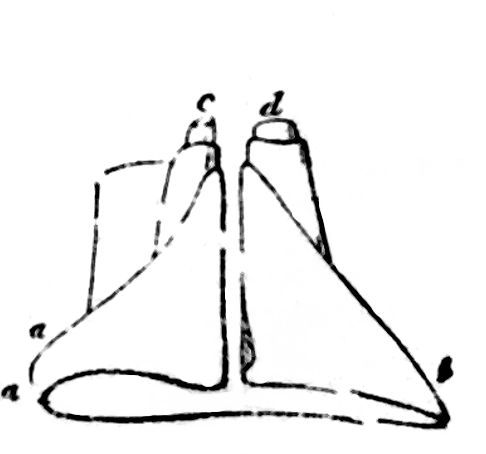
Fig. 16.
7. The “Favourite”—(Fig. 14). Fold the napkin into three parts longways, then turn down the two sides as in fig. 7, and roll up the part A on both sides, until as represented on the right-hand side in fig. 14; then turn it backwards (as A B) on both sides; now fold down the point C towards you, turn over the napkin, and fold the two other parts from you so that they shall appear as in fig. 15. Turn the napkin over, thus folded, and raising the centre part with the two thumbs, draw the two ends (A and B) together, and pull out the parts (C and D) until they appear as in fig. 13. The bread is to be placed as represented in K, fig. 13.—Extracted from the Family Friend.
DISTILLATION. The process of distillation is one which is used for separating liquids from each other which boil at different degrees of heat. In domestic economy, it is most frequently employed to obtain spirit, more or less flavoured, or scented, with some volatile essential oil. The apparatus commonly used is the Still, for boiling the liquid to generate the vapour, and a long spirally-twisted tube termed the Worm, which is placed in a tub of cold water, and through which the steam passes to be condensed. The worm is the most objectionable part of the modern still; its great evil is the difficulty with which it is cleaned, so as to prevent one strong-flavoured substance spoiling those which are distilled afterwards. If the coils of the worm are not very numerous, a bullet, with a string attached, may be passed through it, and a sponge or small bottle-brush, fastened to the string, may be worked backwards and forwards; but if there are several coils, it will be found impossible to do this, from the resistance caused by friction. In this case, the only plan is to close one end of the worm with a cork, and fill it with a solution of caustic alkali, allowing it to remain for some hours, and repeating the application with fresh liquid, if it be required.
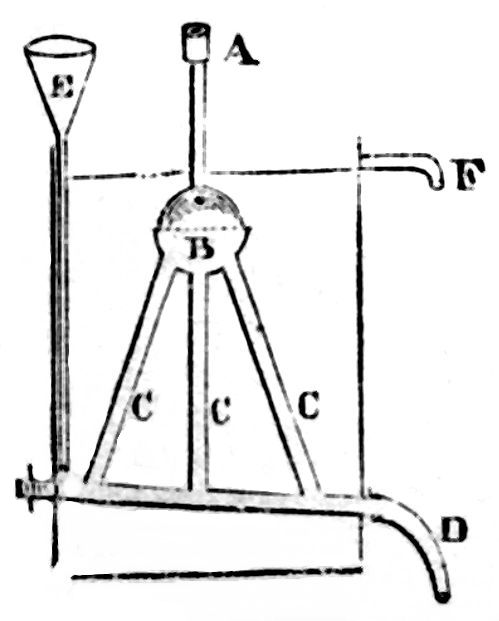
Fig. 1.
In Germany, the worm is being superseded by an excellent condenser, which is so superior that we are induced to give a sketch of it, hoping that it may lead to its adoption in this country. The vapours from the still pass into the tube A (fig. 1), by which they are conducted into B, a hollow globe, made to unscrew at its centre. The vapours, passing along the tubes C, are condensed, and the distilled liquid drops from D. The pipe E should convey a constant stream of cold water to the bottom of the tub, and this, rising as it is warmed by abstracting heat from the tubes and globe, should escape by F. All the tubes being straight, it is obvious that they can be readily cleaned from their ends.
In the laboratory, distilling is most frequently performed with vessels termed retorts, or even from flasks; but as these are not very applicable to domestic purposes, we pass them over.
In domestic practice, the still is usually employed to obtain some water or spirit flavoured with essential oil, or the oil itself, and the process should be slightly modified so as to suit each case. The vegetable substance should not be placed on the bottom of the still itself, as in that case it might become burnt, and so give an unpleasant flavour to the whole; but a bottom of wicker-work should be placed in the still in the first instance for it to rest upon, or a perforated board. The substance to be distilled should be placed in the still, covered with water, for some hours before the fire is lighted; no more water being added than sufficient to cover it, if the preparation of oil is the object.
Herbs, for distilling, should be collected on a dry day, and—unless the oil resides in the seeds, as in the case of caraway, anise, &c., or in the flowers, as in the rose, lavender, &c.—just before the flowers have opened, as at that period there is the greatest quantity of essential oil in the plant. All plants cultivated for distillation should be grown in a situation where they can receive a full amount of sun-light, as shade or darkness very much tend to prevent the formation of essential oil.
The liquid which comes out of the worm is a mixture of water highly-flavoured with the substance, and some undissolved oil. This latter is sometimes heavier and sometimes lighter than water, either sinking or floating; in the latter case the oil may be readily separated by filling a bottle with the mixture, and, when the oil is collected at the top, carrying it off by a few threads of cotton placed as in fig. 2, taking care that they are moistened with oil before arranging them; the cotton acts as a syphon, and removes the whole of the oil. If the object of the operation is to obtain the oil and not the distilled water, the latter should be preserved, and used again and again with fresh herbs; because, having in the first operation dissolved up as much oil as it is capable of doing, it causes no loss in the subsequent distillations.
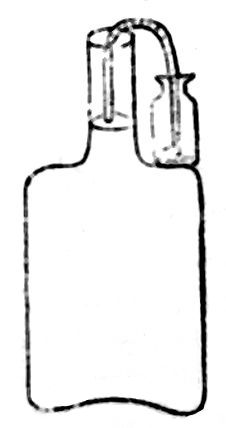
Fig. 2.
It may, perhaps, be thought that our article is incomplete, from our not giving any particular directions as to the manufacture of spirits, both as regards the first fermentation and subsequent distillation; but our readers should bear in mind that the manufacture of spirit is illegal, and the result is most frequently a heavy fine and imprisonment, to which we have no wish that our articles should be introductory.
ELECTRICITY. The word Electricity denotes a peculiar state, of which all bodies are susceptible, and which is supposed to depend upon the presence of a substance called the electric fluid. Some of its phenomena were known to the ancients, particularly those attractions and repulsions which a piece of amber, after being rubbed, exhibits, with regard to hairs, feathers, and other light bodies; and it was from its power of drawing light substances to it when rubbed that the Greeks gave amber the name Elektron, which is the origin of the word Electricity. Thales, who lived six centuries before the Christian era, was the first who observed the electrical properties of amber; and he was so struck with the appearances, that he supposed it to be animated. Mr. Boyle is supposed to have been one of the first persons who got a glimpse of the electrical light, or who seems to have noticed it, by rubbing a diamond in the dark. Sir Isaac Newton was the first who observed that excited glass attracted light bodies on the side opposite to that on which it is rubbed.
An electric is any substance, which being excited or rubbed by the hand, or by a woollen cloth, or other means, has the power of attracting light bodies. If a piece of sealing wax be rubbed briskly with the sleeve of your coat, a silk handkerchief, &c., for some time, and then held near hair, feathers, bits of paper, or other light bodies, they will be attracted; that is, they will jump up, and some of them will adhere to the wax. If a tube of glass, or small phial, be rubbed in a similar manner, it will answer much better. If this operation be performed in the dark, something luminous will be seen, which is called the electric matter or fluid; and all bodies that we are acquainted with have more or less of it in them; though it seems to lie dormant till it be put into action by rubbing. The air, and everything, is full of this fluid, which appears in the shape of sparks; the rubbing of the glass with the hand collects it from the hand; and the glass, having now more than its natural share, parts with it to any body that may be near enough to receive it. The substance rubbed and that with which it is rubbed are always found to be oppositely electrified—the one body having more and the other less than its natural share; indeed, one kind of Electricity is never obtained without, at the same time, the productions of the other. Those bodies which have been called Electrics, will not convey electricity from one body to another, and therefore they are termed Non-Conductors. The most remarkable are—glass, and all vitreous substances, precious stones, resins, amber, sulphur, baked wood, wax, silk, cotton, wool, hair, feathers, paper, white sugar, air, oils, metallic oxides, all dry vegetable substances, and all hard stones. Those bodies, which, when rubbed ever so much, do not exhibit electricity, are called Non-Electrics. They convey electricity from one body to another, and therefore are denominated Conductors; they are as capable of having electricity developed upon them by friction as those bodies which have been called “electrics,” but it is conducted away as fast as it is produced. Some of them conduct electricity much better than others. The principal conductors are the metals, charcoal, all fluids except dry airs and oils, most saline substances, and stony substances. Woollen and silk, when wet, will, by means of the water, conduct electricity.
When a body has more than its natural quantity of this fluid, it is said to be electrified positively, or plus; and when it has less than its natural quantity, it is said to be electrified negatively, or minus. When bodies are electrified either of these ways, they repel each other; but if some be electrified plus, and others minus, they mutually attract; or if one body be electrified plus, and the other not electrified in either way, they also attract each other.
There are some fishes which possess the extraordinary faculty of being able, at pleasure, to communicate shocks like those of an electric battery or galvanic pile, to any animal that comes in contact with them. They are called the torpedo, the gymnotus electricus, and the silurus Indicus. The most remarkable of these is the Gymnotus Electricus, or Electric Eel, which is frequently found in the marshes and stagnant pools of Guiana, and other countries of South America. The shocks they give are exceedingly severe; and Humboldt mentions a road which has been totally abandoned, because the mules, in crossing a wide ford, were, by these violent attacks, often paralysed and drowned. Even the angler on the bank was not exempt from danger, the shock being conveyed along his wetted rod and fishing-line. The Electric Eel is sometimes twenty feet long. The electricity of all those fishes is exerted by them only when they please, and of course only while they are alive. After the animal has discharged its electrical matter, the next shock is weaker; and when the animal is exhausted, it has lost all the power of producing any effect for some time.
There is no longer any doubt that the cause of thunder is the same with that which produces the ordinary phenomena of electricity. The resemblance between them is indeed so great, that we cannot believe thunder itself to be any other than a grander species of electricity.
WALKING. To walk gracefully, the body must be erect, but not stiff, and the head held up in such a posture that the eyes are directed forward. The tendency of untaught walkers is to look towards the ground near the feet; and some persons appear always as if they were admiring their shoe-ties. The eyes should not thus be cast downward, neither should the chest bend forward to throw out the back, making what are termed round shoulders; on the contrary, the whole person must hold itself up, as if not afraid to look the world in the face, and the chest by all means be allowed to expand. At the same time, everything like strutting or pomposity must be carefully avoided. An easy, firm, and erect posture, are alone desirable. In walking, it is necessary to bear in mind that the locomotion is to be performed entirely by the legs. Awkward persons rock from side to side, helping forward each leg alternately by advancing the haunches. This is not only ungraceful but fatiguing. Let the legs alone advance, bearing up the body.
DIFFERENCE OF DAYS. There is a vast difference in the length of days. A sidereal day is the real and invariable period of the diurnal rotation of the earth on its axis, and contains 23 hours, 56 minutes, 3.5 seconds, of mean solar time; the lunar day is 24 hours, 48 minutes; and the solar day, which is the mean apparent time of one revolution of the earth on its axis, is 24 hours.
GLOVES. Before the art of weaving them was known, gloves were sometimes made of velvet, tiffany, and satin, as well as of various kinds of leather; at present, the skins generally made use of are chamois, kid, lamb, doe, dog, beaver, elk, and buff. Yeovil, in Somersetshire, is famous for their manufacture, as are Worcester and Woodstock; the latter for driving-gloves. Of late years, the silk gloves of Derby have been much in request, and manufactories of thread, cotton, worsted, and other woollen gloves, have sprung up; but for dress, kid have always been most approved.
MOROCCO LEATHER. Is not so called from its being brought from Morocco, but from the art of dressing it being originally introduced from that country. The true morocco leather is made of goat-skins tanned, and dyed on their outsides; sheep-skins are also similarly treated. The goat-skins are not only more pliant, but their surface is smoother; they are also more durable than those of sheep, but their employment is restricted on account of their high price.
GALL-NUTS. The gall-nuts used in making ink are produced by the insect which punctures the leaves of a species of oak very common in Asia Minor, where they are collected in considerable quantities by the poorer inhabitants: from the different ports of the Levant they are exported to various parts of the world. The galls held in the greatest estimation are those known in commerce under the name of blue galls. These are the produce of the first gathering, before the fly has issued from the gall.
MAMMALIA. Vertebrated animals having an internal, bony, cartilaginous skeleton and a brain, with a double heart and warm blood, and suckling their young. This first Linnæan class is divided into seven orders, viz.: primates, bruta, feræ, glires, pecora, belluæ, and cete; including not only all the viviparous quadrupeds, but also the bat tribe, and seals and whales.
PENS (METALLIC). This description of pens came into use about the year 1830. Quills are said to have been first used for pens in 553, or, as some say, in 635.
SKYLARK (THE). The common lark, field lark, or laverock, as this bird is variously termed, is one of the best known and most highly-esteemed of our native songsters; its shrill music, so sprightly and joyous, has been listened to with delight by everyone. This little brown bird is one of the plainest, and even meanest, of all the feathered choir—a bird that, though it builds its nest, low in the gorses, hath, as Elizabeth Barrett says, “Its song in the stars’ courses,” to show, as our poet tells us, what “honour hath humility.” This is the Alauda arvensis of naturalists; and the largest of our native larks, measuring, commonly, seven inches in length, allowing about three inches for the tail. It is a handsome, sprightly-looking bird, with a silky crest, erectable at pleasure. It looks sadly out of place in a cage, although it is often so kept, for the sake of its shrill, clear melody, which may be heard rising above the din of the busy street, and suggesting images and scenes of country life. We need not describe the colours and markings of the plumage, for they must be sufficiently familiar to all our readers. The female may be distinguished from the male bird by its smaller size, and more thickly and darkly-spotted breast, which has, too, less of a ferruginous tinge than that of the male.
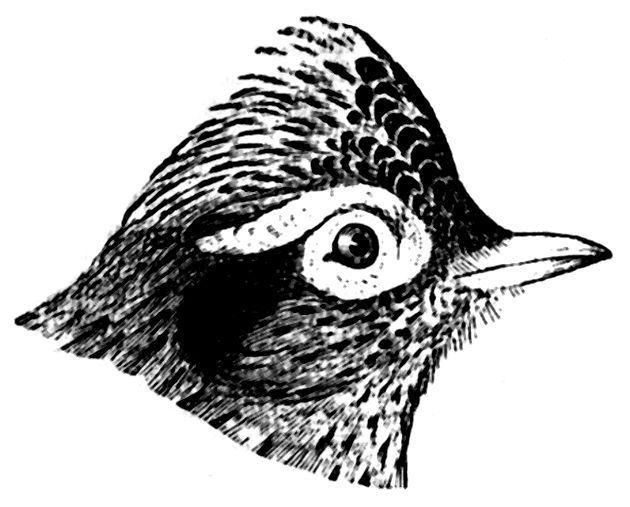
Black and white varieties of this bird occasionally occur: the plumage of the former is of a motley hue, with a tinge of dull red showing through; the latter is either pure white or yellowish. Specimens of this variety are sometimes found wild. In February or March these flocks break up, and soon after commences the work of incubation. The nest is generally built in a hole scraped in the ground, or a natural hollow between two ridges in a corn or hay-field. The Scottish poet, Grahame, thus describes it:—
“On tree or bush no lark is ever seen:
The daisied lea he loves, where tufts of grass
Luxuriant crown the ridge; there, with his mate,
He founds his lowly house of withered bents,
And coarsest speargrass; next the inner work
With finer and still finer fibres lays,
Rounding it curious with his speckled breast.”
And in this little fabric, which Macgillivray says is rather loosely put together, may be found four or five eggs, of a greenish gray colour, freckled and marked with grayish brown. There are generally two broods in the year, the first young appearing sometimes as early as the end of April; the second come out in June or July. They frequently leave the nest before they are fully fledged; and, therefore, should be taken for rearing in good time. They should be fed with white bread, soaked in milk, and crushed poppy seed; a few ants’ eggs conduce much to make them healthy. The males may be known by the yellow tinge of their plumage. In confinement they should have poppy seed, crushed hemp, barleymeal, and bread crumbs, with an occasional supply of green food, such as water-cresses, cabbage, lettuce, &c. A little lean meat, with ants’ eggs, now and then, by way of a treat, tend to make them lively, and more inclined to sing. Adult birds, introduced into the aviary, will become immediately reconciled if they have some oats and poppy seed thrown to them; afterwards they will do very well on the universal paste. Any air or melody which it is desired they should learn must be whistled to them before they are fully fledged, as the males commence practising their natural song very early. They must also be kept separate from other birds while under this system of tutelage. Naturalists say that adult larks will sometimes acquire the song of the chaffinch and nightingale. Larks are subject to the ordinary maladies which afflict birds, and are especially liable to yellow scurf about the beak; generous diet, such as ants’ eggs, meal worms, with green food, and universal paste, are most likely to cure this. These birds will live eight or ten years in confinement. We have heard of instances of extreme longevity; as many as thirty years being mentioned.
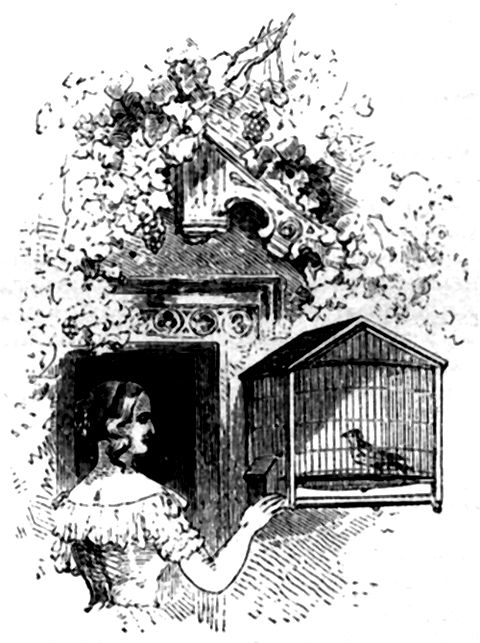
They require a cage at least a foot and a half long, nine inches wide, and fifteen inches high; the shape is immaterial, and it is best to cover the top with cloth, as the birds have a habit of springing upwards, especially when they are at all wild, and so may injure themselves. Their food and drinking vessels should be of glass or porcelain; a piece of fine turf, renewed at least once a week, should be placed in the bottom of the cage; and great attention should be paid to cleanliness, as, if the feet get dirty, they are apt to acquire disease.
CHESS. The game of chess is played by two persons upon a board which is square, divided into sixty-four smaller squares. One-half of these sixty-four squares is coloured white; the other half black. The two players sit opposite each other, with the board between them; and care must be taken that a white corner square be at the right-hand of each player. When the board is thus placed, the horizontal straight lines, running from right to left, are termed ranks; the perpendicular ones, running from one player to the other, are called files; the oblique ranges, of which the two principal ones run from one corner of the board to the opposite one,—one on white, the other on black squares,—and the other adjoining, are named diagonals.
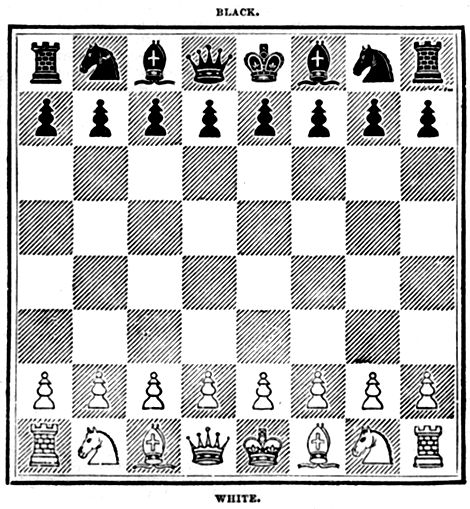
The names of the eight pieces are as follows:—King, Queen, two Rooks or Castles, two Bishops, and two Knights. These are placed in the first rank of each player’s side of the board, the Pawns being placed before them in the second rank. The pieces are arranged in the following manner:—In each corner square stands a Rook, or Castle, next to these a Knight, a Bishop, and the two middle or centre squares are occupied by King and Queen, so that the White King always stands on a black square, and the Black King on a white square, the Queen standing on a square of her own colour, Regina servat colorem. The diagram represents the board and men, neither side having made a move yet.
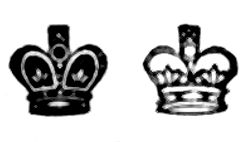
King.
Movement of the Pieces and Pawns. The King can move in any direction, but only to a square adjacent to the one he occupies. He can also capture any adverse man that comes near him, unprotected by any other piece or Pawn; but he cannot place himself on any square which is attacked by an adverse man, for the King is the only piece that is never taken; he is the soul of the game, and a player may have all his men, and being checked (the meaning of which will be explained hereafter), without being able to remove the attacking or checking man, he is checkmated—that is to say, the game is lost. Though the King can only move one square at a time, there is one exception to this rule, which is only permitted once in a game, that is, the act of castling. For this a player has two choices; he may castle to the right or to the left. This is done by moving the King two squares in either direction towards the Rook with which he castles, and placing the Rook on the other side of the King on the square next to him. For instance, supposing white to have his two Rooks in each corner, and the King on his original square, the King can castle on the left, which is called his Queen’s side; or on the right, termed the King’s side. In the former case he would be placed on the square originally occupied by a Bishop, and his Queen’s Rook would have to stand on his Queen’s square; in the latter he would be moved to a square where his Knight stood, and his Rook would occupy the square of his Bishop. There are, however, certain conditions attached to the privilege of castling. 1. You cannot castle after having moved your King, or the Rook, with which you wish to castle. 2. There must be no piece between the King and the Rook, whether your own or your adversary’s. 3. You cannot castle while in check, nor to a square where the King would be in check; nor can the King castle, if, in doing so, he passes a square which is attacked by an adverse piece or Pawn. The two Kings cannot, of course, come close to each other, but must have at least one square between them.
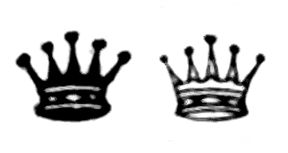
QUEEN.
The Queen is by far the most powerful of all pieces, combining the action of the Rook and the Bishop. It moves in a straight line, rank or file, backwards and forwards, and also diagonally, but only over empty squares, like all other pieces, except one. Place a Queen on the empty board, on the fourth square, counting from the King’s square upwards; and thus placed in the centre of the board, she will be found to bear upon twenty-seven squares, exclusive of the one she occupies. Placed in one of the four corners, where her action is most limited, she will still command twenty-one squares besides the one she stands on.
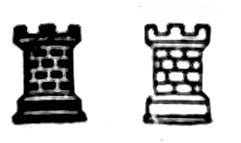
ROOK.
The Rook, also called the Castle, is next in importance to the Queen. She moves in a straight line, backwards or forwards, or sideways, always over empty squares. It is a peculiarity of this piece, that, whether it is placed in the middle of the board, or in a corner, it always commands the same number of squares, fourteen, besides the one it stands on.
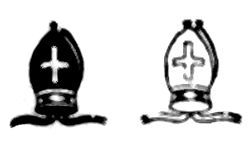
BISHOP.
The Bishop moves diagonally, backwards and forwards, as far as the squares are empty. It never can change its colour; and as each player has two, they are placed, one on a black square, and the other on a white one, the former called the Black Bishop, the latter the White Bishop.
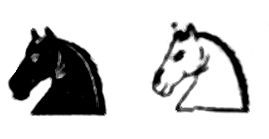
KNIGHT.
The move of the Knight is very peculiar, and difficult to describe. The Knight is the only piece that has the privilege to leap over another piece. It moves one square in a straight line, and one obliquely. Thus, for instance, the White Knight, which at the beginning of a game stands to the right of the White King (see diagram), can at once be moved to the third square of the Bishop, or to the third square of the Rook, thus springing over the intervening Pawns. This movement, being of a complicated nature, should be practised carefully by the student.
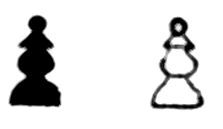
PAWN.
The Pawn moves only in a straightforward direction, one square at a time; but, unlike the pieces, which take an adverse man in the same way they move, the Pawn captures diagonally. It never moves nor takes backwards. Any Pawn can, on starting from its original place, which, as the diagram shows, is the second rank, make two steps, but, in doing so, cannot capture an adverse man, but is liable to be taken in passing the intermediate square by an adverse Pawn, but not by any piece or officer. For example:—your opponent, playing the black, has a Pawn of his on the fourth square, counting upwards from your Queen. You advance your Pawn in front of your King two squares; he has the option of either allowing it to pass or to take it with his Pawn, as if you had moved it only one square, and in thus capturing your Pawn in passing, he must place his own on the third square from your King—not on the fourth.
On Taking an Adverse Man.—The art of capturing an adverse man is by removing it from the board and placing your man on the square which the captured piece or Pawn occupied. All the eight men standing in the first rank of the board take in the same direction in which they move; not so the Pawn, which, as stated above, captures diagonally. Any of your men can be captured by an adverse one, except the King: he is never taken, but checkmated. The King being, as before mentioned, the soul of the game, each player directs his efforts towards attacking the adverse King, and carefully surrounding his own by his officers and Pawns. Any piece or Pawn attacking the adverse King, this is called giving check or checking, and such an attack must be notified by saying, check; whereupon your opponent must attend to this immediately, by either capturing the man that thus attacks or checks him, or by interposing some of his men between the checking-piece and his King, or lastly by removing his King to another square. But, should you be unable to get out of check by either of the above ways, then your King is checkmated,—that is, you have lost the game. Capturing is optional in all cases save one—when your King is in check, and you incapable to move out of check, except by taking the Pawn or piece that checks, you are obliged to do so.
ALIQUANT PARTS. Numbers which will not divide or measure a whole number exactly. Thus, seven is an aliquant part of sixteen. (See Aliquot Parts, p. 173.)
MEALY AND WAXY POTATOES. An examination of the potato with a microscope has proved the relative worth of the mealy and waxy kinds of this useful vegetable. On examining a thin slice, it is seen to be almost entirely composed of cells, which are sometimes filled with, and sometimes contain clusters of, beautiful little oval grains. These grains remain unchanged in cold water; but when it is warmed they dissolve in it, and the whole becomes a jelly, and occupies a larger space than it did in the form of grains. When a potato is boiled, then each of these cells of which it is composed becomes a little vessel full of jelly; and, if there be not a great quantity of starch in the cells, it may be gelatinized without bursting them. But, if the number of grains or their size be very great, the cells of the potato are broken on all sides by the expansion of the little masses of jelly, and the appearance of mealiness is produced. Hence we see that mealy potatoes are the most valuable, and waxiness denotes a deficiency of starch or nourishing matter.
MOTHER-OF-PEARL. This is the hard, silvery, brilliant, internal layer of several kinds of shells, particularly oysters, which is often variegated with changing purple and azure colours. The large oysters of the Indian seas alone secrete this coat of sufficient thickness to render their shells available to the purposes of manufactures.
CORK. Cork is the exterior bark of a tree belonging to the genus of the oak, and which grows wild in the southern parts of Europe, particularly France, Spain, Portugal and Italy. When the tree is about twenty-six years old, it is fit to be barked, and this can be done successively every eight years. The bark always grows again, and its quality improves with the increasing age of the tree.
EMERY. This substance is the most powerful for grinding down surfaces, from the extreme hardness of its particles, which are harder than sand. It is a variety of corundum, the hardest known substance except diamond. It comes from the Isle of Naxos in the Archipelago.
LIQUIDS (DECANTING, STRAINING, AND FILTERING OF). The decanting of liquids is, under ordinary circumstances, an operation sufficiently simple to require no explanation; but the ease and certainty with which it can be performed depend entirely upon the form of the vessel from which the liquid is poured, the adhesion existing between liquids and solids giving rise to a tendency in the former to run down the outside of the vessel; and, if the latter is nearly full, or very large in circumference, or the sides approach the perpendicular direction, this accident almost always occurs. The difficulty of returning a glass of wine to the decanter, or of pouring from one full tumbler into another, are well-known examples of this inconvenience.
Advantage may, however, be taken of the adhesion of liquids to solids, and by it the former may be led into the required direction. This cannot be better illustrated than by a description of the means by which a glass of wine may be returned, without spilling, to the decanter. If a teaspoon is dipped into the wine, so as to become wetted with it, and then held perpendicularly with the bowl downwards, and the point over, but not touching, the entrance into the decanter, and the edge of the glass be made to touch the back of the spoon, it will be found, on inclining the former, that the wine, having a perpendicular solid body to adhere to and run down, will do so in preference to trickling along the oblique outer surface of the wineglass; and, in this mode, a liquid may be poured steadily out of any similar vessel with so little disturbance as not to agitate any sediment that may exist in it. In the laboratory of the chemist, a piece of glass rod is usually employed for this purpose; but a spoon, or pencil, or any similar substance having a surface capable of being wetted by the liquid, answers well.
If, however, the vessel out of which it is wished to decant is large, very full, or the sides, on pouring, are nearly perpendicular, the plan is not successful; thus, it could not be employed in aiding the transfer of the liquid from one full tumbler to another. Even this may be accomplished without the aid of a funnel, or without spilling, by preventing the adhesion of the liquid to the edge or side of the vessel out of which it is poured, which may be readily done by greasing the rim, when it will be found quite practicable to pour out of a nearly full tumbler without spilling.
In many instances, the employment of a syphon in decanting will be found very advantageous, particularly when the containing vessel is large, and cannot be readily moved, or when there is any sediment which it is desirable not to disturb. The most simple form of this instrument consists of a tube, bent as in fig. 1, with one leg shorter than the other; this may be made of glass, pewter, or, in fact, of any kind of stiff tubing that will retain its form—a piece of gutta-percha pipe, carefully bent by a moderate warmth, whilst a piece of stout cord is in the interior to prevent the sides closing together, answers very well. Before use, the syphon must be filled with liquor; this is best accomplished by turning it upside down, with the opening to the short leg raised on a level with that of the long one, when the liquid should be poured into the former.
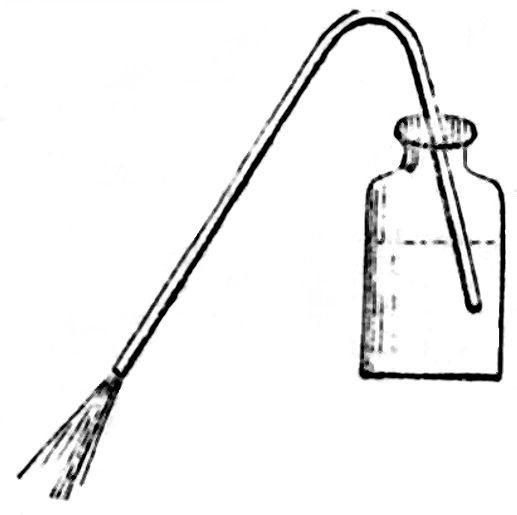
Fig. 1.
When both legs are filled, they should be closed with the fingers; the shorter leg introduced into the liquid it is wished to draw off; and the opening of the longer leg brought to a lower level than that of the shorter, and on removing the fingers, the liquid will flow as in fig. 1, until it is below the level of the short leg. If the syphon is made of small tubing, or is lessened at the openings so as not to exceed a quarter of an inch in diameter, there will be no occasion to close the end of more than one leg with the finger, as the liquid will not flow when it is brought to the proper position, unless both orifices are open; and thus the necessity of plunging the finger into the liquid is obviated, and the syphon can also be used with a narrow-necked bottle, into which the hand could not be passed.
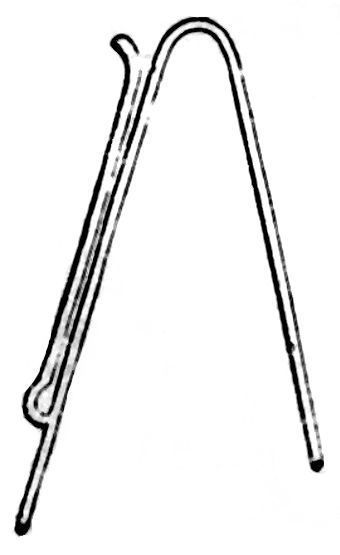
Fig. 2.
To do away with the necessity of filling the syphon before use, the instrument is usually made with a sucking tube, as in fig. 2; in this case, all that is requisite is, to introduce the short leg, close the opening to the long one, and, by the action of the mouth, draw up the liquid until both legs are full, when, on removing the finger, the stream will flow. A very ingenious syphon of this kind is described by the German chemist Mohr; it is thus constructed:—Take a long Eau-de-Cologne bottle, and with a file and turpentine, make a deep notch across, about an inch and a-half from the bottom; then, with a charcoal point or pastile, or hot iron, produce a crack, and cut off the bottom, grinding it smoothly; then take a tube bent at an angle of forty-five degrees, and, by means of a good cork, perforated with a rat-tail rasp, fit it tightly in the bottom of the bottle, and add also another piece of tubing for the suction tube; the whole will then have the appearance represented in fig. 3, and will form an exceedingly useful and very convenient syphon.
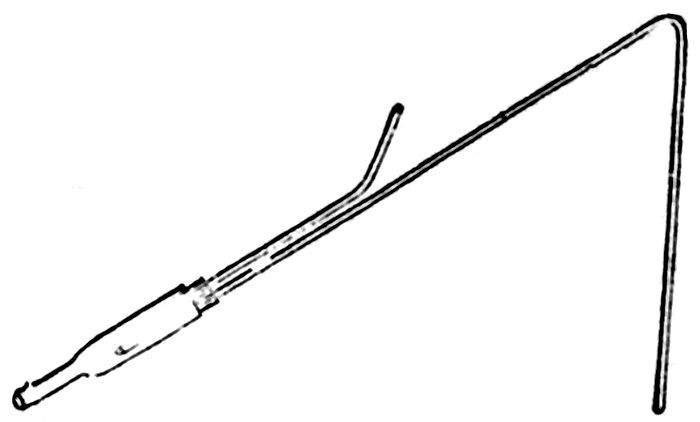
Fig. 3.
In emptying large stone bottles or carboys, the following plan may be had recourse to:—Perforate a sound cork with two openings by a rat-tail rasp, and fit, air-tight, two tubes bent as in fig. 4.
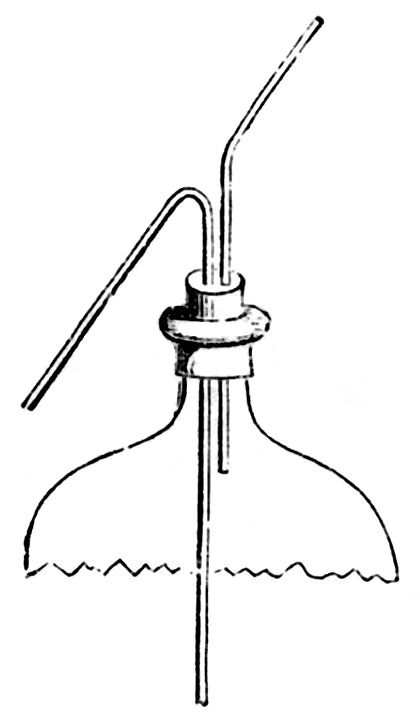
Fig. 4.
On blowing through the upper, the liquid will be forced to ascend and run over the bend of the other, which will then act as a syphon. This plan is exceedingly useful in emptying carboys of corrosive liquids, as oil of vitriol, &c.; and if all the joints are—as they should be—air-tight, the flow may be arrested by closing the upper tube with the finger. In the figure, the outer leg of the syphon is shortened, to save space; in practice, it must be of sufficient length to be lower than the inner leg within the vessel.
If a syphon is required frequently for decanting the same kind of liquid, it is found troublesome to be constantly filling it before each time of using; this trouble is obviated by the use of an instrument formed with legs of equal length, which are turned up at the ends, as in fig. 5; this, having been filled, may be hung up in the erect position, and the liquid will not escape; but, on plunging one end into a liquid, it will be found immediately to flow from the other, provided that the latter is below the level of the surface of the liquid.
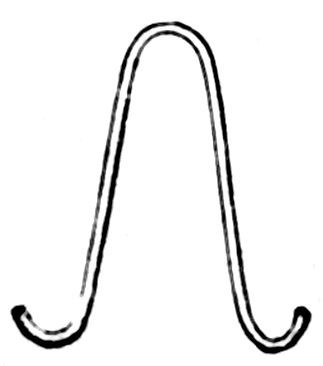
Fig. 5.
Straining and Filtering. The operations of straining and filtering are frequently required in domestic manipulations, and the apparatus employed usually consists of sieves and a jelly-bag. As in many other instances, it will be found advantageous to import several contrivances from the laboratory to the kitchen. One of the most useful (because most simple) strainers consists of a square frame, formed of four pieces of wood nailed together at the corners, with a piece of calico, linen, or canvas, of suitable fineness, tacked to the four sides. This strainer is particularly useful in separating any solid substance—as the residue in making wines; or if grated potatoes are put on one made of coarse cloth, the starch can be readily washed through, leaving the useless portion on the strainer; the cloth should not be tacked very loosely, as it bags down when any substance is put on it, and the liquid runs away below from the centre. This strainer is a most useful one; it is readily made, of any degree of fineness, and of any size; and it also possesses the great advantage, that, if necessary, the tacks fastening the cloth can easily be withdrawn, when the substance remaining can be rolled up in the cloth, and tightly squeezed, to express the last portions of liquid, which are frequently the most valuable.
In cases where a finer filtration is required than can be obtained by means of a cloth, as in cleaning turbid wine or spirit, the use of filtering-paper is recommended. This paper is merely a stouter kind of blotting-paper, thick varieties of which answer very well for domestic purposes; it is most simply used by taking a square piece, folding it into half—by bringing the two opposite edges together—and then folding the oblong so obtained across its length. By this means a small square is obtained, one quarter the original size, which may be opened into a hollow cup, having three thicknesses of paper on one side, and one on the other; this is to be placed, with the point downwards, in a funnel, and the liquid poured in; and as soon as the pores of the paper are expanded by the moisture, it will be found to flow through perfectly clear. Care must be taken, in making the filter, not to finger it much where the two foldings cross each other, as a hole is readily made at that part, and the filter spoiled. The objection to this simple contrivance is, that from its flat sides applying themselves closely to those of the funnel, the flow of the liquid is impeded, and is therefore slow. This effect may be obviated by the use of the plaited filter, the construction of which we will endeavour to describe. A square piece of filtering or stout blotting-paper, is to be doubled, and the oblong so obtained is to be again folded in half, when, if the last fold is opened, it will have the appearance of fig. 6.
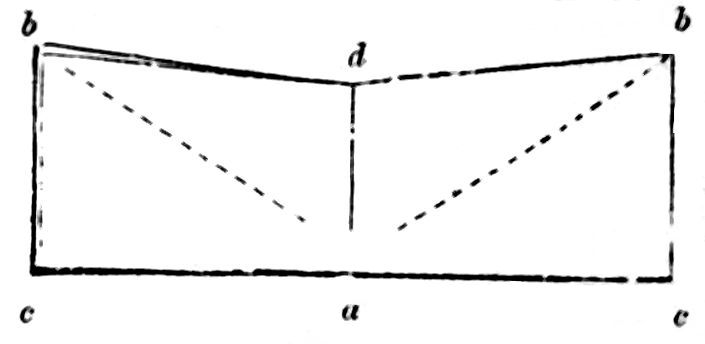
Fig. 6.
From the corners, b b, folds are to be creased in the direction towards a, but not reaching it for half an inch; these are indicated by the dotted lines, which divide the double paper into four triangles, each of which is to be again folded into eights; and care must be taken that all the folds are made the same way, that is, projecting to the same side of the paper. When complete, the doubled and creased paper will appear as fig. 7.
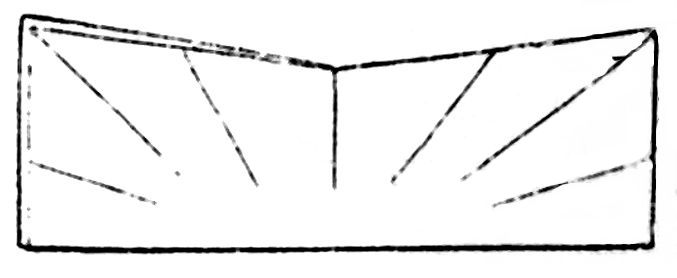
Fig. 7.
Now divide each eighth into half, by a fold in the opposite direction to those previously made, when it will be found that the whole will readily fold up like a paper fan. The projecting loose ends which are formed by the corners b, should be cut off, and the double sides separated for the first time by blowing them apart, when the whole may be readily opened out as in fig. 8.
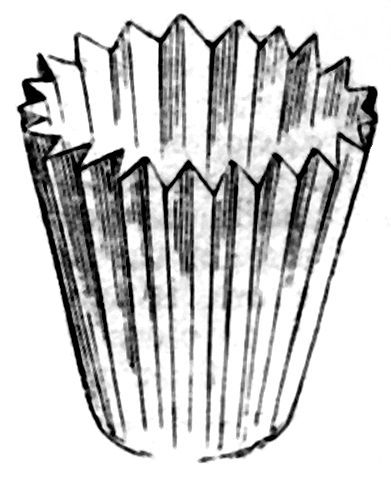
Fig. 8.
In making this filter, which takes much less time than to follow the description, two precautions are requisite. The folds should be made at once with one firm pressure, and not with a series of rubbings; and all the creases should stop short of the middle, otherwise a hole will be made at that point long before the filter is completed. The advantages of this filter are, that it exposes a large surface for the liquid to pass through; and from its only being in contact with the funnel where the angles project, the current flows away readily.—Practical Housewife.
WRITING AND CONVERSATION (MODES OF ADDRESS IN). There are many who well know how to use the pen as far as handwriting is concerned, but when they are called upon to address their superiors in life, they are quite ignorant as to the proper and polite mode; and having seen much perplexity manifested from not knowing how to accomplish this art, we shall enter somewhat largely on prescribed forms of superscription.
The Baronetage. This order, instituted by King James I., 1611, is said to have been suggested by the minor barons, so called, to distinguish them from the great barons, though both barons by tenure; the one retaining their territorial possessions, the other having alienated them. The title is, however, of very ancient standing, both in England and France, and was used in the former for banneret, when it was meant to designate a knight-banneret, who had the privilege of sitting in parliament. When this hereditary order was instituted, or revived—for we read concerning knights going forth in quest of adventures as far back as the feudal times—it happened that a rebellion raged in the northern province of Ireland, and it was therefore deemed expedient that each newly-created baronet should, after the example of the ancient knights, who rendered due service to the king, pay into the exchequer a sum of money adequate to the maintenance of thirty soldiers for three years, at eight-pence per day; this sum, increased by fees, amounted to nearly twelve thousand pounds. It was required further, that the candidate should be a gentleman by birth, and in possession of a clear estate or one thousand per annum. The word “Sir” is affixed to the Christian name of a baronet, as it is used before that of a simple knight; and his wife is entitled “Lady,” “Madam,” or “Dame,” according to the custom of speaking. Baronets and their heirs male, have place in battle near the royal standard, which they are bound to defend. Baronets lose all distinction of rank when they sign their names; even the “lordly line of high St. Clair,” being simply baronets, affix merely their Christian names. A letter to a baronet is superscribed—“To Sir X. Y., Baronet, or Bart.;”—to a knight, “To Sir A. B.”
Barons by Letters Patent. The king, in olden times, used to invest a newly-created baron in open parliament; and so late as the time of King James I., that monarch, in person, solemnly enrobed each peer in scarlet, with a furred hood; but in the same year it was determined to discontinue these ceremonies in future, the delivery of letters patent being deemed sufficient. Barons, when addressed officially by the crown, are styled, “Right trusty and well-beloved.” Letters sent to them, by private persons, must bear a superscription as follows:—“To the Right Honourable.” (For a baron’s coronet, see p. 141.)
Viscount. The next grade in the ascending scale towards the highest estate of the realm, is that of vicecomes, or viscount, which title was formerly applied to the sheriff of a county, but was not used as a designation of nobility before the reign of Henry VI. A viscount is uniformly created by patent, and descends from father to son, unless especially provided against. The honour was originally conferred as an advancement to barons; but afterwards created frequently with the barony; and, in modern times, it has been conferred on private gentlemen, as a reward for distinguished services. Thus, for example, Viscount Sidmouth, Viscount Leinster, Viscount Goderich, Viscount Exmouth, &c. Viscounts are addressed by the crown as “Our right trusty and well-beloved Cousins.” Letters to them bear the superscription—“To the Right Honourable Viscount A. or B.” The sons and daughters are simply “the Honourable.”
Earl. The dignity of earl, which existed in this country previous to the time of William the Conqueror, was originally annexed to a particular piece of land, and comprised three descriptions of earldoms. First—pertaining to an entire county, in which case the county became palatine, or the possessor of royal privileges. Secondly—derived only from a county, but without the privilege of holding high courts, and offices of justice, and without any possessions; and with revenues arising solely from participating in profits derived from the pleas of the county court. Thirdly—a kind of earldom constituted by a grant of land from the crown. The titles in each are often taken, not only from towns or counties, but from private estates, or villages, and family surnames. When officially addressed by the crown, earls are termed “Our right trusty and right well-beloved Cousin.” This mode of address was first adopted by Henry IV. The king being either by his wife, his mother, or his sisters, actually related, or allied to every earl in the kingdom, constantly acknowledged that connexion in all his letters, and other public acts; from whence, according to Blackstone, the usage has descended to his successors on the British throne, though the same reason does not exist. An earl, on some special occasions, bears also the title of “Puissant Prince.” When addressed by letter, as follows—“To the Right Honourable the Earl of ——” The eldest sons of Earls are Lords; the sisters also have the title of Ladies. (For Coronet, see p. 160.)
Marquis. A marquis (marchio), is the next degree of nobility. His office, formerly, was to guard the frontiers and limits of the kingdom, which was called the marches, from the Teutonic word marche, a limit; as in particular were the marches of Wales and Scotland, before those countries were annexed to England. The persons who guarded the frontiers were called Lords Marches, or Marquises; their authority was abolished by statute in the time of Henry VIII. as no longer necessary. Ruins on the borderlands still attest the power and extent of those strongholds, where lords of the marches presided in nearly regal splendour. Such is Ludlow Castle, on the borders of Wales, amid scenes of sylvan beauty, where Milton wrote his “Comus,” and among whose fields and woods he laid the scene of that inimitable poem. The first English marquisate was conferred by King Richard II., in 1386, upon Robert de Vere, afterwards created Duke of Ireland; the second creation occurs in the same reign; after which, the dignity remained dormant till the reign of Edward VI., but thenceforward it became a regular and common grade of nobility. His official address is “Our right trusty and entirely-beloved Cousin.” He also bears the title, on some occasions, of “Puissant Prince.” His sons are Right Honourables, and Lords; his daughters Right Honourables, and Ladies. The style of a Marquis is “Most Honourable.” If addressed by letter, the direction should be as follows:—“To the Most Honourable the Marquis of ——.” (For a marquis’ coronet, see p. 157.)
Duke. The dukedom, the most elevated dignity in the British peerage, was first introduced by Edward III., who created his eldest son, Edward the Black Prince (so called on account of his sable armour), Duke of Cornwall, and subsequently Prince of Wales; when the dukedom merged in the principality, and has ever since been vested in the heir-apparent to the throne, who, at his birth, becomes Duke of Cornwall. A duke is officially addressed by the crown, “Our right trusty and right entirely beloved Cousin and Councillor.” He is also entitled upon some occasions, “Puissant Prince.” All letters to him are thus superscribed:—“To His Grace the Duke of ——,” or “To the Most Noble the Duke of ——.” His sons are Right Honourables, and Lords; his daughters Right Honourables and Ladies. Thus, in addressing them by letter—“To the Right Honourable Lord A. or B.” The sons of a royal duke are, however, styled princes. In writing to a duke or marquis, it is usual to distinguish him from nobility of minor rank by using the words, “My Lord Duke,” or “My Lord Marquis.” In writing to an earl, a viscount, or a baron, you simply say “My Lord.” In like manner, an archbishop who takes precedence of a duke, and is “His Grace,” is addressed by letter in no other form than simply “My Lord” You give him, and a duke, the title of “Grace” at the termination of the letter, when you say, “I remain, my Lord, your Grace’s most obedient, &c.” To all others, the marquis included, you simply say, “Your Lordship’s most obedient,” &c. And yet, notwithstanding such high-sounding titles are addressed to different orders of nobility, and as if the simple word “Sir” was after all the highest title of respect, the term “Sire,” which is precisely the same word as “Sir,” or “Sieur,” in its original meaning, exclusively belongs to the king. He stands alone at the apex of society, and hence to him is assigned, as by right, an appellation signifying lord, or master. (For a duke’s coronet, see p. 153.)
The addition of squire, after a surname, formerly belonged solely to a man of considerable landed property, next in rank to a knight; to an attendant on some noble warrior; or to one who had a place at court. Since the days of Shakspeare, who thus applied the word squire, it has been very generally appropriated, and is now given as a term of courtesy, to every one who holds a respectable position in society.
The word “gentleman,” on the contrary, is more restricted; it pertains to persons of good and honourable birth. In reference to which, and the great changes that take place in society, are the verses of an old song, which we quote from memory:—
“The king can make a belted knight,
With banner bold, and spurs so bright,
All meet for tournament or fight—
But not a gentleman.”
According to rules established in the Herald’s Office, a person is entitled to the rank of gentleman, whatever may be his condition, or however dispossessed of broad lands and ancestral homes, who can show a coat of arms for five generations.
Spiritual Peers. Archbishops have the ducal title of “Grace,” and take precedence of all dukes, next to those of royal birth. The Archbishop of Canterbury ranks as first peer of the realm, and the Archbishop of York as third, coming immediately after the Lord Chancellor. His Grace of Canterbury styles himself “by divine providence;” while the Archbishop of York, and the bishops, adopt the term “permission” instead of “providence.” Bishops are styled “Lords,” and “Right Reverend Fathers in God.” The wives of ecclesiastics are not designated by the titles of their husbands. “Reverend,” belongs to all clergymen under the rank of archdeacon. The archdeacon is addressed as—“The Venerable the Archdeacon ——.” The dean as—“The very Reverend the Dean of ——.” The bishop as—“The right Reverend the Bishop of ——.” The archbishop as—“The most Reverend the Archbishop of ——.” But the archbishop being equal in rank to a duke, his letters are addressed as follows:—“To his Grace the Archbishop of Y. or Z.” “Worship” is a title that belongs to magistrates and municipal corporations. The corporation of London is “right worshipful,” others are only “worshipful.” “Your Worship,” is a term addressed to a magistrate sitting in judgment; even a justice of the peace is entitled to this form of address, when engaged in official duties. The superscription of letters sent to ladies, follows the same rule as that which serves for gentlemen, merely changing the pronoun from him to her, thus—“To her Grace the Duchess of B.” The wife of a baronet or knight is styled “Lady.” A lady who derives the title of “Honourable” by descent, as the daughter of an earl or viscount, if marrying a private gentleman, is always addressed by her Christian name; thus—“The Honourable Charlotte de Courcy.” Whereas, the wife of a gentleman who bears the title of “Honourable” by virtue of birth, or some official situation, is addressed as—“The Honourable Mrs. C.” In writing to the Queen, the form of address runs thus:—“Madam, may it please your Majesty;” the superscription on the letter being uniformly—“To your Majesty.” It is presumed that her Majesty listens to the request of the petitioner; she is therefore feigned to be present, and being present, is addressed with the pronoun you. To write otherwise is an utter breach of etiquette.
INCLINED-PLANE. A natural mechanical power, which deflects a body aside, when moving perpendicularly towards the centre of the earth, by which the force towards the centre is modified. Its common application is to elevate bodies, which are raised perpendicularly while they are moved up the plane; and the force gained is as the increased distance moved over, that is, as the length of the inclined-plane is to the perpendicular height gained.
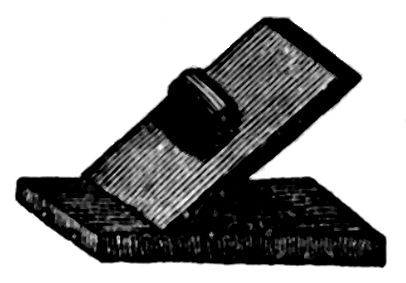
BEAVER. An interesting and intelligent animal, which builds substantial dwellings on rivers, and is hunted and destroyed by man for the down of which hats are made; but silk and fine wool are now substituted. The engraving represents a colony of these creatures in a sort of council, before they begin any work.
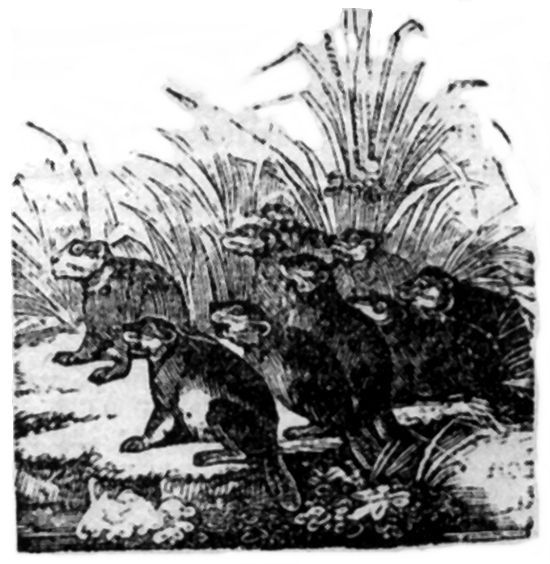
TRANCE. Magnetic sleep, or trance, has served at all times to perplex the world by the strange breach it seems to make between the bodily and mental functions, by its unexpectedness in some cases, and by the peculiar agency producing it in others. Dr. Holland observes that, “as respects magnetic sleep, or trance, in all its alleged shapes, there is no well-authenticated fact making it needful to believe that an influence is received from without beyond those impressions on the senses which are capable, according to the temperament and other circumstances, of exciting disordered as well as healthy actions, throughout every part of the nervous system, and especially in the sensorial functions.”
NEPTUNE. The god of the ocean, in the Greek mythology.
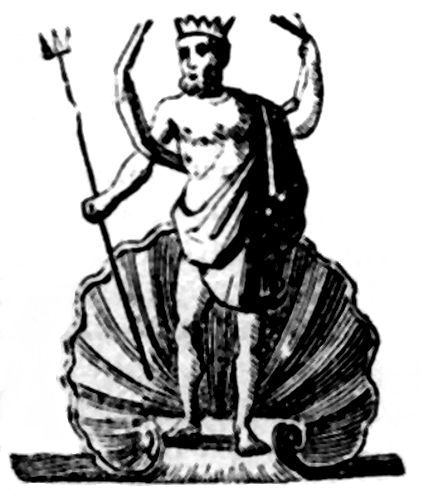
TRANSPARENT PAPER. Paper can be made as transparent as glass, and capable of being substituted for it for many purposes, by spreading over it with a feather a very thin layer of resin dissolved in spirits of wine. Fine thin post paper is best, and the mixture must be applied on both sides.
MAGNETISM. A phenomenon of the action and reaction of the gases which fill space, and to which the surface of iron presents a peculiar reaction. The plate represents the curved forms in which particles of steel-dust range themselves when sifted on paper laid over a magnet. There is no mystery in it, nor any fluid circulating, because every particle of the steel is to be regarded as a magnet with two poles; and it is found that if a considerable number of magnetized needles were placed round the same magnet, they would be directed into curves just like those of the steel-dust. The whole is a mere mechanical affection.
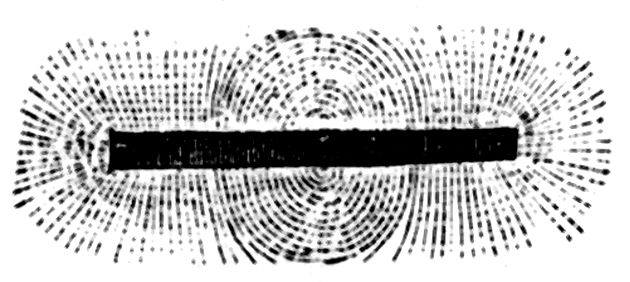
FIG-TREE. A tree which, in warm climates, produces delicious and nutritive fruit, and succeeds in England in warm situations, and against walls.
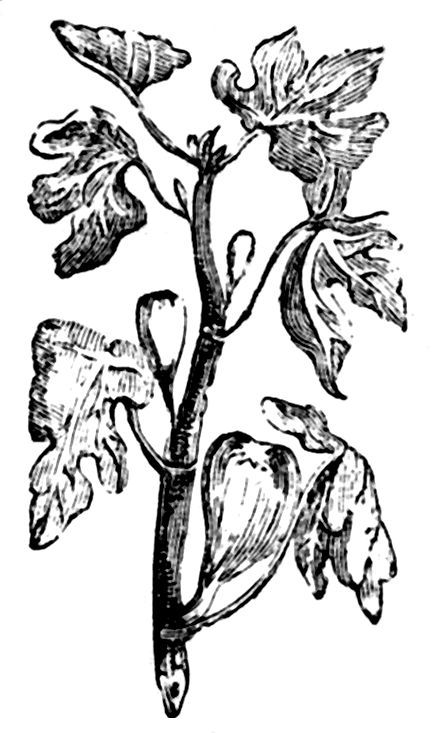
CHRISTIAN NAMES. Christian names are so called from their having originally been given to converts at baptism, as substitutes for their former pagan appellatives, many of which were borrowed from the names of their gods, and therefore rejected as profane.
LIGHT-HOUSE. A lofty building, erected on sea-coasts to warn and guide ships by night. They are very curious structures, consisting of an intense body of light, radiated by concave reflectors and convex lenses, sometimes coloured for distinction’s sake, and made to change and revolve as further means of distinction.
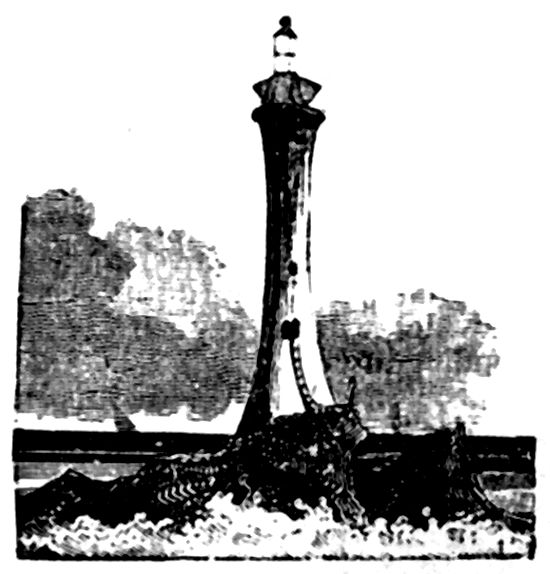
SKIN (DARK COLOUR OF THE). Darkness of complexion has been attributed to the sun’s power, from the age of Solomon to this day,—“Look not upon me, because I am black, because the sun hath looked upon me;” and there cannot be a doubt that, to a certain degree, the opinion is well founded. The invisible rays in the solar beams, which change vegetable colour, and have been employed with such remarkable effect in the Daguerreotype, act upon every substance upon which they fall, producing mysterious and wonderful changes in their molecular state, man not excepted.
ESSENCE OF FLOWERS (TO EXTRACT). Procure the petals of any flowers that have an agreeable fragrance, card thin layers of cotton-wool, which dip into the finest Florence or Lucca oil, sprinkle a small quantity of fine salt on the flowers, and lay them on a layer of cotton and a layer of flowers, until an earthen jar or wide-mouthed glass-bottle is full; tie the top close with bladder, then lay the vessel in a south aspect to the heat of the sun, and in fifteen days, when you uncover it, a fragrant oil may be squeezed out of the cotton mass altogether, which will be found little inferior to the celebrated otto of roses, if those flowers have been used.
FLOWERS (CLASSES OF). Flowers are commonly classed as bulbs, tubers, herbaceous perennials, biennials, and annuals. The first are chiefly, as well as a few of the tubers, spring flowers, and of course require to be planted in prepared beds, boxes, or pots, in the autumn, sooner or later, according to the place or purpose for which the flowers are wanted. Tulips, hyacinths, polyanthus-narcissus, are the principal bulbs; and together with crown-imperials, gladiolas, crocuses, snowdrops, scillas, &c., are all planted in autumn, sooner or later, according to the option or judgment of the manager. Of tubers, the anemone and ranunculus are the chief of the bed flowers; and when a succession of these are wished for, the tubers may be put into the ground at the end of every two months, which will bring their blossoms at corresponding intervals.
SNAILS. In France the snail is becoming a fashionable article of diet, and for some time past a particular place has been appropriated for their sale in the Paris fishmarket, in the south-east angle, near the lobsters and fresh-water fish. “Snails,” says one of the French journals, “were highly esteemed by the Romans, our masters in gastronomy, and are now raised in many of the departments with success.” In the sixteenth century, the Capuchins of Fribourg recovered the art of breeding and fattening snails, an art which is not lost in our day; for in Franche-Comté, Lorraine, and Burgundy, they raise excellent snails, which find a sure demand in the Paris market. There are now fifty restaurants, and more than twelve hundred private tables in Paris, where snails are accepted as a delicacy by from eight thousand to ten thousand consumers. The monthly consumption of this molluscan is estimated at half a million. The market price of the great vineyard snails is from 2f. 50c. to 3f. 50c. per hundred, while those of the hedges, woods, and forests, bring only from 2f. to 2f. 25c. The proprietor of the snaillery in the vicinity of Dijon is said to net over 7,000 francs annually.
WINE (HOW TO CHOOSE). Choose port wine which runs smooth on the palate, and is free from all heat and harshness. It should be soft as velvet, if for immediate consumption, and have none of that astringency which somewhat resembles Peruvian bark. In wines new from the country, this taste is sure to be perceptible; but if, after due care and keeping, it be found to remain on bottling, the wine is bad. Medical men have sometimes recommended port wine for this very quality; but it is a defect in the wine, and will not remedy by age. Some call it stalkiness. Flavours are not easily defined in their gradations by language—richness of flavour bordering upon sweetness; brightness of colour, hue neither purple, nor reddish, nor too deep; generous in taste, and what wine-merchants call fruitiness, are qualities with port-wine drinkers,—imitated in an adulteration with gerupega,—and what may be called oiliness, rather than dryness. Care must be taken that the wines purchased in bottle are of the right age, neither too green nor too slight. They should be clear and bright.
TOAST AND WATER. Cut a clean piece of bread about three inches square, and not quite half an inch thick; toasting it brown all over without burning it, and then put it into a pint mug filled with clean cold water, clapping a saucer over the top to keep the steam from escaping. In about ten minutes a pint of nice, cooling, and refreshing drink will be produced.
BREAD (ETYMOLOGY OF THE WORD). Bread is brayed grain, from the verb to bray, or pound; expressive of the old method of making the meal. Dough comes from the Anglo-Saxon word deawian, to wet, to moisten. Loaf is from the Anglo-Saxon lif-ian, to raise, to lift up—as raised bread. Leaven is derived from the French word lever, to raise, or the Saxon word lif-ian.
PASSING BELL. It is so called because the defunct has passed from one state to another, and it owes its origin to an idea of sanctity attached to bells by the early Romanists, who believed that the sound of these holy instruments of percussion actually drove the evil spirit away from the soul of the departing Christian. Durand, who flourished about the end of the twelfth century, tells us in his “Rationale,” “When any one is dying, bells must be tolled, that the people may put up their prayers; twice for a woman, and thrice for a man; if for a clergyman, as many times as he had orders; and, at the conclusion, a peal on all the bells, to distinguish the quality of the person for whom the people are to put up their prayers. A bell, too, must be rung when the corpse is conducted to church, and during the bringing it out of the church to the grave.” Shakspeare, in one of his poems, says:—
“Come list and hark, the bell doth toll
For some but now departing soul,
Whom even now those ominous fowle,
The bat, the night-jar, or screech-owl,
Lament; hark! I hear the wilde wolfe howle
In this black night that seems to scowle,
All these my black book shall enscrole.
For hark! still, still the bell doth toll
For some but now departing soul.”
MODELS. The first models were figures of living persons, and Dibutates, the Corinthian, was the inventor of those in clay. His daughter, known by the designation of the Corinthian Maid, being about to be separated from her lover, who was going on a distant journey, traced his profile by his shadow on the wall; her father filled up the outline with clay, which he afterwards baked, and thus produced a figure of the object of her affection, giving rise to an art till then unknown, about nine hundred and eighty-five years before Christ. One of the most surprising efforts ever achieved by human industry was that undertaken by General Pliffner, to model the mountains of Switzerland. It was begun in 1766, and completed in 1785, a period of nearly twenty years. Bonaparte was a patron and lover of this art, many admirable performances in which, as a reward to the artist, he purchased, weight for weight, according to their bulk, in silver or gold. On one occasion, a humble price of 400 francs being set upon a work, he erased the word francs, in lieu of which he inserted Napoleons, and directed them to be paid.
WATER. A fluid, of which a cubic foot weighs 1,000 ounces, or 825 times more than a cubic foot of atmospheric air; the constituents of which are one part, by weight, of hydrogen, and 7½ of oxygen; and two parts, by bulk, of hydrogen, and one of oxygen. It becomes solid at 32° of Fahrenheit, and boils or evaporates, and becomes no hotter, at 212°, though, by compression, it has been heated red-hot. When expanded in steam, at 212°, it acquires 1,800 times its bulk, and presses with the force of atmospheric air; at 226° it expands 9,000 times, and 36,000 times at 257°. A volume of ice is made fluid by as much excitement as will raise an equal volume of water 140°. Vegetables decompose it, the hydrogen forming their unctuous, resinous, and saccharine principles, in combination with the carbon of the soil; the oxygen being evolved by the leaves, and a supply thereby kept up of what is fixed by animal respiration and combustion. In the ocean, it is combined with 1-30th of its weight of muriate of soda, or sea-salt; but, as salt does not crystallize so soon as water, sea-water remains liquid till the thermometer is 3.5 lower than for other water. In like manner, the salt does not evaporate at the heat which vaporizes water, and, therefore, the two processes of crystallizing and evaporating separate the water from the salt. Hence, the clouds which rise from the sea, rain, fresh water, and water evaporated by art, yield salt in the proportion of one ton from 35 of water. In crystallizing, vacuities arise, which enlarge the bulk: hence, frozen water splits rocks and trees, and ice floats upon water. Water combines with iron, sulphur, lime, and various substances, under a great variety of names; hard water arises from carbonic acid in water which then combines with lime. Waters are called hard when they contain a salt which decomposes the soap instead of dissolving it. The deductions drawn, in regard to the decomposition of water, from the experiment of discharging a galvanic battery through water are erroneous; for the poles of the battery themselves produce the oxygen and hydrogen supposed to be produced by the water, being, in fact, the constituents of the solution lying between the plates, and identical with positive and negative electricity in all cases and circumstances. (See p. 18.)
PAPER-HANGINGS. A safe rule with regard to paper-hangings is to choose nothing that looks extravagant or unnatural; no staring pattern or colour, which would only be fit to make caps for May-day sweeps. Regard should be had to the uses of an apartment: a drawing-room should be light and cheerful, a parlour should look warm and comfortable without being gloomy: bed-room papers should be cool and quiet, and generally of a small pattern, and of such colours as harmonise with bed furniture and other fittings.
TRUFFLE BEETLE. Entomologists, who search carefully along the hedge-banks, athwart which innumerable spiders have thrown their elegant tracery, may chance to find the truffle beetle (Leiodes cinnamomea) feeding on the fungus from which he derives his name. Unlike many of his brethren, who delight in sunny months, and inhabit the loveliest flowers, the truffle beetle is found between the months of October and November, often, too, on windy and open downs as those of Wiltshire, Hampshire, and Kent, and bleak, and woodless tracts in Scotland, regardless of fierce winds, and formed of sleet, though small and delicately formed, and apparently ill-adapted to resist the extremity of cold.
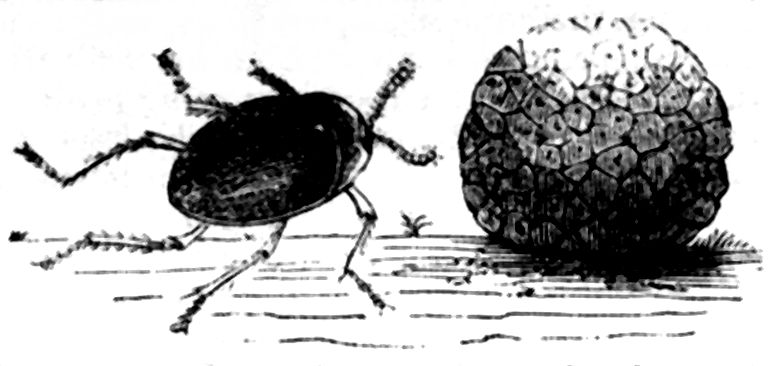
MENSURATION. The art of determining the square and cubic dimensions of superfices and solids, effected in superfices by multiplying the length by the breadth, and in solids by the further multiplication of the depth; figures when irregular being reduced to regular ones. Thus 4 dimensions one way and 3 another, give 12 squares, or 4 multiplied by 3.
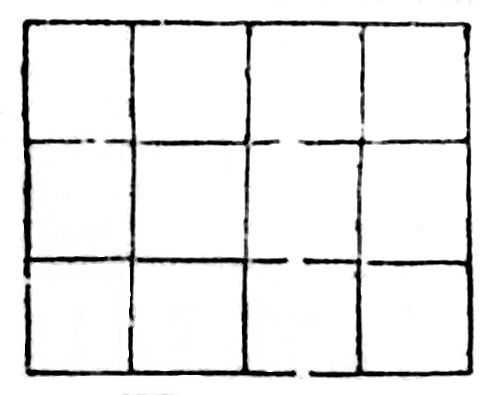
TRIANGLE. A figure having three sides and three angles, called right-angled, when two of the sides are perpendicular to each other, and oblique-angled, when not so. The three angles are equal to two right angles, the sides are proportionate to their opposite angles, and the sides of different triangles having equal angles are proportionate to each other. These principles are the foundations of trigonometry, and of much mathematical science, because all figures may be reduced to triangles; and it hence appears that every figure contains twice as many right angles less by four as it has sides, as 3 × 2 = 6 - 4 = 2, for a triangle; or 7 × 2 = 14, 4, or 10 right angles for an heptagon.
JACK. In mechanics, a very powerful engine, by which great weights are lifted in building, &c.
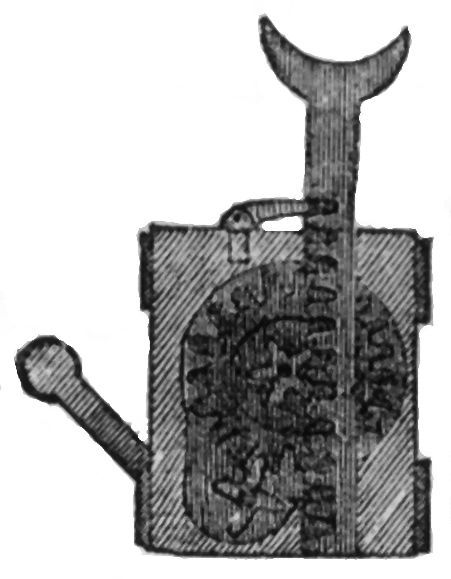
JACK. A very useful implement in kitchens, sometimes turned by the force with which smoke and rarified air ascend in a chimney. The Smoke-jack consists of a horizontal wheel, the radii of which are placed obliquely, so as to permit the smoke to pass through them; the axle then turns a small crank-wheel, which works into another at right angles, and at the end is a pulley with a chain to turn a spit set before the fire, with any article intended to be turned and roasted. Many jacks are, however, turned by means of a weight, which pulls round a cylinder, and thereby, with the intervention of a chain, rotates the spit.
BANK OF ENGLAND. This institution, which for centuries has exercised such an influence upon the commerce and wars of the world, was first projected by a merchant named Patterson. It was incorporated by William III. in 1694, when the whole of its capital was lent to Government. The profits of the company arise from the interest of the Government debt, their annual advances on Exchequer bills, and many other sources.
YANKEES. The term Yankee, applied to Americans, is said to have originated in the manner in which the native Indians of America pronounced the word English—they called the early settlers from Great Britain “Yengeese,” which corruption led to their being termed Yankees.
WATCH. A pocket instrument for measuring time, excited into action by a steel spring coiled up, and acting by various ingenious contrivances. The spring is in a brass box, called the barrel, and combined with a pyramidal fusee, on which a connecting chain is wound by the key. The spring being fastened at one end to the barrel, and at the other end to an arbor, or axle, unwinds off the fusee, turning it, and keeping the watch going, while the action accords by its various size with the varied energy of the spring. The force being thus produced, other wheels are put in motion, and time is exactly measured by the hands on the dial. Watches were invented about the year 1500, and are much esteemed in all countries. Watches are manufactured to a great extent at Geneva, and at Paris, and three or four other towns in France; in England, at Liverpool and Coventry. But it is in London where the art of watchmaking reigns with unrivalled sway, both in extent and perfection. The extreme variation in twelve months of two watches made in London, by the same artist, was only from nine-tenths of a second to 2″ 8 in a temperature varying from 82° to 39°, according to an official report made from the Royal Observatory at Greenwich.
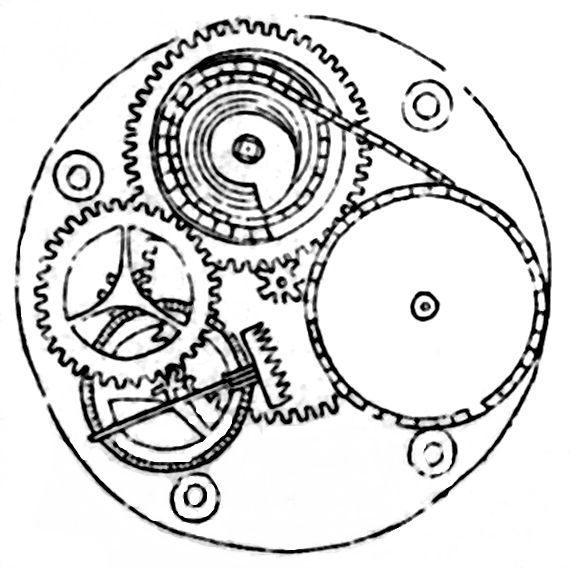
Wheels, &c. of a Watch.
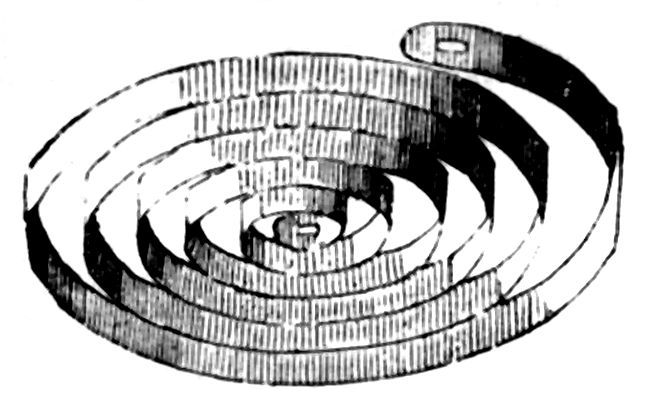
Spring of a Watch.
GAS (ECONOMY OF, FOR DOMESTIC PURPOSES). In situations where gas is to be obtained, it forms a ready, and, for some purposes, very economical means of obtaining heat; its economy does not arise from its cheapness compared with other means, but from the fact that it need not be lighted till the instant it is required, and can be as quickly extinguished when it has done its required duty. For heating any vessels containing liquids, especially if the heat is required to be only of short continuance, gas will be found extremely advantageous; a ring-burner, constructed as shown in fig. 1,
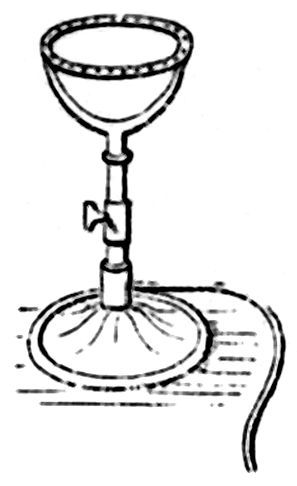
Fig. 1.
less than three inches in diameter, will quickly boil a gallon of water in a metallic vessel. Burners of this description are usually used in the laboratory, surrounded by a case made of sheet-iron or tinned plate, as fig. 2.
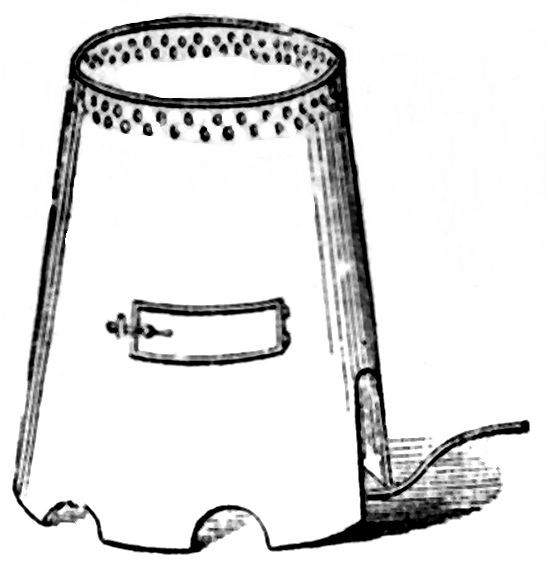
Fig. 2.
This serves to support the vessel to be heated, to steady the jets of flame, and to conduct every portion of hot air against the bottom; the door also gives a ready access to the burner for the purpose of lighting the gas.
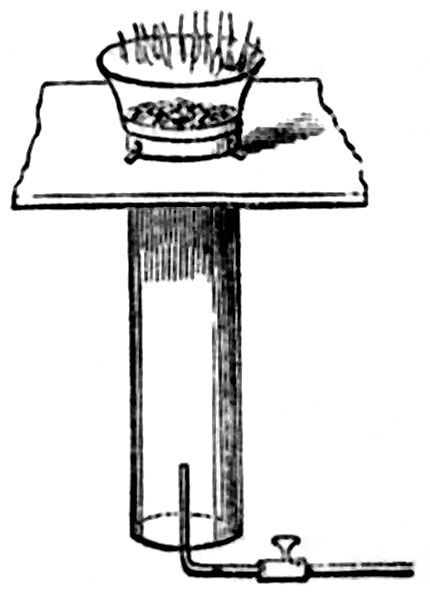
Fig. 3.
For the domestic use of gas in heating, there is no contrivance so useful as the following: a circular hole, from two to four or more inches in diameter, is cut in the dresser, through which is passed a sheet-iron tube, supported by three little elbows. This tube projects a few inches above the table, and about a foot and a-half below; its lower end is open, and into it projects a gas-pipe, furnished with a stopcock; the upper extremity is covered with a sheet of wire gauze, similar to that used for blinds, on which, as shown in fig. 3, may be placed some pieces of pumice-stone, surrounded and kept together by a broad ring—neither the pumice-stone nor the ring, however, are essential parts of the contrivance. The action of this arrangement is as follows:—When the gas is turned on it escapes from the pipe, rising through the tube, and mixing with the air contained within it; this mixture then escapes through the wire gauze, and may be lighted on its upper side, without passing through it to the gas below. The flame should be perfectly free from smoke, which indicates too much gas—should be pale, colourless, and not soil any bright metal placed in it. If the flame is in the slightest degree yellow, it will do this, and then the gas should be partly turned off; on the contrary, if there is not enough gas, the flame will be extinguished. When lighted, the pumice becomes red-hot, and throws out a great heat. When used in boiling, the vessel should be supported a short distance over the flame by a trevet; if it is made to rest on the top of the ring, and is sufficiently large to close it entirely, the current is stopped and the flame extinguished, whilst the unburned gas still escapes below. This contrivance is most useful, it is lighted in an instant, is perfectly free from smoke, and no unburned gas escapes; it throws out great heat; and may be employed to heat bright tools with much more convenience than a charcoal fire. The objections to its use are, that, in burning, it produces, as all gas does, a quantity of carbonic acid gas, deteriorating the air, and that the flame cannot be very much enlarged or diminished; so that if fires of different power are required, two or more of the contrivances must be put in order. Otherwise, the instantaneous action, small cost, great heating power, and cleanliness of the plan, strongly recommend it. In summer weather, in many small families, it can be made to dispense altogether with the use of a fire. By a little variation, the whole contrivance may be made to stand on the table like fig. 1. In this and other cases, vulcanized India-rubber will be found to form by far the best kind of flexible tube, being quite impervious, very durable, and excessively pliant. Those who wish to try the experiment of heating on this plan may readily do so by covering the top of the glass chimney of any common burner with a piece of wire gauze, folding it over the sides; the gas may then be turned on, and lighted above the gauze, after it has mingled with the air in the chimney; a small burner, however, does not afford sufficient gas for the purpose, and, there being too much air, the flame is weak and liable to go out.
GUN BARRELS (TO BROWN). Take of nitric acid, half an ounce; sweet spirit of nitre, half an ounce; blue vitriol, two ounces; tincture of steel, one ounce; mix all together in eight gills of water; apply this mixture with a sponge, then heat the barrel a little, and move the oxide with a hard brush. This operation may be repeated a third or fourth time, till you have the brown required; it is then to be carefully wiped and sponged with boiling water, in which there has been put a small quantity of potass. The barrel, being taken from the water, must be made perfectly dry, and then rubbed smooth with a burnisher of hard wood; afterwards heated to the height of boiling water, and varnished with the following varnish:—
Varnish for Gun Barrels that have Undergone the Process of Browning. Take of spirits of wine, two parts; dragon’s blood, powdered, three drachms; shellac, bruised, one ounce; dissolve all together. This varnish, being laid on the barrel, and become perfectly dry, must be rubbed with a burnisher to render it smooth and glossy.
AUTOGRAPHS (TO PRESERVE). The best plan to preserve autographs is to fix them in what is usually known as an invoice-book, in such a manner as to enable the collector to take them in and out at pleasure. The thin India-rubber thread may be used conveniently, running from corner to corner across the note or letter. The thread should be passed through a bit of card on the other side of the paper (to prevent the knot tearing the paper), and knotted. If the autographs are gummed or pasted, they cannot be removed without injury.
COINS (TO TAKE IMPRESSIONS FROM.) Procure tin or lead-foil, as thin as possible, place it on the coin, and with a pin’s head, or any small smooth instrument, work it into every part; then take it off, revert it into a shallow box, and pour plaster into its concave side. A durable plaster cast is thus obtained, covered with tin-foil, which will resemble silver.
MONTH. The calendar month is a twelfth division of the year. A solar month is the time in which the sun passes through a whole sign of the zodiac—it is 30 days, 10 hours, 29 minutes, and 5 seconds. A lunar month, or the period of one moon, is 29 days, 12 hours, 44 minutes, and 3 seconds. A civil month consists of a certain number of days, according to the laws and customs of different countries. In the year there are twelve solar months, and thirteen lunar months.
ZODIAC. A space round the heavens among the fixed stars, 15 degrees wide, the centre of which is the plane of the ecliptic, and it corresponds in breadth with the inclination of the sun’s axis of 70° 30′, which thereby produces a maximum of force in that plane of the medium of space, but expanding as it diffuses around. The distant stars within it are divided into twelve portions, called signs: six to the north of the earth’s equator, and six to the south; altogether fanciful, but referring to the business of the season, when first applied, though to these superstition has annexed whimsical influences. The names of these signs, their hieroglyphics, and the days on which the sun enters them, are as follow: Northern Signs—♈︎ Aries, the Ram, 21st of March. ♉︎ Taurus, the Bull, 19th of April. ♊︎ Gemini, the Twins, 20th of May. ♋︎ Cancer, the Crab, 21st June. ♌︎ Leo, the Lion. 22nd of July. ♍︎ Virgo, the Virgin, 22nd of August. Southern Signs—♎︎ Libra, the Balance, 23rd of September. ♏︎ Scorpio, the Scorpion, 23rd of October. ♐︎ Sagittarius, the Archer, 22nd of November. ♑︎ Capricornus, the Goat, 21st of December. ♒︎ Aquarius, the Water-bearer, 20th of January. ♓︎ Pisces, the Fishes, 19th of February. As we reckon the year by the earth’s motions, and the solar year is 50.25″ of a degree shorter than the sidereal, so the time when the sun is on our equator is earlier every year by 20′ 23″ of time; hence the equinoctial points recede among the stars; but as we always call the ascending point Aries, so the original stars go forward, and the equinoctial, with reference to them, recedes 50′ 25″ in a year; 1° 23′ 45″ in a century; a sign in 2,150 years; and the whole circle 25,791 years. It is, however, a mere change in relative appearances, and produces no mundane affection whatever.
GUM ARABIC. The purest and finest gum arabic is brought in caravans to Cairo, by the Arabs of the country round Mounts Tor and Sinai, who bring it from this distance on the backs of camels, sewn up in bags, and often adulterated with sand, &c. The gum exudes spontaneously from the bark and trunk of the branches of the tree, in a soft, nearly fluid state, and hardens by exposure to the air, or heat of the sun. It begins to flow in December, immediately after the rainy season, near the flowering time of the tree. Afterwards, as the weather becomes hotter, incisions are made through the bark, to assist the transudation of the juice.
WAX AND WAFERS. Francis Rousseau, a native of Auxerre, who travelled a long time in Persia, Pegu, and other parts of the East Indies, and who, in 1692, resided at St. Domingo, was the inventor of sealing wax. A lady, of the name of Longueville, made this wax known at court, and caused Louis XIII. to use it; after which it was purchased and used throughout Paris. By this article, Rousseau, before the expiration of a year, gained 50,000 livres. The oldest seal with a red wafer ever yet found is on a letter written by Dr. Krapf, at Spires, in the year 1624, to the Government at Bareuth.
SOAP-BUBBLE. A soap-bubble, as it floats in the light of the sun, reflects to the eye an endless variety of the most gorgeous tints of colours. Newton showed, that to each of these tints corresponds a certain thickness of the substance forming the bubble: in fact, he showed, in general, that all transparent substances, when reduced to a certain degree of tenuity, would reflect these colours. Near the highest point of the bubble, just before it bursts, is always observed a spot which reflects no colours and appears black. Newton showed that the thicknesses of the bubble at this black point was the 2,500,000th part of an inch! Now, as the bubble at this point possesses the properties of water as essentially as does the Atlantic Ocean, it follows that the ultimate molecules forming water must have less dimensions than this thickness.
BRIDE CAKE. Bride cake is used at weddings, because of its origin in confarreation, or a token of the most firm conjunction between man and wife, with a cake of wheat or barley, from far (Latin), bread or corn. Dr. Moffatt tells us, that “the English, when the bride comes from church, were wont to cast wheat upon her head.” Herrick says, speaking to the bride:
“While some repeat
Your praise, and bless you, sprinkling you with wheat.”
BULBOUS ROOTS. The time to put these in is from September to November, and the earliest ones will begin growing about Christmas. The glasses should be blue, as that colour best suits the roots; put water enough so as to cover the bulb one-third of the way up, less rather than more; let the water be soft, change it once a week, and put in a pinch of salt every time you change it. Keep the glasses in a place moderately warm, and near to the light. A parlour window is a very common place for them, but is often too warm, and brings on the plants too early, and causes them to be weakly.
KNIGHTS of the Garter, Bath, Thistle, and St. Patrick, are installed members of those orders entitled to wear stars and ribands, and are limited in number. All Knights Bachelors, or Knights of Foreign Orders recognized in the “London Gazette,” bear the title of Sir, and their wives that of Lady. The engraving represents an ancient Knight in his armour. (See Knighthood, p. 129.)
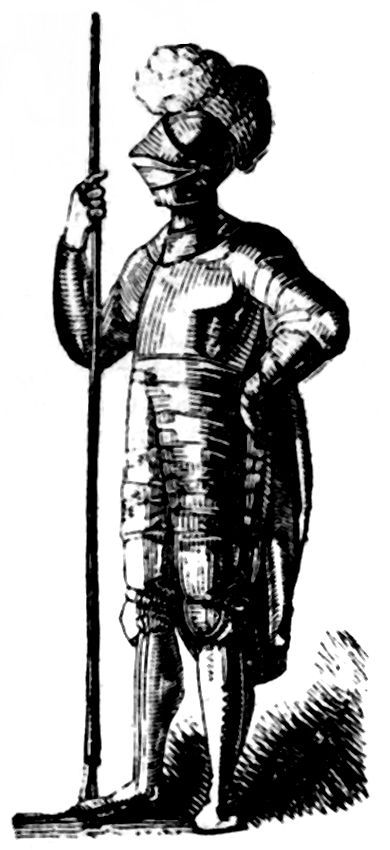
DEATH’S-HEAD HAWK-MOTH. That beautiful creature is the bee-tiger, or death’s-head hawk-moth (Acherontia atropos), frequently seen during the month of September. Men in old times regarded her with superstitious dread.
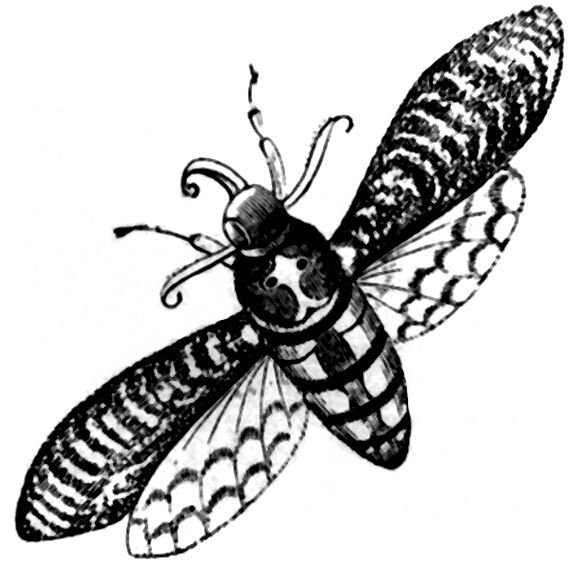
“The ill-omened insect,” said they, “bearing the impress of a death’s-head upon her shoulders, is a messenger of ill; wherever she alights upon the sill of a window, sorrow is coming fast; or sickness will seize upon some member of the family.” Thus they spoke; but the lover of insects now rejoices when this magnificent moth crosses his way. Her home is not, indeed, within yonder glittering oak ball, though well it might become her; she rather prefers to hide beneath the leaves of creeping plants, or under ground, by which means she is protected from the piercing rays of the sun, and the attacks of unfriendly ichneumonidæ.
WINDMILL. A machine erected in elevated positions, and provided with vanes or sails, which, placed in a certain angle to the wind, turns millstones, by which corn is ground, and apparatus worked by which it is sifted and prepared for use by the baker.
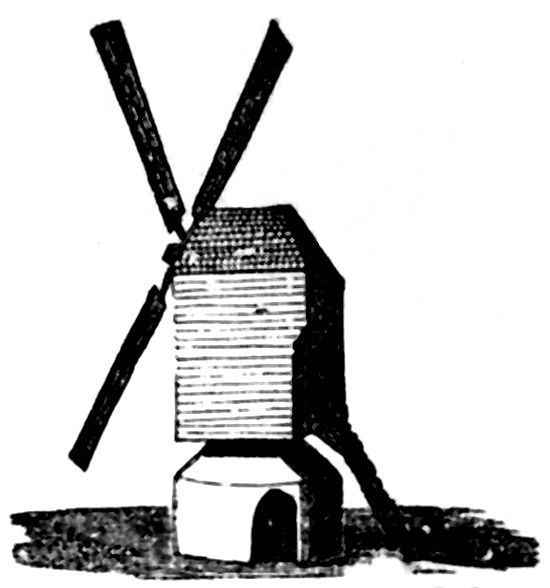
BARONS OF THE EXCHEQUER. The four judges who officiate in the Court of Exchequer, at Westminster or London.
PNEUMATIC APPARATUS. An apparatus for generating, collecting, and exhibiting gases. A, is a vessel containing some ingredients for generating gas; B, a pipe to convey it to the glass vessel; D, filled with water, which is driven out as the gas enters; C, is a resting bar, and a vessel of water to let in D when full of gas for use.
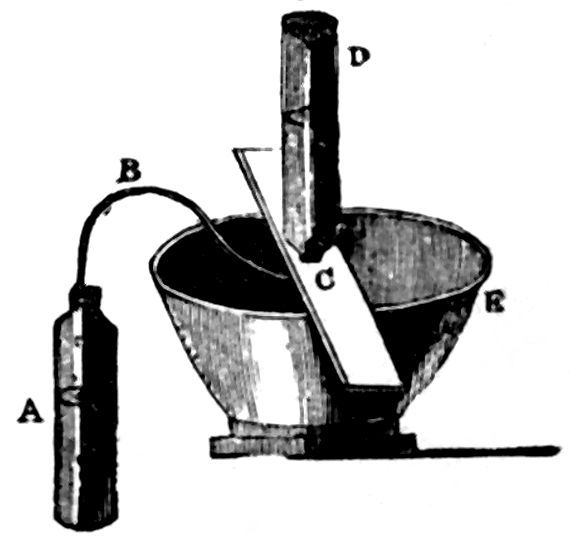
MAY is the third month of Romulus’s year; but the fifth month as reformed by Numa and Julius Cæsar. Romulus assigned thirty-one days to this month; Numa reduced the number to thirty; and Julius Cæsar restored it to the original length, which it now retains. There is some doubt about the origin of the name of this month; because, although the Romans offered sacrifices to Maia, the mother of Mercury, upon the first day of this month, yet it appears pretty evident that the name was fixed long before the time of Romulus.
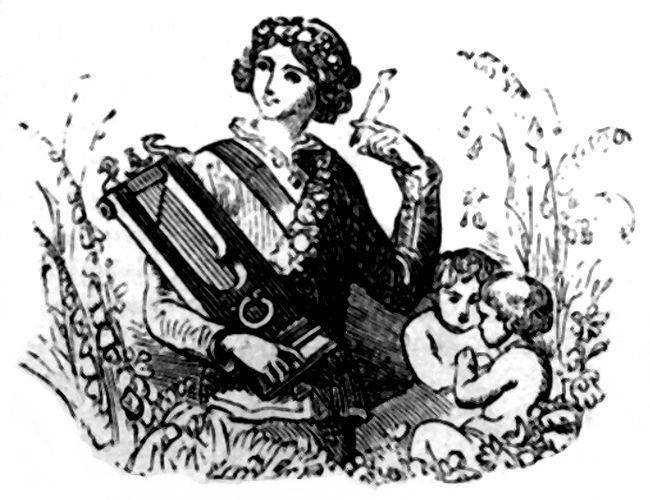
Among our British and Saxon ancestors this month was hailed as the genial harbinger of approaching summer, and celebrated sometimes with religious observances, and at others amid general festivity. On May-eve the Druids made large fires on eminences, in honour of Beal, or Bealan, the Celtic or Irish word for the sun. Two of these fires were kindled in every village, between which the men and beasts devoted to sacrifice were compelled to pass, one of them being killed on the kairn, and the other on the ground; hence the Irish proverb applied to a person in a dilemma, “Itter dha teine Bheil” (between Bel’s two fires).
Synonymes.—In Latin, Maius; French, Mai; Italian, Maggio; Portuguese, Maio; Saxon, Tri-milchi; and ancient Cornish, Me. Verstegan says, that “the pleasant month of May they (the Anglo-Saxons) termed by the name of Tri-milchi, or Tri-milki, because in that month they began to milk their kine three times in the day.”
Symbol or Allegory of the Month.—A young man, with a beautiful face, clad in green, embroidered with various bright flowers, and a garland of white and damask roses upon his head. In one hand he held a lute, and on the forefinger of the other a nightingale, allegorical of the “eve song” of this bird, which is first warbled during the month. The sign of Gemini, the Twins, also accompanied him, alluding to the sun entering that sign on the 20th of the month. (See our engraving).
There is not a day in the year that is devoid of historic interest, and May has her fair share of the number.
The 1st, commonly called May-day, is a very remarkable one in our calendar. It is dedicated to St. Philip and St. James the Less. St. Philip was born at Bethsaida, near Tiberias, and is supposed to have been the first of our Saviour’s disciples and an apostle; he died at Hierapolis, in Phrygia. St. James the Less underwent martyrdom in a tumult in the temple, about the year a.d. 62.
May-day festivities are said to have originated with the Romans, who worshipped Flora, and celebrated her festivals by rejoicings and offerings of spring flowers, and the branches of trees in bloom. In our own country, in former times, the village lads and lasses left their homes at break of day—
“On a May-day morning, to fetch in May.”
These good old times have long since passed away, and are now little more honoured than in mere remembrance. Then we had the May-pole, painted with various colours, dressed with garlands and streamers, and surmounted by a large crown; and there was the village fiddler, seated upon a cask, and vigorously scraping away for the lads and lasses to skip round the May-pole.
The sports of the chimney-sweepers on the 1st of May and the two following days are familiar to all, yet very few are aware that Jack-o’-the-Green originally consisted of a man dressed out with flowers and ribbons, with a long walking-stick, having a wreath of flowers twisted around it. This strange character danced away at the festivities, whisking his stick about his head, and keeping up the spirit of the games.
The 3rd day is “The Invention of the Cross,” being the anniversary of the alleged discovery, by St. Helena, the mother of the Emperor Constantine the Great, of the cross on which our Saviour suffered.
The 6th day is dedicated to St. John the Evangelist, who is said to have been plunged into a cauldron of boiling oil, by order of Domitian; but, as he was not harmed, he was permitted to live, and was afterwards banished to the desert isle of Patmos, in the Archipelago, where he is supposed to have written the “Apocalypse,” or book of “Revelations.”
The 9th day is Rogation-Sunday, which is a moveable feast. It takes its name from the Latin rogare, to ask, because Mammertius, Bishop of Vienna, in 469, appointed the three following days for the offering of supplications, with fasting, to be offered up to avert the calamities that had befallen his diocese.
The 13th day, this year, is Ascension-day, or Holy Thursday, which is the anniversary of Christ’s ascension, formerly celebrated by processions, which were abolished at the Reformation. The ministers and officers of the various parishes, with those who please, followed by the boys of the parish school, bearing peeled willow-wands, proceed in procession to the different parish boundaries, which are struck with the white wands; and this is called “beating the bounds.” This day is also Old May-day.—In 1832 died Baron George Cuvier, the celebrated naturalist and geologist, aged sixty-three.
The 23rd day, this year, is Whit-Sunday, so named because on this day the catechumens appeared in the ancient church in white garments, and Whitsuntide is most probably a contraction from White Sunday tide or time. The festival of Whitsuntide, or the Day of Pentecost, was established to commemorate the miraculous descent of the Holy Ghost on the Apostles.
The 26th day is dedicated to St. Augustin, a monk sent to England by Pope Gregory the Great, to convert the Saxons. He accomplished his mission satisfactorily, for he converted King Ethelbert, who appointed him Archbishop of Canterbury, which he held until his death, in 610.
The 29th day is commonly called the Restoration-day, because in 1660 Charles II. was brought back to England, and restored to the throne of his ancestors. In some parts of England people wear oak-leaves and oak-apples (gilt) in their hats, in commemoration of the concealment of Charles in an oak tree at Boscobel, after his defeat by Cromwell, at the battle of Worcester, September 3, 1651.
The 30th day; in this year, is Trinity-Sunday, which is the day set apart for the celebration of the festival held in honour of the Holy Trinity, and enjoined in the Council of Arles, in 1260.
Voltaire and Columbus were born in this month. The former is the voluminous French writer, who was born at Chatenay, near Sceaux, in 1694, and died Aug. 30, 1778. His most celebrated works are the “Henriade” and the “Life of Charles XII.” His collected works form seventy volumes.
Christopher Columbus, the illustrious navigator, who first discovered the American continent, was born at Genoa, in 1437. After vainly seeking aid from Genoa, Portugal, and England, he at length induced Ferdinand and Isabella of Spain to equip and man three vessels, with which he made the important transatlantic discoveries for which his name is so distinguished. After enduring many insults and disappointments, he died at Valladolid in 1506.
JUNE. This was the fourth month of the old Roman year, but the sixth month as reformed by Numa and Julius Cæsar. Romulus assigned to it thirty days as the proper limit, thereby increasing it four days. Numa Pompilius reduced the number of days to twenty-nine; but Julius Cæsar confirmed its position, and restored the day which Numa had taken away from it.
Divers opinions exist as to the origin of the name of this month. Some derive it from Junius Brutus, who expelled the Tarquins from Rome on the first of this month, and settled the Government upon the people; others assert that it is derived from the Latin word junius, because it is considered as the month for young persons. The most probable and more generally received opinion is, that it derives its name from the goddess Juno, in honour of whom a festival was celebrated at the commencement of the month.
The Synonymes of the month are as follow:—In Latin, Junius; French, Juin; Italian, Giugno; Portuguese, Junho; and Saxon, Sere Monath, or dry month.
In the earliest times, our Saxon ancestors called June Weyd-monat, because, says Verstegan, “their beasts did then weyd in the meddowes, that is to say, goe to feed there, and hereof a meddow is also in the Tutonicke, called a weyd, and of weyd we yet retain our word wade, which we understand of going through watrie places, such as meddowes are wont to be.”
The ancients represented this month as a young man, clothed in a mantle of dark grass-green colour, having his head ornamented with a coronet of flowers, while he held an eagle in his left hand, and bore a basket of summer fruits upon his right arm. At his right was the sign of Cancer, the crab, alluding to the sun entering that sign on the 22nd of the month, to make the summer solstice. (See the engraving).
In this month the wind is still cold, but Flora reigns triumphant, and every hedge, and bank, and bush, and field are in full bloom. The blossoms of the fruit trees, however, gradually drop off, the grass in the meadows gets high, and partially obscures the yellow ranunculi, which decorated them in spring.
Our calendar contains several remarkable days in June. The 1st is dedicated to St. Nicomede, who was a pupil of St. Peter, and was discovered to be a Christian by his honourably burying Felicula, a martyr.
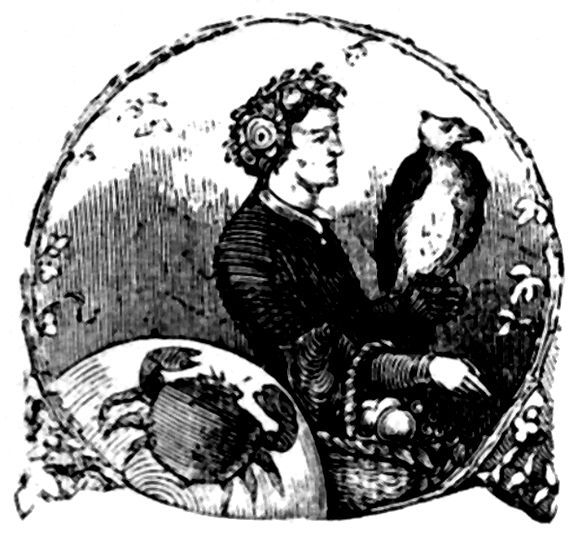
The 5th day is dedicated to St. Boniface, who was a Saxon presbyter, born at Crediton, in Devonshire. His name was Winfred, or Winefrid; and, after being educated in a Benedictine monastery, at Exeter, he was sent to Friesland as a missionary. In 745 he was created Archbishop of Mentz, and was murdered in 755 by the peasantry in East Friesland, while holding a confirmation.
The 11th day is dedicated to St. Barnabas, whose proper name was Joses. He was descended from the tribe of Levi, and was born at Cyprus, but educated under Gamaliel, at Jerusalem, and was associated with St. Paul, preaching the Gospel in various countries, for upwards of fourteen years. He suffered martyrdom at Salamis, in his native isle, by being stoned to death by the Jews. The festival of this saint used to be observed with great ceremony, garlands of roses and woodroof being worn during the observance.
The 15th day is dedicated to St. Vitus, who was a Sicilian martyr, under Diocletian. Formerly it was a custom to offer fowls on the festival of this saint, to avert the disease called St. Vitus’s dance.
The 17th day is dedicated to St. Alban, who suffered martyrdom in 303, and was the first Christian martyr in this island. He was converted to Christianity, by Amphialus, a priest of Caerleon, in Monmouthshire, who, flying for protection from persecution, was hospitably entertained by St. Alban, at Verulam, in Hertfordshire, now called, after his name, St. Alban’s—Amphialus, being closely pursued, made his escape, dressed in St. Alban’s clothes. This, however, being soon discovered, exposed St. Alban to the fury of the Pagans, and he, refusing to perform the sacrifice to their gods, was first miserably tortured, and then put to death. John Wesley, the founder of the religious sect called after him Wesleyan Methodists, was born at Epworth, in 1703.
19th. On this day, in 1215, the Barons of England compelled King John to sign the Magna Charta, or Great Charter at Runnymede, a meadow between Staines and Windsor. In 1820 died Sir Joseph Banks, the naturalist, in his seventy-seventh year.
The 21st of this month is the longest day in the year.
The 23rd day is called Midsummer-eve. It is kept with various ceremonies in different parts of England, bonfires being lighted, and the doors of the houses decorated with St. John’s wort, long-fennel, green birch, flowers, candles and lamps, which are kept burning all night.
The 24th day is Midsummer-day. It is also called St. John’s-day, being held in commemoration of the nativity of John the Baptist, who was beheaded by the stratagem of the wife of Herod.
28th. In 1577, Peter Paul Rubens, the most celebrated painter of the Flemish school, was born at Cologne. His “Village Fete,” in the Louvre, and his “Battle of the Amazons,” and “Last Judgment,” at Munich, are considered by many judges as his best paintings.
The 29th is dedicated to St. Peter, and is kept with great pomp at Rome, being a high festival of the Roman Catholic Church.
30th. In 1474 the first book printed in England was completed on this day by Caxton, and was called “The Game and Play of the Chesse.”
Ludovico Ariosto, one of the most distinguished poets of Italy, at a period when Europe was in a state of semi-barbarism, was also born in this month, at Reggio, in 1474, and died at Ferrara, in 1533. His principal production was the incomparable poem of “Orlando Furioso.”
LIP-SALVE. White wax, two and a half ounces; spermaceti, three quarters of an ounce; oil of almonds, four ounces. Mix well together, and apply a little to the lips at night. Another—A dessertspoonful of salad oil in a saucer, hold it over a candle, and drop melted wax over it till the oil is thinly covered; when they are incorporated, pour it into boxes. (Wax taper will do.)
WINDS. A change in the temperature of a portion of air; an increase or a diminution of the quantity of water which it holds in a state of vapour; in short, any circumstance which causes it either to contract or expand destroys the equilibrium among the different parts of the atmosphere, and occasions a rush of air, that is, a wind, towards the spot where the balance has been destroyed. Winds may be divided into three classes: those which blow constantly in the same direction; those which are periodical; and those which are variable. The permanent winds are those which blow constantly between, and a few degrees beyond, the tropics, and are called trade-winds. On the north of the equator, their direction is from the north-east, varying at times a point or two of the compass each way: on the south of the equator, they proceed from the south-east. The origin of them is this:—The powerful heat of the torrid zone rarefies, or makes lighter, the air of that region; the air, in consequence of this rarefaction, rises, and to supply its place, a colder atmosphere from each of the temperate zones moves towards the equator. But these north and south winds pass from regions where the rotatory motion of the earth’s surface is less to those where it is greater. Unable at once to acquire this new velocity, they are left behind, and instead of being north and south winds, as they would be if the earth’s surface did not turn round, they become north-east and south-east winds.
The Monsoons belong to the class of periodical winds. They blow half the year from one quarter, and the other half from the opposite direction: when they shift, variable winds and violent storms prevail for a time, which render it dangerous to put to sea. The monsoons of course suffer partial changes in particular places, owing to the form and position of the lands, and to other circumstances; but it will be sufficient to give their general directions. From April to October, a south-east wind prevails north of the equator, southward of this a south-east wind. From October to April, a north-east wind north of the equator, and a north-west between the equator and 10° of south latitude.
The Land and Sea Breezes, which are common on the coasts and islands situated between the tropics, are another kind of periodical winds. During the day, the air, over the land, is strongly heated by the sun, and a cool breeze sets in from the sea; but in the night, the atmosphere over the land gets cooled, while the sea, and consequently the air over it, retains a temperature nearly even at all times; accordingly, after sun-set, a land breeze blows off the shore. The sea breeze generally sets in about ten in the forenoon, and lasts till six in the evening; at seven the land breeze begins, and continues till eight in the morning, when it dies away. These alternate breezes are, perhaps, felt more powerfully on the coast of Malabar than anywhere; their effect there extends to a distance of twenty leagues from the land.
Thus, within the limits of from twenty-eight to thirty degrees on each side of the equator, the movements of the atmosphere are carried on with great regularity; but beyond these limits, the winds are extremely variable and uncertain, and the observations made have not yet led to any satisfactory theory by which to explain them. It appears, however, that beyond the region of the trade-winds, the most frequent movements of the atmosphere are from the south-west, in the north temperate zone. This remark must be limited to winds blowing over the ocean, and in maritime countries; because those in the interior of continents are influenced by a variety of circumstances, among which the height and position of chains of mountains are not the least important. These south-west and north-west winds of the temperate zones are most likely occasioned in the following manner:—In the torrid zone there is a continual ascent of air, which, after rising, must spread itself to the north and south in an opposite direction to the trade-winds below: these upper currents, becoming cooled above, at last descend and mix themselves with the lower air; part of them may perhaps fall again into the trade-winds, and the remainder, pursuing its course towards the poles, may occasion the north-west and south-west winds of which we have been speaking. This interchange between the heated air of the tropics, and the cold air of the polar regions, greatly tends to moderate the climate of each. Besides, the air from the tropics being richer in oxygen, on account of the more luxuriant vegetation decomposing a larger quantity of carbonic acid, is well calculated to supply any deficiency in the amount of this most important substance, which might occur from the barrenness of a less favoured climate.
Hurricanes have been supposed to be of electric origin. A large vacuum is suddenly created in the atmosphere, into which the surrounding air rushes with immense rapidity, sometimes from opposite points of the compass, spreading the most frightful devastation along its track, rooting up trees, and levelling houses with the ground. They are seldom experienced beyond the tropics, or nearer the equator than the 9th or 10th parallels of latitude; and they rage with the greatest fury near the tropics, in the vicinity of land or islands, while far out in the open ocean they rarely occur. They are most common among the West India islands, near the east coast of Madagascar, in the islands of Mauritius and Bourbon, in the Bay of Bengal, at the changing of the monsoons, and on the coasts of China.
Whirlwinds sometimes arise from winds blowing among lofty and precipitous mountains, the form of which influences their direction, and occasions gusts to descend with a spiral or whirling motion. They are frequently, however, caused by two winds meeting each other at an angle, and then turning upon a centre. When two winds thus encounter one another, any cloud which happens to be between them is of course condensed, and turned rapidly round; and all substances sufficiently light are carried up into the air by the whirling motion which ensues. The action of a whirlwind at sea occasions the curious phenomenon called a water-spout.
ROOTS. The root not only supports the plant by fixing it in the soil, but affords a channel for the conveyance of nourishment. At the extremity of each fibre of a root, there is an expansion of the cellular integument, called spongiole, from its resemblance to a small sponge; being full of pores, it absorbs the water from the soil. There are pores in every part of a plant, above ground, but they are almost wholly for the purpose of exhalation. The roots have no pores, except in the spongioles at the extremities. It would be useless for them to be furnished with evaporating pores, since they are not exposed to the atmosphere, where alone evaporation could take place. The tendrils of vines, and of other climbing plants, which serve to fix them against a wall, or the trunk of a tree, cannot be considered as roots; since, though they answer the purpose of sustaining the plant, they are unable to supply it with nourishment. But there are some parasitical plants, such as the mistletoe, which, having no immediate communication with the earth, strike their fibres into the stems or branches of a tree, and derive their nourishment from this richly-prepared soil: yet, as the absorption in this case is not carried on by the regular mode of spongioles, their fibres are not denominated roots. The spongioles act only by capillary attraction and suck up moisture, just as a lump of sugar absorbs the water into which it is dipped. As a proof of this it has been shown, that if roots, saturated with moisture, be transplanted into very dry earth, the latter will absorb the moisture from the roots. Absorption does not immediately cease upon the death of a plant, as the blood ceases to circulate upon the expiration of animal life; but when the vessels, through which the fluid should pass, have lost their vital energy, that susceptibility of irritation and contraction, which enabled them to propel the fluid upward, ceases, and it can no longer ascend into the roots, but remains stagnant in the spongioles, which soon become saturated. Disease and putrefaction follow; and that nourishment which was designed to sustain life now serves only to accelerate disorganization. The fluid is, however, still performing the part assigned to it by the Creator, for if it be necessary to supply living plants with food, it is also necessary to destroy those which have ceased to live, in order that the earth may not be encumbered with bodies become useless, and that their disorganized particles may contribute to the growth of living plants. Thus, the putrefaction of leaves, straw, &c., which reduces the bodies to their simple elements, prepares them to become once more component parts of living plants. Botanists distinguish several kinds of roots. The radix fibrosa, or fibrous root, is the most common in its form: it consists of a collection or bundle of fibres. The roots of many grasses, and most annual herbs, are of this description. The couch-grass is an example of the radix repens, or creeping-root. If an attempt be made to eradicate such roots, a succession of bunches of fibres are met with, springing from an apparent root which grows horizontally, and appears to be endless. This long horizontal fibre is, however, not a root, but a subterraneous branch, for it has no spongioles; the real roots are the small bundle of fibres which spring from it. Such a root is very tenacious of life, as any portion in which there is an articulation will grow. The ox-eye, whose strong penetrating roots strike deep into the earth, furnishes an example of the radix fusiformis, or spindle-shaped. It is also called the tap-root, from its tapering so considerably towards the end. The radix bulbosa, or bulbous-root, such as that of the lily, the hyacinth, or the onion, is improperly so called, for the tufts of fibres, pendant from the bulb, are the roots. The bulb constitutes the stem of the plant. The potato belongs to the class of tuberous, or knotted roots, which are of various kinds, comprehending all such as have fleshy knobs, or tumours. In all cases they are to be considered as reservoirs of nourishment, which enable the plant to sustain the casual privations of a barren or dry soil. The root of the orchis is deserving of notice, from its singularity. It consists of two lobes, somewhat similar to the two parts into which a bean is divided. One of these perishes every year, and another shoots up on the opposite side of the remaining lobe. The stem rises every spring from between the two lobes, and since the new lobe does not occupy the same place as its predecessor, the orchis every year moves a little onwards. The duration of roots is either annual, biennial, or perennial. To the first belong plants the existence of which is limited to one season, such as barley, and a vast number of garden and field flowers. The biennial root produces, the first season, only herbage, and the following summer, flowers and fruits, or seed; after which it perishes. To the perennial belong plants which live to an indefinite period, such as trees and shrubs. (See Stems and Leaves, p. 221-223).
MITRE. A sacerdotal crown, formerly worn on the head by bishops.
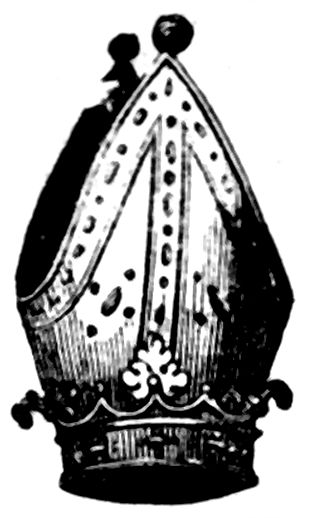
VARNISH (BLACK) FOR WOOD. Put 28 lbs. of common black pitch and 28 lbs. of common asphaltum into an iron pot: boil nine hours, and let it stand to cool for twelve hours; then set it again upon the fire, and as soon as it boils, add 8 gallons of boiled oil; introduce afterwards gradually 10 lbs. of red lead, and 10 lbs. of litharge, and boil until it will roll very hard. Leave it to cool, and then mix in 20 gallons of turpentine. This is a cheap black, and will dry in half an hour.
BANANA, OR PLANTAIN. An invaluable tropical fruit tree. It serves the Indians for bread, and grows to the height of 15 or 20 feet. At the top of the stalk, leaves expand from six to eight feet long, and two to three feet broad, which grow so quick that their expansion may be discerned. The flower forms a spike in the centre, often nearly four feet long and nodding on one side.
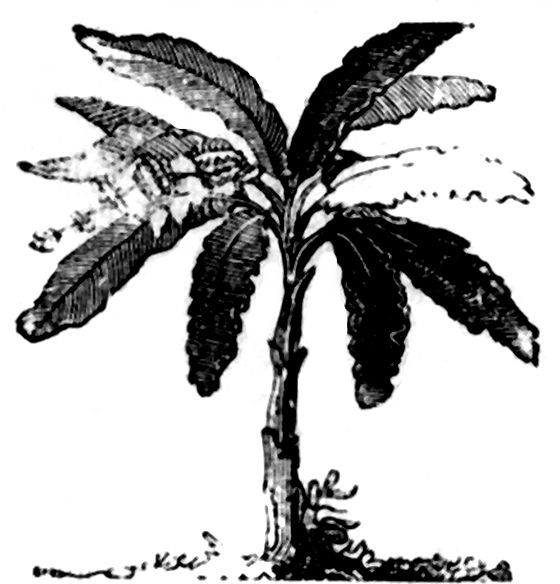
The fruit, or plantains, are twelve inches long and two in diameter; at first green, and afterwards of a pale yellow. The spikes of fruit weigh from 30 to 40 pounds. They are generally cut before ripe, the green stud pulled off, and the heart roasted, and served at table as bread. The negroes almost live upon them, and they serve, likewise, to fatten all domestic animals. Every other part of the tree is useful, and the leaves are used as napkins and table-cloths. Of another sort, the fruit is rounder and more luscious, and, when ripe, eaten raw or fried in slices, is relished by all ranks in the West Indies. It is only perennial in its roots, for the stalk dies down to the ground every year; but, by cutting them down, suckers rise from the root, and there is a constant succession of fruit all the year.
SUMMER. The season of long days and warm weather, arising from the inequality with which the circles of rotation are cut by lines of darkness, owing to the pole being turned towards the sun.
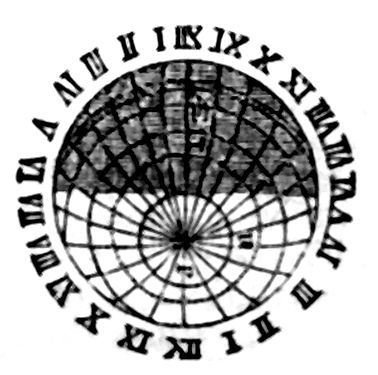
WINTER. The season of long nights, owing to the revolving circles being more in the dark than in the light, and to the pole turned from the sun.
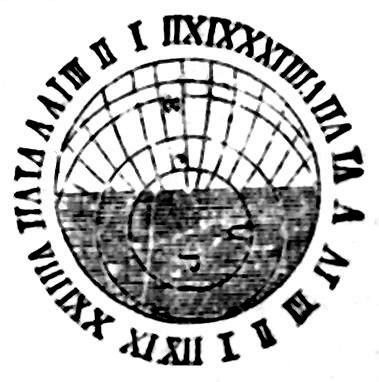
SYMBOL. An emblem; thus, the serpent is a symbol of Time or Eternity. Symbols were the bases of the Egyptian hieroglyphics, and of the ancient alphabets; thus, a mirror was the symbol of Beauty, and when a planet was called Venus, the symbol ♀ of a mirror was assigned to Venus; and so with other things.
TIDES (THE). The tides are produced by the attraction of the moon. The cohesion of fluids being much less than that of solid bodies, they more easily yield to the power of gravity, in consequence of which, the waters immediately below the moon are drawn up in a protuberance, producing a full tide, or what is commonly called high-water, at the spot where it happens. According to this theory, you would imagine we should have full tide only once in twenty-four hours—that is, every time that we were below the moon—while we find that we have two tides in the course of twenty-four hours, and that it is high-water with us and with our antipodes at the same time.
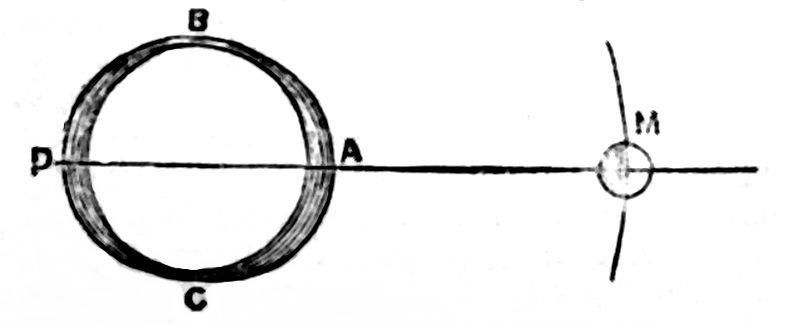
This opposite tide is rather more difficult to explain than that which is drawn up beneath the moon. In order to render the explanation more simple, let us suppose the earth to be everywhere covered by the ocean. M is the moon, A B C D the earth. Now, the waters on the surface of the earth about A being more strongly attracted than in any other part, will be elevated, the attraction of the moon at B and C, being less; but still it will be greater there than at D, which is the part most distant from the moon. The body of the earth will, therefore, be drawn away from the waters at D, leaving a protuberance similar to that at A; so that the tide A is produced by the waters receding from the earth, and the tide D by the earth receding from the waters.
The influence of the sun on the tides is less than that of the moon; for observe that the tides rise in consequence of the moon attracting one part of the waters more forcibly than another part; it is this inequality of attraction which produces full and ebb tides. Now, the distance of the sun is so great, that the whole globe of the earth is comparatively but as a point, and the difference of its attraction for that part of the waters most under its influence, and that part least subject to it, is but trifling; and no part of the waters will be much elevated above or much depressed below their general surface by its action. The sun has, however, a considerable effect on the tides, and increases or diminishes them as it acts in conjunction with, or in opposition to, the moon.
The moon is a month in going round the earth; twice during that time, therefore, at full and at change, she is in the same direction as the sun.
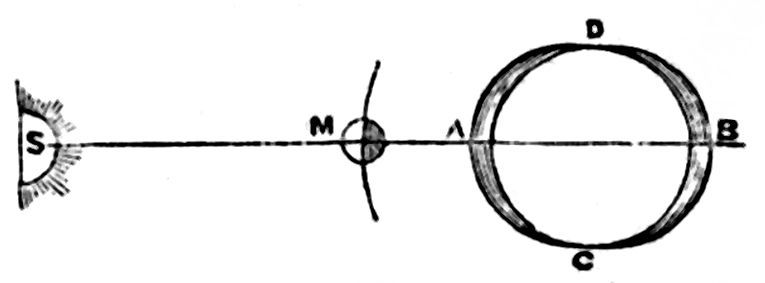
Both then act conjointly on the earth, and produce very great tides, called spring-tides, as represented at A and B; but when the moon is at the intermediate parts of her orbit, the sun, instead of affording assistance, weakens her power by acting in opposition to it; and smaller tides are produced, called neap-tides.
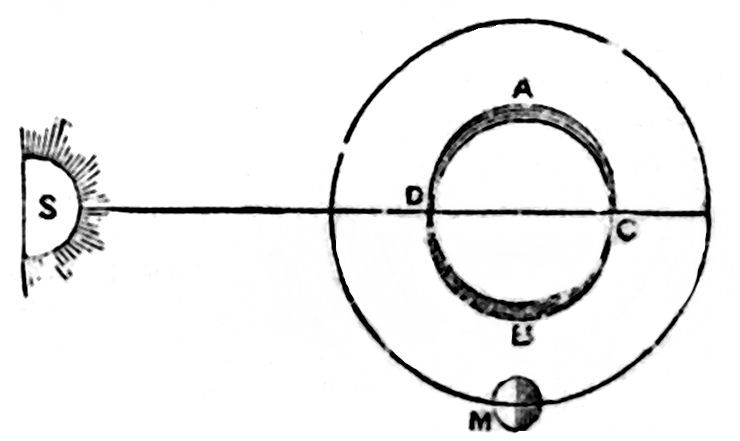
Since attraction is mutual between the moon and the earth, we produce tides in the moon; and these are more considerable, in proportion as our planet is larger. Neither the moon nor the earth in reality assume an oval form, for the land which intersects the water destroys the regularity of the effect. The orbit of the moon being nearly parallel to that of the earth, she is never vertical but to the inhabitants of the torrid zone; in that climate, therefore, the tides are greatest, and they diminish as you recede from it and approach the poles; but in no part of the globe is the moon immediately above the spot where it is high tide. All matter, by its inertia, offers some resistance to a change of state; the waters, therefore, do not readily yield to the attraction of the moon, and the effect of her influence is not complete until some time after she has passed the meridian.
The earth revolves on its axis in about twenty-four hours; if the moon were stationary, therefore, the same part of our globe would, every twenty-four hours, return beneath the moon; but as during our daily revolution the moon advances in her orbit, the earth must make more than a complete rotation in order to bring the same meridian opposite the moon: we are about three-quarters of an hour in overtaking her. The tides, therefore, are retarded, for the same reason that the moon rises later, by three-quarters of an hour every day. This, however, is only the average amount of the retardation. The time of the highest tide is modified by the sun’s attraction, and is between those of the tides which would be produced by the separate action of the two luminaries. The action of the sun, therefore, makes the interval different on different days, but leaves the average amount unaffected.
SIMPLE BODIES. Oxygen is one of the most important of the elementary bodies. In a simple state, it is obtained only in the form of gas. It is an exceedingly abundant body; the air of the atmosphere contains one-fifth, and water is resolveable into a mixed gas, one-third of which, by bulk, is oxygen, and the remainder hydrogen. It also exists in most natural products—animal, vegetable, and mineral. Oxygen gas is, like common air, colourless, invisible, tasteless, inodorous, and elastic. But it is heavier than common air, in the proportion of 11½ to 10. It is a powerful supporter of combustion; that is to say, when any inflamed body, as a lighted candle, is put into it, it burns very vigorously—much more so than when in common air; indeed, it is owing to the oxygen it contains that common air supports combustion at all. Its presence is also necessary for the continuance of animal life. We cannot breathe air which has been deprived of its oxygen.
Hydrogen is known only in the state of gas, and is sometimes called inflammable air. It is the lightest of all bodies that can be weighed. It is one of the ingredients which form water—from which it can be easily procured. Hydrogen gas, when pure, possesses all the mechanical properties of common air. It does not support combustion, though it is itself one of the most combustible of all bodies; for if a lighted candle be put into a vessel containing hydrogen, the candle will be instantly extinguished, while the gas itself will be inflamed. It is not fit for respiration, for animals which breathe it die almost instantaneously. If pure oxygen and hydrogen be mixed together, and the mixture set fire to, it explodes with great violence, and forms water. Hence we see the origin of the term hydrogen, which literally signifies the water-former. Hydrogen gas is, on account of its greater levity, employed to fill balloons.
Nitrogen, called also Azote, is a gaseous body, rather lighter than common air; of which it forms four-fifth parts, the remaining one-fifth being oxygen. It has neither colour, smell, nor taste. It does not support combustion, nor is it combustible itself, for if a lighted candle be put into a vessel containing nitrogen, it is instantly extinguished, and the gas itself does not take fire, as is the case with hydrogen. Nitrogen is fatal also to animal life; any animal put into it dies in a very short time.
Carbon. When wood is heated to a certain degree in the open air, it takes fire, and forms, whilst burning, water and carbonic acid gas, till the whole of it is consumed. A small portion of ashes is the sole residue. But if the wood be heated to redness in close vessels, so that the atmospheric air cannot have free access to it, a large quantity of gaseous and other volatile matters is expelled, and a black, hard, porous substance is left, called charcoal.
Charcoal may be procured from other sources. When the volatile matters are driven off from coal, as in the process for making coal-gas, a peculiar kind of charcoal, called coke, remains in the retort. Most animal and vegetable substances yield it, when ignited in close vessels. Thus a very pure charcoal may be procured from starch or sugar, and from the oil of turpentine or spirit of wine, by passing their vapour through tubes heated to redness. When bones are made red-hot in a covered crucible, a black mass remains, which consists of charcoal mixed with the earthy matters of the bone. It is called ivory-black, or animal charcoal.
Carbon is the name given to the pure inflammable part of charcoal, of which substance the diamond is only a variety in a pure crystallized state; for pure charcoal and diamond, when treated in the same manner, produce precisely the same results. Carbon is insoluble in water, and infusible by the most intense heat, provided air be excluded. Animal and vegetable oils are composed almost entirely of carbon and hydrogen. The same may be observed of gum, sugar, and starch. These bodies, however, contain oxygen.
Charcoal absorbs the odoriferous and colouring principles of most animal and vegetable substances. When coloured infusions of this kind are digested with a due quantity of charcoal, a solution is obtained, which is nearly if not quite colourless. Tainted flesh may be rendered sweet and eatable by this means, and foul water may be purified by filtering through charcoal.
Sulphur occurs as a mineral production in some parts of the earth, particularly in the neighbourhood of volcanoes, as in Italy and Sicily. It is commonly found in a massive state; but is sometimes met with in a crystallized form. It is procured abundantly in combination with several metals, such as silver, copper, antimony, lead, and iron. It is obtained in large quantities by exposing the common iron pyrites to a red-heat in close vessels.
Sulphur is well known under the name of brimstone. It is a brittle solid body, of a greenish yellow colour, emits a peculiar odour when rubbed, and has little taste. It is insoluble in water; but, if poured into it when liquified, it retains its softness, and is in this state employed for taking impressions from seals and medals.
Phosphorus was discovered about the year 1669, by Brandt, an alchemist of Hamburgh. It is a semi-transparent yellowish matter, of the consistence of wax. It is procured, in general, by the decomposition of bones. It is exceedingly inflammable. Exposed to the air at common temperatures, it undergoes a slow combustion; it emits a dense white smoke, which has the smell of garlic, appears luminous in the dark, and is gradually consumed. On this account, phosphorus should always be kept under water. On account of its very combustible nature, it requires to be handled with great caution; gentle pressure between the fingers is sufficient to kindle it. It burns rapidly, emitting a splendid white light, and causing an intense heat.
Chlorine was discovered in 1770. It is a substance of much importance, being, in combination with other substances, extensively used in the arts. Chlorine is a yellowish-green coloured gas, which has an astringent taste, and a disagreeable odour. It is one of the most suffocating of the gases, exciting great irritability in the windpipe, even when considerably diluted with air. When strongly and suddenly compressed, it emits both heat and light—a character which it possesses in common with oxygen gas. Under considerable pressure it assumes the form of a limpid liquor of a bright yellow colour. Chlorine is a supporter of combustion. If a lighted taper be plunged into chlorine gas, it burns with a small red flame and emits a large quantity of smoke. Phosphorus takes fire in it spontaneously. Several of the metals, such as tin, copper, arsenic, antimony, and zinc, when introduced into chlorine in the state of powder, or in fine leaves, are suddenly inflamed. Chlorine, though formerly called an acid, possesses no acid properties. It has not a sour taste, nor does it redden the blue colour of plants, which nearly all acids do. One of the most important properties of chlorine is its bleaching power. All animal and vegetable colours are speedily removed by chlorine; and when the colour is once discharged, it can never be restored. Chlorine, however, cannot bleach unless water be present. Chlorine is useful also for the purposes of fumigation, and is used to purify the air in fever hospitals. The infection of the small-pox is also destroyed by this gas, and matter that has been submitted to its influence will no longer generate that disease.
Iodine is a substance much resembling chlorine in some of its properties. It may be procured by drying and powdering common sea-weed, and heating it with sulphuric acid and peroxide of manganese: a violet coloured vapour rises, which, if received in a cool vessel, will condense on its sides, and will form scaly crystals of a somewhat metallic lustre. These crystals are the substance: from the violet colour of its vapour it is called iodine. It has the property of forming a beautiful blue colour, when mixed with a little powdered starch, diffused through cold water; hence iodine and starch are used as tests of the presence of each other. Iodine stains the fingers yellow, but not permanently. Like chlorine, it destroys vegetable colours, though not so powerfully. Iodine is used in medicine: in small doses it increases the appetite; but in large doses, or continued too long, it produces remarkable emaciation.
To these simple non-metallic bodies we might add bromine, selenium, boron, fluorine (the base of fluorspar), and silicon (the base of flint). But as they are of less importance, and as the nature of some of them is still a subject of dispute with chemists, we shall omit the consideration of them for the present.
ANCHOVY. The anchovy is abundant in the Mediterranean, and along the coasts of Spain and Portugal and France. It occurs also on various parts of our coast, as Hampshire, Cornwall, Wales, &c. The anchovy has been celebrated from the earliest times, and a sauce or condiment called garum, prepared from it, was held in high estimation among the Greeks and Romans. In preparing this fish for use, the head and viscera are removed, otherwise the pickle would be intensely bitter; the anchovy was in fact once supposed to have the gall in its head. A fish called the sardine, common in the Mediterranean, and belonging to the same genus (E. melletta, Cuv.) is frequently mixed with real anchovies, or even sold salted and barrelled as the genuine fish. The sardine may be known by its long taper form, its brown colour, and pale flabby flesh.
ORGAN (MECHANISM OF AN). Since the bellows are of so much consequence, we will begin by explaining their construction. They are what is termed double bellows, consisting of two moveable parts and keeping up a continual blast. Fig. 1 shows them in section as they appear when full of wind.
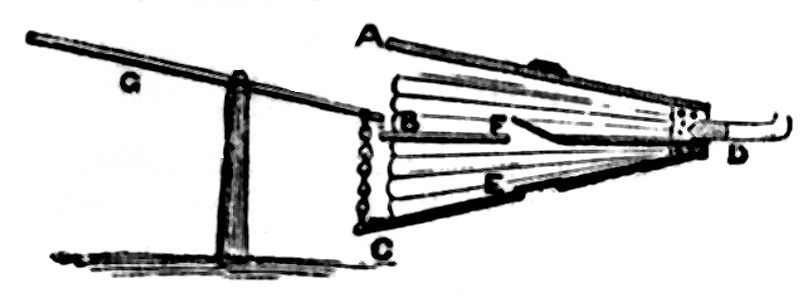
Fig. 1.
They consist of three boards, A, B, C, united by leather as in a common pair used in a house. The two lower boards have a hole in them, covered by a valve of leather, opening upwards. The upper board is weighted, the middle one being fixed, and the lowest capable of moving up and down by the handle G. In the diagram, the valves are shown in the position which they take just as the lowest board begins to be raised by the handle; the air contained in the lower part will close E, and open F, through which it enters the upper compartment. Thus, all the air will pass upwards, till the board C reaches its highest position; then, on letting go the handle G, C will fall by its weight, more air will enter from without by E, and that contained in the upper part, closing F, is driven through D into the organ by the falling of the upper board: thus, if C is again raised before the air in this upper chamber is exhausted, a constant blast will be kept up. (Whenever double bellows are used, whether for organs, forges, or other apparatus, they are always constructed with three boards and valves in this way.) From these bellows, the air passes into a box, called the wind-chest; this also has a valve, opening inwards, and placed just over the hole at which the nozzle of the bellows enters. Over this is placed the sounding-board, which forms a cover to it throughout its length, but extends, as to its width, far beyond it. This sounding-board is the most important part of the organ, and must be very carefully made, and all its parts, as well as the wind-chest, made perfectly air-tight. The construction, however, of this part being somewhat difficult to describe without a diagram, we have made a sketch of it as it would appear if open, and shall add another, placing it in its proper position, and connected with the wind-chest, which is dotted in fig. 2.
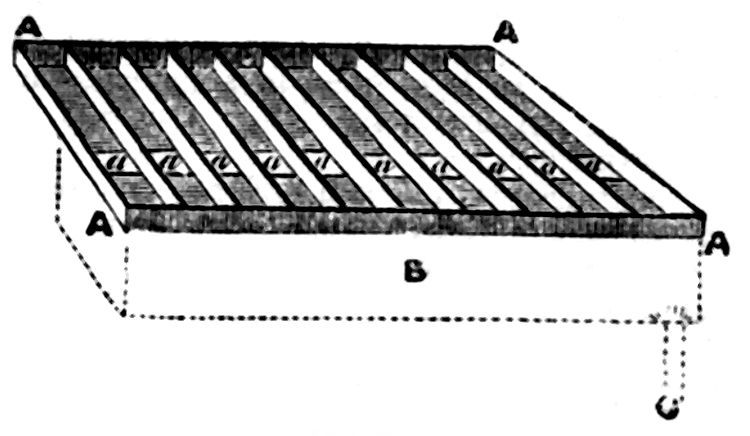
Fig. 2.
It will here be seen that the sounding-board is a shallow box, divided lengthwise into as many compartments as there are to be notes. At the part where the wind-chest is joined to it, a portion of the bottom of each division is cut away; under each of these slits is a valve, opening downwards, and held up till the key is pressed down by a spring, as well as by the wind in the wind-chest. This will be shown in a separate figure. In fig. 2, A is the sounding-board, B the wind-chest, C the nozzle of the bellows, with its valve; A A the slits to be covered below by the valves connected with the keys. Now, if we suppose this sounding-board to be covered by a flat board, and the wind-chest filled, and one of the key-valves opened, the air will flow into the compartment belonging to that valve; and if, in this cover-board, a hole were made and a pipe inserted, the air would escape into it, and cause it to sound. But, our readers are probably thinking that all this grooved apparatus would not be needed to sound a row of pipes; nor is it, but in an organ there are several rows, and we shall presently find, that, for the purpose of sounding or stopping certain pipes at pleasure, the above arrangement is absolutely necessary. Take, for instance, the compartment on the right side, and say that it represents the note A. In the flat cover we supposed, let six holes be bored in the direction of the length of the compartment, and let six pipes of different construction, some wood and some metal, be inserted in these holes, all turned to A. Then, by opening the first valve, all these will sound that note, and, by arranging pipes over the other compartments in like manner, any tunes can be played, and the effect will, from the number of pipes to each note, be very grand. But in this way we could only play very loudly, and with what is termed the full organ. We must, therefore, describe the plan by which any row of pipes can be played alone; for instance, a row of wooden ones, or metal, or both together. Instead of covering the sounding-board, already drawn, with a solid flat board, let another be put over it, divided in the same way, but shallower, and with the compartments running in the contrary direction.
In the figure below, A is the wind-chest; B, the part of the sounding-board shown in fig. 2; C, the upper part, forming its cover, and divided, as shown at L, E (the dotted lines show the position of the compartments beneath). It will be seen that a series of holes are made in the bottom of this upper tray corresponding with the compartments, both in itself and those below.
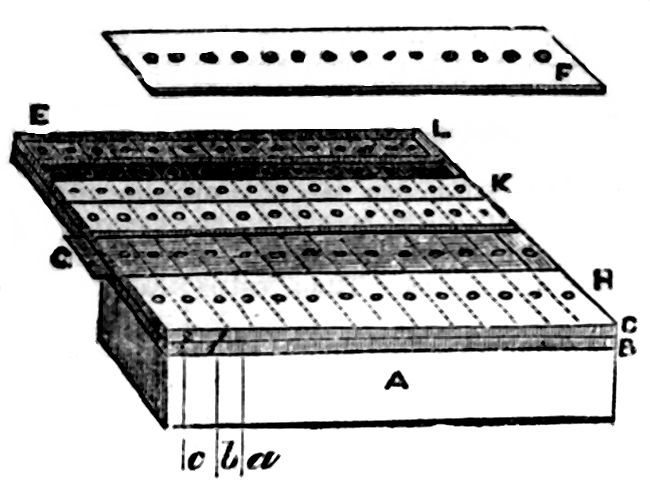
Fig. 3.
Some boards, like F, slide into these upper divisions, the holes in which tally with those below, and also with others in the flat board, which covers the whole, shown at K and H. These boards, however, only tally when pulled out a little by means of the stops. G represents one so pulled out. Now, suppose all the slides pushed in but one, and the outer board put on, and, in the holes in this latter, pipes placed. If a valve is opened by the key pressed (say the first to the right, as before), the air will pass from the wind-chest into the channel between 1 and 2, and its only vent being through the first hole in the slide that is pulled out, it will pass by it into the pipe that is placed over it in the board covering the whole (shown at H and K); and so, in every note played, the row of pipes only over the slide that is drawn out can sound, as none of the other sets of holes tally. Thus we can, by means of stops or handles connected with these slides, use one or more at pleasure. a, b, c are wires by which the valves are connected with the keys, which valves we will now explain. (Fig. 4). G is a part of the wind-chest, and F the sounding-board; H the valve, K the spring, B the key, turning on a centre, as does also the lever C. D is the wire from the valve. The divisions we stated in the sounding-board would run lengthwise between the valves, as shown by the dotted line.
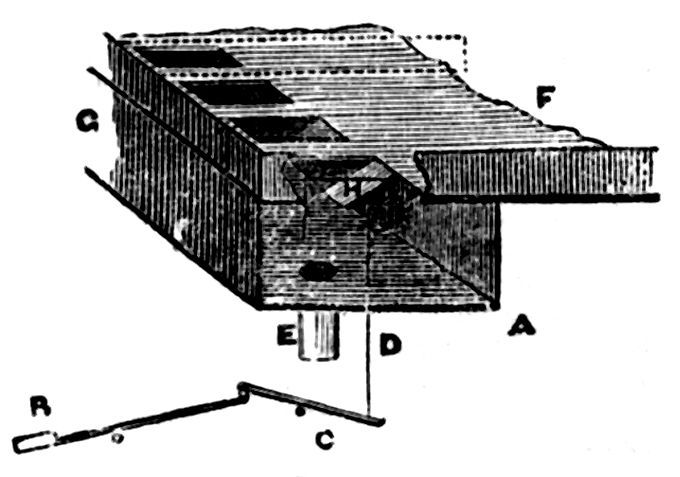
Fig. 4.
We think a glance at the diagram will make it all quite clear; and we would advise our young friends to read over, as far as this, several times, so as to get a clear idea of the construction before proceeding to learn about the pipes and other matters. We will now describe the construction of the pipes, beginning with the wooden ones.

Fig. 5.

Fig. 6.
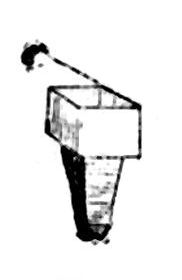
Fig. 7.
Fig. 5 represents one of these. It is made square, of seasoned wood; the front is cut off, near the bottom, and bevelled, as seen more plainly by the section at c; the lower part is a solid plug of wood, and so cut that when the piece a, fig. 6, is put on (marked b in fig. 5), a narrow slit is left just below the edge of the bevel. Through this slit (shown in the section and at a, fig. 7), the air rushes from the wind-chest, and being cut, as it were, by the bevel, produces a sound, deep or shrill, according to the length of the pipe; if the upper part is stopped by a plug, o, fig. 6, the sound is still more sharpened, and a higher note produced. In this way the wooden pipes may be tuned to any pitch. One set of the metal pipes are also made in a similar way; but there is another kind, called reed-pipes, the principle of which is somewhat different, and the sound of them more like that of a clarionet. Indeed, the latter instrument is made in a similar way, except that its reed is not made of metal. The following diagrams represent one of this kind.
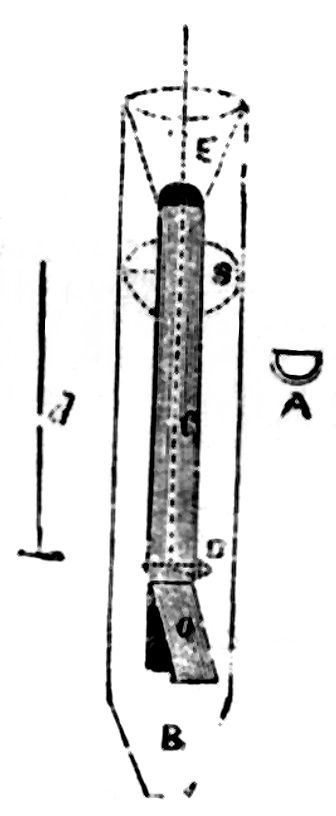
Fig. 8.

Fig. 9.

Fig. 10.
In figs. 8, 9, 10, B is the primary tube of metal, like the one in the last diagram; within this is a half tube, c, of which a section is given at A. The flat part of this tube is covered by a slip of brass, the lower part of which is left to vibrate; this is marked o. In figs. 8 and 10, a piece of wood, S, is inserted in the outer pipe, forming a plug, and also a support for the inner tube, which is passed into it. Thus all the air that enters the outer pipe must pass through the inner tube, and in so doing it causes the part o to vibrate, which produces a sound. The tone is regulated by the wire d, shown dotted in fig. 8. The lower part of this wire rests on the reed, or vibrating slip o, and thus any length may be left to vibrate; and according as a long or short piece is left loose, the tone is deep or shrill. This wire passes through the plug S; E is another tube, also inserted in the piece of wood S, and is, in fact, a continuation of the inner tube. The shape of it varies according to the different style of tone required.
These are the chief pipes in an organ. There are others, especially in large instruments; but we must not lengthen this paper by describing them. We need only add that if a pipe of 12 inches long gives a certain note, one of 24 inches will give its octave below, and one of six inches an octave above. So, also, if an open pipe gives C, it will give the C above if closed. Thus it is easy to arrange the pipes, after one of a certain known length is fixed on for a fundamental note.
We will conclude this explanation of the pipes by stating that they are often 32 feet long in large organs, and so numerous that at Weingarten, in Germany, they number no less than 6,666; and in that organ are no less than 66 stops. At Haarlem also is one containing 60 stops. The flute-stop in the Temple church in London is very sweet; and any of our friends that get the chance should hear that organ, as they will, if fond of music, find there a great treat.
We must now tell you about two additions to the mechanism of an organ—the swell and tremblant. The first is usual in good organs, but the latter is not so often used in this country. The swell consists of a number of open pipes placed in a box in the organ. This box has a moveable cover, connected with a pedal in front. By putting the foot on this pedal the cover is slowly raised, by which means the tone comes forth gradually, swelling louder and louder till the box is quite open; and by slowly letting the pedal go, the tones sink and grow softer and softer, till they die away by degrees. The effect is beautiful, if the player has good taste, and introduces the swell with judgment, which however is often not the case. The tremblant is a valve situated over the entrance of the bellows, by which the air is allowed to enter by fits, giving a trembling mournful sound to the notes. There is a tremblant in the organ at the German chapel at the Savoy.
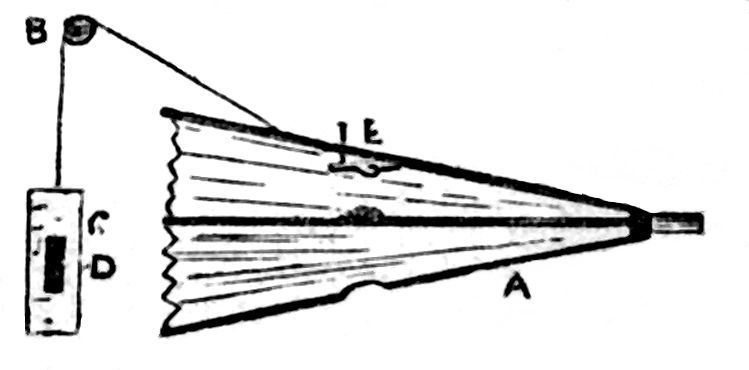
Fig. 11.
There are two or three other contrivances that we must explain, as they are of great use, the first of which is the tell-tale, by which the organist can see how much wind there is in the organ. To the top board of the bellows a cord is attached, which passes over a pulley, as in fig. 11. A is a section of the bellows; B, the pulley; C, a graduated piece of board, placed in front of the organ, and in sight of the player; D, a piece of lead attached to the cord. It will thus be seen that when the upper board of the bellows is at its height, the lead will have sunk on the board to a mark made on it, showing the bellows to be full of wind; but as this wind is expended, the upper board sinks and the lead rises. At E is a safety-valve, to prevent the bellows from bursting. It opens inwards as soon as the board is raised so high that a peg or piece of wire attached to it comes into contact with a stop placed over it. There is usually a tell-tale in front of the organ, and one by the bellows-blower.
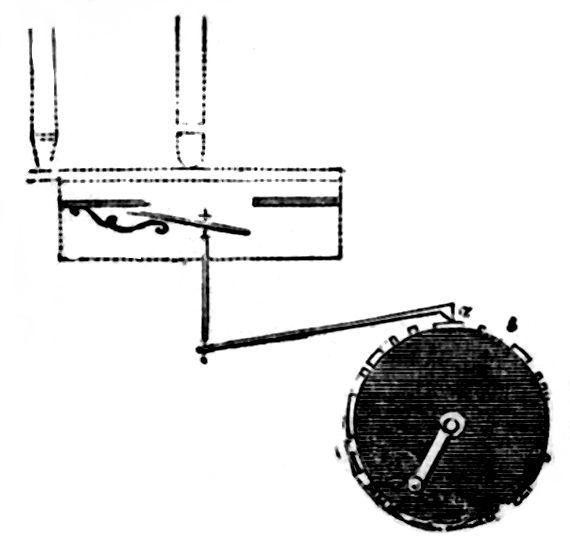
Fig. 12.
Such is the organ in its simplest form, as constructed for churches, and sometimes also for private houses; but of late years the grinding, or barrel organ, has come into use to a great extent, being constructed for the use of those who are not acquainted with music, or are incompetent to play upon those made with keys. When intended only for street-playing there is but one set of pipes; but when made for churches there are stops as in the finger organs. In each case the bellows are worked by a crank upon the axis on which the playing-handle is fixed, and the valves are opened by levers communicating with a series of pegs on a barrel turned by the same handle. Fig. 12 is a section of such barrel, with the pegs and levers. The different notes and tunes depend on the position of the pins in the barrel, each pin, as is evident, acting on the particular lever under which it revolves. The duration of each note depends on the length of each pin, for the long ones, as a, necessarily keep the valve open longer than such as b. Several tunes are arranged on one barrel, the barrel being shifted lengthwise at each, and retained in the same position by a catch acting on notches cut in one end of the axis. It is usual, also, when a great number of tunes are desired, to have several different barrels fitted to the same organ, either of which may be used at pleasure.
There is a great advantage in barrel organs, inasmuch as any one can play them, the only thing necessary being to turn the handle at the same rate; and for this reason they are often used in churches where music would otherwise have been impracticable on account of the difficulty of finding a person able to play upon a finger organ. At the same time, it is impossible to play the various tunes with as great effect as on the latter, which is certainly a drawback, when it is considered how much effect adds to the grandeur of any piece of music executed.
GLASS-PAINTING (TRANSPARENT) FOR WINDOWS, &c. The producing a transparent pattern on the semi-opaque surface of ground-glass is thus effected:—
Having determined on the kind of window which is to be made, and the size of its panes, we cut out in drawing-paper the shape of the pane or panes, and sketch the pattern on this paper with Indian-ink in clear distinct lines. The pattern should be something bold and artistic; a scroll; any variety of star, or style of diamond, or lattice-work; or groups of vine-leaves and grapes, or oak-leaves and acorns; or mottos, or initials in old English letters. It is by no means necessary that all the panes should be alike in pattern or in size, diversity in these points, if tastefully managed, being an improvement rather than an injury to the effect.
When the pattern is drawn, lay the pane of ground-glass on it, with the rough or ground side upwards, and with a fine camel-hair pencil, moistened in copal varnish, trace the outlines of the pattern on to the glass. This done, remove the pane of glass on to a sheet of pure white paper, which will enable the tracing to be seen, and then, with appropriate brushes, put in the shading and the clear parts, and perfect the pattern. Wherever it is intended that the glass shall be clear, there with copal varnish fill up the space, as every touch of the varnish clears the glass; the untouched portions, by retaining their whitish, semi-opaque appearance, serve as a background, and throw up the pattern.
The varnish used should be obtained at an artists’ colourman’s, and should be as clear and devoid of colour as possible. The camel-hair pencils should be only moistened with it, for if loaded or saturated, they are apt to make blots, or jagged, uneven outlines and strokes; enough varnish to render the glass transparent, but no more than enough, is to be laid on, or the pattern will look rough and unequal, instead of smooth and even. A small phial of spirits of turpentine should always be standing by, in which the camel-hair pencils may be washed before they begin to dry, for if suffered to dry, or put away with any varnish in them, they harden, and become utterly useless. They must, therefore, be immediately well washed in spirits of turpentine, and then carefully wiped in a soft linen rag, or an old silk handkerchief.
When the pattern has been duly elaborated, in the manner described, the pane of glass must be set aside for eight or ten hours, in a warm dry place, where nothing is likely to touch it, and where dust cannot settle upon the sticky surface. After it has thus had time to become slowly and thoroughly dry, it must be immersed in clear cold spring water for five or ten minutes, and then be placed on edge to drain itself. If the varnish is good, the pattern will now be firmly set, and stand out in clear relief on the semi-opaque ground.
Exposure to moderate heat will turn the transparent parts of the glass from crystal white to orange brown; but this is an operation requiring great care, as too great heat will often split the glass, or at least render it very brittle.
A pretty window may be easily and quickly prepared thus:—It may contain twelve square panes, and thirty-one long narrow ones; or six square panes and thirteen long narrow ones; or any number of each which will admit of each square pane being set in, or framed by, four of the narrow ones. The square panes are to contain a transparent pattern on the ground glass; the narrow ones are all to be of one colour, as rich blue, or carmine, or yellow, or violet. To render them thus we must use water-colours in cakes, as Prussian blue, carmine, gamboge, or, for the violet, Prussian blue and carmine. Having rubbed down the paint we intend to use on a China palette, with a full camel-hair brush, we lay the shade evenly and smoothly over the whole of the narrow pane, and, when the paint is dry, varnish it with the copal varnish, and then, having allowed the varnish the requisite number of hours to dry, immerse the pane in water, and again dry it, when it will be fit for use.
The cake water-colours are those used for this transparent painting. We need not add that the best will alone produce such effects as will confer pleasure. Those which are opaque must be avoided. The following, with the combinations they are capable of producing, will be found sufficient for most purposes: Prussian blue, ultramarine, indigo, gamboge, yellow lake, burnt sienna, purple lake, carmine, scarlet or crimson lake; Vandyke brown, madder brown, and ivory black. The greens must be made by combining gamboge with one of the blues; as almost all cake greens, except verdigris, are opaque.
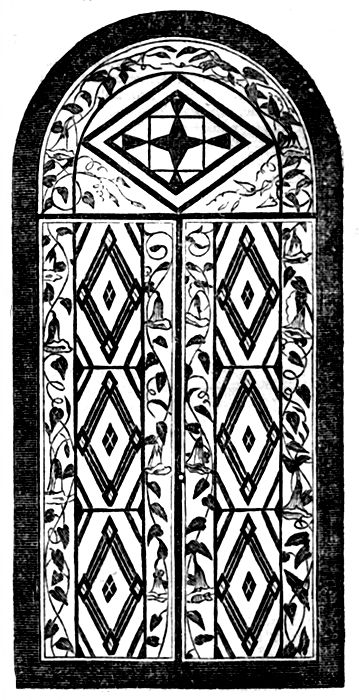
We lay the square of glass which is to be painted on the copy, with the ground side towards us, and the glassy one downwards; with a fine lead pencil we then trace the outlines on to the ground surface, and having done so, remove the square on to a sheet of white paper, and proceed to work exactly as if we were about to paint a group of flowers, or a landscape with water-colours on cardboard, working it up as artistically, and as carefully avoiding all that looks like daubing.
It is generally as well to let one shade dry before we add another to it, or work it up by deeper touches; for if the paint is washed out, or taken off by the touch of the brush, a patchy appearance is given to the thing.
When the painting is completed and thoroughly dry, it is to be smoothly varnished all over with the copal varnish; but this is a manipulation requiring great care, for if the outline be not perfectly kept, the transparency extends to the white parts of the glass, and mars the effect of what should be the ground-work of the picture. When the varnish is dry, the pane is to be immersed in water as before directed, and placed to dry.
In the design exhibited in page 196, the square panes have a transparent pattern on the white ground glass, and the narrow-side panes contain wreaths of convolvulus, painted and thrown up in transparency on the ground glass. All the black lines and marks in the cut are intended to represent the transparent or varnished parts of the pattern, while the white is the untouched ground glass.
In the following design, the square panes contain transparent groups of painting, while the narrow ones have a pattern in clear glass on the white ground; or the ovals and lozenges in the narrow panes may be made of some transparent colour, while the lines and dots are simply transparent.
All kinds of armorial bearings and heraldic devices may be given with great brilliancy and effect in this transparent glass-painting.
Scriptural subjects, either with the quaint, hard outlines and glowing tints which we see in some illuminated missals, or delicately worked up and finished off; groups of brightly-plumaged birds, or gorgeous butterflies, mottos, devices, shaded scrolls; in short, anything fancy as taste may dictate and combine, and skill work out, can be produced.
Brilliancy of effect must be aimed at, and at the same time a lightness and smoothness of colouring maintained.
The simplicity of this art, and its perfect adaptation for a drawing-room occupation, as well as its usefulness in beautifying an abode, and giving an air of elegance to what would else be merely common-place, renders it one that ought to become generally known.
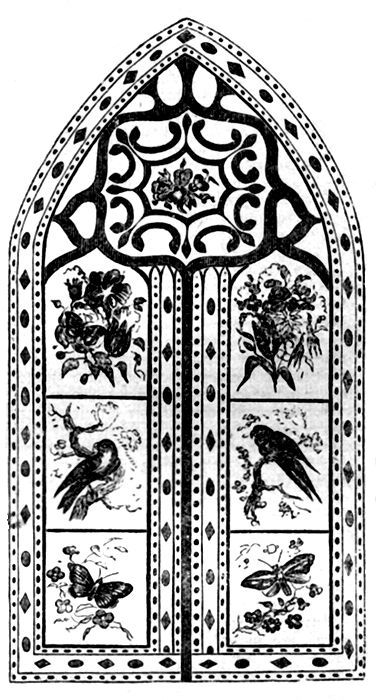
HONEY-SOAP. Cut thin two pounds of yellow soap, into a double saucepan, occasionally stirring it till it is melted, which will be in a few minutes if the water is kept boiling around it; then add a quarter of a pound of palm oil, quarter of a pound of honey, three pennyworth of true oil of cinnamon; let all boil together another six or eight minutes; pour out and stand it by till next day, it is then fit for immediate use.
PENCIL MARKS (TO PRESERVE). If you have anything drawn or written with a lead pencil that you wish to preserve from rubbing out, dip the paper into a dish of skimmed milk. Then dry it, and iron it on the wrong side. In ironing paper do not let the iron rest a moment, (as it will leave a crease or mark,) but go over it rapidly.
SEASONS (THE). The variation of the seasons, and the difference of the length of days and nights in those seasons, result from the same cause.
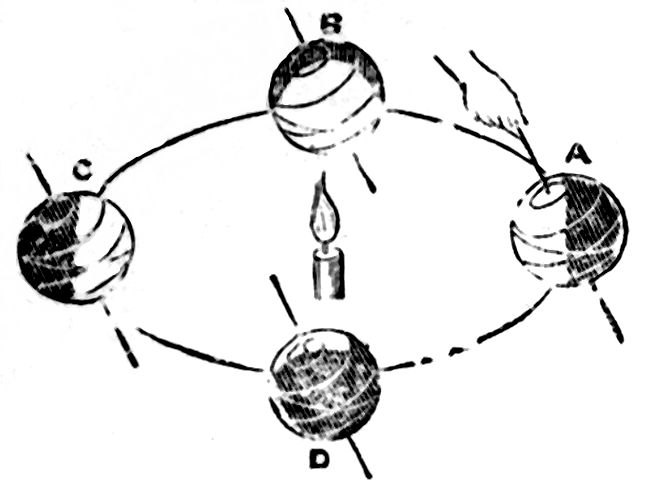
In moving round the sun, the axis of the earth is not perpendicular to the plane of its orbit—in other words, its axis does not move round the sun in an upright position, but slanting, or oblique. This may be understood more clearly by carrying a small globe round a candle, which is to represent the sun. You must consider the ecliptic drawn on the small globe as representing the plane of the earth’s orbit; and the equator, which crosses the ecliptic in two places, shows the degree of obliquity of the axis of the earth in that orbit, which is nearly 23½ degrees. The points in which the ecliptic intersects the equator are called nodes. The globe at A is situated as it is in the midst of summer, or what is called the summer solstice, which is on the 21st of June. The north pole is then inclined towards the sun, and the northern hemisphere enjoys much more of his rays than the southern. The sun now shines over the whole of the north frigid zone, and, notwithstanding the earth’s diurnal revolution, it will continue to shine upon it as long as it remains in this situation, whilst the south frigid zone is at the same time completely in obscurity.
Let the earth now set off from its position in the summer solstice, and carry it round the sun; observe that the axis must be always inclined in the same direction, and the north pole point to the same spot in the heavens. There is a fixed star situated near that spot, which is hence called the north polar star. The earth at B has gone through one quarter of its orbit, and is arrived at that point at which the ecliptic cuts or crosses the equator, and which is called the autumnal equinox. The sun now shines from one pole to the other. At this period in the year, the days and nights are equal of every part of the earth; but the next step she takes in her orbit involves the north pole in total darkness, whilst it illumines that of the south. This change was gradually preparing as the earth moved from summer to autumn. The instant the earth passes the autumnal equinox, the long night of the north pole commences, and the south pole begins to enjoy the light of the sun. As the earth proceeds in her orbit, the days shorten and the nights lengthen throughout the northern hemisphere, until it arrives at the winter solstice, on the 21st of December, when the north frigid zone is entirely in darkness, and the southern enjoys uninterrupted daylight. Exactly half of the equator, it will be observed, is enlightened in every position, and consequently the day is there always equal to the night.
Observe, that the inhabitants of the torrid zone have much more heat than we have, as the sun’s rays fall perpendicularly on them, while they shine obliquely on the temperate, and almost horizontally on the frigid zone; for during their long day, the sun moves round at no great elevation above their horizon, without either rising or setting.
To a person placed in the temperate zone, the sun’s rays will shine neither so obliquely as at the poles, nor so vertically as at the equator; but will fall upon him more obliquely in autumn and in winter than in summer. Therefore, the inhabitants of the earth between the polar circles and the equator will not have merely one day and one night in the year, as happens at the pole; nor will they have equal days and equal nights, as at the equator, but their days and nights will vary in length at different times of the year, according as their respective poles incline towards or from the sun, and the difference will be greater in proportion to their distance from the equator. During the other half of her orbit, the same effect takes place in the southern hemisphere as we have just remarked in the northern. When the earth arrives at the vernal equinox, D, where the ecliptic again cuts the equator, on the 22nd of March, she is situated with respect to the sun exactly in the same position as in the autumnal equinox; excepting that it is now autumn in the southern hemisphere, while it is spring time with us; for the half of the globe, which is enlightened, extends exactly from one pole to the other. On the two days of the equinox, the sun is visible at both poles, but only half of it is seen from either, the other half being concealed by the horizon.
METALLIC PENS (TO PREVENT INK DAMAGING). Throw into the inkstand, or the ink bottle, a few nails, or any piece of iron not rusted. The action of the acid in the ink will be expended on the iron.
MOON AND ECLIPSES (ON THE). This satellite revolves round the earth in the space of twenty-seven days eight hours, in an orbit nearly coinciding with the plane of the earth’s orbit, and accompanies us in our revolution round the sun. Her motion, therefore, is of a complicated nature; for, as the earth advances in her orbit, whilst the moon goes round her, the moon proceeds in a sort of progressive circle.
The moon always presents the same face to us, by which it is evident that she turns but once upon her axis while she performs a revolution round the earth; so that the inhabitants of the moon have but one day and one night in the course of a lunar month. Since we always see the same hemisphere of the moon, the inhabitants of that hemisphere alone can see the earth. One-half of the moon, therefore, enjoys our light every night, while the other half has constantly nights of darkness; and we appear to the inhabitants of the moon under all the changes, or phases, which the moon exhibits to us.
When the moon is in the same direction from us as the sun, we cannot see her, as her dark side is towards us; but her disappearance is of very short duration, and as she advances in her orbit, we perceive her under the form of a new moon. When she has gone through one-sixth of her orbit, one quarter of her enlightened hemisphere will be turned towards the earth, and she will then appear horned. When she has performed one quarter of her orbit, she shows us one-half of her enlightened side. She next appears gibbous; and after that full. As she proceeds in her orbit she becomes again gibbous, and her enlightened hemisphere turns gradually away from us, till she completes her orbit and disappears; and then again resumes her form of a new moon.
When the moon is full, she is always in opposition to the sun—when a new moon, in conjunction with it. At each of these times the sun, the moon, and the earth are in the same right line; but in the first case, the earth is between the sun and the moon; in the second, the moon is between the sun and the earth. An eclipse can only take place when the sun, moon, and earth are in a straight line, or nearly so. When the moon passes between the sun and the earth, she intercepts his rays, or in other words, casts a shadow on the earth: this is an eclipse of the sun, and it continues whilst the shadow is passing over us. When, on the contrary, the earth is between the sun and the moon, it is we who intercept the sun’s rays, and cast a shadow on the moon; she then disappears from our view, and is eclipsed.
Why, it may be asked, have we not a solar and a lunar eclipse every month? Because the planes of the orbits of the earth and moon do not exactly coincide, but cross or intersect each other; and the moon generally passes either on one side or the other, when she is in conjunction with, or in opposition to, the sun; and, therefore, does not intercept the sun’s rays, or produce an eclipse; for this can only take place when the earth and moon are in conjunction near those parts of their orbits which cross each other (called the nodes of their orbits), because it is then only that they are both in the same plane, and in a right line with the sun.
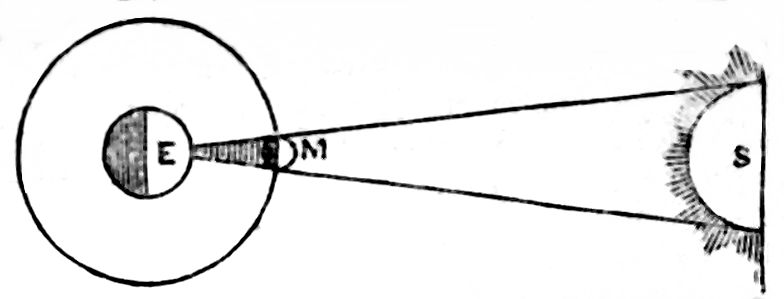
A partial eclipse takes place when the moon, in passing by the earth, does not entirely escape her shadow. When the eclipse happens precisely at the nodes, they are not only total, but last for some length of time.

When the sun is eclipsed, the total darkness is confined to one particular spot of the earth, as the moon’s shadow is not large enough to cover the earth. The lunar eclipses, on the contrary, are visible from every part of the earth, where the moon is above the horizon.
MAST. An elevated pole in a ship, to which are attached the sails to catch the wind. It is supported by an ingenious combination of ropes, adapted to ascend for the purpose of adjusting the sails. Masts are divided into fore, main, and mizen; and the middle or mainmast in large ships is divided into lower, top, and top-gallant.
SEVEN WONDERS (THE). They were the Egyptian pyramids; the mausoleum erected by Artemisia; the Temple of Diana at Ephesus; the walls and hanging gardens of Babylon; the Colossus at Rhodes; the statue of Jupiter Olympus; and the Pharos, or watch-tower, at Alexandria.
RIGGING. The system of ropes belonging to a ship, by which the masts are sustained and ascended, and the sails managed. The names and uses of the several ropes, and the dexterous management of them, constitute an able sailor.
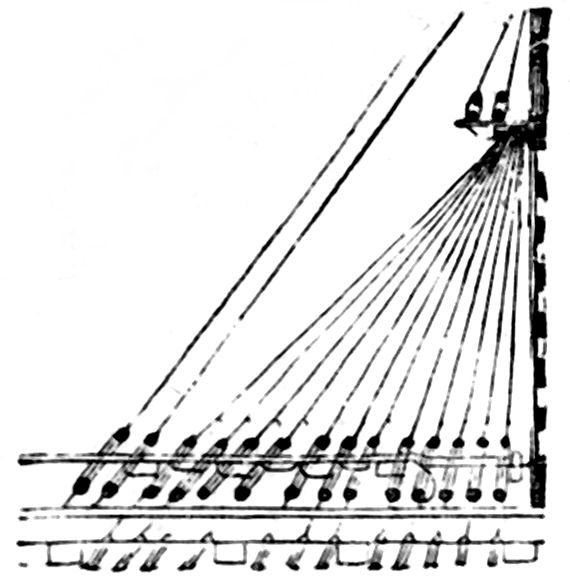
ROSES (PROPAGATION OF). Roses require a strong, loamy soil, and the deeper it is the better, if the subsoil be dry. Where the ground is not naturally rich, a quantity of rotten manure should be added to it, and, every spring, manure forked in about the plants.
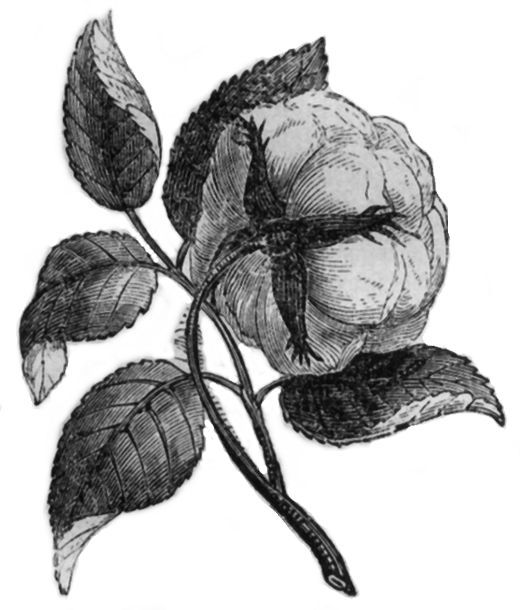
Roses are propagated chiefly by cuttings, layers, and buds. Cuttings of the hardy kinds of roses, such as the hybrids of the Chinese and Bourbon, the Boursault, Ayrshire, Evergreen, Multiflora, and the Hybrid Perpetual, may be struck in the open ground. The best time is in autumn, just before the fall of the leaf. The cutting may be from nine inches to a foot in length, and should be taken off close to the old wood, with what gardeners term, a heel. Fig. 1 represents a cutting ready for planting, a is the heel.
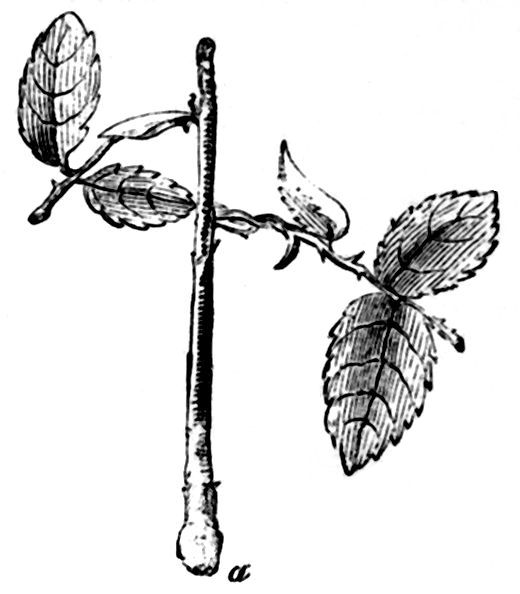
Fig. 1.
When the cutting is planted, two or three eyes should be left above the ground. If you have a quantity, they may be inserted about an inch apart, and a few small boughs, or fern fronds, stuck in amongst them, as a shelter from sun and frost. In spring, those that have not struck root, should be pulled out; and in autumn, those which have succeeded may be transplanted to where it is intended they are to flower. Cuttings of the more tender kinds—as the Bourbon, Noisette, Chinese, and Tea-scented, should be placed under a hand-glass. The glass should be occasionally lifted on fine days, to admit air, and dry the soil; any decayed leaves or cuttings should at such times be removed; water will seldom be required till the spring. About April these cuttings will have rooted; they should then be taken up, potted singly, and removed to a frame, or a close shaded room, for a few days. Such as are intended to be grown in the open air should be planted out in May. Roses grown as dwarfs, or bushes, are the kinds most generally layered. The soil about the plant should first be loosened; then, selecting a good shoot, strip off a few leaves at a distance varying from six inches to two feet from the point of the shoot (see fig. 2 a a); then, taking the shoot in the left hand, insert a sharp knife just behind an eye, at b, on the upper side of the shoot, and pass it evenly and carefully upwards, cutting about half through the shoot, and for an inch and a half or two inches in length. Bend down the shoot, so that you may see the proper place to bury it; then open a hole, press the shoot into it, peg it down two or three inches beneath the surface, and cover with the soil. It is well to twist the shoot a little after the cut is made, so that the end of the tongue, b, from which the roots will be emitted, may have a downward direction when in the ground. It is also a good plan to split the tongue, and keep the split open by inserting a small stone in it. Each layer should be tied to a small stake, c, to prevent its being agitated by the wind.
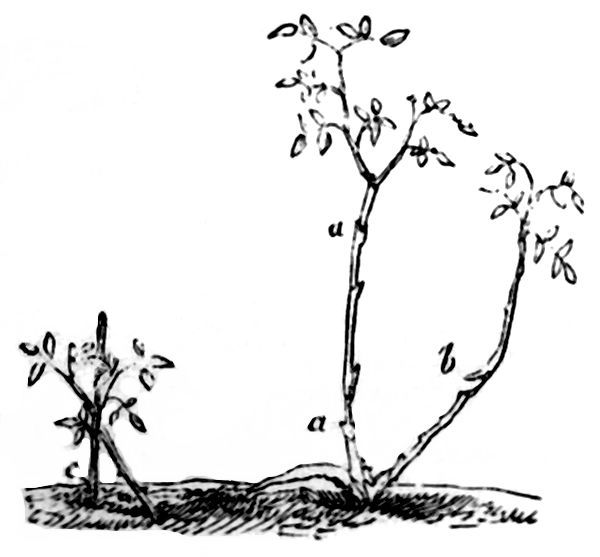
Fig. 2.
June, July, and August, are the best months for layering; if the weather be dry, the layers should be watered. About November they will be ready to be taken from the parent plants, by cutting them off within two inches from the tongue; then transplant them to wherever they are intended to flower. In spring they should be pruned down to three or four eyes: some of them will bloom the same summer or autumn. Standard roses are well-known ornaments of the garden; they look well in any position, but appear to the greatest advantage when planted in opposite and parallel lines in the centre of two beds, one on each side of a central or principal walk. In pruning, the young shoots should be annually shortened to about two or three inches from the point they started from; and if the head should become too large and straggling, some of the old wood should be cut out, and its place supplied by young shoots, which spring from the centre; keeping in view, as you prune, that the beauty of a standard consists principally in its having a round compact head, so as to present a favourable appearance when seen from any side. Weeping roses form beautiful objects when planted singly on lawns; they are roses of a pendulous habit, such as the Ayrshire and Evergreen, budded on stocks four feet and upwards in height. The main shoots ought not to be shortened, after the second year, until they reach the earth; prune the laterals only, and flowers will be produced all along the branches from the head to the ground.

Fig. 3.
When they attain their full size, a hoop, as in fig. 3, should be attached, to prevent the branches being injured by the wind. Fig. 3 represents a weeping rose of full growth, without leaves, to show how it should be trained and pruned.—Family Friend.
TOAD. A harmless, but unsightly amphibious animal; very tenacious of life, and believed, when enclosed in stones and trees, to be able to exist for many centuries; being torpid during the winter, they creep into crevices, and sometimes become enclosed by petrifactions or concretions. They live on small worms and insects, and are great enemies of wasps. The Pipa, or Surinam toad, is larger than our toad, and more ugly; but its young grow in cells on its back from eggs to tadpoles, and then to perfect toads in large numbers.
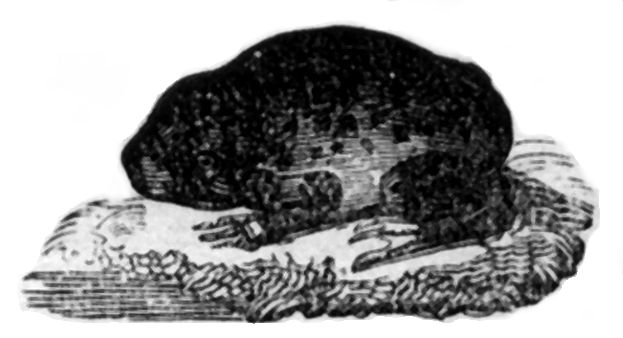
GALVANISM. Galvanism is so intimately connected with electricity, that it may be considered as a branch of that science. It was first accidentally discovered in the chemical laboratory of M. Lewis Galvani, professor of anatomy in the university of Bologna, upon the following occasion: The lady of the professor being of a delicate habit, was occasionally supported by soup made from frogs as a restorative. Some of these animals, skinned for that purpose, were lying upon a table in the laboratory of the professor, in which stood an electrical machine. One of the assistants, in experiment, by accident brought the point of the scalpel near the crural nerves of a frog recently killed, lying not far from the conductor; the muscles of the limb were instantly set in motion, being agitated with strong convulsions. By a long series of new experiments, the law of nature, as far as respects the influence of this principle, was investigated, of which mere accident had at first afforded him a glimpse only. Galvani published a treatise on the subject, addressed to the Institute of Bologna, in the year 1791. On the appearance of this work, the universal attention of the philosophers of Europe was arrested. This discovery was made at a time when something more than hypothesis was necessary to satisfy the mind of the inquisitive inquirer after scientific truth. To this desire may be referred the almost innumerable experiments which were made in every district in Europe, in consequence of this publication; by which means the science became considerably enriched by the addition of a great variety of new facts, by contemporaries and successors, insomuch that it is said the labours of Galvani, the original discoverer, bear but a comparatively small proportion to what have been since adduced for its illustration.
Galvani found, that, by the mere agency of a metallic substance, where he had no reason to suspect the presence of electricity, the limbs of a recently-killed frog were convulsed; and having ascertained the fact by a number of experiments, he in the course of his inquiries found that the convulsions or contractions were produced only when dissimilar metals were employed. It was now inferred that electricity is not only produced by the friction of bodies, but even by the mere contact of certain substances. At the same time it was admitted, that these substances must have some chemical agency or action upon each other, and that the effect produced seems to be proportionate to the degree of chemical action. The following well-known facts were now supposed to be explained by this science. Porter taken from a pewter pot has always been held by connoisseurs in that liquor to be better than when taken from china or glass: this was now said to arise from a certain decomposition effected by means of the liquor in the vessel—the porter and the saliva on the under lip coming in contact with the metal. Pure mercury retains its metallic splendour a long time, but its amalgam with tin, &c., is almost immediately oxydated or tarnished. Inscriptions of very ancient date, on pure lead, have been found in a perfect state, while others of modern times, made on compound metals, are corroded and scarcely legible. Works of metal, whose parts are soldered together by means of other metallic substances, soon tarnish, or are oxydated about the places in which the different metals are joined. So likewise is the copper on ships, which is fastened on by means of iron nails. Zinc also may be kept a long time under water, with scarcely any change; but if a piece of silver touch the zinc while under water, there will be very soon a sensible oxydation. Take a piece of zinc and place it under the tongue, and lay a piece of silver as big as half-a-crown on the tongue, and no particular taste will be observed; but, bring the outer edges of the metals together and a very disagreeable taste will be perceived, which is said to arise from the decomposition of the saliva, a watery fluid. The same thing may be noticed with a guinea and a piece of charcoal. These facts have been thus explained, and the theory generally admitted:—The conductors of electricity, however they may differ from each other in their conducting powers, may be divided into two classes. The first class, which are denominated the dry and more perfect conductors, consist of metallic substances and charcoal; the second class, called also imperfect conductors, are waters, acids, &c. From these, or some of them, all Galvanic Circles, as they are named, are formed.
Hitherto this influence or agent had been chiefly investigated with reference to its operation on animal substances. Hence its popular name was for a long time, Animal Electricity: but it being soon found that its agency was more extensive, that it possessed powers not indicated by this denomination, and that of course the retention of this name would lead to error, the word Galvanism was adopted in its stead. This extension of the Galvanic principle was connected with new discoveries, and improvements from various quarters; these, however, for a considerable time, were generally small, and unimportant in their nature. But among all the recent discoveries in Galvanism, that made by Professor Volta, in 1800, is most remarkable in its nature, and most interesting in its relations. Volta set out with the idea, contrary to that of Galvani, that the electricity did not belong to the animal, but to the different metals employed. Galvani was not likely to produce any greater effect than what could be obtained by two pieces of metal, because he believed the electricity to be in the animal. Volta was led to the discovery of the battery, by combining a number of pieces of metal together, because he was persuaded that the electricity was in the metals or fluids employed. These repeated combinations obtained the name of Galvanic, or more properly, Voltaic batteries: and the science itself is usually denominated, from the discoveries resulting from these batteries, Voltaism.
The simplest galvanic apparatus consists of a set of tumblers, containing water slightly mixed with nitric or sulphuric acid, which are connected by bent wires with a piece of zinc at one end, and a piece of copper at the other; connect the tumblers by placing these in them all in the same order—one metal in the first and last, and both metals in each intermediate one:—touching the first copper and the last zinc with the fingers will occasion a shock.
The pile is made thus: Take twenty or thirty pieces of zinc, each as large as a penny. Get as many pieces of copper about the same size, and also as many pieces of paper or cloth, which are to be dipped in a solution of salt and water. In building up the pile, place zinc, paper, copper, &c., constantly in the same order until the whole be finished. The sides of the pile may be supported with rods of glass, or varnished wood, fixed in the board on which it stands. The following experiments may then be performed:—
Having wet both hands, touch the lower part of the pile with one hand, and the upper part with the other; a slight shock of electricity will be felt as often as one hand is removed. If the hand be brought back, a similar shock will be felt. Put a basin of water near the pile, and put the left hand into it, holding a wire, the one end of which touches the top of the battery or pile; then put the end of a silver spoon between the lip and the gum, and with the other end of the spoon touch the lower part of the pile; a strong shock is felt in the gum and in the hand. Take the left hand from the water, but still keep hold of the wire, and then perform the last experiment in the same manner, and a shock will be felt in the gum only. Hold a silver spoon in one hand, and touch with it the battery at the lower part, then touch the upper part with the tongue; the bitter taste is extreme. In performing the above experiments, if, instead of the two ends of the pile, the one end and the middle of it be touched, the sensations will not be nearly so strong.
The Galvanic trough is a very powerful apparatus; it is composed of zinc and copper plates placed in pairs, so that all those of one metal lie toward the same end. The end plates have connecting wires; and when the trough is filled with water, impregnated with nitric or muriatic acid, and the points of the wires brought together, the action is remarkably powerful; any number of troughs may be united and made to act at once. In this way substances have been decomposed on which the strongest fires had no effect.
Modern research has considerably augmented our knowledge of Galvanism. It was, after some time, discovered that the efficiency of a Galvanic Circle depends on its being formed of three bodies, two of which have a powerful effect on each other, but neither of them, if possible, any on the third. Hence perfectly pure zinc, or (what answers extremely well) zinc amalgamated with mercury, platina, and dilute acid; or charcoal, zinc, and acid; form batteries which are very effective, and which from their long-continued actions are called constant batteries; indeed, the zinc in them is not at all acted upon by the acid in which it is immersed, unless when connected with the platina, &c., by means of a wire or some other conductor, and then only to an extent proportioned to the goodness of the conductor which connects them.
Galvanic action is now applied to a very interesting and useful purpose, which is called the Electrotype process. This enables us with great facility, and the most perfect exactness, to copy medals, engraved copper-plates, &c., and to cover almost any substance with gold, silver, copper, &c. In its simplest form it may be illustrated by a small Galvanic battery, consisting of a vessel of unglazed porcelain, within which is a piece of zinc immersed in dilute sulphuric acid, and outside of it a plate of copper immersed in a solution of blue vitriol (sulphate of copper); when the zinc and copper are connected together by a wire, &c., the former will be gradually dissolved, and the latter covered with fine copper deposited from the blue vitriol.
The experiment will be more perfect when a generating cell (a constant battery) and a decomposing cell are used. Let us suppose the generating cell to consist of amalgamated zinc, platina, and dilute sulphuric acid; and the generating cell to be a vessel containing a solution of blue vitriol, in which a plate of copper and the medal intended to be copied are immersed, without being in contact. When the zinc of the generating cell is connected with the medal, and its platina with the plate of copper, the medal will in a few hours be covered with a plate of pure copper, whose thickness will depend on the time used in forming it, &c., and which being removed from the medal, and placed instead of it in the generating cell, will constitute a matrix, and be covered with copper, thus affording a copy of the medal, than which nothing can be more exact. The same matrix will, it is evident, be sufficient for the production of an indefinite number of copies.
RETORT. A vessel capable of bearing great heat, with an open end. Any substance intended to be acted upon by great heat being put into it, is exposed in it over a lamp, or other fire, and on being volatilized, passes through the end into any other vessel adapted to receive it, as in the engraving.
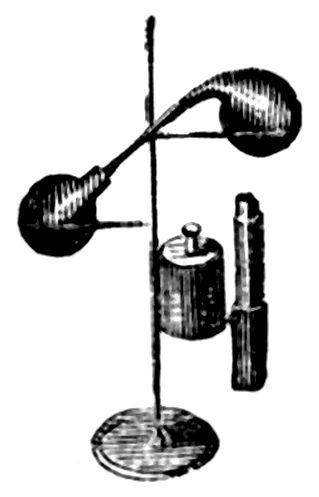
ARTESIAN WELLS. These are deep wells, sunk down to some stratum, which is pierced, and the water suddenly rises in the well as high as the source of the spring, which may even be higher than the ground where the well is sunk, and then the water will pour out as a fountain, or flow over. The deep wells in London are of this kind, and the water in them is remarkably pure. The name “Artesian” is derived from the province of Artois, in France, where, it is said, they were first excavated.
MITE. An insect without wings, with eight legs, two eyes, and two large joints. It is very prolific, and will live many months without food.
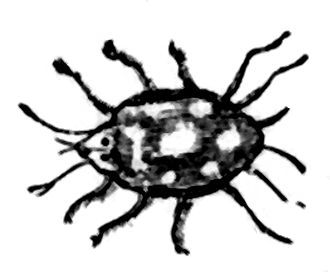
CHRYSIDIDÆ. These are the hummingbirds of entomologists. They are adorned with the most splendid and effulgent colours, tastefully arranged, and blended in perfect harmony.
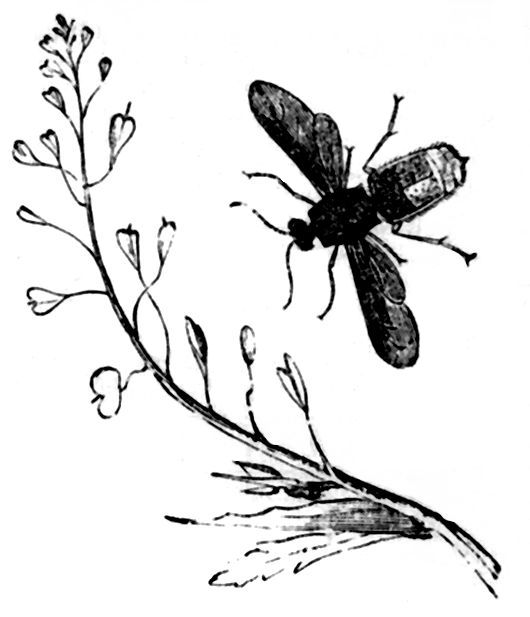
Who can look without admiration upon this member of a beauteous tribe, the Chrysis fulgida, or golden fly, a creature partially enwrapped in a shining coat of mail; the head, thorax, and first segments of the abdomen and legs bright blue, variegated with green and purple; the second and third segments of a bright crimson, reflecting gold and green? Thus gaily attired, the insect no sooner attains perfection, than he finds a ready supply for all his wants in the humble-looking shepherd’s-purse, a small way-side plant, which presents a striking contrast to his own brilliant vestments. About sixteen species of the tribe pertain to Britain; among which the golden fly may be seen during the warm days of June merrily running with his companions up and down the southern side of walls and pailings, glittering in the sun beams, and delighting the lover of nature with his resplendent hues.
OCTAHEDRON. A solid figure with eight faces.
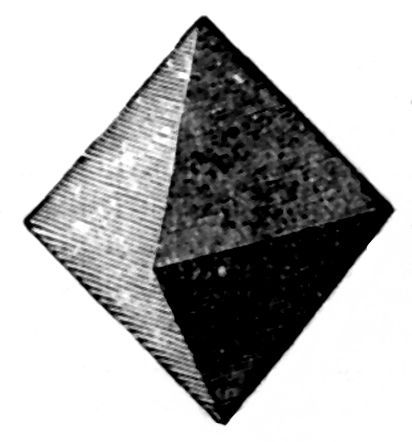
FERNS. Begin to unfold in March, and the botanist who seeks for them in woods and bank-sides may often discover round hairy-looking balls, of a rich brown colour, emerging from among the grass and mosses. Such balls contain some infant fern, carefully folded up, but soon to yield to the joint ministry of showers and sunbeams, and to stand forth in its singleness and beauty.
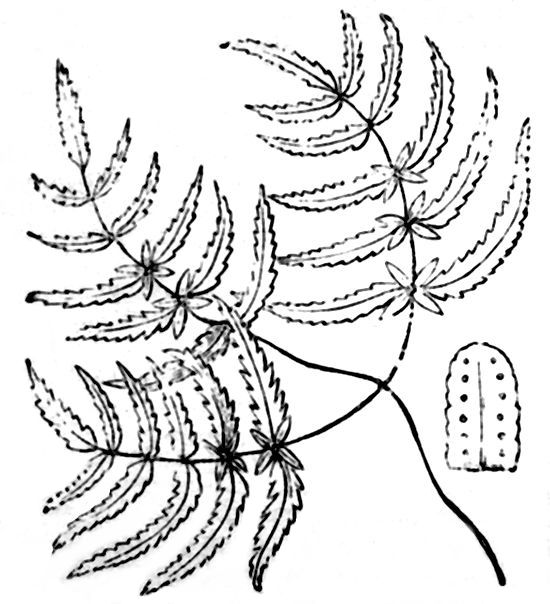
Oak fern grows generally in wild and mountainous districts, and although one of the most elegant and attractive of our native species, seems instinctively to avoid the abodes of men, and fixes itself in places overhung with rocks, or thick foliage. The roots are black and fibrous, and the young fronds make their appearance in March and April; they each resemble three small balls, upheld on wires, which gradually unfold and display a triple division; the fronds arrive at maturity early in the summer, and entirely disappear before the storms of winter. This species, the Polypodium dryopteris of botanists, derives its specific name from being occasionally found among the mossy roots of aged oaks. Its localities are often associated with local scenery and time-haunted ruins, with the remembrance of Druidic observances and rites, and places renowned in history. Dry, stony heaths, in Yorkshire, Lancashire, Westmoreland, and Scotland, are some of its favourite resorts, though growing in great luxuriance beside the fall of Lodore, on the side of Derwentwater, in Cumberland. The unfolding of this graceful species is ever welcome. Its emerging from the earth uniformly indicates the passing by of winter storms, and is accompanied by the lesser celandine, with its glossy yellow cups—the speedwell, and hawthorn, and those two most fragrant flowers, the violet and the meek soft-eyed primrose. The mezereum, that fills the air with fragrance, and daffodils—
“That come before the Swallow dares, and tint
The winds of March with beauty,”
often affect the same locality. Fronds of the Broad fern (Lastræa dilatata, or Aspidium dilatatum and spinulosum, and Polypodium cristatum, for by each of these names has the Broad fern been designated) also appear in March, and, although thus early developed, are rarely injured by the frost.
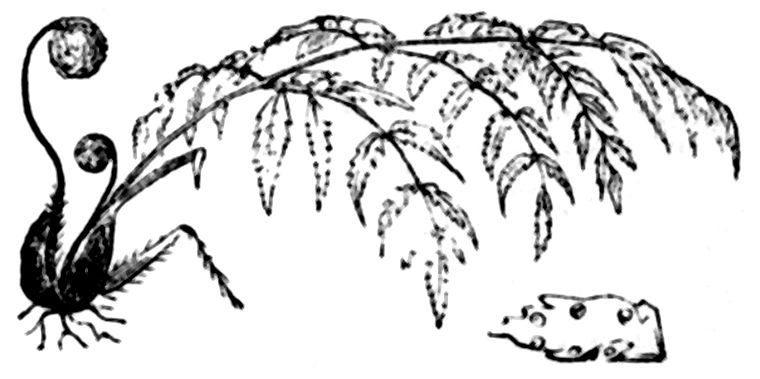
New fronds succeed one the other as months pass on; they apparently attain their maturity in September, and continue green and vigorous throughout the winter; yet only in sheltered places, for the Broad fern seems to shrink instinctively from cold. This fern occasionally assumes a dissimilar appearance from such as it generally presents, and is therefore somewhat puzzling to inexperienced botanists.
RAINBOW. An effect on drops of rain, from the different refrangibility of the rays of light which produce different colours. The inner bow is produced by a refraction at the entrance of the drop, a reflection from its back, and a refraction at its exit, or by two refractions and one reflection.
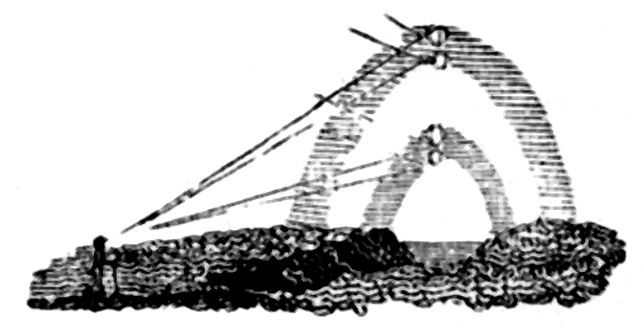
The outer bow by two refractions and two reflections within the drop; and, as much of the light is dispersed by the two reflections, so the outer bow is fainter than the inner bow. As all the drops in a shower are affected at the same time, so all the colours of light are visible anywhere to a spectator whose back is to the sun, in circles which are from 55 to 52 degrees, and from 42½ to 40 degrees from the eye; but in the two bows the colours are reversed. The two bows may be imitated by small glass globes of water placed within the above angles from the eye, or by throwing up water with an engine. A line passing from the sun through the eye of the spectator goes to the centre of the bow, so that the height of the bow is inversely as the height of the sun; and, if the sun is more than 42 or 54 degrees high, there can be no bow. Of course, as it is a mere optical effect, depending on the position of the eye, no two persons can see the same bow. The moon, or any strong light, will make a coloured bow as well as the sun.
MAGNETISM, &c. The production of magnetism by electricity is another of the important results which have arisen from an increased knowledge of Galvanism.
Almost everyone knows that property of the magnet which causes it to attract iron and a few other substances. This attractive power may be communicated temporarily to soft iron, and permanently to steel, either by the natural magnet (the loadstone) or the artificial (a magnetized bar of steel). If a magnet be suspended freely it will arrange itself north and south; that is, one pole or extremity will point almost north, and the other in the opposite direction. This directive power, as it is called, is what makes the mariner’s compass so useful to the navigator. By its aid he may traverse the pathless ocean during the darkest night in the utmost security; and yet it consists merely of a needle (a small bar of steel magnetized) balanced on a fine point, so that it can move in every direction over a circular card, marked with 32 divisions (called points) in its circumference.
If a bar of steel is carefully balanced on a point, and then magnetized by rubbing it to a magnet, or by any other means—except in a part of the earth just midway between the magnetic poles—it will no longer remain in equilibrio, but will form an angle with the horizon, which is called the angle of dip. Hence, to make the needle of the mariner’s compass assume and preserve a horizontal position, we are obliged to render one end of it heavier than the other. We have already said that the needle does not, when left to itself, point due north and south; the angle it makes with a horizontal line lying in the meridian of the place is called the angle of variation of that place. It is to be remarked that this angle is not always the same even at the same place. Both “dip” and “variation” arise from that cause which makes the needle point to the magnetic poles, namely, the earth being a great magnet and acting as such on the needle. We may illustrate both dip and variation by placing a magnetized bar of steel under the needle in such a way as that it will occupy the same positions with reference to it as the magnetic axis (a line passing through the magnetic poles) occupies.
It only remains to show why the earth acts towards the needle as if it were a great magnet. The earth is what is called an electro-magnet; that is, one formed by the circulation of electrical currents around it. The connexion between electricity and magnetism was long known; but that electricity circulating around the needle will cause it to be deflected from its ordinary position, and that the same current passing round a bar of iron would magnetize it, are facts which constitute a recent and very important discovery.
The currents which produce the magnetism of the earth are due to the enormous evaporation from its surface, and to the constant change of temperature caused by revolution on its axis, which exposes different parts of it in succession to the sun’s rays.—Electricity developed during change of temperature has been designated thermo-electricity.
We are not to suppose that only ferruginous substances (although the best for the purpose) or even metals alone are capable of being magnetized by means of electricity. We may illustrate the most interesting facts in electro-magnetism by covering copper wire with worsted, cotton, or some other bad conductor of electricity, and then coiling it round a bar of iron. On connecting the extremities of the wire-coil or helix, as it is termed, respectively, with the plates of a Galvanic Circle, the iron bar will be found to be highly magnetic. It is necessary to cover the wire with some non-conducting substance, or the electricity, instead of traversing the length of it, and so passing round the iron, would pass directly from one part of the wire to another, selecting, as electricity always does, the shortest path.
The helix is capable not only of producing magnetism in iron, but also electricity in another helix placed around or intertwined with it; and it is found, whether used by itself, or in combination with another, to give to the electricity derived from a single Galvanic Circle an intensity which could scarcely be obtained from the combination of a very great number of circles—the zinc of one being connected with the copper or platina of the next; which is the mode of arrangement required when we desire to give to Galvanic electricity a greater or less degree of intensity; that is, a capability of producing mechanical or physiological effects, and the power of traversing bad or imperfect conductors.
MNEMONICS. The art of memory; and as memory itself arises from association of ideas, so mnemonics consists in associating things to be remembered with some set of familiar objects, as the rooms in a house, the streets in a city, or the buildings on a well-known road. This was the system published by Sir R. Phillips in 1800; but in 1810, M. Feinagle applied the same system to pictures and objects in a room. About 1740, Mr. Lowe published the art of remembering dates and figures by converting them into syllables, and joining them to their proper words, or parts of them. He used vowels or consonants as they best suited the formation of a syllable:—
| a | e | i | o | u | au | oi | ei | ou | y | |||
| 1 | 2 | 3 | 4 | 5 | 6 | 7 | 8 | 9 | 0 | 100 | 1000 | 1,000,000 |
| b | d | t | f | l | s | p | k | n | z | g | th | m |
Therefore we remember the dates of the following events, and any others, thus:—
| Deluge | 2,348 | we call | Del. difk. |
| Troy | 1,184 | we call„ | Tro. bako. |
| Socrates | 396 | we call„ | Socra. tous. |
| Alexander | 323 | we call„ | Alexan. tet. |
making as many as we please: and in this way 200 or 300 dates and numbers may easily be remembered through life. The interrogative system of education is partly founded on the same principle of association.
RHUBARB. Good rhubarb may be thus distinguished from the inferior descriptions. The general characters of good rhubarb are, its having a whitish or clear yellow colour, being dry, solid, and compact; moderately heavy and brittle; when recently broken, appearing marked with yellow or reddish veins, mixed with white; being easily pulverizable; forming a powder of a fine bright yellow, having the peculiar, nauseous, aromatic smell of rhubarb, and a sub-acrid, bitterish, somewhat astringent taste, and when chewed, feeling gritty under the teeth, speedily colouring the saliva, and not appearing very mucilaginous. The size and form of the pieces are of little consequence; only you must break the large ones to see that they are not decayed or rotten within, and also observe that they are not musty or worm-eaten. This is the more necessary, as damaged pieces are frequently so artfully dressed up, and coloured with powdered rhubarb, as to impose on the buyer by their appearance.
DOGS (DISTEMPER IN). 1. To six grains of calomel add ten grains of jalap made up into a pill with a little fat. If no favourable change takes place, repeat the dose in three or four days. The greatest care must be taken to keep the dog warm and dry (with sufficient ventilation); and, even when perfectly recovered, do not suffer him to go into wet grass for a short time, as it is certain to be attended with fatal results. In ordinary cases of illness from cold or over-work, the best medicine is good syrup of buckthorn, about two tablespoonfuls.—2. Sixty grains of gamboge, sixty grains of calomel, sixty grains of jalap, and twelve grains of tartar emetic; make into twelve pills. One to be taken every day for three days; then rest a day, and begin again. Keep the dog warm, and give him warm broth. Nothing to be taken for two hours after the dose. Regularly used in Yorkshire, and found most beneficial.—3. As soon as the disease is discovered, give, for a small dog, one teaspoonful of common salt, and then one drachm of Æthiop’s Mineral in three doses, one each morning. Mix the mineral with a piece of dripping on the bottom of a plate. If a large dog, the dose must be increased accordingly.—4. As the death of four-fifths of young puppies from distemper is the result of over-feeding, especial care should be taken to have them in as poor a condition as possible. Previous to their being attacked by this disease they should not taste butcher’s meat; and, when seized, allow them to bleed very freely, by making an incision with a pair of sharp scissors on the ear. Give them a little sulphur with their food, and keep them dry and warm.
EXCELSIOR. The word is derived from the Latin, and is the comparative of the adjective excelsus, high, lofty. Its meaning, therefore, is—“still higher;” and in the beautiful poem by Professor Longfellow, it is adopted as the motto of a genius whose world experience is thus illustrated.
BARLEY. In its prepared state of pearl-barley, it is a most useful adjunct to the medical practitioner; its decoction, commonly called barley-water, is an agreeable and efficacious demulcent in affections of the mucous membrane, and a grateful and nutritious beverage in fevers; for the former purpose it is required much thicker than for the latter. The following is a good recipe for making plain barley-water: Take 2½ ounces of pearl-barley, wash it, and boil for a short time in half a pint of water, which pour off and throw away; then pour in four pints of hot water, boil down to two pints, and strain. This is an excellent diluent drink in fevers; it is very soothing for inflamed mucous surfaces, especially those of the urinary organs; it may be rendered more pleasant and useful as a fever drink by the addition of a few slices of lemon. If a laxative is required, the compound decoction, prepared as follows, may be given: Sliced figs and stoned raisins of each 2½ ounces; bruised liquorice-root 4 drachms; water 1 pint; barley-water, as above, 2 pints; boil down to a quart and strain. The demulcent properties of either of the above formulas may be increased by the addition of an ounce of gum-arabic to each pint of the liquor. As a food for infants brought up by hand, simple barley-water and milk, equal proportions, sweetened with a little refined sugar, has been recommended; care should be taken to stop it, if the bowels should become relaxed with this diet. Gruel, for children, may be made of the pearl-barley, or Robinson’s prepared groats; for most, however, this diet, as a continuance, will be found too heating.
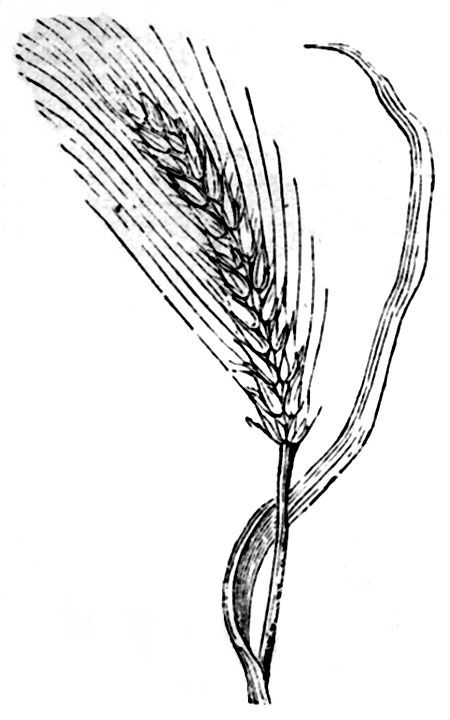
A Barley Pudding, good for invalids, may be made as follows: Add to 4 tablespoonfuls of prepared barley sufficient cold milk to form a thin paste; pour on it a quart of boiling milk, then add a small slice of butter, a tablespoonful of powdered lump sugar, sufficient lemon-peel to flavour it, and two eggs, previously well beaten up; mix well, and let the whole bake for an hour and a half in a slow oven. This is very nutritious and easy of digestion; it may be rendered more palatable to some by the addition of a slice or two of lemon.
JUPITER. The largest planet of the solar system, being 91,522 miles in diameter, or 1,400 times larger than the earth. It revolves round the sun in 4,332 days and 14 hours of our time, and on its own axis in 9 hours, 56 minutes, inclined to the eliptic 86° 54½′. It is attended by four satellites.
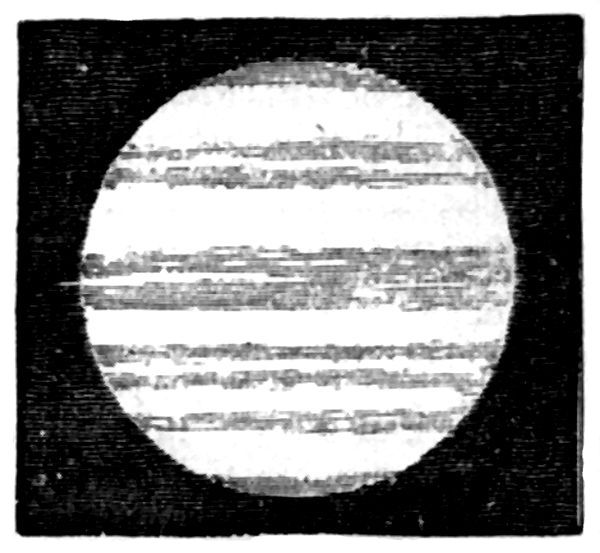
JUPITER. The chief of the gods, worshipped under that and other names by all the nations of antiquity. The temple and statue of Jupiter at Athens was one of the wonders of Greece, and he was worshipped under the names of Jupiter Olympus, and Jupiter Tonans, or the Thunderer. He was the Osiris of the Egyptians, the Bramah of the Hindoos, the Ammon of Ethiopia, the Woden of the Scandinavians; and some ascribe the Greek model to the Jehovah of the Jews.

FEET (TO REMOVE THE OFFENSIVE SMELL OF). The object of perspiration is to remove carbonic acid, and other noxious matters from the blood; these, in ordinary cases, escape through our clothing. But as shoes and boots are but very slightly porous, the free discharge of the offensive perspiratory matter is prevented, and consequently it has an unpleasant smell. There is no remedy for this but cleanliness. Wash the feet night and morning with lukewarm water and soap; put on clean stockings every day, if possible; keep two or three pairs of shoes in wear instead of one only, and change every other day,—attend to these instructions, and the annoyance complained of will be much lessened, if not removed. The evil of bad-smelling feet will be found, in nearly all cases, to arise from an uncleanly habit.
MOTH (Phalæna). An elegant species of insect, whose changes correspond with those of the butterfly.
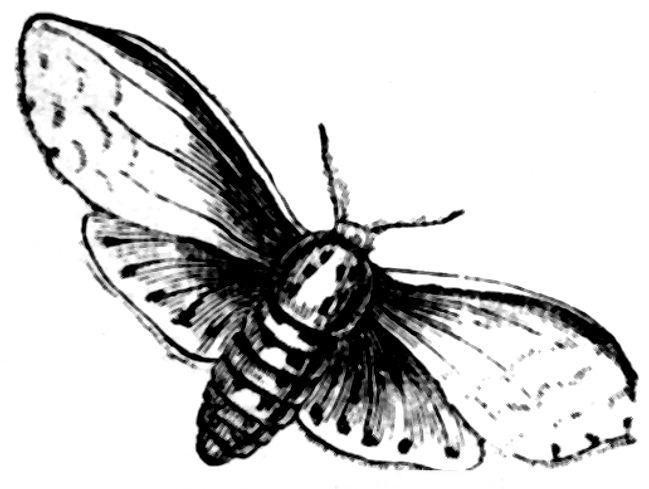
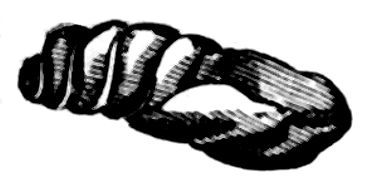
Grub of the Moth.
LAVENDER WATER. Take of English oil of lavender, and essence of bergamot, of each one ounce, four cloves, and rectified spirits of wine one pint. Shake them well together, and let them stand a month, then add two ounces of distilled water, and distil.
WHEY. Ninety-two parts of one hundred of cream, the remaining eight being equal proportions of butter and cheese, or suet and curd.
PRISM. A triangular form of glass, or any refracting medium, by the oblique action of which the atoms whose propulsions, called light, are decomposed, and exhibit a coloured spectrum, which is divided into 360 parts. The upper side is hot, red, and oxygenous, and 45 parts; and the lower violet, cold, and hydrogenous, and 80 parts; with the intermediate colours and qualities, as orange 27, yellow 48, green 60, blue 60, and indigo 40. The whole being a mechanical and perfect decomposition of the elementary atoms of the atmosphere, the excitement of which constitutes light.
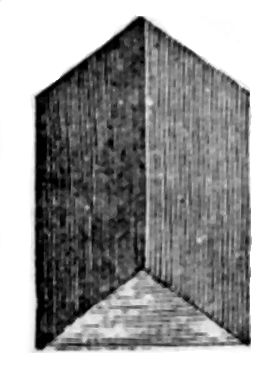
TRIANDRIA. The third class of the Linnæan system of plants, containing three orders: monogynia, digynia, and trigynia, with three stamina.
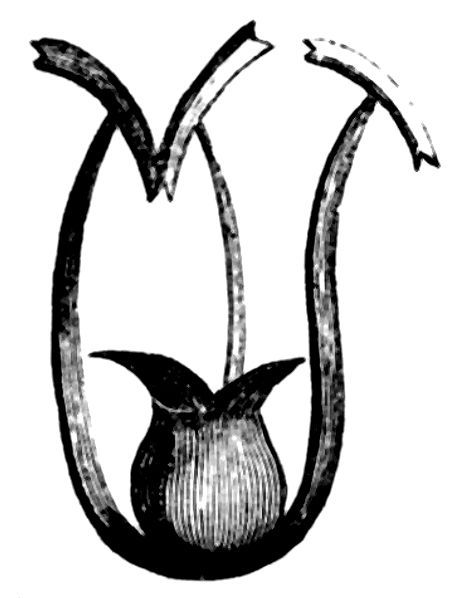
ZEBRA. An animal the size of an ass, distinguished by its striped skin, and wild and common in Southern Africa.
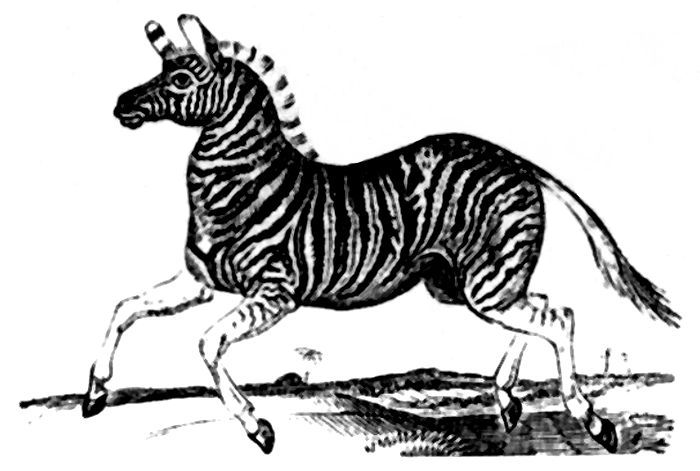
STEMS. Every plant has a stem through which the sap circulates, and from which the leaves and flowers spring. This stem is not always apparent: it is sometimes concealed under ground, sometimes disguised under an extraordinary form: the stem of the tulip, for instance, is contained within the bulb, which is commonly, but improperly, called its root: that of the fern is subterraneous. The functions of the root and stem are totally different: the former merely sucks up nourishment from the soil, and transmits it to the leaves; the latter is supplied with organs to distribute it to the several parts of the plant, the leaves, the flowers, &c.
The stems of plants are divided into two classes; those which grow internally, hence called endogenous—they are also called monocotyledons, from their seed having only one cotyledon, or lobe: and those which grow externally, called exogenous, or dicotyledons, from their seed having two lobes.
There is a third class, denominated acotyledons, which have no cotyledons, and no vascular system, such as fungi, lichens, &c.
The date, the palm, and the cocoa-nut tree, the sugar-cane, and most of the trees of tropical climates, belong to the monocotyledons, or endogenous plants. Their stems are cylindrical, being of the same thickness from the top to the bottom. Their mode of growth is this: a hollow stem shoots up to a certain height, and there stops; layer after layer grows in the interior of this hollow stem, till at length a period arrives when the outer coats are so hardened and distended, as to yield no longer; the stem has then attained its full growth in horizontal dimensions, and offers a broad, flat, circular surface to view, which has scarcely risen in height above the level of the ground. In this stage it resembles the stump of the trunk of a tree which has been cut down. The following spring, there being no room for a new layer of wood to extend itself horizontally, it shoots up from the centre of the stem vertically; fresh layers every year successively perforate this central shoot, till it becomes hard, compact, and of the same horizontal dimensions as the base; the second period of growth is then complete.
The leaves and fruit of this class of plants grow from the centre of the last shoot, and form a sort of cabbage at the top of the tree, on cutting off which, the tree perishes.
Endogenous plants have no real bark, the external coats of wood are so much hardened as to render such a preservation unnecessary.
These plants have usually no branches. Corn, and all gramineous plants, the lilaceous tribe of flowers, and bulbous roots, are all endogenous. Some of these send forth shoots, but they are not from the stem, but from a knot or ring upon the stem. The sugar-cane, which grows in this manner, is the largest of the gramineous plants.
The structure of the exogenous plants, or dicotyledons, to which the trees of our temperate climes belong, is much more complicated.
The stem is composed of two separate parts: the one ligneous, the other cortical; in other words, it is formed of wood and bark.
The wood consists, in the first place, of the pith, a soft medullary substance, which occupies the centre of the stem, and is almost always of a cylindrical form. This soft, pulpy body, does not grow or increase in size with the tree, but retains the dimensions it originally had in the young stem.
The first layer, surrounding the central pith, grows freely during a twelvemonth, but the following year it is enclosed by a new layer; being, by the pressure of this layer, prevented from extending laterally, it makes its way where there is no pressure; that is to say, vertically. When, during the third year, a third layer surrounds and compresses the second, this, in its turn, escapes from the bondage by rising vertically. This process goes on year after year, so that the stem grows in height at the same time that it increases in thickness. This mode of growing renders the form of the stem conical, the layers diminishing as the stem rises.
These layers of wood attain a state of maturity, when they become so hard by continued pressure as to be no longer susceptible of yielding to it. Previous to this period, the layers bear the name of alburnum, signifying white wood, for wood is always white, until it reaches this degree of consistency. The length of time requisite to convert the alburnum into perfect wood, varies from five to fifty years, according to the nature of the tree.
The vegetation of the bark is precisely the inverse or that of the wood; that is to say, it is endogenous, its layers growing internally: the new soft coat of bark, therefore, lies immediately in contact with the new soft layer of wood. The outer coats of bark, when they become too hard to be further distended by the pressure of the internal layers, crack, and becoming thus exposed to the injury of the weather, fall off in pieces: it is this which produces the ruggedness of the bark in some trees. The other layers, as they become external, and exposed to the same sources of injury, experience the same fate.
It has long been a disputed point what part of the stem the sap rises through; some have maintained the opinion that it ascended through the pith; others, that it rose through the bark; but they have both been proved to be wrong. By colouring the water with which the plant was watered, it has been traced within the stem, and found to ascend almost wholly in the alburnum, or young wood, and particularly in the latest layers. (See Roots, p. 199).
LEAVES (FUNCTIONS OF). If the leaves of a tree be stripped off, the fruit comes to nothing, which is exemplified every year in gooseberry bushes, the leaves of which have been devoured by caterpillars; and though the fruit trees of warm climates, partly naturalized with us, grapes and peaches, for instance, ripen their fruit sooner, perhaps, if partially deprived of their leaves; yet if that practice be carried too far, the fruit perishes. The white mulberry, indeed, cultivated in the south of Europe, for the food of silkworms only, bears wonderfully the loss of its foliage three or four times a year.
These facts have led some to think, that leaves were merely a clothing, or a protection against cold and heat. Though this is undoubtedly true, still it is a very small part of the use of leaves.
That leaves give out moisture, or are organs of insensible perspiration, is proved by the simple experiment of gathering the leafy branch of a tree, and immediately stopping the wound at its base, with wax, or any other fit substance, to prevent the effusion of moisture in that direction. In a very short time, the leaves droop, wither, and are dried up. If the same branch, partly faded, though not dead, be placed in a very damp cellar, or immersed in water, the leaves revive, by which their power of absorption is also proved.
The great annual sunflower is said to have lost by perspiration 1 lb. 14 oz. weight, in the course of twelve hours, in a hot dry day. In a dry night, it lost about three ounces; in a moist night, scarcely any alteration was observable; but in a rainy night it gained two or three ounces. The cornelian cherry is most remarkable in this respect: the quantity of fluid which evaporates from its leaves, in the course of twenty-four hours, is said to be nearly equal to twice the weight of the whole shrub.
The perspiration of aquatic plants seems to be remarkably copious. Of these some grow constantly immersed in water. Their leaves are peculiarly vascular, and dry very quickly in the air, withering in a few minutes after exposure to it. Other aquatics float with only the upper surface of their leaves exposed to the air, which surface is so contrived that water will scarcely remain upon it. These leaves, though extremely juicy, dry with great rapidity, as does every part of the plant, when gathered. It is probable that they imbibe copiously by their under sides, and perspire by their upper.
Light has a very powerful effect upon plants. The green colour of the leaves is owing to it, so that plants raised in the dark, are of a sickly white; and it is well known that the blanching of celery is effected by covering the plant and excluding the light.
Light acts beneficially upon the upper surface of leaves, and hurtfully upon the under side; hence the former is always turned towards the light, in whatever situation the plant may happen to be placed. Plants, in a hot-house, present the fronts of their leaves to the side where there is most light, not to the quarter where most air is admitted, or to the flue, in search of heat. It has been found, that vine leaves turn to the light, even when separated from the stem, if suspended by a thread.
Nor is this effect of light peculiar to leaves alone. Many flowers are equally sensible to it, especially the compound radiated ones, as the daisy, sunflower, marigold, &c. In their forms, Nature seems to have delighted to imitate the radiant luminary, in the absence of whose beams many of them do not expand their blossoms at all. The stately annual sunflower displays this phenomenon more conspicuously, on account of its size: the flower follows the sun all day, and returns, after sun-set, to the east, to meet the sunbeams in the morning. A great number of leaves also follow the sun in his course. A clover field is a familiar instance of this.
The chemical actions of light, heat, and the component parts of the atmospheric air, upon leaves, are now tolerably well understood. It is agreed that in the day-time plants imbibe, from the atmosphere, carbonic acid gas (which is a compound of oxygen and carbon), that they decompose it, absorb the carbon as matter of nourishment, which is added to the sap, and emit the oxygen. The burning of a candle, or the breathing of animals, in a confined space, produces so much of this gas, that neither of these operations can go on beyond a certain time; but the air so contaminated serves as food for vegetables, the leaves of which, assisted by light, soon restore the oxygen, or, in other words, purify the air again. This beautiful discovery shows a mutual dependence of the animal and vegetable kingdoms, and adds another to the many proofs we have of the wisdom and wonder-working power of the Creator of all things.
In the dark, plants give out carbonic acid, and absorb oxygen; but the proportion of the latter is small, compared to what they exhale by day, as must likewise be the proportion of carbonic acid given out; else the quantity of carbon added to their substance would be but trifling, especially in those climates in which the proportion of day to night is nearly equal, and which, notwithstanding, we know to be excessively luxuriant in vegetation.
There can be no question of the general purpose answered to the vegetable constitution by these functions of leaves. But when we attempt to consider how the peculiar secretions of different species and tribes of plants are formed; how the same soil, the same atmosphere, should, in a leaf of the vine, or sorrel, produce a wholesome acid, and in that of a spurge, or manchineel, a most virulent poison—how sweet, and nutritious, herbage should grow among the acrid crow-foot, and aconite—we find ourselves totally unable to comprehend the existence of such wonderful powers in so small, and, seemingly, simple an organ, as the leaf of a plant. The agency of the vital principle alone can account for these wonders, though it cannot, to our understanding, explain them. The thickest veil covers the whole of these processes; and so far have philosophers hitherto been from removing this veil, that they have not even been able to approach it. All these operations, indeed, are evidently chemical decompositions and combinations: but we neither know what these decompositions and combinations are, nor the instruments in which they take place, nor the agents by which they are regulated.
WRITING. A most important art, the successful practice of which arises from holding the pen properly, when beginning to learn, as represented in the engraving.
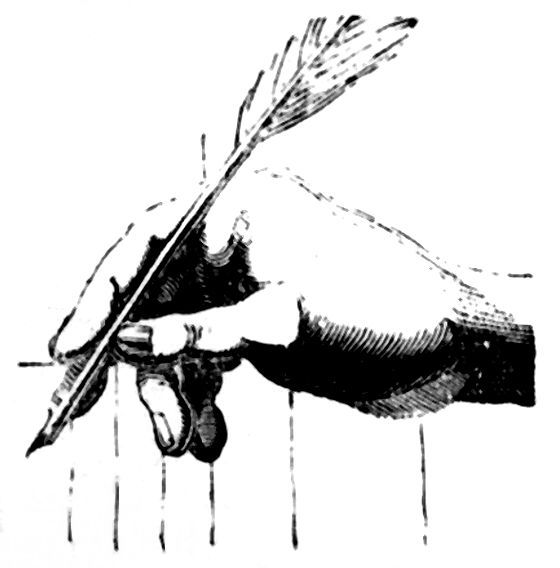
HOTTE. A basket of wicker-work, much used in France, for carrying burdens on the back. It is slung over the arms by means of straps, and great weights are thus carried with much facility.
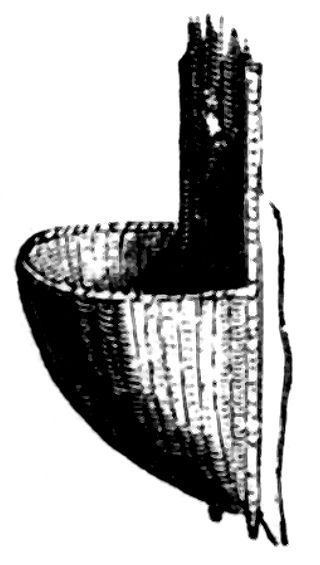
HYDROGEN GAS. A variety of atoms, in motion, which fill a space, and which space, when filled with them, is from fifteen to sixteen times lighter than if the space were filled with common atmospheric air. The engraving represents its manufactory in large quantities for the purpose of filling a balloon.
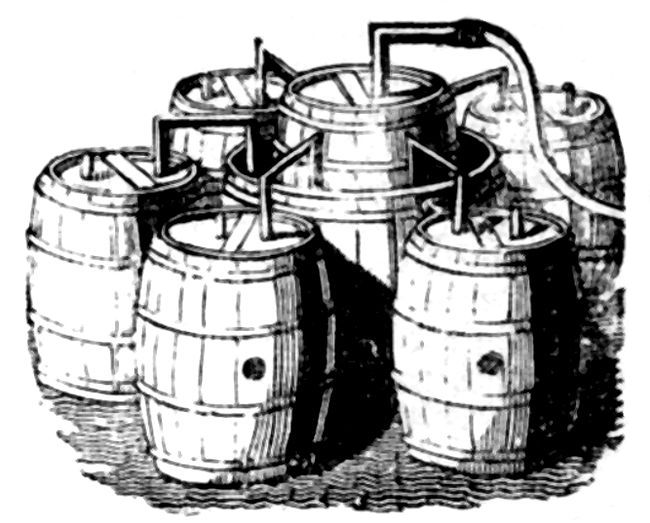
The casks placed round are partly filled with water, from which hydrogen is extracted, by putting pieces of zinc into it, and two-fifths of sulphuric acid, or vitriol. This producing an effervescence, the light gas passes out of the casks through the bent tubes which pass through a vessel of cold water under the cask placed in the centre, from which it passes through the bent tube into the balloon, and being so much lighter than atmospheric air, it rises with great force, and carries the balloon with it into the upper regions of the atmosphere.
UNDERSHOT WHEELS. Those which are acted upon by a stream at the bottom, overshot ones acting by a stream at the top. Undershot wheels require a much greater body of water than overshot; the former are consequently constructed in rivers, and the latter in streams of water. The application of water to mechanical purposes in the grinding of corn, fulling of cloth, dressing of leather, spinning of cotton, wool, &c., &c., deserves to be ranked among the most important inventions of man.
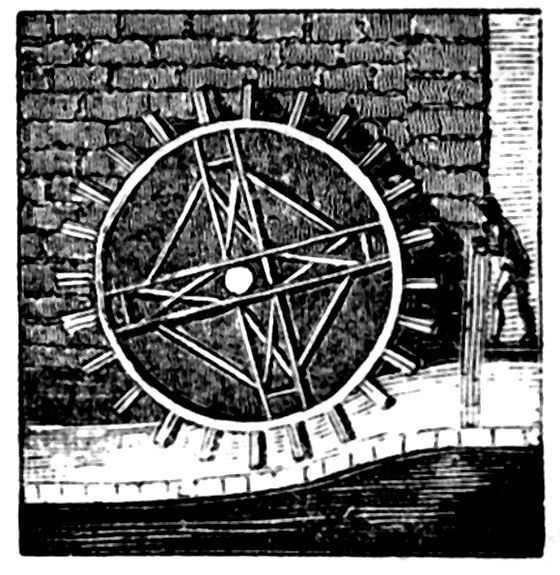
JULY. In the ancient calendar of the Romans this month was called Quintilis, to denote its numerical position—being, in fact, the fifth month of the old Latin year; whereas now it is our seventh. It was sacred to Jupiter, and consisted of thirty-six days, which Romulus reduced to thirty-one, and Numa Pompilius to thirty; but Julius Cæsar restored the day which Numa had taken away from it. In consequence of the alterations made in the calendar by Numa, July became the seventh month in the year, but retained the name of Quintilis, until Marc Antony changed its name to Julius, as a compliment to Julius Cæsar, who had done so much to improve the calendar.
The Synonymes of the month are as follow:—In Latin, Julius; French, Juillet; Italian, Luglio; Portuguese, Julho; and Saxon, Heu Monath, Hey Monath, or Hay month, because the hay-harvest of our Saxon ancestors was held in this month. It was also called Maed Monath, because at this season the meadows are covered with bloom.
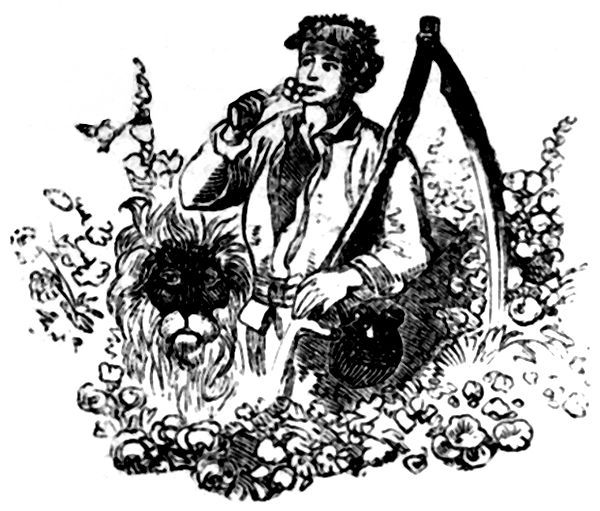
The allegorical representation of the month (as exhibited in our illustrative engraving) consisted of a young man in a light jacket eating cherries; his face and chest sunburnt, and his head surmounted by a wreath of wild thyme. He bore a scythe on his shoulders, symbolical of the hay-harvest, while an ample bottle hung at his girdle, and at his side was the sign of Leo, the lion, alluding to the sun entering that sign on the 23rd of the month.
The month of July is usually very hot, especially during the first fortnight of the Dog-days; but this excessive temperature often gives way to the æstival rains, which begin about St. Swithin’s-day. If showery weather set in about the middle of the month, the chances are that the great part of the period will be wet; and hence the popular proverb which ascribes forty days’ rain to St. Swithin. It is at this season that the most beautiful and picturesque skies are seen, and that small meteors most abound. The solstitial season this month may perhaps be considered as the most delightful; for though the vegetable world in the month of June is perhaps more adorned with blossoms, yet the days are now at their full length; a beautiful twilight takes the place of night, and we seldom or never feel cold, except in particularly unseasonable years. Besides this, the air is generally calm and wholesome; and though sometimes great heat prevails, yet it is relieved by thundershowers, and the evenings are refreshing and delightful. Full-grown grass in the meadows, the flowering of the purple clover, of the midsummer daisy, of the red poppy in the corn-fields, of the lilies, and of the whole of that beautiful tribe, the roses, besides numerous others of the floral family, distinguish this delightful season of the year. At this period, also, sheep-shearing forms an important branch of rural industry.
Hay-making is another great feature of rural industry for which the month of July is distinguished. It is always a source of pleasure to the young, and even to the aged, who delight to tell their oft-told tales of love, whispered at eve after the well-filled waggons have been carried to the yard to increase the snug stacks of sweet new-mown hay. Hay-making is most assuredly one of the most pleasing occupations of an English summer.
We shall now proceed to notice a few of those days which are the most remarkable in the calendar for this month.
The 3rd day commences with what are termed the Dog-days, which continue until the 11th of August. The name was first given in reference to the heliacal rising of the constellation of Canis major, called Sirius, or the Dog-star, which was formerly thought to make the sea boil, dogs to go mad, wine to turn sour, animals generally to languish, and to originate fevers and cholera. The name applied to this period probably took its origin from a festival having been formerly held at Argos, expressly instituted for the killing of dogs during this season.
4th. Dedicated to St. Ulric, Bishop of Augsburg. The Translation of St. Martin is also fixed upon this day; and although the day is retained in the calendar of the Church of England, yet it is not observed.
7th. Dedicated to St. Thomas à Becket, Archbishop of Canterbury, who was murdered at the altar of Canterbury Cathedral, on the 29th of December, 1170.
15th. Dedicated to St. Swithin, who lived in the ninth century. He was the deviser and originator of tithes in England, and the priest of King Egbert. Being very pious and learned, he was created Bishop of Winchester, and, dying in the year 865, was canonized by the Pope. He requested that he might be buried in the open churchyard, which was a singular request, inasmuch as the bishops were generally buried in the chancel of the minster. The story runs, that the monks, wishing to translate the remains of the saint, on his being canonized, resolved to do so on the 15th of July, with a solemn procession and great pomp; but as it rained violently on that day, and the forty days succeeding, they looked upon it as a mark of disapprobation of the saint, and erected a chapel over his grave instead, at which many miracles are said to have been performed. Ever since then a popular notion has prevailed, that if it rains on St. Swithin’s day there will be rain for the forty ensuing days.
20th. Dedicated to St. Margaret, an Italian virgin, who was martyred in 278. Although the name is retained in our calendar, the day is not kept.
25th. Dedicated to St. James the Apostle. Formerly the Catholic priests blessed apples on this day; and a popular belief prevailed, that, whoever ate oysters on this day would not want money for the remainder of the year.
26th. Dedicated to St. Anne, the mother of the Virgin Mary.—In 1830 the disturbances in Paris commenced, and lasted for several days, ending in the abdication of Charles X., and the acceptance of the crown of France by Louis Philippe.
The celebrated anatomist and surgeon, John Hunter, was born July 14, 1728, at Long Calderwood, in Kilbride, near Glasgow; and in 1755, the distinguished tragic actress, Mrs. Siddons, was born at Brecknock. She died in 1831.
Sir Joshua Reynolds was born July 16, 1723, at Plympton St. Mary, Devonshire. As a painter he stood unrivalled in his day, and did much to improve the art. It has been said of him, that he “exalted portrait to the dignity of history;” and Northcote remarks, that “to the grandeur, the truth, and simplicity of Titian, and to the daring strength of Rembrandt, he has united the chasteness and delicacy of Vandyck.” He died in 1792.
AUGUST is said to have derived its name from the Roman Emperor, Augustus Cæsar, to whom it was dedicated in honour of his being created Consul in this month, and having triumphed three times in Rome, subjected Egypt to the Roman power, and put an end to civil wars. It was called Sextilis, or the sixth month, in the Album calendar, in which it had only twenty-eight days assigned to it. Romulus added two days, and Augustus Cæsar a third, which number it has since retained; and from the time that Numa Pompilius revised the calendar, it has continued as the eighth month of the year.
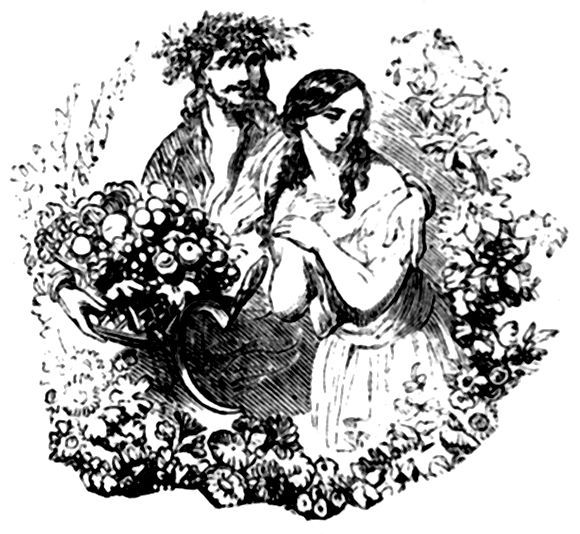
The Anglo-Saxons called it Arn-monat, or Barn-monat, alluding to this being the period when their barns were commonly filled, the Saxon word Arn signifying harvest. It was also called Weod-monath, clothing month, alluding to their fields being then clothed with corn, just as the Romans dedicated this month to Ceres, the goddess of harvest.
The Synonymes of the month are as follow:—In Latin, Augustus; French, Août; Italian and Portuguese, Agosto.
The allegorical representation of the month is a young man of rustic and cheerful countenance, with a flame-coloured habit; upon his head is a garland of rye and wheat; upon his arm a basket of ripe fruits; at his belt a sickle; and at his side the sign Virgo, the Virgin, because the sun enters that constellation on the 23rd of the month.
The month of August is the most glorious and resplendent of the year, for it is then that Ceres, with her golden-eared corn, gladdens the hearts of men. Sheaves of wheat are now piled upon the carts, and the whole field is astir.
August may be considered as the first of the sporting months. The legal shooting of red game, or grouse, commences on the 12th; and of black game, or heath fowl, on the 20th. Hence the sportsman looks forward with pleasure to the appointed day. He then hies to the moor with friend and dogs, and searches for the much-coveted game. The common grouse, or moor fowl, are only found in sequestered places, abounding with copses and brushwood, confining themselves wholly to the open moors and uncultivated wastes covered with heath.
August possesses charms even for the gastronomist, for upon the 5th of the month the oyster season begins—an opening-day for the London fishmongers. The consumption of oysters in London alone is estimated at about 14,000 or 15,000 bushels a year, and the imports between 52,000 and 54,000.
In the month of August there are some Red Letter days, which are deserving of especial notice.
The 1st of the month is Lammas-day, which is a fixed festival, but not observed by the Church of England. Some derive the term from Lamb Mass, because on that day the tenants who held lands under the cathedral church in York, which is dedicated to St. Peter ad Vincula, were bound by their tenure to bring a live lamb into the church at high mass. Lammas seems to have been held as a day of thanksgiving for the new fruits of the earth. It was probably one of the great festival days of our heathen ancestors.
6th. The next festival is the Transfiguration of our Lord, which is not observed by the Church of England, although inserted in the calendar attached to the Prayer Book. It was instituted by Pope Calixtus, in commemoration of Christ’s transfiguration on the Holy Mount.
10th. St. Lawrence.—This is a festival held in honour of this saint, who suffered martyrdom at Rome by order of the Emperor Valerian. He is the tutelary saint of the Spaniards; and the church of the Escurial, in Spain, founded by Philip II., and dedicated to St. Lorenzo, in honour of Philip having won a battle upon the 10th of August, is built in the form of a gridiron, which is supposed to have been the instrument of torture employed by the Emperor Valerian.
15th. The Assumption of the Virgin.—This is a grand festival of the Romish Church. It was instituted in 813, to celebrate the ascension of the Virgin into heaven. In Catholic countries this day is marked by splendid ceremonies and processions.
24th. St. Bartholomew’s-day is a festival of the Church of England. St. Bartholomew was an apostle, but there is no scriptural account of his labours or death. The legend of the Romish Church represents him as preaching in the Indies, and concluding his life by being flayed alive by order of Astyages, brother to Palemon, the King of Armenia.—This day has a horrible celebrity in connexion with the massacre of the Protestants at Paris, in 1572, when 10,000 were butchered in a fortnight, besides 90,000 in the provinces.
Sir William Herschel was one of the most distinguished astronomers of modern times, to whom the scientific world is deeply indebted for the discovery, in 1781, of a new primary planet, which was named, in honour of George III., Georgium Sidus. He was born at Hanover in 1738, and died in 1822.
The name of the French Emperor, Napoleon Bonaparte, is too well known to require any lengthened observations. For nearly a quarter of a century he was the great leading star, military and political, of the western world. But though he rose in glory, he set in humility. He was born at Ajaccio, in Corsica, on the 15th of August, 1769, and was educated at the military school of Brienne, from 1779 to 1784.
Prince Albert, as the illustrious consort of our most gracious Queen, and the liberal patron of British art, deservedly ranks as the first subject of the empire. His Royal Highness is the second son of Ernst Anton Karl Ludwig, Duke of Saxe-Coburg, whose ancestors were Margraves of Meissen in the twelfth century, and Electors of the Empire from 1425 to 1547. The Prince was born at the Castle of Rosenan, on the 26th of August, 1819, and his marriage with Queen Victoria took place in 1840.
APARTMENTS (TO PERFUME.) Put into a spirit lamp, or narrow-necked bottle, any essence or scent not containing water; provide the lamp, or bottle, with a thick lamp-cotton, and place slightly above the cotton a small ball of spongy platinum; then put a light to the wick, and after the platinum is red-hot (which it will be in a few seconds), blow it out. The platinum ball will continue in a state of ignition as long as any spirit remains in the bottle, evaporating the perfume as it rises by means of the wick. We have tried this, and seen it tried often, and can answer for its being good.
CRICKET (THE LAWS OF). 1. The Ball. At the beginning of each innings, either party may call for a new ball.
2. The Bat. May be generally four inches and a quarter in the widest part, and about thirty-eight inches in length.
3. The Stumps. Must be twenty-seven inches out of the ground; the bails eight inches in length; the stumps of sufficient thickness to prevent the ball from passing through.
4. The Bowling Crease. Must be in a line with the stumps, six feet eight inches in length; the stumps in the centre; with a return crease at each end, towards the bowler, at right angles.
5. The Popping Crease. Must be four feet from the wicket, and parallel to it; unlimited in length; but not shorter than the bowling crease.
6. The Wickets. Must be pitched opposite to each other, by the umpires, at the distance of twenty-two yards.
7. It shall not be lawful for either party, during a match, to alter the ground, without the consent of the other, by rolling, watering, covering, mowing, or beating.
This rule is not meant to prevent the striker from beating the ground with his bat near to the spot where he stands during the innings, nor to prevent the bowler from filling up holes with sawdust, &c. when the ground shall be wet.
8. After rain the wickets may be changed, with the consent of both parties.
9. The bowler shall deliver the ball with one foot on the ground behind the bowling crease, and within the return crease; and shall bowl four balls before he change wickets; which he shall be permitted to do only once in the same innings.
10. The ball must be bowled. If it be thrown or jerked, or if the hand be above the shoulder in the delivery, the umpire must call “no ball.”
11. He may require the striker at the wicket from which he is bowling to stand on that side of it which he may direct.
12. If the bowler toss the ball over the striker’s head, or bowl it so wide that it shall be out of the distance to be played at, the umpire (even although he attempt to hit it) shall adjudge one run to the parties receiving the innings, either with or without an appeal from them; which shall be put down to the score of wide balls; and such balls shall not be reckoned as any of the four balls. When the umpire shall have called “wide ball,” one run only shall be reckoned, and the ball be considered dead.
13. If the bowler deliver a “no ball,” the striker may play at it, and be allowed as many runs as he can get, and he shall not be put out except by running out.
14. In the event of no run being obtained by any other means, one run shall then be scored. In the event of a change of bowling, one ball, shall be allowed for the sake of practice.
15. At the beginning of each innings the umpire shall call “play;” from that time, to the end of each innings, no trial-ball shall be allowed to any bowler.
16. The striker is out, if either of the bails be bowled off, or if a stump be bowled out of the ground:
17. Or if the ball from a stroke of the bat, or hand, but not wrist, be held before it touch the ground, although it be hugged to the body of the catcher:
18. Or if, in striking, or at any other time while the ball shall be in play, both his feet be over the popping crease, and his wicket put down, except his bat be grounded within it:
19. Or if, in striking at the ball, he hit down the wicket:
20. Or if, under pretence of running, or otherwise, either of the strikers prevent a ball from being caught:
21. Or if the ball be struck and he wilfully strike it again:
22. Or if in running, the wicket be struck down by a throw, or by the hand or arm (with ball in hand), before his foot, hand, or bat be grounded over the popping crease (but, if the balls be off, a stump must be struck out of the ground):
23. Or if any part of the striker’s dress knock down the wicket:
24. Or if the striker touch or take up the ball while in play, unless at the request, of the opposite party:
25. Or if with any part of his person he stop the ball, which in the opinion of the umpire at the bowler’s wicket shall have been delivered in a straight line to the striker’s wicket, and would have hit it.
26. If the players have crossed each other, he that runs for the wicket which is put down, is out.
27. A ball being caught, no run shall be reckoned.
28. A striker being run out, that run which he and his partner were attempting shall not be reckoned.
29. If a lost ball shall be called, the striker shall be allowed six runs; but if more than six shall have been run before “lost ball” shall have been called, then the striker shall have all that have been run.
30. After the ball shall have been settled in the wicket-keeper’s or bowler’s hand, it shall be considered dead. If, when the bowler is about to deliver the ball, the striker at his wicket shall go outside the popping crease before such actual delivery, the said bowler may put him out, unless (with reference to law 22), his bat in hand, or some part of his person, be within the said crease.
31. If the striker be hurt he may retire from his wicket, and return to it any time during that innings.
32. If a striker be hurt, some other person may stand out for him, but not go in.
33. No substitute in the field shall be allowed to bowl, keep wicket, stand at the point, cover the point, or stop behind, in any case.
34. If any fieldsman stop the ball with his hat, the ball shall be considered dead, and the opposite party shall add five runs to their score. If any be run, they shall have five in all.
35. The ball having been hit, the striker may guard his wicket with his hat, or with any part of his body except his hand; that the 24th law may not be infringed.
36. The wicket-keeper shall stand at a reasonable distance behind the wicket, and shall not take the ball for the purpose of stumping until it has passed the wicket; he shall not move till the ball be out of the bowler’s hand; he shall not by any noise incommode the striker; and if any part of his person be over or before the wicket, although the ball hit it, the striker shall not be out.
37. The umpires are sole judges of fair and unfair play, and all disputes shall be determined by them, each at his own wicket; but, in case of a catch, which the umpire at the wicket bowled from cannot see sufficiently to decide upon, he may apply to the other umpire, whose opinion shall be conclusive.
38. The umpires, in all matches, shall pitch fair wickets, and the parties shall toss up for the choice of innings.
39. They (the umpires) shall allow two minutes for each striker to come in, and fifteen minutes between each innings. When they shall call “play,” the party refusing to play shall lose the match.
40. The umpires are not to order a striker out unless appealed to by the adversaries.
41. But if one of the bowler’s feet be not on the ground behind the bowling crease, and within the return crease, when he shall deliver the ball, the umpire at his wicket, unasked, must call “no ball.”
42. If either of the strikers run a short run, the umpire must call “one short.”
43. No umpire shall be allowed to bet.
44. No umpire is to be changed during a match, unless with the consent of both parties, except in violation of the 43rd law; then, either party may dismiss the transgressor.
45. After the delivery of four balls the umpire must call “over,” but not until the ball shall be finally settled in the wicket-keeper’s hand, or that of the bowler; the ball should then be considered dead; nevertheless, if an idea be entertained that either of the strikers is out, a question may be put previously to, but not after, the delivery of the next ball.
46. The umpire must take especial care to call “no ball,” instantly upon delivery; “wide ball,” as soon as ever it shall pass the striker.
47. The players who go in second shall follow their innings, if they shall have obtained one hundred runs less than their antagonists.
48. When one of the strikers shall have been put out, the use of the bat shall not be allowed to any person till the next striker shall come in.
MUSICAL INSTRUMENTS. Organ. This is the largest and most harmonious of all wind instruments. It may be more properly termed a collection of instruments. The invention of the organ is very ancient, though it is agreed it was little used till the eighth century. It seems to have been borrowed from the Greeks. Vitruvius describes one in his tenth book. The Emperor Julian has an epigram in its praise. St. Jerome mentions one with twelve pairs of bellows, which might be heard a thousand paces, or a mile; and another at Jerusalem, which might be heard at the mount of Olives. The structure of the modern organ may be conceived as follows: The organ is an assemblage of several rows of pipes. Its size is usually expressed by the length of its largest pipes; thus we say an organ of 32 feet, of 16 feet, of 8 feet, and of 2 feet. The organ has at least one set of keys, when it has only one body; and two or three, when otherwise. The large organs have four, sometimes five sets. Besides, the pedals or largest pipes have their key, the stops or touches whereof are played by the feet. The keys of an organ are usually divided into four octaves. Ctesibius of Alexandria, who lived in the reign of Ptolemy Evergetes, is said to have first invented organs that played by compressing the air with water, which may still be practised. Archimedes and Vitruvius have left us descriptions of the hydraulic organ. Among celebrated organs may be mentioned those of Haarlem and of Rotterdam, in Holland; the organ at Ulm, in Germany; and in England, those of York Minster, the Birmingham Town Hall, and the Temple Church of London. The great Haarlem organ, built by Christian Muller early in the last century, contains nearly 5,000 pipes. That at Ulm is 90 feet in height. York Minster organ has 4,089 pipes, and is famous for the beautiful softness of its tone. Willis’s organ at the Great Exhibition of 1851 attracted much attention; it contained more than 4,400 pipes, and was built on the continental plan.
Harp. A musical instrument of the string kind; being of a triangular figure, and placed on end between the legs to be played on. Menage derives the word from the Latin harpa, and from the German harpe. Others bring it from the Latin carpo, because touched or thrummed with the fingers. This instrument is struck with the finger and thumb of both hands. Its music is much like that of the spinnet, all its strings going from semitone to semitone: whence some call it an inverted spinnet. It is capable of a much greater degree of perfection than the spinnet. All authors agree that it is very different from the lyra, cithara, or barbiton used among the Romans. Notwithstanding all the improvements of sounding-board, pedals, &c., the harp is at best but an imperfect instrument.
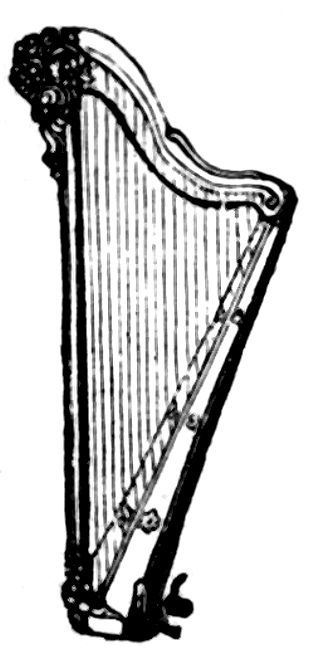
Spinnet, from spinæ, thorns, a stringed instrument, apparently derived from the harp, and superseded by the harpsichord, which is an improvement of it. The spinnet may be considered as the original ancestor of our modern pianoforte. It consists of a number of harp-strings stretched horizontally on a frame, and played by means of keys, which set in motion little teeth, or hooks, like those on a child’s “musical cart.” These little hooks produce a musical twang. They were in due time superseded by quills, when the spinnet in its improved shape obtained the name of
Harpsichord. A musical instrument of the string kind, played upon after the manner of an organ. It is furnished with a set, and sometimes with two sets, of keys: the touching or striking of these keys moves some little jacks, which strike the chords or strings. The strings are composed of brass or iron, and are stretched over four bridges, as they are called, placed within the instrument. Harpsichords are now only to be found among collections of old curiosities; they have quite gone out of use.
Pianoforte. This instrument derives its name from two Italian words, piano, soft, and forte, loud. It differs from the harpsichord mainly in the use of hammers, which strike the strings, instead of quills, and thus enable the performer to produce a loud or a soft sound, according to the force with which he strikes the keys. The soft and loud pedal form the second distinctive feature of the pianoforte; the first of these pedals, on being pressed, keeps the leathern or woollen dampers used to soften the sound of the instrument, permanently on the keys. The loud pedal, on the other hand, raises these dampers, and thus again softness and loudness of sound may be produced. The pianoforte first began to be popular in England and France at the close of the last century, though it was invented in Germany at a much earlier date. The great firm of Erard, in London and Paris, began its career in the latter city about the year 1786, the first member of the firm having obtained a patent for various improvements from King Louis XVI. Clementi’s pianos used to be famous in London. The chief firms at present are those of the Broadwoods and Collards. The pianoforte is one of the most perfect musical instruments we possess, in its power of giving variety and completeness of effect.
Harmonium. This is an improved form of an instrument for some time popular in England under the name of seraphine; it is in fact the principle of the organ simplified and reduced so as to be suitable to the limits of a chamber or a small chapel. The harmonium is made like the organ, with a certain number, of registers, or stops, each producing a different effect. It is played by means of a finger-board, like a piano, and the wind is supplied by bellows worked by the feet. This instrument is particularly adapted for the performance of church music, as it possesses the power of sustaining the notes.
Trumpet. A musical instrument, the most noble of all portable ones of the wind kind, used chiefly among the cavalry to direct them in the service. The word is formed from the French trompette. The ancients had various instruments of the trumpet kind; as the tubæ, cornua, litui. When the sound of the trumpet is well managed, it is of a great compass. Indeed, its extent is not strictly determinable, since it reaches as high as the strength of the breath can force it. A good breath will carry it beyond four octaves, which is the limit of the usual keys of spinnets and organs. There are two notable defects in the trumpet, observed by Mr. Roberts in the Philo. Trans. The first is, that it will not perform certain notes within its compass, commonly called trumpet notes: the second, that four of the notes it does perform are not in exact tune. The same defects are found in the trumpet-marine.
French Horn. This is no other than a contorted or wreathed trumpet. It labours under the same defects as the trumpet itself; but these have of late been so palliated as to require no particular selection of keys for this instrument. The Hebrews made use of horns, formed of rams’ horns, to proclaim the jubilee. This instrument is of great sweetness, and possessed of a range of three octaves.
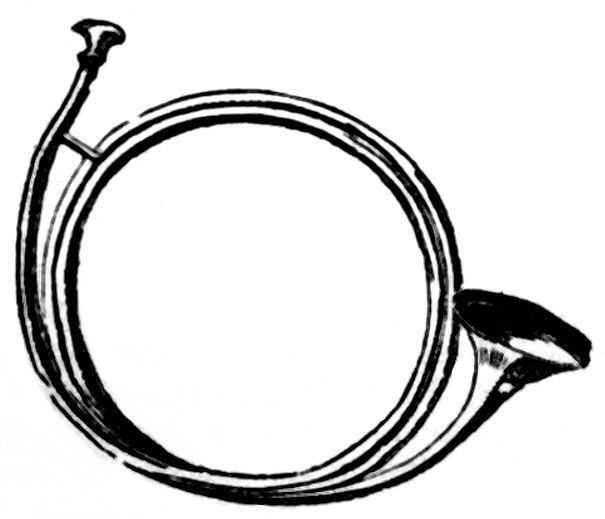
Cornet-à-Pistons. An instrument of the horn kind, furnished with several pistons for the modulation of the notes. The cornet-à-pistons has of late been much improved, and is decidedly the softest and most agreeable brass wind instrument in existence.
Clarion. A kind of trumpet whose tube is narrower, and its tone acuter and shriller, than that of the common trumpet. It is said that the clarion, now used among the Moors, and Portuguese, who borrowed it from the Moors, served anciently for a treble to several trumpets, which sounded bass tenor.
Fife, or Fiffaro. A shrill instrument of martial music, consisting of a short narrow tube with holes disposed along the side, and blown at the side like a German flute.
Clarionet. A wind instrument of the reed kind, with a mouth-piece, the scale of which, though it includes every semitone within its extremes, is virtually defective. Some additional keys have lately been added to this instrument to improve it.
Bassoon. A wind instrument, consisting of a perforated tube and a reed through which it is blown. The compass of the bassoon only comprehends three octaves.
Serpent. A bass wind instrument, taking its name from its curvilinear form, and consisting of several twists, which are usually covered with leather. It has three distinct parts—a mouth-piece; neck and tail; and six circular apertures for the modulation of its notes.
Æolian Harp. A truly natural wind instrument, which derives its name from Æolus, the god of winds. Its construction is extremely simple, and generally consisting of a light hollow box about two inches deep, four broad, and from two to three feet long, along which are extended five or six catgut strings, made tight by bridges near each end of the box, and fixed in its end on pins. The instrument thus constructed and placed in a proper situation in the bottom of a window to receive a current of air across its strings, produces, in the tremulous motion given to the strings by the wind, a most delicate, soft, murmuring and pleasing combination of sounds, neither directly resembling those of a stringed nor of a wind instrument, but partaking of the nature of both.
Violin. A well-known stringed instrument, used on almost every occasion where music is introduced. During the puritanical reign of Cromwell the use of violins was superseded by that of the viol, a rude instrument, with six strings; but after the Restoration violins again became fashionable, and the viol was doomed to lasting oblivion. Cremona, in Italy, was once famous for the manufacture of violins. Stradivarius was the most celebrated maker. The antiquity of the violin has long been a subject of dispute with the learned, as it is generally supposed, and with much reason, that no instrument played with a bow was known to the ancients.
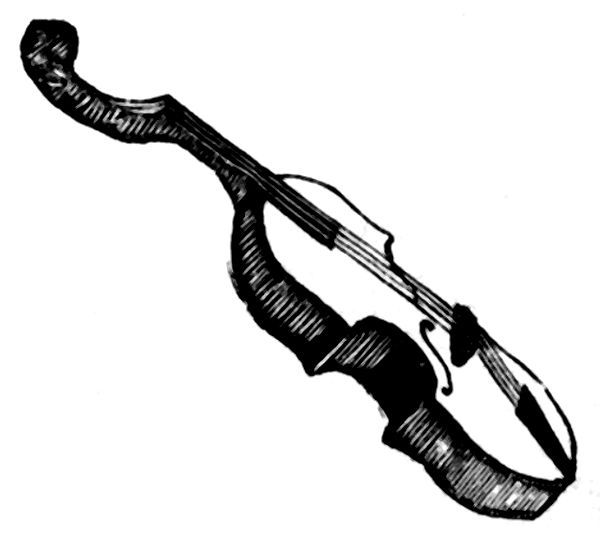
Tambourine. A kind of semi-drum in the shape of a sieve, mounted at the sides with small bells and loose pieces of tin. It was formerly considered as a tinkling cymbal.
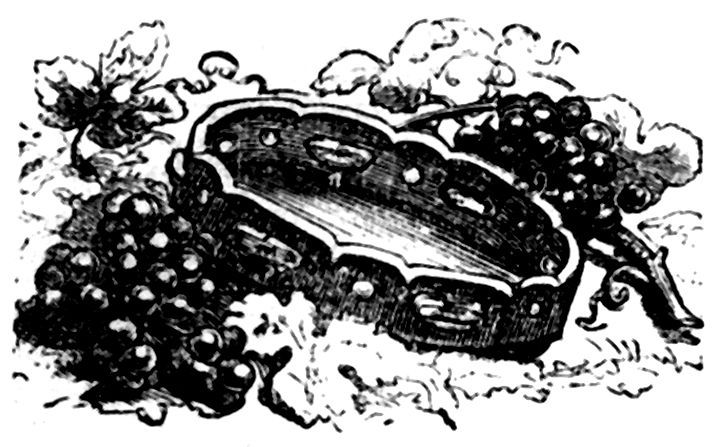
Violoncello. An instrument like the violin, but much larger in size, and deeper in tone. In quartets of stringed instruments, two violins generally take the first and second parts; a larger kind of violin, called a viola or tenor, the third; and the violoncello the fourth. The double-bass is the largest instrument of the violin kind; it is usually furnished with only three strings of great thickness. Its notes are deep and powerful.
Drum. A well-known martial musical instrument in use principally among the infantry, serving to call the soldiers together, to direct their march, attack, retreat, &c. The drum is said to be an oriental invention, and is thought to have been first brought into Europe by the Arabians.
Kettle Drums are used by cavalry, and consist of two large basons with spherical bottoms, or, rather, two hemispheres, which are covered over the flat side with vellum, and made tight with screws and an iron ring. Kettle-drums are always tuned—the one to the key-note, the other to the fifth, of the piece that is to be played.
Dulcimer. A triangular instrument, strung with about fifty wires cast over a bridge at each end, the shortest being generally eighteen inches and the longest thirty-six. It is performed upon by striking the wires with little wooden rods turned up a little at the ends. This name is also applied to a Hebrew instrument by the translators of the Bible, the figure of which is not now known.
Guitar. Derived from the Spanish guitarra, which is from the Latin bithara, a kind of lute; it is a six-stringed instrument, with an oval body, and a neck like a violin, or fiddle, the strings passing from the head to the lower end over a sounding-hole and bridge. Such is the general and passionate attachment to this instrument in the south of Spain, particularly Valencia, that the labourers, carters, and even travellers, will solace themselves in the evening, till a late hour, strumming the guitar and singing. Formerly it was used even by gentlemen to serenade their mistresses. The American “banjo” is merely a primitive kind of guitar.
Flute. A general name for several kinds of cylindrical wind instruments of different lengths and diameters. The common or English flute is about eighteen inches in length and one in diameter, with eight holes and a beaked mouth-piece, which is blown at the end. The flageolet is a small kind of this flute. The German flute is much larger, consists of several moveable joints, and is furnished with keys.
Cymbal, or Cymbalum. An ancient kind of round brass instrument, the nature and powers of which are not now known.
Cruth, or Crowth. An old Welsh instrument resembling a fiddle.
Triangle. A steel instrument, so called from its consisting of three bars of polished steel united so as to form a triangle, which is performed upon by a steel rod.
Bagpipe. A well-known wind instrument of great antiquity among the northern nations, and long a favourite in Scotland, where it was probably introduced by the Norwegians or Danes. The bagpipe consists of two principal parts—the bellows or leathern bag to collect and retain the wind, and the instrument composed of three pipes, the longest of which is called the drone.
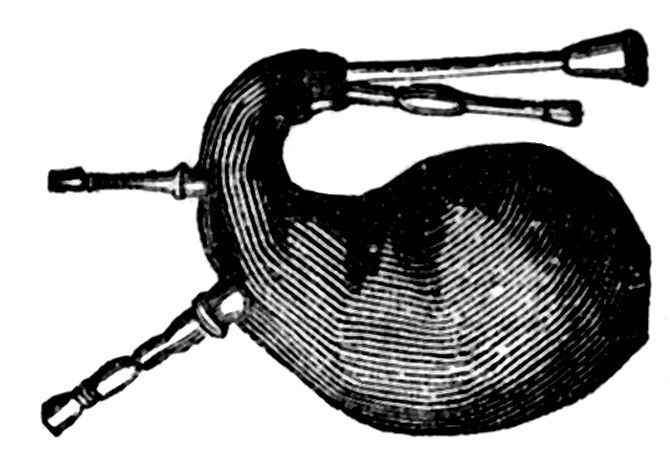
Hautboy, or Oboe. A portable wind instrument of the reed kind, consisting of a tube gradually widening from the top towards the lower end, and furnished with keys and circular holes for modulating its sounds. The tone of the hautboy is graceful and soothing, and particularly adapted to the expression of soft and plaintive passages.
Sackbut. A musical instrument of the wind kind; being a species of trumpet, though different from the common trumpet both in form and size. The sackbut is usually eight feet long, without being drawn out, or without reckoning the circles. When extended to its full length, it is usually fifteen feet. The wreath is two feet nine inches in circumference. It serves as bass in all concerts of wind music.
ATMOSPHERE (THE). The atmosphere is one of the most essential appendages to the globe we inhabit, and exhibits a most striking proof of Divine skill and omnipotence. It is now ascertained to be a compound substance, formed chiefly of two very different ingredients, termed oxygen and nitrogen gas. Of 100 measures of atmospheric air, 21 are oxygen, and 79 nitrogen. The one, namely, oxygen, is the principle of combustion. It is absolutely necessary for the support of animal life, and is one of the most important substances in nature. The other (nitrogen) is altogether incapable of supporting either flame or animal life. But the term atmosphere is also applied to the whole mass of fluids, consisting of air, vapours, electric fluid, and other matters which surround the earth to a certain height. This mass of fluid matter gravitates to the earth, revolves with it in its diurnal rotation, and is carried along with it in its course round the sun every year. It has been computed to extend about 45 miles above the earth’s surface, and it presses on the earth with a force proportioned to its height and density. From experiments made with the barometer it has been ascertained, that it presses with a weight of about 15 pounds on every square inch of the earth’s surface; and, therefore, its pressure on the body of a middle-sized man is equal to about 32,000 pounds, or 14 tons avoirdupois, a pressure which would be insupportable, and even fatal, were it not equal on every part, and counterbalanced by the spring of the air within us. The pressure of the whole atmosphere upon the earth is computed to be equivalent to that of a globe of lead 66 miles in diameter; in other words, the whole mass of the air, which surrounds the globe, compresses the earth with a force or power equal to that of five thousand millions of millions of tons. This amazing pressure is, however, essentially necessary for the preservation of the present constitution of our globe, and of the animated beings which dwell on its surface. It prevents the heat of the sun from converting water and all other fluids into vapour; and preserves the vessels of all organized beings in due tone and vigour. Were the atmospherical pressure entirely removed, the elastic fluids contained in the finer vessels of men and other animals would inevitably burst them, and life would become extinct; and most of the substances on the face of the earth, particularly liquids, would be dissipated into vapour.
Besides these, the atmosphere possesses a great variety of other admirable properties, of which the following may be mentioned. It is the vehicle of smells, by which we become acquainted with the qualities of the food which is set before us, and learn to avoid those places which are damp, unwholesome, and dangerous. It is the medium of sounds, by means of which knowledge is conveyed to our minds. Its undulations, like so many couriers, run for ever backwards and forwards, to convey our thoughts to others, and theirs to us, and to bring news of transactions which frequently occur at a considerable distance. A few strokes on a large bell, through the ministration of the air, will convey signals of distress, or of joy, in a quarter of a minute, to the population of a city containing a hundred thousand inhabitants. It transmits to our ears all the harmonies of music, and expresses every passion of the soul: it swells the notes of the nightingale, and distributes alike to every ear the pleasures which arise from the harmonious sounds of a concert. It produces the blue colour of the sky, and is the cause of the morning and evening twilight, by its property of bending the rays of light, and reflecting them in all directions. It forms an essential requisite for carrying on all the processes of the vegetable kingdom, and serves for the production of clouds, rain, and dew, which nourish and fertilize the earth. In short, it would be impossible to enumerate all the advantages we derive from this noble appendage to our world. Were the earth divested of its atmosphere, or were only two or three of its properties changed or destroyed, it would be left altogether unfit for the habitation of sentient beings. Were it divested of its undulating quality, we should be deprived of all the advantages of speech and conversation, of all the melody of the feathered songsters, and of all the pleasures of music; and, like the deaf and dumb, we could have no power of communicating our thoughts but by visible signs. Were it deprived of its reflective powers, the sun would appear in one part of the sky of a dazzling brightness, while all around would appear as dark as midnight, and the stars would be visible at noon-day. Were it deprived of its refractive powers, instead of the gradual approach of the day and the night, which we now experience, at sun-rise we should be transported, all at once, from midnight darkness to the splendour of noon-day; and, at sun-set, should make a sudden transition from the splendours of day to all the horrors of midnight, which would bewilder the traveller in his journey, and strike the creation with amazement. In fine, were the oxygen of the atmosphere completely extracted, destruction would seize on all tribes of the living world, throughout every region of earth, air, and sea.
PARTS OF SPEECH (GENERAL ACCOUNT OF). In every thing we study, as well as in every thing we do, where we have to deal with a multitude of objects, Classification—that is, arranging the objects into divisions and subdivisions, each having some peculiar point about it that distinguishes it from the others—is of the utmost importance, and should be set about first. The General has his army in battalions—these are divided into regiments—these into companies, and so on: while some are cavalry, some infantry, some sappers and miners, some artillery-men, some sharp-shooters. The Botanist divides his thousands of different plants first into flowering and flowerless tribes, and he then subdivides these into many classes, orders, and other divisions and subdivisions.
So it is with the Grammarian. There are nearly sixty thousand words in the English language; and the first thing we must do is to marshal them in order: in divisions and subdivisions.
In speaking or writing we must have a name for that about which we speak or write.
First, then, we observe a very great number of words which are names of things, as the words by which we would name or designate the objects shown in the adjoining cut, if we wished to speak of them.
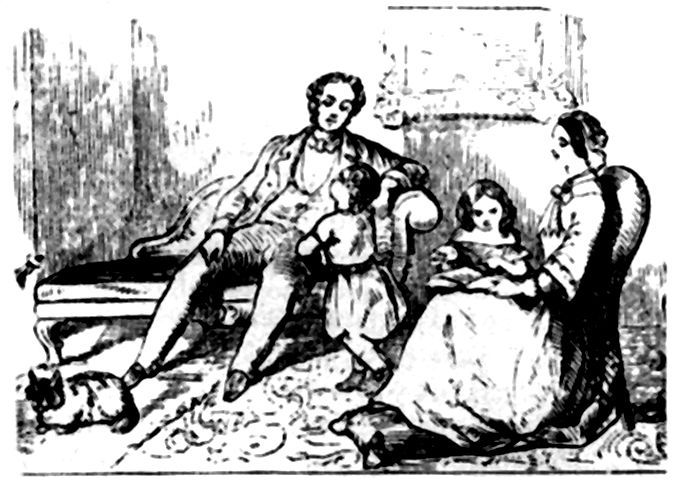
The man shown here may be spoken of as a man, a gentleman, an Englishman, a father, a husband, a friend, a merchant, a master, a householder, Sidney, or George Sidney. All these are name-words, or Nouns. In like manner, the words woman, Mrs. Sidney, Jane Sidney, lady, wife, mother, boy, Henry, girl, child, cat, book, John, tongs, fire, rug, fireside, are Nouns, or names of things.
As all these objects are represented in the engraving, it might be supposed that we might define a noun to be “the name of whatever we can see;” or use the old description, that “a noun is the name of a person, place, or thing.” It is true that the name of any thing we can see is a noun; but there are many things which we cannot see, the names of which are nouns. In the scene represented in the above cut, there would be sound from the girl who is reading, which cannot be seen; yet the word sound is a Noun. Also, the names of actions and states of being are Nouns—as reading, or sleeping.
The name of whatever we can think of or speak about is a Noun; or, a Noun is the name of whatever can be perceived by the outward senses, or by the inward mind.
The Noun, then, is the first division of words, or, as each division is often called, a part of speech. The term “noun” is derived from the Latin word nomen, signifying “a name.”
The next part of speech is the Adjective, a word used along with a noun, to express some quality or property of it—that is, to qualify it.
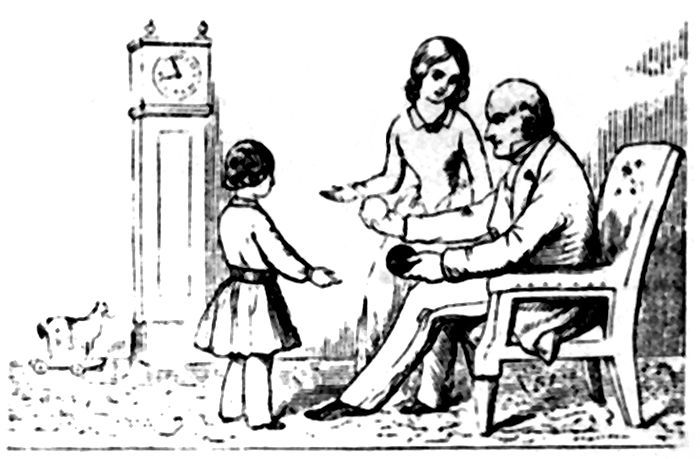
In the above cut, we see several objects, the names of which are nouns; as the man, the woman, the boy, the balls, the chair, the clock. But we observe that the man is old, the woman is young, the boy is little; one ball is black, and the other ball is white. Those words in italics are adjectives, for they qualify the nouns, that is, tell us some qualities or properties of the nouns. They may be used along with the nouns, either in the way given above, or as follows: an old man, a young woman, a little boy, a white ball, a black ball.
An Adjective is often described as a word used along with a noun, to limit its signification. Thus the words “a man,” may mean any man whatever in the wide world. But if we say “an old man,” we now limit the meaning of the word “man” to one that is old, shutting out from our consideration any man that is not old.
The word adjective is derived from the Latin words jactum, thrown,—and ad, to; signifying that it is added to, or placed beside, the noun. It is also called the adnoun.
The next part of speech is the Pronoun, the name of which tells its meaning distinctly. It is from the Latin word pro, for,—and the word noun, and means for a noun. It it a word used for, or instead of, a noun.
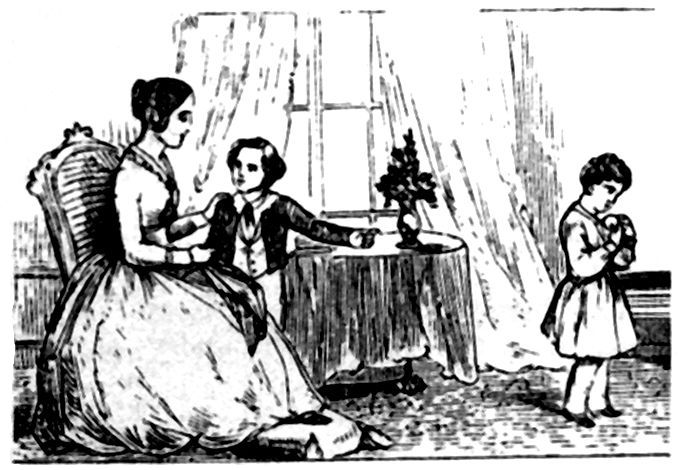
In the engraving we see a little boy who has taken his brother’s ball, and the latter is complaining to his mamma. He would very likely say to her—“Please, mamma, would you speak to Tommy; he has taken the pretty white ball that grandpapa gave me, and he won’t let me have it; and he won’t let me play with him.” And mamma probably replies—“Well, John, we will go to him, and hear what he will say to us about it.”
The words in italics are pronouns. They are used instead of nouns:—you instead of mamma; he and him instead of Tommy; me instead of John himself, who is speaking; it instead of the ball; we and us instead of mamma and John taken together.
Verbs. Whenever we speak or write, we assert or affirm something, or we command, or we ask a question. The word in the sentence that does any of these is called a Verb. Thus, in the sentences—Victoria reigns in England—Louis Napoleon is Emperor of France—His uncle Napoleon died at St. Helena, in 1821; the words, reigns, is, died, are verbs; these make the assertion.
The words in italics, in the description of the adjoining cut, illustrate the verb. Jane rides on her pony, while her papa walks at her side, holding Tommy by the hand:—The words in italics make assertions; they are verbs.
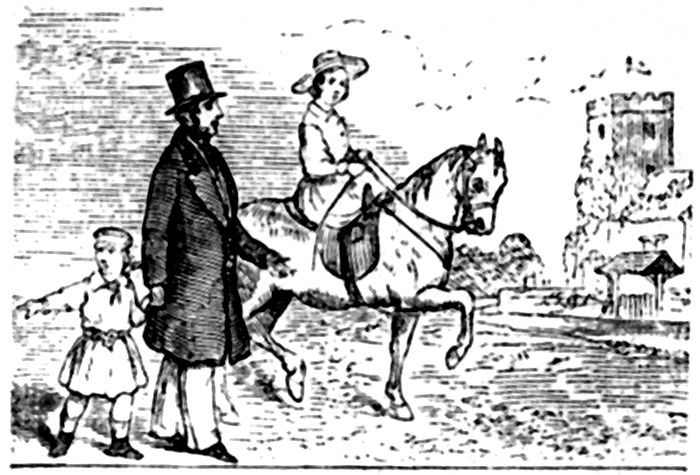
The word verb is derived from the Latin, verbum, a word; this part of speech being called the verb, or the word, as being the principal word in a sentence.
The verb was formerly defined as “that part of speech which signifies to be, to do, or to suffer;” and a respectable modern grammarian defines it as follows:—“A verb implies action, or the doing of something.” But these definitions are, in some respects, applicable to certain nouns; and the true idea of the verb is, that it is the word by which we assert, or can assert.
The next part of speech is the Adverb, a word used along with a verb, to express some circumstance relating to it—i.e., to qualify it; as, She rides well, she writes badly, they came soon, he fought bravely, he ran away. The Adverb is also used to qualify an adjective; as, She is very good, he is not tall. And it is also used to qualify another adverb; as, She rides uncommonly well, she writes very badly, they came too soon.
Adverbs may be known in this way: they answer to the questions. How? When? Where?—as, How does he write? Well, very well, or very badly.
The Preposition is a word placed before a noun or pronoun, to show its relation to something mentioned previously. Thus.—John went to France; he came with me; this letter is for Jane. The words in italics, to, with, and for, are prepositions, showing the relation between the words “France,” “me,” and “Jane,” in these sentences, and something that is previously mentioned, as that “John went,”—that “he came,”—and “this letter.” The following sentences also illustrate Prepositions:—He is in the house. She is sitting on the sofa. The letter was written by him. He threw a stone at me.
The Preposition is easily distinguished in this way: it makes sense with any of the words me, us, him, them, placed after it; as with me, to us, from him, after them.
The derivation of the word preposition partly explains its nature. It comes from the Latin words, positum, placed—præ, before.
A Conjunction is a word used to connect words and parts of sentences; as—He and I went out, but she stayed at home, that her mother might not be left alone. The words in italics are conjunctions.
The word conjunction is from the Latin words cum, with, or together—and jungo, I join.
An Interjection is any abrupt exclamation, as ah! oh! alas! oh dear! or any such expression used to indicate pain, grief, joy, or surprise. It has been observed that it is not properly a part of speech, but resembles the wild, inarticulate cries of animals. Its name is from the Latin words, inter, between—jactum, thrown: indicating some expression thrown, as it were, abruptly between words.
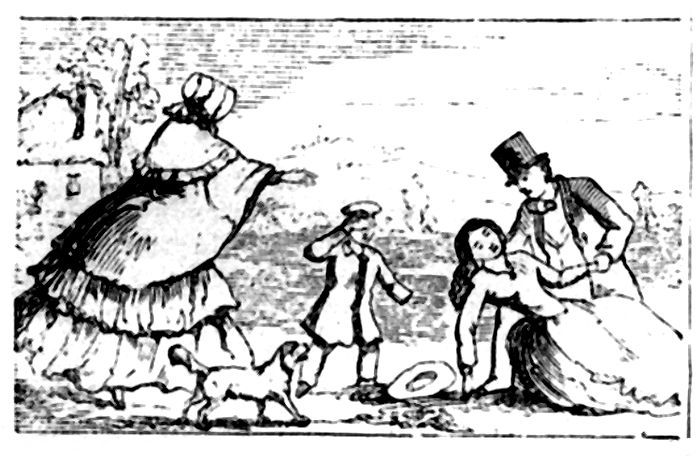
Adverb, Preposition, Conjunction, and Interjection.—What do we see in the figure? The pony has thrown Jane, and scampered away; but she is not hurt, for she fell ON the soft grass, and is only frightened. She merely cried, “Oh!” Tommy is more frightened than she is, and is crying bitterly. She will soon recover FROM her fright, for her papa is speaking kindly TO her, and holding her hand IN his, and her mamma is running TO her, and I dare say they will soon laugh AT it, and AT the dog, who is barking loudly. The adverbs are in italics; the conjunctions in small capitals; the prepositions in large capitals.
Many grammarians consider the little words, a, an, the, as forming another part of speech, which they call the Article. But they are now more usually considered as a kind of adjective.
These eight, then, are all the parts of speech. Each of the 60,000 words belongs to one or other of the above kinds of words. Let us shortly describe them:—The noun is the name of anything. The adjective qualifies the noun. The pronoun is used in place of the noun. The verb asserts, commands, or asks a question. The adverb qualifies a verb, adjective, or other adverb. The preposition shows the relation of a noun or pronoun following it, to something which has gone before. The conjunction connects words or parts of sentences. The interjection is any abrupt exclamation.
DAHLIA (CULTIVATION OF THE). Dahlias do not require too rich a soil—except those intended for exhibition, or show flowers, the management of which we shall treat of presently—in very nutritious ground they exhaust their vigour in producing strong stems and leaves, thereby causing the flowers to be poor, ill-formed, and few in number. A very barren, light soil, is equally unsuitable, and should be strengthened by a judicious addition of leaf-mould, before the plants are placed in it. Where the soil is wet, heavy, clay land—the most unsuitable of all—it must be rendered friable by an admixture of drift or river sand, or, what is still better, road-scrapings. About November, the sand or scrapings should be laid over the soil to the depth of two inches, and well dug in, the ground being left rough through the winter; in spring two more inches should be laid over, and dug in as before. A moderately rich, light loam, is indisputably the best soil; but it must be borne in mind that this plant exhausts the ground to a remarkable degree, and consequently will not succeed, if grown too frequently on the same spot. A clear, open situation, freely exposed to the sun, without either shade or shelter, is indispensable for the production of fine blossoms. Those who have but limited space and few plants should place them singly, or otherwise, in the situations most advantageous for cultivation and display which their ground affords. No general directions can apply to particular localities. But where there is plenty of room, and a large collection of plants, no mode of growing the dahlia has such an imposing effect as when planted in a mass by themselves, unmixed with any other flower. When planting in a mass, two important objects must be kept in view, or else the effect will be spoiled. The first is to place the plants according to their respective heights; the second is, to associate them so that their colours may harmonise agreeably. If the clump is to be on a border backed by a wall or hedge, so that it can be seen only from one side, the tallest-growing plants must be placed in the rear; the next tallest in front of those; and so down to the shortest, which must hold the front rank of all. But if the clump is to be formed on a bed which can be viewed from all sides, the tallest must be placed in the centre, and the next in height successively downwards, till the shortest are placed in the front. To harmonise the colours—purples and crimsons, and crimsons and scarlets, should be separated by yellow, white, or buff; the salmon-coloured and buff separated by white. The plants should be placed three feet from each other every way; this space will keep each plant sufficiently distinct when close to them, and yet so united that at a short distance the whole clump will appear as a solid mass; it will also afford room to get amongst and attend to the plants. Another mode of planting dahlias, which exhibits a grand effect, is to place a row on each side of a walk as an avenue; in such position the plants need not be more than two and a half feet apart.
Dahlias are propagated by dividing the tubers when they have formed incipient shoots, by seed, and by cuttings. As the last method is comparatively useless to the amateur, we shall not take up space to describe it, but proceed to the first two. The roots—or more properly speaking, the tubers—should be kept cool, inactive, and entire, until the beginning of May, when they should be planted out in the open border, barely buried in the soil, and covered with a hand-glass. The eyes of the tubers will soon push forth young shoots, and when these have attained the length of two or three inches, the tuber should be cut with a sharp knife, so as to retain a portion of the tuber attached to each shoot. These young plants may be placed in pots with light soil, and kept in the house for a short time; or they may at once be planted in the borders where they are to flower, sheltering them from the sun by day, and from cold at night, until they are established. Another method, slightly different indeed, is to place the roots in a warm situation—in a south border for instance—covering them all but their eyes with rotten bark, leaf-mould, or other light material; when the buds break, divide as before described. It is a safe plan when dividing the roots, to cut so as to secure, if possible, more than one promising bud on each piece. It is satisfactory to know, that except in florists’ gardens and large establishments, where quantities of plants are required early in the season, artificial heat is not required for propagating the dahlia from the tuber. We have the high authority of Mr. Paxton for saying, that plants raised according to these methods, frequently grow stronger and flower better than those which have been raised earlier in the season by the application of heat.
When the young plants, by whatever mode obtained, are finally planted out where they are intended to flower, the upper part of the root should not be less than three inches beneath the surface, and the soil should be carefully settled down about the roots, by gently pouring in water as the hole is being filled up. A large sized flower-pot inverted over the young plant makes an excellent protection at night; and shade may be afforded in the day-time by branches of fir or laurel stuck in the ground. A stake suitable to the full height of the flower must be inserted and fixed firmly into the ground close to the stem, at the time of planting. This is imperatively necessary; for the insertion of the stake after planting is sure to injure the roots, check the growth of the plant, and destroy its beauty. The leading shoot, as it advances, must be tied to the stake with strips of bass. These bands must not in the first instance be tied too tight, and frequent attention must be given to see that they do not hinder the stem from swelling to its full size. During the whole period of growth, the soil about the roots should be kept moderately moist, but not over-drenched, with water, which to this plant is equally as injurious as drought. If the soil be light, and the summer excessively dry and hot, a layer of fresh cow manure for about two feet round the base of the stem of the plant, is highly recommended as a preventative to too rapid evaporation.
Having described the culture of the dahlia, from the tuber to the flower, we shall now turn to its most interesting mode of propagation. It is from the seed alone that all new varieties are obtained, and it is only from the seed that the plant has been, and, no doubt will be, so greatly improved. About the middle or end of January, the seeds should be sown in shallow pans placed in a hot-bed frame, near the glass, and exposed to the light; as soon as the seed-leaves are properly developed, the young plants should be pricked out into other pans, at the distance of an inch from each other; they should then be watered, and shaded for a few days until they recover the shock of this, their first removal, and are briskly thriving again. When they have attained the height of two inches, they should be potted, singly, into small pots, and gradually inured to a lower temperature. As they increase in size, they require to be shifted into larger pots; and advantage taken of all opportunities of hardening them for the open air. The seedlings may be planted out, in the open air, about the end of May, and the course of culture already detailed must be followed. Until the seedlings show their flowers, there are no means of ascertaining, with certainty, their quality or colour; though it has been observed that plants with wholly green stems produce white flowers, those with brownish stems the darker coloured flowers, and those with light-coloured stems pale or blush-coloured flowers. When the blooming season arrives, the seedlings should be examined early each morning before the sun has shone upon the flowers, as their true colours are better ascertained at that time of day.
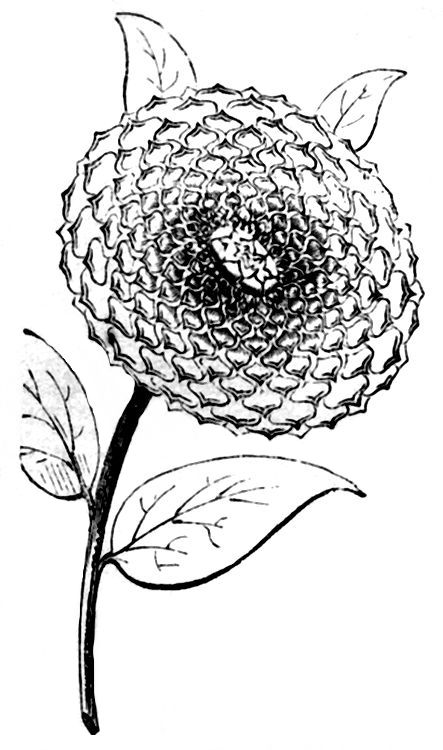
Such plants as are considered unworthy of preservation should be at once pulled up and thrown away, for they will only exhaust the soil to no purpose; and those which having proved good are worthy to be retained, should not be suffered to bloom profusely, in order that the tubers may retain more nutritive matter, and thereby be better able to produce strong and healthy plants in the following season. The tubers must never be subjected to the destructive influence of frost. About the end of September, some ashes, sawdust, peas-haulm, or other protective materials, should be laid over the roots; and when the stems and leaves turn black, the plant should be cut down to within six inches of the ground. A few days afterwards, taking advantage of a fine morning, the tubers must be lifted, and laid exposed to the sun during the remainder of the day. When the soil about the roots is dry, all that can be removed without injury should be taken off. The tubers may then be buried in dry sand, or laid on a shelf or boarded floor where they will be perfectly free from frost and damp, and in a moderately cool temperature, being at no time, through the winter, higher than forty-five, nor lower than thirty-six degrees.
MAMALUKES. The name of an ancient dynasty, who ruled in Egypt for many centuries, and still applied to the soldiers represented in the engraving.
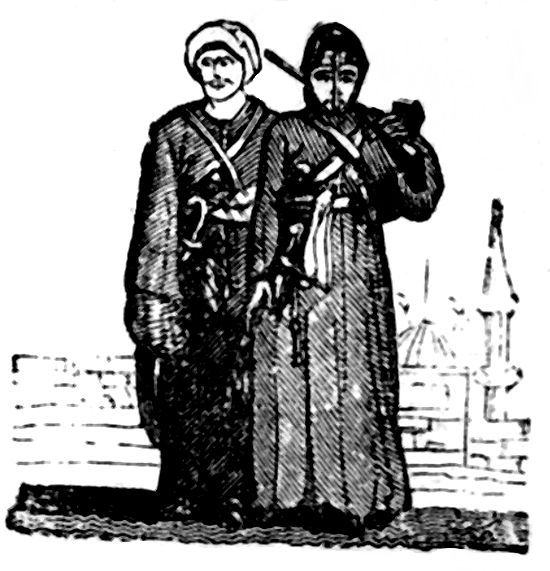
SILK (TO KEEP). Silk articles should not be kept folded in white paper, as the chloride or lime used in bleaching the paper will probably impair the colour of the silk. Brown or blue paper is better—the yellowish smooth India paper is best of all. Silk intended for a dress should not be kept in the house long before it is made up, as lying in the folds will have a tendency to impair its durability by causing it to cut or split, particularly if the silk has been thickened by gum. A white satin dress should be pinned up in blue paper, with coarse brown paper outside, sewed together at the edges.
GLASS CRACKING BY HEAT (MEANS OF PREVENTING). If the chimney-glass of a lamp be cut with a diamond on the convex side, it will never crack, as the incision affords room for expansion produced by the heat, and the glass, after it is cool, returns to its original shape, with only a scratch visible where the cut is made.
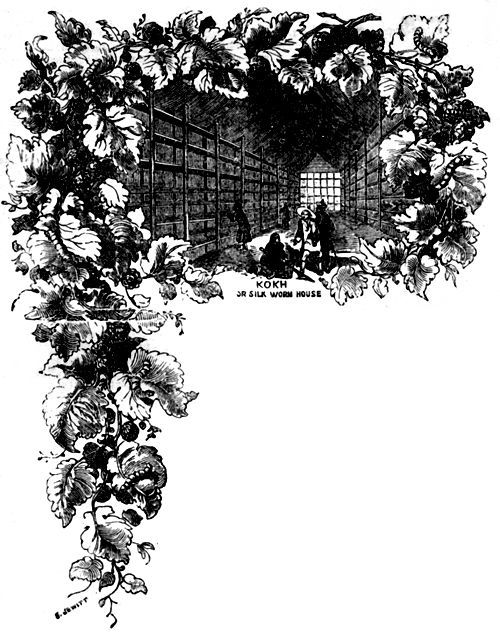
THE SILKWORM AND ITS PRODUCTS. The Silkworm is the caterpillar of one of the family Bombycidæ, systematically known by the name of Bombyx Mori. The eggs are globular, and about the size of mignionette-seed; they may be purchased in Covent Garden Market, at the rate of about ten shillings per ounce. The good ones are of a pale slate or ash colour; whilst the imperfect ones are of a light yellow tint. The moth is of a light cream colour, with transverse bands of a darker tint on the anterior wings, and a crescent-shaped central mark; the body, which is encircled by rings of a darker tinge, is covered, as are also the wings, with long velvety feathers, giving a particularly soft, thick, and warm look to the insect; the antennæ are also thickly feathered. The eggs are hatched in the spring, simultaneously with the bursting into leaf of the mulberry-trees, upon which they live, and the little worm immediately commences eating the young leaves which are placed for its nourishment. It is about eight weeks in arriving at maturity, and during that period changes its skin at four or five different moultings. When about to cast its skin it ceases to eat for some length of time, and exists in a state of perfect repose or stupor, with the fore-part of the body slightly raised. It remains in this torpid condition a sufficient time for the new skin, which is now forming, to become sufficiently mature and strong to enable the caterpillar to burst through the old one. As soon as the moulting is over, and the caterpillar has recovered from the exhaustion which its efforts have produced, it commences eating voraciously and increases in size very rapidly.
The silkworm when full-grown measures about three inches in length, and is at first of a slate colour; but as it increases in size it becomes paler, until at maturity it arrives at nearly the same tint as the moth itself. When it has arrived at this state, about ten days after the last moulting, the caterpillar seeks some convenient spot for the spinning of its web or cocoon. The silk is elaborated in two long tubular vessels lying on either side of the stomach and intestines, and terminating in a single tube opening in the lower lip of the caterpillar. The silk bags, as the vessels containing the liquid gum of which the delicate thread of silk is composed are called, are closed at their lower extremity, from whence they taper gradually to a greater width in the middle, and contract towards the head, where they unite with the spinnaret, or spinning tube.
Having now described the insects themselves, we will proceed to watch their progress from the eggs to the spinning and winding of the cocoon. During the winter months the silkworm-grower preserves the eggs in linen bags with great care, and as soon as they begin to burst into life in the spring, they are gently laid in flat wicker baskets lined with sun-baked clay, where they are supplied with the young and delicate leaves of the mulberry. At this time the tiny worms are scarcely larger than cheese mites, and therefore, for the first few days, a small quantity of food is consumed. As it is essential that the whole of the eggs should be hatched at about the same time, so as to ensure the tender budding leaves for the young brood, if any of the bags, from cold or otherwise, are later than the others in bursting into life, the peasants carefully wrap small quantities of the eggs in woollen materials and carry them about their persons, until the artificial warmth thus applied produces the desired result. For the first week the worms are kept in these wicker-baskets, fresh leaves being given to them three or four times daily. At the end of the first week they have generally grown to the size of about half an inch in length, when the period of the first moulting has arrived, and the worms lie in a torpid state for a period of two days. The caterpillars which have survived this operation are then carefully removed from the wicker baskets and placed in the kokh, which has been arranged for their reception. The kokh, or silkworm home, is a low thatched building formed of sun-dried bricks, with trellised windows covered with myrtles and other trees, so as to exclude birds and serpents; but at the same time so as to admit or a free circulation of air. In these kokhs are long ranges of mat shelves, attached to poles, and ranged one above another, with about one foot space between each range.
On these shelves the silkworms are placed by the attendant peasants, and plentifully supplied with mulberry leaves, which are now devoured in such quantities as to render it necessary to lop off, and supply them with, the small twigs from the trees. During the two weeks succeeding the first moulting, large branches are lopped from the trees every morning and brought to the kokhs, and by this means the leaves are preserved in greater freshness, and are profusely sprinkled along the shelves by the peasants. About this period the second change of skin takes place, and after this torpid condition the worm wakes up with renewed strength and vigour, and with considerably increased voracity of appetite. From this period the caterpillars grow prodigiously; they never cease eating, day or night, and the noise of their eating, on first entering the kokh, is said to be quite as loud as a heavy shower of rain falling on a thatched roof, and to resemble the incessant clipping of thousands of little scissors.
By the time the worms have attained their full maturity and growth, they have generally denuded of their foliage the whole plantation of mulberry-trees, and the attendants therefore look anxiously for the time when they shall cease eating; this they do suddenly, and again fall into a state of stupor, which lasts about two days. On again awaking to activity, the silkworm, for the first time since it came into life, shows signs of restlessness, and crawls hastily about in search of a retreat. As soon as this restlessness is perceived, the attendants carry in a quantity of dried twigs and branches, and carefully scatter them over the worms, who take to them with such avidity, that, in the course of an hour or two, not one will be found who has not selected for himself a spot whereon to weave a silken bed.
As soon as the caterpillar has fixed upon a place for the formation of its cocoon, it attaches long threads of glutinous matter or silk from side to side, to form a support for itself, and thus continues to work until it has woven around itself a hollow envelope of light tissue-like texture. As it does not move or change the position of the hinder part of its body, but continues moving its head from side to side, attaching and drawing the thread from point to point, it follows naturally that, after a time, its body becomes enclosed by the network thus produced. The work is then continued from one thread to another, the caterpillar moving its head and spinning in a zigzag manner, bending the fore-part of its body back so as to spin in all directions within reach; and the position of the body is only changed for the purpose of covering the part which was beneath it with silk. As the web is thus spun by bending the fore-part of the body back, it follows that the silkworm very soon encloses itself in a cocoon very much shorter than its own body, and the work is thus continued with the worm in a bent position. Thus the worm, by pure instinct, forms a cocoon which is of just sufficient size for its purposes in the chrysalis stage, and not guided by its present proportions. During the time of spinning, the silkworm decreases considerably in length, and, by the time it has completed its cocoon, has diminished its size by one-half.
The cocoon consists of three distinct layers of silk; the first loose and flossy, the second of a closer texture, and the inner coating finer, and glued or gummed closely together and forming a compact surface. After building the cocoon, the silkworm divests itself of its caterpillar garment, and is at once transformed into a chrysalis. In the chrysalis state the animal remains for about a fortnight, during which period the delicate and beautiful limbs of the moth are being formed.
At the end of this period a slight swelling of the chrysalis indicates that a new life is about bursting forth; a rupture down the back succeeds, and, by degrees, the snowy moth emerges from her horny shell into the hollow silken chamber of the cocoon. There, after fluttering for a few minutes, it emits a fluid which has the power of softening the silk at the pointed end of the cocoon, through which the moth soon afterwards bursts into life and activity. The cocoon takes about five days’ incessant and unceasing labour in its formation, and, when finished, is egg-shaped, and about an inch and a-half in length.
It must be borne in mind that the silk composing the cocoon is spun out by the animal in one continuous thread, from the first commencement to the completion of the fine lining; the length of this thread of course varies in some small degree, but generally the continuous unbroken thread produced and spun by each worm is about one thousand feet. Of course, as the value and use of the silk depends upon its perfect length being preserved, it would be very prejudicial to allow the moth to be formed in those cocoons which are intended for use. A sufficient quantity having been set aside for producing eggs for the next season, the rest are either exposed to the broiling sun, or placed in a furnace until the poor little animal is stifled in the very beautiful edifice which his ingenuity has formed, and which is so soon converted into a tomb. This done, the grower opens the soft external covering of floss-silk, and removes the harder cocoon. This floss-silk is afterwards brought to a manufactured state by spinning.
The cocoons are now formed into hanks ready for use by the manufacturer. For this purpose small furnaces are raised, adapted to the purpose, on the top of which is placed a vessel of water. Into this water a number of the cocoons are thrown, and the heat of the water soon softens the gum or glue, and renders the separation and proper winding the delicate threads a matter of easy accomplishment. The reeler is provided with a whisk of fine twigs bound together and cut off evenly at the ends, and with this she gently stirs and presses the cocoons in the water till the loose threads become entangled on its points. She then raises the whisk with the threads attached, removes them from it, and draws their ends through her fingers. The operator collects ten, fifteen, or twenty threads together, and passes them through small loops or eyes in a reeling machine. This apparatus is very simple, consisting only of a hollow wheel, upon which she attaches the ends of the threads, while another female turns the handle. By this means fifteen or twenty cocoons are unwound at one time, and as each is drawn off another is substituted, and thus a continuous thread, composed of many cocoons, is produced.
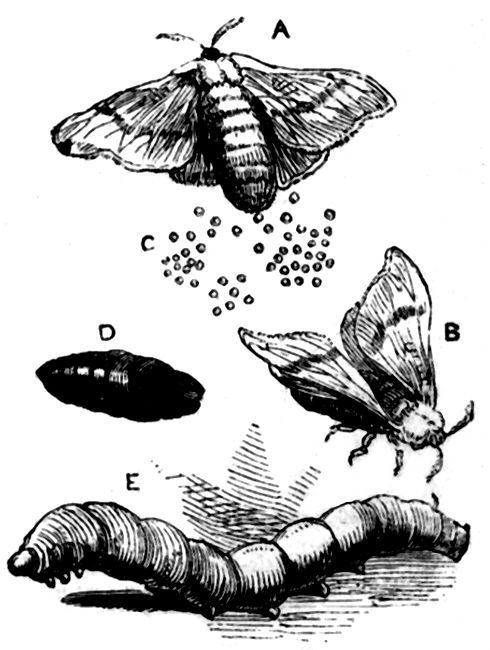
To give a more clear insight into the wonderful capacity of the silkworm for the operations it has to perform, we place before the reader engravings of the animal and its transformations, referring to our previous remarks for the explanations how these changes are effected. In the annexed illustrations we have—A, the female silkworm moth; B, the male moth; C, the eggs; D, the pupa removed from the cocoon; E, the caterpillar; F, position of the silk bags and spinnaret in the worm; and G, the cocoon.
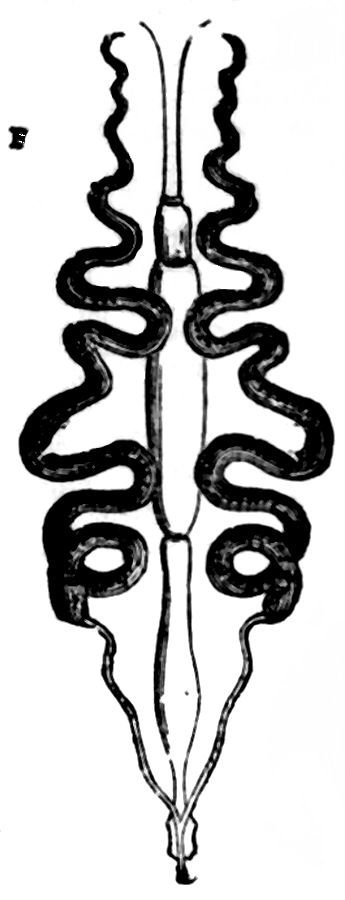
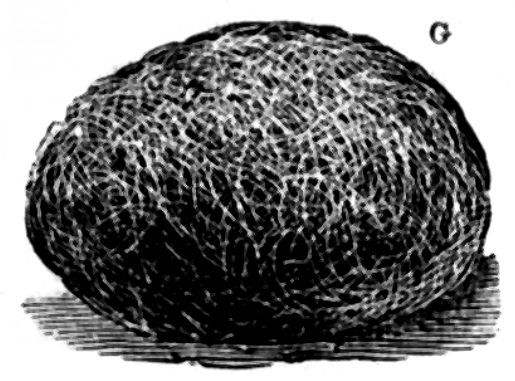
See Silkworms’ Eggs, p. 129.
MAGIC LANTERN AND DISSOLVING VIEWS. The principle of construction is very simple. It consists of a tin box, with a bent funnel at the top, which serves for the double purpose of allowing the smoke and heat to escape, and preventing the light dispersing in the room, and thus interfering with the reflected image. It has a door at the side, a polished tin concave reflector at the back of the inside, and a powerful light placed in the focus of the reflector; the light being supplied by an argand, oil, or gas lamp, or by the combustion of oxygen and hydrogen gases thrown upon lime. For private exhibitions, the oil argand lamp is generally and more easily employed. Opposite to the light and focus of the reflector is a moveable or telescopic tube, containing a hemispherical illuminating lens near to the reflector, and a convex lens at the extremity of the tube; and between the two lenses is a slit for the introduction of the painted glass slides. The general form of the magic-lantern is shown in figure 7, which represents two lanterns (B and L) arranged for exhibiting the dissolving views.
To use the Magic-lantern. Light the lamp, polish the reflector with a dry cloth, and also carefully wipe the lenses to remove any moisture; then place the lamp in the focus of the reflector, close the door of the lantern, and place it upon a table ready for use. Suspend a wet sheet from a line stretched across the room, or have a screen made of calico stretched tightly upon a frame; in the event of not using either of them, you must reflect the images upon a smooth white-washed wall. Slip in a slide with the figures, and other subjects, inverted, or upside down,—then advance or recede with the lantern, and by moving the tube in front of the slide you will be enabled to adjust the focus, and obtain a magnified image of the painting upon the slide reflected upon the screen, sheet, or wall. When the room is large enough, it is better to place the screen between the spectators and the lantern, as it renders the deception more complete.
The Magic-lantern Slides may be formed of long strips of glass, cut of sufficient width to pass freely in and out of the slit in the tube of the lantern, and if the designs are not valuable, the edges of the slides may be simply bordered with paper to prevent them injuring the tube. If, on the contrary, the paintings are good and worth preserving, the glass should be placed in a wooden frame, similar to that shown in the above figure, each slide being numbered or labelled; and the painted surface protected by another slip of glass placed over it, and fixed in the frame.
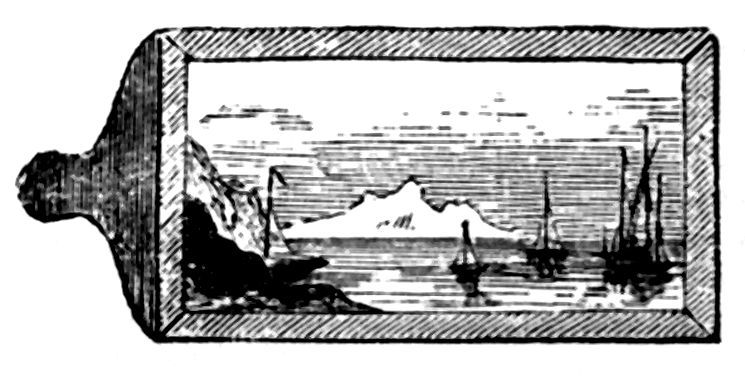
Fig. 1.
The most amusing objects for the slides are grotesque figures; sudden transformations, such as a cabbage turning into a tailor, or a basket of eggs into a nest of birds; and moving figures and objects, such as a cobbler at work, a tight-rope dancer, a storm coming on at sea, in which the ship appears to be struck by lightning and consumed; the eruption of Vesuvius; or a railroad with the train passing along. The movements of the figures and objects are obtained by painting the subject upon two glasses, which are fixed in the same frame, and so arranged, that, when one is drawn aside or moved upwards or downwards, the first design is concealed, or else another one is added to it.
Sometimes several figures are contained in the same slide; and when the subjects are distinct, such as objects of natural history, or small interior views, &c., the slide is made of mahogany or deal, with circular pieces cut out in such a manner as to leave a rabbet on one side. The paintings, protected by a plain piece of glass, are then dropped into the holes, and confined by small brads, or a thin piece of wood turned to fit in the hole, and each painting numbered or labelled, so as to prevent mistakes, and for the convenience of reference.

Fig. 2.
Dissolving Views. We have already seen, that, when a magic-lantern is used, a view painted upon the slide employed may be produced in a magnified form upon a screen, sheet, or wall. Now, if we employ two lanterns instead of one, it necessarily follows that we shall have two views distinctly thrown upon the screen. Practice will soon enable you to observe, that, by altering the focus of the lens after the clear image has been reflected upon the screen, the view becomes dim, and gradually dissolves if the focus is still further altered. If the lens of the second lantern, which is supplied with another view, is gradually brought up to the proper focus, the first view may then be said to have dissolved, and assumed the form of the second. The second view then dissolves, and a third takes its place, and so on—the chief object being to show a view which is made to fade gradually, and blend with a second view, which then becomes clear and bright, and fades, in its turn, to blend with a third.
The dissolving process may be effected in several ways: 1st. By altering the focus—a plan that succeeds for exhibitions on a small scale. 2nd. By placing the hand gradually over the nozzle of the lantern, and thus obscuring the view by degrees while a second slide is introduced, and, by gradually withdrawing the hand from before the nozzle, the second view is seen developing itself slowly and perfectly. These two plans are applicable for either single or double small lanterns. The best method of dissolving is undoubtedly that employed in all large apparatus, viz., by means of dissolvers or fans, which may be shaped like the one F in fig. 4, D in fig. 7, or else like the one (fig. 3) in the margin.
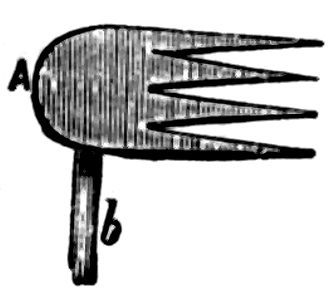
Fig. 3.
The first kind will be explained when describing the apparatus required for the oxyhydrogen lanterns; the last are simply two pieces of cardboard or tin, mounted upon metal stems (b), which are fixed in a piece of wood at such a distance from each other, and with the part (A) turned to the outside, so that the one fan obscures the light of one lantern, while the light of the other is displayed. By pulling or pushing the wood in which the fans are fixed, before the nozzles of the lanterns, the views will be dissolved easily and gradually, in such a manner that one view will merge into another so slowly that the change will appear almost supernatural, producing an effect peculiarly beautiful and attractive.
We have had three diagrams engraved of the apparatus necessary for producing dissolving views on a large scale suitable for a lecture-room, or exhibition of any kind.
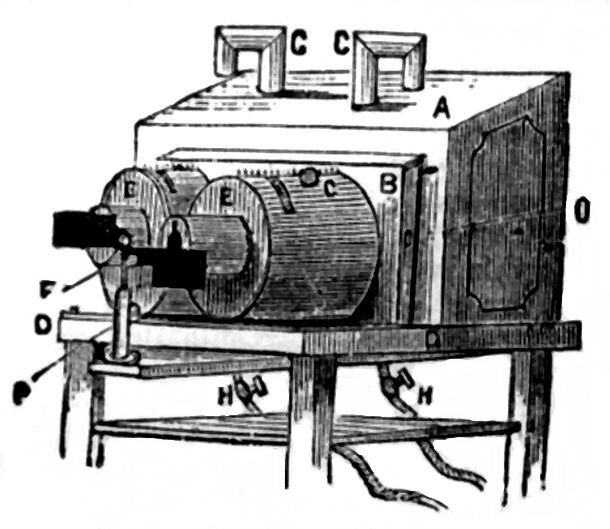
Fig. 4.
Our first figure (fig. 4) represents the form of lantern used at the Royal Polytechnic Institution, London. It consists of a box (A) with a projecting part (B), having an opening (o) between the back part and the condensers of the two lanterns contained in the box. The painted slides are inserted at (o), and thus pass between the light and the condensers or lenses. In this apparatus the lenses are made of the best glass, so as to avoid achromatic refraction. The top of the box is fitted with two chimneys (G G) made of japanned iron to allow the smoke and heat to escape. In front of the box we observe the barrels of the lanterns (E E), with the rack-work which regulates the focus by means of a screw (c) placed above them. The box containing the two lanterns is placed upon a firm stand (D D), having a slide passing underneath, which is fitted at one end with an upright piece having the dissolving fans placed on either side of a central point (F). By this arrangement the fans can be raised or depressed at the will of the exhibitor, and retained in their position by means of the screw (H), and they may also be made to advance or recede from the nozzles of the lanterns by means of the slide which passes under the table.
In shutting off the light, it is necessary to pay attention to the following observations: When the light is thrown from one lantern we obtain a large circle or disc of light thrown upon the screen; and our object in exhibiting is always to have a disc of this size, or nearly so, reflected upon the screen; therefore, in shutting off the light, it will be necessary to adjust the fans, so that the under part of one lens is only obscured as much as the upper part of the other is displayed. By this means we are enabled to preserve the brilliancy of the views and prevent the disc being irregular and dusky at the upper and lower parts. As it is sometimes necessary to use both lanterns at the same time, the fans or dissolvers are movable.
The light used in these lanterns is supplied by the combustion of oxygen and hydrogen gases in a combined state, the flame being thrown upon a cylinder of lime, so as to produce the Drummond Light; and in order that the manner in which this is done may be perfectly understood, we have had a diagram engraved.
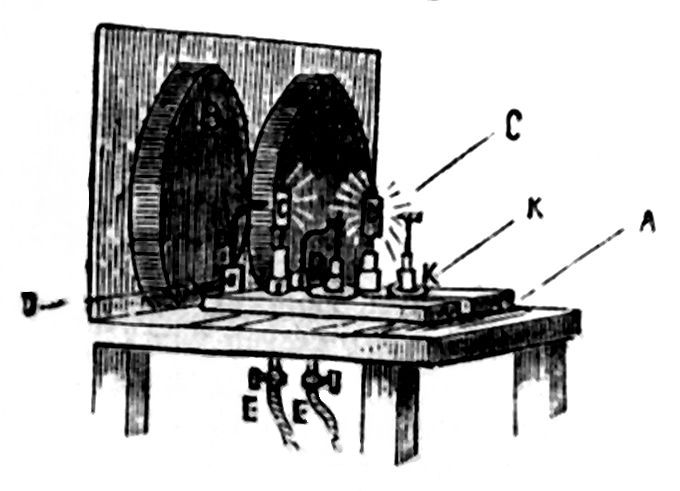
Fig. 5.
It represents the interior of the box and the back part of the condensers (B B). About 8 inches from the condensers are cylinders of lime placed upon a pivot which has a small cog-wheel at the lower part of it, and which is connected with another wheel at the lower part of the key (K), used to wind up the machinery. The object of employing this machinery is to cause the lime cylinders to revolve slowly upon their axes, so as to expose a fresh surface to the action of the flame, which is so intense that it will even melt a diamond. Close to the lime cylinders you will see the blow-pipes by which the gases are thrown upon the lime; these issue from the receivers (D D), where the gases are mixed after being supplied by the pipes (E E) connected with large caoutchouc bags (fig. 7, F,) placed between press-boards, which are loaded with weights to force the gas out of the bags. After the gases have been mixed, they may be safely ignited at the end of the blow-pipe, and the flame allowed to play upon the cylinder; but you should be careful not to allow a flame to approach these gases in a mixed state, without they are connected with a receiver or a Hemming’s safety-tube, for if this precaution is neglected, a very dangerous explosion will ensue. It is the method now generally employed to prevent accidents of this kind, and one that is extremely simple and valuable.
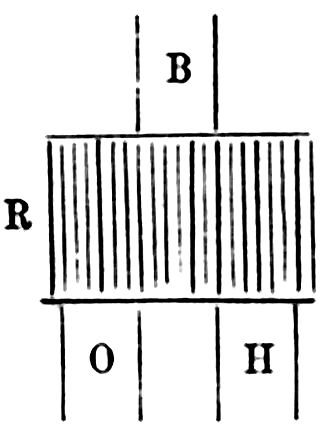
Fig. 6.
A square receiver of brass (R) is filled with fine brass wire, which is pressed tightly together, so that when the gases enter the receiver by the tubes (O and H), which are connected with the caoutchouc bags containing the oxygen and hydrogen gases, they then pass through the spaces between the brass wires, which are now, in fact, narrow tubes. After the gases have been mixed, they pass out of the receiver and through the blow-pipe (B), to be thrown upon the lime cylinder, and thus produce a most intense, pure, and beautiful light, well-known as the Drummond Light.
The lime cylinders should be wrapped in paper singly, and the whole kept in bottles with well-greased stoppers.
To make the lime cylinders, procure a piece of chalk or limestone, and cut it into pieces about 1½ inches long, and ¾ inch in diameter, and as round as you can; then drill a hole through the centre of each, in the long axis; and, having placed them in a crucible in the centre of a good fire, keep them red-hot for about four hours. Cool them gradually, and wrap in paper as soon as possible.
A convenient form of dissolving apparatus for a private exhibition, and also for lecturers who have to travel from town to town, is that shown in fig. 7.
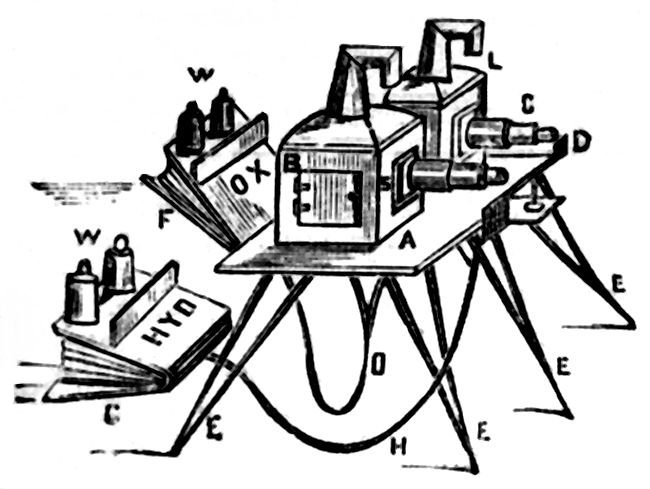
Fig. 7.
It consists of a stand (A) with folding tripod legs (E E E E), and having a slide underneath, and, as in the former one, supplied with dissolvers or fans (D). The lanterns (B L) are made of mahogany, with japanned iron tops, having a place (S) for the reception of the slides, before which are the moveable tubes (C) with the necessary lenses. A caoutchouc bag (F) fitted with a stopcock, and flexible or vulcanized india-rubber-tube (O) unions, and press-boards, is filled with oxygen gas; the boards are loaded with weights (W) to maintain an equal pressure of the gas, and another similar bag (G) filled with hydrogen gas is also loaded with weights, and connected with the apparatus by a flexible tube (H). This apparatus is so constructed that it may be packed away with the tubes, pressure-boards, lanterns, slides, &c., into a comparatively small space; and as it may be exhibited with as much ease as an ordinary lantern, it is extremely useful for the general purposes of schools, lecturers, and families.
The small magic-lanterns may be procured of almost any optician, and vary in price from 5s. to £5. The apparatus shown in fig. 4 would cost about £120, and that in fig. 7, from £42 to £100, including all the necessary tubes, gas-bags, apparatus for generating the gases, &c., but exclusive of slides in every case. The slides vary in price from 1s. to 30s. each, according to the size, design, mechanical arrangement, and style.
CLOTHES (TO BRUSH). Have a wooden horse to put the clothes on, and a small cane to beat the dust out of them; also a board or table long enough for them to be put their whole length when brushing them. Have two brushes, one a hard bristle, the other soft; use the hardest for the great coats, and for the others when spotted with dirt. Fine cloth coats should never be brushed with too hard a brush; this will take off the nap, and make them look bare in a little time. Be careful in the choice of the cane; do not have it too large, and be particular not to hit too hard; be careful also not to hit the buttons, for it will scratch, if not break them; therefore a small hand-whip is the best to beat with. If a coat be wet, and spotted with dirt, let it be quite dry before brushing it: then rub out the spots with the hands, taking care not to rumple it in so doing. If it wants beating, do it as before directed; then put the coat at its full length on a board; let the collar be towards the left hand, and the brush in the right: brush the back of the collar first, between the two shoulders next, and then the sleeves, &c., observing to brush the cloth the same way that the nap goes, which is towards the skirt of the coat. When both sides are properly done, fold them together; then brush the inside, and last of all the collar.
LACE (TO WASH). Cover a bottle (the larger the better) with a linen case made to fit tight: calico will not be found to answer. Roll the lace round it, taking care that the edge is kept smooth, and that the head of the succeeding round covers it; tack the lace if there are several lengths, in the slightest possible manner, and without any knots. When the lace is rolled round the bottle, cover it tight with linen. Then rub it well with soap (the best curd); or, if very dirty, make a strong lather, and let the bottle remain in it for a night; rinse it well by pouring water over it. If possible, expose the bottle to the sun, watering it frequently, and also to the night air, and let it dry thoroughly before you open it. Do not, on any account, use hot water, as it destroys the look of newness.
COAT (TO FOLD FOR PACKING). Lay the coat at its full length upon a table, with the collar towards the left hand; pull out the collar so as to make it lie quite straight; turn up the coat towards the collar, letting the crease be just at the elbow; let the lappel or breast on one side be turned smoothly back on the arm and sleeves. Turn the skirt over the lappel, so that the end of the skirt will reach to the collar, and the crease or folding will be just where the skirts part at the termination of the waist. When you have done on one side, do the same on the other. Turn the collar towards the right-hand, and fold one skirt over the other, observing to let the fold be in the middle of the collar.
COPPER-PLATE PRINTING. An art practised by means of what is called a rolling-press. The engraved plate (copper or steel) is covered with ink, made of oil and lamp-black, then cleanly wiped on the smooth parts, and laid on wet soft paper; and on being passed between two cylinders with great force, the impression of the engraved part is perfectly transferred to the paper.
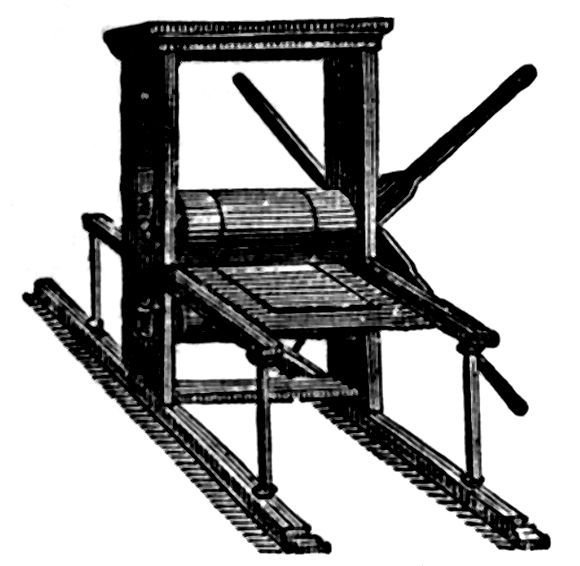
MUSIC (AN EASY METHOD OF TEACHING THE RUDIMENTS OF). The Staff—Let the pupil be provided with a pencil and a moderate-sized slate on which has been previously drawn, with the point of a penknife, the five lines of the staff thus:—

The pupil should then be desired to count these lines, commencing from the lowest, which is called the first line, to the highest, which is called the fifth line; and after that, the spaces between them. He must then be informed that the five lines and four spaces he had first counted form a staff, and that every line or space is called a degree, so that the staff contains nine degrees, namely, five lines and four spaces. On these lines, and in these spaces, the heads of notes are placed, which are formed either in the shape of an open oval, or a circular blot. The teacher should illustrate this upon the slate, thus:—
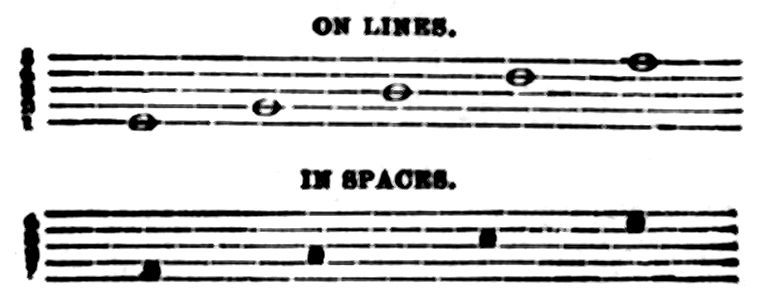
This must be repeated until thoroughly impressed upon the memory of the pupil, and until he is able to make the notes upon the lines and within the spaces himself.
The Treble, or G Clef—Names of the Notes.—For the second lesson the slate should be prepared thus:—

And the pupil must be told that each of the notes just made are named from the first seven letters of the alphabet,—namely, A, B, C, D, E, F, G; but that, in order to tell the names of these notes, a clef must be placed at the commencement of the staff. But as it is our object not to burden the mind of the pupil with more than is at present absolutely necessary, it will be sufficient here to observe, that there are two clefs, namely, the Treble or G clef, and the Bass or F clef. The Treble or G clef turns upon the second line of the staff, and all the notes on that line are called G. The notes before made upon the staff must now be removed, and the teacher will write the Treble clef thus:—

The names of the notes upon the five lines of the staff in the Treble or G clef must now be learnt, the teacher first adding the other four to the one already written on the second or clef line. The pupil must repeat after the teacher—E on the first line within the staff in the Treble clef; G on the second line within the staff in the Treble clef; B on the third line within the staff in the Treble clef; D on the fourth, &c.; and F on the fifth, &c. Afterwards, at the discretion of the teacher, the notes in the spaces may be introduced, their names being also repeated in the same manner, namely, F in the first space within the staff in the Treble clef; A in the second space within the staff in the Treble clef; C in the third, &c.; E in the fourth, &c. The names of the notes in the spaces will be very easily learnt, as the letters combined will be found to spell the little word “Face.” The slate should then be left thus:—

And the pupil will now, no doubt, feel sufficient interest to conquer any little difficulty that may remain before the next lesson.
The Base or F Clef—Names of the Notes.—The pupil should be carefully examined in the first and second lessons before the third is commenced. After which, any notes or letters that may be left upon the slate must be removed, and the Bass clef written at the commencement of the staff, thus:—

The pupil must now be shown that the Bass or F clef is placed upon the fourth line of the staff, so that the two little dots are in the third and fourth spaces, and all the notes on that line are called F. The names of the notes upon the five lines, and within the four spaces of the staff in the Bass or F clef must now be taught in a manner exactly similar to that given for those of the Treble in the preceding lesson; the teacher being particularly careful that the pupil repeats, after each note, the name of the clef. The Bass notes are generally found to be more difficult to learn than those of the Treble; the principal reason of which is that they are too often attempted before the Treble have been thoroughly mastered; and years afterwards, when playing, the pupil will frequently mistake an A for an F, or an F for a D. It cannot, therefore, be too fully impressed upon the mind of the teacher, that, even should it take six months to teach a child his notes upon the slate, they are at last really thoroughly learned; that knowledge will, at a future time, more than compensate both pupil and teacher for the time and patience expended in acquiring it. The slate must now be left thus:—

and the names of the notes well studied by the pupil before the next lesson.
The Ledger-Lines in the Treble Clef.—Another staff may now be drawn with the penknife upon the slate below that one previously used for both clefs, and the Treble clef written at the commencement of the upper staff, and the Bass clef at the commencement of the lower. The pupil is now required to write any of the notes already learnt in either clef, without hesitation, when directed by the teacher; and if this can be done with ease, the pupil may now be taught the Ledger-lines.
When more than nine notes are required, short lines are added above or below the staff, called ledger-lines. The teacher must illustrate this upon the slate, thus:—
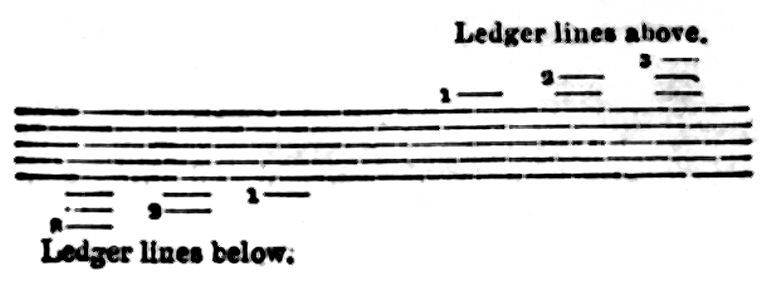
These lines, like those of the staff, are placed at equal distances from each other, and are reckoned, omitting a letter for the space between every two, in the same way. Example in the Treble clef:—
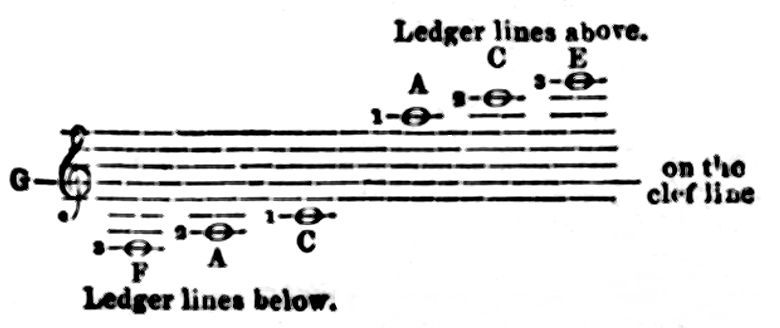
The spaces also may be continued above and below the staff, the heads of the notes being placed in the spaces left between the Ledger-lines, thus:—
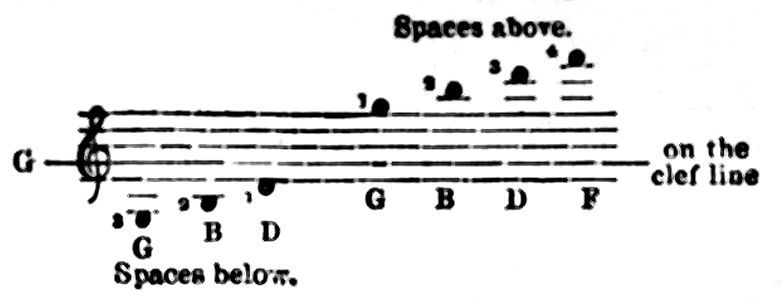
The notes upon the Ledger-lines must now be learnt, and the pupil requested to look upon the slate, and at the note to which the teacher will point, at the same time repeating after him the names of the notes, thus: C on the first line below the staff in the Treble clef; A on the second line below the staff in the Treble clef; F on the third line below the staff in the Treble clef; the teacher observing that the Treble clef is repeated distinctly each time. The notes on the Ledger-lines above the staff must now be repeated after the teacher also, thus: A on the first line above the staff in the Treble clef; C on the second line above the staff in the Treble clef; E on the third line above the staff in the Treble clef. Then the names of the notes in the spaces above and below the staff in the Treble clef must be learnt, the pupil still looking upon the slate, and repeating after the teacher, thus: D in the first space below the staff in the Treble clef, &c.; G in the first space above the staff in the Treble clef, &c. The notes must now be left upon the slate thus:—
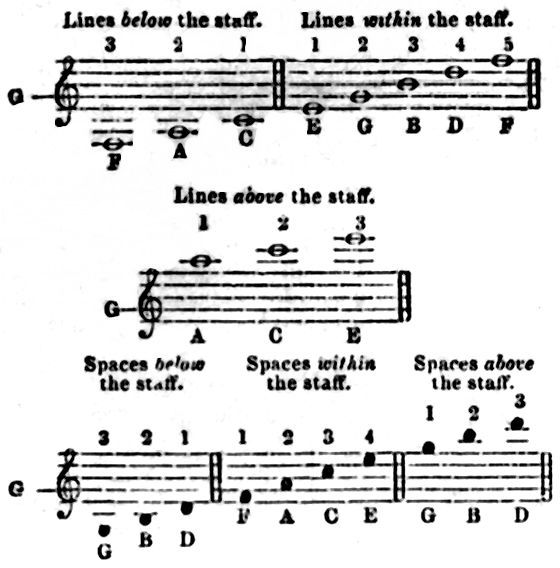
And the pupil must study them perfectly before the next lesson.
Of the Ledger-Lines in the Bass Clef.—For the fifth lesson the pupil must be thoroughly examined in all the notes of the Treble clef, both above, within, and below the staff, and each note written upon the slate by the pupil himself, commencing from F on the third line below the staff, to E on the third line above the staff, and the spaces in the same way; then he should write both lines and spaces consecutively, making the heads of the notes on the lines in the shape of an open oval, and those in the spaces a circular blot, thus:—
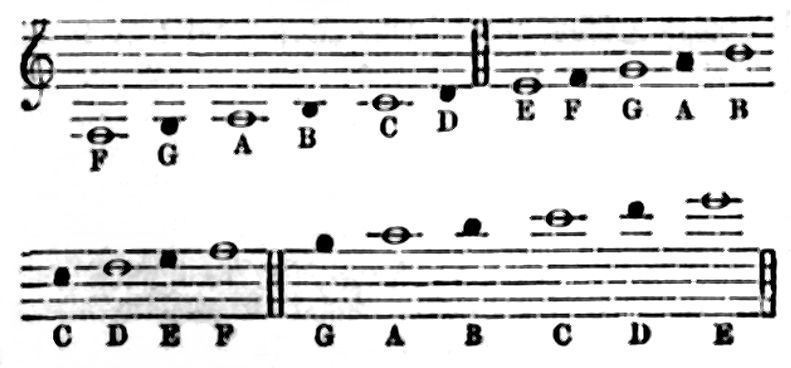
Then these should be removed from the slate, and the pupil directed to write the notes at all imaginable distances, the names of which he may easily ascertain by counting the intervening lines or spaces. If the teacher finds that these are all now perfectly learnt and understood, he may proceed to teach the pupil the names of the notes in the Bass clef; but, again, it may be well to warn him that, if he commences to teach the Bass notes before those in the Treble have been thoroughly learned, it will be doubling his own labour, and injuring his pupil, in exactly the same manner as in the directions given for those in the Treble clef; not forgetting, particularly, to observe that the pupil repeats above, within, or below the staff in the Bass clef, after the name of every note.
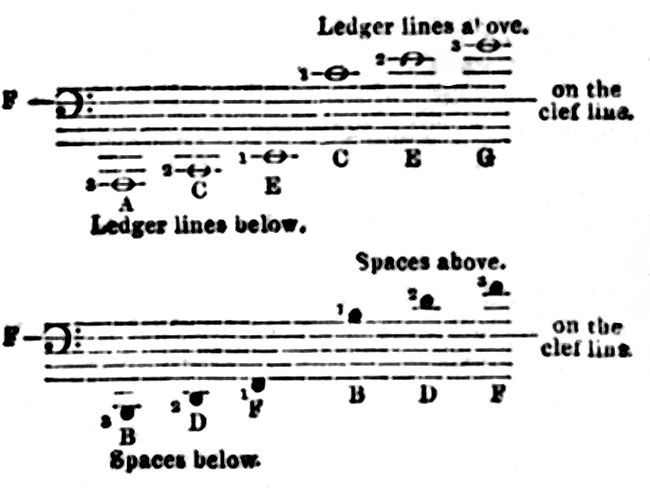
Then the Bass notes must be written by the teacher, and left upon the slate thus.—
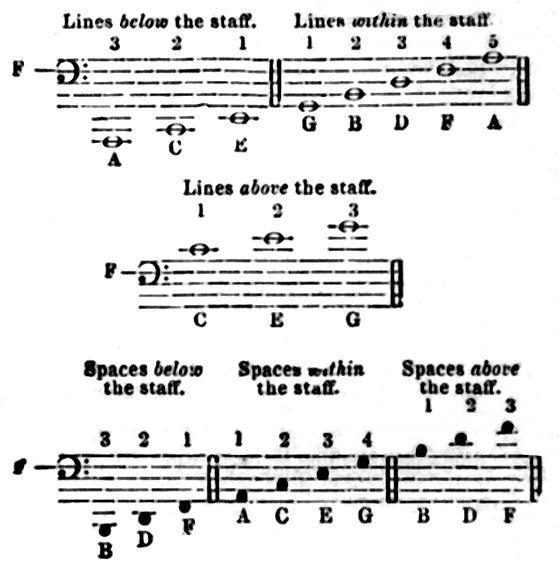
And the pupil must commit them to memory before the next lesson.
The Notes and their Names in both Bass and Treble Clef.—The teacher will now examine the pupil in the Bass notes taught in the preceding lesson; after which, the pupil must write each note upon the slate, thus:—
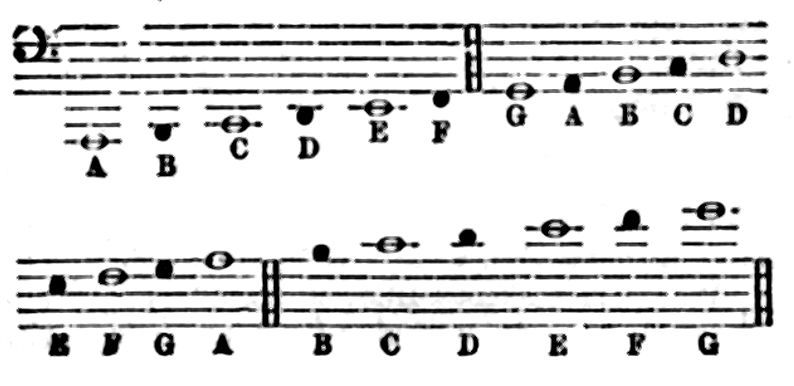
And if, after this, any note called for by the teacher above, within, or below the staff in either clefs can be immediately given by the pupil, with its name, &c., upon the slate, he may next be taught the value of the notes.
Of the Six different Sorts of Notes.—There are six different kinds of notes used in music, which are expressed by adding additional marks to the open oval and the circular blot. They are called the Semibreve, Minim, Crotchet, Quaver, Semiquaver, and Demisemiquaver, and are made thus (the teacher must now write these six different kinds of notes upon the slate).—
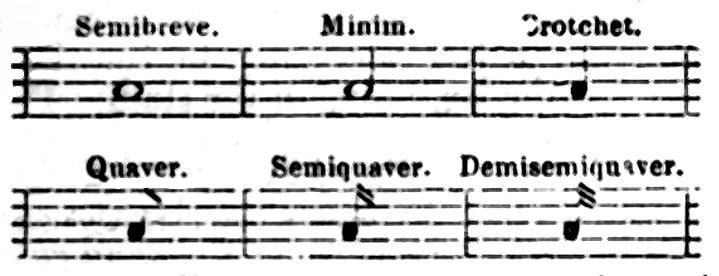
The pupil must now repeat after the teacher the following description of these notes, at the same time pointing to them upon the slate thus:—The semibreve is an open oval; the minim is an open oval with a stem; the crotchet is a circular blot with a stem; the quaver is a circular blot with a stem and a dash; the semiquaver is a circular blot with a stem and two dashes; the demisemiquaver is a circular blot with a stem and three dashes. These ought now to be written several times by the pupil himself upon the slate, and he may afterwards be told that these notes are of various lengths, and also that the semibreve is the longest note used in music, and the demisemiquaver the shortest: these he should make at once upon the slate, and will find no difficulty in remembering.
The teacher must now show that every one of these notes is equal to two of the next in value, thus—
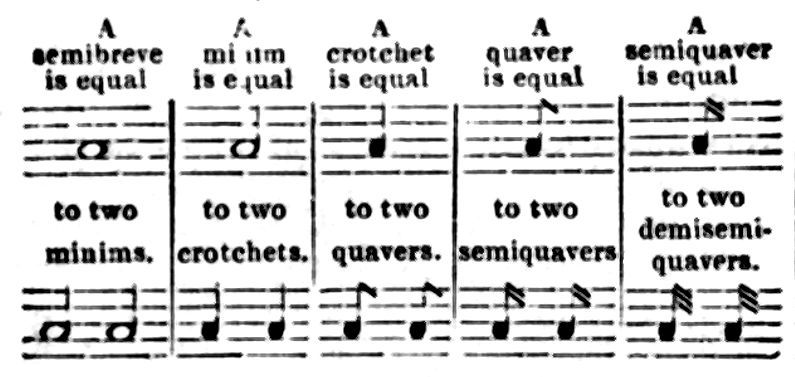
When several notes below the crotchet in value follow in succession, it is not necessary to put separate dashes to their stems, but they may be united in groups and the dash continued thus—

The six different kinds of notes, with their names, must again be written upon the slate by the teacher, and left for the pupil to learn before the next lesson.
Of the Value of Notes.—The teacher must now carefully explain to the pupil that as the semibreve is equal to two minims, it must also be equal to four crotchets, or eight quavers, or sixteen semiquavers, or thirty-two demisemiquavers, which must then be written on the slate, thus—
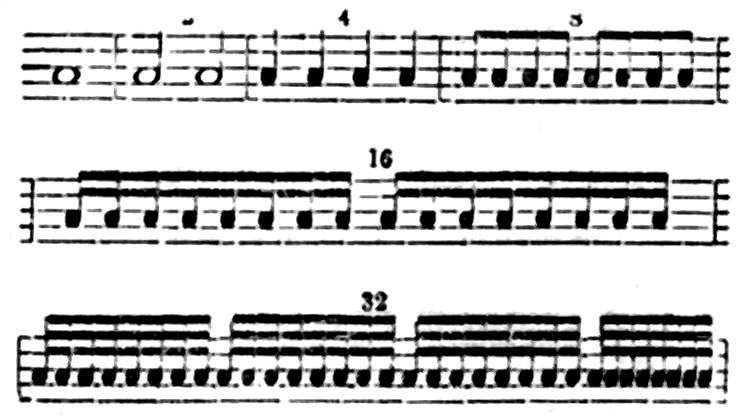
And that the minim also, which is next in value to the semibreve, is equal, not only to two crotchets, but to four quavers, or eight semiquavers, or sixteen demisemiquavers, thus—
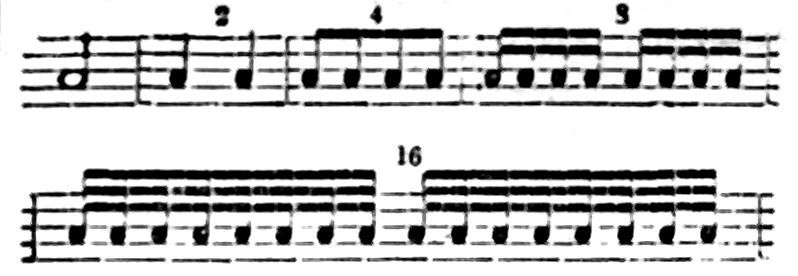
The crotchet, which is next in value to the minim, is also equal not only to two quavers, but to four semiquavers, or eight demisemiquavers, thus—

And the quaver, which is next in value to the crotchet, is also equal, not only to two semiquavers, but to four demisemiquavers, thus—

and the semiquaver, which is next in value to the quaver, is equal to two demisemiquavers, thus—
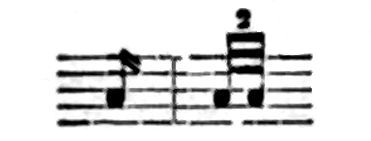
These must all be left upon the slate, for the pupil to study before the next lesson. In order to do which, two additional staves must be drawn on the other side of the slate.
Of the Dotted Notes, and of the Rests.—When a dot is placed after a note, it makes the note half at long again as it would be without it, thus—
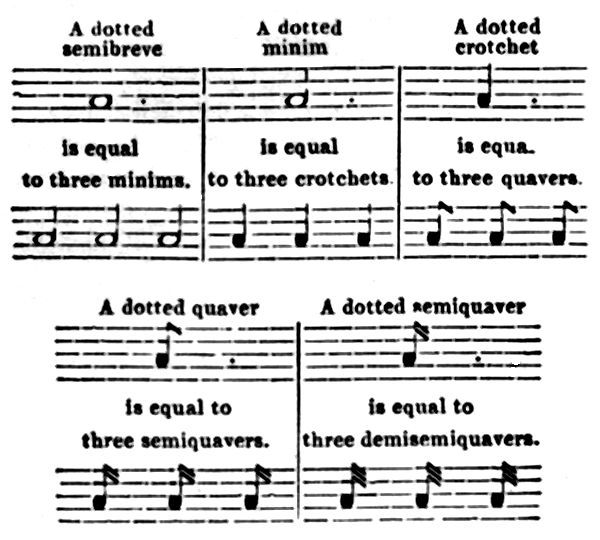
The teacher should inform the pupil that each note has its rest, or silence, of which there are six, named after the six different kinds of notes, and are made thus—(the teacher must now write the six notes, with their respective rests beneath them, upon the slate)—

The pupil must then repeat after the teacher the following description of these rests, at the same time pointing to them upon the slate, thus:—The semibreve rest is a mark placed under a line; the minim rest is a mark placed above a line; the crotchet rest turns to the right; the quaver rest turns to the left; the semiquaver rest has two marks; the demisemiquaver three. The teacher may now show the pupil that a dot placed after a rest lengthens it in the same manner as it does the note from which it derives its name. This lesson must also be left upon the slate for the pupil to study.
Of the Brace, the Bar, and the Measure, and of Triple and Common Time.—Music for the pianoforte is written upon two staves, which are joined together by a brace, made thus:—
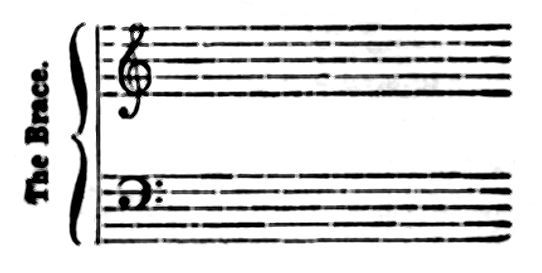
The upper staff is used for the Treble or G clef, the notes in which are played with the right hand; and the lower staff for the Bass, or F clef, the notes of which are played with the left hand.
Every musical composition is divided into equal portions of time, called measures, by means of upright lines drawn down the staff, called Bars, thus:—

Every measure must contain a certain number of notes, according to the Time marked at the beginning of the staff.
There are two principal sorts of Time; viz.:—Common or Equal Time; and Triple, or Unequal Time. Common time is expressed either by the initial letter of the word common, or by the figures 2/4. The former indicates that every measure will consist of notes to the value of a semibreve, thus:—

The latter, that every measure will consist of notes to the value of a minim. The upper figure showing how many, and the under figure showing what kinds, of notes the measure should contain. Thus, for example, in the figures 2/4 we know, by the under figure being four, that crotchets are to be counted, four crotchets only being equal to a semibreve; and the upper figure being two shows us that the number of crotchets each measure must contain will be two, thus:—

Triple time is expressed by the figures 3/2, 3/4, and 3/8. By the figures 3/2, we know that every measure must consist of notes to the value of three minims, two minims being equal to a semibreve, and the upper figure showing that three are to be counted, thus:—

By the figures ¾ we know that every measure must consist of notes to the value of three crotchets, four crotchets being equal to a semibreve, thus:—

And by the figures 3/8 we know that every measure must consist of notes to the value of three quavers, eight quavers being equal to a semibreve, thus:—

The pupil may now practice by filling up the measure with notes of a proper length himself, while the teacher looks on.
In these ten short and simple lessons we have endeavoured to render the rudiments of music as easy to the pupil as possible; and must now leave him entirely to the care of his teacher, who may begin at once to point out to him the different notes upon the piano, with their Sharps and Flats, &c. But we cannot conclude these remarks without strongly advising that no tune, however simple, be taught the pupil for the first twelve months at least, but that his practice should be entirely confined to scales and exercises; great care being taken (especially at the commencement) by the teacher to form the proper position of the hand, without which, although the pupil may have much natural taste for the art, he will never be able to arrive at any degree of perfection in his execution. [We have to acknowledge our obligations for this valuable article to that universal favourite “The Family Friend.”]
KNIFE-BOARD (TO MAKE A COMMON). Cover with thick buff-leather, on which are put emery one part, crocus martis three parts, in very fine powder, mixed into a thick paste, with a little lard or sweet oil, and spread on the leather to the thickness of a shilling. This gives a superior edge and polish to knives, and will not wear the knife near so much as the common method of using brick-dust on a board.
WATER LOUSE. A small creature of great activity, in most waters, shaped like the engraving.
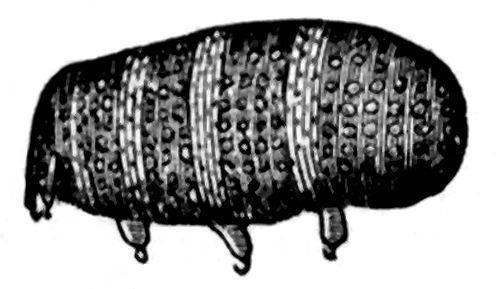
PLANTS (WATER FOR). It is well known that rain-water is far better than spring-water for promoting the growth of plants; this is from the former containing that which is a necessary ingredient in their formation—namely, ammonia—and which is abundant in liquid manure. The efficacy of this may be soon developed by sprinkling one-half of a grass-plot with spring-water, and the other half with water in which pounded carbonate of ammonia (about one ounce to the gallon) has been dissolved; the former will keep it alive, but the latter will give it vigour and luxuriance.
PRESERVES (COVERING FOR). The material used by the trade for covering preserves (instead of bladder), is made by crushing over sheets of paper, of the thickness and strength required, with linseed oil which has been previously boiled. The sheets must be hung upon a string, and be thoroughly dried before using. This material is sometimes used (a strong paper being selected) to cover tulip shades, and as a substitute for glass in workshop windows.
PAPYRUS. A reedy grass, on which the ancients wrote.
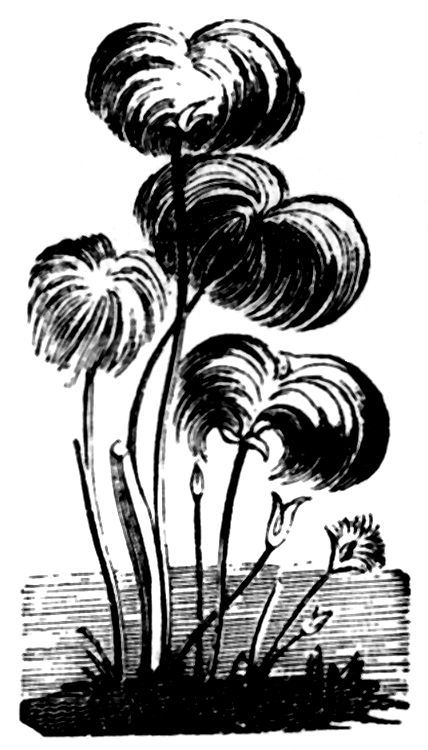
CANDLES (HOW TO MAKE GOOD). Candle-wick, if steeped in lime and saltpetre, and dried in the sun, will give a clear light, and be little apt to run. Good candles may be made thus: melt together ten ounces of mutton tallow, a quarter of an ounce of camphor, four ounces of beeswax, and two ounces of alum; then run it into moulds, or dip the candles. These candles furnish a beautiful light.
INDIAN-INK. Indian-ink, equal in quality to that imported from China, may be made by holding a plate over the flame of a lamp or candle so as to receive the fine soot, and mixing this with size made from parchment or uncoloured leather. The Indian-ink is made from fine lamp-black and size, with the addition of a little perfume, which latter is by no means essential to its quality.
SAP (THE). The sap of trees may be obtained, by wounding a branch, or stem, in spring, just before the buds open; or in the end of autumn, though less copiously, after a slight frost, yet not during the frost. It has always been observed to flow from the young wood, or alburnum, of our trees not from the bark. A branch of the vine, cut through, will yield about a pint of this fluid, in the course of twenty-four hours. The birch also affords much sap. It flows equally upward and downward, from a wound.
This great motion, called the flowing of the sap, which is to be detected principally in the spring, and slightly in the autumn, is, therefore, totally distinct from that constant propulsion of it going on in every growing plant.
This flowing of the sap has been thought to demonstrate a circulation; because, there being no leaves at the time to carry it off by perspiration, it is evident that, if it were at these periods running up the sap vessels, it must run down again by other channels. But as soon as the leaves expand, its motion is no longer to be detected. The effusion of sap from plants, when cut or wounded, is, during the greater part of the year, comparatively very small. It is thought, therefore, that this flowing of the sap is nothing more than a facility of the sap to run, owing to the peculiar irritability of the vegetable body at that period; and that it runs only when a wound is made—being naturally at rest till the leaves open and admit of its proper and regular conveyance.
As soon as the leaves expand, insensible perspiration takes place, very copiously, chiefly from those organs: but also, in some degree, from the bark of the young stem and branches. The perspiration of some plants is very great. The large annual sunflower is said to perspire about seventeen times as fast the ordinary perspiration of the human skin.
The sap, in its passage through the leaves and bark, becomes quite a new fluid, possessing the peculiar flavour and qualities of the plant; and not only yielding woody matter for the increase of the vegetable body, but furnishing various secreted substances more or less numerous and different among themselves. These, accordingly, are chiefly found in the bark. In herbaceous plants, the stems of which are only of annual duration, the perennial roots frequently contain these fluids in the most perfect state; nor are they, in such, confined to the bark, but deposited throughout the substance, or wood, of the root, as in rhubarb and gentian.
Gum, or mucilage, a viscid substance, of little flavour or smell, and soluble in water, is a very common secretion. When superabundant, it exudes from many trees, in the form of large drops, as in the plum, cherry, and peach trees, and different species of the mimosa, or sensitive plants, one of which yields the gum arabic, others the gum senegal, &c.
Resin is a substance soluble in spirits, as is the turpentine of the fir and juniper. Most vegetable exudations partake of a nature between resin and mucilage, being partly soluble in water, partly in spirits; and are therefore called gum-resins. The more refined and volatile secretions, of a resinous nature, are called essential oils; and are often highly aromatic and odoriferous. One of the most exquisite of these is afforded by the cinnamon bark. They exist in the highest perfection in the perfumed effluvia of flowers, some of which, capable of combination with spirituous fluids, are obtainable by distillation, as those of the lavender and rose.
Acid secretions are well known to be very general in plants. The astringent principle is a species of acid; it may be derived from various sources—for instance the tannin from the oak, willow, &c. An acid is found united with even the sugar in the sugar cane.
Sugar, more or less pure, is very generally found in plants. It abounds in various roots, as the carrot, beet, and parsnip; and in many plants of the grass or cane kind, besides the famous sugar-cane.
It is curious to observe not only the various secretions of different plants, by which they differ from each other in taste, smell, qualities, and medical virtues, but also their great number and striking difference, frequently in the same plant. Of this, the peach tree affords a familiar example. The gum of this tree is mild and mucilaginous: the bark, leaves, and flowers abound with a bitter secretion, than which nothing can be more distinct from the gum. The fruit is replete, not only with acid, mucilage, and sugar, but with its own peculiar aromatic and highly volatile secretion, on which its fine flavour depends. How far are we yet from understanding the vegetable body, which can form, and keep separate, such distinct and discordant substances!
The odour of plants is, unquestionably, a volatile, essential oil. Its general nature is evinced by its ready union with spirits or oil, not with water.
To all the foregoing secretions of vegetables may be added those on which their various colours depend. We can but imperfectly account for the green, so universal in their herbage; but we may gratefully acknowledge the beneficence of the Creator, in clothing the earth with a colour the most pleasing, and the least fatiguing to the eye. We may be dazzled with the brilliancy of a flower garden, but our eyes repose at leisure on the verdure of a grove or meadow.
DRESSES (TO PRESERVE COLOURS OF). The colours of merinos, mousseline-de-laines, ginghams, chintzes, printed lawns, &c., may be preserved by using water that is only milk-warm; making a lather with white soap, before you put in the dress, instead of rubbing it on the material; and stirring into a first and second tub of water a large tablespoonful of ox-gall. The gall can be obtained from the butcher, and a bottle of it should always be kept in every house. No coloured articles should be allowed to remain long in the water. They must be washed fast, and then rinsed through two cold waters. Into each rinsing water, stir a teaspoonful of vinegar, which will help to brighten the colours; and after rinsing, hang them out immediately. When ironing-dry (or still a little damp), bring them in; have irons ready heated, and iron them at once, as it injures the colours to allow them to remain damp too long, or to sprinkle and roll them up in a covering for ironing next day. If they cannot be conveniently ironed immediately, let them hang till they are quite dry; and then damp and fold them on the following day, a quarter of an hour before ironing. The best way is not to do coloured dresses on the day of the general wash, but to give them a morning by themselves. They should only be undertaken in clear bright weather. If allowed to freeze, the colours will be irreparably injured. We need scarcely say that no coloured articles should ever be boiled or scalded. If you get from a shop a slip for testing the durability of colours, give it a fair trial by washing it as above; afterwards, pinning it to the edge of a towel, and hanging it to dry. Some colours, (especially pinks and light greens,) though they may stand perfectly well in washing, will change as soon as a warm iron is applied to them; the pink turning purplish, and the green bluish. No coloured articles should be smoothed with a hot iron.
WOOD (TO GIVE A FINE BLACK COLOUR TO). Steep the wood for two or three days in lukewarm water, in which a little alum has been dissolved; then put a handful of logwood, cut small, into a pint of water, and boil it down to less than half a pint. If you then add a little indigo, the colour will be more beautiful. Spread a layer of this liquor quite hot on your wood, with a pencil, which will give it a violet colour. When it is dry, spread on another layer; dry it again, and give it a third; then boil verdigris at discretion, in its own vinegar, and spread a layer of it on the wood; when it is dry, rub it with a brush, and then with oiled chamois skin. This gives a fine black, and imitates perfectly the colour of ebony.
GLASS OR CHINA (TO PACK). Procure some soft straw or hay to pack them in, and if they are to be sent a long way, and are heavy, the hay or straw should be a little damp, which will prevent them slipping about. Let the largest and heaviest things be always put undermost, in the box or hamper. Let there be plenty of straw, and pack the articles tight; but never attempt to pack up glass or china which is of much consequence till it has been seen done by some one used to the job. The expense will be but trifling to have a person to do it who understands it, and the loss may be great if articles of such value are packed up in an improper manner.
SHELLS (TO POLISH). This may be done by either hand-labour or by varnishing; in both cases all the rough parts must be well rubbed down with emery and water. If they are to be polished by hand (which is the best and most lasting way), after they have received two or three courses of emery, of different, degrees of fineness, they must be finished with buff-leather, dressed with rotten stone and oil.
PASTE. Good and durable paste may be made with flour in the usual way, but rather thick, with a proportion of brown sugar and a small quantity of corrosive sublimate. The sugar keeps it flexible, and prevents it sealing off from smooth surfaces, and the corrosive sublimate, independently from preserving it from insects, is an effectual check against its fermentation. This salt, however, does not prevent the formation of mouldiness; but a drop or two of the essential oil of lavender, peppermint, anise, or bergamot, is a complete security against it. Paste made in this manner and exposed to the air, dries without change to a state resembling horn, so that it may at any time be wetted again, and applied to use; and if kept in a close covered pot may be preserved in a state fit for use at all times.
POLISHED IRON (TO PRESERVE). Polished ironwork may be preserved from rust by a mixture not very expensive, consisting of copal varnish intimately mixed with as much olive oil as will give it a degree of greasiness, adding thereto nearly as much spirit of turpentine as of varnish. The cast-iron work is best preserved by rubbing it with blacklead. But where rust has begun to make its appearance on grates or fire-irons, apply a mixture of tripoli with half its quantity of sulphur, intimately mingled on a marble slab, and laid on with a piece of soft leather: or emery and oil may be applied with excellent effect; not laid on in the usual slovenly way, but with a spongy piece of the fig-tree fully saturated with the mixture. This will not only clean but polish, and render the use of whiting unnecessary.
STEEL-YARD. An instrument depending on the principle that equal multiples of matter and motion produce equal momenta; so that a lever revolving at the centre D, and moving a body at one inch from the centre equal to six pounds, will be balanced by another body of one pound at six inches from D.
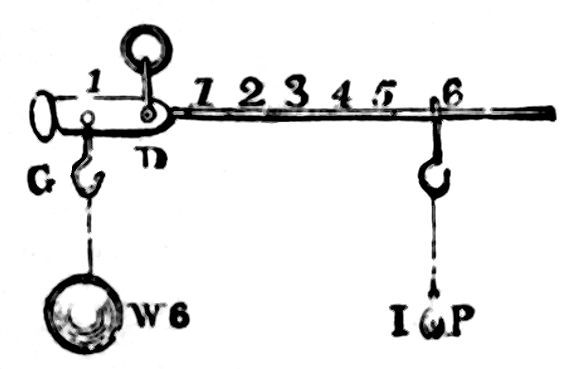
STICKING-PLASTER. Take half an ounce of benzoin, and six ounces of rectified spirit, dissolve and strain; then take one ounce of isinglass, and half a pint of hot water; dissolve and strain apart from the former. Mix the two, and cool. This jelly is to be brushed ten or twelve times over black silk, stretched smooth. Dry, and finish with a solution of four ounces of chian turpentine, in six ounces of tincture of benzoin.
SALAMANDER. A species of lizard of deep black and orange colours, and perfectly harmless. Superstition ascribed to it the power of resisting fire.
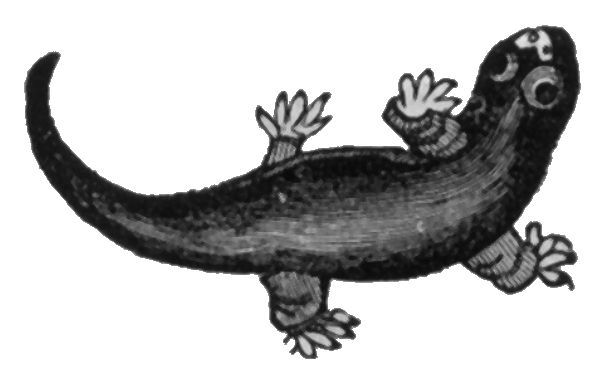
FURNITURE-POLISH. Melt beeswax in spirits of turpentine, with a very small proportion of resin. When it is entirely dissolved, dip in it a sponge, and wash the mahogany lightly over with it. Immediately afterwards, rub it off with a clean soft cloth. For carved furniture, spread the mixture on with a small soft brush, and rub it off with another brush, a very little harder.
OURANG-OUTANG. An ape without a tail, like a dwarf man, but without organs of speech, or muscles for laughter.
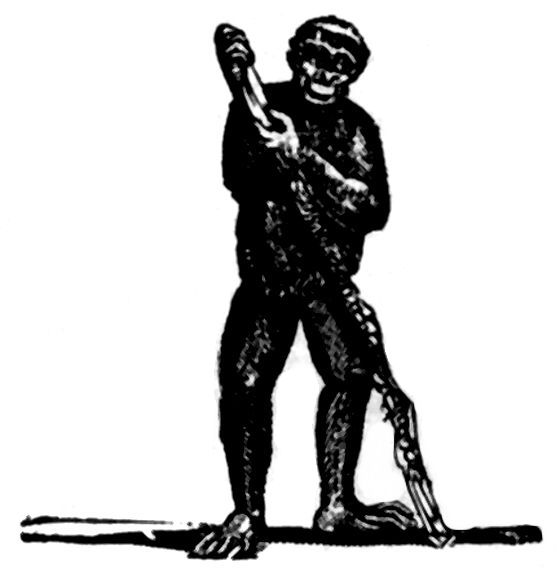
PORCELAIN OR GLASS-WARE (TO CLEAN). The best material for this purpose is fuller’s-earth; but it must be beaten into a fine powder, and carefully cleared from all rough or hard particles, which might endanger the polish of the brilliant surface. In cleaning porcelain it must also be observed that some species require more care and attention than others, as chinaware in common use frequently loses some of its colours. The red, especially of vermilion, is the first to go, because that colour, together with some others, is laid on by the Chinese after burning.
ROSES (TO RESTORE FADED). Throw some sulphur on a chafingdish of hot coal, hold a faded rose over the flames of the hot sulphur, and it will become quite white; in this state dip it into water; put it into a box or drawer for three or four hours; when taken out it will be quite red again.
PLIERS. An instrument, or double lever, the fulcrum of which is at the centre, and it enables watchmakers and other artisans to take firm hold of any small objects.
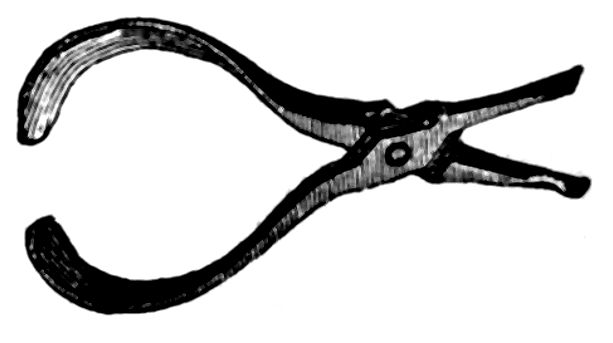
SEPTEMBER is literally the seventh month of the year according to the ancient Roman calendar, as established by Romulus, but the ninth of Numa’s year. It derives its name from Septem, seven, and imber, a shower of rain, as this is generally the commencement of the rainy season. The Senate of Rome would have named it Tiberius, in honour of that emperor, but he rejected the compliment. Domitian called it Germanicus. It was also named Antoninus in honour of Antoninus Pius; and Commodus called it Herculeus; but the name of September, though improper if we consider its place in the number of months, has outlived every other appellation. Originally the month had only sixteen days assigned to it in the old Alban calendar; but they were increased to thirty by Romulus, and to thirty-one by Julius Cæsar, while Augustus reduced the number of days to thirty, as they exist at the present time.
Our Saxon ancestors called this month Gerst Monath. Verstegan informs us that the reason it was thus called was, “that barley, which that monath commonly yeelded, was antiently called gerst, the name of barley being given unto it by reason of the drinke therewith made, called beere, and from beerlegh it came to be berlegh, and from berlegh to barley. So, in like manner, beereheym—to wit, the overdecking or covering of beere—came to be berham, and afterwards barme, having since gotten I wot not how many names besides. This excellent and healthsome liquor, beere, antiently also called ael, as of the Danes it yet is (beere and ale being in effect all one), was first of the Germans invented and brought into use.”
The Synonymes of the month are—in Latin, September; French, Septembre; Italian, Settembre; and Portuguese, Setembro.
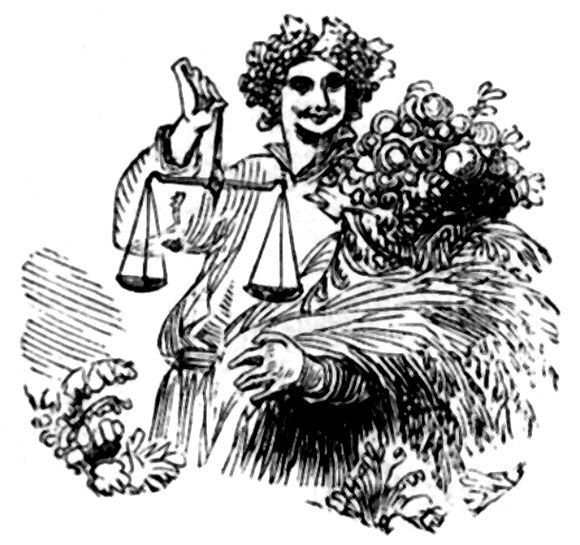
This month is allegorically represented as a young man dressed in purple, with a wreath of white and purple grapes upon his head, and with a merry countenance. Under his left arm he holds a bundle of oats, and in his right-hand a cornucopia of the ripe fruits of the season. The sign of Libra, the balance, on his right, is symbolical of the sun entering that constellation on the 23rd of the month.
September is the month for the sports of the field. With the first day partridge-shooting commences, and then the eager sportsman, who has long watched where the birds alight and feed, with impatient step hastens to gain the stubbles, with dogs and gun.
The autumnal season sets in about Michaelmas with a cooler air, often cold nights, but for the most part fine weather. As it advances, and the temperature continues to decline, it frequently produces showers and wet weather, accompanied with high gales of wind, which prevail most during the night, and are often succeeded by dead calms in the day-time. Towards the close of the month the fogs become dense, and sometimes last during the day. They spread more especially over the meadows to a great extent in low and flat situations, without being effectually dissipated even by the sun’s mid-day rays.
The red-letter days of this month are tolerably numerous:—
The 1st is St. Giles’s-day.—This saint was born at Athens, and became abbot of Nismes, in France, in 715, and died in 750. He is the patron saint of beggars and cripples. St. Giles’s church, Cripplegate, London, and the High church, Edinburgh, are dedicated to him. Numerous miracles are attributed to this saint by the writers of early ecclesiastical history.
7th. St. Eunurchus, Enurchus, or Evurtius.—This saint is retained in the Church of England calendar; but all that we can learn respecting him is, that he was a bishop of Orleans, who lived in the reign of Constantine, and died about 340.
8th. The Nativity of the Virgin Mary.—This is a grand festival in the Romish Church, and is still retained in the Church of England calendar. It has been held in honour of the Virgin Mary for more than a thousand years, with matins, masses, homilies, collects, processions, and other ceremonies.
14th. The Exaltation of the Holy Cross, or, as it is sometimes called, Holyrood-day.—This is a festival of the Romish Church, retained in the Church of England calendar. It celebrates the miraculous appearance of a cross in the heavens to the Emperor Constantine. The rood was a carved group of the Four Evangelists; or Our Saviour, with the Virgin Mary on one side and St. John on the other. This group was placed in a gallery across the nave, near the chancel or choir of the church, which was henceforth called the rood-loft, or rood-gallery; here the choir, or musicians who performed the mass, were placed during the service.
21st. St. Matthew.—This day is a festival of the Church of England, held in honour of the son of Alpheus, who is said to have died a martyr in Ethiopia. Upon this day the lord mayor, aldermen, sheriffs, and governors of the various royal hospitals and charities in London, attend divine service, and afterwards visit Christ’s Hospital, when orations are delivered, in Latin and English, by the two senior scholars in the school who are qualifying for college.
29th. Michaelmas-day is a festival instituted in the year 487, in honour of St. Michael and All the Holy Angels. It is a great festival of the Romish Church, and is still retained in the calendar of the Church of England. Wheatley, in his “Exposition of the Book of Common Prayer,” remarks that the feast of St. Michael and All Angels is observed, that the people may know what benefits we derive from the ministry of angels. Many very curious customs are observed in different parts of this kingdom upon Michaelmas-day. In Kidderminster, the inhabitants till within the last fifteen or twenty years assembled at a particular hour of the day, which was announced by the ringing of the town-house bell, and during one hour—termed lawless hour—the poorer class of people amused themselves by throwing cabbage-stalks at each other, while the higher classes threw apples from the town-hall among the crowd. In some parts of Scotland the people bake a cake upon this day, which is called “St. Michael’s bannock.” In Ireland a sheep is often killed upon this day, and a part of it given to the poor. In England, Geese are “ordain’d to bleed at Michael’s shrine.”
Dante, the great poet of Italy; Oliver Cromwell, the Protector of England; Buffon, the distinguished Naturalist; and Nelson, the illustrious British Admiral, were born in this month.
On the 3rd of this month, in 1651, Cromwell gained the celebrated victory of Worcester, which, as it gave the Commonwealth-party full power over the three kingdoms, he called “the crowning mercy of God.” In 1658, on the very same day of the month, this distinguished general breathed his last.
OCTOBER was the eighth month of Romulus’s year, as the name implies, being derived from Octo, eight, and imber, a shower of rain; but in the calendar of Numa, and of Julius Cæsar, it was classed as the tenth month of the calendar, as at the present time. The Senate of Rome gave this month the name of Faustinus, in compliment to Faustina, the wife of the Emperor Antoninus; and Domitian called it after himself; but, in spite of all attempts to alter the name, it has continued to preserve the one originally given by the old Romans. The number of its days, in the time of Romulus, was the same as at present. Numa Pompilius reduced them to twenty-nine; but Julius and Augustus Cæsar each added one day, so that the original number of days was restored, and has not been altered since.
Among our Saxon ancestors this month was called Wyn Monath, or wine month, wyn signifying wine; and Verstegan observes:—“Albeit they had not antiently wines made in Germany, yet in this season had they them from divers countries adjoining.” They also called it Winter fulleth, or fylleth, from the approach of winter.
Synonymes.—In Latin, October; in French, Octobre; in Italian, Ottobre; and in Portuguese, Outubro.
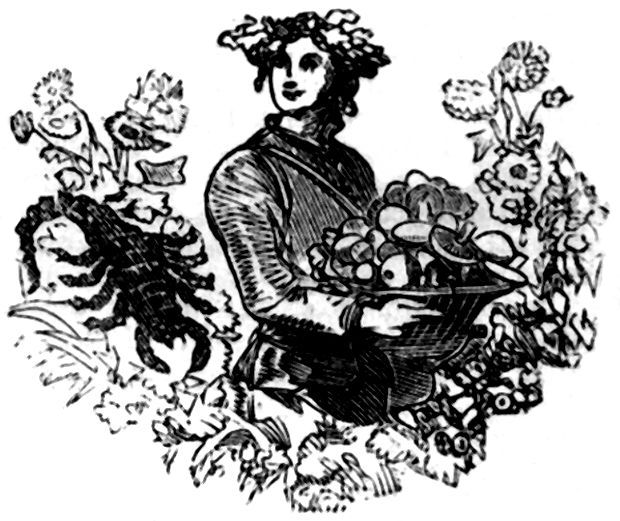
The Symbol, or Allegory of the month is a young man, dressed in a garment of carnation and yellow, indicative of the hue of the trees at this season; his head is decorated with a garland of acorns and oak-leaves, and his face
“Full of merry glee,
For yet his noule was totty of the must,
Which he was treading, in the wine-vat’s lee,
And of the joyous oyle, whose gentle gust
Made him so frollick.”
In his right-hand he held a basket of medlars, chesnuts, mushrooms, and other fruits, “ripe and rare;” while in his left hand he grasped the sign Scorpio, the scorpion, symbolical of the sun entering that constellation on the 23rd of the month.
The 1st of October is a favourite day with the sportsman; for then pheasant-shooting begins. This day is also appointed by Act of Parliament for commencing to decoy wild fowl in Lincolnshire, whence the London markets are chiefly supplied with wild ducks, teal, and widgeons. In a single season upwards of 30,000 of these birds have been sent to the metropolis from Wainfleet.
6th. Faith.—This name, in the Church of England calendar, was given in honour of a female at Aquitaine, who was put to death under Dacian. She was the titular saint of several churches in France, particularly that of Longueville, in Normandy, which was erected by Walter Giffard, Earl of Buckingham.
9th. St. Denys, or Denis, is the patron saint of France, and the legend informs us, that he was beheaded, with some other martyrs, in the year 272, upon an eminence in the neighbourhood of Paris, since called Mons Martyrum (Montmartre), in honour of them.
11th. Old Michaelmas-day.—A custom formerly prevailed in Hertfordshire for young men to assemble in the fields, and choose a leader, whom they were obliged to follow through fields and ditches. This occurred every seven years, and every publican then supplied a gallon of ale and a ganging cake—a plum cake—so called from the day being termed a ganging-day.
17th. St. Etheldreda was the daughter of Annas, king of the East Angles, and born about 630, at Ixning, formerly a noted town on the western border of Suffolk. Having taken the veil, she ultimately became an abbess, and acquired celebrity for having saved herself and nuns from the outrage of the Danes by mutilating their faces, which so exasperated the Danes, that they fired the convent, and destroyed its inmates.
18th. St. Luke.—This festival was appointed in the twelfth century, in honour of the Evangelist. He is said to have died about the year 70, at the age of eighty-four, having written his gospel when seventy-six years of age.
20th. On this day, in 1632, was born the celebrated architect, Sir Christopher Wren. He was the son of the Dean of Windsor, and first drew his breath at East Knoyle, in Wiltshire. His mathematical talents were precociously manifested; and at the age of fifteen he wrote “A New System of Spherical Trigonometry;” but it was in 1663 that his architectural genius was first called into action, when he was commissioned to prepare designs for the restoration of St. Paul’s cathedral, the building of which was begun in 1675. Besides this magnificent pile he erected the hospitals at Chelsea and Greenwich, various public edifices, and about sixty churches. He died in 1723.
26th. St. Crispin.—Formerly St. Crispinian’s name was coupled with St. Crispin’s, but it has long been disjoined from it. These two saints are said to have been two Roman youths of good birth, brothers, who in the third century went as Christian missionaries to France, and preached for a long time at Soissons. In imitation of St. Paul, they supported themselves by working at the trade of a shoemaker by night, while they preached during the day.
28th. St. Simon and St. Jude is a festival of the English Church. Simon is said to have suffered martyrdom in Britain. St. Jude, also called Thaddeus, suffered martyrdom in Persia.
29th. On this day was beheaded the illustrious navigator and historian, Sir Walter Raleigh. He was born at Budleigh, in Devonshire, and did eminent service for Queen Elizabeth, particularly in his discovery of Virginia, and in the defeat of the Spanish Armada; but on the accession of James I. he lost his interest at Court, was stripped of his preferments, unjustly accused of high treason, tried, condemned, and executed on the 29th October, 1618. The grand work which has established his fame is “The History of the World,” to the end of the Macedonian Empire, B.C. 323.
31st. All-hallow Even, or Hallow E’en, is the great festival of the month, and is the vigil of All-Saints’-day. Many curious customs are connected with this day. Burns informs us, in a note to his poem on “Hallow E’en,” that “the first ceremony of the festival is pulling each a stock or plant of kail. They must go out, hand in hand, with eyes shut, and pull the first they meet with; its being big or little, straight or crooked, is prophetic of the size and shape of the grand object of all their spells—the husband or wife. If any yird, or earth, stick to the root, that is tocher, or fortune; and the taste of the custoc, that is, the heart of the stem, is indicative of the natural temper and disposition. Lastly, the stems, or, to give them their ordinary appellation, the runts, are placed somewhere above the head of the door; and the Christian names of the people whom chance brings into the house are, according to the priority of placing the runts, the names in question.”
FLOWER (THE). The flower consists of several parts.
The calyx, or flower cup, forms the external integument which protects the bud before it expands: it consists of several parts, called sepals, resembling small leaves, both in form and colour. These sepals are, in general, more or less soldered together; sometimes so completely as to form a cup apparently of one piece.
Above and within the calyx rises the corolla, which is the coloured part of the flower. It is composed of several petals, either separate or cohering, so as to form a corolla of one single piece: in the latter case, the flower is called monopetalous. When the petals first burst from the calyx, and expand in all their beauty, they still serve to protect the central parts of the flower. They are at first curved inwards, forming a concavity around the delicate organs which occupy the centre. This not only shelters them from external injury, but reflects the sun’s rays upon them, like a concave mirror; thus rearing them, as it were, in a hot-house. When these parts are full-grown, the artificial heat being no longer necessary, and the admission of light and air being not only safe but advantageous, the petals expand; leaving the internal organs exposed to the free agency of these elements.
At the base of the petals is generally situated an organ, called the nectary. This is the store whence the bee derives honey.
The most important parts of the flower are those organs which occupy the centre. It is here that the seed which is to propagate the plant is lodged, in a vessel called the ovary, or seed-vessel. From its summit rises a little threadlike stalk, called a style; which, at its extremity, supports a small, spongy substance, denominated the stigma. These three parts form a whole, which bears the name of carpel.
Immediately surrounding the pistils are situated the stamens; each of which consists of a slender filament, supporting a little bag, or case, called an anther, filled with pollen, which is a species of dust or powder. The anthers, when ripe, burst; and, being more elevated than the stigma, shed their pollen upon it; without which no seed can be perfected.
In some vegetables the stamens are in one flower and the pistils in another; in others, the stamens and pistils are upon separate plants. In these cases the pollen is conveyed from the one to the other by means of the wind, or by winged insects, which, in penetrating, by means of their long and pliant proboscis, within the recesses of the corolla, in order to obtain the nectar, cover their downy wings with the pollen. This unheeded burden they convey to the next flower on which they alight; and in working their way to the nectary, it is rubbed off and falls on the stigma. Every insect, however ephemeral, every weed, however insignificant, has its part assigned in the great system of the universe.
In Persia, very few of the palm and date trees, under cultivation, have stamens, those having pistils being preferred, as alone yielding fruit. In the season of flowering, the peasants gather branches of the wild palm trees, whose blossoms contain stamens, and spread them over those which are cultivated, so that the pollen comes in contact with the pistils, and fertilizes the flower.
There were two remarkable palm-trees in Italy. The one, situated at Otranto, had no stamens; the other, at Brindisi, which is about forty miles distant, had no pistils; consequently, neither of those trees bore seed. But when, after the growth of many years, they not only rose superior to all the trees of the neighbouring forests, but overtopped all the buildings which intervened, the pollen of the palm-tree at Brindisi was wafted by the wind to the pistils of that of Otranto; and, to the astonishment of every one, the latter bore fruit.
SEED. The seed, from which the future plant proceeds, is the sole end and aim of all the parts of fructification. It consists of several parts, the most essential of which is the embryo, or germen, called by Linnæus, corculum, whence the life and organization of the future plant originate.
The cotyledons, or seed lobes, are immediately attached to the embryo, of which they form, properly speaking, a part. They are commonly two in number, and, when the seed has sufficiently established its root, generally rise out of the ground, and form a kind of leaves. Hilum, the scar, is the point by which the seed is attached to its seed-vessel, or receptacle, and through which alone nourishment is imparted for the perfecting of its internal parts; it is also the point through which the radical is protruded in the first stage of germination.
There is no part of the vegetable kingdom which offers so many striking proofs of admirable contrivance as the seed. The care which Providence has bestowed upon it is astonishing.
Independently of the innumerable means which are adopted for maturing and protecting the organs on which the production of the seed depends, and which form part of the system of provision for perfecting it—independently, too, of the countless contrivances, some highly artificial, for the immediate purpose of perfecting it,—the mode in which this organ is preserved after it is matured evinces consummate care and wisdom. Sometimes it is packed up in a capsule, a vessel composed of tough and strong coats; sometimes, as in stone-fruits and nuts, it is closed in a strong shell, which again is enclosed in a pulp; sometimes, as in grapes and berries, it is plumped overhead in a glutinous syrup, contained within a skin or bladder; at other times, as in apples and pears, it is embedded in the heart of a firm fleshy substance; or, as in strawberries, pricked into the surface of a soft pulp. These and many other varieties exist in what are called fruits. In pulse, and grain, and grasses,—in trees, and shrubs and flowers,—the variety of seed-vessels is incomputable. We have the seeds, as in the pea tribe, regularly disposed in parchment pods, which completely exclude the wet; the pod also, not seldom, as in the bean, lined with a fine down distended like a blown bladder; or we have the seed enveloped in wool, as in the cotton-plant; lodged, as in pines, between the hard and compact scales of a cone; or, barricadoed, as in the artichoke and thistle, with spikes and prickles; in mushrooms, placed under a penthouse; in ferns, within slits in the back part of the leaf; or, which is the most general organization of all, we find them covered by a strong close tunicle, and attached to the stem, according to an order appropriated to each plant, as is seen in several kinds of grain and of grasses.
Equally numerous and admirable are the contrivances for dispersing seeds. Who has not listened, in a calm and sunny day, to the crackling of furze-bushes, caused by the explosion of their little elastic pods, or watched the down of innumerable seeds floating on the summer breeze, till they are overtaken by a shower, which, moistening their wings, stops their further flight, and at the same time accomplishes its final purpose, by immediately promoting the germination of each seed in the moist earth?
How little are children aware, as they blow away the seeds of the dandelion, or stick burs in sport on each other’s clothes, that they are fulfilling one of the great ends of nature.
The awns of grasses answer the same end.
Pulpy fruits serve quadrupeds and birds as food, while their seeds, often small, hard, and indigestible, pass uninjured through the intestines, and are deposited, far from their original place of growth, in a condition perfectly fit for vegetation.
Even such seeds as are themselves eaten, like the various sorts of nuts, are hoarded up in the ground, and occasionally forgotten, or carried to a distance, and in part only devoured.
The ocean itself serves to waft the larger kind of seeds from their native soil to far distant shores.
LITHOGRAPHIC STONES (TO PACK). The accompanying figure will explain this more readily than any description. A and B represent two stones secured in a box, C, D, E, F, by slips of wood, c, d, e, f, which are screwed to the sides of the box. The stone B is placed in the box with its face upwards, then the slips of wood (c, d,) screwed in, and then the next stone (A) face upwards, and lastly the slips (f, e,) and the lid over all. Thus packed, they may be conveyed to any distance without any danger of injury to the stones or drawings.

PAPER-HANGINGS (TO CLEAN). Cut into eight half-quarters a stale quartern loaf; with one of these pieces, after having blown off all the dust from the paper to be cleaned, by means of a good pair of bellows, begin at the top of the room, holding the crust in the hand, and wiping lightly downward with the crumb about half a yard at each stroke, till the upper part of the hangings is completely cleaned all round; then go again round with the like sweeping stroke downward, always commencing each successive course a little higher than the upper stroke had extended till the bottom be finished. This operation, if carefully performed, will frequently make very old paper look almost equal to new. Great caution must be used not by any means to rub the paper hard, nor to attempt cleaning it the cross or horizontal way. The dirty part of the bread too must be each time cut away, and the pieces renewed as soon as at all necessary. (How to Choose Paper-hangings, see p. 189.)
COURT-PLASTER (TO MAKE). Stretch tightly some thin black or flesh-coloured silk in a wooden frame, securing it with packthread or small tacks. Then go all over it with a soft-bristle brush, dipped in dissolved isinglass or strong gum-arabic water. Give it two or three coats, letting it dry between each. Then go several times over it with white of egg.
FOX AND GEESE. Take a piece of well-seasoned wood, about nine inches square, and cut off the corners, so as to make it octagonal; then draw, cut into the wood, and afterwards paint, or simply paint, the figure shown in the accompanying diagram, and bore a hole at the junction of the lines, as indicated by the ○’s and ●’s in the figure. Fix four or eight small feet to the board, and then prepare the eighteen men.
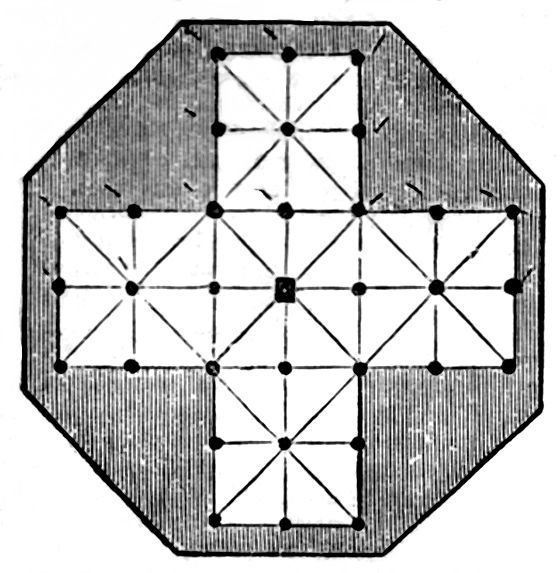
The men are divided into seventeen geese and one fox, the latter of which is distinguished by its size and colour. The men may be cut out of a piece of wood, and should be somewhat like the annexed figure and size. They may be turned for a few pence.

Instead of having a wooden board, the above figure may be drawn upon a piece of cardboard, and chequer or draught-men used instead of the others, distinguishing the fox by placing one man above the other, the same as a king in draughts.
Sometimes this game is played with sixteen men instead of eighteen—viz. fifteen geese and one fox.
When about to play, arrange the fox in the centre of the board, as indicated by the square black mark, and the geese at the stations or points marked thus ●; if seventeen men are used, the two extra geese must be placed in the two blank points—○.
The fox can move both ways, either backwards or forwards; the geese can only move forward, in the direction of the right lines; but they cannot pass over two spots at one time.
The object of the game is, for the geese to pen up the fox so that he cannot move, and for the fox to reduce the number of the geese by taking as many as he can, which he does by jumping over every one that has a point or hole before or behind him that is not filled up.
The geese cannot take the fox if he stands close to them; but the fox may always take the geese, provided there is a blank point before or behind it, as described above.
Neither fox or geese can move more than from one point to another at a time, unless previously agreed upon, and they must always keep along the line.
If a skilful player has the geese, the fox is almost sure to be penned up, and therefore the fox should not be too hasty in his moves.
GLASS (TO JOIN). Melt a little isinglass in spirits of wine, and add a small quantity of water. Warm the mixture gently over a moderate fire. When mixed, by thoroughly melting it will form glue perfectly transparent, and which will reunite broken glass so nicely and firmly that the joining will scarcely be perceptible to the most critical eye. Lime mixed with the white of an egg forms a very strong cement for glass, porcelain, &c., but it must be done neatly, as, when hard, the superfluous part cannot easily be smoothed or taken off.
FEATHERS (TO DYE BLUE.) The feathers must be first well washed in soap and water, then exposed to the air for several days. Lastly, after being well rinsed in pure warm water, they must be dipped in hot alum-water. A solution of indigo composition, commonly called chemic blue, having been prepared, the feathers are to be dipped therein. The immersion in alum-water, and in the dye-water, to be alternately performed till the requisite shade is obtained.
VARNISH (TO COLOUR BASKETS AND OLD STRAW HATS.) Take either red or black sealing wax; to every two ounces of sealing wax add one ounce of rectified spirits of wine; pound the wax fine, then sift it through a fine lawn sieve till you have made it extremely fine; put it into a large phial with the spirits of wine; shake it; let it stand near the fire forty-eight hours, shaking it often; then with a brush (a hogs-bristle brush) lay it all over the baskets. Let it dry, and repeat the application a second time.
BRONZING. Bronze of a good colour acquires by oxidation a fine green tint, called patina antiqua. Corinthian brass receives in this way a beautiful clear green colour. This appearance is imitated by an artificial process called bronzing. A solution of sal-ammoniac and salt of sorrel in vinegar is used for bronzing metals. Any number of layers may be applied, and the shade becomes deeper in proportion to the number applied. For bronzing sculptures of wood, plaster figures, &c., a composition of yellow ochre, Prussian blue, and lamp-black, dissolved in glue-water, is employed.
SHUTTLE. A piece of wood which in weaving passes a cross thread through the warp.

GLUE (RICE). Mix together rice-flour and cold water to a thick paste, pressing out all the lumps with a spoon, and making it very smooth. Then dilute it with a little more water (altogether, you may allow a gill of water to a tablespoonful of rice-flour), and boil it slowly as long as you would boil starch, stirring it frequently. When done, set it to cool. Use it for pasting fine paper, and for any little ornamental articles made of pasteboard. It is a very nice and durable cement. The water in which rice has been boiled for the table will afford a cement for slight purposes.
BIRTHS (REGISTRATION OF). The act requires that the father or mother of every child born in England (or, in case of the death, illness, absence, or inability of the father and mother, the occupier of the house in which they reside), shall, within forty-two days next after the day of such birth, give information to the registrar of the parish where the child was born, without the payment of any fee, providing it is done within forty-two days; but if it is neglected after that period, it can be registered within six months of the birth, by the payment of 7s. 6d.; after six months, it cannot be registered at all.
FRUIT (TO PACK FOR CARRIAGES). If fruit is to be sent to any considerable distance, great care should be taken in packing it: it should not be done in baskets, as they are liable to be bruised among heavy luggage, and the fruit of course will be impaired. Forsyth, therefore, recommends boxes made of strong deal, of different sizes, according to the quantity of fruit to be packed. In packing, proceed thus:—First put a layer of fine, long, dry moss in the bottom of the tin box, then a layer of currants or cherries, then another layer of moss, and so on alternately fruit and moss, until the box is so full that when the lid is hasped down the fruit may be so firmly packed as to preserve them from friction. Then make a layer of fine moss and short, soft, dry grass, well mixed, in the bottom of the deal box; pack in the melons with some of the same, tight in between all the rows, and also between the melons in the same row, till the layer is finished; choosing the fruit as nearly of a size as possible, filling up every interstice with the moss and grass. When the melons are packed, put a thin layer of moss and grass over them, upon which place the tin box with the currants, packing it firmly all round with moss to prevent it from shaking; then put a thin layer of moss over the box, and pack the pears firmly (but so as not to bruise them) on that layer, in the same manner as the melons; and so on with the peaches, nectarines, plums, and lastly the grapes, filling up the box with moss, that the lid may shut down so light as to prevent any friction among the fruit. The boxes should have locks, and two keys which may serve for them all: each of the persons who pack and unpack the fruit having a key. The moss and grass should always be returned in the boxes, which, with a little addition, will serve the whole season, being shaken up and well aired after each journey, and keeping it sweet and clean. After the wooden box is locked, cord it firmly. If fruit be packed according to the above directions, it may be sent to the farthest parts of the kingdom with perfect safety.
TORTOISE. A very harmless animal, with a shelly covering, which sleeps through the winter, and lives to a great age. Its flesh is eaten in the West Indies, and its covering serves for ornaments.
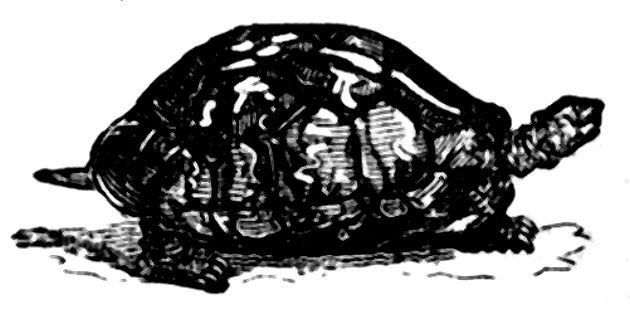
DIAPHANIE. This beautiful art is so simple in its elements that it will not take much space to initiate the reader into its mysteries. The principal purposes to which it is applicable are for the decoration of hall windows, churches, lamp-shades, stair-cases, hand-screens, windows, and window-blinds, Chinese lanterns, and conservatories; but it is equally available for every purpose in which the combination of transparency and ornament enter. Although the chief features of this art are the decoration of glass to the resemblance of stained windows and painted transparencies, it may be used for the adornment of window-blinds, &c., upon muslin or silk.
The materials are glass, muslin or silk, a roller, brushes, designs, one bottle of clearing liquid, prepared gum, and a bottle of washable varnish.
Be sure that the glass is free from imperfections, such as specks or bubbles, and scrupulously cleansed. Of course, if it is already fixed in window-frames, you must take it as you find it. Muslin for pictures is preferable to silk, for its cheapness and possession of great transparency. Whichever may be chosen, observe that it must be tightly stretched upon a frame, and that the muslin be free from coarse threads. Much of the beauty of the work depends on the careful selection of the designs. In experiments, choose a simple design, the subject of which must be left to the fancy of the person engaged in the work. The brushes (hog’s hair) will be sufficient for the application of the varnish and cement. Starch, mixed with cold water, and boiled, is the best cement that can be used to make the designs adhere to the glass; but gum or size will do, if more convenient. The cement must be thinly laid on. The washable varnish renders the picture easy to clean, and the clearing liquid is used to destroy the opacity of the paper. It must be applied to the blank side of the picture.
Lay the glass flat upon a folded cloth; then cut out the subjects, and placing them upon the blank side of the grounding paper, (the plain side upwards), trace the outline by rubbing on with the finger a small quantity of blacklead; after this, cut the paper so that the subject may clearly fit it. Much care must be exercised in these operations. The next process in order will be the fastening of the papers on glass. This is done with a sponge and water; the uncoloured part of the paper must be made quite damp; then put on the glass and the printed sides a thin coating of the cement. Take care that no air-bubbles remain between the glass and print, and also observe that the papers must be kept damp while the operation is carried on; for, if the cement is allowed to dry, it will destroy the transparency when the clearing liquid is used.
The cement requires about six hours to dry, when two coatings of the liquid should be applied to the back of the print.
As a remedy, if it is not clear, rub on an additional supply of clearing liquid on the opaque parts. Let the glass remain for twelve hours, that the paper may dry, after which apply the washable varnish. There are other methods, but they are somewhat inferior.
After stretching the muslin or silk tightly on a frame, take the sheets, laying the plain sides upwards to receive the clearing liquid, which put on with a brush, and when dry, give it another coating. A coating of cement will now be necessary to apply to the coloured side of the paper, taking great care to press it equally with the roller. There is now nothing left to the completion of the transparency but to varnish it. If the picture be misty, again use the clearing liquid.
Painting upon Glass or Muslin. For this purpose you will require the following colours:—Raw and burnt sienna, brown pink, Prussian blue, yellow lake, crimson lake, rose madder, French ultramarine, ivory black, burnt umber, gamboge, verdigris. In using these colours, should they work stiffly, work a little turpentine with them. If your painting is on glass, after laying it flat on the print you have chosen to copy, with ivory black and a fine sable-pencil trace the outlines, and after it is dry, let the colouring commence. There is but little difference in the operations of painting on glass or muslin. The latter material should have a coating of parchment size after it has been tightly stretched; but the process of colouring is precisely the same as in the process on glass.
Painting Glass and Muslin in Water-Colours. The same colours are used as those previously enumerated, omitting the verdigris. First, see that the glass is free from grease, and if not, wash it with a little gall. If the operations are to be on muslin, better apply a thin coating of size before working. Add a little gall to your cake colours after they are diluted with water on the slab, and then proceed as in oil colour. Between each layer of colour, as water-colours quickly dry, give the glass a coating of mastic varnish. After the outline is complete, the glass should be placed on a frame, and supported on both sides by an upright piece of wood. The colours may be heightened by applying others of the same tint; and, for the sake of durability, a second sheet of glass should be placed over the work in all departments of this art.
For using ordinary Engravings on Glass. The paper they are printed on should contain no size. Damp the plain side of the picture with a sponge, and apply to the other a coating of washable varnish; then warm the glass, lay on the print, press with the roller, and place it at some distance from the fire to dry. The next process requires great care, or the beauty of the engraving will be injured. Damp the print again with water, and rub off the superfluous paper; after this, and when the miniature has been absorbed, apply the clearing liquid with a camel-hairbrush. When it is thoroughly hardened, the washable varnish can be applied, and the work is finished.
Imitation of Ground Glass may be effected by taking equal quantities of ground white lead and sacrum, and mixing with one part of boiled oil and two of turpentine, slightly tinted with yellow or blue. When this is done, take a painter’s clean duster, and gently dab with the ends of the hair, until the work has assumed the uniformity of appearance necessary to its perfection.
STAINS (TO REMOVE FROM THE HANDS). Damp the hands first with water, then rub them with tartaric acid, or salt of lemons, as you would with soap; rinse them, and rub them dry. Tartaric acid or salt of lemons will quickly remove stains from white muslin or linens. Put less than half a teaspoonful of the salt or acid into a tablespoonful of water; wet the stain with it, and lay it in the sun for at least an hour; wet it once or twice with cold water during the time. If this does not quite remove it, repeat the acid-water, and lay it again in the sun.
SHAVING SOAP. Good white soap (in thin shavings), three pounds; palm soap, one pound; soft water, three quarters of a pound; soda, one ounce. Melt carefully over a slow fire, in an earthen vessel; then add oil of lavender sixty drops, oil of lemon forty drops; bergamot, fifty drops. Mix well and make it into forms.
MAHOGANY (ARTIFICIAL). The following method of giving any species of wood of a close grain the appearance of mahogany in texture, density, and polish, is said to be practised in France with success. The surface is planed smooth, and the wood is then rubbed with a solution of nitrous acid; one ounce of dragon’s blood is dissolved in nearly a pint of spirits of wine; this, and one-third of an ounce of carbonate of soda, are then to be mixed together and filtered, and the liquid in this thin state is to be laid on with a soft brush. This process is to be repeated, and in a short interval afterwards the wood possesses the external appearance of mahogany. When the polish diminishes in brilliancy, it may be restored by the use of a little cold-drawn linseed oil.
GRATE PAPER (ORNAMENTAL). The accompanying illustration (See next page), when drawn upon paper and cut out, will require some amount of patience and perseverance; but the paper, when completed, will amply repay the operator for all the trouble, as it is extremely elegant, and at the same time inexpensive.
The materials required for each paper are, two sheets of white tissue-paper, and some paste or mucilage.
The instruments required are, a sharp pair of fine-pointed scissors, a lead pencil (F, or FF), needle and sewing cotton, and a circular punch (o).
To prepare the materials, take two large sheets of tissue-paper, and paste or gum them very neatly together by their longest sides, so as to form a large sheet.
When dry, fold the paper in the centre, and double it again; mark off the exact distance of each bar or pattern with a pencil, and rule the paper according to the design given; then tack it along the spaces between each bar, so as to prevent it moving during the process of cutting out. Sketch the design according to pattern or taste, and then proceed to cut out all the shaded parts with a sharp pair of scissors, taking care not to sever the connecting pieces; but if they should be divided by accident, the two parts must be neatly joined with a little gum or paste and tissue-paper.
In marking off the design, it may be some guide to our readers to inform them of the dimensions of each part of a paper according to the accompanying design.
When the paper is folded and tacked—
| No. | 1 should measure | 6 | ½ | in. long and | 2 | in. | wide | |
| No.„ | 2 | 9 | 4 | ½ | wide„ | |||
| No.„ | 3 | 11 | ½ | 2 | ¾ | wide„ | ||
| No.„ | 4 | 15 | 3 | ¼ | wide„ | |||
| No.„ | 5 | 15 | ¾ | ½ | wide„ | |||
| No.„ | 6 | 17 | ¼ | 1 | ½ | wide„ | ||
| No.„ | 7 | 17 | ¾ | ½ | wide„ | |||
| No.„ | 8 | 19 | ¾ | 2 | wide„ |
When all the shaded parts have been cut out, and the design finished by punching the parts that require it in Nos. 5, 6, 7, and 8, the basting-threads must be removed, the paper carefully opened out; and, the top being neatly tied with a piece of thread, the ornament should be suspended to a nail driven in the chimney, hung over a piece of wood like a cross, and placed over a heap of faded grate shavings, or thrown over a stiff sheet of dark-coloured paper arranged on purpose.
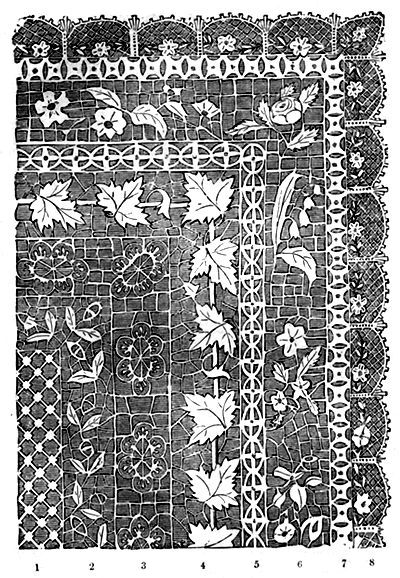
MUSICAL INSTRUMENTS (TO STAIN). Crimson—Boil one pound of ground Brazil-wood in three quarts of water for an hour; strain it, and add half an ounce of cochineal; boil it again for half an hour gently, and it will be fit for use. Purple—Boil a pound of chip logwood in three quarts of water for an hour; then add four ounces of alum.
TIVOLI, OR CHINESE BILLIARDS. This is a very interesting game, and is easily played. The board with which you play varies in length from 2 feet 6 inches to 4 feet or upwards, and is shaped as shown in the accompanying figure.
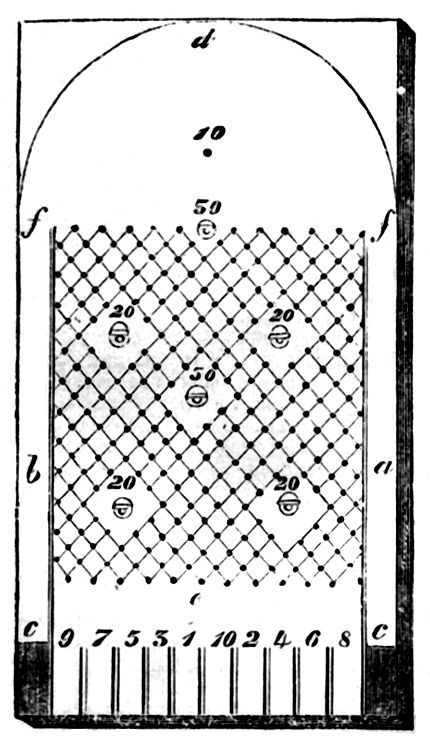
It may be easily made by any ingenious person, by attending to the following directions: partition off a space on each side of the board (a b) sufficiently wide for the marble or ball with which you play to run freely along. Place a piece of wood, about 3½ inches in length, at the lower end of each passage (c), and fix it at an angle of about ten degrees. Divide the space between the two passages at the lower end (e) into ten compartments, and paint a number before each, in the order observed in the figure. Six spaces are to be left in the board for the marbles or balls to drop into, and these are to have a central portion sunk in the board (as c in the annexed figure), into which the marble or ball (b) drops; a wire (a) is bent over the circle so as to form an arch, and proper numbers are to be painted before each, as shown in the figure.
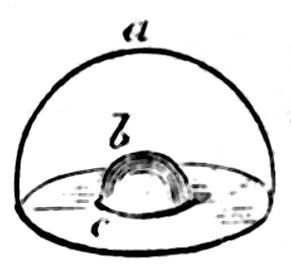
A small dent is to be made in the board, midway between the 30 resting-point and the arch of the board, and 10 painted in front of it. The space between the two passages (a b) must be ruled into a diamond-shaped pattern, as seen in the figure, each diamond measuring one inch on all its sides; and when this is done the lines must be painted black, and a thick pin driven into each of its angles (indicated by a dot in the figure). It now only remains to finish the board by affixing a thin piece of wood (d), which extends from f to f; and to provide two balls or marbles, one dark and the other white; and two small cues, or tapered sticks, with which the game is played.
Before the game is commenced, the upper end (d) of the board must be slightly elevated (about two inches) from the table.
RULES.
1. Any number of persons may play, and if more than two, sides, or partners, are to be chosen.
2. The number of the game is previously agreed upon by the players, being sometimes fixed as low as 2,000, or at 10,000, or 30,000.
3. The dark ball counts ten times the number into which it falls. For example: if it lodges in 50 cup it counts 500, and so on.
4. The white ball only marks those numbers into which it falls.
5. If a ball lodges against a pin, the player striking the ball does not mark any thing.
6. If a ball makes the circuit of the board, that is, from c on one side to c on the other, the player loses 10.
7. If a ball is not struck with sufficient force, so that, instead of leaving the passage, it returns again to the starting point, c, the player loses 10.
8. The choice of first player is decided by the highest number obtained by the first throw, the winner to have the option of scoring the number.
9. The player who obtains the highest number first, wins the game.
TRANSFER PAPER (TO MAKE). 1. Take starch, 6 ounces; gum arabic, 2 ounces; alum, 1 ounce. Make a strong solution of each separately in hot water. Mix, and apply it to one side of the leaves of paper while warm, by means of a clean painting-brush: and when dry, a second and a third coat may be given; lastly, press it, to make it smooth.
2. Give the paper three coats of thin size, one coat of good white starch, and one coat of a solution of gamboge in water: the whole to be applied with a sponge, and each coat to be allowed to dry before the other is applied. The whole of the solutions to be fresh made.
3. (M. Bregeaut’s recipe). Take of starch, 2 drachms; gum arabic in powder, 2 scruples; alum, 10 grains; yellow berries pounded, 10 grains. Some hours previous to making the transfer-paper, put the gum to dissolve in water; dissolve the alum separately, and make the starch rather thin, then add successively the gum and the alum, stirring well. Boil the berries well in water, strain, and add the residue to the mixture. Apply the mixture warm to the paper (which should be unsized), by means of a flat brush: when a sufficient coating is given, the paper must be either glazed, or run through the press, the yellow face downwards, on a clean lithographic stone.
Before writing, the paper must be rubbed with some powdered gum-sandarach, to prevent the ink spreading; afterwards wipe it off with a hare’s-foot. If you have any difficulty in using the steel pen, use a crow-quill or common quill.
WHITE HOUSE-PAINT (TO MAKE ECONOMICAL). Skim-milk, two quarts; fresh slaked lime, eight ounces; linseed oil, six ounces; white burgundy pitch, two ounces; Spanish white, three pounds. The lime to be slaked in water, exposed to the air, mixed in about one-fourth of the milk; the oil in which the pitch is previously dissolved to be added a little at a time; then the rest of the milk, and afterwards the Spanish white. This quantity is sufficient for twenty-seven square yards, two coats, and the expense not more than tenpence.
TORTOISESHELL (TO MEND). Bring the edges of the pieces to fit each other, observing to give the same inclination of grain to each; then secure them in a piece of paper, and place them between hot irons or pincers; apply pressure, and let them cool. Take care that the heat is not too great, or it will burn the shell.
TULIP (CULTIVATION OF THE). The tulip is a native of Persia, and was first introduced into Europe at Constantinople, where it was, and still is, a great favourite with the worshippers of Allah. In 1554, Auger Gislem Busbec, better known as Busbequis, being at the Porte as ambassador from Ferdinand I., Emperor of Germany, procured some seeds and bulbs, which he transmitted to Vienna, with the remark that “the Turks charged a high price for them.” Several amusing stories are related about these bulbs; how they were at first eaten as onions, but found unpalatable; how they were then made into a conserve with sugar, but their flavour not improved; and how, at last, being thrown out on a manure-heap, as worthless, a few bloomed, revealing the true use of the plant. This was its first introduction into Western Europe.
In the first half of the seventeenth century occurred that remarkable historical episode, the “tulipomania.” It commenced in Holland, from thence it spread to France; and, no doubt, would have invaded England if the inhabitants of this country had not been fully engaged with the more sanguinary mania of civil war.
The peculiar habit of the tulip not permitting it to be freely and quickly propagated, is no doubt the reason why some particular varieties have been so highly esteemed. From the time of sowing the seed, five years at least must elapse before the flower appears, and this first bloom is almost invariably a self, or mere ground colour. In this state the plant is termed a breeder; and when in the course of a few years, more or less, the petals become striped and variegated, it is then termed broken.
There are two species of tulips extensively cultivated in England—the earliest of which is the Van Thol. The late-flowering variety is the garden tulip—the T. Gesneriana, the prize flower, and tulip par excellence. English florists divide this species into three classes, viz., roses, byblomens, and bizarres. The roses are marked by crimson, pink, scarlet, or cherry-colour, on a white ground. The byblomens are marked with black, lilac, or purple on a white ground. The bizarres are marked with purple or red, on a yellow ground. These classes are still further divided into flamed and feathered. A flamed tulip is one that has a dark-pointed spot, somewhat in shape like the flame of a candle, in the centre of each sepal. Though it has become almost conventional among amateurs and gardeners to speak, and write too, of a tulip’s petal, yet the word is a gross botanical misnomer. A tulip has neither corolla nor petal, but merely a calyx of coloured sepals. A feathered tulip has a dark-coloured edge round it, gradually becoming lighter on the margin next the centre of the sepal; the feathering is said to be light, if narrow; heavy, if broad; and irregular, if its inner edge has a broken outline. In some instances a tulip may be both feathered and flamed.
To display tulips to the best advantage, they must be grown in beds, situated in an open, airy part of the garden. The exact size of a bed is, as the reader will presently see, easily determined by the number of plants it is intended to contain. The required dimensions being marked out, the soil should be removed to the depth of twenty inches; and a layer of sound fresh loam, ten inches thick, placed in the bottom of the excavation. Over the loam must be laid twelve inches in depth of thoroughly rotten two-year-old cow manure; and over this last, another layer of loam, two inches deep at the sides and three in the centre, thus leaving the surface slightly convex. The bed should be prepared in the beginning of October, so as to allow it to settle before the time of planting, which is from the first to the tenth of November; and at this time the bed will be about two inches higher than the circumjacent walks.
Mr. Groom, of Clapham, one of the first tulip-growers in the world, and who, no doubt, possesses the best collection extant—the Dutch having completely lost their pre-eminence in the finer varieties—cultivates these plants in beds of four feet in width. When the bed is ready to receive the bulbs, its surface is brought to an accurate convex curve, by means of a piece of board, in the required form, termed a strike. This being done, the places of each and every bulb are exactly marked by the same implement, which is divided into eight spaces of six inches each. On the flat side of the strike, at the marks between the spaces, are small staples which receive seven small pegs; these, when the strike is laid across the bed, mark the places for one row of bulbs. From this first row, which is six inches from one end of the bed, six inches are measured at each side, and the strike being again laid over the bed at the termination of these measurements, gives the places of the plants in the next row—the same method being continued till every place is accurately determined. From the foregoing, it will be seen that there are seven bulbs in each row across the bed; that each bulb is six inches apart, every way, from another; and that the side and end ones are six inches from the edge of the bed—the length of the bed depending upon the number of bulbs the grower possesses, or chooses to plant in it; a bed twenty-five feet in length is said to have the most brilliant effect. The places for the bulbs having been thus found, a little clean sand should be sprinkled on each position, the bulb placed on it, and a little very sandy earth put over, so as to envelope each bulb in a cone. The bed should then be covered with a sound, fresh loam, and the surface smoothed off with the back of the strike, which for this purpose is formed with a curve and shoulders; the former taking in the breadth of the bed, while the latter slides against boards placed at each side; the whole moved onwards, takes off the redundant soil, leaving the surface regularly rounded, the centre being six inches higher than at the sides. The tallest-growing flowers must be placed in the centre; the nearest in size next, and so decreasing; in height, the shortest are placed at the sides. The convexity of surface permits the bulbs to be covered with a depth of soil proportionate to the size of the plant. No tulip bulb, however strong the plant may be, should be covered by more than four inches of soil, measuring from its upper part; nor should it be buried less than two inches, however small or weak it may be.
It is a most important object to arrange the bulbs in the bed, so that when in bloom the plants will make the greatest possible display.
If symptoms of frost appear after the bulbs are planted, the bed must be covered with fern, straw, or other similar protection; for though the tulip can scarcely be destroyed by the most rigorous frost known in this climate, yet a short exposure to even a slight congelation will injure the bulb, and its effects will be plainly apparent in the blooming season by the split discoloured sepals, and other imperfections of the flower. When the plants appear above ground, the protecting material must be removed, the surface of the soil slightly stirred, and a covering of hoops and mats, or waterproof transparent cloth, which is much better, placed over the bed, as heavy rain, hail, or frost, are equally injurious; air and light, however, must be freely admitted on all favourable occasions. In March, the bed should be again stirred, and the soil drawn close to the stems of the plants. The covering should be removed on fine days only, until about the latter end of April, when it must be taken away altogether to make room for the top-cloth or awning, which should then be erected over the bed. A cheap and simple awning, consisting of a few uprights and rafters, and a piece of canvas, may be erected by any one possessing the minutest development of the organ of constructiveness; the subjoined figure, which we trust requires but little explanation, is intended to represent.
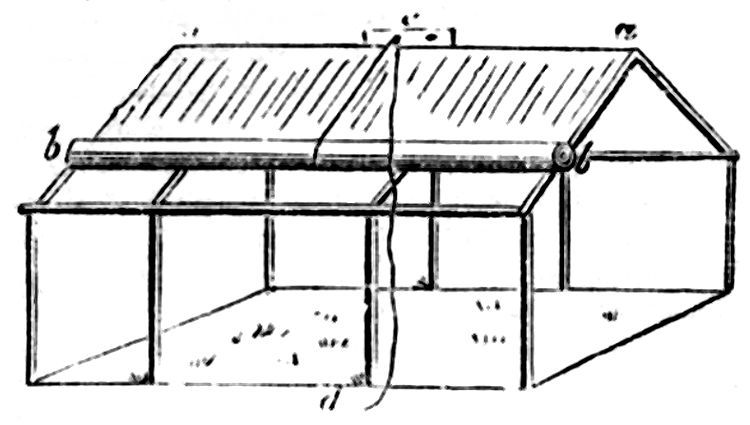
An Economical Awning.
The canvas is fastened along the ridge a a, and should be long enough to reach down to the ground. A roller, b b, is fixed to the lower edge of the canvas, and a cord attached to the ridge is brought down under the canvas, round the roller, and up over the canvas to a pulley at c; so that by pulling or slackening the cord d, the canvas is rolled up or let down. On the other side of the frame there is also another cord, canvas, roller, and pulley, used in the same manner, and for the same purpose. The blooming season draws on apace in May, and from the moment that the flowers commence to show colour, neither sunshine nor rain must be allowed to fall upon them. Still, a free circulation of air must be constantly kept up, and therefore the canvas should not be let down close to the ground except in windy weather, which is exceedingly prejudicial to the flowers; then the canvas should be let down close on the windy side. If any bulbs have perished, or failed to produce bloom—a great eyesore in a bed—the deficiency may be supplied by transplanting others with the transplanter (see p. 153).
During the time that the flowers are in bloom, each one should be particularly examined, tulip-book in hand, and memoranda made according to their individual and general appearance. As soon as the bloom commences to fade, the awning should be removed, and the plants exposed to the full influence of the sun and air. When the sepals drop, the seed-pods should be picked on; and about the end of June, or beginning of July, when the foliage has turned yellow and shrivelled, the bulbs may be taken up, the offsets separated from them, and the stems cut off with a sharp knife, about half an inch from the bulbs, and the latter put in drawers placed in the shade, there to dry and harden.
In August the bulbs should be cleaned free from dirt; their skins and the bit of stem adhering to them taken away: each one placed in its own division of the drawer, and the drawers placed in the cabinet. About this time, too, the compost should be thrown out of the bed, and the fresh compost for next season carefully turned over and searched, for those destructive pests, the wire-worm and grub. In September, the bed may be planned and arranged in the drawers. In October the offsets should be planted out in the reserve garden. Choose a dry, airy situation; the soil should be fresh sandy loam, with a little rotten cow manure, placed from seven to twelve inches beneath the surface. The beds should be raised six or eight inches above the alleys, formed rather convex on the surface, and provided with hoops and mats, to use as occasion may require, as protection from heavy rains, hail, and frost. Tulips never require to be artificially watered, even in the driest seasons, at any period from planting to taking up. At the same time moderate, gentle showers in spring, before the flowers appear, are most beneficial to the plants, and at such times the covers should be removed.
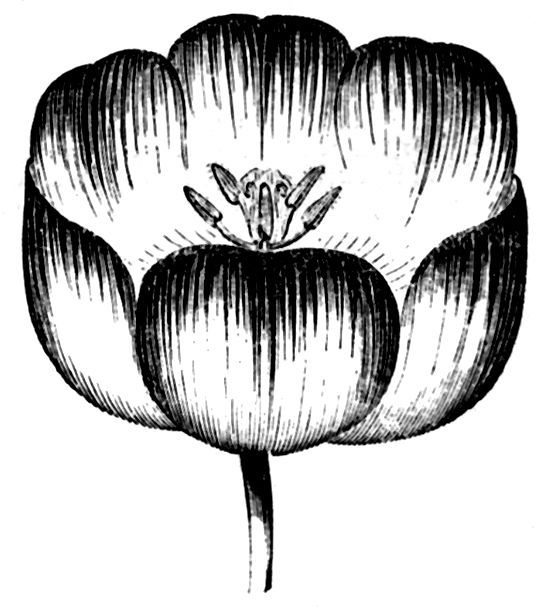
Tulipa Gesneriana, var.—Duke of Sutherland, (a Bizarre).
The tyro, when purchasing bulbs, should select those that have not lost the brown skin—are not mouldy nor soft at the root end, and are full, solid, and rather pointed at the other.
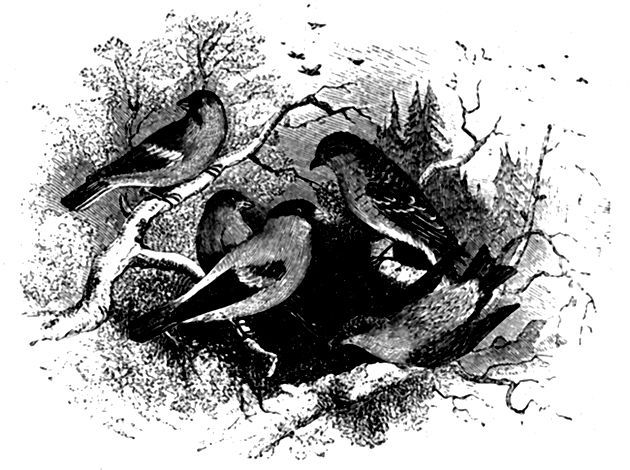
GROUP OF FINCHES.
BULLFINCH (THE). Bullfinches are permanent residents with us; not very plentiful in any locality. They may be round in most places where there are leafy coverts, and especially near fruit gardens, to which they do much mischief by picking the buds off the trees. The gardeners call them “pick-a-buds,” and wage a war of extermination against them. It should be remembered, however, that these birds are great insect-destroyers, and, perhaps, do as much good as harm. It is, indeed, contended by some authorities that every bud which they pick off envelopes a grub, that being the object sought for, and that alone eaten, and the vegetable covering rejected. We cannot say whether this be the case or not, but would fain give our friend “bully” the benefit of the doubt.
The bullfinch’s nest is sometimes found in the apple or some other fruit tree; it is usually at a considerable height from the ground. The young should be taken early, if they are to be taught to pipe, or imitate the songs of other birds. Just as the tail feathers begin to appear, that is, when they are about twelve or fourteen days old, is perhaps the best time. Bolton says much younger, but we think this injudicious, for several reasons. The best food for the young bird is crumbs of white bread, saturated with boiling milk, and mixed with an equal quantity of soaked and bruised rape seed. As they grow up, poppy and millet-seed, sprouting corn, lettuce and water-cresses, fruit and nuts, should be given them; they may also have, when fully grown, such food as they chiefly take when in a wild state—viz. fir and pine-seeds, most berries that have kernels, buds of the beech, maple, oak, and other trees, and seeds of the nettle, and any of the cruciform plants. The young males may be distinguished from the females by the red tinge on the breast; the latter can be taught to pipe, but never so easily and so well as the former, and they are never such handsome birds, being destitute of that beautiful carmine tint which gives such warmth and richness to the plumage of the cock bullfinch.
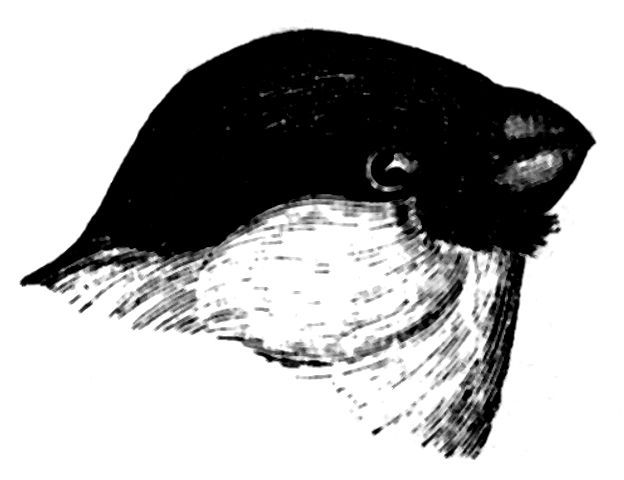
Bechstein advises that the young birds should have buckwheat grits, steeped in milk, and mixed with rape seed; and while recommending for the old ones hemp and rape seed, says that they live longest if fed on the latter only, with now and then a little plain biscuit, the former being so heating as sometimes to produce blindness, and bring on atrophy. If loose in the room or aviary, they will do very well on the food given to the other birds.
Grown bullfinches are easily caught by means of limed twigs, or a common trap. In spring they readily answer to the call of the decoy bird, or even a gentle “tui, tui!” uttered by the fowler. In autumn, wild berries will perhaps prove the most effectual bait. Birds thus caught are generally more healthy, and attain a greater age than those brought up in confinement, simply because they feed, when young, upon their natural food, and are not weakened by the bits of sugar and other delicacies usually given to feathered pets; under any circumstances, however, this does not appear to be a long-lived bird, eight years being the maximum age attained by the captive bullfinch, which more commonly does not live beyond six. Of course there are exceptions to this, as to all other rules, but they are few.
The chief maladies to which bullfinches are subjected are, constipation, dysentery, epilepsy, melancholy (or dejection). In this latter state, without exhibiting any particular marks of disease, they sit apart, mope, and refuse to sing; they should then be fed exclusively on steeped rape seed, all delicacies or exciting food being avoided; change of scene is good for them. When moulting, they should have a rusty nail in the water, and good nourishing food, including a few ant’s eggs, if they can be procured. The other maladies may be treated in the same way as directed for the canary. (See p. 94.)
CARVING. How often is a well-spread dinner disfigured by blundering awkward carving. It is a duty most shun, because most are unskilled in the art. Yet one of the most important acquisitions in the routine of daily life is the ability to carve well, and not only well but elegantly. It is true that the modes now adopted of sending meats, &c., to table, are fast banishing the necessity for promiscuous carving from the richly-served boards of the wealthy; but in the circles of middle life, where the refinements of cookery are not adopted, the utility of a skill in the use of a carving-knife is sufficiently obvious.
It must not be supposed that the necessity for this acquirement is confined to the heads of families alone; it is as important for the bachelor visitor to be familiar with the art as it is for the host himself; indeed, he is singled out usually for the task of carving a side dish, which happening to be poultry of some kind, becomes a task most embarrassing to him, if he should happen to be ignorant of the modus operandi of skilfully dissecting a fowl. Ladies ought especially to make carving a study; at their own houses, they grace the table, and should be enabled to perform the task allotted to them with sufficient skill to prevent remark, or the calling forth of eager proffers of assistance from good-natured visitors near, who probably could not present any better claim to a neat performance.
Carving presents no difficulties; it simply requires knowledge. All displays of exertion or violence are in very bad taste; for if not proving an evidence of the want of ability on the part of the carver, they present a very strong testimony of the toughness of a joint or the more than full age of a bird: in both cases they should be avoided. A good knife of moderate size, sufficient length of handle, and very sharp, is requisite; for a lady it should be light, and smaller than that used by gentlemen. Fowls are very easily carved; and joints, such as loins, breasts, fore-quarters, &c., the butcher should have strict injunctions to separate the joints well.
The dish upon which the article to be carved is placed should be conveniently near to the carver, so that he has full control over it; for if far off, nothing can prevent an ungracefulness of appearance.
FISH.
In serving fish, some nicety and care must be exercised; here lightness of hand and dexterity of management is necessary, and can only be acquired by practice. The flakes which, in such fish as salmon and cod, are large, should not be broken in serving, for the beauty of the fish is then destroyed, and the appetite for it injured. In addition to the skill in the use of the knife, there is also required another description of knowledge, and that is an acquaintance with the best parts of the joint, fowl, or fish being carved. Thus, in a haunch of venison, the fat, which is a favourite, must be served with each slice; in the shoulder of mutton there are some delicate cuts in the under part. The breast and wings are the best parts of a fowl; and the trail of a woodcock on a toast is the choicest part of the bird. In fish a part of the roe, melt, or liver should accompany the piece of fish served. The list, however, is too numerous to mention here; and, indeed, the knowledge can only be acquired by experience. In large establishments the gross dishes are carved at the buffet by the butler, but in middle society they are placed upon the table.
BOILED TONGUE.
Carve across the tongue, but do not cut through; keep the slices rather thin, and help the fat from underneath.
SUCKING PIG.
The cook should send a roast pig to table as displayed here, garnished with head and ears; carve the joints in the direction shown by the lines in the diagram, then divide the ribs, serve with plenty of sauce: should one of the joints be too much, it may be separated: bread sauce and stuffing should accompany it. An ear and the jaw are favourite parts with many people.
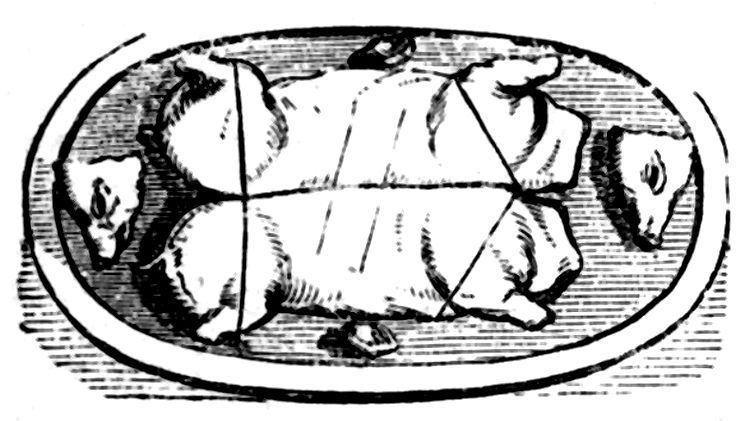
Remove the legs and shoulders, they very easily separate; divide the back into two parts, and by holding the fork firmly in the back, and passing the knife underneath near the middle, and bending it back, this is accomplished readily. The most tender part is on the loins, the meat there is of a very delicate flavour; liver should be helped with it.
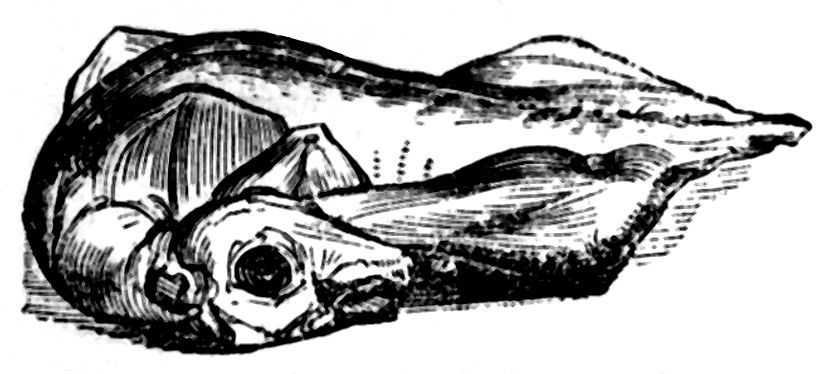
Poultry requires skilful carving; the requisites are grace of manner, ease in the performance, a perfect knowledge of the position of the joints, and the most complete mode of dissecting, so as to obtain the largest quantity of meat. In no case is the ability more demanded than in carving a roast turkey. Unless this is done well, there is not only much waste, but the appearance of the turkey is spoiled.
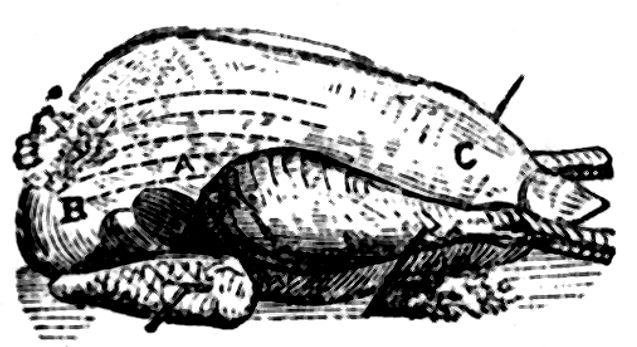
You will commence by carving slices from each side of the breast, in the same directions as the lines marked in the engraving, cutting from a to b. Now remove the legs, dividing the thighs from the drumsticks; and here an instrument termed a disjointer will be found serviceable, for unless the turkey be very young, and the union of the joints very accurately taken, dislocation becomes difficult: the disjointer effects the separation at once, and it possesses also the advantages of enabling the carver to divide a thigh into two, thus permitting a less bulky portion of a part much esteemed to be served. The pinions and that portion of the body removed with it are always a delicacy, and care should be taken to carve them nicely; the joint of the pinion will be found at B. The stuffing, whether truffles or whatever it may be made of, you will obtain by making an opening at c.
BOILED TURKEY.
Boiled turkey is trussed in a different fashion to the roast, but the same direction given for the first applies to the second. The legs in the boiled turkey being drawn into the body may cause some little difficulty at first in their separation, but a little practice will soon surmount it.
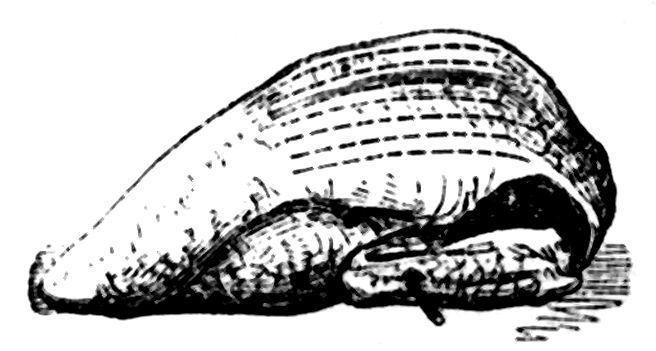
TURKEY POULTS.
Refer to directions for carving pheasants.
ROAST FOWL.
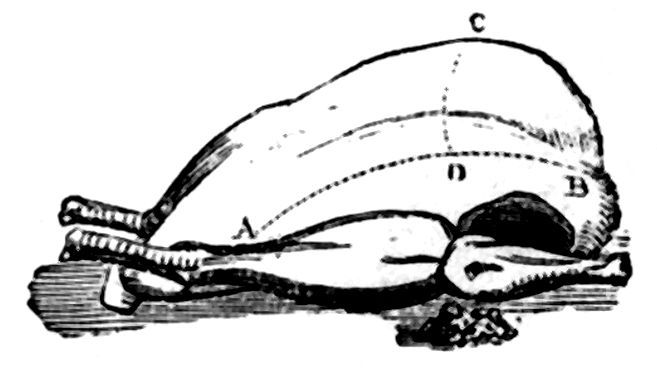
This operation is a nice and skilful one to perform; it requires both observation and practice. Insert the knife between the legs and the side, press back the leg with blade of the knife, and the joint will disclose itself: if young it will part, but at best, if judiciously managed, will require but a nick where the joints unite. Remove your wing from d to b; cut through and lay it back as with the leg, separating the joint with the edge of your knife; remove the merrythought and neck-bones next; this you will accomplish by inserting the knife and forcing it under the bones, raise it, and it will readily separate from the breast. You will divide the breast from the body by cutting through the small ribs down to the vent, turn the back uppermost; now put your knife into about the centre between the neck and rump, raise the lower part firmly yet gently, it will easily separate; turn the neck or rump from you, take off the side bones, and the fowl is carved.
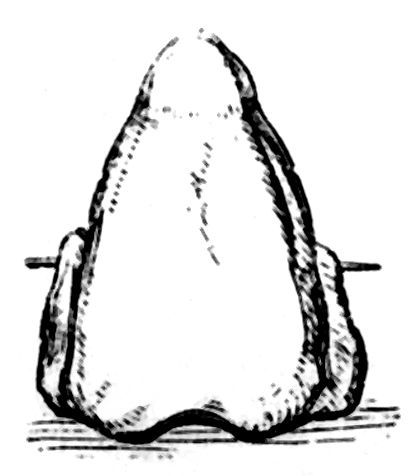
boiled fowl (breast).
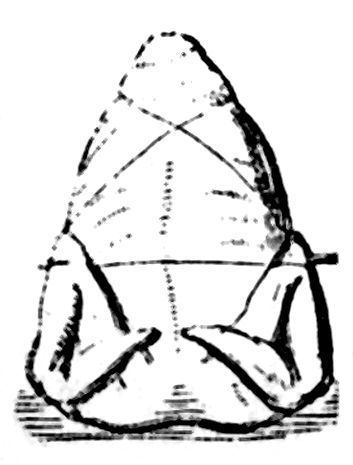
boiled fowl (back).
In separating the thigh from the drumstick, you must insert the knife exactly at the joint we have indicated in the engraving; this however will be found to require practice, for the joint must be accurately hit, or else much difficulty will be experienced in getting the parts asunder.
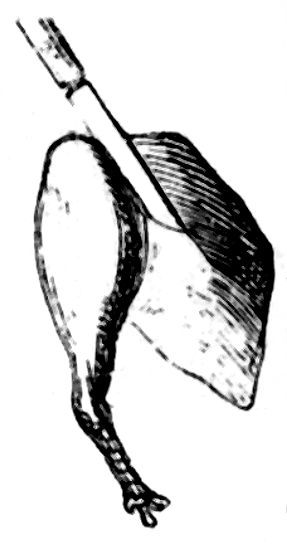
There is no difference in carving roast and boiled fowls, if full-grown; but in a very young fowl, when roasted, the breast is served whole. The wings and breast are in the highest favour, but the leg of a young fowl is an excellent part. Capons, when very fine and roasted, should have slices carved from the breast.
ROAST GOOSE.
Follow with your knife the lines marked in the engraving, a to b, and cut slices; then remove the wing, and if the party be large, the legs must also be removed; and here the disjointer will again prove serviceable. The stuffing, as in the turkey, will be obtained by making an insertion at the apron c.
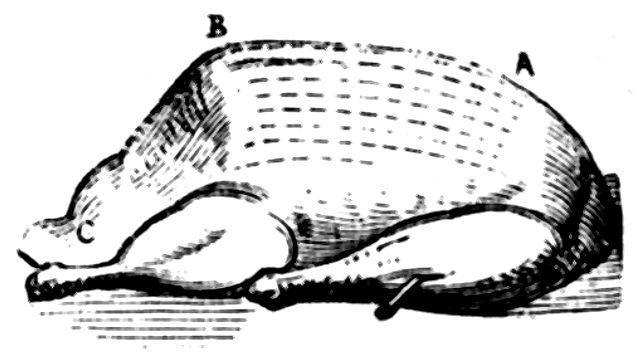
PHEASANT.
Clear the leg by inserting the edge of the knife between it and the body, then take off the wings, b to a, but do not remove much of the breast with them; you are thus enabled to obtain some nice slices; the pheasant is then carved, as a fowl. The breast is first in estimation, then the wings, and after these the merrythought; lovers of game prefer a leg.
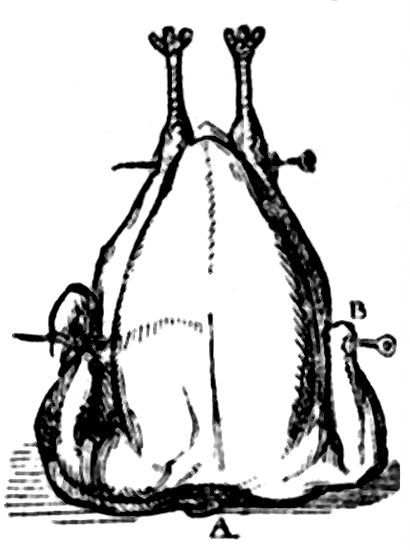
Guinea Fowl are carved in the same manner.
PARTRIDGE.
Separate the legs, and then divide the bird into three parts, leaving each leg and wing together. The breast is then divided from the back, and helped whole, the latter being assisted with any of the other parts. When the party consists entirely of gentlemen, the bird is divided into two by cutting right through from the vent to the neck.
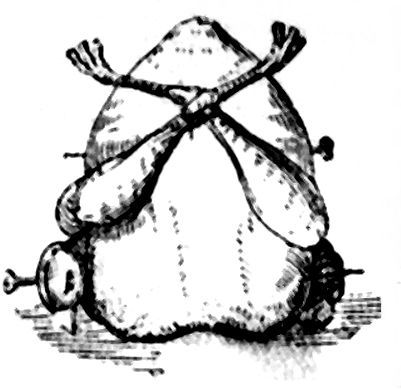
Quails, Landrail, Wheatears, Larks, and all small birds are served whole.
Grouse and Plover are carved as partridges.
Snipe and Woodcock are divided into two parts; the trail being served on toast.
Wild Duck and Widgeon. The breast of these fowls being the best portion is carved in slices, which being removed, a glass of old port, made hot, is poured in; the half of a lemon seasoned with cayenne and salt should then be squeezed in, the slices relaid in their places, and then served, the joints being removed the same as in other fowl.
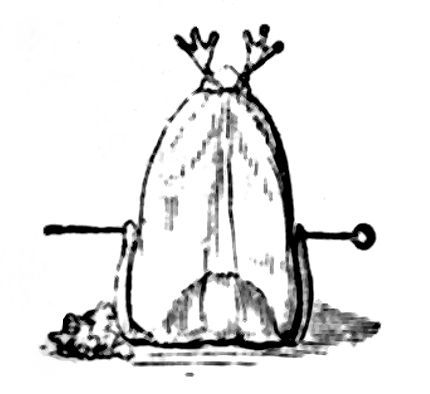
pigeon (breast).
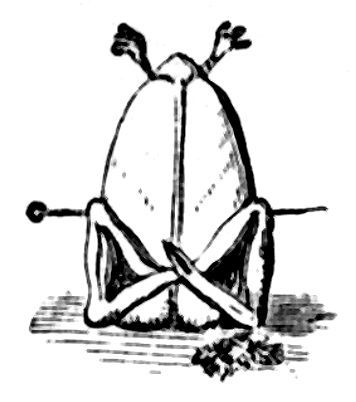
(pigeon back)
Like Woodcock, these birds are cut in half, through the breast and back, and helped.
Trussing.—Run a skewer through the two shoulders, at 2; another through the head at 1, or pass it into the mouth and through the body, to keep the head in its place; two others should be passed through the roots of the ears, to keep them erect; and another through the legs at 3. The inside of the ears should be singed out with a hot poker before roasting, and the eyes extracted with a fork. Many people let a hare soak in cold water all night before trussing, but a few hours is quite sufficient to extract the blood.
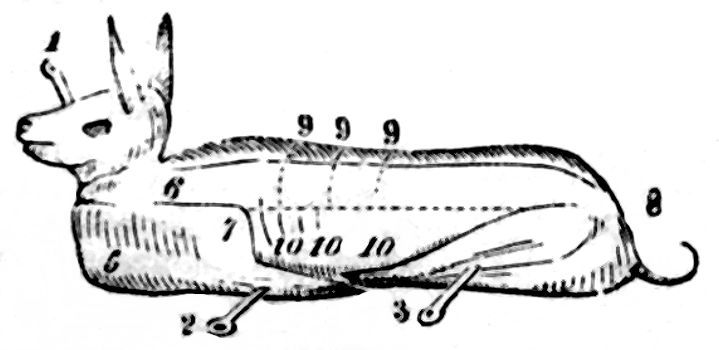
Carving.—Insert the point of the knife inside the shoulder at 6, and divide all the way down to the rump, on both sides, in the line 6, 7, 8, which will separate the hare into three pieces. Sever the shoulders in the direction of 5, 6, 7, and the legs in a similar manner; as the latter is too large for one person in a large hare, it should be divided from the thigh. Now behead it, cut off the ears close to the roots, and divide the upper from the lower jaw; then place the former on a plate, put the point of the knife into the forehead, and divide it through the centre down to the nose. Cut the back into several small pieces in the lines 9—10, and proceed to assist, giving some stuffing (which is found below 10) and gravy to each person. This can only be done easily when the animal is young; if old, it must be cut up as follows: Cut off the legs and shoulders first, and then cut out long narrow slices on each side of the back-bone in the direction 7-8; then divide the back-bone into three or more parts, and behead the hare as usual. The prime parts are the back and legs; the ears are considered a luxury by some, and so are the head, brains, and bloody parts of the neck. The best part of the leg is the fleshy part of the thigh at 8.
RABBITS.
Whether for roasting or boiling, are trussed and cut up the same as a hare, except that the back is divided into two or three parts, without separating it from the belly. The best parts are the shoulders and back; the head should not be given unless asked for.
In conclusion, we may observe, that all printed directions must fail without constant practice; yet, with practice, and due attention to the rules we have laid down, we doubt not that many of our readers will speedily become good carvers.
NUTRITIOUS FOOD. The following statement shows the proportion of nutriment contained in various articles of food:—Greens and turnips contain 8 lbs. in the 100: carrots, 14 lbs. in the 100; potatoes, 25 lbs. in the 100; butcher’s meat sorted, about 35 lbs. in the 100; wheaten bread, 85 lbs. in the 100; broad beans, 89 lbs. in the 100; peas, 92 lbs. in the 100; lentils, 94 lbs. in the 100; French beans in grain, from 92 to 94 lbs.
GALL-NUTS. The gall-nuts used in making ink are produced by the insect which punctures the leaves of a species of oak very common in Asia Minor, where they are collected in considerable quantities by the poorer inhabitants; from the different ports of the Levant they are exported to various parts of the world. The galls held in the greatest estimation are those known in commerce under the name of blue galls. These are the produce of the first gathering, before the fly has issued from the gall.
BIRDS (RAPID FLIGHT OF). A vulture can fly at the rate of 150 miles an hour. Observations made on the coast of Labrador convinced Major Cartwright that wild geese could travel at the rate of 90 miles an hour. The common crow can fly 25 miles; and swallows, according to Spallanzi, 92 miles an hour. It is said that a falcon was discovered at Malta twenty-four hours after the departure of Henry IV. from Fontainebleau. If true, this bird must have flown for 24 hours at the rate of 57 miles an hour, not allowing him to rest a moment during the whole time.
PAINTS (TO MIX). In mixing paints, observe that for out-door work you must use principally, or wholly, boiled oil, unless it be for the decorative parts of houses, &c., then mix as for indoor work. For indoor work use linseed oil, turpentine, and a little “driers,” observing, that the less oil, the less will be the gloss; and that for “flatted white,” &c., the colour, being ground in oil, will scarcely require any further addition of that article, as the object is to have it dull. The best “driers” are ground litharge and sugar of lead; the former for dark and middle tints, and the latter for light ones. (To Remove the Smell of Paint, see p. 47.)
| 16 | Drams | 1 ounce, oz. |
| 16 | Ounces | 1 pound, lb. |
| 14 | Pounds | 1 stone. |
| 28 | Pounds | 1 qr. of cwt. |
| 4 | Qrs. or 112 lbs. | 1 cwt. |
| 20 | Cwt. or 2240 lbs. | 1 ton. |
| 19½ | Cwt. or 2184 lbs. | 1 fother of lead. |
All coarse and heavy goods, subject to waste, are weighed by this weight.
TROY WEIGHT.
| 4 | Grains | 1 carat. |
| 6 | Carats or 24 grs. | 1 pennyweight. |
| 20 | Pennyweights or 480 grs. | 1 ounce, oz. |
| 12 | Ounces | 1 pound. |
By this weight are weighed Gold, Silver, Jewels, Amber, Precious Stones, &c. The proportion of a pound Troy to a pound Avoirdupoise is as 14 to 17.—14 oz. 11 dwts. 16 grs. Troy, or 7000 grains, are equal to a pound Avoirdupoise. A pound Troy contains 5760 grains.
| 2¼ | Inches | 1 nail. |
| 4 | Nails | 1 qr. of a yard. |
| 3 | Quarters | 1 Flemish ell. |
| 4 | Quarters | 1 yard, or 36 in. |
| 5 | Quarters | 1 English ell. |
| 6 | Quarters | 1 French ell. |
The English Ell is used in Holland, but most articles are measured by the Yard.
| 1728 | Cubic inches | 1 foot. |
| 27 | Feet | 1 yard. |
WOOL WEIGHT.
| 7 | Pounds | 1 clove. |
| 2 | Cloves, or 14 lbs. | 1 stone. |
| 2 | Stones, or 28 lbs. | 1 tod. |
| 6½ | Tods, or 182 lbs. | 1 wey. |
| 2 | Weys, or 364 lbs. | 1 sack. |
| 2 | Sacks | 1 last. |
This weight is used for wool only.
| 20 | Grains | 1 scruple, 20 | grs. Troy. |
| 3 | Scruples | 1 drachm, 60 | grs. Troy.„ |
| 8 | Drachms | 1 ounce, 480 | grs. Troy.„ |
| 12 | Ounces | 1 pound, 5760 | grs. Troy.„ |
Apothecaries and Chemists use this weight in compounding medicines, but they buy their drugs by Avoirdupoise weight. The pound and ounce are the same as in Troy weight, only differently divided and subdivided.
| 2 | Pints | 1 quart. | |
| 2 | Quarts, or 4 Pints | 1 pottle or ¼ peck. | |
| 2 | Pottles, or 4 Quarts | 1 gallon. | |
| 2 | Gallons | 1 peck. | |
| 4 | Pecks, or 8 Gallons | 1 bushel. | |
| 4 | Bushels | 1 coomb. | |
| 2 | Coombs, or 8 Bushels | 1 quarter. | |
| 5 | Quarters, or 10 Coombs | } | |
| or 40 Bushels. | } | 1 wey, or load. | |
| 2 | Weys, or 80 Bushels | 1 last. |
Corn, Fruit, Oysters, Seeds, and other dry goods are measured by this measure.
| 36 | Pounds | 1 truss of straw. |
| 56 | Pounds | 1 truss of hay. |
| 60 | Pounds | 1 truss of new hay. |
| 36 | Trusses | 1 load. |
| 3 | Barley-corns in length | 1 inch. | |
| 4 | Inches | 1 hand’s breadth. | |
| 12 | Inches | 1 foot. | |
| 3 | Feet | 1 yard. | |
| 5 | Feet | 1 pace. | |
| 6 | Feet or 2 Yards | 1 fathom. | |
| 5½ | Yards, or 16½ Feet | 1 rod, pole, or perch. | |
| 4 | Rods, or 22 Yards | 1 chain of land. | |
| 40 | Poles, or 10 Chains | 1 furlong. | |
| 8 | Furlongs, or 1760 Yds. | 1 mile. | |
| 3 | Miles | 1 league. | |
| 60 | Geographical, or 69½ | } | |
| English Statute Miles | } | 1 degree. |
This table refers to things of length only.
| 2 | Pints | 1 quart. |
| 4 | Quarts | 1 gallon. |
| 9 | Gallons | 1 firkin. |
| 2 | Firkins | 1 kilderkin. |
| 2 | Kilderkins | 1 barrel. |
| 54 | Gallons | 1 hogshead. |
| 108 | Gallons | 1 butt. |
SQUARE MEASURE.
| 144 | Inches | 1 foot. |
| 9 | Feet | 1 yard. |
| 30¼ | Yards | 1 pole. |
| 40 | Poles | 1 rood. |
| 4 | Roods | 1 acre. |
| 30 | Acres | 1 yd. of land. |
| 100 | Acres | 1 hide. |
| 640 | Acres | 1 mile. |
WINE MEASURE.
| 2 | Pints | 1 quart. |
| 4 | Quarts | 1 gallon. |
| 10 | Gallons of brandy | 1 anker. |
| 18 | Gallons | 1 runlet. |
| 42 | Gallons | 1 tierce. |
| 63 | Gallons | 1 hogshead. |
| 84 | Gallons | 1 puncheon. |
| 2 | Hogsheads | 1 pipe or butt. |
| 2 | Pipes | 1 tun. |
| 20 | Sheets | 1 quire of outsides. |
| 24 | Sheets | 1 quire of insides. |
| 25 | Sheets | 1 quire of Printers. |
| 20 | Quires | 1 ream. |
| 2 | Reams | 1 bundle. |
| 10 | Reams | 1 bale. |
TIME.
| 60 | Seconds | 1 minute. |
| 60 | Minutes | 1 hour. |
| 24 | Hours | 1 day. |
| 7 | Days | 1 week. |
| 4 | Weeks | 1 month.[1] |
| 13 | Months 1 day 6 hours | 1 year. |
| 365 | Days | 1 common year. |
| 366 | Days | 1 leap-year. |
| 100 | Years | 1 century. |
ROMAN MONEY, WEIGHTS, AND MEASURES.
Money.—The Romans, like other ancient nations, at first had no coined money, but either exchanged commodities with one another, or used a certain weight of uncoined brass, or other metal. Hence the names which indicated certain pieces of money, when coin came to be used, were the same as those which were used to indicate weights.
Brass Coins.—The first brass coin that was used at Rome was called As, made in the reign of Servius Tullius; and being stamped with the heads of oxen, sheep, swine, &c., was called pecunia, from pecus. Hence Æs, brass, is often put for money, Ærarium, for treasury, &c. Sometime afterwards the stamp was changed, and on one side it bore the figure of Janus; on the other the beak of a ship. The As originally weighed a pound, but was gradually reduced, and in the first Punic war, Asses were coined of only two ounces in weight; in the second Punic war, of only one ounce; and in the year of the city 563, of only half an ounce. The other brass coins were the Semissis, the Triens, the Quadrans or Teruncius, and the Sextans.
| The As, in value of our money | about three farthings. |
| Semissis | half an As. |
| Triens | one-third. |
| Quadrans, or Teruncius | one-fourth. |
| Sextans | one-sixth. |
Silver.—Silver was first coined in the year of the city 484, five years before the first Punic war: the impressions upon which were usually, on one side, carriages drawn by two or four beasts, and on the reverse, the head of Roma, with a helmet. On some were stamped the figure of Victory. The coins of silver were the Sestertius, Quinarius, Denarius, and Centussis.
| s. | d. | ||
| Sestertius, marked L.L.S. for libra libra semis, or by abbreviation H.S., worth 2½ Asses, or in our money | 0 | 1 | 3/8 |
| Quinarius, marked V, worth five Asses | 0 | 3 | 7/8 |
| Denarius, marked X, worth ten Asses | 0 | 7 | ¾ |
| Centussis, worth ten Denarii | 6 | 5 | ½ |
Gold.—Gold coin was first struck in the year of the city 546, in the second Punic war, and called Aureus, the stamps upon it were chiefly the images of the Emperors. The Aureus, at first, was equal in value to 25 Denarii, or 100 Sestertii; or in our money, to 16s. 1¾d.; but afterwards it was debased, and under the later Emperors was worth only 15s.
Accounts were kept in Sestertii and Sestertia. The Sestertium was not a coin, but a shorter expression for 1000 Sestertii, or in our money £8 1s. 5½d.
We find also mentioned the Libra, containing 12 oz. of silver, worth £3, and the Talentum, worth £193.
Besides the ordinary coins, there were various medals struck to commemorate important events, properly called Medallions; for what we commonly term Roman medals were their current money.
The Roman measures of length or distance were feet, cubits, paces, stadia, and miles.
| Foot | 0 | 0 | 0 | 12 |
| Cubit | 0 | 0 | 1 | 6 |
| Passus, or Pace | 0 | 0 | 5 | 0 |
| Stadium, or Furlong | 0 | 208 | 3 | 0 |
| 8 Stadia, or 1000 Paces | 1 | 0 | 0 | 0 |
The Roman Acre contained 240 feet in length, and 120 in breadth, that is, 28,800 square feet.
WEIGHTS.
The chief weight among the Romans was the As, or Libra, a pound, equal in English Troy weight to 10 oz. 18 dwt. 13 grs.; this Libra was divided into 12 parts, Unciæ (ounces), and these Unciæ into several less weights.
The most common measure of capacity was the Amphora, called also Quadrantal or Cadus, containing nearly 9 English gallons. They had also a measure called Congius, equal to 1/8 of an Amphora, or 1-1/3 of a gallon English; and another called Sextarius, equal to 1/8 of the Congius, or about a pint and a half.
ROMAN DIVISION OF TIME.
Romulus is said to have divided the year into ten months, beginning with March; Numa added the other two months. When Julius Cæsar became master of the State, he adjusted the year according to the course of the sun, and assigned to each month the number of days which it still contains. This is the famous Julian Year which continues in use to this day in all Christian countries, without any variation, except that of the Old and New Style, occasioned by Pope Gregory, a.d. 1582.
The Romans divided their months into three parts, by Calends, Ides, and Nones. The 1st day was called the Calends, the 5th day the Nones, and the 13th the Ides; except in March, May, July, and October, when the Nones fell on the 7th, and the Ides on the 15th.
The custom of dividing time into weeks was introduced under the Emperors, being derived from the Egyptians; and the days of the week were named from the planets, viz.:—
| Dies | Solis | Sunday |
| Lunæ | Monday | |
| Martis | Tuesday | |
| Mercurii | Wednesday | |
| Jovis | Thursday | |
| Veneris | Friday | |
| Saturni | Saturday. |
In marking the days, they counted backwards; thus they called the last day of December, Pridie Calendas Januarii, or the day before the Calends of January: the 30th day they called the 3rd day before the Calends of January; and so on through the year.
In leap-year the 24th and 25th days of February were both called the 6th day before the Calends of March, and hence this year is called Bissextilis.
The day, as with us, was divided into 12 hours, and lasted from six o’clock in the morning till six in the evening. The night was divided into four watches, each consisting of three hours.
The Romans had no clocks or watches, and the first dial is said to have been erected in Rome so late as 447 years after the building of the city.
Tables of Weights and Measures mentioned in Scripture.
MEASURES OF LENGTH.
| m. | yds. | ft. | in. | b.c. | |||
| A Finger | 0 | 0 | 0 | 0 | 2 | ½ | |
| A Hand breadth | 0 | 0 | 0 | 3 | 1 | ¾ | |
| A Span | 0 | 0 | 0 | 10 | 2 | ½ | |
| A Cubit | 0 | 0 | 1 | 9 | 2 | ½ | |
| A Fathom | 0 | 2 | 1 | 3 | 1 | ½ | |
| Ezekiel’s reed | 0 | 3 | 0 | 0 | 0 | ||
| Do. according to others | 0 | 3 | 1 | 11 | 0 | ¾ | |
| The Measuring Line | 0 | 48 | 1 | 11 | 0 | ||
| A Stadium or Furlong | 0 | 243 | 0 | ½ | 0 | 0 | |
| A Sabbath-day’s Journey | 1 | 216 | 0 | 0 | 0 | ||
| The Eastern Mile | 1 | 672 | 0 | 0 | 0 | ||
| A Day’s Journey | 33 | 288 | 0 | 0 | 0 | ||
LIQUID MEASURE.
| gals. | qts. | pts. | ||
| The Log | 0 | 0 | 0 | ¾ |
| The Firkin or Metretes | 0 | 3 | 1 | 1/3 |
| The Hin | 1 | 1 | 0 | |
| The Bath | 7 | 2 | 0 | ½ |
| The Homer, or Cor | 75 | 2 | 1 | ¼ |
DRY MEASURE.
| bush. | pks. | pts. | ||
| The Cab | 0 | 0 | 2 | ¾ |
| The Omer | 0 | 0 | 5 | |
| The Seah | 0 | 1 | 1 | |
| The Ephah | 0 | 3 | 3 | ¼ |
| The Lethech | 4 | 0 | 0 | ½ |
| The Homer | 8 | 0 | 1 | ½ |
WEIGHTS.
| lbs. | oz. | dwts. | gr. | ||
| A Shekel | 0 | 0 | 9 | 2 | ½ |
| A Maneh | 2 | 3 | 6 | 10 | |
| A Talent | 113 | 10 | 1 | 10 | |
MONEY.
| £ | s. | d. | |
| A Gerah | 0 | 0 | 1 |
| A Zuzah | 0 | 0 | 6 |
| A Bekah | 0 | 1 | 1 |
| A Shekel (Silver) | 0 | 2 | 3 |
| Golden Daric, or Dram | 1 | 1 | 10 |
| A Shekel of Gold | 1 | 16 | 5 |
| A Maneh or Mina | 5 | 13 | 10 |
| A Talent of Silver | 341 | 10 | 4 |
| A Talent of Gold | 5464 | 5 | 8 |
THE JEWISH METHOD OF RECKONING TIME.
The day, reckoning from sun-rise, and the night, reckoning from sun-set, were each divided into 12 equal parts, called the 1st, 2nd, 3rd, 4th, &c., hours.
THE WATCHES.
The First Watch was from sun-set to the third hour of the night. The Second, or Middle Watch, was from the third hour to the sixth. The Third Watch, or Cockcrowing, was from the sixth hour to the ninth. The Fourth, or Morning Watch, was from the ninth hour to sun-rise.
MILK. Milk consists of water holding in solution casein or cheese, sugar of milk, various salts, and, in suspension, fatty matter in the form of myriads of semi-opaque globules, to which the colour and opacity of milk is due.
Skim-milk, butter-milk, cream, butter, curds and whey, cream-cheese, and ordinary cheese, are mere modifications of milk, differing only from each other either in the abstraction of one or more of its constituents, or else in the variation of their proportions.
Butter differs little from cream, but is more completely separated from the sugar, cheese, and salts; and the fat globules in place of being free and distinct have all run together, so as to form a semi-solid substance.
Cheese is made from skim-milk, entire milk, or cream; it consists of the casein and butter. The cheese prepared from skim-milk containing the smallest quantity of butter; that from entire milk, as Cheshire cheese, a larger quantity; and that from cream, as Stilton cheese, the most of all.
Now, although the casein and sugar of milk, as well as the butter, vary in quantity in different cases, yet ordinarily the quality of milk is estimated by the amount of cream which it yields.
For the determination of the quality of milk it is, however, requisite not only to ascertain the amount of cream which it yields, but also to take the specific gravity or density of the milk.
In estimating the specific gravity of any liquid, distilled water is taken as the standard, being reckoned at 1,000. Now milk, holding as it does in solution a large quantity of sugar, casein, and salts, is of course much heavier than water; and it is stated that milk of good quality should have a specific gravity of about 1,031. But milk, as we have seen, contains also a large proportion of fatty matter, and which, being much lighter than distilled water, serves when equally suspended through the fluid, to decrease its density. The larger therefore the quantity of cream, the lower will be the specific gravity—some milks, owing to the large quantity of cream contained in them, possessing a density of only 1,020, or even less.
We have said that the butter is suspended in milk in the form of innumerable droplets of various sizes; in rich milk, these are particularly abundant, so that when a drop of such milk is viewed under an object-glass of high magnifying power, the field is crowded with myriads of these globules, as shown in fig. 1.
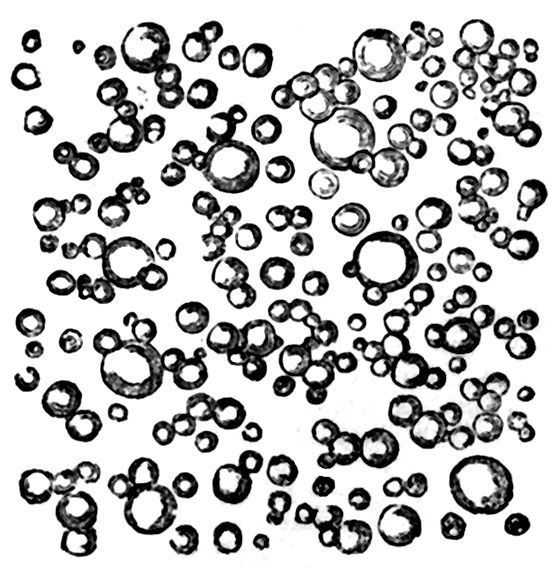
Fig. 1.—Good Milk.
In an impoverished milk, the globules will be smaller in size and fewer, and the field of vision will present the appearance of fig. 2.
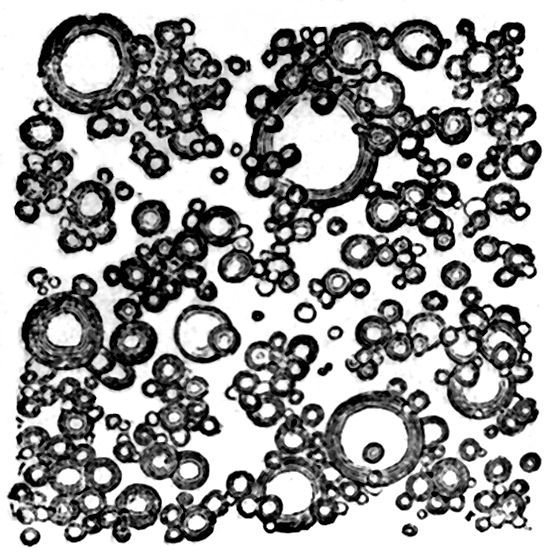
Fig. 2.—Poor Milk.
When curd of milk is examined under the microscope, the butter is still seen as droplets of fat, and the cheese as a granular substance of a yellowish colour. See fig. 3.
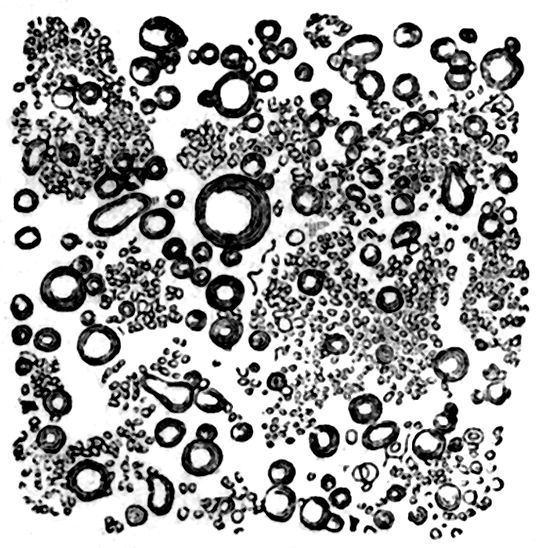
Fig. 3.—Curd of Milk.
Of all articles of food, none is so much adulterated as milk. We find different writers naming a variety of ingredients as commonly employed in the adulteration of it—amongst which may be mentioned flour, milk of almonds, gum arabic, gum tragacanth, chalk, turmeric, carbonate of soda, sugar, emulsion of hemp seed, and sheep and horses’ brains, rubbed up with water into an emulsion.
HAIR (THE STRUCTURE OF THE). 1. Hair is found to grow on all parts of the surface of the body, except the palms of the hands and the soles of the feet.
2. The hair differs considerably in length, thickness, shape, and colour; according to situation, race, family, sex, and age.
3. As hair is a bad conductor of heat, it is obviously one of the most appropriate coverings for the bodies of animals, or the head of man, because heat escapes very slowly through it. The surface of the body is protected from the influence of excessive heat, moisture, and electricity, by means of the hair.
4. “The hair,” says Mr. Paget, the eminent anatomist, “in its constant growth, serves, over and above its local purposes, for the advantage of the whole body, in that, as it grows, it removes from the blood the bisulphide of protein and other constituents of its substance, which are thus excreted from the body.” It is therefore evident that the hair performs an important part in the animal economy. It has been remarked that shaving or cutting the hair assists in the removal of carbon and hydrogen from the system; consequently long hair is injurious.
5. If we but look at the back of our hands we shall observe the hair issuing from small depressions in the skin. These depressions are the orifices of the hair-follicles, which extend to various depths in the corium, and are always lined with cells of the same kind as those found in the epidermis.
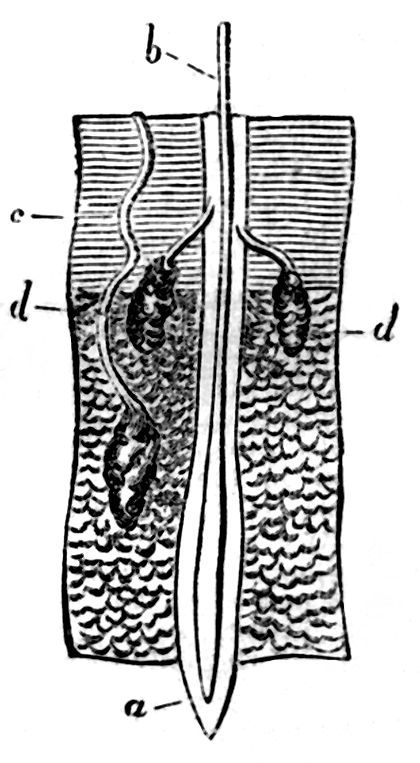
Fig. 1.
6. Here is a diagram that will explain how the hair is retained in the skin, and if you examine it attentively you will be able to understand the relative positions of the various parts. The diagram represents a section of the human scalp, showing the manner in which the hair penetrates it; a, is the hair-follicle; b, the hair within the follicle; c, the epidermis; d d, the sebaceous glands opening into the hair-follicle; e, the fatty tissue, with the cellular tissue underneath it, in which the base of the hair-follicle is embedded.
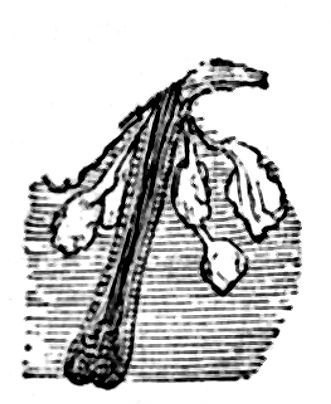
Fig. 2.
7. As we have seen above, the sweat-glands are connected with the hair-follicles; and, in the accompanying figure, you will observe that there are no less than six of these glands opening into the hair-follicle which belongs to the beard.
8. The shaft of the hair is that part which you discern above the surface of the skin (fig. 1, b), and if you follow it into that membrane, you will see that it is lodged in a fold of what is termed basement membrane, or its follicle, which is larger or bulbous at the lower part, like the hair which is inside it. The accompanying diagram will enable you to understand the relative positions of the adjacent parts to the hair.
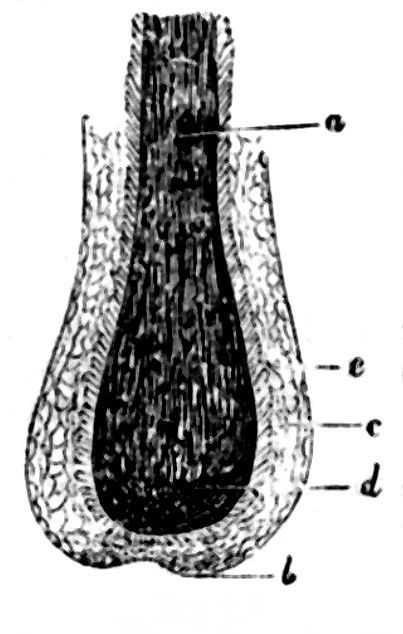
Fig 3. a, mass of cell in the centre of the hair filled with pigment; b, basement membrane of the hair follicle; c, layer of epidermic cells; d, imbricated cells, loaded with pigment at the lower part, and becoming gradually compressed as they approach the surface of the akin; e, layer of imbricated cells.
9. The hair-follicle is merely a turning-in of the skin, so as to invest the hair, and its inside is a continuation of the epidermis; for the cells are of the same nature (fig. 2, c), the deeper ones being somewhat round, while the superficial ones are flattened and scaly (e). The follicle is kept in its place according to the size and strength of the hair, by means of the adjoining tissues (sec. 6, fig. 1), and the small vessels, called capillaries, which afford materials for increase.
10. The hair grows from the bottom of the follicle, being formed by the secretions of these cells, and being gradually pushed upwards by them, so as to increase its length.
11. As the cells ascend in the bulb of the hair, they become larger until they reach the central part—hence the increased size of the bulb; but when the shaft commences, the cells become longer, denser, and, in fact, fibrous.
12. By simply crushing the hair, we are able to discern its fibrous nature; but this may be more readily demonstrated after the hair has been softened by maceration in an acid.
13. Hair consists of a cortical or fibrous horny texture which invests it, and a medullary or pith-like substance, which is observed on the inside.
14. The cortex, or bark of the hair, is formed by a single layer of cells being imbricated (fig. 2, e), and forming a thin layer outside the fibrous tissue of the shaft. These cells overlap each other, so that their edges give a serrated feel and appearance to the hair. If you rub your finger from root to point over a hair, and then rub it backwards, you will find that its surface is serrated; and, if the hair is very large, you will find that the roughness is greater,—because there is usually a double series of imbrications in the large hairs.
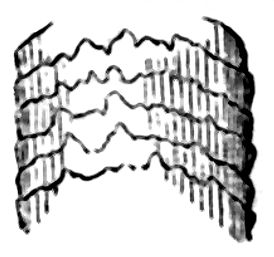
Fig. 4. A portion of hair magnified so as to show the imbrication of the outside.
15. If we make a longitudinal section of the shaft of a hair, we find that the centre is made up of a series of cells, filled up with pigment, and contained in the fibrous part of its substance. In order to observe this appearance, we must use a sharp razor to make the section, and a magnifying power of about 150; but as every person is not able to do so, we have given a diagram of the appearance of the longitudinal section of the hair.
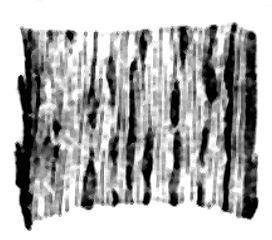
Fig. 5. Longitudinal section of a hair, showing the imbrication of the cortex, and the pigment cells in the fibrous part.
16. If we take a hair, and cut it across with a sharp razor, so as to make a very thin section of it—a mere shaving, in fact—we shall observe three parts: first, a thin varnish-like layer of flattened cells; then a set of fibres, which are placed further apart as they approach the centre, which is dotted here and there with pigment-cells in some hairs, but is always loose, and looks like pith.
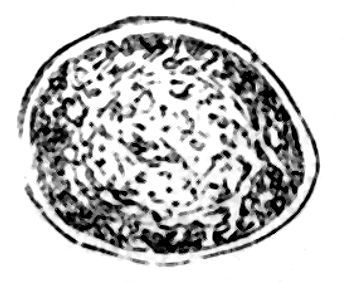
Fig. 6. Transverse section of a hair, showing the three different textures.
17. The hair varies in length according to situation, sex, and race. In the Kurilian race, there are individuals who have hair growing down the back and covering nearly the whole body. The average length of the beard is ten inches, but some men have had beards that swept the ground. Women have also been met with whose hair reached to their feet; but yet the ordinary length is only from twenty to forty inches.
18. Colour influences its texture: thus flaxen hair is said to be the finest, and black the coarsest; and as hair becomes gray, it becomes coarser. Withof, a German anatomist, states that a square inch of the skin of the head contains 598 black hairs, 648 chesnut hairs, and 728 flaxen hairs.
19. The colours and shades of the human hair are very numerous, and depend, in a measure, upon age, climate, and race. The following table will give some idea of the varieties caused by race and climatal influence:—
| Race or Tribe. | Hair. |
| Afghans | black. |
| Arabs | black and crisp, with grizzly beards. |
| Armenians | dark. |
| Berberines, or Nubians of the Nile | dark, and strongly frizzled. |
| Californians | black, long, very strong, and not woolly. |
| Chinese & Indo-Chinese | thick, coarse, lank, and black, with scanty beards. |
| Circassians | brown or black. |
| Egyptians | black and crisp. |
| Endamênes (New Guinea) | thick, rough and shining, without being woolly. |
| Esquimaux | coal-black, straight, strong, and long black. |
| Ethiopian | black and crisp. |
| Greeks | black, brown, and flaxen. |
| Kamtschatkans | black. |
| Kurds | black. |
| Kurilians or Ainos | very black. |
| Mantschoos | brown. |
| Mexicans | thick, black, coarse, and glossy; beard thin. |
| Mongolians | black, stiff, straight, and sparing. |
| Ossetines | brown or light, and sometimes red beards. |
| Patagonians | lank and black; beard scanty. |
| Singhalese | black. |
It is worthy of remark with respect to the colour of the hair, that it varies with the colour of the iris, or coloured part of the eye, and the general hue of the skin. It has been remarked, and with more degree of truth than is generally believed, that the darker the hair the stronger the body, and vice versa.
20. The difference of colour in human hair appears to depend, according to Vauquelin, on the presence or absence of a peculiar oil. He states that black hair consists of,—1. An animal matter, which constitutes the greater part. 2. A white concrete oil, in small quantity. 3. Another oil of a grayish-green colour, more abundant than the former. 4. Iron, the state of which in the hair is uncertain. 5. A minute proportion of oxide of manganese. 6. Phosphate of lime. 7. Carbonate of lime, in very small quantity. 8. Silex and sulphur, each in considerable quantity.
21. Hair is remarkably elastic and strong. A single hair from the head of a boy only eight years of age supported the weight of 7.812 grains; and one from the head of a man twenty-two years of age supported 14.285 grains. Weber states that a hair 10 inches long will stretch to 13 inches.
HAIR (MANAGEMENT OF THE). Pass a fine-tooth comb, at regular intervals every twenty-four hours, through the hair, in order to keep it from matting or entangling; separate the hairs carefully and repeatedly, so as to allow the air to pass through them for several minutes; use a brush that will serve the double purpose of cleansing the scalp and gently stimulating the hair-bulbs. Before going to bed, it will be desirable to part the hair evenly, so as to avoid false folds, or what is commonly called turning against the grain, which might even cause the hairs to break. Such are the usual and ordinary requirements as to the management of the hair. There is, on the other hand, a class of persons who carry to excess the dressing and adornment of the hair, especially those who are gifted with hair of the finest quality. Thus, for example, females who are in the habit, during the ordinary operations of the toilette, of dragging and twisting the hair, so as almost to draw the skin with it; the effect of which is, in the first instance, to break the hairs and fatigue the scalp, and finally to alter the bulb itself.
FLOWERS (LANGUAGE OF). The first rule to be observed in our floral grammar is, that the pronoun I or me is expressed by inclining the symbol flower to the left, and the pronoun thou and thee by inclining it to the right. When, however, it is not a real flower offered, but a representation upon paper, these positions must be reversed, so that the symbol leans to the heart of the person whom it is to signify.
The second rule is, that the opposite of a particular sentiment expressed by a flower presented upright is denoted when the symbol is reversed; thus a rose-bud sent upright, with its thorns and leaves, means, “I fear, but I hope.” If the bud is returned upside down, it means, “You must neither hope nor fear.” Should the thorns, however, be stripped off, the signification is, “There is everything to hope;” but if stripped of its leaves, “There is everything to fear.” By this it will be seen that the expression of almost all flowers may be varied by a change in their positions, or an alteration of their state or condition. For example, the marigold flower placed in the hand signifies “trouble of spirits;” on the heart, “trouble or love;” on the bosom, “weariness.” The pansy held upright denotes “heart’s-ease;” reversed, it speaks the contrary. When presented upright, it says, “Think of me;” and when pendent, “Forget me.” So, too, the amaryllis, which is the emblem of pride, may be made to express, “My pride is humbled,” or, “Your pride is checked,” by holding it downwards, and to the right or left, as the sense requires. Then, again, the wallflower, which is the emblem of fidelity in misfortune, if presented with the stalk upward would intimate that the person to whom it was turned was unfaithful in the time of trouble.
The third rule has relation to the manner in which certain words may be represented; as, for instance, the articles, by tendrils with single, double, and treble branches, as under—
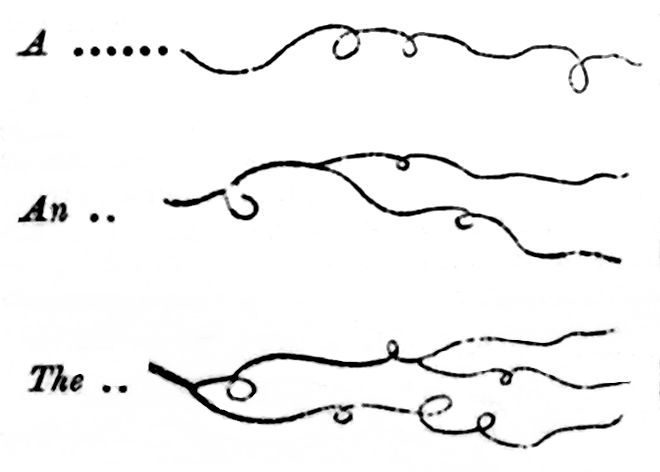
The numbers are represented by leaflets running from one to eleven, as thus—
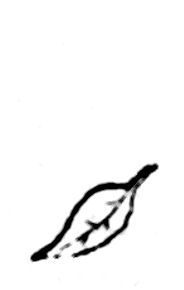
1
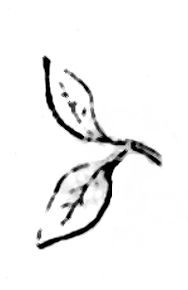
2
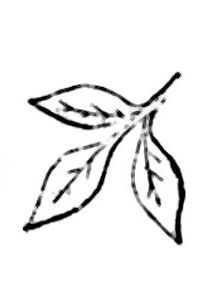
3
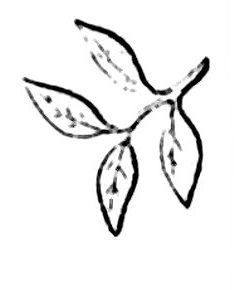
4
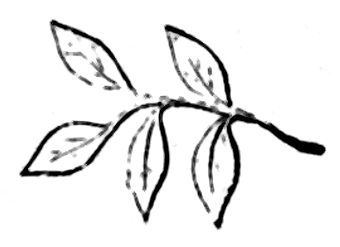
5
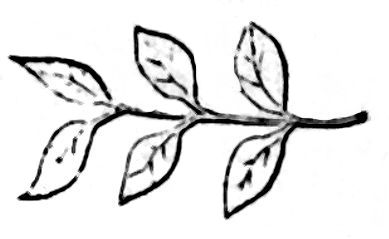
6
From eleven to twenty, berries are added to the ten leaves thus—
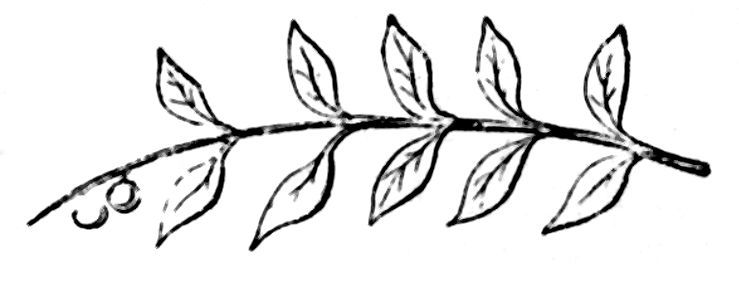
12
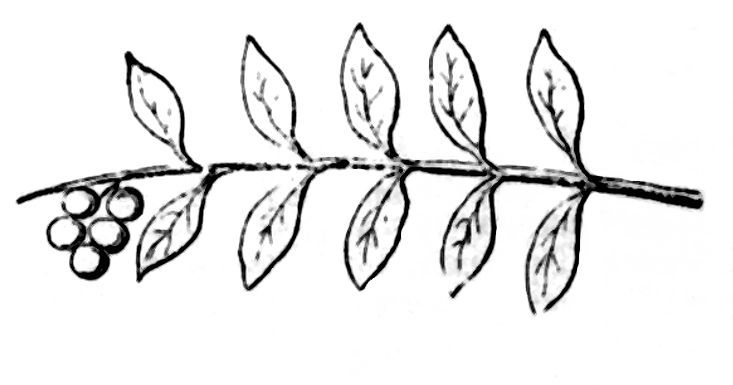
15
From twenty to one hundred, compound leaves are added to the other ten for the decimals, and berries stand for the odd numbers, so—
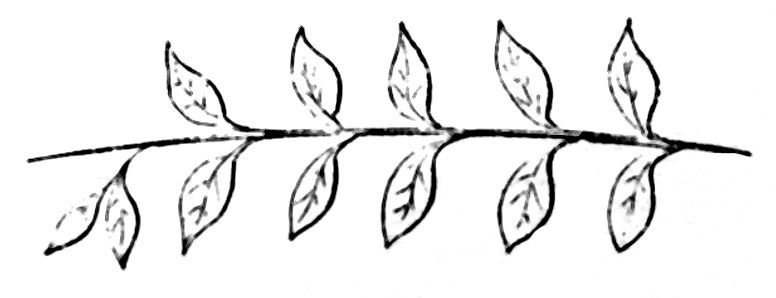
20
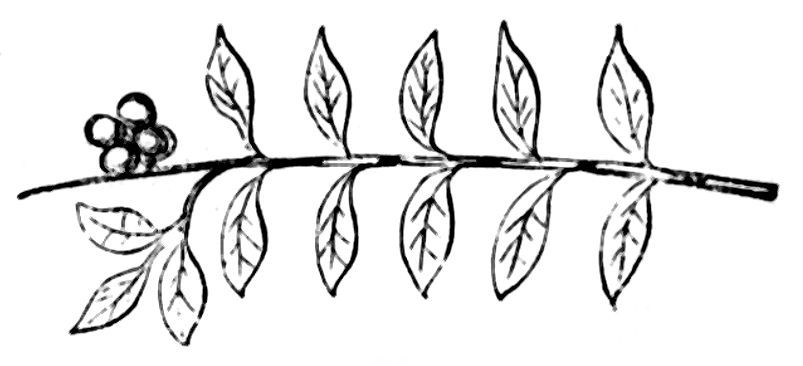
34
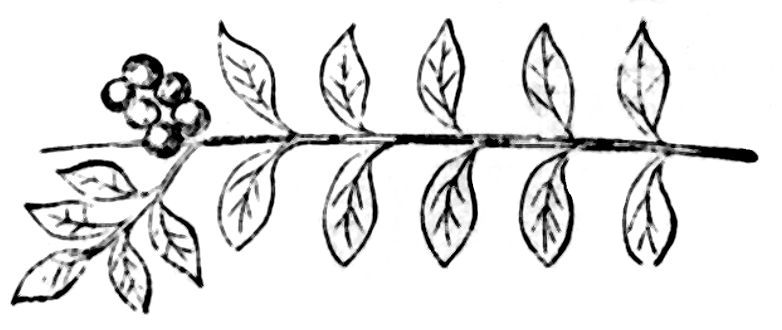
56
A hundred is represented by ten tens; and this may be increased by a third leaflet and a branch of berries up to 999.
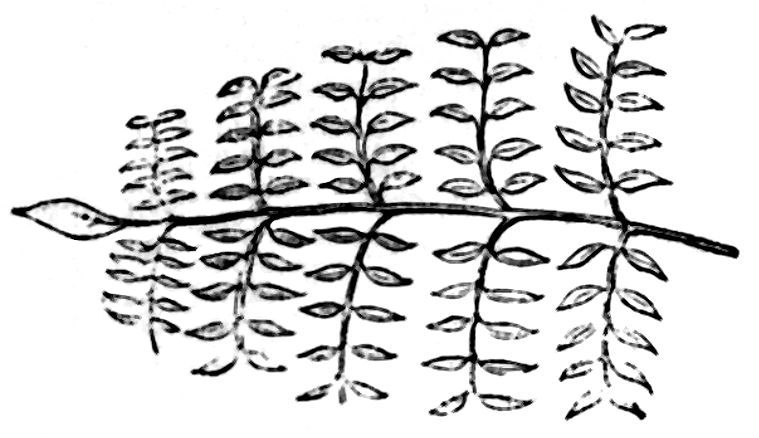
100
A thousand may be symbolized by a frond of fern, having ten or more leaves, and to this a common leaflet may be added to increase the number of thousands. In this way any given number may be represented in foliage, such as the date of a year in which a birthday, or other event, occurs to which it is desirable to make allusion, in an emblematic wreath or floral picture. Thus, if I presented my love with a mute yet eloquent expression of good wishes on her eighteenth birthday, I should probably do it in this wise:—Within an evergreen wreath (lasting as my affection), consisting of ten leaflets and eight berries (the age of the beloved one), I would place a red rose-bud (pure and lovely), or a white lily (pure and modest), its spotless petals half concealing a ripe strawberry (perfect excellence); and to this I might add a blossom of the rose-scented geranium (expressive of my preference), a peach blossom to say “I am your captive,” fern for sincerity, and perhaps bachelor’s buttons for hope in love.
This is, however, as far as we need carry the example. Our readers will at once understand our application of the principles laid down as a basis for this delightful language of flowers, in which all the days of the week are symbolized as follows:—
Monday by a leaf of the lotus or water-lily, nymphæa, half represented light, half dark. Selected because the eastern nations consider the lotus as—
“The emblem and cradle of creative night.”
Tuesday has a leaf, half of which is light, to signify the heavens; and the other half blue or sea-green, meaning the waters, in reference to the second day’s work of creation.
Wednesday. The emblematical leaf for this day is divided into three colours; light for the heavens, blue for the waters, and green for the earth.
Thursday has a green lotus leaf, on which is placed a flower, figurative of the great luminary created on the fourth day.
Friday has a leaf on which an insect is feeding—“Let the earth bring forth the living creatures.”
Saturday. The leaf for this day is filled with fruit—“I have given you every herb bearing seed, and every tree, in which is the fruit.”
Sunday. Simply an olive leaf, sacred to peace or rest.
The floral emblems of the month are thus given by Phillips:—
January is represented by a robin, encircled in a garland of sweet-scented tussilago (tussilago fragrans); since the one cheers our dwellings at this season by its chirrup, whilst the other regales the early month by its fragrance.
February has a wreath of snowdrops (galanthus nivalis) surrounding a pair of goldfinches; that being the month in which those flowers appear, and on which, also, the birds begin to couple.
March is distinguished by the hieroglyphics of a bird’s nest encircled by a branch of the almond (amygdalus),
“That blooms on the leafless bough.”
April. For this month we have a linnet on his nest in the midst of a bush of
“The vernal furze with golden baskets hung.”
May. A nest of young birds clamorous for food, in a hawthorn bush in full flower, represents this month.
June has a wreath of flowing grapes, encompassing a branch of ripe strawberries; and
July a bunch of red cherries, enwreathed with the fragrant purple thyme. For
August is woven a coronal of wheat, barley, and oats, encircling ripe plums.
September has a cluster of purple grapes, with a wreath of hops—
“For clustering grapes are his peculiar care.”
October is represented with various-coloured China-asters and clusters of hazelnuts.
November has a garland of flowing ivy, with turnips and carrots in the centre; and for
December is woven a garland of holly, with its glossy green leaves and vermilion berries, from the centre of which hangs a branch of mirth-inspiring mistletoe.
EYES (PRESERVATION OF THE). Mr. Cooper, in his “Practical Remarks on Impaired Vision,” gives some excellent hints on the preservation of the eyes, which will be interesting to many of our readers.
Daily experience teaches us that the decay of vision is hastened by many causes which are frequently overlooked. Although it is about forty that the sight usually begins to fail, yet we find that some persons attain extreme old age without needing glasses at all. Other persons, on the contrary, require glasses by the age of thirty, and, though much depends upon constitution, much also depends upon a person’s habits.
One of the worst of habits is that of overworking the eyes by candle-light at night. Repose from labour, so necessary for the restoration of tone and vigour to the several organs of the body, is too sparingly granted to the eyes.
Let it be remembered that day-work is preferable to night-work; that while the light of a candle or lamp is trying even to a strong eye, the moderate light of the sun is strengthening to it. Those whom circumstances compel to study in the evening should select that kind of work which is least distressing to the eyes; they should especially avoid indistinct writing or small print.
Reading by fire-light, or simply gazing at the fire when sitting alone, or in a contemplative mood, is highly injurious to feeble eyes, and should be avoided by all. It is not advisable to read by twilight; too little light is as pernicious as too much light, yet many persons will, evening after evening, try their eyes in this way rather than burn a candle. It is injurious to the eyes to be long exposed to the reflection of a strong light, whether artificial or natural, such as the reflected sunshine from the page of a book. Too brilliant a light produces undue excitement of the eyes. To preserve weak eyes as much as possible from a strong light, neutral tint spectacles are exceedingly suitable.
In reading and writing, just that amount and quality of light, whether natural or artificial, should be allowed which, while it thoroughly illuminates the object, feels grateful and pleasant to the eyes. This desideratum can never be obtained without due regard to the position of the light. The light cast upon a book while the candle is in front is by no means pleasant, and the glare of the flame is very trying to weak eyes. It will be found, that if the candle or lamp be placed behind the reader, a little elevated, and slightly on one side, the pleasantest and least injurious effect is produced; for the light then reflected to the eyes is less distressing, and at the same time the eyes are perfectly protected from the heat and glare of the flame.
Sudden transitions from gloom to strong light should be avoided. The dazzling effect produced when we come suddenly from darkness into light arises from the pupils having been widely dilated to admit the greatest possible number of luminous rays whilst in the gloom; and as the pupil of the eye requires time to contract, sudden transitions from comparative darkness to a bright light compels the eye to admit far more rays than is either agreeable, or than it is calculated to bear without injury.
It cannot be too strongly urged upon any one about to use spectacles for the first time, that that power which will enable him to read without much exertion by candle-light is the only power suitable for him. It is by candle-light only he should use glasses at first, and as soon as he finds that he stands in need of glasses by day as well as by candle-light, and that the glasses he uses no longer afford him sufficient assistance by candle-light, it will be proper to use the next power for the evening, but for the evening only, and to allow himself the use of the others—and their use only—during the day. The greatest caution as to increasing the power of glasses should be observed, for persons who change their glasses, unnecessarily increasing their power each time, are exhausting the resources of art instead of economising them as much us possible. Optical aid can only be extended to a certain point, and the steps to that point should be as slow and as numerous as possible. By exercising prudent precautions, persons may often attain great age, and yet never require the aid of glasses beyond a very moderate power; others, on the contrary, who from ignorance frequently increase the power of their glasses, may run through the whole assortment, and leave themselves only the most inconvenient resources to fall back upon—viz. the very highest powers.
PROFILES IN BLACK (METHOD OF TAKING). Procure a wooden frame, about a foot square: divide each side into six portions, and stretch across strings at equal distances before marked, so as to make in all thirty-six squares. Purchase some of the black paper used by artists (three halfpence a sheet), and on the white side rule thirty-six equal squares corresponding to those on the frame. Then desire the person to sit about three yards from you, and in such a position that you see his profile through the squares of your frame. Then sketch on your paper with the ruled lines the profile as you see it through the squares, and draw it on yours correspondingly. Then cut out what you have sketched, and stick, with black side up, on a piece of card. This is a capital way for one who has no artistic taste to take sketches of views, busts, &c.
PAN. The son of Mercury, chief of the rural deities, and god of shepherds.
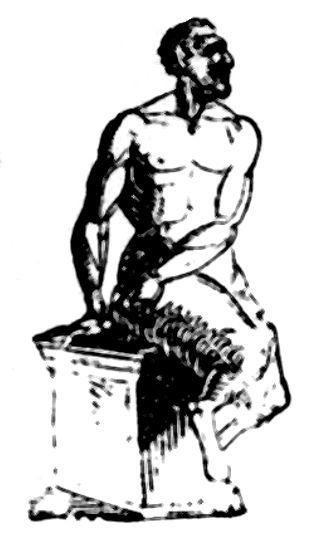
SHIRTS (TO FOLD). Having spread the shirt on a table or on a bed, fold over the two sides lengthways, so as to lie one over the other upon the bosom. Turn the sleeves back halfway from the shoulders (doubling over the sleeve-gussets in half) so as to be straight down on the folded body. Then take the whole and give it a cross-fold upward, so that the lower half of the shirt that is turned over covers the upper part of the sleeves and the bosom. False collars are folded in half only. False bosom pieces first in half from the back, and then another fold is given, so as to leave the full part upwards.
EAGLE. A bird of prey, of the genus falco, of which there are several species; as the sea eagle, known in Scotland and Ireland, which feeds on fish; the golden eagle, three feet long, with wings extending above seven feet, which devours fawns, lambs, kids, &c., and lives to a great age; the cinereous eagle, common in the mountains of Europe; the crying or plaintive eagle, of Siberia and Asia and also the bald or white-headed eagle, which preys on flesh and fish. The talons and bills of all the species are strong and terrible, and their sight is keen and distant.
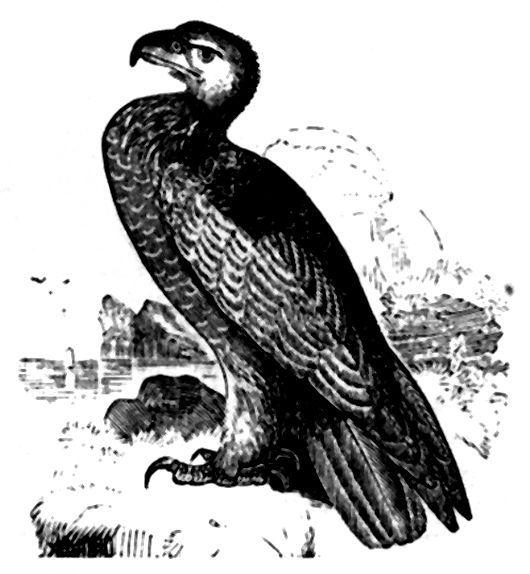
MULE. An animal, the produce of a horse and an ass, and which itself does not propagate. It is much esteemed for its hardihood, strength, and sureness of foot; and is therefore preferred as a beast of burden in all mountainous countries. If ill-treated it displays proverbial obstinacy.
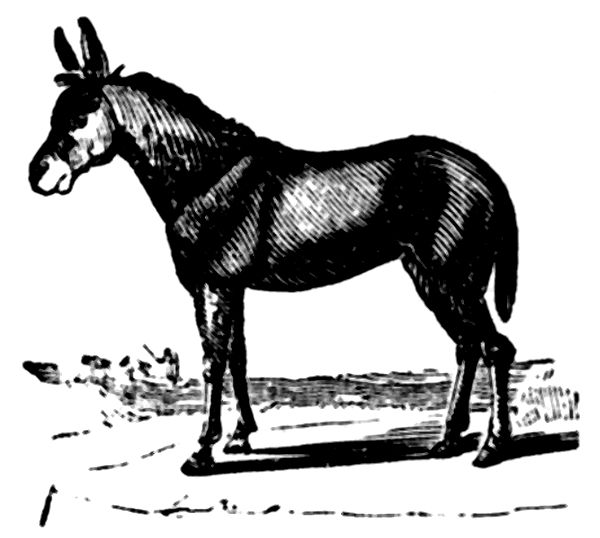
ROCKS (TRANSITION). The lowest, in which are found organised beings, but these consist only of zoophytes, or equivocal animals, and shell-fish, while the rocks above these contain animals possessed of sight and locomotion, and the still more modern ones contain perfect animals; all so many unerring displays of the slow and gradual production of one thing out of another, in regular progressions of complication and perfection.
TRUSTEE. One invested with property for a special purpose.
NET-MAKING. A useful art, by which fibrous materials are knotted in a regular manner, and continued over a large surface. The formation and commencement of the meshes and the shape of the wooden needle used in the process, is plainly represented in the engraving.
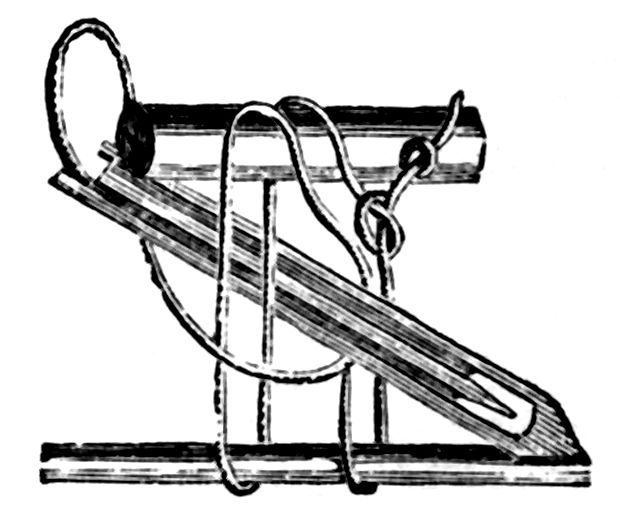
NOVEMBER, was so called from being the ninth month of Romulus’s year, which began with March; but, according to the altered calendar of Numa and Julius Cæsar, it was the eleventh month of the year, as it now stands. As the ninth month, it was derived from the Latin words novem, nine, and imber, a shower.
Our Saxon ancestors called this month Blot Monath, or slaughter month, because, as food for the cattle was scarce during the winter season, it was customary for them to kill and salt most of their winter meat during this month. The name is derived from the Saxon word Blotan, to kill or slay. They also call it Wint Monath, or wind month, on account of the tempestuous weather which prevails at this period of the year, when the wind strips the trees of their few remaining leaves.
Synonymes.—In Latin, November; French, Novembre; Italian, Novembre; and Portuguese, Novembro.
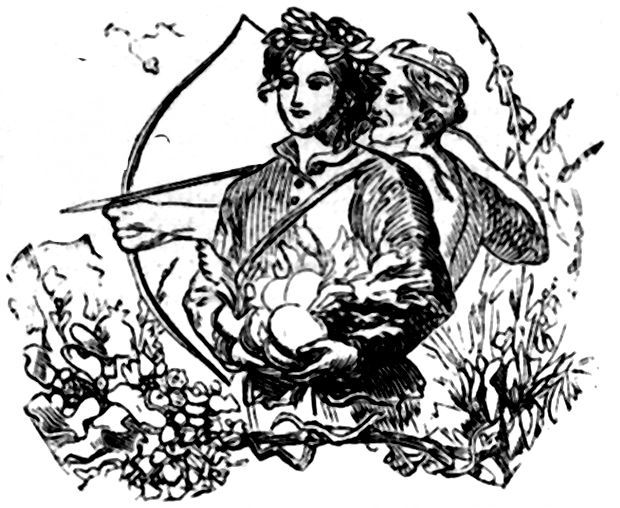
Symbol or Allegory of the Month.—A young man, dressed in clothes the colour of the leaves when they begin to fall; his head was crowned with a garland of olives with the fruit; in his hands he held bunches of turnips and parsnips, symbolical of the produce of the earth during this month; and behind him was the sign of Sagittarius, the Archer, in allusion to the sun entering that constellation on the 22nd of the month. (See our allegorical engraving.)
1st. All Saints is a festival instituted by Boniface IV., when he was allowed by the Emperor Phocas to convert the Pantheon at Rome into a Christian church. It was originally celebrated on the 12th of May, in honour of the Virgin Mary and all Martyrs, but was afterwards ordered to be kept upon November 1st. Many curious customs are still practised in various parts of Great Britain upon this day, similar to the ceremonies of Hallowe’en.
2nd. All Souls is a festival of the Romish church, held in commemoration of the Faithful Departed, and is accounted a very solemn festival, being celebrated with masses and formal ceremonies adapted and arranged for the purpose. Brady informs us, that “Odilon, Abbot of Cluny, in the ninth century, first enjoined the ceremony of praying for the dead on this day in his own monastery: and the like practice was partially adopted by other religious houses, until the year 998, when it was established as a general festival throughout the Western Churches.”
5th. Gunpowder Plot.—This day is held in commemoration of the discovery of the “Gunpowder Plot,” a.d. 1605, and the happy deliverance of King James, I., and the three Estates of England, from the conspiracy of Guido Fawkes and others, who intended to have destroyed the King, the Prince of Wales, and the Lords and Commons, by igniting a large quantity of powder placed in a cellar beneath the Parliament-house. Schoolboys look forward with great anxiety to the celebration of this day, when they will be able to indulge in squibs, crackers, catherine-wheels, or pin-wheels, and other pyrotechnic displays. Then the effigy of Guy is burned in the midst of a great bonfire, and fireworks exhibited in commemoration of the event.
11th. St. Martin’s Day, or Martinmas.—St. Martin is said to have been born in Lower Hungary, about 316, and to have originally been a soldier. Having been elected, Bishop of Tours, in 371, he is said to have lived in a narrow hole in the side of a rock, and to have died in 397.
13th. St. Brice, or Britius was born at Tours, became a monk under St. Martin, and finally succeeded him in the see of that city.
15th. St. Machutus, sometimes called St. Malo or Maclou, is said to have been born in England, but having visited Brittany, became Bishop of Aleth, where he died 15th November, 565.
23rd. St. Clement, who was a follower and fellow-labourer with St. Paul, is the patron saint of blacksmiths, and is said to have been thrown into the sea, with an anchor fixed about his neck.
25th. St. Catherine is said to have been beheaded by order of the Emperor Maxentius, or Maximinius II. Butler, in his “Lives of the Saints,” tell us that “she was first put upon an engine made of four wheels joined together, and stuck with sharp-pointed spikes, that when the wheels were moved her body might be torn to pieces.”
30th. St. Andrew, who was one of the apostles, is said to have been martyred in the year 66, at Patræ, in Greece, upon a cross of the form of the letter X, which has ever since been called St. Andrew’s cross. He is the patron saint of Scotland.
This month gave birth to four names renowned in history namely, John Milton, James Ferguson, Martin Luther and Cardinal Wolsey.
James Ferguson was born at Keith, in Banffshire, in 1710. He was the son of a labourer, but by his extraordinary genius raised himself to the highest pinnacle of mathematical and astronomical fame. In 1754 he published a brief description of the solar system, but his greatest work was his “Astronomy explained upon Sir Isaac Newton’s principles, and made easy to those who have not studied Mathematics.” He died on the 16th of November, 1776.
John Milton, the distinguished author of “Paradise Lost,” and of numerous other poetical works, was the son of a scrivener in London, and born in Bread-street, in 1608. During the civil wars between Charles I. and his Parliament, he entered warmly into the defence of the latter, and was afterwards appointed Latin Secretary to Cromwell. He wrote against the King’s book, called “Icon Basilike,” and was also employed to answer the treatise of Salmasius, entitled “Defensio Regia,” which he did in a powerfully written work, entitled, “Defensio pro Populo Anglicano.” He died on the 8th of November, 1674.
Martin Luther, the great apostle of the Reformation, was born at Eisleben, in Lower Saxony, on the 10th of November, 1483. In 1534 he published a translation of the whole Bible, and printed, during the same year, a book against the service of the mass. He died at his native place on the 18th of February, 1546.
That eminent prelate and statesman, Cardinal Wolsey, was the son of a butcher, and born at Ipswich, in 1471. He was at one time in high favour with Henry VIII., and lived in princely state; but at length that capricious monarch, in consequence of Wolsey’s opposition to his divorce from Catherine of Aragon, became his bitterest enemy. In 1529 he was deprived of the Seals of State and impeached, though a full pardon was afterwards granted him. He was, however, again arrested on a charge of high treason; but died at Leicester, on his way to London, on the 28th of November, 1530.
BANK OF ENGLAND NOTE (THE). The Bank of England possesses no security which may not be known by any person who will make himself acquainted with the following characteristics of the paper, the plate printing, and the type printing of the note. The paper is distinguished—1. By its peculiar colour, such as is neither sold in the shops, nor used for any other purpose. 2. By its thinness and transparency—qualities which prevent any portion of the printing on the note being washed or scratched out without a hole being made. 3. By its characteristic feel, which consists of a singular crispness and toughness, owing to the fact that the Bank paper is made from new linen and cotton, not from rags. 4. By the peculiar wire mark or water mark, which can only be produced when the paper is in a state of pulp; consequently the forger must procure a mould, and make his own paper, both requiring the skill of such first-rate artisans as are not likely to be met with in the haunts of crime. 5. By the three deckle or rough edges. These edges are produced when the paper is in pulp; two notes being placed in the mould, and divided lengthways. The deckle is the raw edge of the paper, and cannot be imitated by cutting. 6. By the strength of the paper: a bank note will lift a hundredweight, if carefully adjusted. The printing is of two kinds, type and plate; the paper is moistened by water driven through its pores by the pressure of the atmosphere; 30,000 double notes are thus moistened in the space of an hour. The ink used is made at the Bank, from linseed oil and the charred husks and vines of Rhenish grapes; this gives a peculiar velvety black to the mark in the left-hand corner of the note. The notes are numbered by a machine which cannot err; and, lastly, are authorized by the signature of the clerk. The bank notes are printed on the side of the paper which receives the watermark, so that, if the paper be split, the unprinted surface only retains the slightest trace of that mark. (See Bank of England, p. 190.)
PAWNBROKERS’ SIGNS. The most wealthy of the Italian bankers, generally called Lombards, belonged to the princely house of the Medici of Florence. They bore pills on their armorial bearings, as indicative of the profession of the family. At that time it was customary to cover boluses, &c., with gold or silver leaf, and hence the Lombards adopted the sign of three golden pills upon their signs. In the course of time, as the great reputation of the Italian bankers increased, others assumed the device, and it has since become general.
CHRISTMAS CUSTOMS. Christmas Eve is celebrated because Christmas day, in the Primitive Church, was always observed as the Sabbath day, and, like it, preceded by an eve, or vigil.—Brand.
It was once believed, that if we were to go into a cow-house, at twelve o’clock at night, all the cattle would be found kneeling. Many also firmly believed that bees sung in their hives on Christmas eve, to welcome the approaching day.
Christmas Day is so called because of its derivation from Christi Missa, the mass of Christ; and thence the Roman Catholic Liturgy is termed their Missal, or Mass-book. About the year 500, the observance of this day became general in the Catholic Church.
Yule formerly used to signify Christmas, because of its derivation from the word ol (ale), which was much used in the festivities and merry meetings of this period; and the I in Iol, icol, in Cambrian, as the ze and zi in zehol, zeol, ziol, Saxon, are premised only as intensives, to add a little to the signification, and make it more emphatical. Ol, or Ale, did not only signify the liquor then made use of, but gave denomination to the greatest festivals, as that of zehol, or yule, at mid-winter; and as is yet plainly to be discovered in that custom of the Whitsun ale at the other great festival.
Crucifixes. Certain initials are affixed to crucifixes because of their signifying the titular tributes paid to the Saviour of the World. The letters I.N.R.I. are universally agreed to be the initials of the Latin words Jesus Nazarenus Rex Judæorum; that is, Jesus of Nazareth, King of the Jews, a title which Pilate wrote and affixed to the cross.—See John, ch. xix. The initials I.H.C. appended to other crosses are said to imply Jesus Humanitatis Consolator (Jesus the Consoler of Mankind); and I.H.S. imply Jesus Hominum Salvator (Jesus the Saviour of Men). The first-mentioned initials are, however, found on the most ancient crosses.
Carols are so called because of its derivation from cantare, to sing, and rola, an interjection of joy.—Bourne.
Bishop Taylor observes that the “Gloria in Excelsis,” the well-known hymn sung by the angels to the shepherds at Our Lord’s nativity, was the earliest Christmas carol. Bourne cites Durand to prove that in the earlier ages of the Churches, the bishops were accustomed, on Christmas day, to sing carols among their clergy. Fosbroke says—“It was usual, in ancient feasts, to single out a person and place him in the midst, to sing a song to God.”
The present carols were substituted, by the Puritans, for the original carols, which were festal chansons for enlivening the merriment of the Christmas celebration; and not such religious songs as are current at this day with the common people, under the same title.
Dr. Johnson, in a note on Hamlet, tells us, that the pious chansons, a kind of Christmas carol, containing some Scripture history thrown into loose rhymes, were sung about the streets by the common people, when they went at that season to beg alms.—Brand.
Laurel is used with other evergreens to deck houses at Christmas, because of its use among the ancient Romans, as the emblem of peace, joy, and victory. In the Christian sense, it may be applied to the victory gained over the Powers of Darkness by the coming of Christ.—Bourne.
Mistletoe is so called because its seeds are said to be dropped by the mistle-thrush, which feeds on its berries. The mistletoe was held sacred by the Druids because they had an extraordinary reverence for the number three, and not only the berries, but the leaves of the mistletoe grow in clusters of three united on one stalk. Its growing upon the oak, their sacred tree, was doubtless another cause of its veneration.
NEWSPAPERS. The Times first appeared in 1788, but bore the number 941, being a continuation of The Universal Register, which had been published for some time before. The first number of The Morning Chronicle was issued in 1769: The Morning Advertiser came out in 1795. It is believed that the first daily paper was The Public Ledger, which was published in 1759.
ET (AND). The figure “&” is sometimes called amperzand. It really stands for the Latin word et, and arose, perhaps, from the habit of the old manuscript writers of writing “et” in one stroke, beginning at the bottom of the t, and after forming an upright stroke, returning to make the e in like manner from below upwards, finishing by crossing the stroke of the t before taking the pen from the paper. The upstroke of the t then was omitted in quick writing, till at last the word et came to be written “&.”
BEES. Most of you know that honey-bees live together in a social community called a hive. In their original condition, these communities had their dwellings in hollow trees, or cavities of rocks; but they are rarely to be found now, except in a domesticated condition—as, the property of men who have supplied them with more convenient houses, and who claim the honey as the rent of these habitations. In each community there are three kinds of bees.
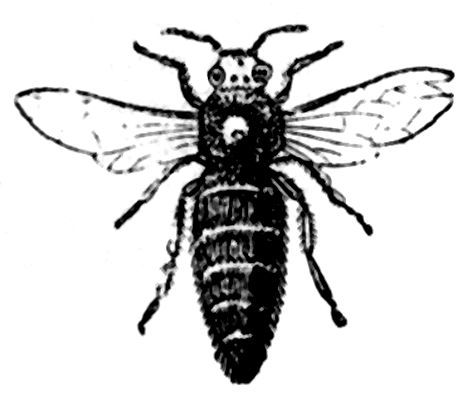
Fig. 1.
First, the Queen, or female bee (fig. 1). This lady can rarely be seen, for she leaves the hive only twice in her lifetime, and then only for a short period. At other times she is so assiduously attended, that the observer has but rare opportunities of viewing her. She is of a dark brown colour; the head is covered with yellow hairs, except where a plume of black ones has grown upon the forehead. The thorax is covered with pale brown hairs, and the abdomen is nearly twice as long as that of the common working bee (fig. 2), and the wings are smaller in proportion.
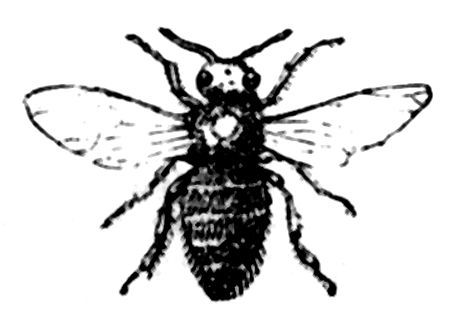
Fig. 2.
The Worker is rather darker in colour—indeed, its body is nearly black. The abdomen is composed of six segments, overlying each other like the greaves of old armour.
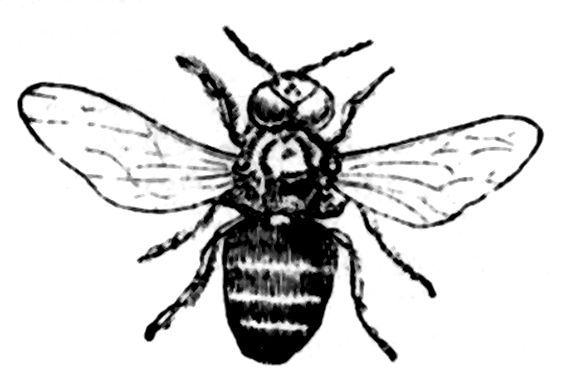
Fig. 3.
The third kind of bee is the Drone, or male (fig. 3), whose name has become a reproach to all idlers, from the circumstance that this insect does not take any part in those diligent labours of the hive in which the workers are constantly employed. The drone is much larger than the worker, but has not so long a body as the queen bee. The thorax and abdomen (that is, the chest and belly) are of nearly equal size, and the eyes are very large.
The scene presented by a community of bees is the more astonishing the more we become acquainted with its details. Each hive is a commonwealth, of which the queen is nominally the head, receiving the greatest honour and care from her industrious subjects. With a greater wisdom than can be claimed by men, these creatures allow no disputes about the succession to the throne to induce them to injure each other; but they require the parties themselves individually to settle the quarrel between each other, without prolonged interference with the duties of the hive. Indeed, they may be said with truth to have adopted the advice of Jeannot—
“Let those who make the quarrels,
Be the only ones to fight.”
Only one queen is permitted to hold office in the community at a time; but while her claims are undisputed, she is treated with singular respect and affection. Indeed, her presence, and the prospect of a future generation, appear the chief motives of the insects to exert themselves.
Reaumur shut up a queen taken from one hive with some workers taken from another, and was curious to see how those strangers to each other would conduct themselves. Bees to the number of more than a dozen surrounded her, and paid her every attention. Owing to an accident, the lady bee had become covered with dust; to remove this became the anxious care of her polite attendants, who licked her on all sides with the greatest assiduity. No sooner was one attendant weary, than a fresh insect took its place, and this “dressing” continued for more than two hours. In the end, the bees forgot their old habitation, and became the servants of the new queen. Even when a dead queen is placed among the bees, they treat her body with honour and respect. On one occasion, a queen, benumbed with cold, was placed among bees who had been deprived of a sovereign. With their trunks they licked her breast, head, and body; and, by crowding beneath, upon, and around her, appeared to be anxious to communicate that warmth which had caused her temporary death. All this while there was a dead silence in the colony, no hum or buzz was to be heard; but presently one of the royal limbs quivered, and there was instantly a short sound or cry among the attendants, who became even more diligent in their attentions. Anon, the motion of the limb was repeated; the attendants appeared now convinced that there could be no mistake, and a song of rejoicing was loud, general, and continuous.
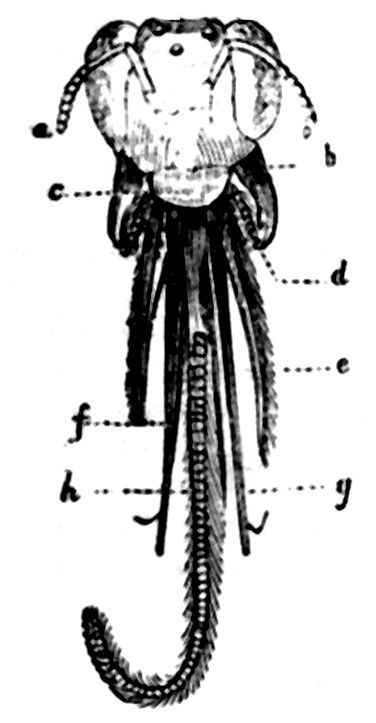
Fig. 4. Head of the humble-bee: a, antennæ; b, mandibles; c, labrum; d, maxillary palpi; e, maxillæ; f, lateral lobes of the tongue; g, labial palpi; h, tongue.
Having spoken of the attention of the bees to their queen, we will now proceed to describe the head of the Humble bee. The parts called maxillæ, or jaws, look very like the tusks, and the tongue closely resembles the trunk of the elephant. The head of the working bee has much of the same character. We have here (fig. 4) his proboscis, very highly magnified.
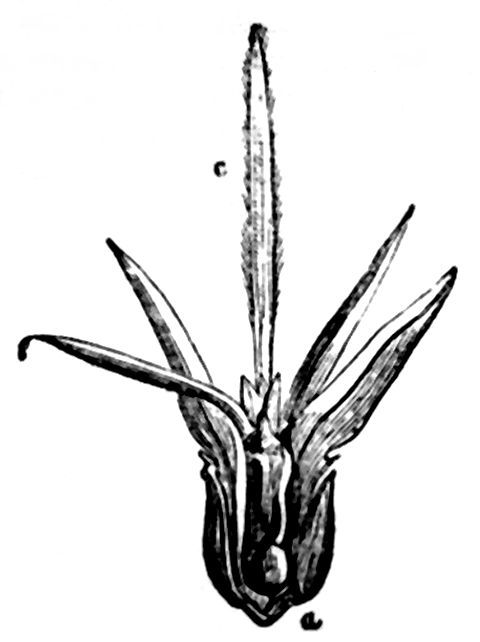
Fig. 5.
To the common observer, this appears to be a single tube, through which the honey is conveyed by suction; but, if we examine it (fig. 5), we find it consists of five distinct parts, four of which form a sheath, and the fifth is a narrow strap covered with fine bristles, and this is used as a tongue in lapping, or sweeping up the honey. The parts around the tongue (c) are furnished with numerous muscles, as is also the tongue itself; so that the tongue can be withdrawn and shut up, or its case opened, and the instrument darted into the bosom of a flower instantaneously. The nectar, or honey, is thus swept up into the honey-bag, which lies at the base of the tongue, from which it can be disgorged at pleasure, as the food of young birds can be disgorged by the mother from her crop, or craw.
It has commonly been supposed, from the earliest times, that the oval lumps of yellow substance on the thighs of bees are composed of wax; but this is an error. The little pellets consist of the yellow pollen of flowers, which, when brought into the hive, is handed over to the bakers, who mix it with honey, and knead it into bee-bread, or food for the young larvæ. The gathering of the pollen is a curious operation, which, however, you may find a hundred opportunities of observing during the summer months. It is gathered from the anthers of flowers, or those small yellow knobs at the tops of the stamens. The dust upon the anthers is called pollen, and is necessary to fertilize the flower. In gathering this yellow dust, therefore, the bee performs an important duty to the flower, as well as to the young bees at home; for he becomes the agent by which this pollen is conveyed from the stamen to the pistil, and the flower is thus rendered capable of producing seed.
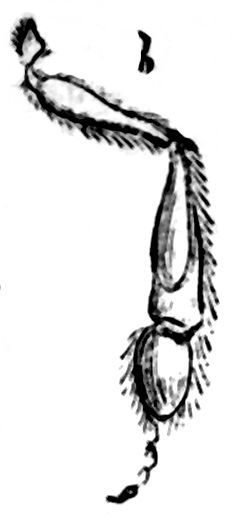
Fig. 6.
But let us turn to the microscope, and look at the wonderful provision made in the formation of the bee’s leg for the conveyance of the pollen homewards. The hinder leg of the bee (fig. 6) is thickly covered with fine hairs on the upper part (b); but, upon the lower, you will see a number of stiff bristles curved inwards, and ranged around a bare surface; thus is constructed a kind of basket, and in this the pollen, as collected, is packed and carried. How wonderful it is, that thus, in every portion of nature, however small, we find the same complete adaptation of parts to their particular purposes!
The wax is secreted from glands which lie beneath the segments of the abdomen or belly, but is only provided when required. It is not gathered from flowers, as was formerly supposed. A certain portion of the population of the hive are appointed wax manufacturers, and these are forthwith supplied with food by other labourers. The wax-workers hang themselves in festoons from the top of the hive, taking hold of each other’s legs, and thus remain for some time in perfect repose. Before the building of a new comb, festoons of bees may be seen hanging in the roof of their dwelling in all directions. After a while, the wax makes its appearance as scales, which exude from between the segments of the abdomen, eight scales appearing on each insect. The bee then detaches itself from its fellows, and makes its way to the roof of the hive, where it commences to build the comb. For this purpose it detaches, with its hind-leg, one of the scales of wax from its abdomen, and conveys it to its mouth, where it is masticated, and mixed with saliva, so as to be quite soft, and whiter than before. Each scale of wax is thus removed in turn, and is then kneaded, and stuck in a mass to the roof; and the bee continues labouring till all the scales are removed, when it is followed by another, who adds his quota of wax to that already accumulated, so as to make a little wall. The wax manufacturers and builders each retire as they conclude their work, and give way to the smaller insects called sculptor bees, who forthwith commence excavating hollows in the wall, which has been erected, with all the regularity and precision of a troop of sappers and miners. The cells are horizontal, and are made exactly hexagonal, or with six equal sides. An insect has thus solved the problem, of “how the greatest strength may be combined with the least quantity of material.”
DISINFECTING LIQUID. In a wine bottle of cold water dissolve two ounces of acetate of lead, (sugar of lead;) and then add two (fluid) ounces of strong nitric acid (aquafortis). Shake the mixture, and it will be ready for use. A very small quantity of the liquid in its strongest form should be used for cleansing all kinds of chamber utensils. For removing offensive odours, clean cloths thoroughly moistened with the liquid, diluted with eight or ten parts of water, should be suspended at various parts of the room. In this case the offensive and deleterious gases are neutralized by chemical action. Fumigation in the usual way is only the substitution of one odour for another. In using the above or any other disinfectant, let it never be forgotten that fresh air, and plenty of it, is cheaper and more effective than any other material.
CLOCKS AND WATCHES. The genius of the Germans appeared in the invention and improvement of many mechanical arts, especially clock-work. They have exceeded all the world in the contrivance of variety of motions, to show, not only the course of the hours and minutes, but even of the sun, moon, and stars; wherefore the clocks at Strasburg, Prague, and many other places all over Germany, are sufficient instances. Clock-makers were first introduced into England in 1368, when Edward III. granted a licence for three artists to come over from Delft, in Holland, and practise their occupation in this country. It was in the year 1577 that pocket-watches were first brought from Germany. The Emperor Charles V. had a watch set as the jewel of his ring; and in the Elector of Saxony’s stables is to be seen a clock in the pommel of his saddle. Charles I. had a ring-dial, made by Delamaine, a mathematician, which that monarch valued so much, that, on the morning before he was beheaded, he ordered it to be given to the Duke of York, with a book showing its use. (See p. 191.)
Epigram. In poetry, a short poem or composition in verse, treating of one thing only, and ending with some point, or lively ingenious thought.
Epitaph. A monumental inscription in honour, or memory, of a person defunct; or an inscription engraven, or cut on a tomb, to mark the time of a person’s decease, his name, family, and usually some eulogy of his virtues, or good qualities.
Emblem. A kind of painted enigma, which, representing some obvious history, with reflections underneath, instructs us in some moral truth, or other matter of knowledge; such as that very significant image of Scævola holding his hand in the fire, with the words agere et pati fortia Romanum est, (to do and to suffer courageously is Roman.) An emblem is somewhat plainer than an enigma. Gale defines emblem, an ingenious picture, representing one thing to the eye, and another to the understanding. The emblems of Alciatus have been in as much reputation among the learned as those of Quarles among the vulgar.
Acrostic. In poetry, a kind of ingenious composition, disposed in such a manner that the initial letters of the verses form the name of some person, kingdom, place, motto, &c. The acrostic is considered by the critics as a species of false wit. Some pretend to find acrostics in the psalms, particularly in those called abedarian.
Eclogue. In poetry, a kind of pastoral composition, wherein shepherds are introduced as conversing together. Theocritus and Virgil, among the ancients, have written eclogues. There were certain prose compositions termed eclogues, as those of Diodorus, Polybius, Ctesias, Theophrastus, Strabo, &c., in which sense the word signifies only extract or collection. M. Fontenelle observes, that the beauty of the eclogue is not attached to what is rural, but rather to what is calm and easy in the rural life.
Ode, among the ancients, signified no more than song, or a composition proper to be sung, and composed for that purpose; and the singing was usually accompanied with some musical instrument, chiefly the lyre. The odes of the ancients, Vossius observes, had a regular return of the same kind of verse, and the same quantity of syllables in the same place of every similar verse; but in the modern ode (says he) there is nothing but confusion of quantities. The ancient odes are generally in honour of their gods;—the English odes are generally in praise of heroes, and great exploits. The distinguishing character of an ode is sweetness and sublimity.
Epode. The third or last part of an ode, the ancient ode being divided into strophe, antistrophe, and epode. The epode was sung by the priest, standing still before the altar, after all the turns and returns of the strophe and antistrophe. The word epode then properly signified the end of the song.
Stanzas were first introduced from the Italian into the French poetry about the year 1580, and thence transferred into the English. Most of the Italian poems are divided into stanzas. A stanza is a number of grave verses, containing some perfect sense, terminating in a pause. There are stanzas of four, six, eight, ten, or twelve verses. The word is Italian, and signifies a stand, or station.
Prologue. In dramatic poetry, a discourse addressed to the audience before the drama or the play begins. The original intention of the prologue was to advertise the audience of the subject of the piece, and to prepare them to enter more easily into the action, and sometimes to make an apology for the poet. This last article seems to have almost excluded the two former in the English drama, and to be in sole possession of the prologue. The prologue is of a more ancient standing than the epilogue. Among the ancients the prologue was a part of the piece, not indeed an essential, but an accessory part; with us it is no part at all; with them the drama was opened with the appearance of the prologue, but with us it is not opened till after the prologue is delivered.
Epilogue. The last part of a discourse, or treatise, containing ordinarily a recapitulation of the principal matters delivered. Epilogue, in the drama, is a poetical composition addressed to the audience, when the play is over, by one of the principal persons or actors therein; containing usually some reflections on certain incidents in the play, particularly those of the part of the person that speaks it.
Epitome. An abridgment, or a reduction of the principal matters of a large book into a little compass.
Madrigal is a little poetic piece, generally amatory, not confined either to the scrupulous regularity of a sonnet, or the subtlety of an epigram, but consisting of some tender, delicate, yet simple thoughts, suitably expressed. An epigram is noted for its pointed wit; but this rather for its tenderness and beautiful simplicity. The Italian and French songs and airs are often of the madrigal kind.
Pindaric. In poetry, an ode formed in imitation of the manner of Pindar. Pindar, whence the manner takes its name, was of Thebes; he flourished about four hundred and seventy-eight years before Christ, and was contemporary with Æschylus; what we have remaining of his, is a book of odes, all in praise of the victors in the Olympian, Pythian, Nemæan, and Isthmian games; whence the first is entitled the Olympians, the second the Pythians, the third Nemæans, and the fourth Isthmians. Pindar is full of force and fire; his thoughts sententious, his style impetuous; his sallies daring, and frequently running as it were at random; he effects a beautiful disorder, which is said to be the effect of the greatest art. The supposed irregularity of his numbers has made several of his imitators imagine themselves Pindaric poets by the mere wildness and irregularity of their verses. None of our writers seem to have succeeded in the Pindaric character better than Cowley; though some may prefer reading
“Our modern Pindar, who, with artful story,
Took wicked pains to tarnish kingly glory.”
Apophthegm is a short, sententious, and instructive remark, pronounced by a person of distinguished character; as that of Augustus—festina lente.
Aphorism is a maxim, or precept, or the principle of a science, or a sentence which comprehends a great deal in a few words. The term is chiefly used in medicine and law. We say the aphorisms of Hippocrates, Boerhaave, &c.; aphorisms of the civil law; &c.
Epic Poem. An heroic poem; or a poem reciting some great, and signal transaction of a hero; called also epopoeia, or epopee. Such are the Iliad and Odyssey of Homer, the Æneid of Virgil, the Gierusalemme of Tasso, and the Paradise Lost of Milton, which are the principal poems of the epic kind.
Belles Lettres, (or Polite Literature, as it is properly denominated in English,) embraces grammar, logic, rhetoric, poetry, music, mathematics, and the learned languages; these are usually called the seven Liberal arts. Belles Lettres and Criticism, says Dr. Blair, chiefly consider man as being endowed with those powers of taste and imagination which were intended to embellish his mind, and supply him with rational and useful entertainment. They open a field of investigation peculiar to themselves. All that relates to beauty, harmony, grandeur, and elegance, all that can soothe the mind, gratify the fancy, or move the affections, belong to their province.
DRAWING (PRACTICAL LESSONS IN). First Lesson. The necessary materials for commencing pencil drawing will be a sharp penknife; three blacklead pencils, marked HB, F, and B; and some drawing paper, or cartridge paper, or a drawing paper book. We advise students to use cartridge paper to begin with, and to have it cut into sheets, which should be numbered at the upper right-hand corner, and when finished deposited in a box or strong portfolio.
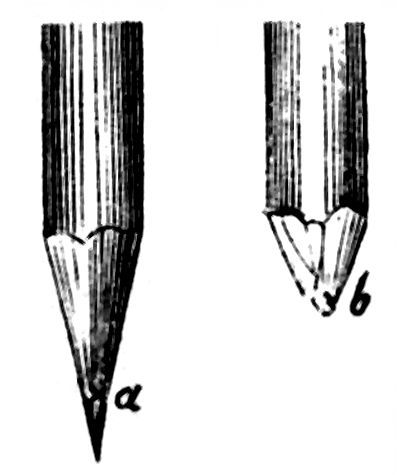
Fig. 1.
To cut your Pencil properly.—As you cannot draw until your pencils are cut, we must request you to cut them, not like b in fig. 1, which is hacked; but cut it to a point, like a, fig 1. In cutting it properly you must not remove too much of the wood, but only sufficient to expose a small part of the lead; if too much of the lead is exposed it will break.
Position during drawing.—It is of great importance that the student should sit to draw in a proper position. Do not have a low table, which obliges you to poke your nose almost upon the paper, and press your chest against the edge of the drawing desk; but sit in an easy, upright position, with your feet straight before you, the left hand resting upon the edge of your paper so as to keep it steady; the copy before you and nearly upright, and the sheet of paper upon which you are to draw slightly elevated.
The proper position to hold your pencil should be that the ends of the fingers are about an inch and a half from the point; and the pencil should not be held too tight, the elbow being kept well in towards the side, but not too stiff; by this means you will have perfect freedom of the hand, and complete command of the pencil.
Second Lesson. As you are now prepared to commence your drawing, please seat yourself properly at the table, and make an effort to form straight horizontal lines, like a (fig. 2), and observe that they are to be parallel, and at equal distances from one another. When you have succeeded in drawing a dozen of these lines the size of the copy, you should then try to form some twice the length, and then go on, increasing the length of them, until you are able to draw lines a yard in length with a piece of chalk upon a black board.
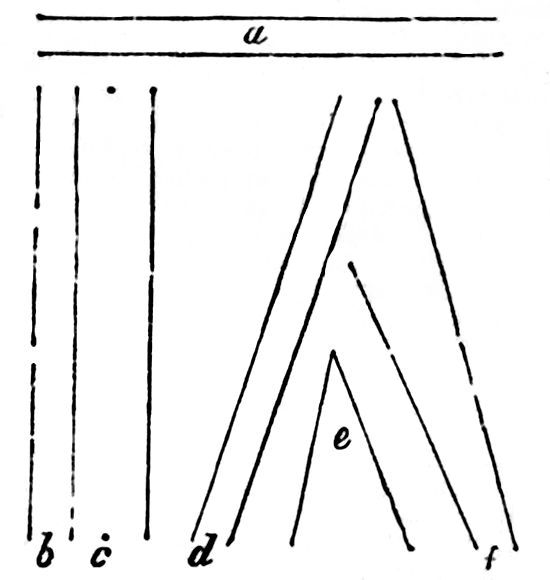
Fig. 2.
To draw horizontal straight lines.—First make a dot upon the paper where you are to commence, and another where the line is to terminate (as c, fig. 2.) then draw a line, between the two, from left to right, the same as between these two points.
: :
Continue to do this until you are able to draw the lines straight and horizontal; then practise making perpendicular lines.
To draw perpendicular straight lines, proceed the same as if drawing horizontal lines; that is, by making dots or points first, and commence with short lines, like the upper one of b (fig. 2). Then increase the length, until they double and quadruple the original ones.
When you have succeeded in drawing either horizontal or perpendicular straight lines, repeat the exercises with the different pencils, so as to give greater breadth to some lines than to others; and sometimes draw the lines very close together, at other times very wide apart, and afterwards fill up the intervening spaces with lines. By this means you will acquire a correct eye and idea of the rudiments of form and proportion.
To draw oblique lines, you should place the dots upon the paper as usual, and practise forming lines from right to left (as d, fig. 2), and afterwards from left to right (as f, fig. 2). When you have acquired sufficient command of your pencil to form the various lines correctly, quickly, and freely, join two of them together, so as to appear like e (fig. 2).
Draw the lines whether they be oblique or slanting, perpendicular or upright, and horizontal, or in a line with the floor, in every kind of manner, sometimes beginning at the right hand side and sometimes at the left; at one time at the top of the line, at another at the bottom of it. Do this, practise often, strive to overcome all obstacles, and depend upon it you will accomplish wonders.
As you have learned to draw straight lines parallel to one another, it will be necessary to make you connect them in some way, so as to form the outline of an object.
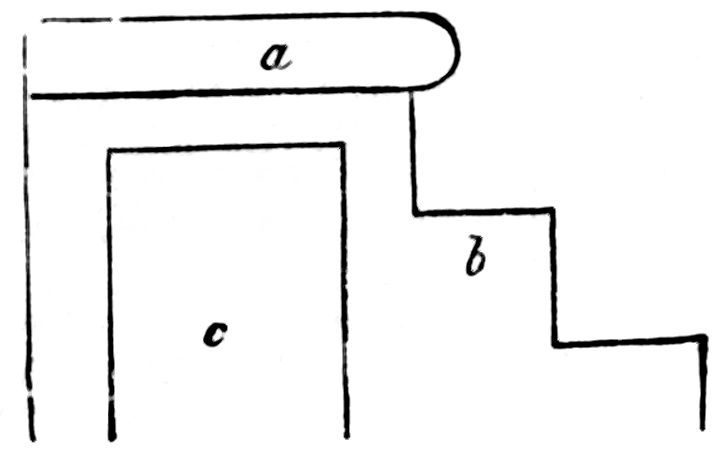
Fig. 3.
Draw two straight lines parallel to one another (like a, in fig. 3); then connect the ends of them by a small curved line, and from that draw a short perpendicular and a short horizontal line (as b, in fig. 3); repeat, until the outline of a set of steps is complete.
Draw a horizontal straight line, and from either extremity of it draw two perpendicular straight lines (as in c, fig. 3).
Draw two oblique lines, so that their lower extremities shall meet (as in a, fig. 4). Then draw two parallel straight lines, so that the beginning of the upper one shall be almost immediately over the end of the lower one, and join the ends of these lines with oblique lines (as b, in fig. 4).
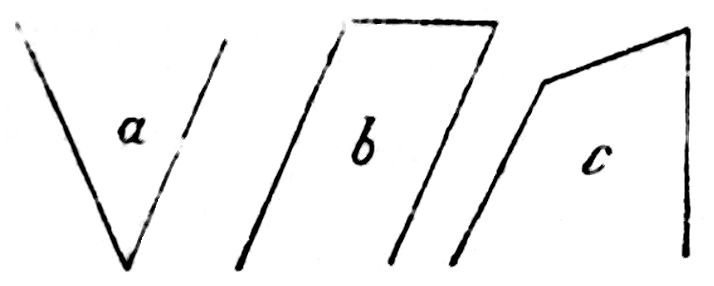
Fig. 4.
Draw a perpendicular straight line, and from the upper end of it, an oblique line from right to left, then unite the end of the oblique line to another oblique line (as in c, fig. 4).
Draw a perpendicular line, and from the lower part of it draw a horizontal line from right to left, (as b, in fig. 5).
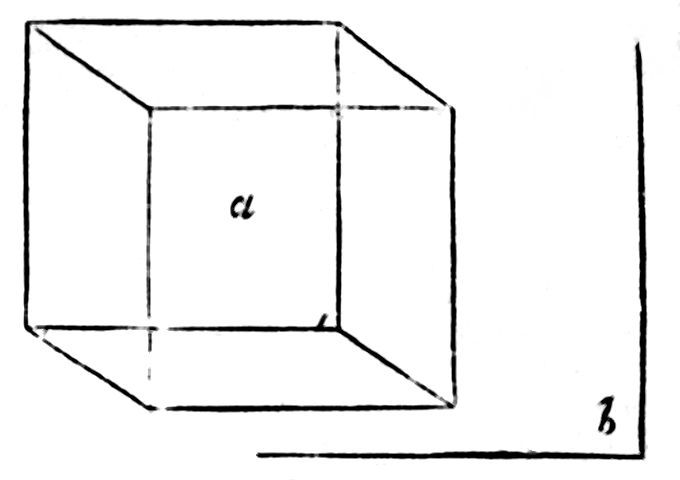
Fig. 5.
Draw four horizontal lines, and then join their extremities by four perpendicular lines (as in a, fig. 5). This will represent a block of wood (called a cube in geometry), having six faces, and eight corners or angles, like a die.
Here is another geometrical figure which you are requested to copy. To do so correctly, begin by making two dots and then forming the upper line; then calculate that the distance of the second line is twice the depth of the fore-part of the stone (which is represented in fig. 6), and draw a very faint short stroke to fix the distance.
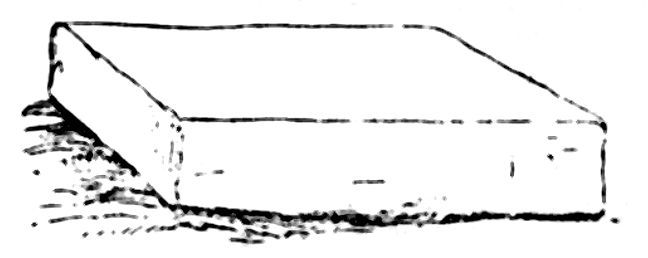
Fig. 6.
You must now fix the place to commence the second line, and you therefore place a dot at about the same depth as the fore-part of the stone towards the right and another dot at about one and a half of the depth from the right of the end of the upper line; then draw a line between the two dots. Join the ends of these two lines by oblique lines, as represented in the figure above, and proceeding in the same manner to place dots upon the paper for the other parts, draw the short perpendicular lines and the oblique and horizontal lines. The figure is now complete in outline, and you must therefore finish it by the addition of a few strokes and dots, as shown in the figure.
To form the outline of the figure, use a F pencil, and a HB to fill in the other strokes.
Here is another figure that you must practise frequently, because it will give you a fair knowledge of the combination of form and proportion, and will school your eyes to the perspective of solids. In this, as in all cases, proceed by making dots before you commence drawing your lines; and we merely repeat this again because we wish our pupils to understand most distinctly that no line should be drawn until the length of it has been marked upon the paper by dots.
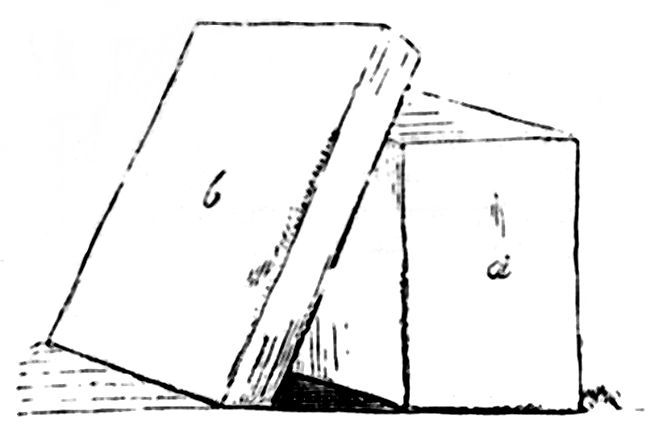
Fig. 7.
When you have drawn the upper horizontal line (of a, in fig. 7), draw a perpendicular line from each end of it, and let each of these lines be one and a half the length of the horizontal line; then unite the two lower ends of the perpendicular lines. Now draw a faint horizontal line along the base of a, and at about half the height of the oblong a place a dot on the faint horizontal line, and another dot at rather more than a third of the length of the dot just placed upon the line from the left lower angle of the oblong. You must then place a dot at about half the length of the above distance above the horizontal line and the same distance from the second dot as the width of the base a. From these several dots, draw oblique lines, (as in b, fig. 7), and join them by other lines, as shown in the figure. You must now draw other short lines from the oblique ones to the face of the oblong, and finish the figure by a few short strokes at the base, as shewn in the above figure.
It is required to represent the two sides of a pyramid. Draw two faint horizontal lines b c, and another one a, perpendicular to them, then draw a line from c to b, commencing at the place where a cuts c: then draw another line from c to b one third longer than the line on the right of a, commencing at the point of junction between a and c. Place a dot on the left of the perpendicular a at nearly the same distance from it, as the space between the lines b and c and twice the length of the oblique line on the right of its base, between the lines b c. From this point or dot, draw lines to meet those drawn before, and the figure will be complete.
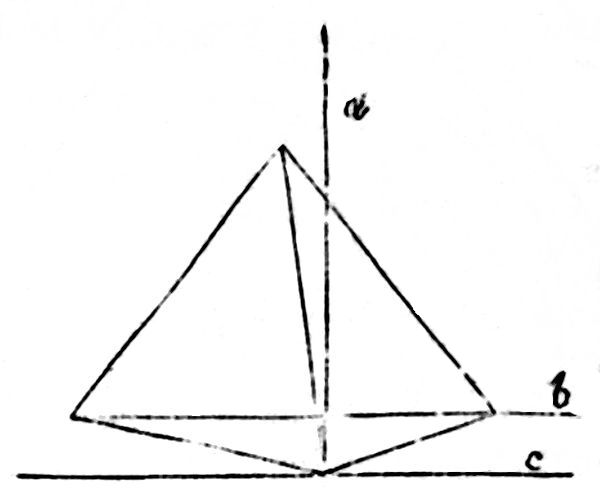
Fig. 8.
Draw a horizontal line, a b, and then draw a perpendicular line, c d, across it (as in fig. 9).
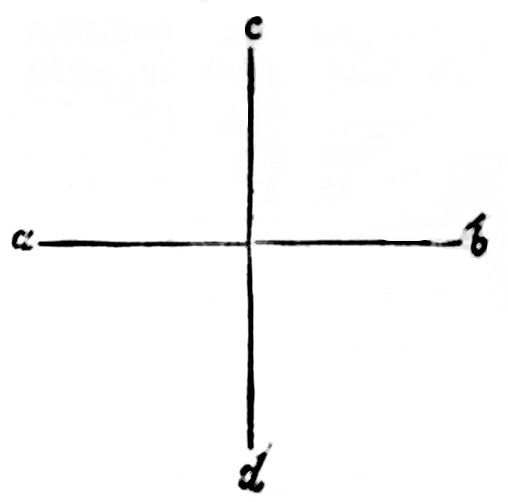
Fig. 9.
You will have formed four right angles a e c, c e b, b e d, d e a; but we are not going to study angles now; that is not our object. We wish you to notice our remarks and practise the figure; then when you can draw this well, you should draw the lines in different directions so near that c may be brought nearer to b, and d to a; by this means you will form various kinds of angles.
Third Lesson. You must now turn your attention to the drawing of curved lines. Unless you can draw a curved line accurately, in any direction, you can never hope to delineate the human figure or animals in a proper manner; for the outlines of both the animal and vegetable kingdoms are made up of curved lines of every variety. It is needless to give a long list of examples; the student will easily observe them in the objects around him, from the horse to the cat or diminutive mouse; or from the gay butterfly that soars above him, to the gnat, from which it has been transformed; or from the lofty oak to the humble acorn.
Commence practising the formation of curved lines, by drawing several like (a fig. 10,) and then, when you are able to do so accurately and easily, draw parallel lines with a greater curve, as (b fig. 10). When you can enlarge these copies upon a black board, with a piece of chalk, or reduce them with a pencil upon paper, then you may venture to draw a circle like (c fig. 10).
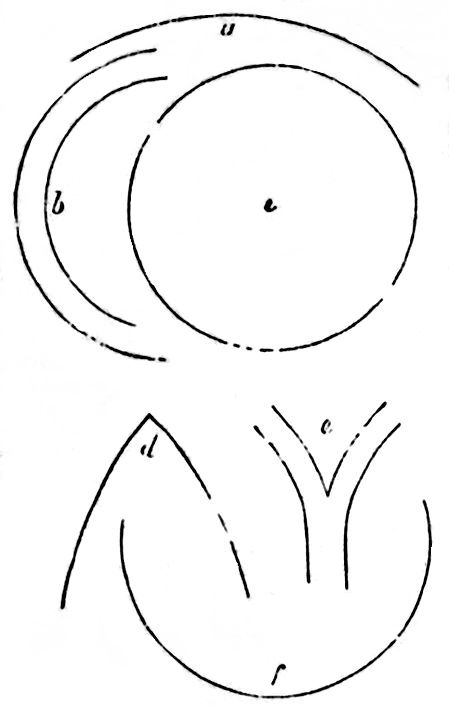
Fig. 10.
To draw a Circle.—Perhaps one of the most difficult tasks for the beginner is to draw a circle; but like everything else, it is easily done when you know how to set about it. Commence the task by making a faint dot upon the paper to mark the centre; then place another dot on either side of it and at equal distances, and continue placing dots at equal distances all around the central one, until a circle of dots is formed; you must then join all the dots with a steady and slow sweep of the hand, beginning at the top of the circle, and drawing from left to right, and right round from the point at which you started. Practise this several times as it will give you precision, and enable you to observe the relative distance of the outer part of the circle from the centre. Do not attempt to use compasses to draw a circle. They will not assist you; on the contrary, when you are without them, you will be at a loss, and unable to accomplish your object. Persevere, and practise continually, and your labours will be rewarded.
When you have drawn a few dozen circles by the aid of the dots, draw some without making any marks upon the paper or board; sometimes drawing from left to right, and at other times, from right to left.
Draw one circle within another, so that their margins shall be parallel, as in the portion of one shown in b fig. 10.
Draw a semicircle, (as f in fig. 10), and then practise forming d and e in the same figure, until you can join lines neatly, sometimes commencing from the lower part of the figures, and at other times, from the upper part.
Divide circles into sections, so as to exhibit the half, a quarter, a third, or other divisions of a circle.
Draw squares, polygons, and triangles within circles, and then construct a circle within a square.
Copy the following figure, and then proceed
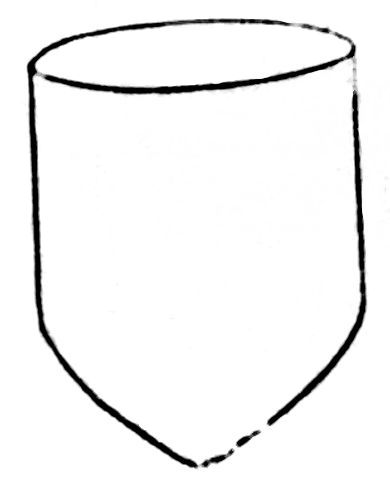
Fig. 11.
to draw the three following outlines,
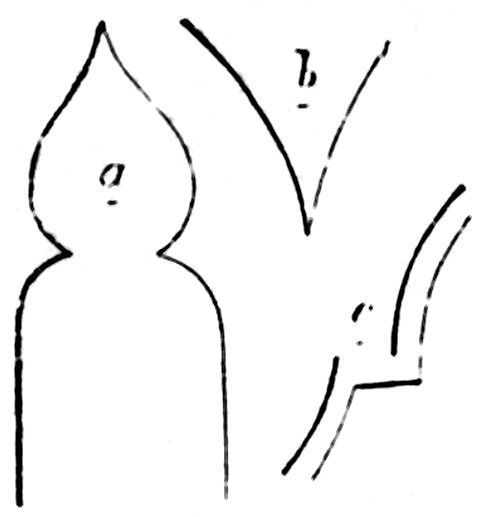
Fig. 12.
which you will no doubt do correctly and readily, from the practice you have already had in the curved lines. Be careful in copying a and c, to make the left-hand lines darker than those to the right, while b has lines of each breadth. It is well to use the pencil marked HB for this purpose, the different thickness of the lines being produced by the degree of pressure employed.
Fourth Lesson. In drawing lines, the hand should rest upon the two last fingers,—if the lines are short the motion of the hand should not extend beyond the wrist-joint; but if the lines are long, then the hand will glide over the paper easily, if it is carefully balanced and rests upon these fingers, while the motion of the hand proceeds from the elbow or from the shoulder.
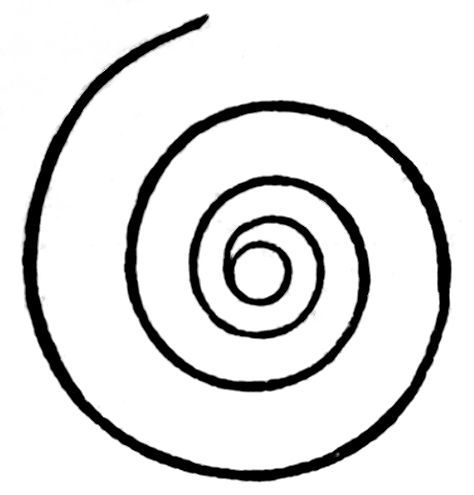
Fig. 13.
As you have already practised curved lines and circles, you will no doubt be able to copy this example, which is the outline of the volute of an Ionic capital from the Erictheum, at Athens.

Fig. 14.
It is needless to describe how it should be drawn, because if you have attended to the rules already given, you will be able to know how to proceed at once. Copy this example over and over again, enlarging and diminishing the copy, until your eye has become familiar with the figure; then endeavour to form its outline without having the example before you. When you have accomplished your task, you will be better prepared to copy the next example.
This drawing is a combination of curved and straight lines so arranged that they form the outline of the base of a column, and by copying this example frequently, you will acquire a very good idea of proportion. If you had not exercised yourself in drawing straight and curved lines, you could not have drawn this figure. You may, therefore, look upon straight and curved lines as the letters or alphabet of drawing.
Here is another example, composed of straight and curved lines, but differently arranged. In drawing this, commence by making a faint horizontal line upon the paper; then place a dot at a proper distance above, for the centre part of the arch; from this dot draw the right hand curved line until it meets the horizontal one, then place another dot a little above the horizontal line, at nearly the same distance as the height of the arch from it, and draw two parallel curved lines close together, from the top of the first curved line to the dot you have just placed on the paper. You have now formed the outline of the arch. Draw a horizontal line from each side of the top of the arch, and at the respective distances draw other lines parallel to it; then draw perpendicular lines between the horizontal ones, and you will now have formed the masonry. Sketch in the lines of the two banks, commencing with the left one, and afterwards sketch in the stones on the right of the base of the arch.
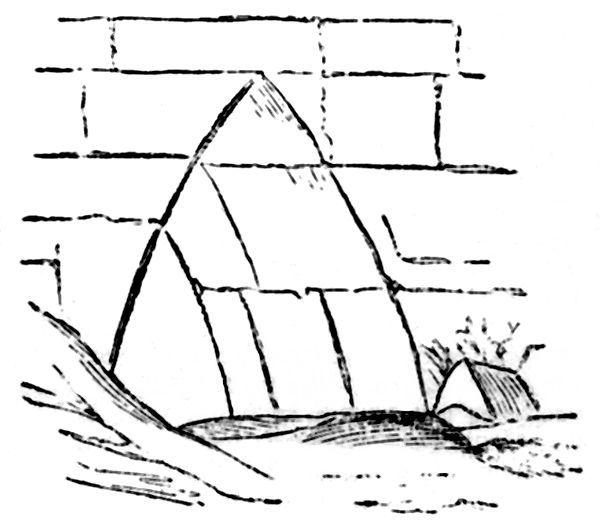
Fig. 15.
At rather more than half the length of the left-hand curved lines place a dot, and another, at about two-thirds the distance from the base of the right-hand curved line; connect these two dots by a curved line, and then sketch in the masonry of the archway, as in the example; all that now remains for you to do is to fill in the shading, which is done by making short parallel strokes at equal distances from each other, as in the example before you.
The next object that you are required to copy, is a pyramid, and you observe that the first example is sketched only in outline, in order that you may clearly understand how it is done.
When you have drawn the outline correctly several times, you may commence the next example (fig. 17) which you observe, is carefully shaded by drawing fine perpendicular parallel lines between the transverse lines, and all of them at equal distances.
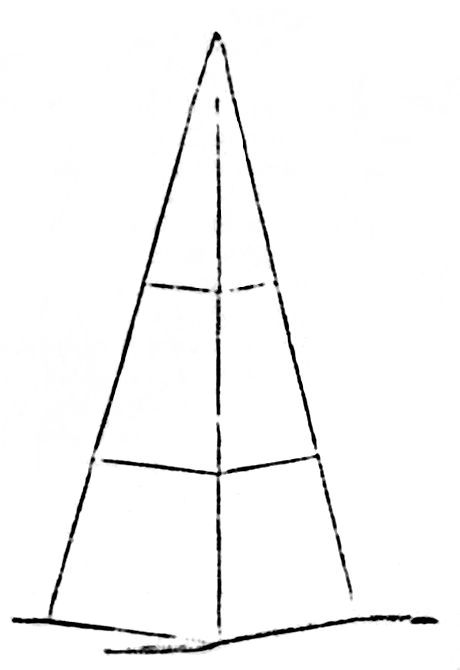
Fig. 16.
The shading at the base is drawn in a similar manner; the only difference being that the lines are horizontal, instead of perpendicular.
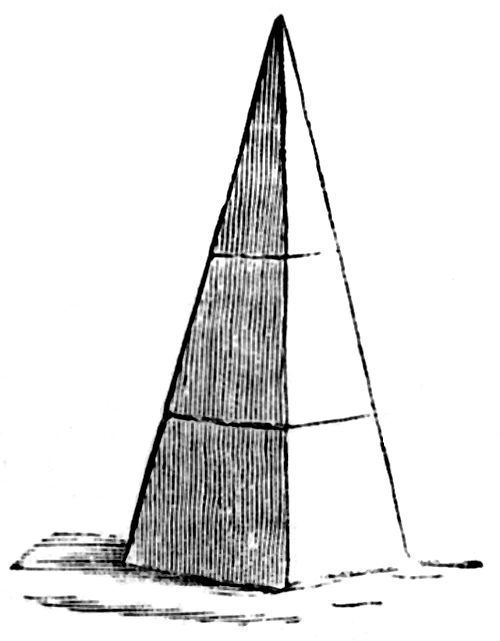
Fig. 17.
The next example is the outline of a pillar with a millstone resting against it (fig. 18); and when you have sketched this, it must be filled in, the same as the other example (fig. 19), which shows the same objects shaded, according to the method we have already pointed out. The weeds and grass require a few extra touches with an HB pencil, and the outline should be strengthened in the dark parts.
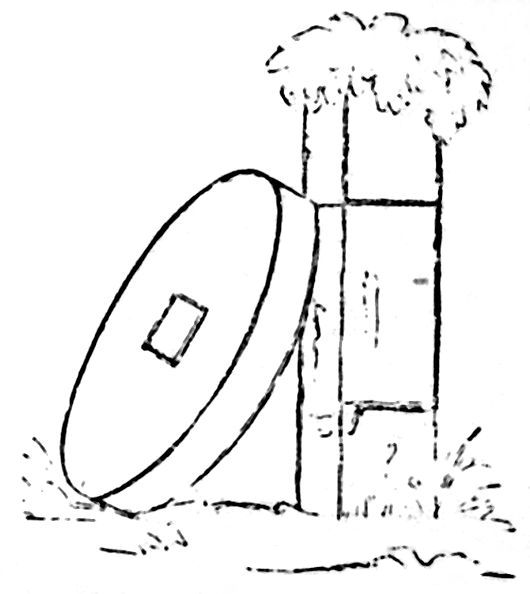
Fig. 18.
Practise these examples frequently, particularly the weeds at the top of the pillar, and the shading.
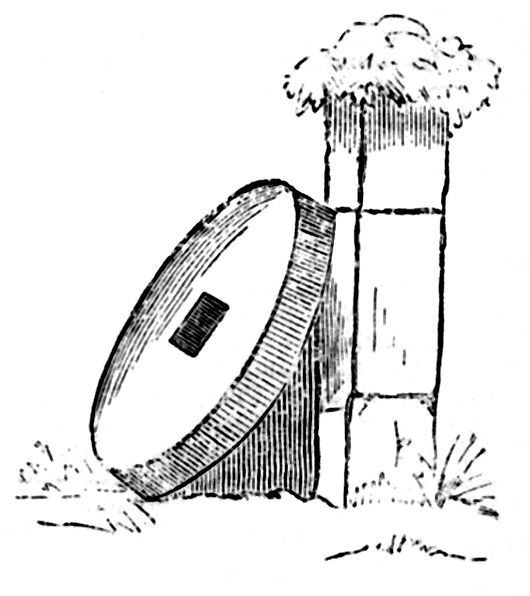
Fig. 19.
When you are able to draw these examples as they are represented here, draw them backwards; in other words, place the millstone on the right instead of the left of the pillar.
Draw examples 17 and 19, and shade them as if the light was on the left.
Fifth Lesson. Before submitting the examples we have prepared for this lesson, it will be necessary to make a few observations upon copying.
We will suppose that you have to copy a drawing,—perhaps an architectural one. How would you commence? Most probably differently to your neighbour, who would also commence differently to his neighbour, and so on, unless guided by correct principles. Do not imagine that what we state is without foundation, it is perfectly true; for, not long since, we placed two drawings of the same subject before four pupils, and requested them to copy them, and each one commenced differently. One of them began at the right-hand side, the other at the left, another at the top, and the fourth in the centre of the drawing. What could illustrate more forcibly than these blunders, that attention to the rules of the art is absolutely necessary?
You ask, “how am I to commence?” and to this question we will at once reply. First, enclose a certain space, by means of four lines, if for a landscape; or by an oval or circular line, if for a portrait, &c.: this is called the boundary line of the drawing, and is used to confine a certain portion of a landscape or other subject. The importance of attending to this rule will be obvious to every person; and when we treat hereafter of sketching from Nature, you will then find how essential it is to adopt this method. When the boundary-line is formed, your next care should be to determine the relative positions of the principal objects, points, or features, &c.; and if you have attended to the instructions given in the former lessons, you will not have much difficulty in doing so by faint lines and dots. In a landscape you will have to fix the height of the horizon, which should be done by first placing a dot at each side of the boundary-line, and then, if you have judged the distance correctly, uniting the two by a faint line drawn through the picture; this is called the horizontal line. When that has been done determine the nearest conspicuous object to the boundary line, its height, width, and relative position to the horizontal line, and other objects; then fix the position of the trees, distance, and foreground, by means of faint outlines, or dots, or both, taking care to observe their relative situations, inclinations, and measurements are regulated by their proximity to the boundary, horizontal, and base lines of the picture; the last-mentioned line, being the bottom or lower boundary line of the drawing.
In fig. 8, you were directed to draw a line perpendicular to the horizontal ones; this was done for the purpose of enabling you to judge the relative distances of the several angles of the pyramid from each other, and you will find it very useful to draw a line through the centre of any object that you have to copy, because it serves as a guide to the proper disposition of the several other parts. Of course, as you become more and more proficient in the art, this will not be always necessary.
We will now commence some practical illustrations of the preceding remarks. You are required to draw fig. 20, which is a centre-piece for a border, or an ornamental panel.
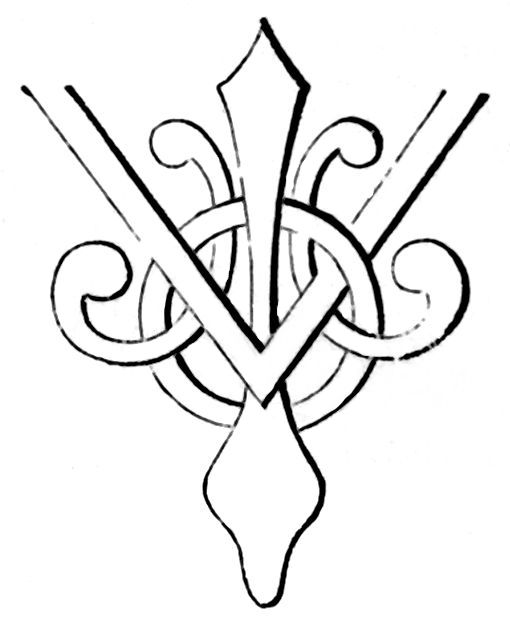
Fig. 20.
Fig. 21, is a diagram illustrating the method of doing so, which is thus: First draw three horizontal lines, a b, c d, e f, and bisect them with the perpendicular
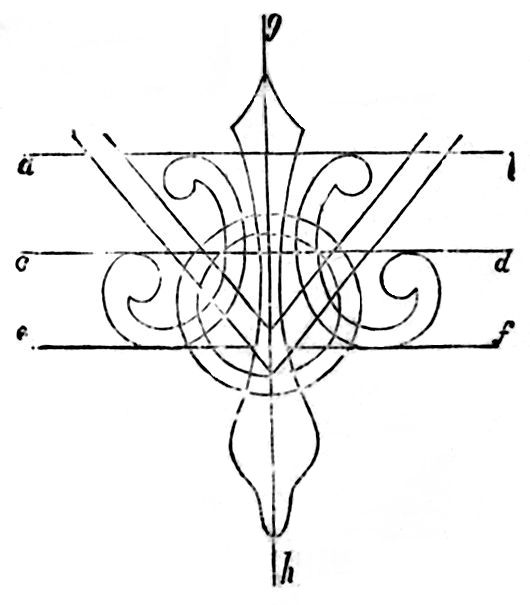
Fig. 21.
line g h. You have only to determine the relative distances of each point by means of dots, and to draw the curved and straight lines faintly, as shown in fig. 21, and afterwards to rub out the superfluous lines, and strengthen the outline by broad touches with an HB pencil.
We have found it an excellent plan to cut the Indian-rubber, used for rubbing out architectural and fine drawings, in a triangular shape, because the angles enable us to remove very small lines, or dots. The Indian-rubber should not be more than 1-4th to 3-7ths of an inch thick.
Our next example is of a different character, being the outline of an antique vase (fig. 22). In drawing this figure, a circle is first of all drawn, and then it is divided by two perpendicular lines, (as shown in fig. 23), and a horizontal line drawn above the circle. These lines are sufficient to enable the pupil to construct the figure with ease.
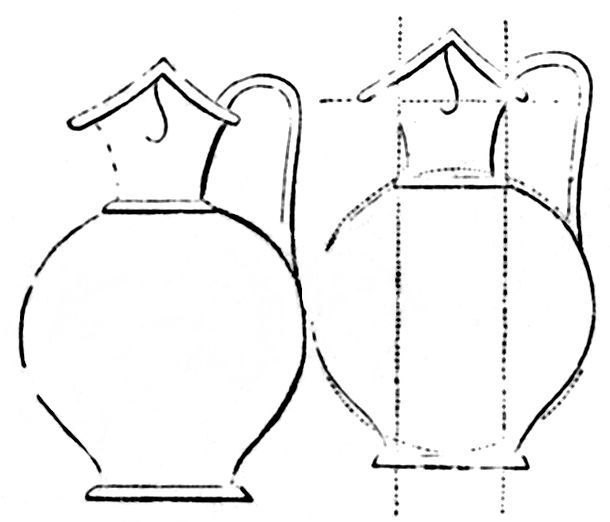
Fig. 22. Fig. 23.
Our next exercises are taken from antique vases, and given without any diagrammatic illustrations to enable the pupil to construct them; because, having already given ample directions, we wish pupils to think for themselves, so as to be able to act at times without the aid of an instructor.
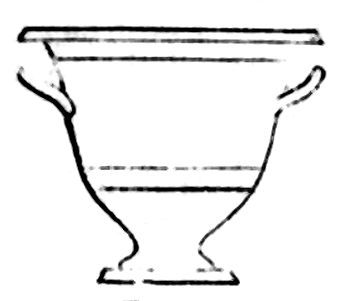
Fig. 24.
Sixth Lesson. We have now to consider the subject of “Outline,” a most important one to a draughtsman.
A simple perfect outline is more valuable that an imperfect one, worked up with all the skill of a Vandyke, Wilkie, or Landseer.
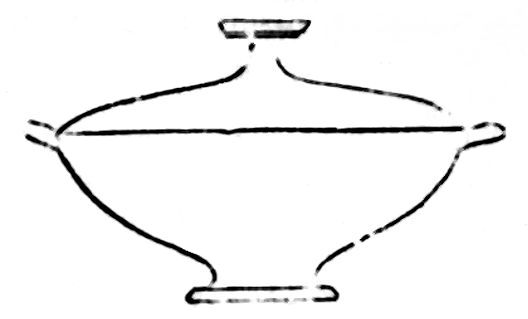
Fig. 25.
Many persons assert that the shading and filling up will hide some of the defects in a bad outline; but be assured that such advice is not only wrong, but highly injurious to tyros in the art of drawing; for opinions such as this are apt to undermine its right principles, and make beginners careless.
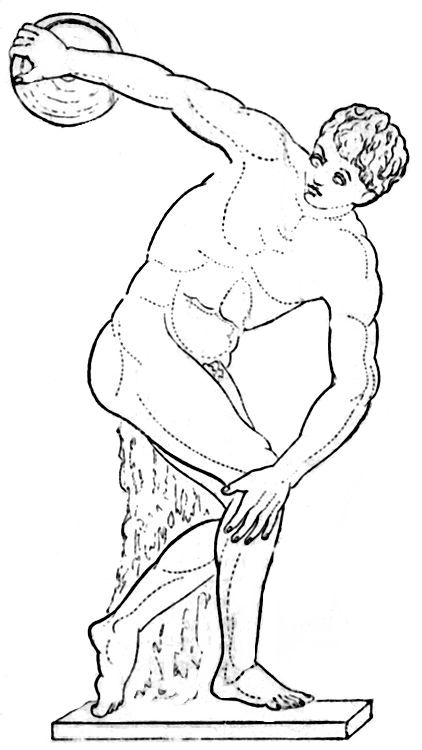
Fig. 26. The Quoit-thrower.
Outline signifies the contour, or the line by which any figure is defined, being, in fact, the extreme or boundary line of an object. It is the line that determines form. For example—the outline of an apple would not, if correct, convey an impression to your mind that it was intended for an orange or a pear; and if you look at figs. 22, 24, and 25, you could not imagine that they were like the ordinary jugs in use.
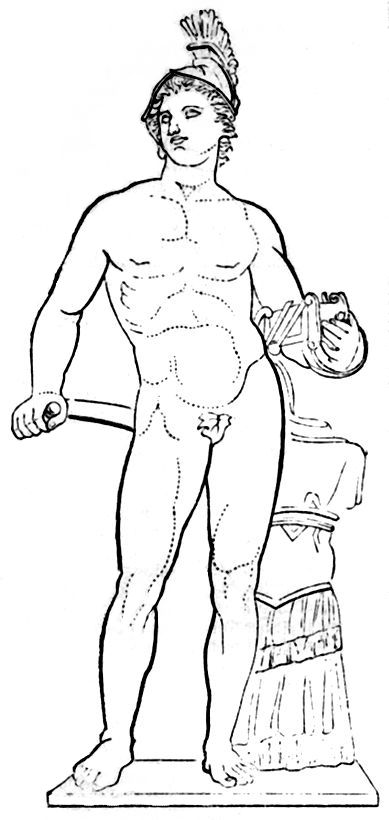
Fig. 27. Alexander.
Outline may be said to be the skeleton or anatomy of objects; at least it bears the same relations to them.
Outline cannot be formed without the aid of curved and straight lines (see Lesson 3.,) and in illustration of this, we beg to call the attention of our pupils particularly to figs. 26 and 27. The former represents the statute of the quoit-thrower of Myron, and the latter the statue of Alexander, by Gabius, after that of Lysippus, in the Louvre. They are both admirable studies for outline, particularly the latter, which exhibits gracefulness, courage, and strength, the muscles being admirably expressed without the aid of shading.
Of course, as you are now able to form lines of all kinds, in any direction, and of any reasonable length, you are already in possession of the alphabet of outline, and the rest depends upon yourself—for without constant application and attention you can never succeed.
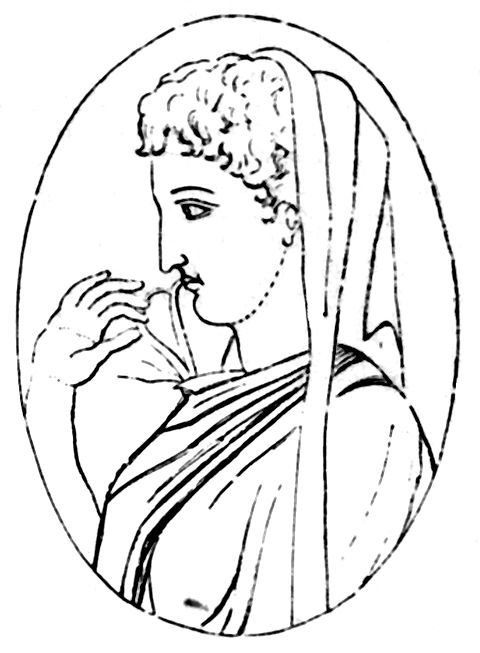
Fig. 28. Pysche.
Never be absurd enough to delude yourself, while you think that you are deceiving your relations or friends, by tracing outlines against a window. The practice cannot be too highly condemned, because it is contrary to art, honour, and good sense; and so long as you continue the system, it will be impossible for you to depend upon yourself.
All marks or lines that assist in expressing the character of the design, may be considered as belonging to outline.
There are many methods of producing effects by means of outline, besides adhering to the variations of form in the figures. For example—the lines used to express drapery should be flowing, continuous, and generally of variable breadth; those used for the flesh or for some kinds of fruit should partake of the same character; hard substances, such as armour, statuary, &c., should be expressed by uniform lines of a fine character; and foliage should be drawn boldly, with occasional dark touches, and with a tremulous lateral motion of the hand. The figure of Pysche, will assist the pupil in comprehending our remarks upon drapery and flesh.
Never jag your lines by making them by fits and starts; let the motion of your hand be free and uninterrupted, so as to form a continuous line; for if the pencil is removed from the paper, a line like a saw will be the result.
We need not remind our pupils that there are extremes of outline as in other things; the one is too great a uniformity of line, the other too great a variation of breadth of line. If the subject is intended to be finished in outline, the pupil should strengthen one side more than the other; and we recommend that the outline etchings issued by the “Art Union of London,” which are excellent compositions, should be carefully studied and copied.
If the subject is to be shaded, the outline should be lightly, and not too firmly, drawn.
We must remind the student in drawing, that to give a correct delineation of the human figure it is indispensable to have some knowledge of muscular action. It is necessary that all the muscles, their purposes and functions, should be well understood; nor must osteology, or the bones of the skeleton, be neglected.
Seventh Lesson. As you are now able to draw outlines correctly, it will be necessary to study light, shade and reflection, which will give the appearance of substance to the objects you wish to delineate.
If we consider light as applied to drawing, we must do so under four distinct heads,—1st, as natural light, or that emanating from the sun when it rises,—
“At morning, flinging wide
Its curtain-clouds of purple and vermilion,
Dispensing life and light on every side;”
2nd, as artificial light, or that derived from combustible bodies; 3rd, as direct light, or that light which reaches an object directly, without passing through or being reflected from one object upon another; and 4th, reflected light, or that light which, when it is received by one object, is thrown off or reflected upon another, as from glass or water.
However, we must request our pupils to try some simple experiments for themselves with regard to light before they enter upon their drawing-lesson of light and shade.
Place a cork upon the table in front of your window, and let its end rest upon a sheet of paper. You will observe a pyramidical dark shadow, the base of which commences at the cork, and also a pyramidical faint shadow, the apex or point of which corresponds with the base of the dark shadow; and you will also observe that a portion of the cork is faintly, another portion deeply, and another portion semi-shadowed.
Place the cork upon its side, and you will obtain nearly the same results; but with this difference, that the shadows are broader, and the effect produced less striking.
Substitute a billiard-ball, a marble, or a bullet for the cork, and the effect is nearly the same, only that the shadow is elliptical, or somewhat oval, instead of pyramidical.
Roll up a piece of paper so as to form a cone, gum down one of the corners, and cut off the base, so as to be even; then set this upon a piece of paper, and you will obtain the same shadows as when you employed the cork, which may be easily proved by placing them side by side.
Many similar and simple objects will readily suggest themselves to the pupil, and should be used as familiar examples to practise light and shade.
From what you have seen, it will be evident that all opaque or non-transparent objects, upon which light happens to fall, must be partially in shadow, whether the light falling upon them be reflected, natural or artificial; while other parts will be illuminated, and therefore placed in strong contrast with those parts of the object that are in shadow.
Shading is intended to impart the appearance of solidity to objects, so that the amount of depth of shading in a drawing conveys the idea to the mind of the beholder—1st, that the object delineated is in relief, or projects from those surrounding it; 2nd, as regards the relative position of one object with regard to another; and 3rd, the distinctive distances of objects from the person viewing them.
Shadows are either natural or accidental. Natural shadows are those that the lover of nature beholds as he rambles through the lone copse, the tangled wood, or river’s margin, where
“The barks at anchor cast their lengthened shades
On the gray bastioned walls.”
Those who aspire to be artists—nay, even the timid amateur, content to toil over the well-beaten path that thousands have journeyed over before—must ever be on the alert to gather studies from nature, as
“The shades of evening softly creep”
over the gentle slopes where innocent lambs feed, or frisking kids nip the tender grass; nor must they despise the lessons furnished by many a quickset hedge or ruined wall, over which
“Some trees
Whose massy outline of reposing shade”
seem placed to tempt the artist to linger on his journey and take a sketch. We have several lovely sketches of what artists term “bits,” snatched in haste from many a bright spot where we have rested in our rambles, even as the
“Shadows, nursed by Night, retire,”
or the sun’s bright beams were first welcomed by returning morn. These each convey lessons—pleasing lessons—not only of artistic but of religious instruction, which gushes forth as we view their beauties. To enjoy such thoughts, to sketch such views, and to treasure up their lessons, we must leave the busy haunts of men, and freed from care, and toil, and noise, seat ourselves beneath the umbrageous arms of some ancient tree, and gaze upon
“A surface dappled o’er with shadows, flung
From many a brooding cloud.”
If a ball is placed upon the table, and a ray of light is allowed to fall upon it, the side near to the light will appear different from the other part upon which the light does not fall, as may be seen in fig 29,
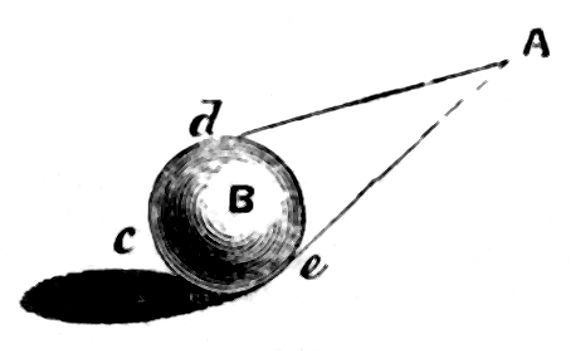
Fig. 29.
in which A represents the point from which the ray of light proceeds until it falls upon part of the ball, d e, which thus receives direct light, while the other part (c) is in natural shadow or shade. You will also observe that there is a long pyramidical shadow thrown upon the table, the result of the non-transparency of the ball.
Having directed your attention to the preliminary and important points connected with light and shade, it now becomes necessary to make some observations upon shading.
In shading there are three kinds of manipulation requisite—1st, waving; 2nd, stippling; and 3rd, cross-hatching. There are certain rules connected with shading which must be generally observed; for it will be found that much of the appearance of objects depends upon the shading employed; for it is by means of the kind of lines used that the projection of bodies from one another, and the appearance of the materials of which they are constructed, are conveyed to those who only possess the opportunity of viewing the sketch. Colour is at all times better adapted to depict the skies, portraits, &c., than drawings of uniform tint, however well the latter may be executed.
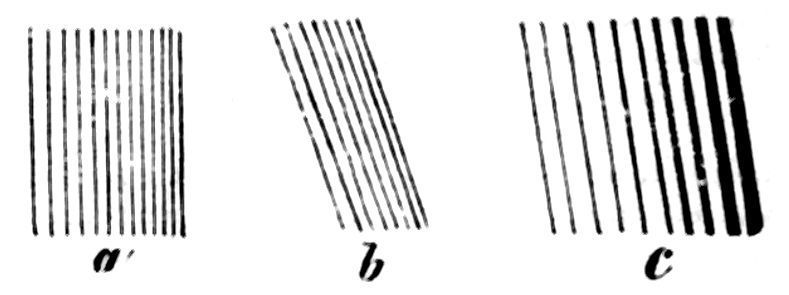
Fig. 30.
The strokes used in shading may be of uniform thickness or not, and they may also be placed at regular or irregular distances. If of uniform thickness (as a, fig. 30), they give the same tone to a drawing that one colour would, if it were placed upon the paper; but if the same strokes are drawn closer together in one part of the drawing than in the other (as a, fig. 30), then that part will have a deeper tone. The same result holds good with respect to oblique lines (as in b, fig. 30). If the lines become darker or broader, and nearer to each other as they recede from the light, then they will convey the impression of an increased depth of tone (as in c, fig. 30), whether the lines be oblique, perpendicular, or horizontal. All lines used in shading do not take the same direction, as, in addition to those mentioned above some are semi-circular.
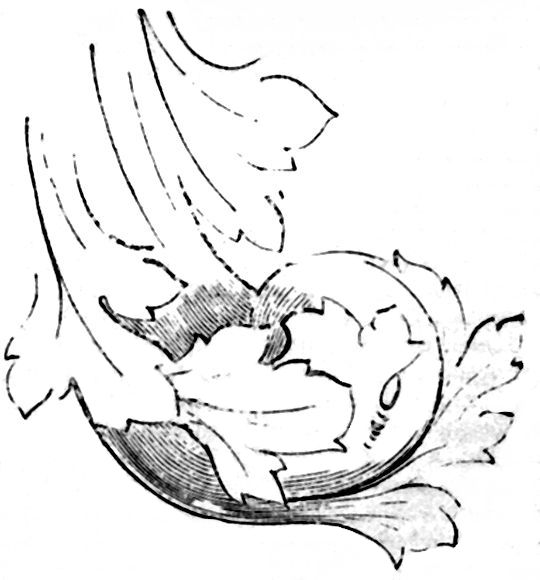
Fig. 31.
Here is a figure (fig. 31) that combines outline and shading, and forms an excellent study for the beginner in both, as in the former lesson, it serves to illustrate the beauty and grace of curved lines, and in the latter, of uniformity of shading.
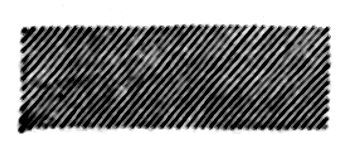
Fig. 32.
Waving shading is produced by a succession of strokes close together, by using a soft pencil (F or B) with a worn point. If these lines are made with a fine-pointed pencil, there is not a uniformity of tint produced, and therefore the lines should not overlap one another, but be drawn as in fig. 32. Foregrounds, and deeply-cast shadows, broken earth, &c., require this kind of shading.
Stippling consists of a series of dots, which impart a depth or lightness of shade, just as they are made large or small, or closer or farther apart; the general rule being to make the large and close together in the depth of the shade, and gradually small and wider apart as the light is approached.
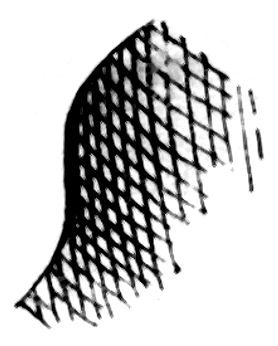
Fig. 33.
Cross-hatching is produced by drawing a number of lines in such a manner that they cross one another at right angles. They should always be commenced from the outline as in fig. 33, and one direction of lines finished before the other cross them; otherwise unevenness of tone will be produced. They should always be thinner as they approach the light, and also wider apart. In curved objects it is necessary to observe the relative convexity and concavity of the surfaces, and to represent them by lines exhibiting a greater or lesser curvature, taking care to increase their breadth in certain parts, and diminish them in others, as may be seen in the most common engravings of concave or convex objects.
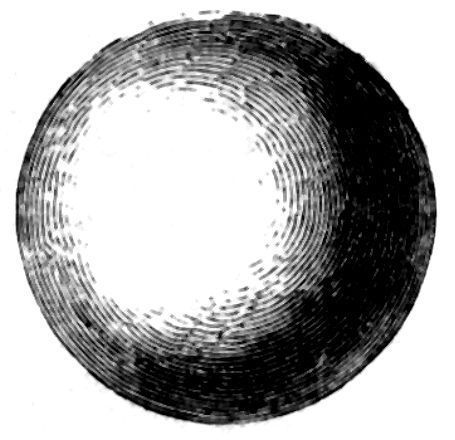
Fig. 34.
The general rule for shading is, that flat surfaces must be represented by straight lines; convex and concave surfaces by curved lines, as in fig. 34, which represents a ball, and shows the manner of increasing the depth of tone by drawing the lines closer to each other; and all surfaces of a mixed appearance must be dealt with according to circumstances; some parts requiring curved and other straight lines, while others again will require cross-hatched lines both curved and straight.
Remember that much of the perfection of shading consists in the knowledge of how much you can do, and no more, and how much your pencil will do. In order to attain perfection or even mediocrity in this department of drawing, you should practise strokes of every description, with each kind of pencil, upon sheets of paper, marked at the top thus—H: H.H: H.H.H: &c., and practise with fine-pointed and worn-pointed pencils, sometimes plain, at other times curved, and also cross-hatched strokes. By this means you will ascertain the power of your hand, and the tone of your pencil.
It is contrary to our practice to recommend any person’s wares, and therefore we refrain upon the present occasion. However, we would advise our pupils always to purchase the best drawing materials. They are the cheapest in the long run, and will always reflect credit upon the draughtsman. Bad tools often make bungling workmen.
PHOTOGRAPHY. The Daguerreotype process consists in exposing a silvered copper plate to vapour of iodine, whereby a film of iodide of silver is formed on the surface; then placing it in the camera, so that the light may act upon it in certain parts, and reduce the iodide of silver to the metallic state; and afterwards exposing it to vapour of mercury. The mercury adheres in minute globules to those parts on which the silver has been reduced. Lastly, the plate is washed with a solution of hyposulphite of sodium, to remove the iodide of silver, not decomposed by the light. In the Calotype process, the picture is taken upon paper. The paper is prepared by immersion first in a solution of nitrate of silver, then, after drying, in a weak solution of iodide of potassium; after which it is soaked in water for a quarter of an hour, and then dried, first with blotting-paper, and afterwards before the fire. The paper thus prepared is called iodized paper; it is not sensitive to light. When required for use, it is washed with a liquid prepared by dissolving 100 grains of crystallized nitrate of silver in two ounces of distilled water, adding to the solution its own volume of strong acetic acid, and mixing the solution thus formed with from one to twenty volumes of a saturated solution of crystallized gallic acid in cold distilled water. These operations must be performed in the dark. The paper thus prepared is highly sensitive, and is fit for taking pictures in the camera. The picture thus obtained is a negative one, being darkest in the parts where the strongest light has acted on it. When first produced it is generally invisible, but may be brought out by again washing the paper with a mixture of one part of the silver solution with three parts of the saturated solution of gallic acid. It is then to be fixed by washing it with water, lightly drying between blotting-paper, and washing with a solution of bromide of potassium. From the negative picture thus produced, positive copies may be obtained by placing it with its face against a piece of ordinary photographic paper (prepared by washing good writing paper with a solution of common salt, then wiping it dry, and washing it with nitrate of silver), pressing it into close contact by a board above and below, and exposing it for a short time to sunshine. Finally, it is to be fixed by immersion in a hot solution of hyposulphite of sodium. Such are the general principles of these processes.
INVISIBLE INK. The most curious of all kinds of sympathetic ink, is that from cobalt. It is a very singular phenomenon, that the characters or figures traced out with this ink may be made to disappear and re-appear at pleasure. This property is peculiar to ink obtained from cobalt, for all the other kinds are at first invisible, until some substance has been applied to make them appear; but when once they have appeared they remain. To prepare this ink, take zaffre, and dissolve it in nitro-muriatic acid, till the acid extracts from it the metallic part of the cobalt, which communicates to the zaffre its blue colour; then dilute the solution, which is very acrid, with common water. If you write with this liquor on paper, the characters will be invisible; but when exposed to a sufficient degree of heat they will become green. When the paper has cooled they will disappear. Observe, if the paper be too much heated, they will not disappear at all.
STEAM NAVIGATION. In December, 1736, a patent for a steam-boat was taken out by Jonathan Hull, and a drawing and description of the same was published in the following year. From want of encouragement to the inventor the boat was never constructed. About twenty years later, two Americans, and Thomas Payne, each claimed the honour of inventing steam-boats, but none of the plans were brought into practice. It is believed that the first steam-boat ever known to succeed, was the joint invention of Mr. Miller, a Scotchman, and his family tutor, Mr. James Taylor. In 1788 they constructed a boat with paddles, moved by steam-power, which was tried on the lake of Dalswinton, Dumfriesshire, and found to realize the expectations of the inventors. In the following year a larger vessel was constructed, by Mr. Miller, at the Carron Foundry; it was tried on the Forth and Clyde Canal, in November, 1789, and was found to travel at the rate of seven miles an hour. A misunderstanding having occurred between Messrs. Miller and Taylor, Mr. Symington, the maker of the engines in their boats, took up the project, and built another experimental steam-vessel, which was tried with success on the Forth and Clyde Canal, but was interdicted by the Canal Company, on account of its motion destroying the banks. This vessel, while it lay at Lock 16, was inspected by Mr. Fulton, accompanied by Mr. H. Bell, of Glasgow. In 1807, Mr. Fulton launched a steam-vessel on the Hudson; and in 1812, Mr. Bell launched another on the Clyde. These were the first vessels used for the service of the public. Fulton’s first vessel was ill-constructed, but he afterwards built vessels with various improvements, and every effort added to their utility and fame. In a few years afterwards, steam-boats were introduced into Britain, when “every method that ingenuity could suggest towards their improvement was called into action; till at length the inexhaustible resources of national art and science produced those ocean steamers which float across the Atlantic—the triumph of art, and the admiration of the world.”
AQUEOUS. Water is required not only as the medium of conveying the other substances into the body, but it forms a prominent constituent of the body itself. Blood contains 790 parts of water to 210 of solid matter in every 1000. Muscles contain 770 parts of water to 230 solid ingredients. The brain and nerves contain about 800 parts of water in 1000. If food does not contain water naturally, it is taken into the system in the form of tea, coffee, beer, and also in its pure state. The quantity of water taken with the food should be about in the proportion of four to one, as we find it in milk. We cannot, however, judge of the quantity contained in solid food till we know its composition. Thus many substances which appear solid contain large quantities of water. In potatoes, for instance, there are 75 parts of water in every 100 parts.
OLEAGINOUS. The butter of the milk represents oily and fatty matters in general, which seem to enter into the composition of all healthy food. They are taken by the inhabitants of tropical countries in the seed of the cocoa-nut, as well as by those of the polar regions from the fat of the seal, and many kinds of fish. They are obtained from both the animal and vegetable kingdoms, being known by the name of suets, fats, and lards, from the former source; and oils and butter from the latter.
SACCHARINE. The sugar of the milk represents several substances obtained from plants and used as food. Sugar itself varies in its composition according to its sources; hence we have cane-sugar, grape-sugar, maple-sugar, &c. Sugar has also a composition nearly approaching that of starch, and this substance is very generally found in the vegetable diet of man; pure in the form of arrow-root, tapioca, and sago; combined in the flour of wheat, and other cereal grasses. Of all the animal products used as food, sugar is found alone in milk.
PROTEINACEOUS. The casein of the milk—which when separated, is known by the name of cheese—has, in common with two other vegetable and animal substances, called fibrine and albumen, a principle for their basis named protein. These substances form the chief part of the fabric of the body, and in their capacity of food, perform a very different function in the body to the butter and sugar before mentioned.
INORGANIC. The salts of milk are the saline substances, which entering into the composition of various parts of the human body, are necessary to its integrity and health. The importance of the presence of these substances is frequently overlooked in food, and many diseases of the human frame arise from their absence. They are conveyed into the system in both animal and vegetable food; but in common salt we have an instance of a substance belonging to this class, taken directly from the mineral kingdom, as food, without the intervention of an organic body.
PORES OF THE HUMAN BODY. The skin of the human body is a very curious object for the microscope. By cutting a thin piece with a very sharp penknife or razor, and applying it to a good microscope, a multitude of small pores will be seen, through which the perspirable matter is supposed to be perpetually transmitted. These are best seen in the under or second skin. There are said to be 1,000 pores in the length of an inch; and of course, in a surface an inch square, there will be 1,000,000, through which, either the sensible or insensible perspiration is continually issuing. If there are 1,000,000 pores in every square inch, the following calculation is made of the number contained in the whole body:—
The surface of the body of a middle-sized person is reckoned to contain 14 feet; and, as each foot contains 144 inches, the number of pores will be estimated at 1,000,000 × 144 × 14 = 2,016,000,000, or two thousand and sixteen millions.
COIN (GOLD AND SILVER). In 1717, gold was made to bear, for the first time, a fixed price in silver coin, the guinea being ordered to pass current at, and for no more than 21s. By this regulation, a guinea and 21s. in silver became equally legal tenders, and so they continued from 1717 to 1774, except that from 1750 guineas were not allowed that privilege if they were deficient in weight more than five grains. The standard fineness of our silver coin was, from the earliest time, three grains alloy in forty grains. Fine gold is worth 2 and one-eighth of a penny per grain; crown gold, 2d. per grain. A Tower pound, of 5,400 grains, at 2 and one-eighth per grain, is equal to a Troy pound of 5,760 grains, at 2d. per grain. The standard fineness of our gold coin was, till 1527, half a grain alloy in 96 grains. The old standard is called fine gold, the new, crown gold. The Tower pound was in use till 1327; since that period the Troy pound has been the standard at the Mint. The seven-shilling pieces of gold have not been in general issue since 1797. From 1774 to 1797, silver coins to an amount not exceeding £25 at one payment, and silver bullion to any amount at 5s. 2d. per ounce, were made a legal tender, with guineas which had not lost more than one grain of their full weight.
NATIONAL DEBT. The national debt is the amount of sums owing by a state to persons who have lent money to it, to enable it to carry on wars and other operations. A stipulated interest is paid to the national creditors or fundholders. The custom of borrowing money, and thus anticipating the available revenue for war purposes, was introduced in the reign of William III. Thus posterity is taxed, for wars of which perhaps it will disapprove. The total amount of the national debt of Great Britain is now upwards of eight hundred millions.
TAPE-WORMS. The tape-worm is found in the human intestines, and attains the length of three or four yards; occasionally even more than this. Now, one curious fact about it is, that the very same species that infests the natives of Great Britain, infests also the Dutch and Germans. Another species, Botriocephalus latus, is peculiar to the Swiss and Russians; while the inhabitants of the French provinces adjoining Switzerland possess the unenviable distinction of being infested with both. It is strange that these creatures should thus be restricted to certain countries, as they are, by their mode of life, exempt from all “the skyey influences.” Perhaps some of my readers may be inclined to speculate on this very singular fact, and infer that honest John Bull must have something about him akin to “the stuff” that Dutch and Germans are made of, when parasites of the same species attack them in common, and avoid the Russians and Swiss. But this were to “reason too curiously;” for an Englishman might be infested with the Tape-worm of Russia, if he became for a long enough time resident in that country.
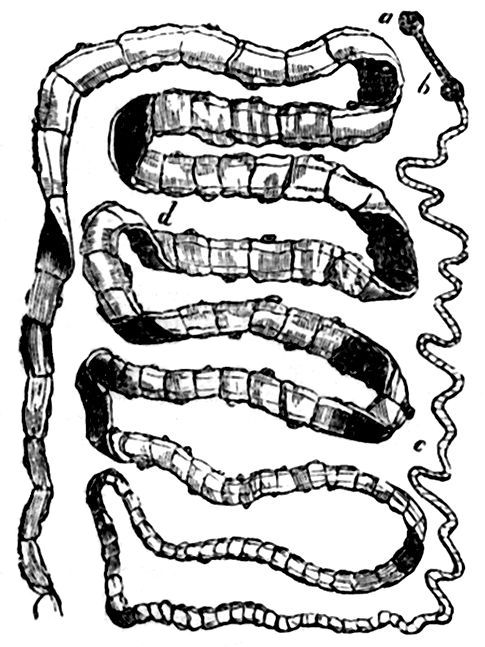
The head of the Tape-worm is furnished with suckers and recurved hooks, so that it can retain a firm hold. Like the root of a plant, it imbibes the nutritive juices required for the support of the entire structure. Each of its numerous joints possesses within itself the means of producing thousands of fertile ova. These joints break off, separating from the stem, as branches heavy with ripe fruits from a richly-laden tree. But a strange mode of reproducing them is provided. The joint next the head divides into two joints; each of these expands and then divides in like manner: so that the egg-producing segments resume in time their former proportions, and thus one head may outlive successive generations of the other parts. “Is there any one,” says Professor Escright, “who, upon the contemplation of this wonderful apparatus, and the extraordinary results of its agency, can for a moment imagine that it is without an object or an end?” The Tape-worm is not produced by chance: no atoms of matter shaped themselves into the living animal, according to the hypothesis of equivocal generation. In all its wonderful details, the humble worm declares its Great Artificer; and Science stands—as true Science ever will stand—the handmaid of Religion.
HORSE. An animal, whose generic character is six front teeth in each jaw, with canine teeth on each side, remote from the rest, with undivided hoofs. There are six species, among which, besides the common horse, is a native of the middle regions of Asia, wild, and uncommonly swift. The other species are the ass, the zebra, the quagga, and the cloven-footed horse of South America. In England, we have many breeds, and the best in the world; but Arabian and Barbary horses are deservedly esteemed for their beauty and swiftness. English race-horses run two miles in three minutes; hunters are another class, combining strength with swiftness. Several counties have their breeds of draught horses, and the black Bakewell breed will draw three tons, or double the regular draught. The age of a horse is determined by the corner front teeth, adjoining the tushes; at four and a-half years these teeth are just visible above the gum; at five, the remaining colts’ teeth are shed, and the tushes appear; at six, the tushes are up, white, and sharp, with a small circle of young growing flesh, the mouth being then complete.
BILLION. This is a million times a million, which no one is able to count, however easy it may be to write it. You can count 160 or 170 a minute, but let us even suppose that you go so far as 200 in a minute, then an hour will produce 12,000; a day, 288,000; and a year, or 365 days (for every four years you may rest a day from counting, during leap-year), 105,120,000. Supposing that Adam, at the beginning of his existence, had begun to count, had continued to do so, and was counting still, he would not, even now, according to the usually supposed age of our globe, have counted nearly enough. For, to count a billion, he would require 9,512 years, 34 days, 5 hours, and 20 minutes, according to the above rule.
GLASS. The art of making glass was introduced into England from France, in the year 674, for the use of churches and monasteries. Benedict Biscop, who in that year founded a monastery, and attached to it an elegant church of stone, after the Roman manner, prevailed on some glass-makers in France to come over and glaze the windows. These artificers not only performed the work assigned to them, but also taught the English how to make windows, lamps, and drinking vessels. Before that period, the windows of houses and churches were filled either with linen, cloth, or lattices of wood; and even in the twelfth century, glass windows in private houses were very rare.
Discovery of Plate-Glass. Blancourt relates, as the mode in which the casting of plate-glass was discovered, that a person who was melting some of this material in a crucible, accidentally spilt it, while fluid, upon the ground. The metal ran under one of the large flag-stones wherewith the place was paved, which obliged the workman to take up the stone in order to recover the glass. He then found it in the form of a plate, such as could not be produced by the ordinary process of blowing. The man’s attention being roused by this fact, he was unable to sleep, and conceiving at once the superiority of this method for forming mirrors, he immediately commenced experimenting, and before the day had appeared, had proved the practicability of the improvement which the purest chance had thus placed within the sphere of his observation.
SHORTHAND. Among all the systems of shorthand, or stenography, we know of none less complicated than that of Taylor, improved by Harding. First, we give the alphabet:—
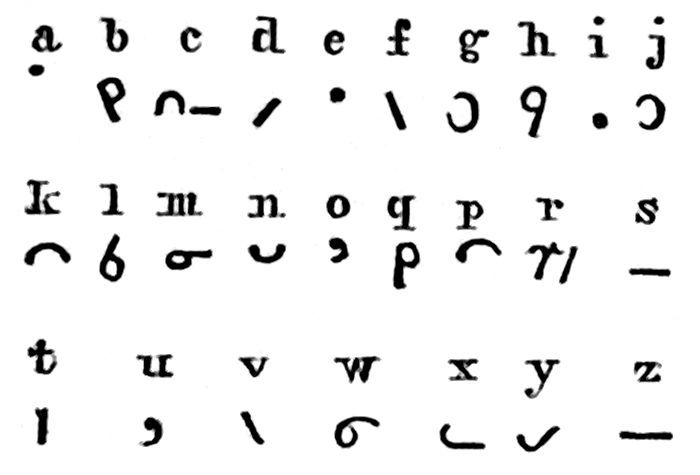
The vowels, it will be seen, are represented by points; the period representing a, e, i, the comma doing the same for o and u; each being further distinguishable by the position of the point. From the consonants, c and z are dismissed as needless; where the former has a hard sound, k is used; where a soft one, s. One character suffices for f and v, for g and j, and for k and q. Thus the consonants are reduced without difficulty or confusion to sixteen. The double consonants, ch, sh, th, &c., are marked by distinct characters. Again, single vowels are allowed to stand for words, as a for an. The and and are noted by commas, differently placed; b stands for be, by, and been, and so on. It is considered a good practical rule in learning, to test progress and efficiency by trying how rapidly the student can write the entire alphabet; to do it correctly four times in a minute, is good. The next source of gain is abbreviation, as by the use of single letters to mark the first and last syllables of words, b standing for abs, in absorb, for instance, d for dom in kingdom. It is known that these letters do not represent merely a letter, by their being slightly disconnected from the word to which they belong, while they are still so near that they cannot be mistaken for independent words. But whole words, of length, are also expressed by a letter or by a mark—these are called arbitrary, and vary according to the writer’s particular subject matter. Students of law, medicine, and divinity, reporters for newspapers, can each easily frame for themselves a plan of writing rapidly those special words which occur frequently to them, are difficult to write literally, and are not liable to be mistaken.
HEBREW ALPHABET. The Hebrew alphabet contains twenty-two letters. Their names may be found in regular order in the 119th Psalm.
ICEBERGS. Are immense bodies of ice, extending occasionally two miles long by one broad, and some hundreds of feet high, which are found floating in the polar seas, and are formed in two ways—in the sea itself, by the accumulation of snow and ice, or on precipitous shores, in glaciers, which are ultimately broken off by their own weight, and often carry with them enormous pieces of rock. These, as the icebergs melt, when floated into warmer regions, are dropped, with all their lesser earthy contents of gravel, &c., to the bottom of the ocean, and so help to raise its bed. The erratic masses of stone called boulders, found scattered in various parts of the world, on the surface, without any apparent connexion with the rocks in the crust beneath, are supposed to have been thus deposited in some remote time, when the locality was covered with the deep waters.
SIGNIFICATION OF CHRISTIAN NAMES.
Aaron, Hebrew, a mountain.
Abel, Heb. vanity.
Abraham, Heb. the father of many.
Absalom, Heb. the father’s peace.
Achilles, Greek, a freer from pain.
Adam, Heb. red earth.
Adolphus, Saxon, happiness and help.
Adrian, Latin, a helper.
Alfege, Sax. always merry.
Alan, British, swift like a greyhound.
Albert, Sax. all bright.
Aldred, Sax. the dread of all.
Alexander, Gr. a helper of men.
Alfred, Sax. all peace.
Alfric, German, all rich.
Alphonso, Gothic, our help.
Alwin, Sax. winning all.
Ambrose, Gr. immortal.
Amos, Heb. a burden.
Andrew, Gr. courageous.
Andronicus, Gr. a conqueror of men.
Anselm, Ger. a defender.
Anthony, Lat. flourishing.
Apelles, Gr. not black at all.
Archibald, Ger. a bold observer.
Arnold, Ger. a maintainer of honour.
Arthur, Brit. a strong man.
Augustus,} Lat. venerable, grand.
Augustin,}
Baldwin, Ger. a bold winner.
Bardulph, Ger. a famous helper.
Barnaby, Heb. a prophet’s son.
Bartholomew, Heb. the son of him who made the waters to rise.
Basil, Gr. kindly.
Beaumont, French, a pretty mount.
Bede, Sax. prayer.
Bevis, Fr. fair to look upon.
Benjamin, Heb. the son of a right hand.
Bennet, Lat. blessed.
Bernard, Ger. bear’s heart.
Bertram, Ger. fair, illustrious.
Blaise, Gr. sprouting forth.
Buonaventure, Italian, good adventure.
Boniface, Lat. a well-doer.
Brian, Fr. having a thundering voice.
Cadwallader, Brit. valiant in war.
Cæsar, Lat. adorned with hair.
Caleb, Heb. a dog.
Cecil, Lat. dim-sighted.
Charles, Ger. noble-spirited.
Christopher, Gr. bearing Christ.
Clement, Lat. mild-tempered.
Conrad, Ger. able counsel.
Constantine, Lat. resolute.
Crispin, Lat. having curled locks.
Cuthbert, Sax. known famously.
Daniel, Heb. God is judge.
David, Heb. well-beloved.
Demetrius, Gr. sprung from the earth.
Denis, Gr. belonging to the god of wine.
Dunstan, Sax. most high.
Edgar, Sax. happy honour.
Edmund, Sax. happy peace.
Edward, Sax. happy keeper.
Edwin, Sax. happy conqueror.
Egbert, Sax. ever bright.
Eleazar, Heb. the God of help.
Eldred, Sax. terrible.
Elijah, Heb. God, the Lord.
Elisha, Heb. the salvation of God.
Emmanuel, Heb. God with us.
Enoch, Heb. instructed or dedicated.
Ephraim, Heb. fruitful.
Erasmus, Gr. lovely, worthy to be loved.
Ernest, Gr. earnest, serious.
Esau, Heb. completed.
Ethelbald, Sax. nobly bold.
Ethelbert, Sax. nobly bright.
Ethelfred, Sax. noble peace.
Ethelfred, Sax. noble in counsel.
Ethelstan, Sax. a noble jewel.
Ethelwald, Sax. a noble keeper.
Ethelwold, Sax. a noble governor.
Evan, or Ivon, Brit. the same as John.
Everard, Ger. well reported.
Eugene, Gr. nobly descended.
Eusebius, Gr. religious.
Eustace, Gr. standing firm.
Ezekiel, Heb. the strength of God.
Ezra, Heb. a helper.
Felix, Lat. happy.
Ferdinand, Ger. pure peace.
Fortunatus, Lat. happy.
Franois, Ger. free.
Frederic, Ger. rich peace.
Gabriel, Heb. the strength of God.
Geoffrey, Ger. joyful.
George, Gr. a husbandman.
Gerard, Sax. all towardliness.
German, Lat. a near kinsman.
Gervase, Ger. all sure.
Gideon, Heb. a breaker.
Gilbert, Sax. bright as gold.
Giles, Gr. a little goat.
Goddard, Ger. a godly disposition.
Godfrey, Ger. God’s peace.
Godwin, Ger. victorious in God.
Griffith, Brit. having great faith.
Guy, Fr. the mistletoe shrub.
Hannibal, Punic, a gracious lord.
Harold, Sax. a champion.
Hector, Gr. a stout defender.
Henry, Ger. a rich lord.
Herbert, Ger. a bright lord.
Hercules, Gr. the glory of Hera or Juno.
Hezekiah, Heb. cleaving to the Lord.
Hilary, Lat. merry, cheerful.
Horatio, Ital. worthy to be beheld.
Howel, Brit. sound, or whole.
Hubert, Ger. a bright colour.
Hugh, Dutch, high, lofty.
Humphrey, Ger. domestic peace.
Jacob, Heb. a supplanter.
James, or Jacques, beguiling.
Ingram, Ger. of angelic purity.
Joab, Heb. fatherhood.
Job, Heb. sorrowing.
Joel, Heb. acquiescing.
John, Heb. the grace of the Lord.
Jonah, Heb. a dove.
Jonathan, Heb. the gift of the Lord.
Joscelin, Ger. just.
Joseph, Heb. addition.
Josias, Heb. the fire of the Lord.
Joshua, Heb. a Saviour.
Isaac, Heb. laughter.
Israel, Heb. prevailing with God.
Judah, Heb. confession.
Kenard, Sax. of a kind nature.
Kenelm, Sax. a defence of his kindred.
Lambert, Sax. a fair lamb.
Lancelot, Span. a little lance.
Laurence, Lat. crowned with laurels.
Lazarus, Heb. destitute of help.
Leonard, Ger. like a lion.
Leopold, Ger. defending the people.
Lewellin, Brit. like a lion.
Lewis, Fr. the defender of the people.
Lionel, Lat. a little lion.
Lodowic, Sax. the defence of the people.
Lucius, Lat. shining.
Luke, Gr. a wood or grove.
Malachi, Heb. my messenger.
Mark, Lat. a hammer.
Marmaduke, Ger. a mighty duke or lord.
Martin, Lat. martial.
Matthew, Heb. a gift or present.
Maurice, Lat. sprung of a Moor.
Meredith, Brit. the roaring of the sea.
Michael, Heb. who is like God.
Morgan, Brit. a mariner.
Moses, Heb. drawn out.
Narcissus, Gr. a daffodil.
Nathaniel, Heb. the gift of God.
Neal, Fr. somewhat black.
Nicolas, Gr. victorious over the people.
Noel, Fr. belonging to one’s nativity.
Norman, Fr. one born in Normandy.
Obadiah, Heb. the servant of the Lord.
Oliver, Lat. an olive.
Orlando, Ital. counsel for the land.
Osmund, Sax. house peace.
Oswald, Sax. ruler of a house.
Owen, Brit. well descended.
Patrick, Lat. a nobleman.
Paul, Lat. small, little.
Percival, Fr. a place in France.
Peregrine, Lat. outlandish.
Peter, Gr. a rock or stone.
Philemon, Gr. saluting.
Philip, Gr. a lover of horses.
Phineas, Heb. of bold countenance.
Ptolemy, Gr. mighty in war.
Quintin, Lat. belonging to five.
Ralph, contracted from Radolph,or
Randal, or Ranulph, Sax. pure help.
Raymund, Ger. quiet peace.
Reuben, Heb. the son of vision.
Reynold, Ger. a lover of purity.
Richard, Sax. powerful.
Robert, Ger. famous in counsel.
Roger, Ger. strong counsel.
Rowland, Ger. counsel for the land.
Rufus, Lat. reddish.
Solomon, Heb. peaceable.
Samson, Heb. a little son.
Samuel, Heb. heard by God.
Saul, Heb. desired.
Sebastian, Gr. to be reverenced.
Simeon, Heb. hearing.
Simon, Heb. obedient.
Stephen, Gr. a crown or garland.
Swithin, Sax. very high.
Thaddeus, Syriac, a breast.
Theobald, Sax. bold over the people.
Theodore, Gr. the gift of God.
Theodosius, Gr. given of God.
Theophilus, Gr. a lover of God.
Thomas, Heb. a twin.
Thurstan, Ger. faithful.
Timothy, Gr. a fearer of God.
Toby or Tobias, Heb. the goodness of the Lord.
Tristram, Lat. sorrowful.
Valentine, Lat. powerful.
Vincent, Lat. conquering.
Vivian, Lat. living.
Urban, Lat. courteous.
Walter, Ger. a wood-master.
Walwin, Ger. a conqueror.
William, Ger. defending many.
Zaccheus, Syriac, innocent.
Zachary, Heb. remembering the Lord.
Zebedee, Syriac, having an inheritance.
Zedekiah, Heb. the justice of the Lord.
Abigail, Heb. the father’s joy.
Adeline, Ger. a princess.
Agatha, Gr. good.
Agnes, Ger. chaste.
Alethea, Gr. the truth.
Althea, Gr. hunting.
Alice, Alicia, Ger. noble.
Amy, Amelia, Fr. a beloved.
Anna, Anne, or Hannah, Heb. gracious.
Arabella, Lat. a fair altar.
Aureola, Lat. like gold.
Barbara, Lat. foreign or strange.
Beatrice, Lat. making happy.
Benedicta, Lat. blessed.
Bernice, Gr. bringing victory.
Bertha, Gr. bright or famous.
Blanche, Fr. fair.
Bona, Lat. good.
Bridget, Irish, shining bright.
Cassandra, Gr. a reformer of men.
Catharine, Gr. pure or clean.
Charity, Gr. love, bounty.
Charlotte, Fr. all noble.
Caroline, feminine of Carolus, the Latin of Charles, noble-spirited.
Chloe, Gr. a green herb.
Christiana, Gr. belonging to Christ.
Cecilia, Lat. from Cecil.
Cicely, a corruption of Cecilia.
Clara, Lat. clear or bright.
Constance, Lat. constant.
Damaris, Gr. a little wife.
Deborah, Heb. a bee.
Diana, Gr. Jupiter’s daughter.
Dorcas, Gr. a wild doe.
Dorothy, Gr. the gift of God.
Drusilla, Gr. dewy eyes.
Dulsabella, Lat. sweet and fair.
Edith, Sax. happiness.
Eleanor, Sax. all fruitful.
Eliza, Elizabeth, Heb. the oath of God.
Emily, corrupted from Amelia.
Emma, Ger. a nurse.
Esther, Hesther, Heb. secret.
Eve, Heb. causing life.
Eunice, Gr. fair victory.
Eudoia, Gr. prospering in the way.
Frances, Ger. free.
Gertrude, Ger. all truth.
Grace, Lat. favour.
Hagar, Heb. a stranger.
Helena, Gr. alluring.
Isabella, Span. fair Eliza.
Jane, softened from Joan; or,
Janne, the feminine of John.
Janet, Jeannette, little Jane.
Joyce, Fr. pleasant.
Judith, Heb. praising.
Julia, Juliana, feminine of Julius.
Kunigunda, Ger. the king’s favour.
Lettice, Letitia, Lat. joy or gladness.
Lois, Gr. better.
Lucretia, Lat. a chaste Roman lady.
Lucy, Lat. feminine of Lucius.
Lydia, Gr. descended from Lud.
Mabel, Lat. lovely.
Magdalene, Maudlin, Syr. magnificent.
Margaret, Ger. a pearl.
Martha, Heb. bitterness.
Mary, Heb. bitter.
Maud, Matilda, Gr. a lady of honour.
Millicent, Fr. sweet as honey.
Mercy, Eng. compassion.
Mildred, Sax. speaking mild.
Nest, Brit. the same as Agnes.
Nicola, Gr. feminine of Nicolas.
Olympia, Gr. heavenly.
Orabilis, Lat. to be entreated.
Parnell, or Petronilla, little Peter.
Patience, Lat. bearing patiently.
Paulina, Lat. feminine of Paulinus.
Penelope, Gr. a turkey.
Persis, Gr. a destroying.
Philadelphia, Gr. brotherly love.
Philippa, Gr. feminine of Philip.
Phœbe, Gr. the light of life.
Phyllis, Gr. a green bough.
Priscilla, Lat. somewhat old.
Prudence, Lat. discretion.
Psyche, Gr. the soul.
Rachel, Heb. a lamb.
Rebecca, Heb. fat or plump.
Rhoda, Gr. a rose.
Rosamond, Sax. rose of peace.
Rosa, Lat. a rose.
Rosecleer, Eng. a fair rose.
Rosabella, Ital. a fair rose.
Ruth, Heb. trembling.
Sabina, Lat. sprung from the Sabines.
Salome, Heb. perfect.
Sapphira, Gr. like a sapphire stone.
Sarah, Heb. a princess.
Sybilla, Gr. the counsel of God.
Sophia, Gr. wisdom.
Sophronia, Gr. of a sound mind.
Susan, Susanna, Heb. a lily.
Tabitha, Syr. a doe.
Temperance, Lat. moderation.
Theodosia, Gr. given by God.
Tryphosa, Gr. delicious.
Tryphena, Gr. delicate.
Vida, Erse, feminine of David.
Ursula, Lat. a female bear.
Walburg, Sax. gracious.
Winifred, Sax. winning peace.
Zenobia, Gr. the life of Jupiter.
NUMERALS. The numerical figures, 1, 2, 3, 4, 5, 6, 7, 8, 9, 0, are upon good authority believed to be of Indian origin. They were not used in Germany till the beginning of the fourth century, nor in Russia until the beginning of the last century. Before the use of these figures, the Roman numerals or alphabetic characters were used. Men in the first instance counted with their fingers; and hence four simple strokes stand for four. Five was represented by a rude drawing of the left hand with the back towards the counter, viz. V. Two V’s together counted ten, and made the figure X. The hundred was marked by the letter C, which stood for the Latin word centum. The latter form of numerical notation is stated still to be preserved in the accounts of the English Exchequer.
ELECTROTYPING. This is the art of depositing metals, held in solution by galvanism, on other metals; thus it is a perfect process of gilding. Impressions of medals, coins, &c., may be copied by it with perfect accuracy.
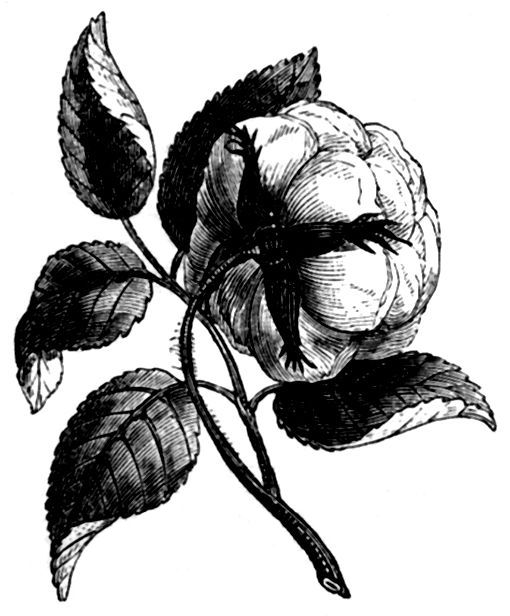
ROSE OF WOOD SHAVINGS (TO MAKE A). Cut out 14 petals same as No. 3, and 18 of No. 2, then 20 of the larger size.
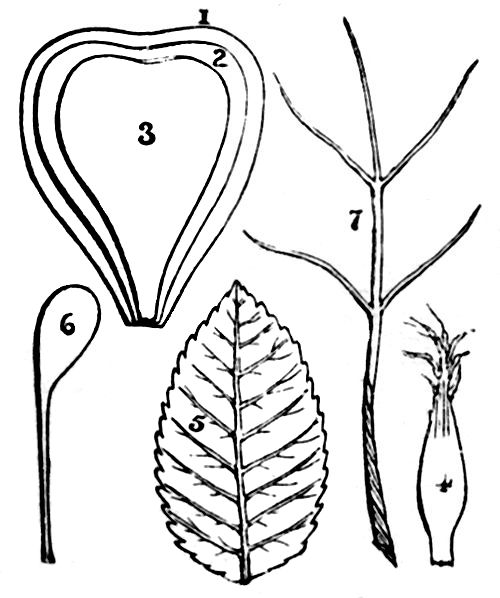
Cut them on the length of the shaving, and curl them slightly at the edge with the scissors; then form a loop of wire as at No. 6, and having twisted a strip of shaving round it, commence to tie on the petals with some strong thread. Tie on the 14 small ones; then the next size, and so on till the flower is complete. Cut the rose leaves also on the length, and vein them with the scissors, holding the points a little apart, so as to give the vein a raised look. Gum them on the wire stalk, which form same as design No. 7. Be careful to bind the spray neatly to the main branch with a slight strip of the shaving, and fasten off by a little gum at the end.
FOWLS (HOW TO KEEP). No fowls can possibly thrive well, or be profitable to the owners, unless they are plentifully fed, and have a comfortable place to roost in at night, and for a shelter in cold or wet weather. Their room or hen-house may be adjoining to some other out-building. It is best to have it facing the east or the south, and it must be perfectly weather-tight. It should have a door and windows, and be very well lighted; the windows may either be latticed with wood or netted with iron wire. In the evening, after the fowls have gone to roost, let the door be locked—seeing that it is opened very early in the morning, unless in bad weather.
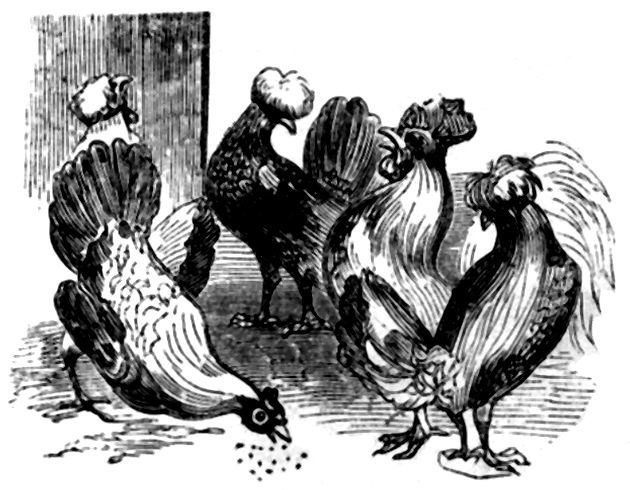
The hen-house should be frequently cleaned out and occasionally white-washed; for, if kept dirty, the fowls will be infested with vermin. If this should happen, catch every fowl, even to the smallest chicken, and rub their skins and feathers well with lard or dripping; then have their house thoroughly cleaned and white-washed at once, afterwards fumigating it with burning brimstone. Next throw some sand or fresh earth on the floor.
If fowls are scantily supplied with water, or if they have access only to that which is dirty or puddled, they will contract a disorder called the pip, which is a thin white scale that grows on the tip of the tongue, and prevents their feeding. Catch them, pull off the scale with your forefinger nail, and then rub the tongue with salt. When fowls have this, or any other disease, they look drooping, their eyes appear dull, and their combs and gills become pale and flabby. When they are sick, feed them with bran that has been mixed to a paste with boiling water.
In wet weather, keep the fowls shut up all day in the hen-house; also when it is very cold, taking care that they are properly supplied with food and water. They should have, in their house, a little manger or feeding-trough, which ought never to be empty. If they have plenty of food always by them, they will eat frequently, but only a little at a time, and it is best for them to do so. When their food is given to them scantily and irregularly, they injure themselves by devouring it too fast.
They should have food given to them regularly three times a-day. When newly hatched they may have bread soaked in milk. By way of variety, you may give your fowls, occasionally, buckwheat, barley, rice, and oats.
If always fed there, they will stay chiefly in their house during the winter, and will in consequence be more healthy, and in every respect more profitable. They must be well supplied with plenty of clean water in large shallow pans of tin or earthenware; also with brick-dust and gravel, to assist their digestion. It is well to place in the centre of their large water-pan a small but heavy one of earthenware, turned bottom upwards, on which the fowls can stand to drink without wetting their feet, which often in winter makes them sick. Recollect always that dirty water gives them diseases. But a little clean brick-dust thrown occasionally in their drinking-pans is good for their digestion.
Their nests should be moveable, that whenever the hen has done sitting they may be taken away and cleaned out before they are replaced. For the nest you may place on the floor (not far from the walls but not against them) old flat baskets; or deep boxes set up on the side; the open or entrance part turned from the light. Fill them with clean dry straw or hay. Place near the boxes lime for the hens to form their egg shells. Old rubbish-lime, or plaster from old walls, is very proper for their purpose, if well broken up. If you cannot procure this, mix lime and water to a mortar: let it dry then break it up and put it into the hen-house. See that the sitting hens have plenty of food and water every day, at the time they come off their nests. If they are not supplied at once, they will go back to their nests without waiting, and suffer much in consequence.
Their roosts or perches should be so contrived as not to be exactly over each other, and some should be placed low enough for the young fowls to reach without difficulty in flying up to them. Let none of the nest-boxes be placed under the roosts.
The hen-house should frequently be cleaned out, white-washed, fumigated with sulphur, or by burning boughs; and then strewed with sand.
Wormwood and rue, sown plentifully every spring about the neighbourhood of the hen-house, will tend to keep away vermin; and if strewed about the floor in the vicinity of their nests, it will keep off weasels and other such animals that come to suck eggs.
Bantam fowls are less injurious to a garden than any others, as the feathers about their feet prevent them from scratching up the seeds. If your garden fence has the paling sharp-pointed at the top, the fowls that are outside will find it difficult to get over; as after flying up to the top, they will have no place to rest their feet on while preparing to take their flight downward.
EARTHQUAKES. Form the most terrible of all natural phenomena. They make the solid globe itself tremble and quiver beneath our feet, and sometimes to appear to the eye to undulate like the waves of the sea when agitated by the wind. They break up the crust of the earth, elevating it here into hills, depressing it there into valleys; seaming it with rents and fissures, from which often arise products never before known in the district; altering the course of rivers; producing new shores and beaches; raising the sea bottom up to become dry land, and depressing the richly wooded land to become henceforth the bottom of the sea; leaving cities that overhung the ocean several miles inland, and submerging other cities again below the waters; altering the distribution of animal life, and occasionally destroying it to a vast extent. Let us mention a case or two by way of illustration:—In 1822, a tract of territory on the Chili coast, above one hundred miles in extent, was raised from two to six feet; and the sea bottom, thus laid bare, emitted for a long time the most intolerable odour from the decay of dead fish, &c. In 1596, on the other hand, several Japanese towns were covered by the sea.
AVALANCHES. Originate in the higher regions of mountains, and are formed of gradually accumulating masses of snow, which, at last, become so ponderous, that the inclined planes on which they rest can no longer support them, and they are hurled down into the valley beneath, often destroying villages, with all their inhabitants, filling up rivers so as to change their course suddenly, and scattering abroad the rocky debris which they have brought down with them.
AIR (CHANGE OF). Change of air is at all times one of the most important auxiliaries of the medical adviser. To persons confined in close towns, accustomed to sedentary employments, and suffering from the ailments incidental to such situations, and modes of life, a change to some open hilly district, or the breezy sea-side, often produces marvellous results; so with the poor invalid, attacked, perchance by consumption, who finds the fresh breezes of the hills or the sea-shore too keen for the diseased lungs to breathe, for such, in some sheltered vale of Devonshire, or other southern parts of our island, relief and enjoyment may be often found. In the low-lying, thickly-wooded rural districts, the air is generally relaxing, and frequently laden with miasma; persons who are obliged to dwell there, should get out upon the open hills as often as possible, and let the lungs play freely in the bracing air; those engaged in rural occupations, are usually enabled to resist the enervating efforts of the bad air which they inhale, although not always, as we see by the prevalence of ague, and other fevers, among them. After all, however, for purity of air, the country is far to be preferred to the town, and in most situations, the rural population are more healthful than the urban.
As a general rule it may be noted that dry air is good, if not too dry; in which case it is likely to cause cracks and chaps in the skin, and to be loaded with minute particles of dust which are injurious to the lungs. Moist air is not healthy to breathe, especially if accompanied by cold, as it often is in this climate, hence the prevalence of pulmonary diseases. The air of the coast, if not too keen, is undoubtedly stimulating and strengthening, in a great measure owing, probably, to its containing a portion of the marine constituents; there is a healthful freshness in the very play and dash of the waves, and the lungs seem to inhale larger quantities of the atmosphere, and to expand more freely, by the margin of the wide ocean; here that indispensable condition of atmospheric purity, constant motion, ever prevails, as it does usually upon great elevations, hill-tops and lofty table-lands, around and over which the gales sweep, whistling, and swaying the boughs of the pines and other mountain-trees, while, in the vale below, the heat is sultry, and not a leaf is stirred. Great contrasts are exhibited in the characters of the dwellers in these two different regions, and this is owing in a considerable degree to the influence or the air they breathe.
ALCOHOL. Is an Arabic term used by chemists to signify highly rectified or pure spirit, such as Spirits of Wine; the term has also another meaning, viz., anything reduced into an impalpable powder; but it is now rarely used in this sense. Alcohol is generally prepared by fermenting saccharine substances, such as malt, and the process of converting the sugar into alcohol is called vinous fermentation. This process of conversion may be thus briefly described. The liquor containing the dissolved sugar is subjected to a heat of 150° and allowed to cool to 70°, yeast is then added; very shortly, an internal movement in the fluid takes place, a thick scum forms on the surface, and a gaseous matter escapes, which is carbonic acid gas; the hydrogen in the fluid then unites with a portion of the carbon, and forms olefiant gas, which, uniting with the water (oxygen and hydrogen), composes alcohol, and this, from its superior lightness, passes over and is condensed, in combination with watery vapour, in a cooled receiver. To deprive alcohol of its water, it is passed through dried Carbonate of Potash, Chloride of Calcium, Lime, Barytes, or Alumina; or it may be done by putting it an open vessel under the exhausted receiver of an air pump, previously placed in a vessel containing lime.
Pure alcohol is a transparent, colourless fluid, of a pungent taste and fragrant odour; it is lighter and more volatile than water, burns with a blue flame which becomes yellowish when the spirit is diluted with water, when mixed with an equal bulk of which, it is termed Proof Spirit; it then has a specific gravity of 0.917, and this is not quite so strong as that used for many tinctures and other pharmaceutical purposes, the strength of which is represented by 0.930, the gravity of pure alcohol being, according to Lowitz, 0.796, although the Leyden college make it 0.815. The pure spirit of commerce is seldom less than from 0.830 to 0.835.
Alcohol is the active principle of all intoxicating drinks, the habitual use of which, according to Dr. Paris, induces “more than half of all our chronic diseases.” Brandy, Rum, Gin, Whisky, &c., are but variously flavoured forms of diluted alcohol; medicinally they are sometimes prescribed, and employed with good effect; brandy has been found especially useful to rouse the system in some cases of extreme debility, and in the sinking stages of typhus fever, &c. They are sometimes recommended as nervous stimulants in cases of great depression, but there is always danger that the taking of them may become a confirmed habit, which will grow upon the patient, and eventually make a wreck of mind and body.
CUCKOO, or CUCULUS. A genus of birds, of which there are 46 species; the common English bird weighing about five ounces; the bill black, and the feathers a dove colour. They arrive in spring, and depart in July. They lay their eggs in the nests of other birds, chiefly in that of the hedge-sparrow, from which the young cuckoos turn out the young sparrows.
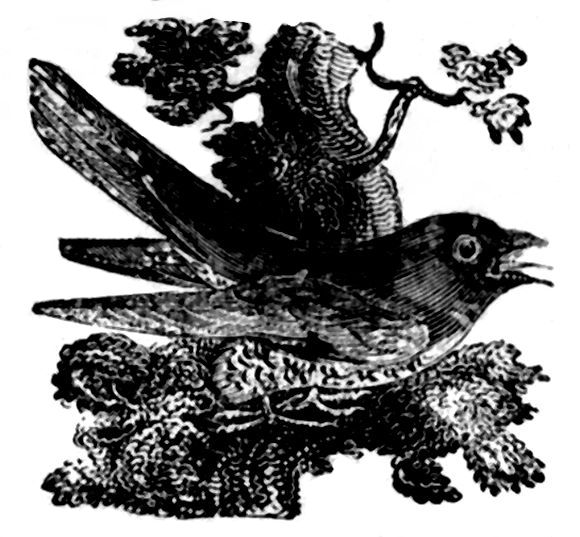
MOLE. A quadruped about six inches in length, living in subterranean burrows, which it rapidly forms by its snout and feet, being able to withdraw its eyes at pleasure.
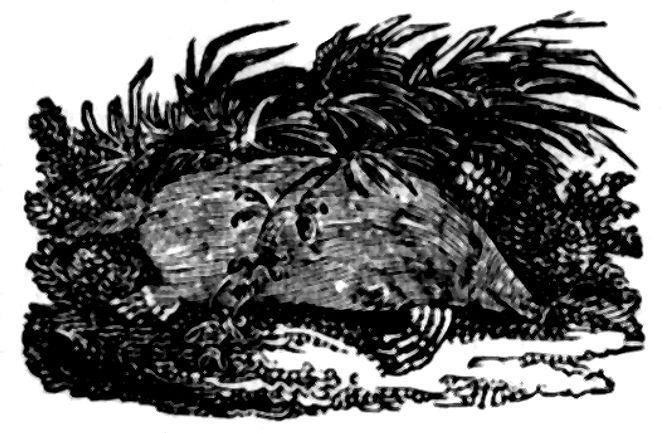
PAPER INTO PARCHMENT (HOW TO MAKE). Sulphuric acid, which changes cotton and other fibrous substances into a fulminating material, possesses also the singular property of transforming paper into parchment. To produce this transformation, take unsized paper and plunge it into a solution of two parts of concentrated sulphuric acid combined with one part of water, withdraw it immediately, and wash it in clean water and the change is complete. It is now fit for writing, for the acid supplies the want of size, and it becomes so strong that a strip, two or three inches wide, will bear from sixty to eighty pounds weight; whilst a strip of parchment of the like size would only bear about twenty-five pounds.
MONKEY. The general name of the ape, baboon, and simia tribe, the several varieties of which are principally found in the tropical climates. They inhabit forests in prodigious numbers, and, though mischievous, their manners are fantastical and interesting. They have hands like man, and also walk on two legs, but they practise no arts beyond what are suggested by the necessities of the hour. They are affectionate to their young, and often exhibit great sagacity, but their brain is smaller than that of man, and they are without his risible muscle, and less in size. They throw missiles with great dexterity, and live on vegetables.
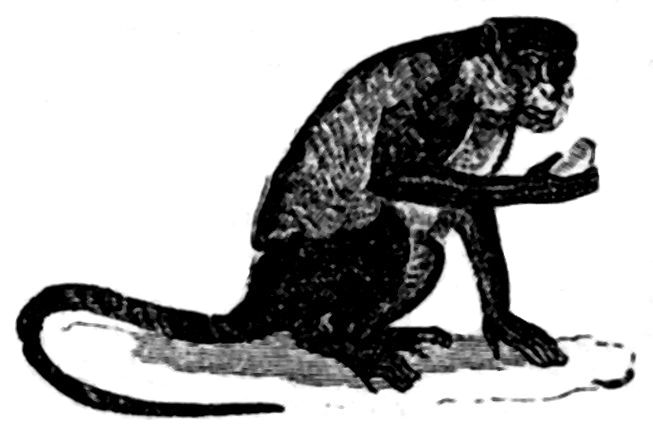
PAPIER MACHÉ. This substance is made from the pulp of paper, or of old paper ground up with size, and moulded into various forms. A mixture of sulphate of iron, quicklime and glue, renders papier maché to a great extent waterproof, and the further addition of phosphate of soda contributes to make it fire-proof. A concise history of the manufacture has been published by Mr. Bielfield.
VULCAN. The god of fire and working metals, in the Greek mythology; and the same as the Tubal Cain of the Hebrews.
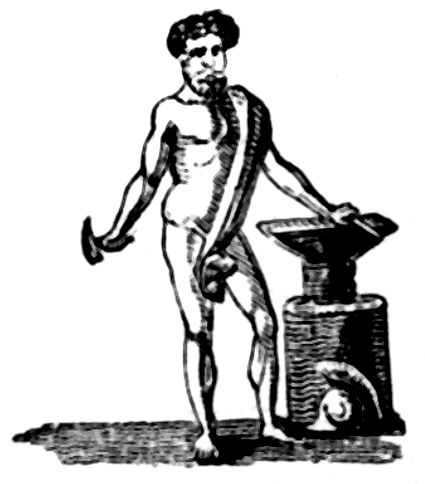
FRIEZE. In architecture the frieze is the part of the entablature between the architecture and the cornice. It is usually enriched with figures of animals, or other ornaments of sculpture.
WOODS (FINE &c.). Some woods, such as ebony, box, mahogany, calambo, cedar, &c. are valued on account of their extraordinary hardness, beautiful polish, brilliant colours, or agreeable smell, and are made into cabinets, tables, combs, beads, &c.
Ebony. The wood of the Amerimnum Ebenus of Linnæus, is brought from the Indies; it is exceedingly hard and heavy, capable of a very fine polish; and on that account it is used in inlaid works, toys, and Mosaic. (Mosaic works are an assemblage of marble, shells, stones, glass, &c., of various colours, cut square and cemented, or inlaid.) This is sometimes done with wood, and the ancients used to adorn their richest furniture with a mosaic of ivory, ebony, and the finest woods. Of ebony there are several kinds, black, red, green, &c., all of which are found in Madagascar. The island of Mauritius likewise, furnishes part of the ebony used in Europe. M. Flacourt, who resided in Madagascar as governor, assures us that it grows very high and big; its bark black, and its leaves resembling those of our myrtle, of a deep, dusky green colour. Tavernier says, that the islanders take care to bury their trees, when cut down, to make them the blacker. Candia, also, bears a little shrub called Ebenus Cretica. Pliny and Dioscorides say the best ebony comes from Ethiopia, and the worst from India: Theophrastus prefers that of India. The best ebony is a jet black, free from veins and rind, very heavy, and of a sharp pungent taste. Its rind was supposed good for some disorders. Ebony yields an agreeable perfume when laid on the coals; and even when green it readily takes fire. The Indians make statues of their gods, and sceptres for their princes of this wood. Since the discovery of dyeing woods, ebony has been less employed than formerly. Green ebony is produced by a tree, less lofty, and more bushy than that which yields the black: it grows in Madagascar, the Mauritius, the Antilles, and especially in Tobago: this is used in dyeing, and yields a fine green tincture. Of red ebony we know but little. Cabinet-makers, inlayers, &c., make pear tree and other woods pass for ebony, by washing them with a hot decoction of galls, &c.
Box is of long duration. Its wood is extremely hard and smooth, and therefore well adapted to the use of the turner. Button-moulds, knife-handles, combs, and mathematical instruments are made of it, and it may be very properly used as a substitute for ebony.
The efficacy of box-wood, in making the hair grow, is thus stated in the Ephemerides of the curious. A young woman of Gunberg, in Lower Silesia, having had a malignant disease, which occasioned the falling off of all her hair, was advised by a person some time after her recovery, to wash her head all over with a decoction of box-wood: this she readily did, without the addition of any other drug. Hair of a chestnut colour grew on her head, as she was told it would do, but having used no precaution to secure her neck and face, they became covered with red hair to such a degree, that she seemed little different from an ape or a monkey. This effect, however, has not been experienced by others, and the box-tree now yields no medicinal or chemical preparation.
Logwood, Campeachy or Indian Wood. This tree grows plentifully, and to a considerable size in Jamaica, Campeachy, &c. The wood is at first red, but after it has been felled some time it becomes black. It is very heavy, and, in burning, gives a clear lasting flame. Logwood is principally used in dyeing, particularly black and violet. It is called also Jamaica Wood. It has a sweet astringent taste, and is administered as medicine in cases of diarrhœa and dysentery. It is much used in Portugal to make port wine, a decoction of logwood with a little Brazil rum, and an extract of rhattanny root, which is brought from S. America, being frequently sent to this country as genuine wine.
Brazil Wood. The Cæsalpina Brasiliensis of Linnæus; an American wood, of a red colour, and very heavy. It is denominated variously according to the places from which it is brought: thus we have Brazil of Pernambuco, Japan, and Lamon. Brazilletto is the same with Brazil Wood; this tree commonly grows in dry barren places, and in the middle of rocks; it is very thick and large; usually knotted and crooked; its flowers, which are of a beautiful red, exhale a very agreeable smell, which is said to strengthen the brain. This wood grows naturally in the warmest parts of America, whence it is imported for the dyers, who make considerable use of it. Though the tree be naturally very thick, yet the demand has been so great, that none of the large trees are left in any of the British plantations. The branches are slender, and full of small prickles. The colour produced from this wood is greatly improved by a solution of tin in aqua regia. It is said that the bark of the tree is so thick, that of a trunk which was as big as a man’s body, when the bark is removed, is scarcely left equal to that of his leg. None of the kinds have any pith, except that of Japan. That of Pernambuco is esteemed the best. It is much used in turned works, and takes a good polish: but it is chiefly valuable for the beautiful orange and red colours in various shades, which it furnishes. It is however a fugitive colour, yet a good and permanent Turkey red can be dyed with Brazil wood and verdigris; the latter being a mordant or digestive. Sappan is another species of Brazil wood, used for the like purposes and found in the East Indies.
Cedar of Lebanon. The cedar of Lebanon is not found as a native in any other part of the world, so far as has come to knowledge. This tree is of great beauty, and bears the openest exposure so well, that it is surprising it is not more cultivated in England. Cedars thrive best in a poor soil, and are of quick growth, as it appears by those fine ones in the physic gardens at Chelsea, which were planted in 1683, and were not then above three feet high, and in 1762 measured near twelve feet in the girth, at two feet above ground. Cedar wood is reputed almost incorruptible, a prerogative it owes chiefly to its bitter taste, which the worms cannot endure. The ancients for this reason made use of cedar tables to write on. Solomon’s temple and palace were both of this wood. Historians tell us that some of this timber was found in the temple of Apollo, at Utica, 2,000 years old. The cedar is included by Linnæus in the genus Pinus or firs. The red cedar brought from Barbadoes and Jamaica is a spurious sort, of so porous a nature, that the wine will leak through it. It is a species of juniper. Cortes is said to have erected a palace at Mexico, in which were seven thousand beams of cedar, most of them 120 feet long, and 12 feet in circumference, as we are informed by Herrera.
Mahogany. This is a wood well known in England. This tree is a native of the warmest parts of America, growing plentifully in the islands of Cuba, Jamaica, and Hispaniola, and also on the Bahama islands. The excellency of its wood for all domestic uses, is generally known, as it has been brought to England for nearly a century, in great quantities. It abounded formerly in the low lands of Jamaica, but it is now found only on hills and places difficult of access. This tree grows tall and straight, rising often sixty feet from the spur to the limbs, and is about four feet in diameter. The foliage is a beautiful deep green, and the appearance made by the whole tree very elegant. Some trees have reached a hundred feet in height. In felling these trees, the most beautiful part is commonly left behind. The negro workmen raise a scaffolding of four or five feet elevation from the ground, and hack up the trunk, which they cut into balks. The part below extending to the root, is not only of larger diameter, but of a closer texture than the other parts, most elegantly diversified with shades or clouds, or dotted like ermine with spots: it takes the highest polish, with a singular lustre. This part is only to be come at by digging below the spur to the depth of two or three feet, and cutting it through; which is so laborious an operation, that few attempt it. The Jamaica wood, for beauty of colouring, firmness and durability, is most valued. Mahogany has been used in medicine with the same effect as Peruvian bark.
Sandal or Saunders wood. Of this hard odoriferous wood there are three species; the Pterocarpus Draco, which is a West India tree thirty feet high, with a solid white wood, and the bark, when cut transversely, yields a blood-red resin, which is the dragon’s blood of the shops; the P. Marsupium is a native of Coromandel, and has an orange-coloured wood; and the P. Santalinus, or red saunders tree of India, with a deep red, heavy, and very hard wood, used for fans and cabinet work. The white and yellow species are more fragrant than the red; the latter is much used for colouring drugs, spirits for thermometers, porter, &c. The White Saunders, or Santalum Album, belongs to another class and order, and is recommended in medicine as a good tonic. The same tree produces both yellow and white wood, the former being the central part of the tree is the most fragrant, hard and bright coloured; the latter is soft next the bark, and possesses little fragrancy. The yellow wood is that which is most used, and the older and larger the tree, the more fragrant and valuable the wood.
Yew. This tree furnishes a reddish wood, full of veins, flexible, very hard, smooth, and almost incorruptible. It is proper for turners and cabinet makers. The yew tree does not grow to a great height, but its trunk often attains an immense circumference.
Guaiacum, Lignum Vitæ, or Arbor Vitæ. There are three species in the genus Guaiacum, one of which is vulgarly known by the appellation of lignum vitæ, and yields the guaiacum of the shops. It grows in most of the islands of the West Indies, where it becomes a very large tree. The wood is solid and ponderous, and so hard as to break the tools in felling the trees. It is seldom cut down for firewood, being difficult to burn; but it is of great use to the sugar planters, for making wheels and cogs for sugar mills. It is also brought to Europe, and wrought into bows, sheaves of ship-blocks, and other utensils; but its principal use is in medicine. The bark and wood of this tree are much of the same nature. They are used in diet drinks to purify and cleanse the blood. Tinctures of the resin or gum-guaiacum, were long considered as specifics for the rheumatism, and are elegant sudorifics.
Aloes Wood, Calambac, or Calambour. A kind of wood brought from China, usually sold under the denomination of lignum aloes. Sir Phillip Vernatti makes calambac and lignum aloes synonymous. Others consider calambac wood to be the best sort of aloes wood, growing chiefly in Malacca and Sumatra, and much used in India for making beads and crucifixes. There are three kinds of this wood, the calambac or finest aloe-wood is light, spongy, very fragrant, and varying from black to yellow, and often of a variegated colour. The common lignum aloes is more dense, and of a brown colour; and the calambour is lighter, more bitter, of a green, black, or brown, and used by cabinet makers and inlayers.
TIMBER TREES. Oak. The uses to which oak is applied are numerous. It will endure all weathers and seasons; hence it is used for purposes that are liable to such exposures, as posts, rails, boards, pales, wheel spokes, hoops, building, &c. For water-works it is second to none, or where exposed to both wind and water, as shipbuilding, &c. The bark and sawdust are useful to the tanner and dyer; and in washing, the ashes or lees are useful.
Elm is of use in water-works for pipes, pumps, and ship planks. It makes good chopping-blocks, not being liable to break and fly in chips. It is used for axletrees by wheelwrights. Carvers use it for foliage and curious works; and it is made into coffins, as being very difficult to corrupt. A decoction of the inner bark of the common elm has been recommended in scorbutic, scrofulous, and rephnitic complaints.
Ash is of almost universal use, particularly where it may lie dry, though often used in other situations, It serves the builder, carpenter, cooper, turner, wheelwright, &c., but more especially the plough-wright; and at sea it is used for oars and handspikes.
Beech is used among turners, joiners, and upholsterers. For uses under water it is said to outlast the oak. Of the bark, floats are made for fishing nets, instead of cork. It also serves for a variety of domestic purposes, and was in great estimation among the ancients. The leaves of the beech continue long sweet, and make good mattresses. An oil may be extracted from the bark. The wood is of a clean fine grain, and can be cut so thin that it makes bandboxes, hat cases, and even book-covers and scabbards for swords.
Walnut is of general use in France. It is not so proper for the outside of buildings, but there is no wood better for the joiners. It is less subject to the worms than beech, and is of a more curious browd. The hickory nut, or white Virginian walnut, is very common in various parts of North America.
Chesnut-Tree is very lasting, and is much sought after by carpenters and joiners. It is esteemed next after the oak, but while it appears fair without, it will decay inwardly. Great part of London was anciently built with chesnut. Excellent starch may be made from horse-chesnuts.
Poplar, Abele, and Aspen, differ little from each other. The timber is excellent for all sorts of white wooden vessels. It is tougher and harder than fir, and is frequently used instead of it. It has something of the nature of cork, and is used by some countrymen as soles for shoes.
Alder is used for water-pipes and sluices; anciently boats were made with it, and large vessels. It is useful for trays, trenchers, and wooden reels. The dyers make the bark useful. Alder endures water, and if always wet, it becomes hard like a stone; though if it be wet and dry alternately, it rots presently.
Birch-Tree. There are four species of birch. The common birch-tree may be cultivated upon barren land, where better trees will not thrive; for there is no ground so bad, but this tree will thrive in it. It will grow in moist springy land, or in dry gravel or sand, where there is little surface. So that upon ground that produced nothing but moss, these trees have succeeded so well, as to be fit to cut in ten years after planting, when they have been sold for near ten pounds per acre, standing, and the after produce has been considerably increased. Many woods near London, which were chiefly stocked with these trees, having been of late years grubbed up, the value of these plantations has advanced in proportion. Persons, therefore, who are possessed of poor land, cannot employ it better than by planting it with these trees, especially as the expense of doing it is not great. Broom-makers are constant customers for birch. Hoop-benders are also great purchasers The largest trees are often bought by the turners; and the wood is used for making ox-yokes, and other instruments of husbandry. In some of the northern parts of Europe, the wood of this tree is greatly used for making wheels for carriages, being hard, and of long duration.
In France, it is generally used for making wooden shoes, and it is good fuel. In some places, these trees are tapped in the spring, and the sap drawn to make birch wine, which has been recommended for the stone and gravel. Mr. Boyle tells us, he has seen extraordinary medicinal effects of the juice itself. He says the juice may be easily preserved, by pouring a little oil on the top of it, or by distillation, &c. The piercing and bleeding of birch is performed thus: about the beginning of March, cut a slit almost as deep as the pith, under some well-spreading branch; cut it oblique, and not longways, and insert a small stone or chip, to keep the lips of the wound a little open; lastly, to this orifice fasten a bottle, into which will distil a limpid and clear water, retaining an obscure smack, both of the taste and odour of the tree. The wonder is, that in the space of twelve or fourteen days, as much juice will be gathered, as will outweigh the whole tree, body and roots.
Larch-Tree. Linnæus refers this to the genus of pine. The common larch-tree grows naturally upon the Alps and Apennines, and has lately been much propagated in England. One kind of this tree is a native of America. In many places ships are built of this wood, which is said to be durable; and, therefore, this may be a very proper tree for planting upon the cold barren hills of England; which, beside the profit they would yield to their proprietors, would also conduce to national benefit. The Venice turpentine is extracted from the larch-tree.
Pine. From the wild pine is procured the common turpentine. The leaves and tender tops of pine and fir are used for diet drinks. Pitch, tar, rosin, and turpentine, are all made from those trees by very familiar methods, which have already been described under their respective heads.
Fir. Linnæus makes the fir-tree only a different species of the pine. The silver fir grows about Strasburg and other parts of Germany, whence the turpentine is brought to England. The Norway, or spruce fir is common to the woods of Norway, and affords the white deals. From the spruce firs is made the spruce beer. A very good method of seasoning planks of deal and fir, is to throw them into salt water as soon as sawed, and to keep them there for three or four days. This renders them much harder, if dried afterwards in the air and sun.
Osier or Willow is of the Salix genus. Of the willow there are many species; Linnæus enumerates seventy. The weeping-willow grows naturally in the Levant, and has been for many years cultivated in the English gardens. The common sallow requires a drier soil than the other species, and will thrive upon the highest hills, whence it is called mountain osier. The wood of this is converted into charcoal, for making gunpowder and drawing pencils. The Laplanders make a sort of leather of the bark, which they manufacture into gloves. The common willow loves a moist and open situation, and grows quick. The bark of this tree has been found a useful medicine in agues. It must be gathered in summer, when full of sap. Our common willows in the spring season, when they are in flower, produce a quantity of cottony matter. The Chinese are industrious enough to collect this cotton as it falls from their willows; and the women and children among the poorer people, card it, &c., and render it fit for many uses. The wood of the willow, though in itself very light and spongy, is yet of a nature to bear the injuries of wet, better than almost any other kind. It is used by the Chinese on all occasions, where the wood is to stand under water, and succeeds well.
Holly. The common holly is a beautiful tree in the winter; it grows naturally in the English woods and forests, where it rises from 20 to 30 feet high. The seeds of the holly never come up for the first year, but lie in the ground as the haws do. The berries, therefore, should be buried in the ground one year, and then taken up and sowed at Michaelmas, upon a bed exposed only to the morning sun. In this bed the plants may remain two years, and then be transplanted. Holly hedges are a beautiful evergreen and strong fence; but they are liable to perish in hard winters. This is supposed to be chiefly owing to the fieldmice, which, for want of other food, disbark the roots of these shrubs. The berries of holly are hot, dry, and carminative, and good against the colic; ten or twelve being taken inwardly, bring away by stool, thick phlegmatic humours. The timber of holly is the whitest of all hard wood; it takes a fine polish, and is, therefore, used by the inlayers. It is also fit for all strong uses, and hence preferred to all others by the mill-wright, turner, and engraver. It makes the best handles and stocks for tools, flails, cart whips, bowls, shivers, and pins for blocks; and is excellent for door-bars, &c.
COLOURS AND PAINTS. The following descriptions of some of the colours used in painting, may not be unacceptable to those of our readers engaged in drawing. They will discover what are produced from minerals, what from earths and stones, and what are extracted from vegetables. It will shew them what kinds are of an innocent, and what of a poisonous quality, and serve as a caution in the use of them.
Cinnabar. Is a combination of mercury with sulphur, and forms a red, heavy, and brilliant mineral, found chiefly in quicksilver mines. The common vermilion is nothing else but cinnabar, ground up with spirits of wine and urine. Cinnabar is either native or factitious. Native or mineral cinnabar, which is that above-mentioned, though found among quicksilver, has mines of its own. Those in Spain are very famous. Each pound of good cinnabar yields fourteen ounces of mercury. The alchymists say it is disposed for attaining to the transmutation of gold. Factitious, or artificial cinnabar, is formed of a mixture of mercury and sulphur, sublimed, and thus reduced into a kind of stone. The best is of a high colour, full of fibres. This is used by farriers to make pills for their horses; and by painters as a colour, it being a very vivid red, but drying with some difficulty. This cinnabar is rendered more beautiful by grinding it with gum water, and a little saffron: those two drugs preventing its growing black.
Vermilion. A bright, beautiful red colour, in great esteem among the ancients, under the denomination of minium. The artificial or fictitious vermilion is made of mineral cinnabar, described above. The natural is found in some silver mines, in the form of a ruddy sand, which is prepared and purified for use. We have two kinds of vermilion from Holland, the one of a deep red, the other pale; the difference of colour only proceeding from the cinnabar being more or less ground. This is of considerable use, among the painters in oil and miniature; and likewise among the ladies, as a fucus or paint, to heighten the complexion. Among the ancients, the images of the gods were painted with vermilion on the feast days; and their generals on the days of triumph.
Red Lead. Is an oxide of lead, calcined and rubified; used by painters, potters, and physicians. This seems to be the real minium of the ancients, which was a preparation of lead, performed by fire.
White Lead, or Superacetate of Lead, used by painters, is only thin plates of lead dissolved with vinegar. Every ten days the rust formed on the surface is scraped off, and again steeped, and scraped till the whole be quite consumed. Of this white lead it is that the paint, used by the ladies, called Ceruse, is made. White lead is somewhat dangerous, both in the grinding and in the using, as being a rank poison.
Massicot is a yellow oxide of lead, nearly equalling Dutch pink in yielding a bright yellow, and surpassing it in durability.
Blue is one of the primitive colours. In limning, miniature, &c., the painters use ultramarine, blue ashes, and smalt. In oil and miniature they use indigo, blue bice, blue verditer, lapis Armenius, smalt, also a counterfeit ultramarine. Dyers’ Blue is one of their simple or mother colours, used in the composition of others. It is given chiefly with woad and indigo.
Woad; called also Glastum, arises from a seed sown annually, in the spring, which produces a plant called Isatis Tinctoria. It has usually three, four, or five crops of leaves every year, the first of which is best, and the rest in their order. When the leaves are ripe they are gathered, let lie some time, and then put under a wheel to bruise or grind them; after which they are laid eight or ten days in piles or heaps, and at last reduced into a kind of balls, which are exposed in the shade, on hurdles, to dry. This done, they are broken or ground to powder; and when ground, spread on a floor and watered. Here the woad is allowed to smoke and heat, till by torrifying it every day it becomes quite dry, which is called silvering. A week, or more, after which, it is in a condition to be used for dyeing. The ancient Britons used to dye their bodies with it, and some hold that it was from this plant, called glastum, that glass took its denomination; though others derive both glass and glastum from the British glass, which signifies a blue colour. A woad blue is a very deep blue, almost black; and is the base of so many sorts of colours, that the dyers have a scale, whereby they compose the different casts, or degrees of woad, from the brightest to the deepest.
Indigo is a deep blue, brought from the East Indies. It is drawn from the leaves of a plant which the Spaniards call anil, and we nil, Indian wood, and indigo. When the plant has arrived at a certain height, and its leaves are in a good condition, they are cut down, thrown into a vat, and covered with water; at the top swims a scum, with all the different colours of the rainbow. Then the water is let off into another vessel, where it is agitated with five or six long poles, fitted together for that purpose. This is continued till the water appears of a deep green, and till the grain, as it is called, forms itself, which is discovered by taking a little of it into another vessel, and spitting in it, when, if a bluish dreg be perceived subsiding, the violent agitation is discontinued. The matter then precipitates to the bottom of the vessel, after which the water is poured off. It is then put into little linen bags to drain, and when dry, it is cut into slices and hardened in the sun. There are several kinds of indigo. That is thought to be the best, which is in flat pieces, of a moderate thickness, pretty hard, clean, light enough to swim in water, inflammable, of a fine blue colour, marked a little on the side with silver streaks, and appearing reddish when rubbed on the nail. Indigo is used among painters, who grind it and mix it with white to make a blue colour, for without that mixture it would paint blackish. It is mixed with yellow to make a green colour. It is also used in dyeing, and may be considered as the best basis of all black, blue, and green colours. With indigo, laundresses give a bluish cast to their linen.
Smalt. A metallic oxide, prepared, purified, and sold, sometimes in the state of a blue powder, and sometimes in cakes; chiefly used along with starch to give linens a finer and cleaner cast; and best known by the name of stone or powder-blue.
Blue Verditer, is a bright blue. It works easy with water. It is somewhat inclining to a green, and it is the blue which is most of all mixed with yellow berries. Verditer is the precipitate obtained from nitrates of copper by lime, powdered with the addition of from 5 to 10 parts of lime in 100.
Next to ultramarine, Blue Bice (a preparation of lapis Armenius) is the most excellent, and is often made to serve instead of it. It works much better than smalt.
Ultramarine. A beautiful blue colour, used by the painters, prepared from lapis lazuli. This is a sort of precious stone, called also azure stone. It is found in mines of gold, silver, and copper, as also in pits of marble, which last is that generally in use. It is composed of silex, sulphate of lime, blue fluorspar, and iron. The Armenian stone bears a near resemblance to lapis lazuli. It is a blue friable copper ore.
Red is one of the five simple or primitive colours.
Madder. A red, bitter astringent root, of a plant called Rubia Tinctorum; much used by dyers, to give a strong, rich, red colour. It is useful in medicine, being found of service in obstructions, and in an ill state of the humours of the body. It is generally made up in form of decoctions, diet drinks, and medicated ales.
Cochineal. Is an animal substance, used by dyers, for giving red colours, especially crimsons and scarlets. Cochineal belongs to a genus of insects, called Coccus, of which there are about fifty species, extremely fertile and troublesome in hot-houses and green houses. Of these the most important species is the Coccus cacti, or cochineal coccus celebrated for the beauty of the colour it yields, when properly prepared. It is a native of South America. The female, or officinal cochineal insect, in its full-grown or torpid state, swells or grows to such a size, in proportion to that of its first or creeping state, that the legs, &c. are so small as hardly to be discovered; so that on a general view it bears as great a resemblance to a seed or berry, as to an animal. When the female cochineal insect is arrived at its full size, it fixes to the surface of the leaf, and envelopes itself in a white cottony matter, which it is supposed to spin or draw through its proboscis, in a continued double filament. The male is a small and rather tender fly, about the size of a flea, the wings large in proportion to its body, which is of a red colour, with two long filaments proceeding from the tail. It is an active, lively insect, and is dispersed in small numbers among the females, in proportion of one male to 150 females. When the female has discharged all its eggs, it becomes a mere husk and dies; so that great care is taken to kill the insects before that time to prevent the young from escaping, and thus disappointing the proprietor of their beautiful colour. The insects, when picked or brushed off the plants, are killed by the fumes of heated vinegar, or by smoke, and then dried, in which state they are imported into Europe. It is said that the Spanish government has been annually more enriched by the profit of the cochineal trade, than by the produce of all its gold mines. Cochineal is extensively used by dyers, and it yields the fine colour so much esteemed in painting, known by the name of carmine. When properly mixed with hair powder, it is what ladies use as rouge.
Carmine. Is a bright red or crimson colour, bordering on purple, used by painters in miniature. It is rarely used in oil, on account of its price. Carmine is the most valuable product of the cochineal insect, which is a sediment at the bottom of the water, wherein is steeped cochineal, couan, and autour; some add rocou, or annatto, but this gives the carmine too much of the orange cast. To be good it must be almost an impalpable powder; that is, a powder scarcely perceptible by the touch. Some prepare a carmine with brazil wood, fernambouc, and gold leaf, beat in a mortar, and steeped in white wine vinegar; the scum arising from this mixture on boiling, when dried, makes carmine; but this kind is much inferior to the former.
Lake, or Lacca. The red that is called artificial is made of Brazil wood, boiled in ley made of the branches of the vine; or, as it is otherwise expressed, Brazil wood boiled in a lixivium of the branches of the vine, adding a little cochineal, terra-merita, calcined alum, with the bones of the cuttle-fish pulverized, and made up into little cakes and dried. If to make it very red, the juice of citron is added, and if brown, oil of tartar. Artificial Lake is also a name given to a coloured substance, drawn from several flowers; as the yellow from the flower of the juniper, the red from the poppy, &c., the blue from the iris or violet.
Rose Pink, or Rose Lake. Is prepared from chalk, and an extract of Brazil or Campeachy wood. It is the most common paint used by stage-players, and is useful to house-painters and paper-stainers, where it can be secured from the air by a varnish.
Red Chalk, or Red Crayon. Is an iron ore used for sketching figures; and also forms a good light red, either in oil or water.
Lac (gum). Is a very singular compound, prepared by the female of a very minute insect, the Coccus lacca, found on some trees in the East Indies, particularly the banyan fig. The insect is nourished by the tree, fixing itself upon the twigs and extremities of the succulent branches, where it deposits its eggs, which it glues to the branch by a red liquid, the outside of which hardens by the air, and serves as a cell to the parent insect. This increases in size, and the young insects at first feed upon the enclosed liquid, and after this is expended, they eat through the coat, leaving a hollow red resinous bag, which is stick lac. The best lac is procured from the province of Acham (or Assam), but it is obtained in great plenty on the uncultivated mountains on each side of the Ganges. There are three kinds of lac—viz., stick lac, which is lac in its natural state, without any preparation; seed lac, which is stick lac broken into small lumps and granulated; and shell lac, which is a preparation of the stick lac. By a number of very accurate experiments made by Mr. Hatchett, it is found that lac consists of a colouring extract of resin, gluten, and wax, all of them in intimate combination. Lac is employed for a variety of purposes in the arts; the finer specimens are cut into beads for necklaces. It enters largely into the composition of sealing wax, and hard japans or varnishes, and it is much used in dyeing.
Kermes. A kind of husk, or excrescence, resembling a berry, growing on an evergreen of the oak kind, Quercus Coccifera, of considerable use both in physic and dyeing. That which is sometimes called by the French vermillion, or grain de gall, or vermeil, is a kind of nest of an insect, about the size of a juniper-berry, round, smooth, and glossy; of a beautiful red colour, and full of a juice of the same dye, found sticking to the bark, on the stem and branches of a sort of scarlet oak, growing in Spain, Languedoc, and other hot countries. The kermes-berry is of a vinous smell, a bitter though agreeable taste, and its pulp, or juice, full of numerous minute ova of animalcules, The origin of the kermes is supposed to be owing to a little maggot, which, pricking the coccifera to deposit its eggs, raises a little tumour or blister, which fills with juice, and as it ripens becomes red. Hence, when kermes is dried, there comes out of it an infinite number of little insects and flies, so small that they are scarcely sensible, insomuch that the whole substance seems converted into them. To prevent this inconvenience it is usual to steep the kermes in vinegar before it is dry. The juice or pulp is extracted from the kermes by pounding it in a mortar, and straining it through a sieve. Of this a syrup is made by adding a sufficient quantity of sugar. The kermes-grain has been considered as an astringent and tonic, &c. There is a celebrated confection called Al-kermes. It is, however, of greater use in dyeing scarlet. According to M. Marfigli’s experiments made at Montpelier, the kermes-berry has the effect of galls, when mixed with vitriol making ink, and mixed with lime water, it makes a crimson.
Yellow. Is one of the five simple and primitive colours.
Turmeric. Is a medicinal root, used likewise by the dyers, to give a yellow colour. It is not unlike ginger, either in figure or size. It is yellow both externally and internally, and very hard. Madagascar yields it; it is also brought from the East and West Indies. Choose that which is resinous, new, hard to break, heavy and big. The yellow root, as it grows old, turns brown, and for want of attending to this, some have supposed that the red and brown were of different kinds. It is much used by the glovers to dye their gloves. The Indians use it to dye their rice, and other foods, of a yellow colour; whence some call it Indian saffron. Our dyers do not find that it gives so steady a yellow as the luteola or weld; but it is admirable to brighten and heighten the red colours dyed with cochineal or vermilion, as scarlet, &c. Turmeric is used in medicine by way of decoction, infusion, powder, &c. It is held a sort of specific in the jaundice and dropsy.
Sumac. Of commerce, is the pulverized leaves and branches of a bushy tree, the Rhus Coriaria, or elm-leaved sumach, which rises about ten feet high, is cultivated in Spain, Portugal, Sicily, and Palestine, for dyeing and tanning. The Spanish sumac is imported in skins, that from Sicily in bags; it is esteemed good when its odour is strong, of a lively green colour, free from stems, and well ground. It is cultivated with great care by the Portuguese and Spaniards; its shoots are cut down every year close to the root, and after being dried and powdered in a mill, are ready for tanning or dyeing. Another species of this genus of plants, the Rhus Cotinus, is used by the Spaniards for dyeing and tanning their yellow leather, which is both brilliant and durable. Preparations of this plant are used by the French dyers under the name of fustet and redoul. The green berries of the plants producing sumac are poisonous, and hence some caution should be taken by dyers in using this dye. It is apprehended that a considerable quantity or the latter kind of sumac or fustet is sold in this country for
Fustic. Which is a yellow wood brought from Cuba, Tobago, Brazil, and the West Indies. The real fustic tree is a species of mulberry, Morus Tinctoria, and grows to a considerable size; its wood ground to powder, and the
Quercitron Bark. Which is produced by a large American tree, called yellow oak, are now the principal substances which yield all the yellow dyes in our manufactories.
Weld. The Reseda Luteola of Linnæus is a plant used by dyers to give a yellow colour. It is much cultivated in Kent for the use of the London dyers. With the help of potash it yields a deep lemon colour. It serves to dye all colours, between white and a deep yellow; and its dye will hold well. For the finest yellows, dyers first boil the cloth or stuff in alum or potash, and then give the colour with weld or woad.
Annotto, Annatto, or Arnatto. Is a kind of orange dye, brought from the West Indies. It is procured from the pulp of the seed-corpuscules, of a shrub called achiotte, the Bixa Orellana, Linnæus, which grows seven or eight feet high, and produces pods, each containing thirty or forty seeds, enveloped in a pulp of a bright red colour. After the pulp and seeds are repeatedly pounded, boiled, strained, and dried, it is fit for sale. Annotto has been of late prepared only by the Spaniards. Much of our cheese is coloured with this dye, and not with marigolds. Some of the Dutch farmers use it to give a rich colour to their butter. The poor people use it instead of saffron, and it was formerly often mixed in the grinding of the cocoa, as an ingredient in chocolate, in the quantity of about two drachms to the pound, in order to give it a reddish colour. It is useful as an ingredient in varnishes and lacquers. The liquid sold under the name of “Scott’s Nankeen Dye” seems to be nothing but annatto dissolved in an alkaline ley.
Saffron. A plant which produces a flower of the same name; whence also a drug called saffron or crocus is gathered. The root which produces the saffron is a kind of bulb, or onion, covered with several bulbous cartilages: its leaves are long. From the middle of the flower arise three long flame-coloured filaments, and these are properly the saffron; the rest of the flower being of no use. Five pounds of fresh filaments make one pound of dry saffron. The best saffron in Europe is that of England; that brought from Spain is injured by the oil which is mixed with it to make it keep. Saffron is used both in food and medicine, to cheer, fortify, and resolve. It was the greatest cordial in medicine. It is also used by illumers, to make a golden yellow colour.
Gamboge. Is a concrete vegetable juice, of a gummy nature. It is chiefly brought to us in large cakes or rolls, from Gamboja in the East Indies. The best sort is of a deep yellow or orange colour, breaks shining and free from dross: it has no smell, and very little taste, unless kept in the mouth for some time, when it impresses a slight sense of acrimony. It immediately communicates to spirits of wine a bright golden colour, and entirely dissolves in it or in water. It makes a beautiful yellow, and is much used by painters. Dr. Lewis says, that it leaves a beautiful and durable citron yellow stain upon marble, when rubbed in substance upon the hot stone. With lime water it yields a blood red colour. As a medicine, gamboge evacuates powerfully, both upwards and downwards. Geoffroy says he has given from four to eight grains, without violence. He recommends it to be taken with an equal quantity of vegetable alkali for the tape-worm.
Ochre. Is a kind of yellow or red earth, used by painters. It is an oxide of iron, under which head it has been described.
Spanish Brown. Is an iron ore, dug out of the ground. Among painters it is used as the first and priming colour. It works well if ground fine. In choosing good, that which is freest from stones, and of the deepest hue, is the most esteemed. For many purposes it requires to be burnt.
Ruddle, Red Hematites, or Bloodstone. Is a sort of dusky red chalk, or earth, found in several parts of England, chiefly in iron mines. It was called by the ancients hæmatites. Pliny reckons five kinds. That commonly used by painters is factitious, being made of Armenian bole, and other drugs. The native or fossil kind comes from Egypt, Bohemia, &c. The gilders use it for burnishers to polish their gold with.
Black. Something opaque and porous, that imbibes all the light falling thereon, reflects none, and therefore exhibits no colour. There are various kinds of blacks. The dyers when they are to dye cloths, &c., black, first dye it blue, with woad and indigo, and the black is given afterwards with logwood, or galls, copperas, and sumac.
There is what is called Jesuit’s black, which dyes black without first dyeing blue. It is said to have been invented by the Jesuits, and was practised in their houses. There is a German black made with ivory and burnt peach stones, mixed and ground with burnt lees of wine.
Ivory Black. Is made of ivory burnt between two crucibles well luted; which being thus rendered perfectly black, is ground in water, and made into little cakes. A crucible is a chemical vessel made of very different materials, as clays, plumbago, platina, or manganese, and so tempered and baked as to endure the greatest fire.
Lamp-Black. Is the sooty fumes of rosin, prepared by melting and purifying the rosin in iron vessels, then setting fire to it under a chimney, or other place, lined with sheep skins, or thick linen cloth to receive the vapour or smoke, which is the black. It is sometimes prepared from the resinous parts of woods, burnt under a kind of tent which receives it. Of this kind we have much from Sweden and Norway. This black takes fire very readily.
Spanish Black. Is so called, because first invented by the Spaniards, and most of it brought from Spain. It is no other than burnt cork, and used in various works, particularly among painters.
There are several colours that require burning, as first, Lamp-Black, which is of so greasy a nature, that, except it be burnt, it will require a long time to dry. The method of burning, or rather drying, lamp-black, is as follows:—Put it into a crucible, over a clear fire, letting it remain until it be red hot, or so near it that there is no manner of smoke arising from it.
Secondly, Umber, which, if it be intended to be a shadow for gold, &c., then burning suits. In order to burn umber, you must put it into the naked fire in large lumps, and not take it out till it be thoroughly red hot; or, if you wish to be more curious, put it into a crucible, and make it red hot. Umber, or martial clay, consists principally of particles of decayed wood mixed with bitumen.
Ivory also must be burnt to make black, thus, fill two crucibles with shavings of ivory, then clap their two mouths together, and bind them fast with an iron wire, and lute the joints close with clay, salt, and horse-dung, well beaten together; then set it over the fire, covering it all over with coals; let it remain on the fire, till you are sure that the matter enclosed is thoroughly red hot; then take it out of the fire, but do not open the crucibles till they are perfectly cold; for, were they opened while hot, the matter would turn to ashes, and so it will if the joints are not luted close.
Bister, or Bistre. Is made of chimney soot boiled, and afterwards diluted with water; serving painters to wash their designs.
Black Chalk. Is used for designing, and is esteemed preferable to blacklead. It is nothing more than argillaceous slate, cut into long slips, fit to be held in the port-crayon. There are two kinds, the one French, and the other Italian; the former is soft, and the latter hard.
India Ink, or Chinese ink. Is an admirable composition, in vain attempted to be imitated in Europe. It is not fluid like our writing ink; but solid like our mineral colours, though much lighter. They make it of all figures, but the most usual is the rectangular, about a quarter of an inch thick. Some of the sticks are gilt, with figures of dragons, birds, flowers, &c. In order to do this, they have little wooden moulds, so curiously wrought, that we could hardly equal them in metal. The Chinese make this ink with smoke-black of various kinds; but the best is said to be made of a liquor procured from a species of the sepia or cuttle-fish, or the smoke of fat pork, burnt at a lamp. They mix a kind of oil with it to make it more smooth, and add other odorous ingredients, to take away the rankness of the smell. After they have mixed it into a paste of the proper consistence, they put it into a mould to figure it.
We shall close this head of paints and colours with a short description of India rubber, that most generally useful substance among learners in drawing.
India Rubber, or Elastic resin. Is a substance produced from the syringe-tree of Cayenne and other parts of South America, and possessed of the most singular properties. No substance is yet known which is so pliable, and at the same time so elastic; and it is farther a matter of curiosity, as being capable of resisting the action of very powerful menstrua. M. de la Condamine says it oozes out, under the form of a vegetable milk, from incisions made in the tree; that it is gathered chiefly in time of rain, because it flows then most abundantly. The means employed to inspissate and indurate it, are kept secret. By inspissate is meant to thicken, and by indurate to harden, which M. Bomare says it does gradually, by being exposed to the air. The Indians make boots of it, which water cannot penetrate, and which, when smoked, have the appearance of real leather. Bottles are also made of it, the necks of which are fastened to hollow reeds, so that the liquor contained in them may be forced through the reed or pipes by pressure. One of these filled with water is always presented to the guests at their entertainments, who never fail to make use of it before eating. Flambeaux, an inch and a-half in diameter, and two feet long, are likewise made of this resin, which give a beautiful light, have no bad smell, and burn twelve hours. A kind of cloth is also prepared from it, which the inhabitants of Quito apply to the same purposes as our oil-cloth and sail-cloth. It is formed, by means of moulds, into a variety of figures for use and ornament. The process is said to be thus:—The juice, which is obtained by incision, is spread over pieces of clay formed into the desired ornamental shape, and as fast as one layer is dry, another is added, till the whole be of a proper thickness. It is then held over a strong smoke of vegetables on fire, whereby it hardens into the texture and appearance of leather, and before the finishing, while yet soft, is capable of receiving any impression on the outside, which remains ever after. Many attempts have been made to dissolve it so as to make it assume different figures, with equal ease as when it was in its original state, running from the tree. Mr. Macquer tried oils, turpentines, spirits of wine, the milky juice of other vegetables, heat, &c., but none of these was capable of dissolving it. At last he tried ether, which perfectly dissolved it, without any other heat than that of the atmosphere. It was then transparent, and of an amber colour.
A resin, similar to this, was discovered some years ago by Mr. Poivre, in the isle of France. Some kinds of this gum have been dissolved by other methods.
GEMS AND PRECIOUS STONES. Gem is a common name for all precious stones or jewels.
The Diamond was by the ancients called Adamant. It is a precious stone, the first in rank, value, hardness, and lustre, of all gems. The goodness of diamonds consists in their water, or colour, lustre, and weight. The most perfect colour is the white. Their defects are veins, flaws, specks, &c. In Europe, the lapidaries examine the goodness of their rough diamonds by daylight. In the Indies it is done by night. Dr. Wall, in the Philosophical Transactions, seems to have found an infallible method of distinguishing diamonds from other stones: a diamond, with an easy slight friction in the dark, with any soft, animal substance, as the finger, woollen, silk, or the like, appears luminous in its whole body; and if you keep rubbing it long, and then expose it to the eye, it will remain so for some time. Diamonds are found in the East Indies, in Golconda, Visiapour, Bengal, and the Island of Borneo. There are four mines, or rather two mines and two rivers. The miners work quite naked, except a thin linen cloth before them; and they have also inspectors to prevent their concealing the stones; which, however, they frequently find means to do, by swallowing them when they are not observed. Diamonds have also been found in the Brazils, and hence the terms oriental and occidental diamond; the latter is esteemed the least valuable, but the constituent principle of both is the same, they are all pure carbon, and perfectly inflammable, as Newton concluded. (See p. 32.)
Crystal, Quartz or Rock Crystal, is a transparent stone, white like a diamond, but much inferior in lustre and hardness. It is used for vases, urns, mirrors, &c.—The ancients knew little of its nature. Pliny speaks of it as hardened petrified water. Several mountains of Europe, and some of Asia, produce rock crystal. Madagascar is also said to yield more than all the world beside. Its perfection consists in lustre and transparency: that with straws, dust, clouds, &c., is little valued. It is frequently found hexagonal (or with six sides): the edges inimitably fine and accurate. It is cut and engraved in the same manner as common glass, of which it was the prototype. F. Francisco Lana, in describing the formation of diamonds, observes, that in the Val Sabbia is a spacious round of a meadow, bare of all herbs, wherein crystals are generated all sexangular. The country people thought them produced from dews, because, being gathered over night, others would arise in a serene and dewy sky. He observed that there was no mark of any mine thereabout, and concluded them produced by the plenty of nitrous streams, which, while it hindered the vegetation of those places, might coagulate the dew falling thereon. Rohault observes, that crystal, diamond, &c. must have been originally liquid. Boerhaave takes crystal to be the proper matter or basis of all gems or precious stones; and that they assume this or that colour from the different admixture of mineral fumes, &c. Rock crystal consists of silica, with a little lime and alumina. There are yellow, green, blue, and violet crystals, called after the precious stones which they resemble, and coloured with iron, as green crystal is called false emerald. Crystal has been erroneously supposed useful in medicine as an astringent, and that it increases milk in nurses, and is an antidote against arsenic.
Ruby. Is a red sparkling gem, of the first rank among precious stones. The ruby is found in Pegu and in Ceylon. There are rubies also found in Europe, particularly in Bohemia and Hungary, especially the former, where in a mine of flints, are sometimes found rubies, as fine and hard as any of the eastern ones. Rubies can be so nearly counterfeited, that the lapidaries themselves may be deceived. When a ruby exceeds twenty carats it is called a Carbuncle, the name of an imaginary stone described by the ancients. They long supposed the carbuncle to be taken from the dragon’s head, and we hear of many a cavalier who went to combat with dragons, on purpose to gain this invaluable jewel. Vartoman assures us, that the king of Pegu used no other light in the night time, but that of his carbuncle, which cast a blaze like that of the sun. The ancients credulously attributed many virtues to the ruby, as that it expels poisons, cures the plague, banishes sorrow, &c. The balass, spinell, oriental, and Brazilian rubies, all consist of silica, alumina, lime, and iron, intimately combined in different proportions.
Emerald. Is a precious stone, very green and transparent, in hardness next after the ruby. There are two kinds, Oriental and Peruvian.—The oriental is harder, more brilliant, and transparent than the Peruvian; which has generally clouds found in it, and sparkles less. Some, it is said, are found in Cyprus, and even in our own island; but they are very inconsiderable.—The emerald is supposed to grow more and more perfect in the mine, like the ruby, and to arrive at its greenness by slow degrees. The ancients supposed them of use in medicine, and made amulets of emerald, against all kinds of sorcery; but we have now more experience, or less credulity, and they are valued for their beauty, not for their virtue. Authors mention emeralds of incredible magnitude; of one, pretended to have been seen by Theophrastus in a temple in Egypt, four cubits long, and three broad: and of an obelisk of emerald forty feet high. Emerald consists of silex, alumina, and oxide of iron.
Topaz. Is the third order of gems after the diamond. It is transparent, and a beautiful yellow or gold colour, very hard, and takes a fine polish. It is found in the Indies, in Ethiopia, Arabia, Peru, and Bohemia; and is known in commerce by the names Oriental, Brazilian, and Saxon topaz. The oriental ones are most esteemed: their colour borders on the orange: those of Peru are softer, but their colour nearly the same. Those of Madagascar were in much esteem, but are now little valued. The topaz is easily counterfeited, and there are factitious ones, which to the eye do not appear inferior to the natural ones. Topaz consists of silex, alumina, carbonate of lime, and iron. The ancients ascribed great virtues to the topaz, which are now discredited. In the 118th Psalm there is mention made of the topaz. It appears to be the true chrysolite of the ancients.
Chrysolite. Is a precious stone of a dusky green colour, with a cast of yellow. The ancients gave this name to all precious stones, wherein the yellow or golden was the prevailing colour. Two kinds are known, the chrysolite of jewellers, and Brazilian chrysolite, the former is of a greenish pale yellow, the latter a golden yellow.
Sapphire, or Sapphyr. Is a precious stone of an azure or beautiful sky-colour. It is transparent, yet so exceedingly hard, as scarcely to bear being engraven. The deepest blues are esteemed, males, and the whitest, females. The finest things, in the Hebrew, are called sapphires. The throne of God is said to resemble a sapphire; and the Rabbins hold that Moses’ rod, and the tables he received on Mount Sinai, were of sapphire. There are oriental, white oriental, Brazilian, and water sapphires, all containing silex, alumina, lime and iron. The chemists make several preparations of sapphire; as a salt, a tincture, an essence, a water, an oil, &c. and there are few diseases but some pretend to cure by them.
Some rank the Cat’s eye in the number of sapphires. This gem has a remarkable diversity of colours, is very hard, and bears a polish equal to the true sapphire. The sapphires of Pegu are the most esteemed. They are found in the same mines with the rubies. Some are also brought from Calicut, Cananor, and Ceylon. The soft water sapphires of Bohemia and Silesia are of some account, though far inferior to the oriental ones, both in their brightness and firmness. Some value the sapphire beyond the ruby, and give it the second place among precious stones. (See p. 129).
Corundum. Is of a greenish white, passing to flesh red, and is crystallized like sapphire. On account of its hardness, it has obtained the name of adamantine spar. It is found in Hindostan, not far from the river Cavery, south of Madras. It occurs also in China, Ceylon, Ava, &c. Of 100 parts, 89 are alumina, 6 silex, 2 oxide of iron, and 3 loss.
Garnet or Granate. Is a gem or precious stone of a high red colour; thus called from the resemblance it bears to the kernel of a pomegranate. Garnets are either oriental or occidental: the first are found in several parts of the East Indies and Syria; the second in Spain, Scotland, Bohemia and Silesia. Those from the east are distinguished by their colour. Some are of a deep brownish red, as big as a hen’s egg; others are nearly of the hue of the hyacinth: a third kind as a mixture of violet with the red. Of the occidental garnets, those of Silesia are the darkest, and those of Bohemia the most valued. They are found near Prague, not in any particular mines, but are picked by peasants in the fields, from among the sand and pebbles.
Amethyst. Is of a violet colour, bordering on purple. Plutarch says the amethyst takes its name from its colour, which according to him resembles wine mixed with water. The ancients supposed it prevented drunkenness, by being hung about the necks of great drinkers. The oriental kind, which is the hardest, scarcest, and most valuable, is of a dove colour. The German is of a violet colour; and that of Carthagena has the colour of a pansy. There are beautiful ones found in the Pyrenees, and in the mountains of Auvergne. The amethyst consist of rock crystal coloured with iron. This stone is not extremely hard, and may be cut with a leaden wheel, smeared with emery moistened in water. It is polished on a pewter wheel with tripoli. It is easily engraven on, either in bas or alto relievo.
Beryl. Is a precious stone or gem, of a light or pale green colour, passing into blue and yellow. The beryl of the ancients is the same with what in latter times has been denominated aqua marina, on account of its azure or sea-green colour. Some authors take the beryl to be the diamond of the ancients; this is certain—the ablest modern jewellers sometimes mistake the one for the other. There are two species of this stone, the oriental or precious beryl, and the occidental or schorlous beryl; the former contains silex, alumina, glucine, lime and oxide of iron; the latter, silex, alumina, lime, and water. The precious beryl is much harder than the schorlous beryl. The beryl is sometimes found large enough to form fine vases. It is said that there are many of them in Cambaya, Pegu, and Ceylon. It occurs in considerable quantities in Saxony, Bohemia, and Moravia. The properties of the beryl were wonderful in the opinion of the ancient naturalists; it kept people, as they thought, from falling into the ambuscades of enemies; excited courage in the fearful, and cured diseases of the eyes and stomach; but all these qualities have vanished with the ignorance which gave them existence.
Agate or Achat. Is a precious stone, partly transparent, and partly opaque; usually diversified with a variety of colours, veins, spots, &c. sometimes exhibiting figures, or appearances of natural objects. There are various kinds of agate, which according to their different colours and degrees of transparency, have different names. The principal are these four, the onyx, the chalcedony, the black, and the German agates. Agates have ordinarily reddish tints, and are of all colours, except bright red, orange and green. They are compounds of chalcedony, carnelion, jasper, hornstone, quartz, amethyst and opal. De Boot mentions one of the size of a nail, wherein a bishop with his mitre was very well represented; and turning it a little, a man and woman’s head were seen in its place. The Sardian and Sardonic agates are very valuable; the latter is of a sanguine colour, and is divided into zones, which seem to have been painted by art. Pliny, Strabo, and Cicero, say that Polycrates’ ring was a Sardonyx. Authors also speak of Roman agates, Egyptian agates, and others. The ancients mention a red agate spotted with points of gold, found in Candia, and called sacred. Agate has always been esteemed for seals; as being a stone that no wax will stick to. Mr. Boyle takes agate to have been formed of separate beds of strata of fine clay or earth, brought by a petrifying liquor to coagulate into a stone. He mentions an agate with a moveable spot, or cloud in it. No country affords finer agate or in greater abundance than Germany. It is found in great quantity at Oberstein, where several thousand persons are employed in quarrying, sorting, cutting and polishing it.
Chalcedony. Is a species of the flint genus: of which there are two kinds, the common chalcedony and the Carnelian. The colour of the former is a nebulous milky grey, in all its shades. It is commonly semi-transparent, harder than flint, and brittle. It is found in Ireland, Ferro Isles, Saxony, Silesia, Siberia, Scotland, Cornwall, &c. It is susceptible of a fine polish, is employed as an article of jewellery, and consists of silex, lime, alumina, and a very little iron.
Onyx. A species of agate, is a precious stone, of a dark horny colour, resembling, as its name imports, the nail of a man’s finger, in which is a plate of a bluish white, and sometimes of red; the several colours appearing as distinct as if laid on by art. There are some brought from Arabia, mixed with a brownish hue; which after taking off one layer of zone, shew another underneath of a different colour. White zones or girdles are essential to an onyx.
Jasper. Is a sort of precious stone, chiefly opaque, but sometimes transparent in certain parts, not very different from agate. The florid jasper, found in the Pyrenees, is usually stained with various colours. The most beautiful is that bordering on the colour of lake or purple; next to that, the carnation; but what is now most valued is the sanguine jasper, being green spotted with red. That in which the red is paler, is called heliotrope. All the varieties of jasper consist of silex, alumina and iron; they are hard, susceptible of a high polish, become harder on being exposed to fire, and occur of a red, green, yellow, brown, purple, grey, blackish and variegated colours. In some jaspers, nature seems to have amused herself in representing trees, animals, landscapes, &c., as if they were painted.
Opal. Is a precious stone having the colours of the rainbow more or less lively, more or less effulgent, and changeable according to the different positions of the stone to the light. In it are seen the red of the ruby, the purple of the amethyst, the green of the emerald, besides yellow, blue, and sometimes black and white. When the stone is broken most of these colours disappear, which shews that they arise by reflection from one or two principal ones. Its form is always either round or oval, like a pearl, its prevailing colour white. Its diversity of colours makes it almost of equal value with a sapphire or ruby. Tavernier says, there are mines of opal in Turkey. Others say Cyprus, Arabia, Egypt, Bohemia, and Hungary produce it; whence it is distinguished into two kinds, oriental and occidental. Pliny and Solinus mention a species of opal called exaconthalithus, which had sixty colours. There is an artificial opal, counterfeited so as nearly to represent the natural stone. The opals contain silex, alumina, lime and iron.
Carnelion. Is a precious stone, ordinarily of a blood red, or bordering on orange. In many of its characters it nearly resembles the common chalcedony. It is but little transparent, cuts easily; and we find most of the fine engravings of antiquity, whether in relievo or indented, are on this stone. In the fire it loses its red colour and becomes opaque. The finest carnelions are those brought from near Babylon, Arabia, and Hindostan; the next are those of Sardinia; the last, those of the Rhine, Bohemia, and Silesia. To give these stones a greater lustre, in setting them, a piece of silver leaf is laid underneath. The principal use made of carnelion is in seals, as it graves well, and takes a fine polish. It is also used for bracelets and other ornaments.
Hyacinth, or Jacinth. A precious stone, so called from its resemblance to the purple flower named hyacinth, or the violet, which is usually of a deep reddish yellow, approaching a flame colour, or the deepest amber. There are four sorts of hyacinths, distinguished by their colour; they are also distinguished into oriental and occidental. The oriental comes from Calicut and Cambaya, and is equal in hardness to the oriental amethyst. The occidental is found in Bohemia and Portugal, and is somewhat softer. The stone graves or cuts fine, and would be more used for seals but that the graving frequently costs more than the stone. The ancients used it for amulets and talismans, and bore it about their necks, or set in rings, &c., supposing it to have the virtue of securing them from the plague. Hyacinth consists of 70 zircon, 35 silex, 2 oxide of iron and some loss in 100 parts. It loses its colour but not its transparency in the fire.
Pearl. Is a hard, white, shining body, usually roundish, found in a testaceous fish, resembling an oyster; and, although an animal production, it is usually ranked among the number of gems or precious stones. The fish wherein the pearls are found is three times the size of the common oysters; and is called by naturalists, Mytilus margaritiferus or pearl muscle. Each muscle commonly yields ten or twelve pearls, though an hundred and fifty, it is pretended, have been seen in the same fish. Some among them are much larger than others and ripen faster. The most perfect drop first, the rest remaining at the bottom of the shell. Some grow so big as to hinder the oyster from shutting, in which case the fish rots and dies. The formation of pearls has embarrassed both ancient and modern naturalists. Pliny supposes them formed of the dew. “The fish,” says he, “rises every morning to the surface of the water, and there opens its shell to imbibe the dew of the heavens, as some liquors are converted into crystals in the earth; or as the juice of flowers into honey and wax in the body of the bee, so the dew, like a liquid pearl, insinuating into the body of the fish, fixes its salts, and there assumes the colour, hardness, and form of pearl.” But this, how plausible soever, is false; for the pearl muscles adhere to the bottom of the sea, and nobody ever yet saw any of them appear on the surface of the water. Some think pearls to be the eggs of the fishes they are found in; but neither does this agree with the phenomena; for pearls are found throughout the whole substance of the oyster—in the head, the coat that covers it, the circular muscles that terminate it, the stomach, and other parts. M. Reaumur observes that pearls are formed like other stones in animals, as those in the bladder, kidneys, &c.; that they are apparently the effects of a disease in the fish; that they are formed of a juice extravasated out of some broken vessels, and detrined and fixed in the membranes. The shells of sea fishes, as well as those of snails, &c., are formed of a glutinous, calcareous matter, oozing out of the body of the animal; and it is no wonder that an animal which has vessels wherein circulates a sufficient quantity of matter (albumen and carbonate of lime) to build, thicken, and extend a shell, shall have enough to form stones, if this matter should happen to overflow and burst forth into any cavity of the body, or among the membranes.
Pearls are caught in the seas of the East Indies—on the coast of Persia, near Ormuz—about Cape Comorin, and on the coast of the Island of Ceylon. They are caught also in the American Seas, and in some parts of Europe—as on the coast of Scotland, and in a river of Bavaria. At the commencement of the season, which is in March and April, and again in August and September, there appear frequently two hundred and fifty barks on the pearl banks: in the larger are two divers, in the smaller, one. Each bark puts off from shore before sun-rise, by a land breeze which never fails, and returns again by a sea breeze which succeeds at noon. As soon as the barks are arrived at the place where the fish lie, and have cast anchor, each diver binds a stone under his body, which is to serve him as ballast, and prevent his being driven away by the motion of the waters, and also to enable him to walk more steadily among the waves; besides this, they tie another heavy stone to one foot, in order to sink them to the bottom of the sea; and as the oysters adhere strongly to the rocks, they arm their fingers with leathern gloves, or take an iron rake to displace them with. Lastly, each diver carries with him a large net, tied to his neck by a long cord, the other end of which is fastened to the side of the bark. The net or sack is intended to hold the oysters he may collect, and the cord is to pull him up by when his bag is full, or when he wants air. Thus equipped, he precipitates himself sometimes above sixty feet under water. As soon as he arrives at the bottom he begins to tear the oysters from the rock, and thrust them into his budget. At whatever depth the divers are, the light is sufficient for them to see what passes around them, and sometimes, to their great consternation, they behold monstrous fishes, from whose jaws they can escape only by muddying the water, and concealing themselves by that means; although the artifice will not always save them from falling a prey to their formidable enemies.
The best divers, it is said, will remain under water nearly a quarter of an hour, during which time they will hold their breath without the use of oils, acquiring the habit by long practice; but the exertion is so violent, as generally to shorten the lives of those who repeat it frequently.
WAXEN FLOWERS AND FRUIT. There are two methods in which to give instruction in this art. The first is, to instruct how to prepare the various materials, and then proceed to describe in detail the making of a flower or fruit; the second is, to avail ourselves of ready-prepared materials, to show the learner how much beauty can be readily produced, and how easily some of the most charming flowers can be imitated—and then to give full directions how the various materials may be prepared by the pupil.
The petals, leaves, &c. of wax flowers are made of coloured sheets of wax, which may be purchased in the shops at 6s. 6d. per gross of sheets, made up in dozens, of various colours. The stems are made of wire of various thicknesses, covered with silk, and overlaid with wax; and the leaves are commonly made each with two thin sheets of wax pressed closely by the thumb upon an embossed leaf of calico. These calico leaves may be purchased for a small sum. The general plan of proceeding may, perhaps, be best understood by a preliminary general description of the manner of making a blossom with many leaves or petals. A piece of cardboard, at least a foot square, should be marked out upon the plan of the accompanying little sketch:—
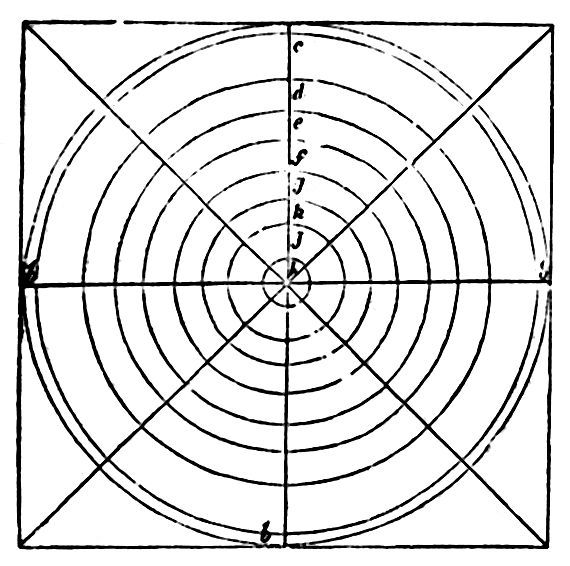
The pattern flower being then held in the hand with the face upwards, the outside or lowest leaves near the flower, called bracts, should be carefully picked off and laid on the cardboard in their relative positions with regard to the centre of the flower, on the outside double line marked b. The parts of the calyx, or outside leaves close to the flower, should in the same manner be carefully removed, and placed in their relative positions on the circle c. If there are two rows they must be laid upon the circle d—arranged alternate with, or opposite, as in the flower, to the parts already laid out. The flower may be thus dissected: the petals, stamens, &c. being laid out in order, and the seed-vessel or little central lump of the flower, laid upon the centre of the cardboard. For convenience, a few small pins may be used to keep the parts in their places. Patterns of each of the different leafy parts may then be cut in paper, and marked, lettered, and numbered. The patterns for a Camellia are subjoined is a practical illustration.
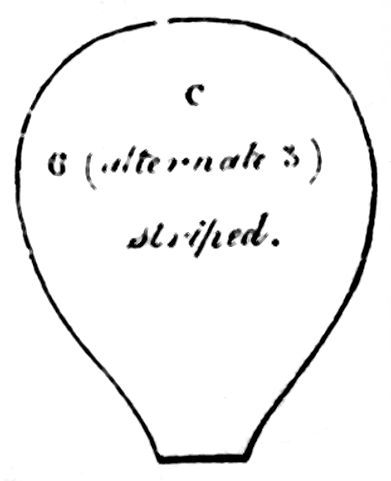
This being the pattern for the calyx was laid upon the circle marked c, and is marked with that letter accordingly. These leaves are six in number, and arranged alternately in two rows of three—hence the pattern is marked 6 (alternate 3). The edges of the sepals, or parts of the calyx, are striped with crimson finely at the edges, and this is indicated upon the pattern.
D and E is the pattern for the eight outermost petals.
To economise room we have given the next patterns (F, G, H, I,) as if laid one on each other.
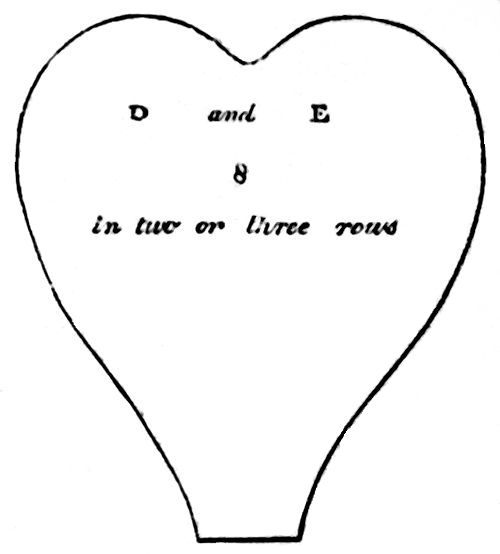
From these sketches paper patterns may be cut. These having been laid upon a sheet of white wax, the proper number may be cut out singly with a loose-jointed pair of scissors made moist by frequently dipping into water, to prevent the wax sticking to them. The putting together of these wax leaves requires little ingenuity, after a foundation has been made with a little knob of white wax upon the bent end of a piece of middling-sized stalk wire. The scraps remaining from the sheets out of which the patterns have been cut, will supply materials for this which represents the central seed-vessel, to which the petals are applied in the following order:—6 of I, 8 of H, 8 of G, 6 of F, 8 of D and E, and 6 of C.
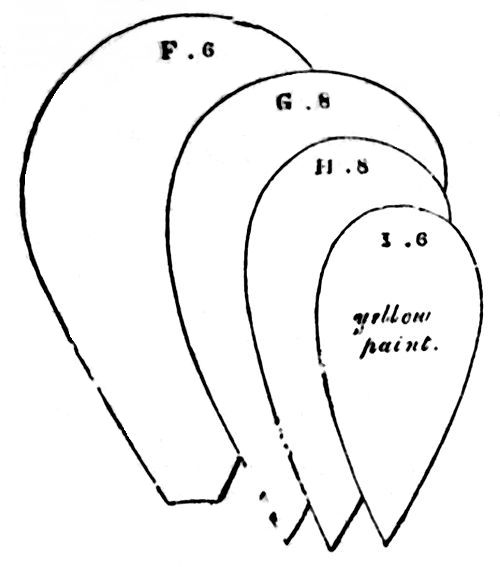
Very few instruments are requisite in the making of wax flowers, and these of the most simple character. Of the most useful is what has been appropriately termed the curling pin. It is desirable to have two of the following sizes and form. The wires should be of steel, the heads of smooth glass. These pins may be purchased for a few pence, being not unfrequently used as shawl-fasteners.
The central part of the flower, or seed-vessel, having been made by folding the scraps of spare wax upon the doubled end of the wire, till it attains the size of a large cherry-stone of this shape, the whole should be put aside while the petals are prepared for attachment. It will be found exceedingly convenient to have a wide-mouthed bottle upon the table, into which the wire stalk can be placed, so that the flower need never be laid down; many fractures of the delicate wax laminæ will thus be prevented, and much trouble saved. The wire should be of that kind which is covered with green silk, and should be about eight or ten inches in length.

One of the petals marked I, should now be taken and laid, with the dull side up, flat along the inside of the second joint of the first finger of the left hand; the curling pin should at the same time be held in the right hand, with the point towards the palm, and the knob free to press and curl the wax. The wire of the pin should rest upon the centre of the ball of the thumb, taking care to allow it to revolve easily.

The natural concavity is given to the petal by rolling the head of the pin close to the edge of the petal on each side. The head of the pin should be previously dipped in water, to prevent the wax sticking to it. When, by this process, the wax leaf is hollowed out and curled, it must be applied to the base of the seed-vessel, and pressed there with the thumb and finger, so as to adhere as in the following engraving. Another leaf must be then similarly treated, and applied opposite to the first, taking care in each case, by pressure at the point A, to incorporate the wax of the petal with that of the seed-vessel.
The four remaining leaves of the I series will require the application of yellow paint, which brings us to that department of our subject which refers to the application of colours—and which it will be necessary for us to explain before we proceed further.
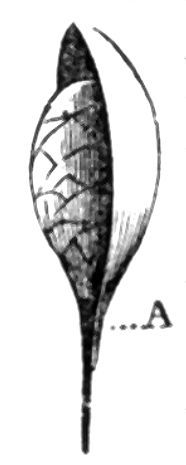
The bright surface of the wax being slightly greased in the process of cutting into sheets, the colours must always be applied on the dull side. The wax, however, will not receive common thin water-colour applied in the usual manner. Powder colours—of which a small stock should be kept—are used in the following manner:—Having taken a very minute quantity of colour-powder on the blade of a penknife, lay it upon a palette, or the under side of a plate, and press it with the blade to destroy any lumps. With the penknife also add a very small quantity of weak gum water, and work the mass to the consistence of cream.

The colours must be applied with tinting-brushes, which are sold in the shops for oriental tinting, with points as in the engraving. Each colour requires a separate brush, as powder-colour will not mix like fluid ones. The brush must be held upright at right angles to the wax, and the colour applied in the direction of the graining. The colour must be applied at once. Yellow paint should be thus applied to the remaining four petals of the I series, taking care that the pigment does not touch the point where it is intended to adhere to the basement. (See cut.)
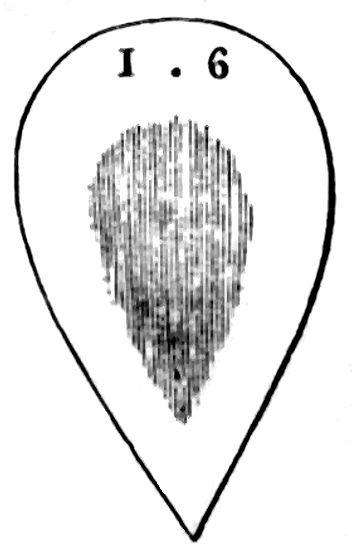
After allowing a minute or two to pass, take the first painted, and having slightly curled it with the dry curling pin, fix it a little higher than the former ones, and a little on one side of the middle line, so that one leaf cannot come exactly behind another.
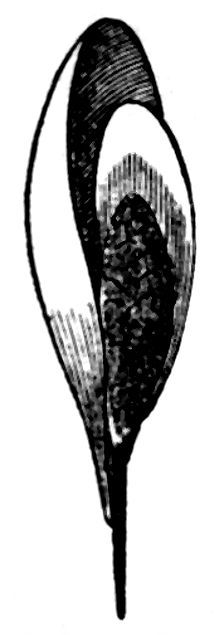
The cut represents the flower with the petals on one side torn away, to show the position of the leaves on the other. The four painted leaves should stand thus, with regard to each other, looking in at the top of the flower.
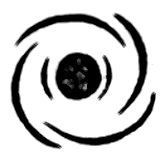
The next size, H, gives two rows of four, the points being placed opposite the vacancies between those previously used. No paint is applied to these; and they must be less curled. Before fixing the G series, having curled each petal by rolling the head of the large pin round the upper edge, the wire should be laid along the centre of the leaf, and the upper edge allowed to turn over, so as to present at the back view, a slight mark like a central leaf-vein, and to make the upper edge slightly everted. (See cut.)
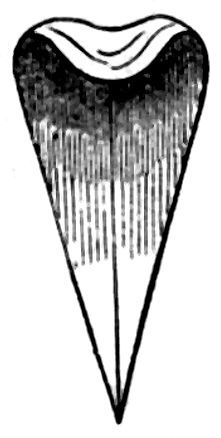
The petals are more and more everted as the subsequent rows, including the F series, are attached.
The next step is the making of the calyx. The parts may be made of green wax, or of white wax, with green paint laid on. In addition to the green in the centre of the leaf, the edges must be striped finely with a purple tint, like the edges of a tulip leaf.
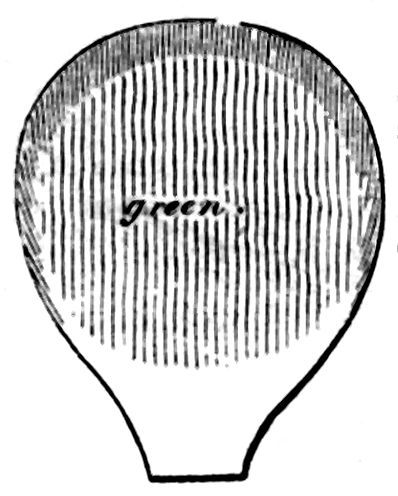
The latter colour may be made with carmine and ultramarine, and applied with a common camel-hair pencil. As previously indicated, the parts of the calyx are to be applied in two rows of three each, with the painted side inwards. If the calyx is properly curled, it should appear a little crumpled by the harder pressure of the smaller pin; and the upper edges should be much everted, to show the striping.
The flower head is now complete. The stalk is made by covering the wire with green wax cut in narrow strips, and pressed on lengthwise. This stalk wax should be made to cover the lower part of the calyx, to steady and strengthen the petals, &c.
To make the leaf, the usual and most simple proceeding is as follows:—Having selected a camellia leaf of embossed calico, a thin wire of about eight inches in length should be laid along its upper side, in the hollow of the central vein, leaving the stalk free; a sheet of dark green wax, with the glossy side outwards, should then be so pressed with the thumb and finger to the calico, that it completely adheres, and holds the wire in its place, between the wax and calico. If this is properly done, the impression of the calico should be indistinctly impressed through upon the layer of wax. The under side of the leaf of the camellia, like that of most evergreen leaves, is of a very light colour, and therefore a light green shade of wax is chosen to cover the calico on the under side, in the same manner as on the upper.
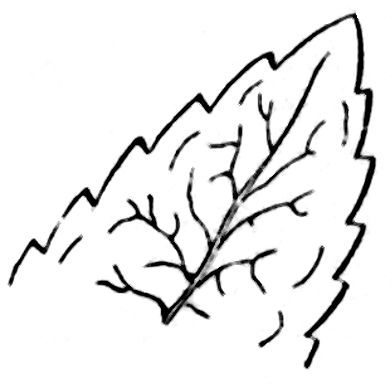
When thoroughly adherent, the superfluous wax must be cut away, leaving the edge serrated, or cut like a saw; the superfluous wire should then be twisted spirally round the principal stem, so that the base of the leaf is close to it, the leaves of the camellia being nearly stalkless or sessile, like those of its near relation, the orange tree. There should be two leaves—one close to the flower, the other lower on the stalk: when these are attached, the stalk covered, and the leaves arranged tastefully, the flower is complete.
We now propose to gather a fuchsia, and to proceed, step by step, to its facsimile in wax.
The first thing to be noticed is the general appearance of the plant. There is a great variety of fuchsias, and each of them has peculiar habits, i.e. each of them carries its stalks, and leaves, and flowers in a slightly different manner.
Of the varieties which look well in wax, that with the pale-pink calyx (or outside leaves of the flower), with the vermilion corolla (or inside part of the flower), is the best. It is to be found in every greenhouse, and almost every cottage window where flowers peep out at the casement. It is less difficult to imitate well than the deep crimson fuchsia, which is known by most gardeners as “the old original.” Having procured a specimen of the variety we have first described, the cardboard plan should be laid before the learner, and the sprig, with the flowers and buds upon it, held in the left hand.
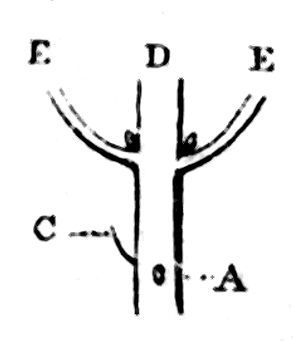
It will be observed that the leaves are arranged opposite each other on the stem. The stalks of the leaves E, growing out from the stem D on either side, have in their axil (or armpit), a bud more or less developed, according to the lateness of the season, and a flower on a pendulous stalk. The next set of leaves grows out of another aspect of the stalk, and the mark of one is seen at A, while the base of its fellow leaf would be on the other side of the stalk indicated by C.
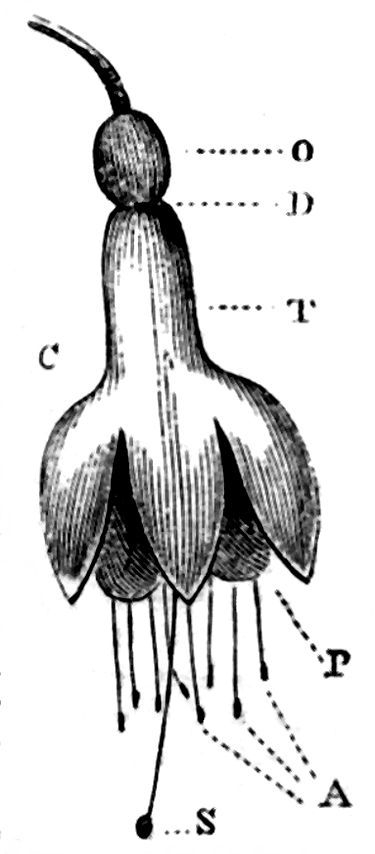
All these points are important to those who wish their flowers to bear criticism. Having noticed the drooping position of the flowers, pick off some of the best leaves, and lay them upon square pieces of gummed paper, press them close and lay them on one side—then pick off a bud, and lay it on the corner of your cardboard, and put a pin through it. Having taken one of the best flowers, pin it in like manner to another corner. This will serve as your guide to the putting up of your waxen model when your parts are ready. A flower slightly faded may be used to pick to pieces. The flower is suspended upon a thin drooping stalk, and is joined, as it were, to the coloured calyx by a green knob, the seed-vessel or ovary (O). Beyond this is a tube, extending and dividing into four segments. This is the coloured calyx (C). A division may be made at D, and the stalk and ovary may be pinned down on another corner of the cardboard. The tube of the calyx (T) should then be slit up with a sharp-pointed knife to the base of one of the notches between the segments, and opened out. The stamens whose points or anthers are marked A in the diagram, and the leaves of the corolla, P (the purple petals), will be found to adhere to this tube; these must be carefully removed and laid out in their proper order on the cardboard. As there is only one row of petals, they may be laid in any of the circles, f, g, or h. The numbers 1, 2, 3, and 4, are understood to be points representing the segments of the calyx.
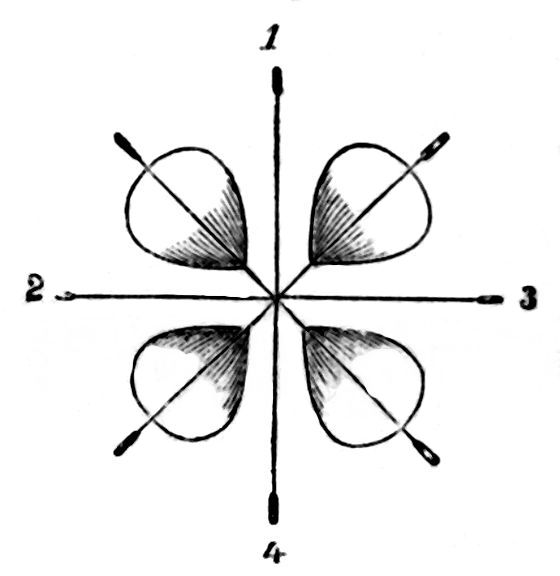
Fig. 1.
The stamens should be then arranged with reference to the petals, as in the diagram, as that is the relative position of these parts in the flower. The long pistil marked S in the diagram of the complete flower, and the tube of the calyx, will now remain in the left hand; the former should be stuck in a pinhole in the centre of the cardboard, with its delicate knob or stigma (S), upwards; the tube of the corolla should be laid flat on a piece of very thin cardboard, and a pattern cut from it at once. The segments are never exactly regular in size, but the following diagram will be found a pretty good guide. The pupil is now ready to commence making the wax flower; but before doing so it is recommended, to save future trouble, to cut out in cardboard a pattern of the shape of the leaves of the corolla, and mark it according to directions before given.
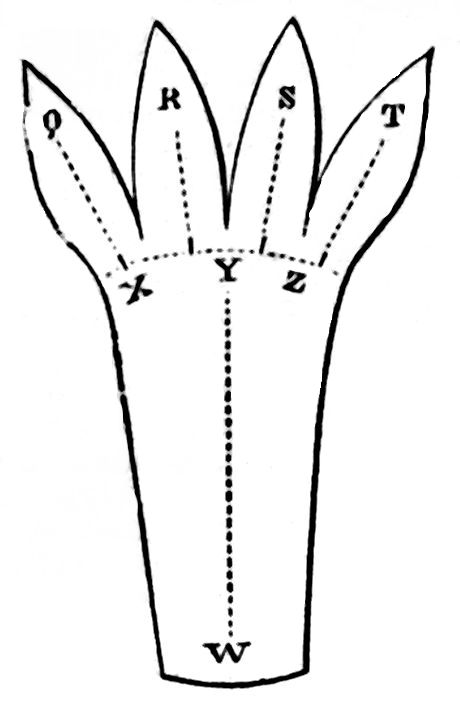
A piece of starched braid with a small knot at the end could be cut the length of the pistil, and 8 pieces of cotton with knotted ends, as mementos of the length and number of stamens.
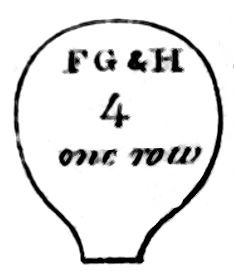
We subjoin patterns of the proper length of the pistil S, and stamens A. The former is attached to the seed-vessel as a suggestion of the distance required between the point of the pistil (the stigma S) and the ovary (O), in laying the foundation of the flower, which we shall now proceed to describe.

Several flowers should be made before they are attached to the main stalk. Several pieces of very fine copper wire should therefore be selected of the length of this page. Having waxed these with any scraps of wax which may have been saved from previous operations, wrap a little very fine silk round the wire, at the distance of about four inches and a half from the end. This is for the foundation of the seed-vessel, or ovary. The diagram next given will indicate the position of this organ. The scraps of light green wax which remained from the sheets used for the under side of the camellia leaves must be pressed with the finger and thumb, so as to make a knob. Beyond and above this, more silk may be wrapped round the pistil, which should be dipped in the melted scraps of pink wax which will remain after setting out the pattern of the calyx. With the fingers the basis of the flower should be made to assume the form given in this diagram, by folding other scraps of wax for an inch above the ovary.

Eight pieces of white netting silk, the length of the stamens, should now be dipped in the melted pink wax, and having been allowed to stiffen, the tips should be redipped, and these touched with a little flour; they must be made to adhere to the basis at the point T, at equal distances all round. A little fine silk tied round the lowest point of the stamens is a good security, but must be well pressed in.
The four petals cut from the darkest shade of pink should be coloured in the manner already described, with a mixture of carmine and ultramarine applied on the dull side, and applied at the point T over the bases of the stamens. The coloured surface will of course be outside, and the edges will overlap each other as the I series in camellia. These petals must not be curled.
The calyx has now to be applied. Presuming that it has been cut out of pale pink wax, according to the pattern given above, it must be curled with the smallest pin in the following manner:—The pattern being laid upon the palm of the left hand, the head of the pin must be rolled along the dotted line X, Y, Z, very lightly, and then with considerable pressure along each of the segments in the direction of the dotted lines to Q, R, S, T. The handle of a paintbrush should now be laid along the line from X, Y, Z, to W, and the sides of the calyx folded over it. The edges being made to fold over each other slightly, should be rubbed down with the handle of another brush; and the tube of the calyx having been thus formed, the first brush handle should be withdrawn. The tubular calyx should then be slipped up from the bottom of the wire over the ovary, and pressed firmly to its place, thus giving steadiness to all the parts. The nails and fingers will finish neatly these parts. The point of the pistil should be redipped and floured, and the blossom is completed as soon as the stalk is thinly covered with light green wax. Several leaves should also be made of various sizes with stalks about an inch in length.
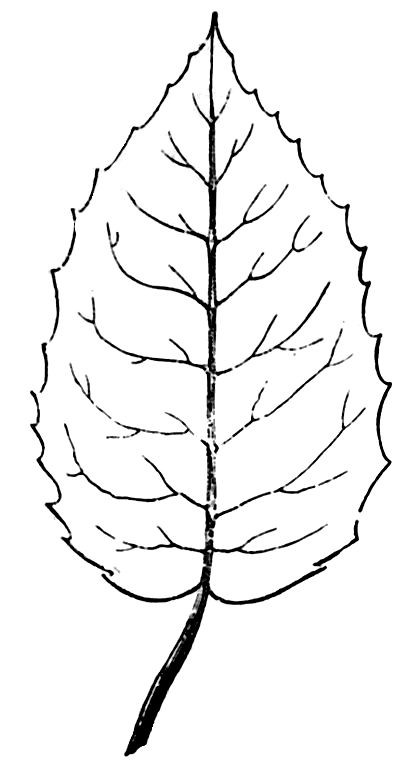
The dark green upper surface should be marked with a pattern drawn upon paper thus:—Lay a sheet of dark green wax, with the dull side up, on a thick piece of blotting-paper, and having laid over it the drawing-paper on which the pattern has been drawn, go over the lines with a hard pencil. This will leave the impression on the wax, by which it can be cut out. The leaf may be finished by laying a light layer of wax on the under side, with fine wire between for a stalk, as with the camellia.
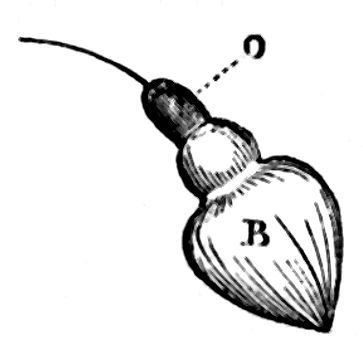
The stalk may be covered with green wax painted with carmine. The flowers and leaves must be attached to the stalk by covering the main stem with wax after fastening the leaves and flowers in their proper places.
To make the sprig natural, some unopened buds should be added. The seed-vessel O, being made in the same manner as before with green wax, the bud B must be made solid, of scraps covered with pink wax rubbed smooth with the steel part of the curling pin.
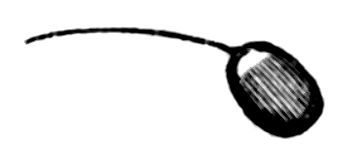
There should be also some fruit, or seed-vessels partly ripened—imitated by a knob of green wax rather larger than the ovary at the base of the flower.
We propose to conclude by explaining how the foregoing principles are applied to the imitation of the composite order of flowers. These in some points differ so much from most other blossoms, that our first section would be incomplete without it. The composite is the largest natural order which systematic botanists have established. Its flowers are readily recognised by their general character, the types of which are the daisy, the sunflower, the china-aster, the common tansy, the groundsel, and the well known dandelion.
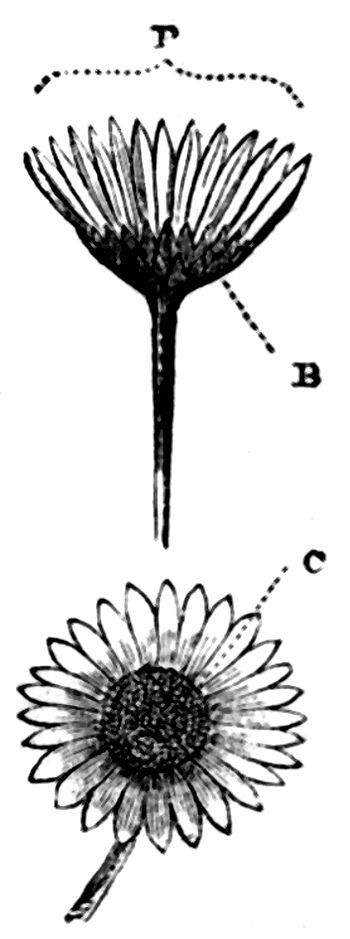
The head, or flower, consists of many blossoms, brought together upon a flat top, or receptacle, formed of small strap-shaped leaves, called bracts (B). The yellow centre, marked C, consists of florets whose corollæ are not developed. One of these heads may therefore contain two hundred florets, which in a wild and uncultivated state may not only possess corollæ at the outer edge, as in the common daisy; or may be covered with corollæ, or doubled, as in the highly cultivated dahlia, where the central disk or eye entirely disappears. What are known as the single flowers of this order, as they require peculiar management, are the subject of the present paper.
As a specimen flower we will take the china-aster, because on the one hand it is not so delicately small as the daisy, nor on the other hand, is it too large for a bouquet. It allows of great variety of colouring also, and will harmonize with the flowers which have gone before.
Having procured two flowers, lay the cardboard sheet on the table before you to receive the parts of the flower which you dissect; and taking it to pieces, place each in its appropriate position. The developed petals will be found generally to consist of two rows, and would lie upon the cardboard as in the diagram.
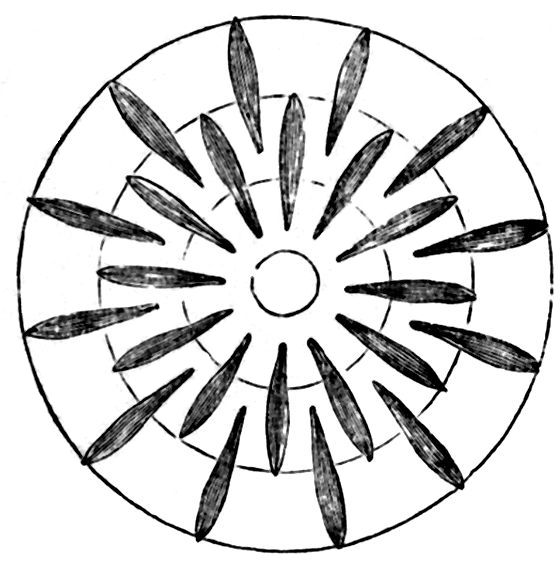
A vertical section should then be made of the disks and florets, to give the idea of the thickness of that part of the flower, and this should be laid in the centre of the cardboard.
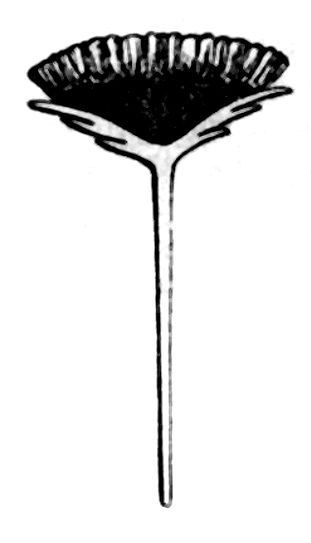
As strips of wax as small as those required for the petal of the china-aster or the composite flowers generally, are so small that they are easily affected by the warmth of the hand, it is better to cut out twenty-four pieces of the proper size and shape (see diagram), and prepare them before proceeding to lay the foundation of the waxen flower. This allows the petals time to cool, and saves trouble in practice.

The petals must be cut in thin pale blue wax, about an eighth of an inch longer than the real flower-leaf, to allow sufficient wax to adhere to the basement. The natural petals will be found to be crimpled in a delicate manner, which we found at first difficult to imitate; but the following plan answers well. Take a hard cedar pencil, and having sliced the top obliquely, cut the straight edge so made into regular but close notches, as deep as practicable. With this, by firm pressure, indent a piece of card; then grain each wax petal by laying it upon the card, and pressing it gently with the notched end of the pencil held obliquely. The pencil should be damped before it is drawn along the petal. This simple mode of crimping wax petals will be found useful in many other cases.

We now proceed to lay the foundation of the flower. Before doing so take note of the stiff appearance of the natural stalk, and the way in which the flower carries its head.
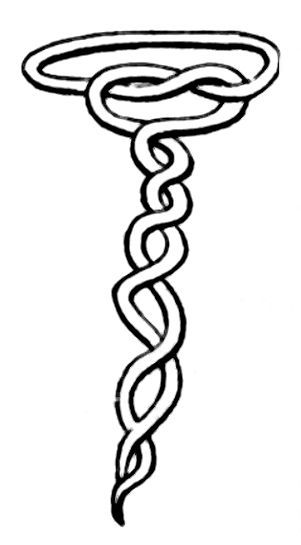
To secure this appearance, a strong piece of wire should be chosen, and should be doubled and tied so as to make a flat ring at the top and a stiff stalk. [The diagram, in which the twining of the wire is represented loosely, will explain this.] Scraps of wax are then to be pressed about the wire, so as to imitate the general outline of the basement of the flower. To make everything intelligible, we have added a sketch of this stage of the proceeding. A piece of thick yellow wax should be cut out the size of the top of the disk, and marked so as to resemble the eye of the flower.
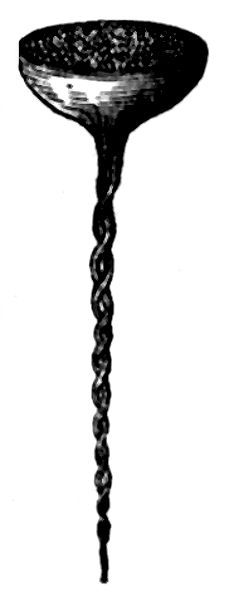
This is done very carelessly by most artists in wax and composite flowers; as ordinarily made, they never look well, as the centre is composed of shreds of wax cut finely with scissors. We can recommend the following:—Apply the yellow wax to the basement so as to make a good round top, and then, with a wet tinting brush (before described) which has been slightly damped with gum water, “bad” the wax regularly all over till it assumes the appearance of fine hairs. The blue petals may then be applied by pressing them gently against the underside of the receptacle, being attentive in giving each petal a fellow on the opposite side, and placing the second row alternate with the first.
This having been done, twenty-four bracts made of dark green wax must be laid on regularly below or against the petals. They must be cut out of four sizes of six; the largest being about an inch, the shortest a quarter of an inch in length. The stalk being covered with green wax must be made angular, and dusted with scrapings from any light-coloured woollen substance. This will give the hairy appearance. If these directions are followed carefully, it will be found that the composite flowers are to be imitated in wax more completely than many blossoms which have the reputation of being made with less difficulty.
When making wax-flowers choose a warm situation as your seat. If the hands are too hot, and the wax is thereby rendered too flaccid, wash in tepid water. The hands are oftener too cold; in which case, washing in hot water, and a seat near the fire, are recommended. Never be in a hurry, or you will spoil your flower. Be careful in cutting the petals, &c., correctly: young artists in wax are apt to be incorrect in cutting the petals, and their flowers are, in consequence, unsymmetrical. After having dissected and imitated a flower, preserve patterns and sketches of its different parts; so that when the season for the plant has passed, other copies of it may be made. Always hold the flower in the left hand, and apply fresh pieces with the right. Any oil, grease, or water, will prevent the proper adhesion of the laminæ of wax to each other.
PLANTS IN COMMON CULTIVATION FOR THE USE OF MAN AND CATTLE.
| Names and Distinctions. | How Propagated. | When Sown or Planted. | Remarks. |
| Corn Crops. | |||
| Wheat | By seed | From the end of September to the end of November. | Sometimes in the southern counties it is sown in March. The seed sown should be the produce of spring-sown wheat, which ripens earlier than the produce of winter-sown wheat. The yield in straw and grain of spring-sown is less than that of winter-sown wheat. |
| Rye | Ditto | Generally ditto; occasionally in March. | |
| Barley | Ditto | From the end of March to middle of May. | |
| Bere or Bigg | Ditto | Generally in September and October. | It may also be sown in any of the spring months. It is an inferior sort for malting; but hardy, and ripens earlier than the parent kind. |
| Oats | Ditto | From the middle of March to middle of April. | |
| Leguminous. | |||
| Pea | Ditto | Generally from the end of February to end of May. | The early frame may be sown in gardens in November. |
| Bean | Ditto | Ditto | A winter variety of horse bean is sown in October and November; it ripens a fortnight earlier than the ordinary field sorts. |
| Kidney Bean | Ditto | From the end of April to end of June. | |
| Vetch or Tare | Ditto | From March to June, and from September to middle of October. | |
| Brassica or Cabbage Tribe. | |||
| Headed Cabbages | By seed | During the whole year, except the winter months. | The seed of Nonpareil, early York and other headed sorts may be sown in June and July, and planted out until the end of November for coleworts in spring. The seed of Savoy for winter use should be sown in April or May. |
| Brussels Sprouts | Ditto | March. | |
| Borecole | Ditto | From 1st of May to June. | |
| Scotch Kale | Ditto | March. | |
| Jersey Kale | Ditto | August and early in September. | |
| Cauliflower | Ditto | From May to September. | The seed may be sown in a hot-bed in October or November; the plants should be put into frames for the winter. |
| Cauliflower Broccoli | Ditto | April and May. | The Cape broccoli (which is an excellent sort) may be sown in April or May. |
| Rape | Ditto | March and April. | |
| Esculent Rooted. | |||
| Potato | By tubers | From middle of February to end of April. | |
| Jerusalem Artichoke | Ditto | March and April. | |
| Turnip | By seed | From middle of March to middle of August. | The early green (garden) sort first—the yellow Aberdeen and Swede in May and June—and the stone in July and August. |
| Carrot | Ditto | March and April. | |
| Parsnip | Ditto | From end of February to end of April. | |
| Radish | Ditto | From January to August. | The first sown will require a moderate hot-bed and protection from frost. There are varieties suited to the seasons. |
| Garden Beet | Ditto | April, May, and June. | |
| Field Beet | Ditto | April. | |
| Cultivated for the Leaves alone. | |||
| Spinach | Ditto | March, April, May, and August. | |
| Lettuce | Ditto | From February to July. | May be sown in September, a hardy sort—for winter and spring use. |
| Cresses, &c. | Ditto | From March to November. | |
| Endive | By seed | From June to middle of August. | |
| Bulbs. | |||
| Onion | Ditto | From end of February to end of March. | If the seed be thickly sown late in March, the bulbs taken up in September, when of the size of small pickling onions, and planted in February following, will bulb largely in July. |
| Leek | Ditto | March. | |
| Shallot | By seed, and dividing roots | If by seed, in March; if by dividing roots, in April. | |
| Chive | Ditto | Ditto | |
| Garlic | By dividing the bulbs | Ditto | |
| Cultivated for the Flower, Head, or Stem. | |||
| Artichoke | By offsets | April. | |
| Asparagus | By seed and roots | March and April. | |
| Sea Kale | Ditto | Ditto | |
| Celery | Ditto | From 1st of March to end of May. | |
| Rhubarb | By seed and dividing roots | March | The petioles of the root leaves are the portions commonly used. |
| Cucumber and Gourd Tribes. | |||
| Cucumber | By seed | April and May. | |
| Vegetable Marrow | Ditto | Ditto | This requires to be raised by seed in a hot-bed. |
| Pumpkin | Ditto | Ditto | Ditto. |
| Garnishing and Sweet Herbs. | |||
| Parsley | By seed | March and August. | |
| Horse Radish | By planting crowns and part of root | February and March | |
| Fennel | Ditto and offsets | Ditto and April | Chamomile and other medicinal herbs are freely propagated by parting the roots, or by slips from the offsets. |
| Mint | By seed or cuttings | If by seed, in March; if by slips or cuttings, in March or Sept. | |
| Sage | Ditto | Ditto | |
| Thyme | Ditto | Ditto | |
| Balm | Ditto | Ditto | |
| Rosemary | Ditto | Ditto | |
STONES. Stone is a general term for all hard, brittle, or insoluble bodies. Having spoken of Precious Stones, we have now to notice the more common kinds; as Marble, Porphyry, Alabaster, Portland stone, &c.
Marble. Is a valuable stone, formed by the union of earth of lime, with carbonic acid, or in the modern language of mineralogy, is carbonated lime, found in great masses and dug out of pits or quarries. Being of a hard, compact constitution, and so fine as readily to take a beautiful polish, it is much used in ornaments of buildings, as columns, statues, altars, tombs, chimney-pieces, tables, and the like. Hauy has described nearly 100 different varieties of carbonated lime, but there is still an indefinite number of different kinds of marble, usually denominated either from their colour, their age, their country, their grain, their degree of hardness, their weight, or their defects; some are of one simple colour, as white, or black; others streaked or variegated with stains, clouds, waves, veins, &c. but all opaque except the white, which, when cut into thin slices, becomes transparent. English white marble is veined with red. Derbyshire marble is variously clouded, and diversified with brown, red, and yellow. That of Devonshire is either black with white veins, or red shaded with gray and orange. Marble of Auvergne, in France, is of a pale red, mingled with violet, green, and yellow. Various other kinds are denominated by the places from which they are brought, as Dinan, near Liège—Namur, Languedoc, Savoy, Sicily, Spain, &c. Artificial Marble is only marble pulverized, and mixed in a certain portion with plaster; the whole well sifted, worked up with water, and used like common plaster. With this stucco are made statues, busts, basso-relievos, and other ornaments of architecture. Marble is polished by being first rubbed with freestone, afterwards with pumice-stone, and last with emery, putty, or calcined tin.
Porphyry. Belongs to that class of minerals, which, occurring in great masses, mineralogists have considered as properly designated by the general term rock: a precious kind of stone or marble. It is of a brownish red, green, or black colour frequently interspersed with white stains; formerly brought from Egypt, and exceeding all others in hardness. The ancient porphyry quarries are long since lost, and the art of cutting it, as practised by the Egyptians, is also lost. The modern tools will scarcely touch it. Either the ancients, therefore, had the art of tempering steel better than we, or they had the art of softening the porphyry. Though it is probable that time and air have contributed to increase its hardness. Mr. Addison saw a workman at Rome employed in the cutting of porphyry, but his advances were exceedingly slow, and almost insensible. The Italian sculptors work it with a brass saw without any teeth, together with emery and water. Leon Baptista Alberti, searching for the necessary temper, says he found goat’s blood the best of any. Cosmo de Medicis is said to have distilled a water from certain herbs, with which his sculptor gave his tools such an admirable hardness and temper, as that he performed some fine works with them, particularly our Saviour’s head, in demi-relievo. Even the very hair and beard, how difficult soever, are here well conducted, and there is nothing of the kind better in all the works of the ancients. But the secret seems to have died with him. The French pretend to have found another method, with an iron saw without teeth, and freestone pulverized with water. The Porphyries are composed of felspar in little fragments, of shorl, and a kind of cement of the nature of jasper, on which the colour of the porphyry generally depends. The felspar and shorl, which enter into the composition of porphyries, contain silex, alumina, magnesia, baryte, and a little iron.
Serpentine. Is one of the primitive rocks, and although most commonly of a green colour, deviating sometimes into various shades of red, it is often confounded with porphyry. There are two varieties of serpentine, the common and the precious. The common serpentine contains silex, magnesia, alumina, water and iron, and is found in Saxony, Bohemia, Italy, Cornwall, and Scotland, particularly at Portsoy. It is soft, takes a good polish, and is turned into vessels and ornaments of a great variety of shapes. At Zoblitz, in Saxony, several hundreds of people are employed in quarrying and manufacturing this mineral; but the serpentine of Portsoy is much superior to the Saxon in colour, hardness, and transparency, and when cut is very beautiful. Precious serpentine is found in Silesia and Italy; it is soft, and of a dark leaf green. The verd antique is a variety of this kind of serpentine.
Granite. Is an aggregated rock, which generally forms the most elevated parts of lofty chains of mountains. It is white or red, and is composed of quartz, felspar, and mica, of the latter in the least quantity. The stones used in paving the streets of London, and most of the curb stones, are of milk white granite brought from Scotland. Granite is very hard, and is susceptible of a fine polish.
Flint or Silex (silica is the appellation of the simple earth). Is commonly of a gray colour, varying from ash gray to grayish black and brownish red; it occurs generally in roundish masses of no great magnitude, rarely in crystals, and sometimes in hollow or perforated globules. It is found in almost all countries, although not very abundantly in Scotland, and is used when split into narrow thin pieces, as flints for gun-locks, or to strike fire with steel to light matches, and for the manufacture of glass instead of fine sand. According to Klaproth, flint contains 98 silica, lime 0.50, alumina 0.25, oxide of iron 0.25, and loss 1=100. The best flints are found in the chalk or lime quarries. The Indians use two pieces of wood, which they rub violently against each other, instead of steel and flint, to generate fire or inflame a match.
Mill-stones are chiefly composed of quartz and felspar, the latter in small particles, with a little mica; they are very hard, not susceptible of a polish, and by their numerous unequal angular prominences, are particularly adapted to grinding corn to powder. Mill-stones are principally brought from Normandy in France, and their chemical and mineralogical characters have never yet been sufficiently examined. There is, however, much reason to believe, that if the mountains of Scotland, Ireland or Wales, were minutely investigated, a stone in every respect fit for mills would be found.
Alabaster, or compact gypsum. Is a well known mineral, used by architects, statuaries, plasterers, and others. It is a sulphate of lime, of which plaster of Paris is a coarse variety. There are three kinds, 1st, the snow-white, shining alabaster, found in Taurus, in pieces large enough to make dishes: it cuts freely, and is capable of a fine polish. 2nd. the yellow alabaster, which is found in Greece, of a soft texture, heavy and nearly the colour of honey. This species has been found also in Germany, France, in Derbyshire, and in Cumberland. 3rd. the variegated, yellow, and reddish alabaster. This is the common alabaster of the ancients, and is so soft that it may be cut with a knife, it is remarkably bright, almost transparent; admits of a fine polish, and consists of large angular sparry concretions. Alabasters are frequently used by statuaries for small statues, vases, and columns. The clearness and fineness of this stone renders it in some measure transparent, whence it has been occasionally employed for windows. There is a church at Florence, still illuminated by alabaster windows; instead of panes of glass there are slabs of alabaster near fifteen feet high, each of which forms a single window, through which the light is conveyed. The countries in Europe which abound most in alabaster, are Germany towards Coblentz; in some parts of Spain and France, in Italy towards Rome. A new manufacture of basso relievos, from a singular species of factitious alabaster, has been established by M. Letapie, at the baths of St. Philip in Etruria or Tuscany. The stream of these baths deposits a peculiar kind of sand, which when collected and condensed in the cavities of any body employed to oppose its current, acquires the nature, hardness, and colour of alabaster, and assumes the forms of those cavities in which it is thus lodged. When alabaster is burned, it falls to powder, is then used in stucco work, for polishing silver, &c.
Freestone or Sandstone. That dug in the peninsula of Portland, and thence called Portland stone, is much used, being softer and whiter than Purbec stone, and is commonly raised out of quarries in bigger blocks; some are also called ryegate or fire stone, freestone. Mr Boyle observes, that a competent knowledge of the stones used in building is of great importance; one stone dug out of a quarry being found to moulder away in a few winters, while another will brave the air for many ages. The same author adds, that, as there are some sorts of stones which will decay in a few years, there are others that will not have attained their full hardness in thirty or forty years, or even much more. Freestone is a whitish stone, dug up in many parts of England, that works like alabaster; but more hard and durable, being of excellent use in building. It is a kind of grit or fine sandstone, and is called freestone from its being of such a constitution as to be cut freely in any direction. This stone occurs in almost all countries, is of a reddish, yellow, white, or gray colour, and is sometimes mixed with small particles of mica, or vestiges of shells. It is used for grindstones, scythe-stones, shoemaker’s whetstones, &c. and in buildings. Workmen constantly employed in cutting it, generally die of consumption in consequence of its fine particles being imbibed by the lungs. A kind of flexible grey sandstone is found in the Brazils. A coarse kind of sandstone is used for filtering water.
Slate. Is a blue fossil, very soft when dug out of the quarry, and is easily cleft, cut, or sawed into thin long squares, to serve in lieu of tiles, for the covering of houses. Sometimes also it is used for tables, and other purposes. The ancients were unacquainted with the use of slate, and covered their houses with shingle, as we read in Pliny. Besides the blue-slate, we have in England a greyish slate, called also Horsham-stone, from a town in Sussex of that name, where the greatest quantities of it are found. The blue slate is a very light, lasting, and beautiful covering. To judge of the goodness of slate, Mr. Colepress recommends an examination of its sonorous quality; if it emits a good clear sound, the stone is firm and good. Another method of proving its goodness is by weighing it, then letting it lie six or eight hours under water, and wiping it very clean; if it weighs then more than it did before, it will not endure without rotting the lath and timber. The clay-slate, which varies in colour from light blue to purple, is the most generally used. The blackish-grey kind is used in schools by scholars learning arithmetic, and for writing; the splinter kind is made into pencils, and several varieties are used as whetstones. Some kinds of hard slate, or schistus, have iron pyrites, and mica embedded in them; others are soft, and used for designing as black chalk.
Pumice-Stone. Is a kind of spongy fibrous stone, very porous and friable, found in the ashes of most volcanoes. Dr. Woodward considers pumice as only a sort of slag or cinder; and affirms it is only found either where forges of metal have anciently been, or near some volcano or burning mountain. Other authors will have it to arise from the bottom of the sea, whence they suppose it to be detached by subterranean fires; and hence account both for its lightness and porosity, and its saline taste, alleging that several parts of the Archipelago are frequently found covered with it all at once, after a few inward shakes and heavings of the bottom of the sea. It consists of 77 parts silex, 17 alumina, and the remainder of a 100 in iron, manganese, and alkali. Pumice makes a very considerable article in commerce, and is much used in the arts and manufactories, to glaze pottery, and to polish and smooth several works. The marblers and parchment-makers use the largest and lightest—the curriers, the heaviest and flattest—pewterers, the smallest.
Hone. A fine sort of whetstone, whereon to set a razor or penknife. It is of a yellowish colour; according to some accounts, it is holly-wood petrified, or changed into stone, by lying in the water for a certain time. Some in Oxfordshire are said to be thus petrified in a very short time. Several kinds of petrified wood are used as whetstones, but they are generally too hard and too coarse for fine edges.
RABBITS. Rabbit House. The first and most important matter is to have a good dry house or shed, in which the animals can be well protected from damp weather. Too much moisture is as fatal to rabbits as it is to sheep; it gives them the rot. Dampness may be all very well for fishes, but is not good for men, women and children, nor yet for horses, cows, pigs, poultry, bees, or rabbits; these all thrive better and are preserved from many diseases by being protected from it.
But though you keep out the wet from your rabbit house, you must not at the same time exclude fresh air; for rabbits can no more be in health without fresh air, than human beings.
Many writers advise that rabbits should not be kept in hutches, but in little houses, so constructed, that they may have protection from the weather, and at the same time enjoy their liberty and amuse themselves. This house may be built about four or five feet square, as may be convenient, with a roof formed to carry off the rain. The floor should be boarded or paved, to prevent the rabbits from burrowing, and have hay or straw laid on it. Some boxes must be provided, placed on the floor with the open side downwards, and with holes at the side for the rabbits to go in or out. Sliding doors to these boxes are convenient to shut in the rabbits when necessary.
In the front of the house there should be a little court, or yard railed off, into which the rabbits may be allowed to run when the weather is dry; and here they will sport and enjoy themselves, and give you opportunities of observing their pretty antics.
But this house will only do for young rabbits, or until they are about five months old; after that age, they would begin to tear each other to pieces, if left together; all the pleasure you had in witnessing their former harmony and happiness would be gone; the bucks would fight dreadfully, and the litters the does might have, would be destroyed; so that it is necessary that breeding does should be kept in hutches, and the bucks be separated from one another. But we nevertheless advise that young rabbits should be allowed to have their liberty in such a house; as they will be far more healthy, and will grow much better, than when they are cooped up in hutches, where they have no room to exercise their limbs.
Hutches. The hutches should be made as large as convenient, that the rabbits may not be cramped for want of exercise; those for breeding does must have a partition, so as to form two apartments, one for feeding, the other as a bed. Single hutches, that is, with one room only, will do for young rabbits, or for bucks to be kept in. The door of the feeding apartment should have wires in it, but that of the bed-place must be of wood, as the doe likes darkness and concealment when she has her litter. It is well to have a sliding-board to divide the two compartments, and to shut out the rabbits when the hutch is to be cleaned; as it is very inconvenient to do this with the rabbits running about. The floors of the hutches should be quite smooth, that the wet may run off, and, in order to facilitate this, a small slit or opening in the floor at the back of the hutch should be made, and the hutch itself be put sloping, a little higher at the front than at the back; for when rabbits have much green food, there is a considerable quantity of moisture which requires to be drained off, that the creatures may be kept dry and clean; and if proper means be taken to receive this into a drain, it forms a very valuable liquid manure.
Feeding Troughs. Are usually made in the form of a long open box, but this is inconvenient in many respects, as the young rabbits get in and spoil the food, and the older ones scratch out much of it, tread it under foot and waste it. A better plan is to have a swinging board in front, the cost of which is soon made up by the food saved. The rabbits when they take their food, push this board inwards with their forehead, and when the head is withdrawn, the board flaps back against the front of the trough. Some persons have a lid to the trough which the rabbit soon learns to lift, and which shuts down again of itself as soon as the head is taken out of the way.
There are many kinds of rabbits, varying in size, form, colour, length of legs or fur, and position of the ears, but the races have been so continuously intermixed, and varied, by breeding, that it is a difficult task to point out any distinct kind as preferable. The smallest and short-legged variety, of the colour of the wild rabbit, appears to be the hardiest. Boys generally prize lop-ears, though they are scarcely so pretty in appearance as the common kind. There is the single or double lop, according as one only, or both ears are dropped. Smuts too are favourites, either single or double. The smut is a black spot on the side of the rabbit’s nose, and a spot on each side constitutes the double smut. Some of these are very beautiful creatures, having a white silvery fur, with rich, glossy, black spots, and they are generally large sized rabbits.
Food. This is an important matter; rabbits eat a very great quantity; you must not think that because they are little animals, they require only a little food; they want much more than you do, in proportion to their size: and to give them proper kinds of food, in sufficient quantity, and at a low expense, constitutes the chief question as regards their profit. How often do we hear it said, and how generally true is the saying, “Oh! my rabbits never pay, they eat their heads off, &c.,” meaning that the expense of the food consumed, more than counterbalances the advantage gained. Now, this arises from want of knowledge. For the greater part of the year, rabbits may be kept almost entirely upon food procured from the fields or garden. Although green food is naturally the food of rabbits, yet, because when injudiciously supplied it scours, and gives them the rot, it is erroneously supposed that it must be almost entirely withheld. It is true, that if it be given to them in a wet state after rain; if it consist of one kind of vegetable only; or if it be of a watery kind, a bad effect takes place; but when the green food is given in sufficient variety, and with a small supply of good dry hay or oats daily, there is not the least fear in giving an unlimited quantity.
We will now give a list of many of the vegetables that are good food for rabbits. All through the summer there will be an ample supply from the garden and hedges. Dandelion, groundsel, sow-thistle, dock-leaves, peas-haulm, lettuce; strawberry, raspberry, and currant leaves; carrot, parsnip, potato, and horse-radish tops; all kinds of grasses, celery; French beans in the pod, vine dressing, apple parings, &c., &c. But we need not further enumerate, when there is scarcely any vegetable which rabbits will not eat; but before all other things they prefer parsley, carrot tops, French beans, both leaves, stalks, and pods.
As soon as the peas and kidney-beans have done bearing, let them be pulled up and given to the rabbits, together with all the pods not wanted for use. In the autumn, when green food becomes scarcer, we give the waste scarlet-runner stalks, of which they are very fond; also the leaves which now fall in abundance from the apple and other trees; and when the garden supplies fail, there is generally plenty of marshmallows, docks, ground-ivy, and grasses from the hedges, to form an abundance of green food for some time longer.
In the winter, carrots, parsnips, swede and common turnip, together with brewer’s grains, mixed with toppings or pollard, supply the lack of fresh vegetables. We never use grains in the summer, because they so soon turn sour and mouldy, and much better food can then be obtained.
We must not omit to tell you that rabbits like the young bark of trees; for this reason we supply ours in the winter with small branches and twigs, which they either strip or entirely consume. We throw to the young ones the prunings of vines; currant, apple, and other trees; except such as laurel, and evergreens said to be poisonous. Nibbling these twigs is excellent amusement for rabbits, and beside keeping them in health, serves as a portion of their food.
Here, then, we have shown that there is no need for starving rabbits, when there is such an abundant variety of food suitable for them, and at all times to be procured. One writer observes, that when rabbits die, ninety-nine times out of the hundred, starvation is the malady. And particularly short-feeding the doe, while, and before she has young ones.
Feeding. It is best to feed rabbits three, or even four times a-day, because when they are fed only twice during that time, a larger quantity of food must be given at each feeding, which is too often wasted. Rabbits appear to relish their food best when given in small quantities, and you will soon learn how much to give at each time you feed, so as to avoid waste and yet for the rabbits to have enough. The does must be well kept, as we have just said, both before and after they have young ones, or it is useless to expect their produce to be vigorous and healthy. A doe with a litter will eat twice as much as at other times, and must be liberally supplied with green food, and carrots and parsnips, raw or boiled, as well as with oats and hay. A few days both before and after kitting, every evening, we give to our does, a few tablespoonsful of gruel, made either with flour or oatmeal, and we find this a good practice, as the animal appears to suffer a good deal from thirst, about that period; care must be taken not to give this while it is hot, nor is it necessary to give much when there is an abundance of green meat. A little cold water, or milk may be given instead of the gruel; we have never found it to hurt any of our rabbits.
Young rabbits when they first come out to feed must not be allowed to eat the greens, with which the doe is supplied; but they may nibble at carrots, and other roots, and at the little twigs we have mentioned, and gradually be accustomed to partake of a more moist diet.
Breeding. Rabbits begin to breed when about five or six months old, and will give seven or eight litters in the year, though it is better to allow them only to have five, as too frequent breeding is injurious. In thirty days after being with the buck, the doe produces her young. A few days before the time, some hay must be given to her, with which and the down she pulls from her fur, she will construct her bed. It is always a sign of the approaching birth of the young when she begins to bite down the hay, or carry it about in her mouth, and to tear the flue from her body. There are generally from four to ten young ones, sometimes more; but it is far better when the doe has so many, to keep only five or six of the finest, they will then grow up strong and healthy, and the doe will not be so much weakened as if all had been preserved. At the end of six weeks the young brood may be removed, and the doe and buck come together again. Great care is required during very severe weather, to prevent the young from dying with cold; and for this reason it is better to allow the doe to rest during the winter. The best breeding rabbits are said to be those produced in March.
Fattening. There is no need to resort to any other method in preparing rabbits for the table, than to give them as much oats, carrots, and green food as they choose to take; if fattened with corn alone, the flesh is not so juicy and relishing, as when they are also allowed an unlimited quantity of vegetables. They are in the greatest perfection from about three to seven months old, and about a month’s feeding as advised will make them thoroughly fat, provided they have not been half-starved previously. The London poulterers exhibit fine specimens of fatted rabbits at Christmas, some we have seen weighing upwards of fifteen pounds; but it is not desirable to produce such over-fat animals, whether rabbits, or oxen, or sheep.
Diseases. Rabbits are generally very healthy, and hardy. When due attention is paid to their food, to ventilation and cleanliness, few animals are less subject to disease; but, as in all other cases, filth, foul air, and damp, produce disease in rabbits. Looseness, which may be seen by the dung being too moist, must be remedied by dry food, such as crusts of bread, good corn, old hay, hard biscuit, or any food of a dry quality. The rot may be said to be incurable, at least we have found it so with young rabbits. The remedy must be looked for in dry hutches, fresh air, and substantial food. The liver complaint, another disorder, is said also to be incurable; but as it does not prevent the rabbits from fattening, the best course is to prepare those attacked at once for the table. Snuffles or colds may be cured by removing the rabbit from the damps and draughts, which have produced the disorder, to a drier and warmer place. It is much easier to prevent disease than to cure. Cleanliness, careful attention, dryness, and regular feeding in the manner we have directed, will, in general, ensure good health in the rabbits, and entirely prevent any of these diseases.
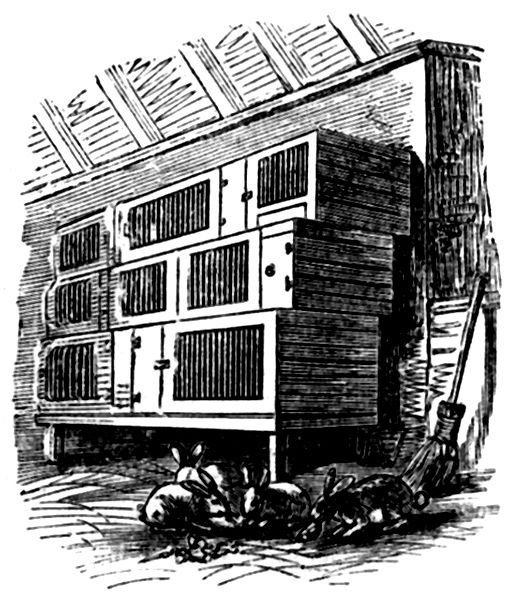
Profits. Rabbits are really profitable. Three does and a buck will give you a rabbit to eat for every three days in the year, which is a very much larger quantity of food than any man will get by spending half his time in the pursuit of wild animals, to say nothing of the toil, the tearing of clothes, and the danger of pursuing the latter. When the amazing fecundity of the rabbit is taken into account, it will readily be seen that if the expense of food, and management can be kept low, a great profit may be obtained. It is said, that from a single pair of rabbits, the prodigious number of one million, two-hundred and seventy-four thousand, eight hundred and forty, may be produced in four years, supposing all the rabbits to live. We have shown how the least possible expense as to food may be attained, by pointing out the food which costs least, and yet is quite suitable for the animals; and there appears to be no good reason, why, a person living in the country who has a shed and a garden should not derive advantage from the keeping of rabbits, and when the care of them can be entrusted to a boy, the cost of management would of course be diminished. The value of the dung, either for sale, or for the garden is considerable, as it is a very valuable manure.
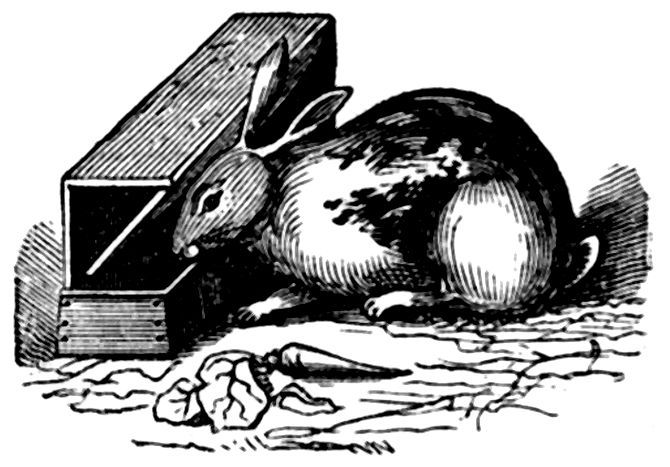
PAINTING (OIL).—We begin by supposing that you can draw—at least, that you can make a straight line (which, indeed, not everyone can do)—and, that you can, either from a fair knowledge of perspective, or a naturally correct eye, copy any object in the room, as the books on the table, the jar of flowers, or the coal-scuttle; for, though a person may, without being able to draw from nature, produce a highly finished copy of a picture, there would be more labour than pleasure in the task; while an original, if only a wheel-barrow and besom, grouped with taste, would give far more delight in the doing, and you would acquire an artistic freedom of hand by such studies.
In the next place, we suppose that you can see colours according to nature, for many persons see them too bright, or quite the reverse of what they are.
We will now proceed to describe the materials actually required in this art. If our pupil can command a room to himself as a studio, if ever so small, so much the better. This, however, is not at all needful—a moderate-sized table will be all the space he requires to engross.
An easel, palette, palette-knife, brushes, colours, a little oil and varnish, and some prepared mill-board, are all that is necessary, and they are not very expensive.
As a large easel standing on the ground is only fit for a studio, we give a sketch of a “table-easel,” which is both simple and portable, and may be made by any carpenter; it will fold up quite flat, and pack at the bottom of a box. It is 18 inches high, 15 wide at the base, 7 wide at the top, 20 long for the leg, 22 for the stand; this is provided with holes, and the leg has an iron point at the end, which fits into the holes, and regulates the inclination of the easel. A loose grooved bar of wood, about 18 inches long, rests on 2 pegs, which are placed in the holes in front of the easel; this supports the picture.
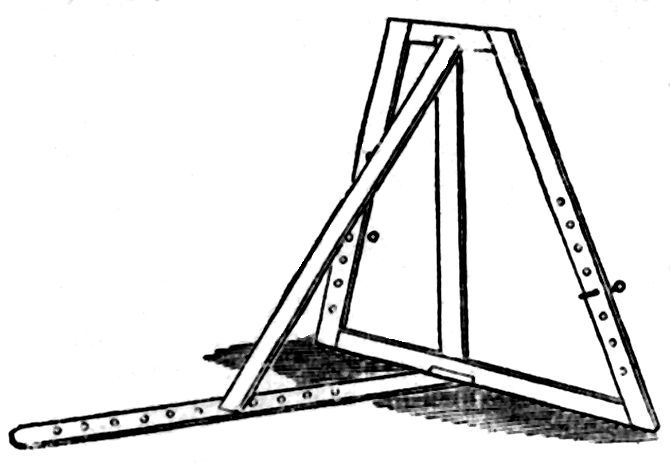
The palette should be made of mahogany, of an oblong shape, and light in weight.
The palette-knife to mix the colours should be pliant and well-tempered.
The brushes we recommend are, two flat hog’s-hair brushes in tin, Nos. 2 and 7; two flat sable brushes in tin, Nos. 4 and 8; three round sable brushes, Nos. 1, 4, and 6.
These seven tools will be amply sufficient to begin with, but some camel-hair ones, in quills, the same as those used in water-colour drawing, may be added; they are very cheap. A brush called a “badger softener” is of use in painting skies, but they are expensive, and may be dispensed with at first.
The colours are enclosed in air-tight metal tubes, and the capsule being unscrewed, you squeeze the colour up from the bottom of the tubes. We give a list of the most useful colours, and from which almost any picture may be painted. Of these, the first six are opaque, and the remainder transparent; we wish the pupil to bear this in mind.
1. Flake white; 2. Naples yellow; 3. Light red; 4. Indian red; 5. Vermilion; 6. Terra verte; 7. Burnt umber; 8. Raw sienna; 9. Burnt sienna; 10. Antwerp blue; 11. Ivory black.
There are also some extra colours, which are of higher price, and used in finishing; these are, French ultramarine, and madder lake. These are very beautiful, and are chiefly used in sky tints, and in delicate flesh tints.
The price of the tubes of paint is sixpence each, that of the extra colours one and sixpence each; but they last for a long time.
Of oils and varnish, you require some raw linseed oil, some light drying oil, a bottle of mastic varnish, a little spirits of turpentine, and a little olive or eating oil.
The prepared millboards for painting on are of all sizes, from six inches by eight, to 24 by 20, and the prices are from sixpence to three shillings each. Academy boards are similar, but thinner and cheaper, and may easily be cut to what size you like. Oil sketching-paper (which is only drawing-paper covered with two or three coats of paint) is cheaper still, and for first trials is very useful. It must be fastened with drawing-pins to a board when used, or if a very small sketch, it may merely rest on a board or a book. We prefer these boards to canvas, which is dear, and requires to be put on a stretching frame. With the addition of a small tin “dipper,” or gallipot, and a few clean rags, our materials are complete; and we trust in the next chapter to explain to our friends the manner of using them.
Second Article. The palette must be prepared for use by rubbing into it as much raw linseed oil as it will absorb; repeat this for two or three days, and then rub it dry with a rag. It will now have a fine polished surface, and the colour will not sink into it.
Your subject must be sketched on the millboard, before you begin your painting operations—a fine light pencil is best for small pictures, but chalk or charcoal is generally used for large subjects. A wet rag is better than India-rubber for correcting mistakes. Let your lines be as few and light as possible, and make the drawing very carefully, that you may not be troubled with alterations when you begin to paint.
You now mix up in the dipper (which is a little tin cup, made to fix on the palette, though a pomade-pot with a cover does quite as well) the “Vehicle,” which is a preparation of oil and varnish, used to temper the colours and make them work pleasantly. There are many kinds of “vehicles,” and artists differ greatly in their choice. That known as “Meglip” is what we advise, and is made by mixing equal parts of the mastic varnish, and light drying oil; stir it for a few moments, and it will become a kind of jelly. Make no more than you require for your day’s painting; half a teaspoonful of each is enough.
You now “set your palette,” as it is termed; that is, you squeeze out of the tubes portions of colour about the size of a nut, and lay them along the upper edge of the palette, beginning from the thumb-side in the following order—white, Naples yellow, raw sienna, burnt sienna, light red, Indian red, vermilion, terra verte, umber, blue, and black. You have thus ample space for mixing, with the knife, the various tints on the lower part of the palette. The lighter tints are generally placed on the right-hand side of the palette. White or black is usually combined with all colours, as they are required lighter or darker. To make any tint, take on the point of the knife a small portion of meglip, and the colours you want, mix them on the palette, scrape them up, and lay in gradations. The following is a set of flesh-tints for a head or figure:—
Lights.—White and a little Naples yellow; white, Naples yellow, and vermilion; white, vermilion, or light red.
Middle Tints. White, black, and vermilion; white, black, and Indian red; white, terra verte, and a little vermilion.
Shadow Tint. Black, Indian red, and a little umber.
The tint of pearly blue we see under the eye is produced by white, vermilion, and ultramarine. For the greenish shade on the forehead and complexions of sallow persons, the terra verte tint is beautiful.
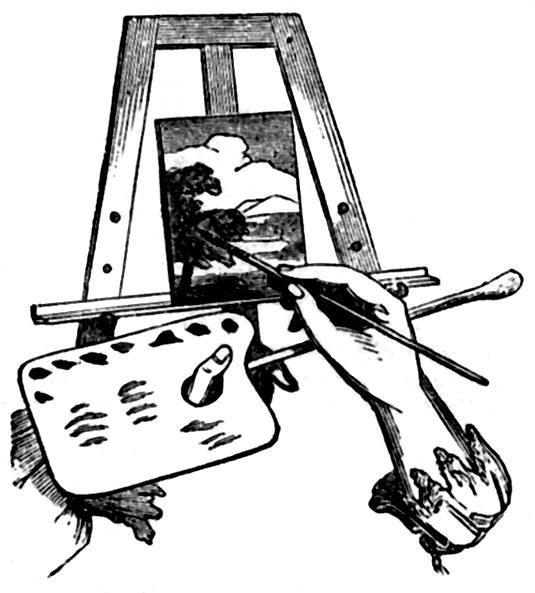
PORTABLE TABLE-EASEL.
Having the palette now set, you are all ready to begin to paint. Place your picture at a convenient height, So that you may not stoop to it; the left hand holds the palette, and the “rest, or mahl stick” on which you support the right hand, as shown in the engraving. The hands should be at some distance from the body, and the artist should sit rather erect, so there is no danger of injuring the chest. It is better to copy at first from a painting, matching the tints as nearly as possible, by holding them close to the original, on the knife. It is, however, very good practice to copy from engravings, where the artist must use his own taste in the colouring.
We will imagine a sketch of a “little shrimper,” and will now direct our pupil how to paint it throughout; it is an easy study, and will make a pleasing picture.
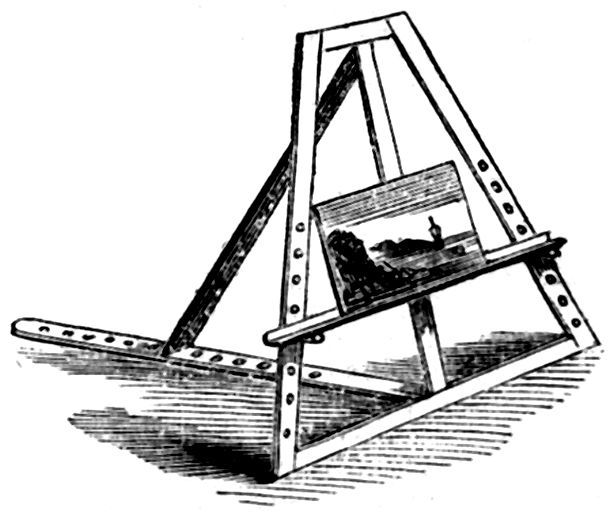
The sky round the head, cool gray cloud, composed of black, white, and vermilion; above the cloud a little blue sky of ultramarine and white, and a few streaks of white, Naples yellow, and vermilion at the horizon. The distant hill—shades of white, black, and vermilion; the nearer rocks—shades of white, black, and raw sienna; the ground, or shore—raw umber, white, or raw sienna, white, and black; the lightest part of the sea—black, white, and Naples yellow, melting off to black, and white, and a little blue; the pool of water in the foreground—black, white, burnt sienna, and a little gray in the lights (as the reflection of the sky); the basket and net—black, umber, or sienna; the face, hands, and legs may be painted with the flesh tints, and a little Indian red and vermilion for the lips, and black and burnt sienna for the eyes; the cap—for the darks, Indian red, black; middle tint—vermilion, Indian red; high light—vermilion and white. For the fold of white round the neck—white, subdued with umber; for the jacket—raw sienna, burnt sienna, and black in the shadow, and raw sienna and white in the light; for the trowsers—tints of blue and black, and blue and white; for the boots—black and a little Indian red, with white touches of light.
Paint in the sky first with a flat sable brush, not overloaded with colour, and rub it well in, so as to have no thick patches of colour on the board—soften with a hog’s-hair tool. The distance must also be painted with little body of paint. With a small brush lay in the face, the eye, and the dark parts first, with more colour in your brush than for the sky; then work downwards at the dress, &c., finishing as correctly as you can, laying on the lights with a flat sable, and with thicker colour on the shadows. The net must be painted with thin colour over the sky. This finishes the first painting, or “dead colouring,” as it is called. When quite dry (which in summer time will be in a day or two, but in damp weather longer), wash it with cold water, and dry it with a soft cloth; this is to prevent the colours from running and working as if they were greasy, when you begin to paint again. Rub over the parts you intend to paint, with a brush wet with a little linseed or oil or meglip, so as to leave the least possible quantity on the painting. This makes the colours combine with the first painting, and also enables you to wipe them entirely off, if you cannot succeed to your mind, while the previous work remains as it was.
Go over the painting with the same tints as in the dead colouring, correcting, improving, and softening, marking the high lights rather lighter, laying them on with spirited touches, and with rather stiff colour.
For the third, or last painting, when perfectly dry, wash and oil as before, and touch up, where it is needed, with the delicate flesh tints, adding a little madder lake on the cheeks.
The “glazing” is put on at this stage of the picture—that is, laying some transparent colour, mixed only with meglip, over any part, to enrich and give it depth; thus, some burnt sienna, glazed over the red cap, will have a very good effect. It must be put on sparingly, so as to see the former paintings through it, and even taken off entirely with a rag or the finger, in some places, as on the highest light. In the same manner may the jacket be glazed with burnt sienna, the trowsers with blue, and a little madder lake in the shadows, to enrich them.
We will now give a few general hints on working up a painting:—
Lay your colours on steadily and boldly, with as few strokes of the brush as you can help. Keep your tints pure and distinct, each in the place you mean it to be. Do not, by going over and over them with the brush more than you can avoid, muddle and mix the tints, for some tints destroy each other, and the transparency and beauty of the painting will be lost. In softening or uniting two tints, it is best either to use an intermediate shade, or else, with a clean brush and no colour, to melt them together. Much depends on the first painting. It should be lighter in colour than the picture is intended to be, as all colours sink, more or less, into the ground as they dry, and it can easily be glazed and toned down to the proper colour. The shadows should be put on thin in colour, the lights with a greater body of paint, with a sharp and firm touch. The brightest lights may be painted quite white, and glazed to the intended hue; but, though beautiful effects are produced by glazing, it is dangerous for the student to be too free in the use of it. Be as careful as you can in the earlier paintings; for it is impossible to glaze a bad picture into a good one.
“Scumbling” is the reverse of glazing, and is done by going over the painting when quite dry, with opaque tints of a lighter hue, generally with a mixture of white. It is of use in cooling down colours that are too bright, and in making objects appear more distant; smoke, mists, and the haziness of the far-off hills, are thus produced. It should be laid on very thinly with a hog’s-hair tool. Scumbling, however, must not go over shadows, as that would spoil their depth.
In painting a head, begin with the eyes and nose, then the forehead, mouth, cheeks, and hair; then go to the background, commencing at the top of the picture, and working down to the head. Backgrounds are very various, but there is generally a little lightish tint near the face, which melts off into deep shadow to the upper part of the picture. In black hair, or draperies, mix a little Indian red, to give a warmth and harmony. A brilliant effect is produced by some painters, who lay the first colouring of a head in gray tints only, composed of black, white, and Indian red, of different shades, using pure white for the high lights; and, when dry, glaze it all over with madder lake and raw sienna; then put on the carnation tints, and point up the shadows with burnt sienna and black. This would answer best for a large head, and is only one of the vagaries in which artists indulge. Let a beginner get the picture as like the copy as possible in the first painting, though rather lighter in tone.
During the progress of the work, frequently retire and look at it from a distance, to judge of the effect; to examine it also in a looking-glass is a good plan to detect any faults in the drawing. If you are copying from anything in nature, either landscape or figure, look at it occasionally with the eyes half-closed, or through a tube or roll of paper; the lights and shadows will by this means appear more distinct and defined, and the object more raised, and be more easily copied.
In our next chapter, we hope to give our readers a few hints on landscape painting, together with the choice of subjects, and the arrangement of a picture, &c.
Third Article. As Landscape Painting is one of the most favourite branches of the art, so it is one of the easiest; for, while keeping the general outline of a view, we can allow ourselves much latitude in details; we may make our trees more full in leaf, our rocks more moss-grown, our rivers more clear, and either bathe our scene in the golden light of sun-set, or make it solemn with “dark driving clouds,” without in anyway affecting the truthfulness of the scene.
The hints which we will give shall apply to any style of landscape.
The sky is always put in first, beginning with the blue of the sky, and working downwards with the various tints, be they golden or gray, according to the aspect you have chosen. In a clear unclouded sky, the blue is deepest above our heads, and melts off to the horizon, till it becomes a tender gray. Ultramarine and white is the purest sky tint, and a little black and vermilion combined with it, gives the most beautiful grays. Clouds are painted over the clear sky with deeper shades of gray, or with a little umber mixed with it; their bright edges are put on after the work is dry, and may be pure white or some flesh-coloured tint, according to the reflection of the sun. Lay the colour on sparingly with one of the larger brushes, in touches or pats, from left to right, beginning from the left-hand corner of the picture. The distances are put in with the gray sky tints, but a little darker in tone. The sky and distance should be softened with a large brush, and allowed to dry before proceeding to the other parts.
Trees, if thin of leaf, and showing much light through them, should be painted over the sky, otherwise they may be laid in at once, in masses of light and shade, and the leaves made over them when dry, with little touches of the brush, and rather thicker colour. There are many different “touches” for foliage, and it requires a little practice to get the habit of doing it well; some, with a fine brush with plenty of colour in it, make a kind of little loop, as if they were going to write the letters O or C; this leaves an oval, full touch. Sometimes a brush is crushed flat upon the colour, and stabbed on the painting, this leaves a star-like touch. Or an old hog or flat sable brush, with the hairs worn, and of different lengths, is used for a jagged foliage. These various touches may be pointed up and corrected by a fine brush. The receding parts of the foliage and the leaves that come against the sky, are painted with thin, transparent colour, with a small tool; the light touches with opaque tints. Foliage should not be made of too glaring a green. A good set of tints is made of blue, raw sienna, and white, blue and burnt sienna: and for light touches, raw sienna and white, or Naples yellow alone; for the dark shadows no blue is needed; shades of black and raw and burnt sienna give a warm olive tone. The lights may be glazed with sienna and a little blue to enrich them. You may produce the rough bark of near trees by painting the trunks rather dark, and putting over rugged, uneven touches of lightish gray, with a very full brush, and glazing it when dry with black and burnt sienna. For trees which are at some distance, and whose foliage appears of a grayish yellow cast, use black, Naples yellow, and white; for very distant trees, add the French blue and a little light red, to give the atmospheric tint.
The foreground must be painted with stronger colours, larger brushes, and bolder touches. For stalks of grass and weeds, a fine-pointed brush is used, and jerked upwards, which gives a spirited touch. For flat rocks or stones the lights are sometimes put on with the palette knife, the colour being taken on the knife, and laid upon the picture, in the manner (to use a homely simile) of spreading bread and butter; but as a nervous hand would most likely fail in this, the brush is the safest for a beginner. The foreground shadows should be glazed with rich tones of browns and olives. When the painting is finished to your mind, by touching upon it here and there (though you must be careful not to do too much, and spoil the spirit of it), you may scumble the distances; and the sky, if too blue, with white alone, or a gray tint; this gives a misty softness to the whole, and brings it to a conclusion.
We have thus given a few general rules for landscape painting, which is all we can do, nature’s tints being innumerable. Try on your palette different combinations of colour, and you may find out some beautiful tints yourself; and if you see any peculiar light or shade in your walks, try and discover the colours it is composed of—indeed, a painter should be always looking out for effects, always trying to learn something fresh from Nature herself, and every day the study will become more interesting.
We must not forget to give some directions for cleaning up, on which all your comfort in painting depends, if not much of the beauty of the picture. Never leave your tools uncleaned till next day; the paint will dry on the palette, and the oil in the brushes, and soon quite spoil them. Take up, on the knife, all the bits of pure colour you have to spare, and lay them on a plate; pour over them as much cold water as will cover them, and they will keep several days soft and workable. Scrape off the palette all the waste colour and oil; wipe it with a rag; pour on it some linseed oil, in which clean all the colour out of the brushes, wiping them, now and then, with a rag; dip them in clean oil, which is to remain in them. Wipe the dirty oil off the palette; put a little fresh on it, and rub it clean and dry. Be careful to keep it, and also the brushes, from dust. If some days are likely to elapse between your paintings, clean the brushes with spirits of turpentine, and dip them into olive oil, they may then be left for a fortnight without getting stiff, or “tacky”—the turpentine must be all wiped from them, or it will eat away the hair. Wash the hog tools in soap and water—warm is best—dry them by rubbing lightly and quickly over a cloth. After using oils or varnish, wipe the mouth of the bottles, to prevent the corks sticking fast; wipe the tubes, too, after using, that they may screw properly. All this may be speedily done with plenty of rags (old stockings make the best) and a newspaper underneath, with very slight soiling of the fingers.
Having now carried you through the practical part, we will speak of the subjects most suitable for the pencil. The various branches of art are divided as follows:—
The historical, or grand style, which includes historical, classical, and Scriptural subjects; this is the highest branch, and few can hope to arrive at excellence in it; as it not only requires a thorough knowledge of anatomy, but a fertile and well-stored mind.
Portrait painting is a delightful field for the pencil, and affords more pleasure than almost any other branch. Moreover, it is not much more difficult to copy a head from nature than from another painting. Persuade some friend who is good-natured enough to submit to be caricatured, or made hideous for the first few trials, to sit to you, and you will soon find it become easy. An old person’s face, with strongly-marked features, is the best study—children and young people are more troublesome as to expression.
Landscape, which includes Marine subjects, is a most popular style, and on a small scale, one of the most suitable for ladies.
BACKGAMMON. Backgammon is the modern name of a game of considerable antiquity in England, where it was formerly known by the appellation of “the tables.” The words back-gammon have been ascribed to the Welsh tongue, in which they are said to signify little battle; but Strutt, with greater plausibility, traces the term to the Saxon “bac and gamen—that is, back-game—so denominated because the performance consists in the two players bringing their men back from their antagonist’s tables into their own; or because the pieces are sometimes taken up and obliged to go back—that is, re-enter at the table they came from.” Whatever be the etymology of the term, the game has been long established in the country; and, as a fireside amusement of a decorous and exciting nature, is a favourite among clergymen, squires, farmers, and retired professional persons.
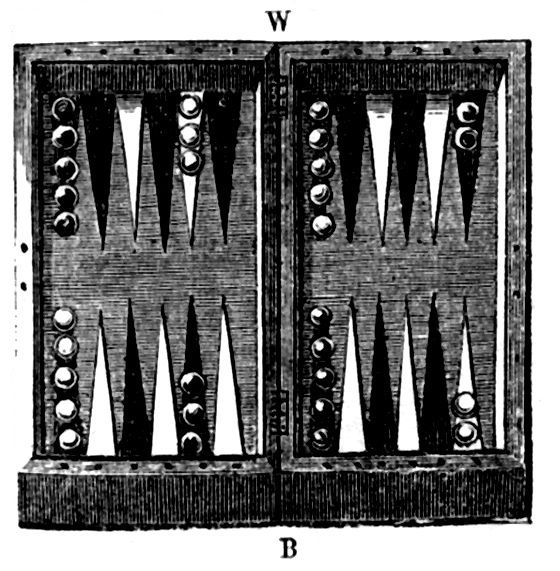
The Backgammon Table.
Backgammon is played with an apparatus consisting of a board or tables, men or pieces, dice, and dice-boxes. The introduction of dice into the game, and their constant use in determining moves, makes backgammon essentially a game of chance, and therefore brings two players of unequal talents nearer a level than other diversions in which skill is the sole or predominant element.
The backgammon board consists of two parts or tables, generally united by a hinge in the middle, by which they can be shut up as a box. Each table possesses twelve points, six at each end. These points are coloured white and black alternately; but this variation of colour has no reference to the game, and is only done to make the points more easily counted.
The game is played by two parties, and with thirty pieces or men; each party has fifteen men, one set of fifteen being black, and the other white. In beginning the game, the men are placed on certain points on the tables, as shewn in the foregoing figure.
The game is played with two dice and two dice-boxes. The dice are common to both; but each party uses his own dice-box, and the throws are alternate.
Each dice is a perfect cube, marked on its sides with dots from one to six. The one is called ace; the two, deuce; the three, tre, or trois; the four, quatre; the five, cinque; and the six, size. At every throw the two dice are employed; consequently, a person may throw from two up to twelve—that is two aces up to two sizes.
If a player throw doublets, or both dice of one number, double the number of dots is reckoned; thus, by a throw of two aces, the player does not count two, but four.
These numbers thrown, or accidentally turned up by the dice, bear a reference to the points on the tables. In order to understand this connection between the dice and the men, the learner must observe how the men are placed on the points, and the rules by which their shifting from one to another is governed.
The tables are here spread out as if two partners were seated, and about to begin to play. The party owning the white men is seated at W, and the party owning the black men at B. We shall call one party White and another Black. White counts round from the ace-point of Black, and Black counts round from the ace-point of White. These ace-points are respectively seen to have two men upon them in opposite corners of the same table.
The grand object of the game is for each party to get all his men played round into the table containing the aces, removing them from point to point agreeable to the throws of the dice.
In throwing, the number upon each die turned up may be reckoned by itself, or collectively, with the number on the other die. Thus, if quatre be thrown by one die, and size by the other, a man can be advanced four points, and another six points; or one man can be advanced ten points, always providing that a point is open to suit this movement to it. No point can be moved to if covered by two men belonging to the adversary. If covered by only one man, which is called a blot, then that man can be hit, and be removed from the point, and placed on the bar between the tables, his place being taken by the man who has won it.
The removal of a man to the bars throws a player considerably behind in the game, because the man must remain out of the play till the dice turn up a certain number corresponding to one open point on the adversary’s table. Being fortunate to get an open point by this means, the man must be entered and wrought round from thence, as in the case of others in the set to which he belongs. The frequent occurrence of this hitting of a blot gives an adversary a great advantage, and allows him to win the gammon.
There are two kinds of victory—winning the hit, and winning the gammon. The party who has played all his men round into his own table, and by fortunate throws of the dice has borne or played the men off the point first, wins the hit.
The gammon may be explained as follows: When you have got all your men round to your own table, covering every point, and your adversary has a man out, then you are enabled to bear or lift your men away. If you can bear all away, so as to clear your table before the adversary gets his man placed by a throw on your table, you win the gammon. If the adversary has been able to bear one before you have borne all your men, it reduces the victory to a hit.
Two hits are reckoned equal to one gammon in playing matches. To win two games out of three is called winning the rub, as at whist.
Hoyle’s Directions for Bearing Men.—If a player has taken up two of the adversary’s men, and happens to have two, three, or more points made in his own tables, he should spread his men, that he either may take a new point in his tables, or be ready to hit the man which the adversary may happen to enter. If he finds, upon the adversary’s entering, that the game is upon a par, or that the advantage is on his own side, he should take the adversary’s man up whenever he can, it being twenty-five to eleven that he is not hit; except when he is playing for a single hit only; then, if playing the throw otherwise gives him a better chance for it, he ought to do it.
It being five to one against his being hit with double dice, he should never be deterred from taking up any one man of the adversary’s.
If he has taken up one of the adversary’s men, and should happen to have five points in his own tables, and forced to leave a blot out of his tables, he should endeavour to leave it upon doublets preferable to any other chance, because in that case the odds are thirty-five to one that he is not hit; whereas it is only seventeen to one that he is hit upon any other chance.
When the adversary is very forward, a player should never move a man from his quatre-, trois-, or deuce-points, thinking to bear that man from the point where he put it, as nothing but high doublets can give him any chance for the hit. Instead of playing an ace or a deuce from any of those points, he should play them from his own size or highest points; so that throwing two fives or two fours, his size and cinque points being eased, would be a considerable advantage to him; whereas, had they been loaded, he must have been obliged to play otherwise.
It is the interest of the adversary to take up the player as soon as he enters. The blot should be left upon the adversary’s lowest point—that is to say, upon his deuce-point rather than upon his trois-point; or upon his trois-point rather than upon his quatre-point; or upon his quatre-point preferable to his cinque-point—for a reason before mentioned: all the men the adversary plays upon his trois or his deuce-points are deemed lost, being greatly out of play; so that those men, not having it in their power to make his cinque-point, and his game being crowded in one place, and open in another, the adversary must be greatly annoyed by the player.
If the player has two of the adversary’s men in his tables, he has a better chance for a hit than if he had more, provided his game is forwarder than that of his antagonist; for if he had three or more of the adversary’s men in his tables, he would stand a worse chance to be hit.
When a player is running to save the gammon, if he should have two men upon his ace-point, and several men abroad, although he should lose one point or two in putting his men into his tables, it is his interest to leave a man upon the adversary’s ace-point, because it will prevent his adversary from bearing his men to the greatest advantage, and, at the same time, the player will have a chance of the adversary’s making a blot, which he may chance to hit. However, if a player finds, upon a throw, that he has a probability of saving his gammon, he should never wait for a blot, as the odds are greatly against his hitting it, but should embrace that opportunity.
ROLLING BLINDS. There is often a great difficulty in making a blind roll nicely after it has been washed: this difficulty may be effectually obviated by attending to the following directions:—Be careful that in drying the blind, it is not stretched out of shape, by being carelessly thrown upon a hedge of unequal heights, or pegged to a line in a crooked manner. The best mode of drying is to lay it lightly on an even grass plot. When there is a little moisture remaining, fold the blind by carefully placing the two ends exactly together, not the two sides, as is proper in folding most other things: then fold the middle to the two ends, and again fold it in the same direction until it is a convenient width for mangling. There is to be no fold running from end to end of the blind. It may then be carefully mangled. It must be nailed exactly straight upon the roller, or it will not roll well, whether washed or unwashed.
DAYS OF THE WEEK (ROMAN NAMES OF). Sunday was called Dies Solis, or the Sun’s day; Monday, Dies Lunæ, or the Moon’s day; Tuesday, Dies Martis, or Mar’s day; Wednesday, Dies Mercurii, or Mercury’s day; Thursday, Dies Jovis, or Jupiter’s day; Friday, Dies Veneris, or Venus’s day; and Saturday, Dies Saturni, or Saturn’s day. The reason they were named thus, was because they considered each of these deities to preside over the day dedicated to them.
BANDAGES. There is not a more important art connected with household surgery than that of bandaging. To do it well requires much practice and no little judgment; even hospital dressers are not always perfect in this branch of their operations; and we have known “family doctors” make a sad bungle of bandaging a leg or an arm. On the other hand, we have seen it so deftly performed, that no piece of machinery-work could excel it; so smooth and regular, so compact and firm; every fold and diagonal turn falling into its exact place, and maintaining its proper relative position; each layer of even texture fading off, as it were, from its fellow, and in turn supporting another, with no undue strain or pressure on any part; the very perfection of close binding. We do not expect many of our readers to accomplish this; but it will be as well for them to understand how it is done, that they may, when the emergency arises, know how to go about it. First of all let us ask what is a bandage?
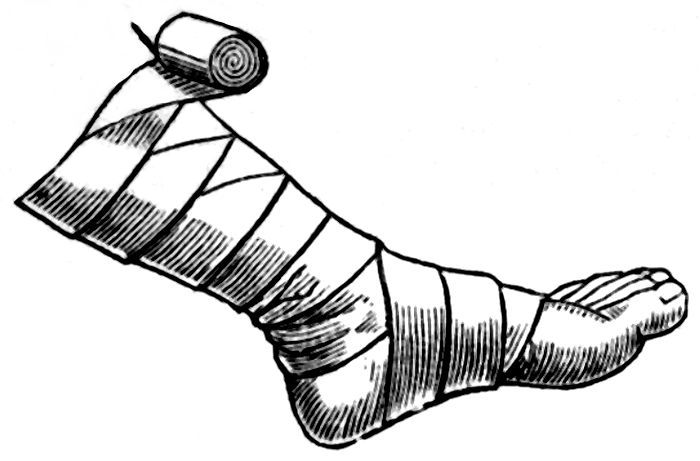
Something that binds, a fillet, a piece of linen or cloth for binding up a wounded limb. The material employed for this purpose is usually stout unbleached calico, from two or three to nine or ten inches wide, and from six to twelve yards long; the former length and breadth will do best for the leg. If commenced at the ball of the foot, and evenly applied, so that each fold overlaps the other about one-third, it will reach to the knee; the preceding cut will best show the mode of application. The bandage having been first tightly rolled up, is taken in the right hand of the operator; the end is passed under the foot, and held there by the left hand until it is secured by one turn of the bandage over it; an upward direction is then taken, so that a couple of folds bring the bandage up to the front of the leg, over the instep; the next turn will naturally pass over the heel behind; and then, if proper care be observed, it will go on fold above fold, each overlapping the other slightly, all up the leg; the bandage is passed from the right to the left hand each time that it goes round the leg, and great care should be taken to hold it firmly, and equalize the pressure, as well as to smooth out any wrinkles that may occur in the process of binding. A firm and even support is thus afforded to the limb, which is not likely to crease, or get displaced by the motion which may be afterwards necessary; it may be made fast above the calf by a couple of pins, or a needle and thread. Great care should be taken in this, as in all similar operations, to get the bandage rolled up tightly and smoothly, before commencing; it may thus be grasped in the hand, and kept well under the command of the operator, who should on no account let go his hold of the bandage, so as to relax the pressure.
The arm does not require so long or broad a bandage as the leg; about two inches, by three or four yards, being the average size: this limb is rather more difficult to manage, half turns being necessary to effect a proper envelopment. How this is effected may be seen by the following cut. The bandage is folded back upon itself, so as to take a different direction, and cover the space which would be left exposed by the ordinary method of folding; these half turns, unless they are done tightly and evenly, will be very apt to slip and derange the whole binding.
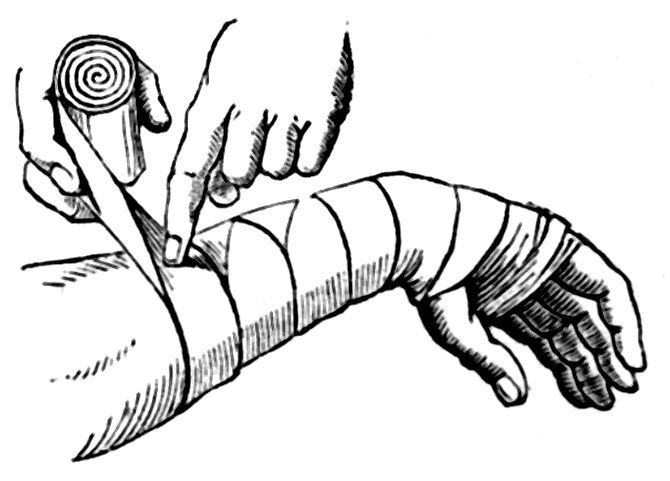
Some operators avoid half turns by letting the roller take its natural course, and then coming back to cover the exposed parts; but this method, besides requiring a larger bandage, does not effect the required purpose so neatly and efficiently. One mode of fastening a bandage is to split it up a short distance, so as to leave two ends, which can be passed round the limb, and tied. It should always be borne in mind that the chief art in applying bandages is to give firm and uniform support, without undue pressure upon any part; and to effect this properly, the strain in winding should be upon the whole roll held in the hand, and not upon the unrolled portion of it; and this strain should not be relaxed during the operation.
The next cut represents the mode of applying what is called a many-tailed bandage, useful to apply over a wound, or wherever it requires frequent changing, or in cases in which it is desirable not to exhaust the patient by much movement of the limb. This is a strip of calico somewhat longer than the limb to be enveloped; on it are sewn, at right angles, other strips, about one-half longer than the circumference of the limb, each overlapping the other about one-third of its breadth, so that when drawn tightly over in regular succession, each secures the other; the end of the strip passes under the heel, and coming up on the other side, is made fast to the bandage there, and so all is kept firm.
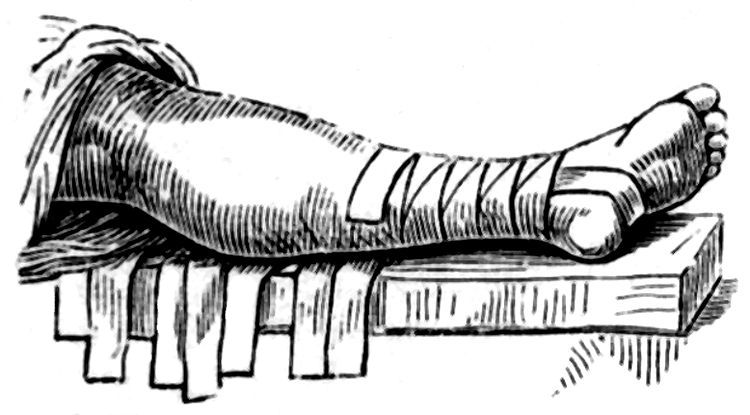
For keeping poultices on the lower part of the back, or in the groin, a cross bandage is used, the fashion of which is this: make a calico band large enough to pass round the loins, and tie a buckle in front; to this is attached another piece, which proceeds from the centre of the back to the anus, where it divides into two, which pass under the thighs, up on either side, and are fastened to the band in front. The bandage used to close a vein after bleeding is commonly called a figure of eight.
For a sprained ankle, place the end of the bandage upon the instep, then carry it round, and bring it over the same part again, and from thence round the foot two or three times, finishing off with a turn or two round the leg above the ankle.
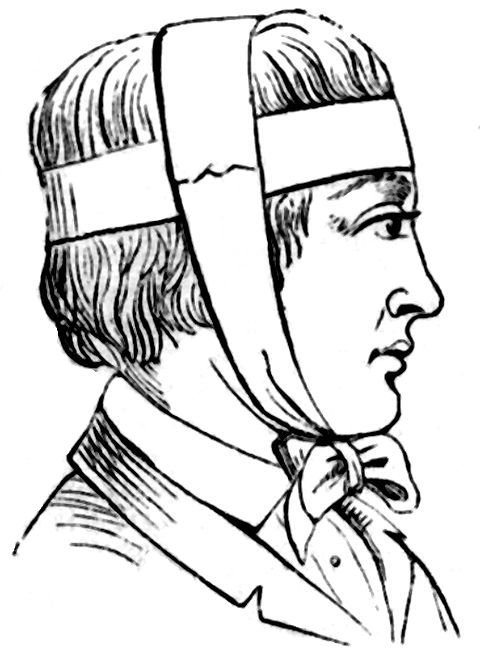
For a sprained wrist begin by passing the bandage round the hand, across and across, like the figure 8; exclude the thumb, and finish with a turn or two round the wrist.
For a cut finger, pass the bandage, a narrow one, round the finger several times, winding from the top, and splitting the end, fasten by tying round the thick part above the cut; or if it be high up, tie round the wrist.
The best bandage for the eye is an old silk handkerchief passed over the forehead, and tied at the back of the head. For the head itself, it is best to have a cross-bandage, or rather two bandages; one passing across the forehead, and round the back of the head, and the other over the top of the head, and below the chin, as in the preceding cut. Or, better than this is, perhaps, a large handkerchief which will extend all over the forehead and crown, two ends of it passing to the back, and after crossing from thence round the neck, then tying the other two beneath the chin.
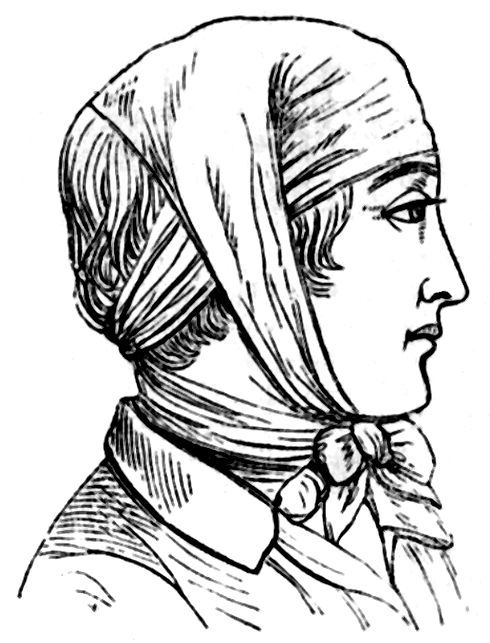
For a bandage to support a pad or poultice under the armpit, a handkerchief may be used, put on as in the following cut; or a broad piece of calico, arranged in the same way.
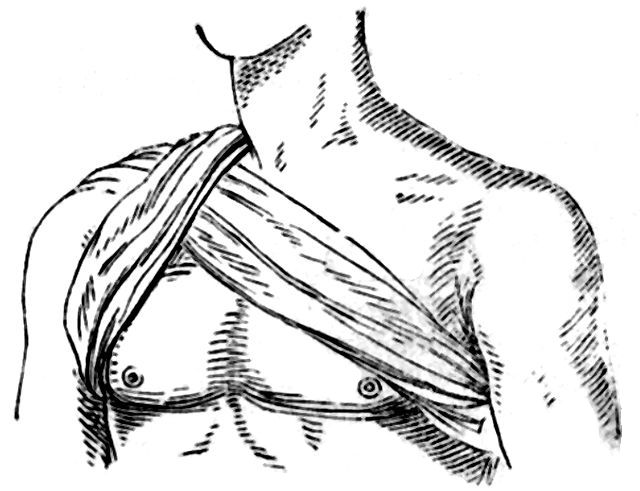
For fracture of the ribs, bandages should be about nine inches wide, and drawn round the body very tightly; in this case, as in that of any other fracture or dislocation, only a properly qualified person should attempt their application.
We have not yet spoken of the T bandage, which is simply a broad band to pass round the body or elsewhere, having attached to it one of the same width, or narrower, like the upright part of the letter after which it is named; or, there may be two stems, if they can be so called, in which case it is a double T bandage, as under.
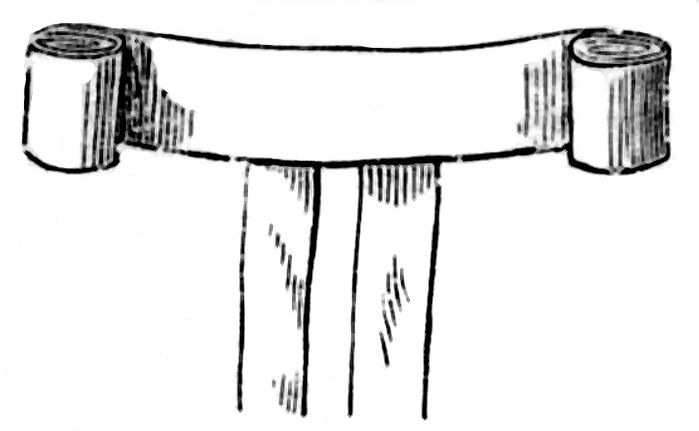
Starch bandages are those in which the roller, before it is put on, is saturated in a strong solution of starch. Sometimes a covering of brown paper is put over this, and another dry bandage is applied; this makes a firm and compact case for the limb; it is useful in cases of fracture, especially if the patient has to be removed to a distance. Sometimes, when it is not desirable to make the covering so thick and durable, the displacement of the bandages is guarded against by brushing a weak solution of starch or gum over the folds.
Bandaging should be performed in nearly all cases from the extremities upwards, or inwards to the heart, except where the injury is situated above the seat of vital action. If they give much pain there is reason to suspect inflammatory swelling beneath, and they should be loosened, if moistening with cold water does not relieve the pain. Flannel for bandages is used where warmth as well as support is required.—Family Doctor.
KALI and ALKALI. These words had originally a similar meaning. The latter term is now applied to a class of bodies having peculiar properties, whilst the term kali is mostly confined to potash, the most active of the class of alkalies. The metal potassium is sometimes called kalium, and the symbol is always written with the initial letter K.
HIEROGLYPHICS. Hieroglyphics consist in certain symbols which are made to stand for invisible objects, on account of some analogy which such symbols were supposed to bear to the objects. Egypt was the country where this sort of writing was most studied, and brought into a regular science. In hieroglyphics was conveyed all the boasted knowledge of their priests. According to the properties which they ascribed to animals, they chose them to be the emblems of moral objects. Thus ingratitude was expressed by a viper; imprudence, by a fly; wisdom, by an ant; knowledge, by an eye; eternity, by a circle, which has neither beginning nor end; a man universally shunned, by an eel, which they supposed to be found with no other fish. Sometimes they joined two or more of these characters together; as, a serpent with a hawk’s head denoted nature, with God presiding over it. Hieroglyphics may be made an interesting medium for instructing the young, as occasionally shown in the “Pastime” department of the “Family Friend.”
MICROSCOPE GLASSES (TO CLEAN). When you clean the eye-glasses, do not remove more than one at a time, and be sure to replace it before you begin another; by this means you will be sure to preserve the component glasses in their proper places; recollect that if they become intermingled, they will be useless. Keep a piece of well-dusted chamois leather, slightly impregnated with some of the finest putty or crocus powder, in a little box to wipe them with—for it is of consequence to preserve it from dust and damp; the former will scratch the glasses, and the latter will prevent you from wiping them clean. As to the object-glasses, endeavour to keep them as clean as possible without wiping, and merely use a camel’s-hair pencil to brush them with; for wiping them hard with anything has always a tendency to destroy their adjustment, unless they are firmly burnished into their cells (see Microscope, p. 92).
PHONOGRAPHY. Phonography includes every method of writing by signs that represent the sounds of the language. It differs from stenography in this respect:—Stenography uses characters to represent words by their spelling, instead of their sound; hence phonography is much the shortest and simplest mode of shorthand writing.
VOICE, HUMAN (RANGE OF THE). The range of the human voice is quite astounding,—there being about 9 perfect tones, but 17,592,186,044,515 different sounds; thus 14 direct muscles, alone, or together, produce 16,383; 30 indirect muscles, ditto, 173,741,823, and all in co-operation produce the number we have named; and these, independently of different degrees of intensity. A man’s voice ranges from bass to tenor, the medium being what is called a barytone. The female voice ranges from contralto to soprano, the medium being termed a mezzo-soprano,—whereas, a boy’s voice is alto, or between a tenor and a treble.
PINCHBECK. This alloy derives its name from being brought into notice by a person of the name of Pinchbeck. It may be made by combining three parts of zinc with four of copper. It was formerly used to make the cases of watches and brooch settings.
MEDICINES (APERIENT). Spring Aperients. For children, nothing is better than:—1. Brimstone and treacle; to each teacupful of this, when mixed, add a teaspoonful of cream of tartar. As this sometimes produces sickness, the following may be used:—2. Take of tartrate of soda, one drachm and a-half; powdered jalap and powdered rhubarb, each fifteen grains; ginger, two grains. Mix. Dose for a child above five years, one small teaspoonful; above ten years, a large teaspoonful; above fifteen, half the whole, or two teaspoonsful; and for a person above twenty, three teaspoonsful, or the whole, as may be required by the habit of the person. This medicine may be dissolved in warm water, common, or mint tea. This powder can be kept for use in a wide-mouthed bottle, and be in readiness for any emergency. The druggist may be directed to treble or quadruple the quantities as convenient.
Aperient Pills. To some adults, all liquid medicines produce such nausea that pills are the only form in which laxative medicines can be exhibited; the following is a useful formula:—3. Take of compound rhubarb pill, a drachm and one scruple; of powdered ipecacuanha, six grains; and of extract of hyoscyamus, one scruple. Mix and beat into a mass, and divide into twenty-four pills. Take one, or two, or if of a very costive habit, three at bed-time. 4. For persons requiring a more powerful purge, the same formula, with ten grains of compound extract of colocynth, will form a good purgative pill. The mass receiving this addition, must be divided into thirty, instead of twenty-four pills.
Tonic Aperient. 5. Take of Epsom salts, one ounce; diluted sulphuric acid, one drachm; infusion of quassia chips, half an imperial pint; compound tincture of rhubarb, two drachms. Half a wineglassful for a dose twice a-day.
Black Draught. 6. The common aperient medicine known as black draught is made in the following manner:—Take of senna leaves, six drachms; bruised ginger, half a drachm; sliced liquorice-root, four drachms; boiling water half an imperial pint. Keep this standing on the hob, or near the fire, for three hours, then strain, and after allowing it to grow cool, add of sal volatile, one drachm and a-half; of tincture of senna, and of tincture of cardamoms; each half an ounce. This mixture will keep a long time in a cool place. Dose, a wineglassful for an adult; two tablespoonsful for young persons above fifteen years of age. It is not a suitable medicine for children.
Infants’ Aperient. 7. Take of rhubarb, five grains; magnesia, three grains; white sugar, a scruple; manna, five grains; mix. Dose, varying from a piece half the size of a sweet-pea to a piece the size of an ordinary pea. 8. A useful laxative for children is composed of calomel, two grains; and sugar, a scruple; made into five powders; half of one of these for a child from birth to one year and a-half, and a whole one from that age to five years.
AQUARIA (PARLOUR). An Aquarium is a collection of aquatic plants and animals placed in conditions as nearly natural as possible, so as to afford at all times a view of their modes of growth and reproduction, and of such particulars of their habits and economy as are open to observations through the medium of the glass vessel which contains them. It is the simplicity of the Aquarium that ensures its success, and most excites the admiration of the scientific observer.
Supposing the student to have made this choice of a vessel, his next step will be to determine whether it shall be stocked with marine or fresh-water specimens; marine stock is the most expensive, and the most difficult to manage. One great difficulty of the marine tank, that of obtaining fresh sea-water, is obviated by the use of the prepared marine salts, by means of which we can manufacture sea-water out of the water-butt; and, more interesting still, if properly managed, this artificial sea-water is in some respects preferable to the genuine article, on account of its freedom from organic matter.
But those who use artificial sea-water for the first time, need a caution. As at present prepared, it is not so pure as might be desired, and it deposits a reddish sediment, consisting of oxide of iron and particles of lime and sand. To obviate the consequences of such impurities, it is advisable to dissolve it in a separate vessel placed at a higher level than the tank into which it is to be transferred. First place your tank as it is to remain,—for when filled, you will be unable to move it,—then dissolve the salts in clear spring or river-water, and test its strength by the hydrometer, till its specific gravity is 1.028. It should be left undisturbed for four-and-twenty hours, in order that any sediment may be deposited; and it may then be drawn off into the tank by means of a syphon of glass or gutta percha, and the deposit left behind. The object of placing the pan at a higher level than the tank, is to facilitate the action of the syphon. A loose glass lid, to keep out dust, is a necessary addition to the tank in any case.
In stocking a marine tank, a stratum of sea-sand and pebbles should first be laid down, or, if these are not easily procurable, common silver-sand may be used, if the precaution be taken to wash it well previously, so as to dissolve out any solvent matters. From this point the difficulties begin. A beginner may introduce plants that speedily decay, and animals that perish in a day or two. If a sea-side rambler, he may gather many curiosities for the tank, and soon have the mortification of finding that some of the prettiest of his specimens have ruined the whole by their rapid decomposition.
But if the specific gravity be first accurately tested, one or two plants of the genus Ulva, or sea-lettuce, should first be introduced, then one or two of the genus Enteromorpha; and, in eight or nine days, these will convey to the water certain properties which fit it for the reception or animals. Long experience proves that plants of any genus, except the two first-named, are utterly unsuitable for a new tank, and many months must elapse before Rhodosperms and other delicate weeds can be used with safety. The fact is, that artificial sea-water is deficient of some minute quantities of certain chemical ingredients, such as iodine and bromine, for instance; and in process of time, these materials are communicated to it by the Ulva and Enteromorpha, and it becomes fitted for more delicately constituted plants and animals.
If fully exposed to the daylight, the sea-weeds will in the course of eight or ten days disseminate their spores, and the stones at the bottom will begin to evolve from their surfaces bubbles of oxygen. Now some common sorts of anemonies may be introduced, such as Actinia Mesembryanthemum, A. clavata, and A. bellis, but A. crassicornis and Anthea cereus are too delicate for early experiments.
Some pretty molluscs may be introduced at the earliest stages, if all goes well, even a few days after the sea-weeds, especially species of Trochus and any of the common sorts of periwinkle. Bivalves are less hardy; and another ten days ought to elapse before specimens of Venus and Pallustra are added. When the last-named are introduced, a few Chitons, Scallops, and Aplysia may be added. As the weeds grow, there will be oxygen sufficient to render the initiation of crustaceans safe, and such crabs as the fiddler, the soldier, and the pretty strawberry crab may follow, as well as a few prawns and shrimps.
The time will now come for increasing the amount of vegetation, and Laminaria phyllitis, Cladophora rupestris, Rhodymenia palmata, and the lovely Griffithsia, with the curious Padina if you can get it, and, indeed, any green or red weeds except tangle and oar-weed.
Marine fishes are suitable for none but very ripe tanks, and even then are difficult to preserve for any length of time. Gobies, blennies, and wrasses are, however, too beautiful not to be worth an effort to domesticate them, and the experience gained in establishing the collection will enable the possessor to proceed with proper caution in the introduction of such lively and intelligent inmates. If the weeds hang out their gay banners, and put out their slender fingers with certain signs of healthy growth, pipe fishes, suckers, marine sticklebacks, small lobsters, and nudibranch molluscs may follow, until an extensive collection is formed of creatures that we never before had opportunities of observing alive, many of which we were never previously acquainted with, even when dead.
As a domestic ornament, combining instruction with a novel kind of recreation, the fresh-water aquarium has already taken precedence of the marine, and will doubtless keep it. The marine tank is certainly the most attractive to the eyes of a student, but the fresh-water tank is at once cheaper, more easily stocked and managed, and unattended with the risks that beset marine life even under the most favourable circumstances. The nearest brook or pond will furnish fluviatile specimens, and generally speaking, these are so easy of management, that a child might set up a tank of this kind, and maintain it in a flourishing condition.
Yet it must not be supposed that there is nothing to learn even in this case, though the experience acquired through many trials and disappointments may be very briefly told for the benefit of beginners. As a rule, it may be held that either rockwork or branching coral is a necessity as well as an ornament of a marine tank, but rockwork of any kind is a positive injury to a fresh-water collection; it soon gets covered with confervæ, which is the greatest enemy to the collection. It may here be mentioned, too, that propagating glasses are not strong enough to bear the weight of rockwork; and if they were, it is scarcely an ornament to any cylindrical vessel: so that in the case of marine stock, a piece of branching coral is the only ornament of the kind suited to a cylinder.
In forming the bed of the fresh-water tank, we should advise the use of sharp sand only with a few small pebbles, the whole well washed previously. Writers on aquarian subjects have invariably recommended the use of mould, but the tank can be kept more free from objectionable vegetable growths, and hence more brilliantly transparent, if pure sand be used, while all the ordinary weeds, Vallisneria, Anacharsis, lilies, &c., grow just as well in sand as in mould, and if the barbel and stone loach are inclined to stir it up with their bearded snouts, there is no muddy deposit on the sides of the vessel in consequence. Indeed, when a hungry loach smells a worm, he will stir up the bottom as violently as a cook would stir up batter; and if there be any solvent matter there, the leaves of the Vallisneria and Stratoides will soon be coated with slime, and upon that slime fucus will soon appear.
As to the plants for a fresh-water tank, there is scarcely a weed to be found in any brook or river but may be safely transplanted to it, a little washing and trimming being necessary to remove decaying matter. Vallisneria spiralis is essential, for it is one of the best oxygen makers, a free grower, and very elegant in outline; the great water soldier (Stratoides) with its spiny leaves shaped like those of the Yucca gloriosa, and with its elegant offshoots starting up like so many umbrella frames on very long stems, is another good oxygen maker. The new water-weed Anacharsis alsinastrum, the pretty Ranunculus aquatalis, Myriophyllum spicatum and Potamogeton of any species, besides the smaller kinds of water-lily, flourish amazingly, and give the tank a fresh and luxuriant appearance. To those who live in the north, we commend a little plant which may be found on the shallow margins and lakes at great elevations. It is the pretty awl-wort, Subularia aquatica, a member of the extensive family of Cruciferæ. It produces numerous rush-like leaves, each of them curved at the point like a cobbler’s awl—whence its name; and in July sends up a little head of tetraform white blossoms strongly resembling those of the water-cress. Though somewhat rare, it takes to its indoor home kindly, and blooms freely beneath the surface, very much to the astonishment of non-botanical observers.
Unlike the marine tank, the fresh-water vessel may be stocked with fishes and plants at the same time, but the precaution must be taken to throw in a few handfuls of some common weed, which should be left to float about and supply oxygen until the plants at the bottom have fairly taken root. A mass of floating weeds is a decided improvement to the tank, and creates a rich green shadow in which the fishes delight, and most of the succulent weeds from brooks will flourish in this way for many months, and even increase considerably by the numerous white rootlets they send down from their joints, some of which will probably reach the bottom and produce a forest of vegetation.
Among the animal stock, minnows, carp, barbel, stone loach, perch, dace, roach, bream, bleak, and chub, and water lizards, are all suitable. Dace and roach are perhaps the most delicate; carp and minnows the most hardy. We have at the present time about a hundred of various kinds of fresh-water fish, some of them so tame as to take food from the hand, and even nibble the fingers sharply; they swarm to the side of the vessel when we tap on it with the finger nails, and will hunt a piece of bread or white of egg, as we move it up and down outside, in a lively style that would make phlegmatic dulness laugh itself into hysterics anytime. The molluscs to be most strongly recommended are Planorbis corneus, a handsome snail of a ram’s-horn shape, Paludina Vivipara, all the kinds of Lymnea, Bithinia tentacula, and the very useful bivalves, the swan mussel, Anoden cygneus, and the duck mussel, Unis pictorum. Though we recommend these, we are bound to add that the Lymnea, though good cleaners, are given to the vice of eating the Vallisneria and the Stratoides; that Paludina is of little use as a cleaner, his beauty only recommending him; and that Planorbis is the best of all cleaners, and rarely deserts the side of the vessel, where snails should remain as much as possible.
We seldom feed our marine stock, but occasionally the flesh of a cooked prawn, or a few minute shreds of mutton, may be given; fresh-water stock delight in the crumbs of home-baked bread, white of egg minced very fine, soft insect food of any kind, particularly maggots and flies, and, above all, small red worms. A romp may be got up at any time, by dropping in a lively worm; the minnows seize it and fight till they tear it in half; before they can gorge it, the loach attack them, and there is so much floundering, that the fragments of the worm are dropped into the jaws of a newt, who seizes it in the manner of a cat seizing a mouse, and the game ends by the newt retaining a firm hold, with half the worm projecting from his mouth, and half a dozen fishes scrambling to tear it out, till the newt triumphs by a sullen perseverance, and gets the prey fairly swallowed, in little less than an hour, during the whole of which time it is worried, in vain, by almost every one of its more lively neighbours.
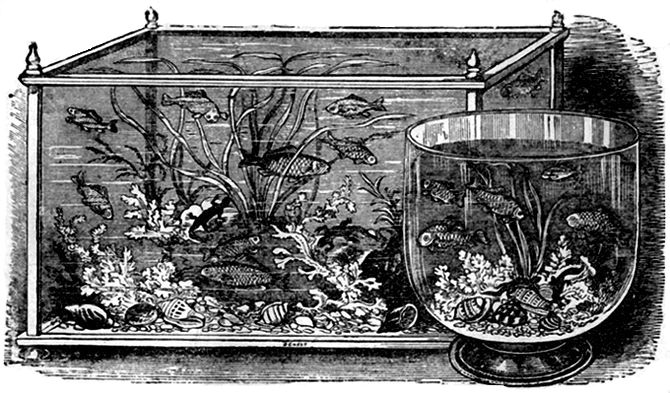
In every case the success of an Aquarium depends upon the adjustment of a fair balance of forces, and if care be taken to remove any matter that might decay and create corruption, and to introduce only as much animal life as the plants are capable of supplying with oxygen, death will then be a rare event. The water should not be changed at all, that is one of the leading features of the Aquarium; and if you cannot keep your stock in health, without a change of water, depend upon it you have gone the wrong way to work, and must begin again de novo. An important matter is to avoid overstocking; keep down the amount of animal life, until the plants are strong, and then increase it slowly, so as to see your progress safely. Whenever you find your fishes gasping at the surface, be sure that there is insufficiency of oxygen, and remove a few to another vessel; for whenever a fish stands upon his tail at the surface for any length of time, it is certain that disease is at work, and that his hours are numbered.
FIGS. (Latin, Ficus.) The fruit of the Ficus Carica, which comes to perfection chiefly in hot climates; the pulp is wholesome, and somewhat aperient, but the tough skin is indigestible, and should not be eaten by those whose organs of digestion are at all weak. Children who are subject to constipation, may take the pulp with advantage. Green figs, as we call those which grow in this country, are more laxative than the preserved ones from abroad, but they have a mawkish, and, to most persons, an unpleasant flavour.
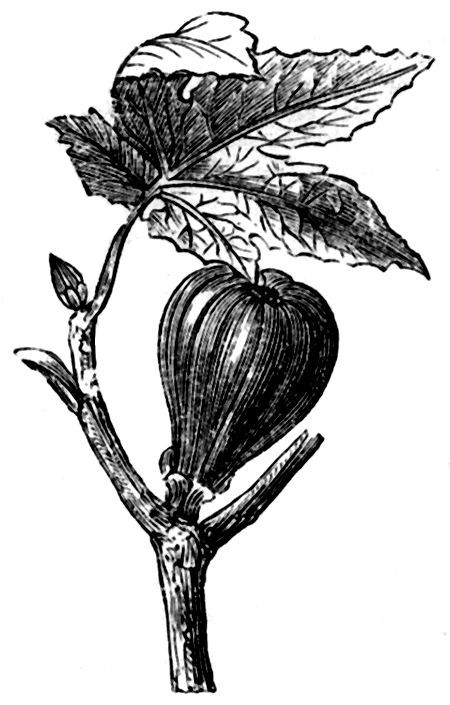
The finest foreign figs come from Smyrna, and other parts of Turkey; if good, they are large and plump, not shrivelled and leathery, as those in the shops too frequently are, being in this state very unwholesome. Figs are sometimes used externally, boiled in milk, or roasted; they are applied to boils and small abscesses, to promote suppuration; in this way they are particularly applicable to gum-boils. They are also an ingredient in the compound Decoction of Barley and Confection of Senna. In the following combination, they make a good demulcent gargle for inflammatory sore throats—Mallow Roots, 1 ounce; or if these cannot be obtained, Linseed, 1 ounce; to 2 or 3 figs, split open; Water, 2 pints; boil to a pint, and strain.
FILBERTS. The fruit of a variety of the Corylus Avellana. The term was originally applied to all nuts with very long husks; but of late the varieties have become so numerous, that this distinction has ceased to be regarded, and nut and filbert have become almost synonymous terms, except that the wild, uncultivated hazelnut, and those varieties which nearly approach it in form, are never called filberts, the eating of which, except as an occasional luxury, we would warn our readers against; like all nuts, they are very indigestible; perhaps now and then, with a glass of good port or sherry wine, and a little salt (cum grano salis), they may do no great harm, but it would be exercising a sound discretion not to eat them at all.
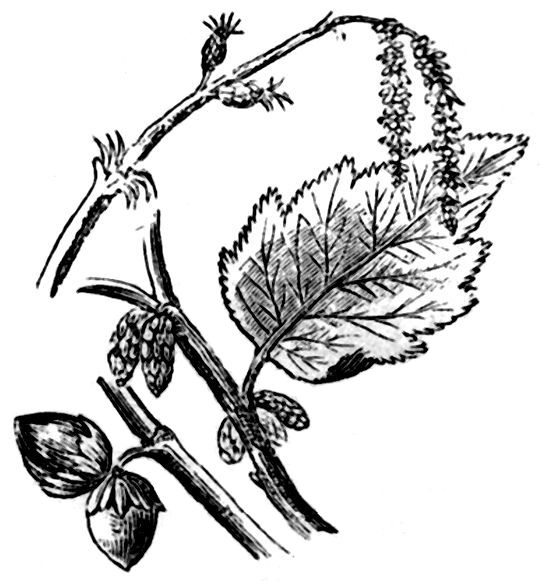
PAPER. Paper is manufactured of vegetable matter reduced to a pulp by means of water and grinding. For the chief purpose to which it is applied in modern times, the ancients had recourse to a variety of materials; such as stone—tablets of wood, plates of lead, skins, parchment, linen, and, above all, the papyrus. Of all these articles, papyrus was found the most useful for ordinary purposes as a substitute for paper. The art of making papyrus into paper was invented in Egypt several centuries before the Christian era. The art of making paper of cotton, cloth, or rags, is supposed to have been borrowed from the Chinese or Persians, and introduced into Europe in the eleventh century by the Saracens; the practice of making linen into paper commenced in the twelfth or thirteenth century, and in France and England early in the fourteenth century. (See Papyrus, p. 251).
DRAUGHTS. Draughts is a game with a checkered board and men, of much less antiquity than chess, and is perhaps to be considered a degenerate descendant of that noble sport. In France, it is called les dames, from having been a favourite game with ladies; and in Scotland this signification is preserved in the term dam-brod, the name universally applied by the common people to the draught-board.
Draughts is played on a chess-board, or a board checkered precisely in the same manner, with thirty-two white, and thirty-two black squares. The board, however, is placed before the players differently. In chess there must be a white square in the right-hand corner, but in draughts the right-hand corner must be black—that is, supposing you to play on the white squares. The following is a representation of a draught-board, numbered for the sake of illustration, and placed as it should be in playing.
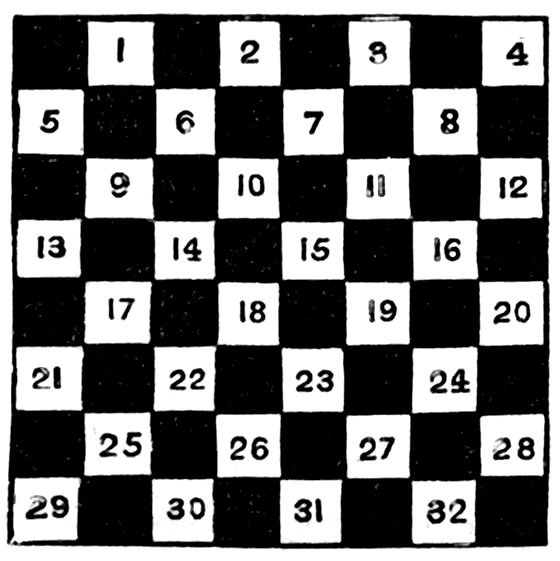
The game is played by two persons, who sit opposite to each other. Each party has a set of twelve men, the colour of the two being different, for the sake of distinction. The men are generally round and flat pieces of wood; one set white, and another black; those of the neatest kind are turned out of boxwood and ebony.
The men may be placed either on the white or black squares, but the whole must be put on one colour only. It is customary in England to place all upon the white, and to have, as above, a black square on the right. In Scotland the black are played upon, when there is consequently a white square to the right. We go upon the supposition that the play is on the white squares, and have numbered them in the above figure accordingly.
The movements in draughts are very simple: a man can move only one square at a time, and diagonally, never straightforward or sidewise. If an enemy’s man stand in the way, no move can take place, unless there be a vacant square beyond into which the piece can be lifted. In this case, the man leaped over is taken; he is removed from the board.
The grand object of the game, then, is to clear the board of the enemy’s men, or to hem them in so that they cannot move; and whichever party does so first gains the victory. As no piece can move more than one step diagonally at a time, there can be no taking till the two antagonists come to close quarters; and the pushing them cautiously into each other’s neighbourhood is the principal art in the game.
When the men on either side have cleared their way by taking, or found an open path to the opposite side of the board, they become invested with a new power of movement: by reaching the first row of squares on the opposite side, the piece is entitled to be crowned, which is done by placing a man on the top of it. Thus crowned, the man may move backward, but always diagonally, and one square at a time, as before. This power of moving, and taking either forward or backward, renders it of consequence to get men crowned; and if two or three on each side gain this honour, the game becomes more interesting, and may speedily be determined.
Immediately after crowning, great art is shewn in blocking up one or more of your adversary’s men, by the aid of which to accomplish a series of derisive moves. For instance, supposing you have detained your adversary’s piece at 4, while he has others situated on 25 and 26—and supposing you have pieces on 12 and 19, with a crowned man at 14, you may, by giving him your 12 and 19, exchange two pieces for three, which is commonly equivalent to winning the game. Again, supposing you have pieces on 13, 22, 30, and a crowned one on 26, and your adversary a piece on 5, with others scattered in the direction of 16, 8, 7, you may, by successively pushing before him your pieces on 13 and 22, gain a formidable exchange.
In beginning to play, much depends on having the first move; and the rule is, that in playing several games each party takes the first move alternately.
If a player touch one of his men, he must play it. If a player omit to take a man when it is in his power to do so, his adversary can huff or blow him—that is, either take the man, or insist upon his own man being taken. The practice is at once to lift the man which ought to have taken yours.
We present the following as an example of playing a game, in which white loses.
The letters N, C, F, T, at the head of the columns, signify Number, Colour, From, To.
| N | C | F | T | N | C | F | T |
| 1 | B | 11 | 15 | 28 | W | 30 | 25 |
| 2 | W | 22 | 18 | 29 | B | 29 | 22 |
| 3 | B | 15 | 22 | 30 | W | 26 | 17 |
| 4 | W | 25 | 18 | 31 | B | 11 | 15 |
| 5 | B | 8 | 11 | 32 | W | 20 | 16 |
| 6 | W | 29 | 25 | 33 | B | 15 | 18 |
| 7 | B | 4 | 8 | 34 | W | 24 | 20 |
| 8 | W | 25 | 22 | 35 | B | 18 | 27 |
| 9 | B | 12 | 16 | 36 | W | 31 | 24 |
| 10 | W | 24 | 20 | 37 | B | 14 | 18 |
| 11 | B | 10 | 15 | 38 | W | 16 | 11 |
| 12 | W | 27 | 24 | 39 | B | 7 | 16 |
| 13 | B | 16 | 19 | 40 | W | 20 | 11 |
| 14 | W | 23 | 16 | 41 | B | 18 | 23 |
| 15 | B | 15 | 19 | 42 | W | 11 | 8 |
| 16 | W | 24 | 15 | 43 | B | 23 | 27 |
| 17 | B | 9 | 14 | 44 | W | 8 | 4 |
| 18 | W | 18 | 9 | 45 | B | 27 | 31 |
| 19 | B | 11 | 25 | 46 | W | 4 | 8 |
| 20 | W | 32 | 27 | 47 | B | 31 | 27 |
| 21 | B | 5 | 14 | 48 | W | 24 | 20 |
| 22 | W | 27 | 23 | 49 | B | 27 | 23 |
| 23 | B | 6 | 10 | 50 | W | 8 | 11 |
| 24 | W | 16 | 12 | 51 | B | 23 | 18 |
| 25 | B | 8 | 11 | 52 | W | 11 | 8 |
| 26 | W | 28 | 24 | 53 | B | 18 | 15 |
| 27 | B | 25 | 29 | &c. | W | loses. | |
It is not considered fair for any bystander to advise what motions should be taken, or for a player to wait longer than five minutes between each move. The draught-player, therefore, must on all occasions act with much more promptitude and decision than in the case of chess. In short, draughts is a very ticklish game. A single false step may lead to irretrievable ruin; and it is only after long experience in figuring in the mind what would be the result of particular movements that proficiency is attained.
WHIST. All games at cards, in our opinion, are insignificant in comparison with whist. The whole structure of the game is ingenious, and a result of just calculation. Its rules have all been carefully studied, and there seems to be a sufficient reason why each has been instituted. The game is a happy blending of skill and chance; skill being the most important element, and chance only accessory, in order to impart a due relish or piquancy to the sport, and deprive highly skilled players of being always certain of the victory.
Whist is played by four persons, two being on either side. The four sit at a square table, one on each side, partners being opposite to each other. The table should be covered with cloth, to permit an easy lifting of the cards. Before commencing the game, a pack of cards is laid on the table, the faces undermost. The parties then cut for partners; that is, they leave it to chance to determine who shall be partners. This is done by each person lifting or cutting a portion of the cards from the heap or pack, and the two who have the highest cards play together.
The value of the cards is as follows:—As already stated, there are four suits, each suit consisting of thirteen cards—ten being common, and three being court-cards. The card in each suit which has but one mark is called the ace; and this ace is the highest in value in all cases, except in cutting for partners, when it is the lowest. The next highest is the king; the next, the queen; the next, the knave; then the ten, nine, eight, and so on down to the two or deuce, which is the lowest. In playing whist, one suit is of higher value than any of the other three; but which suit shall possess this temporary distinction depends on chance in dealing out the cards; the last card dealt out is turned up, and the suit to which it belongs is called trumps; trumps, then, is the suit of the highest value. In the course of a game, the trump suit may of course vary at every deal.
The cutting of the pack, as above mentioned, determines who are to be partners, and at the same time determines who is to deal. The rule is, that he who had the lowest card in cutting, is the dealer. This person shuffles the cards last, that is, has a right to mix them in any way he thinks proper, always keeping the backs towards him. Previously to this his adversaries are entitled to shuffle the cards also; indeed, each person has a right to shuffle them. Being duly shuffled, the pack is laid on the table—always backs uppermost—before the youngest hand, or the person sitting to the right hand of the dealer; and he cuts it, by lifting off a portion, not less than four cards, and laying it down. The dealer now puts the lower portion on the top of the portion laid off.
Dealing must be neatly performed; the dealer holding the pack in his left hand, lifts off the top cards with his right, and distributes them, one to each, all round. He begins with the person on his left, who is called the elder hand, then the person opposite, then the youngest hand, and then himself. He thus goes thirteen rounds, the last card which he holds in his hand falling to his own share. This last card he turns up, and it determines the suit to be trumps. The dealer, therefore, has at least always one trump in his hand, but this advantage is somewhat neutralised by the adversaries having a knowledge of one of his cards. The trump-card lies on the table exposed till the first trick is played. Any exposure of a card in dealing, by real or pretended accident is strictly provided against.
Rules for Dealing. If a card is turned up in dealing, the adverse party may call a new deal if they think proper; but if either of them has been the cause of turning up such card, then the dealer has the option.
If a card is faced, there must be a fresh deal, unless the opponent objects; if two, the deal is void.
It is the duty of every person who plays to see that he has thirteen cards. If any one happens to have only twelve, and does not find it out till several tricks are played, and that the rest have their right number, the deal stands good; and the person who played with the twelve cards is to be punished for each revoke, provided he has made any. But if any of the rest of the players should happen to have fourteen cards, in that case the deal is lost.
The dealer should leave his trump-card upon the table till it is his turn to play; and after he has mixed it with his other cards, no one has a right to demand what card was turned up, but may ask what suit is trumps. In consequence of this law the dealer cannot name a wrong card, which otherwise he might have done.
None of the players may take up or look at their cards while they are dealing out: when this is the case, the dealer, if he should happen to miss deal, has a right to deal again, unless it arises from his partner’s fault; and if a card is turned up in dealing, no new deal can be called, unless the partner was the cause of it.
If any person deals, and instead of turning up the trump, he puts the trump-card upon the rest of his cards, with the face downward, he loses his deal.
Playing the Game. The cards being all dealt, each takes up his hand, which he must scrupulously prevent any of his antagonists, or his partner from seeing. The cards should be ranged like a fan in the left hand, so that its holder can see all his cards at a glance. It is advisable, for the sake of order and convenience, to arrange the cards in the hand, all of a suit together. Each having his cards sorted, the game commences by the elder hand, or person on the left of the dealer, laying down a card. The person on his left follows, and so on to the dealer, who lays down last.
The principle of playing is as follows:—Whatever suit the first card is of, that suit must, if possible, be followed by each party round; but if one party has not a card of that suit, he can lay down one of any other suit. Should he do so, and afterwards lay down a card of the suit which he appeared to be deficient of, he has committed a revoke, and a penalty is exacted in the loss of three tricks. It is necessary, for the sake of fair-play, to be very rigorous in punishing a revoke.
The four cards laid down in a round is called a trick. The trick is won in various ways. The card of the highest value wins. For example, if the first player lays down a deuce of spades, the second a three of spades, the third a four of spades, and the fourth a five of spades, this last person wins; his party gains a trick. But should one of the players not have a spade in his hand, and lays down a deuce of the suit which happens to be trumps, that card wins. No matter how high in value the cards laid down are, the trick is always won by a trump-card, though it were only a deuce. If several trump-cards be laid down, or all be trumps, then the highest trump-card wins. The ace of trumps is the highest card.
When the trick is played, it is lifted by the person who wins, and placed beside him in a heap on the table, back uppermost, and he continues to take up all other tricks his party wins. Thus one on each side collects and reckons the tricks.
Whoever wins the trick becomes elder hand, and plays first in next round; and so on, each winner plays first till all the cards are played out.
A pack produces thirteen tricks, but none is counted till after six. For instance, if one party wins four tricks, they do not count; and the other party which has nine tricks counts three. Should one party gain all the tricks, it counts seven.
The ace, king, queen, and knave of trumps are called honours. These have a peculiar value in reckoning towards the game. Should each person hold one honour, honours do not count; but should two partners hold three honours between them, they score two points; when they hold four, they score four points.
In long whist, the game consists of ten points, gained by tricks and by honours. Should a party make six tricks and hold four honours, it has won the game at one deal. It will therefore be perceived that honours, the possession of which is a matter of mere chance, exert a powerful influence in gaining the victory over an adversary.
Only at one time in the game do honours not count; this is when the party is at nine; the odd point to make up to ten being only gained by tricks. When a party is at eight, and the first trick has been played, one of that party, who holds two honours, may ask his partner if he has one honour; and if he says he has, the three honours are at once shown, which concludes the game. There are rules for calling honours, which we subjoin.
In the course of playing the game, no one must drop the slightest hint how he wishes his partner to play, or make any other observation calculated to mislead or direct. Neither may any one, before his partner has played, inform him that he has or has not won the trick; even the attempt to take up a trick, though won before the last partner has played, is deemed very improper.
All parties must play by their own perceptions of what would be most judicious. There is only one exception to the rule of keeping silence, which is in the case of a revoke. If a person happens not to follow suit, or trump a suit, the partner is at liberty to enquire of him whether he is sure he has none of that suit in his hand. This indulgence must have arisen from the severe penalties annexed to revoking, which affects the partners equally, and is now universally admitted.
The great knack in playing whist is to remember what is out, and hence, by the play of both partner and adversaries, to have a shrewd guess of what each holds in his hand. A primary rule is to follow a partner’s lead, as it is presumed that no one, in playing first, is without a good reason for tabling a particular suit.
The term finessing signifies the attempt to gain an advantage; thus, if you have the best and third best card of the suit led, you put on the third best, and run the risk of your adversary having the second best; if he has not, which is two to one against him, you are then certain of gaining a trick.
A loose card is a card of no value, and consequently the most proper to throw away; it would be folly to lay a good card down, when it must clearly be taken by a better card already tabled.
A sequence is a succession of cards in the same suit; as ace, king, queen, knave.
Tenace is possessing the first and third best cards, and being last player; you consequently conquer the adversary when that suit is played.
Scoring is the method of reckoning the points in a game. The reckoning is made by four counters, or pieces of money; and the way in which these pieces are disposed shows the score. The following is the ordinary method of scoring:—
| 1 | 2 | 3 | 4 | 5 | 6 | 7 | 8 | 9 |
| 0 | 0 | 00 | 000 | 0 | ||||
| 0 | 00 | 000 | 0000 | 00 | 000 | 0 | 0 | 0 |
| 0 |
Rules for Playing.—If a person plays out of his proper turn, or shows a card, it is in the option of either of his adversaries to call that card; that is, cause him to lay it down at any time in that deal, provided it does not make him revoke; or either of the adversaries may require of the person who ought to have led, the suit the said adversary may choose.
If a person supposes he has won the trick, and leads again before his partner has played, the adversary may oblige his partner to win it if he can.
If a person lends, and his partner plays before his turn, the adversary’s partner may do the same.
If the ace or any other card of a suit is led, and the last player should happen to play out of his turn, whether his partner has any of the suit led or not, he is neither entitled to trump it nor to win the trick, provided you do not make him revoke.
If a revoke happens to be made, the adversaries may add three to their score, or take three tricks from the revoking party, or take down three from their score; and if up, notwithstanding the penalty, they must remain at nine: the revoke takes place of any other score of the game.
If any person revokes, and discovers it before the cards are turned, the adversary may call the highest or lowest of the suit led, or call the card then played, at any time when it does not cause a revoke.
No revoke can be claimed till the trick is turned and quitted, or the party who revoked, or his partner, has played again.
If a revoke is claimed by any person, the adverse party are not to mix their cards, upon forfeiture of the revoke.
No person can claim a revoke after the cards are cut for a new deal.
If any person calls, except at the point of eight, the adversaries may call a new deal, if they think proper.
After the trump-card is turned up, no person must remind his partner to call, on penalty of losing one point.
No honours in the preceding deal can be set up after the trump-card is turned up, unless they were before claimed.
If any person calls at eight, and his partner answers, and the adverse party have both thrown down their cards and it appears that the parties calling have not the honours, the adversaries are entitled, if they please, to compel the play to go on, or to have a new deal.
If any person answers without having an honour, the adversary may consult and stand the deal or not.
If any person calls at eight, after he has played, it is in the option of the adverse party to call a new deal.
If any person separates a card from the rest, the adverse party may call it, provided he names it, and proves the separation; but if he calls a wrong card, he or his partner is liable for once to have the highest or lowest card called in any suit led during that deal.
If any person, supposing the game lost, throws his cards upon the table with their faces upwards, he may not take them up again; and the adverse party may call any of the cards when they think proper, provided they do not make the party revoke.
If any person is sure of winning every trick in his hand, he may show his cards; but he is then liable to have them called.
If any person omits playing to a trick, and it appears that he has one card more than the rest, it is in the option of the adversary to have a new deal.
Each person, in playing, ought to lay his card before him; and if any of the adversaries mix their cards with his, his partner may demand each person to lay his card before him, but not to enquire who played any particular card.
Hints to Learners. 1. Lead from your strong suit—or that with which you could make the most tricks—and be cautious how you change suits.
2. Lead through an honour, when you have a good hand—that is, cause your adversary on the left to lay down a good honour—in order that it may be taken up if possible by your partner.
3. Lead through the strong suit of the left-hand adversary, and unto the weak of him who is on the right; but not in trumps, unless you are strong in them.
4. Lead a trump if you have four or five, or a strong hand; but not if weak.
5. Sequences are eligible leads, and begin with the highest.
6. Follow your partner’s lead, but not your adversary’s.
7. Do not lead from ace queen or ace knave.
8. Do not lead an ace unless you have the king.
9. Do not lead a thirteenth card unless trumps are out.
10. Do not trump a thirteenth card unless you are last player, or want the lead.
11. The third to play always to put on his best card.
12. When you are in doubt, win the trick.
13. When you lead small trumps, begin with the highest.
14. Do not trump out when your partner is likely to trump a suit.
15. Having only a few small trumps, make them when you can.
16. Make your tricks early, and be cautious how you finesse.
17. Never neglect to make the odd trick when in your power.
18. Never force your adversary with your best card, unless you have the next best.
19. If you have only one card of any suit, and but two or three small trumps, lead the single card.
20. Always endeavour to keep a commanding card to bring in your strong suit.
21. When your partner leads, endeavour to keep the command in his hand.
22. Always keep the card you turned up as long as you conveniently can.
23. If your antagonists are eight, and you have no honour, play your best trump.
24. Always take care to reckon and amend the score at conclusion of each deal; and do not speak or attempt to converse unless between the deals.
A rubber, or rub, consists of three games. The side that has gained two out of the three, wins the rub. If the same side gains the first and the second game, that concludes the rub, without playing the third.
In short whist, each game consists of five points. If one side wins the game before their adversaries score at all, it is called a treble; if after they have scored one or two, a double; if after three or four a single. These treble, double, and single games count as 3, 2, and 1, respectively. If the side winning the rub had, for instance, a treble and a single, they count four, which form points of the rub (as the odd tricks and honours form those of the game); the game, if any, won by the other side, is deducted. Besides the points made by the games, the rubber itself counts as two points.
Whist is sometimes played by three persons, the fourth place being termed dumby. The cards for dumby are exposed on the table, and played by one who undertakes to act as dumby’s partner throughout.
CHROMATYPE. This is a new process of photography, and consists in washing good letter paper with the following solution: Bichromate of potash, 10 grains; sulphate of copper, 20 grains; distilled water, 1 ounce. Papers prepared with this are of a pale yellow colour, and may be kept for any length of time, without injury, and are always ready for use. For copying botanical specimens, or engravings, nothing can be more beautiful. After the paper has been exposed to the influence of sunshine, with the object to be copied superposed, it is washed over in the dark, with a solution of nitrate of silver, of moderate strength; as soon as this is done, a very vivid positive picture makes its appearance, which then only requires washing in pure water.
WEEDS (UTILITY OF). Many plants we term weeds, have valuable medical qualities, and some may be applied to useful purposes, so as to pay something towards the expense of clearing them from the ground. Thus, sow-thistles (Sonchus) afford food for rabbits or hogs; the hog-weed or cow-parsnip (Heracleum sphondylium) is good for either swine or cattle; horses and asses are fond of young thistles when partially dried, and the seed may be prevented from spreading by gathering the down, which makes good pillows: however, there is some danger of trusting them to this stage of growth, as a high wind would, and frequently does, disperse them over a whole country. Charlock, when drawn, may be given to cows, who are very fond of it, particularly of the smooth kind; and it is stated that it can be converted into good hay. Nettles, fern, and the more bulky hedge weeds, are, in Staffordshire, collected annually, about midsummer, and burnt,—their ashes being afterwards formed into balls, which are of considerable value, being used in composing a ley for scouring and cleaning linen and other clothes.
MAGNITUDE. Magnitude cannot be explained by definition. As Dr. Lardner observes, there is no magnitude so great, that we cannot conceive a greater, and none so small, that we cannot conceive a smaller. The diameter of the earth measures about 8,000 miles; but it is very small compared to the diameter of the sun, which measures nearly 900,000 miles: and this, again, is itself very small compared with the distance between the earth and sun, which measures little less than 100,000,000 miles; and even this last space, great as it is, vanishes to nothing, compared with the distance between the sun and the fixed stars.
SCRATCHING OUT INK MARKS. Persons who have not penknives always in a good order for scratching out ink marks, will find a piece of fine sand or glass-paper does just as well.
NURSERY PICTURES (TO PRESERVE). Pictures are an almost endless source of amusement to children, and as a great variety may now be had at a trifling cost, there are but few families where some are not to be found: there are, perhaps, as few families where vexation has not been experienced in finding how soon the mere paper pictures are torn. A simple plan, by which children may use them for years, without tearing, is to paste them on to cheap calico—or the better part of worn-out calico garments will do just as well. Rub with a little smooth flour paste, the back of the picture and the calico on which it is to be put; lay the picture smooth upon the calico, and leave it to dry gradually; when quite dry, neatly cut round the edges, and the picture will bear all the treatment children are likely to give it, without being torn. Parents who have not tried, would be surprised what a fund of amusement they might inexpensively acquire for their children, if they would so serve every picture that comes in their way, and provide a portfolio, or box for their reception.
RING FAST ON THE FINGER. When this occurs, the use of cold water to the finger and hand—the hand and arm being elevated at the same time—may cause sufficient shrinking to permit of the removal; it this does not succeed, the following may. A piece of fine pack thread, or linen thread is to be wrapped evenly and firmly round the finger, from the tip as far as the ring, through which the end is to be inserted, which being done, the pack thread must be gradually unwound by means of the end thus placed. If this process does not succeed the ring must be filed off; it cannot remain without risk.
SILVER SPOONS. To remove the stains on spoons caused by using them for boiled eggs, take a little common salt between the thumb and finger, and briskly rub the stain which will soon disappear.
SHOES. Whenever shoes or boots are taken from the feet, it would greatly preserve the upper leather from cracking, if the wearer was to bend back the sole of the shoe on the knee, or the back of a chair, and also pinch up the upper leather; it should be done when warm from the feet. Shoes worn only once a week, should be done in this manner every Sunday night. When put on again the next Sunday morning, they will have the feel of a new pair. I was told this by a shoemaker out of business, as a secret, some years ago, and have always attended to it since with a great saving to my pocket.
FLEA. We give a cut of this troublesome parasitic insect, although probably, most of our readers are but too well aware of its form; for it is one of our commonest household nuisances; we have it here, however, in its magnified proportions, and a horrid monster it looks, with long muscular, spiny legs, well adapted for leaping, and scaly body, neck, and head, beset with hairs, and armed with two lancets within a sheath, for piercing the skin of its victim, and a proboscis for sucking up its blood.
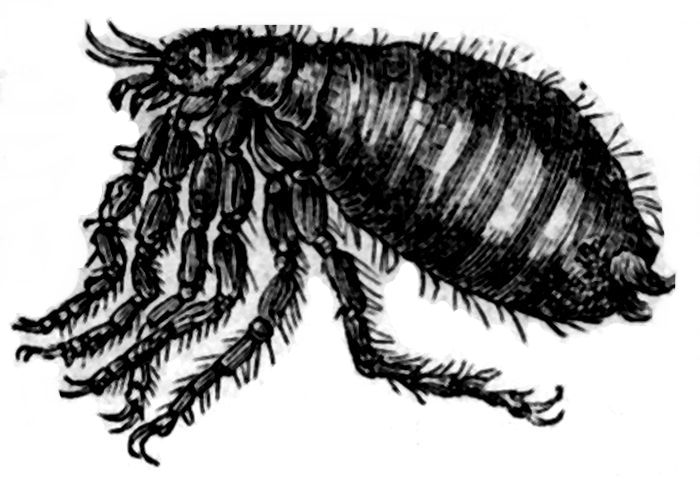
Into the natural history of the creature, it suits not with our present purpose to enter at any length; we may just say that its scientific name is Pulex irritans, and that the female, of which the above is a representation—the male being somewhat smaller, and different in shape, as shown in next column—deposits her eggs, some twenty or thirty in number, in the crevices of boards, or amid collections of dirt, or rubbish of any kind, from whence in six or eight days emerge the whitish, greasy-looking maggots; these, when a fortnight old, envelope themselves in small cocoons, and after remaining in this state about ten days, come out as perfect Fleas, ready to make war upon men, women, and children, but especially affecting those who have the most tender skins. How to get rid of them? is the anxious question with all careful mothers and tidy housewives. Cleanliness and indefatigable hunting, we reply; there is nothing to be done without trouble, and catching this nimble skipper, requires both quickness and patience in no ordinary degree. When there are Fleas in a bed-room, let the carpets be taken up, and the floors frequently washed, and then sprinkled with a strong decoction of Wormwood; among the bed clothes, put a bag filled with Dry Moss, the odour of which is said to be very offensive to them, as is also that of fresh-gathered Pennyroyal leaves. As a trap for them, some use Alder leaves, gathered while the dew is on them; to this the Fleas adhere, and may then be easily taken. Mercurial Ointment rubbed in the joints of the bedstead, and Sulphur fumigations, are also said to be efficacious in killing or expelling them; Sweet or Train-oil they cannot abide, and to drive them from their last stronghold, the coat of the cat or dog, it is but necessary to pour some along the back, and then rub it in with the hand, until it is well incorporated with the hairs. Here is a choice of remedies; but all will be of little avail without cleanliness—personal and otherwise. Only dirty, negligent people, are much troubled with Fleas, unless they are necessitated to live in old houses, of which they have long had possession, or in localities extremely favourable to their propagation; the efforts of such should be constantly directed to keeping them under, and the above information may probably assist them.
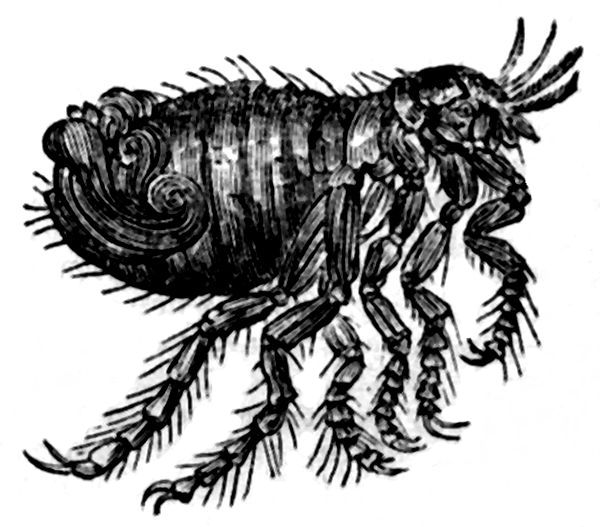
Fig. 1.
They are often extremely annoying to sick persons, and irritable children, depriving them of rest, and thus retarding restoration to health; for this reason, the Family Doctor is bound to wage war against them; besides, they inflict severe bites, and make ugly marks on the skin; now, although Flea Bites are proverbially small matters, yet, they sometimes cause serious inflammation, not to speak of the disfigurement; they should be rubbed over with a little Cold Cream, and if much inflamed, kept wet with a lotion of Elder Flowers with a few grains of Sugar of Lead dissolved in it.
CHIMNEYS (SMOKY). A chimney which smokes at the wrong end is a great nuisance; a cause of discomfort, vexation, and annoyance to all who are forced to live near it; and it is not surprising that very numerous attempts have been made to find a remedy. We have what are called wind-guards, reverberators, and all sorts and shapes of chimney-pots, to the great disfigurement of our houses; but these are mere expedients which might be avoided. The best way to prevent a chimney smoking at the wrong end is to build it properly at first, or to alter it on some sound and practical plan.
The great cause of smoky chimneys is that they are made too wide at their lower end, where they come down and meet the fire-place; for years it has been the practice to leave an opening the whole width and depth of the fire-place, from which the smoke rushes out and half blinds or stifles those who are sitting by the fire. How often do we see a board, or a strip of tin, or a narrow curtain hung under the mantel-piece. to keep the smoke from being troublesome. But besides this annoyance, these wide-mouthed chimneys waste more than half the heat of the fire; for, instead of coming out and warming the room as it ought to do, the heat rushes at once up the chimney and so is lost.
Although a large open fire-place helps in keeping a room ventilated, it is further objectionable because of the draughts which it creates. In old-fashioned houses, people are obliged to use screens and many other contrivances to shelter themselves from the currents of air which come from all quarters, to give stiff-necks, ear-aches, and other unwelcome twinges to those who sit near the great cavern called a fire-place, where they are scorched on one side and frozen on the other. With such arrangements, a room never can be warm, because the air rushes away so fast that the walls have never time to get heated, and at a distance from the fire are as cold as out of doors.
A good deal of the inconvenience of smoke might be avoided by the proper management of a fire. Count Rumford observes—“Nothing can be more perfectly void of common sense, and wasteful and slovenly at the same time, than the manner in which chimney fires, and particularly where coals are burned, are commonly managed by servants. They throw on a load of coals at once, through which the flame is hours in making its way; and frequently it is not without much trouble that the fire is prevented from going quite out. During this time no heat is communicated to the room; and what is still worse, the throat of the chimney is occupied merely by a heavy dense vapour, not possessed of any considerable degree of heat, and consequently not having much elasticity. The current of warm air from the room which presses into the chimney, crosses upon the current of heavy smoke which rises slowly from the fire, obstructs it in its ascent, and beats it back into the room; hence it is that chimneys so often smoke when to a large a quantity of fresh coals is put upon the fire. So many coals should never be put upon the fire at once as to prevent the free passage of the flame between them. In short, a fire should never be smothered; and when proper attention is paid to the quantity of coals put on, there will be very little use for the poker; and this fact will contribute very much to cleanliness, and to the preservation of furniture.”
The Count devoted much attention to household economy generally, and as we know of no better plans for curing or preventing a smoky chimney and saving fuel than his, we shall endeavour to give such a simple account of them as will enable any working-bricklayer or mason either to build a new chimney properly, or to alter an old one on correct principles.
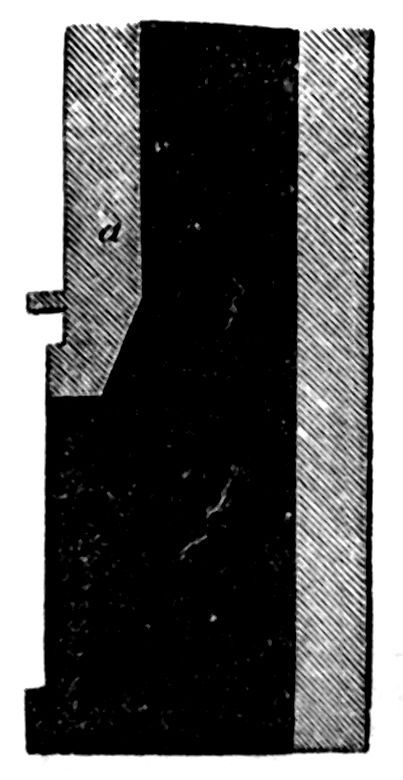
Fig. 1.
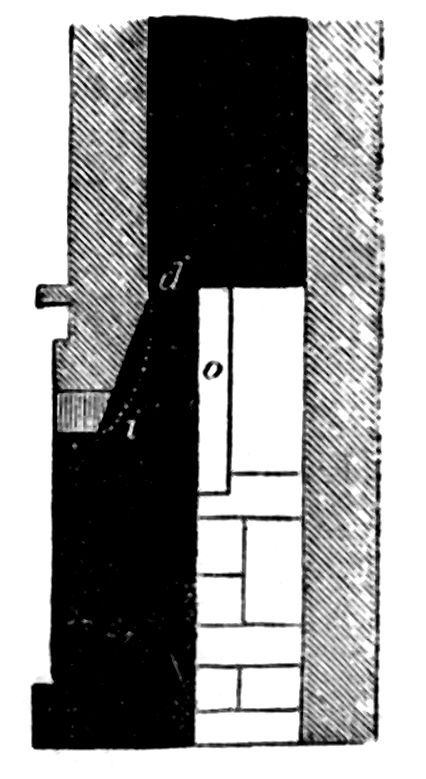
Fig. 2.
Generally speaking, it will be necessary to diminish the opening of the fire-place—that is, to make it smaller; and to fix the grate more forward and less high than has been the practice. Sometimes a straight stone slab placed all across under the mantel, or a row of bricks supported by a flat iron bar, will be sufficient to effect a cure; for this lowers the breast of the chimney, and diminishes the size of the opening of the fire-place. The breast of a chimney is that part against which the mantel is built, and a good deal depends on the way on which this is finished on the inside.
Then, if we wish smoke to ascend easily, we must place the throat, or lower part of the chimney, immediately over the fire; the back of the fire-place also should be built perpendicular. There is no more reason why smoke should refuse to ascend a properly-constructed chimney, than that water should refuse to descend through a pipe. And it will be seen from the diagrams that these improvements can be made with but a small amount of trouble.
Figure 1 shows a fire-place and part of the chimney as usually built; an opening with square sides, in which the grate is fixed so far back that most of the heat is lost. The depth, however, from back to front should not be more than from 9 to 13 inches; the back is, therefore, to be built up, as shown at figure 2, and in the ground plan, figure 4. It will be seen that the chimney breast has a small piece added to lower it.
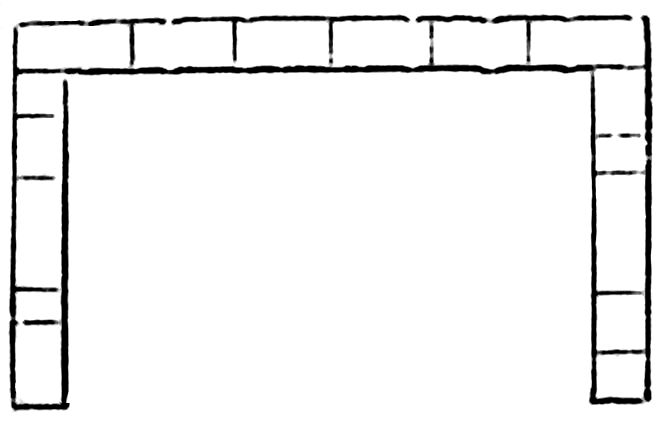
Fig. 3.
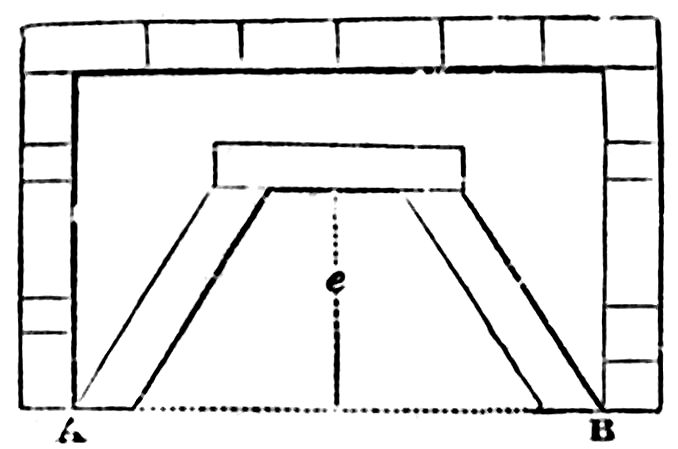
Fig. 4.
Figure 3 represents the ground plan of the fire-place in figure 1; but instead of square, it is to have sloping sides, and is to be filled up as in figure 4. To do this according to rule, a line A, B, is to be drawn straight from one jamb to the other; and from the centre of this, a cross line e is to be drawn from front to back. The mason is then to hold a plumb-line against the inside of the chimney breast, where it begins to run straight upwards, as, for example, at a, figure 1, and the spot where the plumb-line rests on the cross line e is to be carefully marked. Four inches behind this mark is the position for the back of the fire-place, as shown by the brickwork in figure 2, which, by being so placed, gives four inches as the dimensions from back to front of the throat of the chimney seen at d.
This brickwork, and the sides, are to be carried up from six to nine inches above the lowest part of the chimney breast, so as to give a sufficient length and form to the throat d; and instead of being finished irregularly, or with a slope at the top, it must be perfectly flat and level; because when the wind sets down the chimney, if it strikes against a slope it drives the smoke into the room, but not if it strikes upon a flat. Too much pains cannot be taken to make a good finish of the inside of the breast; it should be quite smooth and perpendicular, so as to offer no impediment to the ascent of the smoke. The lower part is to be carefully rounded off with plaster, as at i, figure 2, instead of being left square or rough and badly finished, as it nearly always is.
The way to fix the sides or coverings of the fire-place is at a slope or angle, as shown at figure 4. It has been found that an angle of 45 degrees is that which throws the most heat into the room. These angles and the back should be made of fire-brick, and if each of one piece the better, as it will then be easy to place them in the position represented in the diagram. The hollow spaces behind may be filled up with regular layers of brickwork, all brought to the same flat level at the top. It is a mistake to suppose that iron is the best material for the back and sides of a grate; fire-brick is much better. Iron absorbs the heat—fire-brick throws it out, and besides it can be white-washed which is a great economy, for white throws out both light and heat, which black does not. All parts of a fire-place not liable to be blackened by smoke, should be kept white, it is a common practice to do so in the United States.
Any workman may get the angle of the sides by an easy way, shown at figure 5. On a board, bench, or table, or on the floor, draw three equal squares, from twelve to fifteen inches each way, as A, B, C; and from the back corner e of the central square B, draw a diagonal line across the square A, to the outer corner f. This gives the angle at which the sides are to be fixed; and if a wooden bevel or mould-board be made exactly to this plan, a bricklayer will always be able to use it in setting out his work, and with something like certainty that he is doing right. If the chimney should be an uncommonly smoky one, or if the grate should not be exactly of the required width, either of the other two angles shown by the dotted lines may be chosen. To leave room for sweeping the chimney, the upper part of the back is to be a single slab, as at o, figure 2, which is to be fitted so as to shift in or out. This can easily be done by standing the slab in its place, and finishing the other work up to it, being careful to leave all level at the top. By taking out this slab when the chimney requires sweeping, room is left for the passage of the brush, and when it is replaced it leaves the chimney throat as perfect as before.
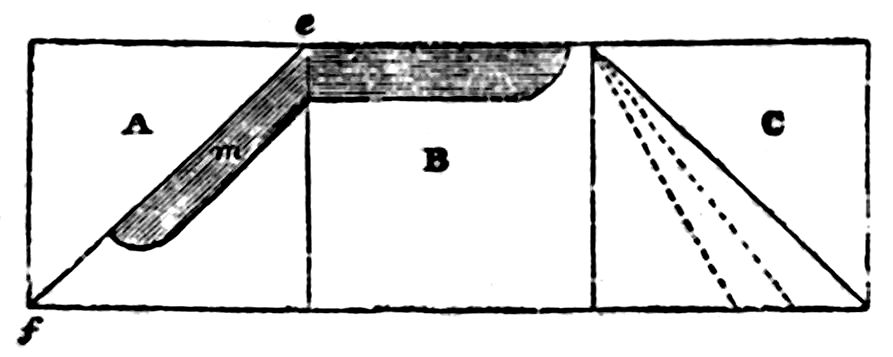
Fig. 5.
The true proportions of a grate are, to have the width of the front three times the width of the back. Nine inches should be the width of the back, and the depth of the grate from back to front the same, which multiplied by three, gives twenty-seven inches as the width of the front. These dimensions are not to be departed from, unless under strong necessity; by keeping to them, the sides or copings of the fire-place will always be at an angle of 45 degrees, as above-mentioned. As a rule, the height of the fire-place should be the same as the width.
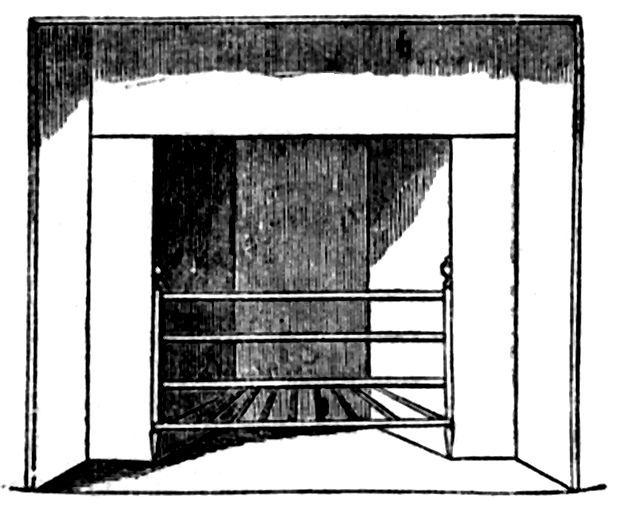
Fig. 6.
If these directions are carefully followed, it will be found that the fire-place will be complete all but the bars, a matter worth consideration, because the less iron there is about a grate the better. The bars and bottom may be made of iron all in one, and the bottom is not to be more than five inches above the hearth; for a grate when fixed low sends more heat into the room than when fixed high. Figure 6 represents a fire-place complete. It does not look so elegant or showy as those which modern taste has produced, but it will be found far more serviceable and economical.
In cases where the breast of the chimney is nine inches thick, the four inches which have to be allowed for the throat behind this, will make the fire-place thirteen inches deep. The back must then be thirteen inches wide, and the front three times thirteen, or thirty-nine inches, and the angles will be in their true position. A fire-place of this size will warm a large room, while a grate nine inches deep will serve for all ordinary sitting-rooms.
A cheerful and steady fire is so great a comfort as to make it worth while to take a little pains to insure it. The plan here described, if properly carried out, cannot fail of success, and will leave little need for chimney-pots or cowls.
DRESS (ON PROPER TASTE IN). There are many people who do not know that in order to dress well, they must follow certain rules, and pay attention to certain laws, and that it is not a mere question of fancy. By dressing well, we do not mean dressing expensively, but dressing properly; for it is not more difficult to exercise taste in the wearing of low-priced clothing, than of high priced.
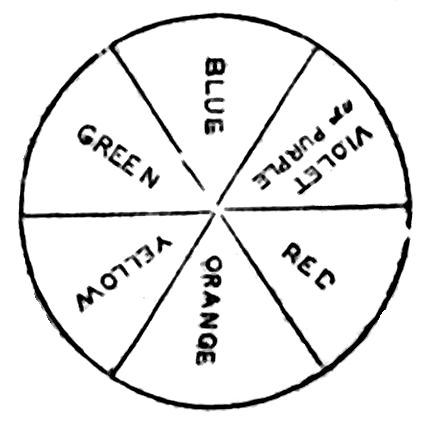
Most people know, that in looking at a rainbow, they see seven different colours, and for a long time it was thought that the number really was seven, but of late years it was found that there are not more than three. These three are called primitive or primary colours; the others are called secondary colours, because they are made up by a mixture or combination of the first three. This may be better explained by means of a diagram. Here the red, blue, and yellow, are the three primitives, and it will be seen that the others lie between them. For instance, the meeting and overlapping of the red and yellow, produces orange, passing from a deep tint on the red side, to a light tint on the yellow side. In like manner, the overlapping of the yellow with the blue forms green, and the overlapping of the red with the blue, produces violet or purple. If the diagram were coloured, the effect would be more apparent, and it would be easy to see that two primary colours are required to make one secondary colour.
There is another fact also to be remarked; the space opposite to each primitive is filled by the secondary composed of the other two primitives, and these secondaries are called complementary colours. Green, therefore, is the complementary colour to red, purple to yellow, and orange to blue. This may be proved in another way:—Fix a red wafer in the centre of a white sheet of paper, look at it steadily for a time, then look at another sheet which has nothing on it, and there will appear to be a green wafer in the middle of it; and so with the other colours. This explains the reason why the putting together of red and green, blue and orange, yellow and purple, in the decoration of rooms, or in dress, produces so pleasing and harmonious a contrast. It is true to nature, and that is the whole secret.
It would be possible by drawing other lines across the same diagram to represent all the varieties of tints, three of orange, three of green, &c., and in each case, the exact complement will always be found opposite the two sections of the primitive: the balance is always kept up. Out of all these, all sorts of hues may be produced, positive or neutral, arranged either in their order as they appear in the rainbow, deepening or softening one into the other, or forming strong contrasts. It is by the latter, that the most striking effects are produced.
In describing the colours, red is said to be the most positive of the primitives, yellow the lightest, and blue the coldest. The first two are always considered to be warm colours, orange is a warm secondary, green is medium, and violet the coldest. Artists speak of the warm colours as standing out, while the cool ones appear to go back. Green and red form a medium contrast; orange and blue the extremest; as in them the warmest and coldest colours are brought together. Black and white are not colours, the first is made by mixing the three primaries together; gray is produced by a mixture of white and black, and forms a colour which is very useful in softening the effects of violent contrasts.
With these facts before us, we shall now be able to comprehend better in what way to regulate the colours of dress; and instead of following mere routine or mere whim, we shall perceive that a little study and attention, will keep us from those disfigurements too often seen in women’s dress.
In the dress of English ladies, we find too frequently a variety of colours, without any pretensions to harmony of arrangement. Not only is the dress or bonnet selected without the slightest consideration, whether it is, or is not suitable to the complexion, but a variety of colours of the most dissonant and inharmonious kinds may frequently be seen in the habiliments of the same lady.
We continually see a light blue bonnet and flowers surrounding a sallow countenance, or a pink opposed to one of a glowing red; a pale complexion associated with canary, or lemon-yellow, or one of delicate red and white, rendered almost colourless by the vicinity of deep red. Now, if the lady with the sallow complexion had worn a transparent white bonnet, or if the lady with the glowing complexion had lowered it by means of a bonnet of deeper red colour—if the pale lady had improved the cadaverous hue of her countenance, by surrounding it with pale green, which, by contrast, would have suffused it with a delicate pink hue, or had the face
“Whose red and white
Nature’s own sweet and cunning hand laid on.”
been arrayed in a light blue, a light green, or in a transparent white bonnet, with blue or pink flowers on the inside, how different and how much more agreeable would have been the impression on the spectator.
How frequently again do we see the dimensions of a tall and embonpoint figure, magnified to almost Brobdignagian proportions, by a white dress; or a small woman reduced to Lilliputian size by a black dress! Now, as the optical effect of white is to enlarge objects, and that of black to diminish them, if the large woman had been dressed in black, and the small woman in white, the apparent size of each would have approached the ordinary stature, and the former would not have appeared a giantess, or the latter a dwarf.
Next with regard to the bonnet—the colour of the lining and the trimming should be such as will best suit the complexion of the wearer. There are, it appears, two methods of setting off or heightening a complexion, first, by a decided contrast, such as a white drapery, or one of a colour exactly complementary to the complexion, but not of too bright a hue; such for example is a green drapery for a rosy complexion, or a blue drapery for a blonde. Secondly, by contrasting a fair complexion of an orange hue with a light green drapery, a rosy complexion with a light blue, or a canary yellow, or strawcolour, with certain complexions inclining to orange. In the last case, the complementary violet neutralizes the yellow of the carnation, which it brightens.
Now, let us suppose an opposite case, namely, that the complexion is too highly coloured, and the object of the painter, or dress-maker is to lower it. This may be effected either by means of a black drapery which lowers the complexion by contrast of hue, or by a drapery of the same colour as the complexion, but much brighter; for example, where the carnations are too rosy, the drapery may be red; where they are too orange, an orange-coloured drapery may be adopted; where they incline too much to green, we may introduce a dark green drapery; a rosy complexion may be contrasted with dark blue, or one of a very pale orange, with a very dark yellow.
A good deal will be found to depend on the way in which the hair or cap is worn; because, if a broad patch of hair come between the trimming and the face, the effect is varied; but when the bonnet is worn far back from the face, then the effect depends on the shape of the bonnet, or on other contrasts. In general, it will be best to follow the same law as laid down for the other portions of the attire. For example, a fair face may have a black hat with a white or red feather. A white bonnet, when not transparent, is most becoming on a red or white complexion; but if it be of gauze or a transparent substance, it will then appear to be gray; the colour of the trimming should be white or pink, but the best effect seems to be produced by blue. A blue bonnet is the best colour for a fair woman, with white or orange trimming, always, avoiding red, or deeper shades of blue, which spoil the effect. Green also is suitable for a fair face, especially if the cheek show a tinge of pink, and the trimming should be white or pink; but a pink bonnet should not be worn unless there be some white or green trimming between it and the face. A mixed wreath of white and green, such as a sprig of Jasmine, or a branch of May, has a very pleasing effect. If red be worn by those who have red faces, it should always be of a darker shade than the face, as the object is to relieve, not to deepen, the complexion; and it has been found by experience, that the reflection from a bonnet-lining is much less than is commonly supposed. Nearly the same may be said of black bonnets; their contrast on a dark face is not always so good as on a light one, but a little contrivance will make that suitable which often appears unsuitable. The trimmings should be white, red, pink, yellow, or orange. Next to black and white, and orange and blue, black and yellow is considered the greatest contrast of colours.
Brunettes and those with a tawny skin may wear white bonnets, but must avoid the blue trimmings; in their case, pink, or cherry-colour will be the most suitable, not forgetting that the hair should show between the bonnet and the face. A violet-coloured bonnet gives the skin a yellow appearance, and no woman likes to be thought yellow-complexioned. But whenever the appearance is not satisfactory, the effect should always be tried of placing something between the bonnet and the face; such as ribands, a wreath, lace or tulle, or the complementary colour, which should also be repeated on the outside of the bonnet. When we find negroes and the dark-skinned people of the East fond of glaring colours, it is only an effect of the laws above-mentioned; in choosing these colours they only take what best becomes them; they have no alternative between these and a pure white.
With respect to the hair: light hair is to be regarded as a “subdued orange,” which is more or less yellow, red, or brown, according to the constitution of the individual. The yellowest is the flaxen or golden hair, which was once in such repute, that ladies who had dark hair took pains to bleach it and remove the colour. Where the red tinge prevails the hair is chesnut or auburn, and sometimes positively red. Black hair and eyebrows contrast well with a fair complexion, or harmonize with a dark one. Sky-blue is the most becoming wear for light and fair-haired persons, being, as it were, a complementary colour to their own hue. Orange, yellow, and red, assort well with dark hair, and in some instances violet or green with their complementaries may be worn. A fresh, rosy complexion should not be surrounded with pink or rose colour, as the effect will be to deaden it; but if a fulling of tulle be placed between it and the face, then the objection will disappear. As before observed, lace or similar materials appear gray, for the threads reflect the light, while the spaces absorb it, and have a dark appearance; and one being intermingled with the other, the result is gray, a neutralizing tint of great value. It should be borne in mind, that transparent white textures are always to be considered as gray. Light green suits the skin which has no red, and makes it look slightly ruddy by the contrast. On the contrary, dark green harmonizes best with brunettes and dark complexions which have a touch of orange in them. If the skin be yellow, then light yellow is to be avoided in the bonnet, as the effect it produces is that of a deadly white; violet gives such a skin a green hue, as also some shades of blue. A dead white, that is, one which is not transparent, suits a fresh colour, making it look more rosy, while the effect of black is to lower the tone of the colours associated with it, and make the skin appear fairer. The three primitive colours may be made to look more brilliant than they are by combining them with gray, and still more so by white; but gray is perhaps to be preferred, as it “forms combinations with blue, violet, and dark colours, in general, which partake of the harmony of analogy, while, on the contrary, it forms with colours naturally bright, such as red, orange, yellow, and light green, harmonies of contrast.” If, for instance, gray be placed by the side of crimson, it will acquire by contrast somewhat of a green hue; by the side of the yellow it will appear purplish; if by the side of blue it will assume an orange hue; the value, then, of a neutral tint of this description when placed in contact with flesh, is very evident.
These observations comprise the chief points of the theory of dress; after reading them, it is impossible not to see the necessity for some degree of attention to the laws of taste. Many people are ready to justify their neglect on the ground that it is a waste of time, or of morality, to be particular in such matters. But we take leave to say that such is not the case. We are bound by social, as well as moral, laws, to wear decent clothing, and there is no impropriety whatsoever in making ourselves look as becoming as possible—always remembering to avoid pride and vanity.
CRIBBAGE. This game is played with the whole pack of cards, and by two, three, or four persons, as the case may be. When there are three, they play as individuals; when four, two play as partners, as in the case of whist. The value of the cards in cribbage is the same as in whist; but there are no trumps, excepting the knave of the suit turned up. There are different modes of playing, according to the number of cards dealt; the number is generally five or six. The game consists of sixty-one points, and to keep score or reckoning, an apparatus called a cribbage-board is employed. This board possesses holes for the scoring of each party, and the scoring is effected by means of pegs. The party who is able to bring his peg into the last hole first wins the game.
The following is an explanation of terms generally used in the game:—
Crib, the cards laid out by each party; and whatever points are made by them, the dealer scores.
Pairs are two similar cards, as two aces or two kings. They reckon for two points, whether in hand or playing.
Pairs royal are three similar cards, and reckon for six points, whether in hand or playing.
Double pairs royal are four similar cards, and reckon for twelve points, whether in hand or playing. The points gained by pairs, pairs royal, and double pairs royal, in playing, are thus effected: your adversary having played a seven, and you another, constitutes a pair, and entitles you to score two points; your antagonist then playing a third seven, makes a pair royal, and he marks six; and your playing a fourth is a double pair royal, and entitles you to twelve points.
Fifteens. Every fifteen reckons for two points, whether in hand or playing. In hand, they are formed either by two cards, such as a five and any tenth card, a six and a nine, a seven and an eight; or by three cards, as a two, a five, and an eight, &c. And in playing thus, if such cards are played as make together fifteen, the two points are to be scored towards the game.
Sequences are three or four, or more successive cards, and reckon for an equal number of points, either in hand or playing. In playing a sequence, it is of no consequence which card is thrown down first, as thus: your adversary playing an ace, you a five, he a three, you a two, then he a four, he counts five for the sequence.
Flush is when the cards are all of one suit, and reckons for as many points as cards. For a flush in the crib, the card turned up must be of the same suit as those in hand.
The go is gained by the player when no other number can be played under thirty-one, in which case he takes one; but if the number makes thirty-one, he takes two. The turn-up card accounts in with both hand and crib.
Regulations for Playing. 1. In dealing, the dealer may discover his own cards, if he pleases, but not those of his adversary. If he does, that adversary is entitled to mark two points, and call a fresh deal, if he pleases.
2. If the dealer gives his adversary too many cards, the adversary may score two points, and also demand another deal, provided he detects the error previous to his taking up his cards.
3. When any player is observed to have in his hand more than the proper number of cards, in that case the person who discovers it may mark four points to his game, and call a new deal, if he thinks proper.
4. If the dealer gives himself more cards than he is entitled to, the adversary may score two points to his game, and call a fresh deal, if he thinks proper; if he does not, he is entitled to draw the extra cards from the dealer’s hands; if the non-dealer observes the adversary has more cards than are his due, after they are taken off the table, he may score four points to his game, and call a new deal.
5. If either party meddle with the cards from the time they are dealt until they are cut for the turn-up card, his adversary is entitled to score two points.
6. If any player scores more than he is entitled to, the other party has a right not only to put him back as many points as were so scored, but also to score the same number to his own game.
7. If either party touches even his own peg unnecessarily, the adversary may score two points to his game.
8. If either party take out his front peg, he must place the same behind the other.
9. Either party scoring a less number of points than are his due, incurs no penalty.
10. Each player has a right to pack his own cards; and should he place them on the pack and omit scoring for them, whether hand or crib, he must not mark for them afterwards.
Cribbage (Five-Card). Proper cribbage is played with five cards, and we shall give a description of it in reference to two persons.
After the dealer has been determined by cutting, as in whist, the cards are dealt one alternately, to the extent of five for each individual. The elder hand takes three points on the board. Each player then proceeds to lay out two of the five cards for the crib, which always belong to the dealer. In doing this, always recollect whose crib it is, as the cards which may advantage your own are almost invariably prejudicial to your game when given to your adversary. This done, the non-dealer cuts the remainder of the pack, and the dealer turns up the uppermost. This card, whatever it may be, is reckoned by each party in hand or crib. When it happens to be a knave, the dealer scores two points to his game.
After laying out and cutting as above mentioned, the eldest hand plays any card, which the other endeavours to pair, or to find one, the points of which, reckoned with the first, will make fifteen; then the non-dealer plays another card, trying to make a pair, or pair royal, and so on alternately till the points of the cards played make thirty-one, or the nearest possible number under that.
When the party whose turn it may be to play cannot produce a card that will make thirty-one, or come in under that number he then says “go” to his antagonist, who thereupon is to play any card he has that will come in to make thirty-one, if he can, and take two points, or to score one for the end hole; and besides, the last player has often opportunities to take pairs or sequences. Such cards as remain after this are not to be played; but each party having, during the play, scored his points gained, in the same manner as hereafter directed, proceeds, the non-dealer first, then the dealer, to count and take for his hand and crib as follows, reckoning the cards every way they possibly can be varied, and always including the turned-up card:
For every fifteen, two points; for every pair, or two of a sort, two points; for every pair royal, or three of a sort, six points; for every double pair royal, or four or a sort, twelve points; for every sequence of any sort, according to the number; for every flush, according to the number; for every knave or noddy of the same suit that was turned up, one point; but when turned up it is not to be reckoned again, nor is anything to be taken for it when played.
Three cards of the same suit in hand entitle the holder to reckon that number, and five for the crib when the turned-up card happens to be of the same suit.
It is always highly necessary, in laying out cards for the crib, that every player should consider not only his own hand, but also whom the crib belongs to, and what is the state of the game; because what might be proper in one situation would be extremely imprudent in another.
If you should happen to possess a pair royal, be sure to lay out the other two cards for either your own or your adversary’s crib, except you hold two fives with the pair royal; in that case it would be extremely injudicious to lay them out for your adversary’s crib, unless the cards you retain insure your game, or your adversary being so near home that the crib becomes of no importance.
It is generally right to flush your cards in hand whenever you can, as it may assist your own crib or baulk your opponent’s.
Endeavour always to retain a sequence in your hand, and particularly if it is a flush.
Always lay out close cards, such as a three and four, a five and six, for your own crib, unless it breaks your hand.
As there is one card more to count in the crib at five-card cribbage than there is in hand, be sure to pay great attention to the crib, as the chance of reckoning more points for the crib than are in hand is five to four.
For your own crib, always lay out two cards of the same suit, in preference to two of different suits, as this will give you the chance of a flush in the crib.
Never lay out cards of the same suit for your adversary’s crib.
Endeavour always to baulk your opponent’s crib. The best cards for this purpose are a king and an ace, a six, a seven, an eight, a nine, or a ten; or a queen, with an ace, a six, a seven, an eight, or a nine; or any cards not likely to form a sequence.
A king is generally esteemed the greatest baulk; as, from its being the highest card in the pack, no higher one can come in to form a sequence.
Never lay out a knave for your adversary’s crib, when you can possibly avoid it, as it is only three to one but the card turned up is of the same suit, by which he will obtain a point.
Even though you should hold a pair royal, never lay out for your adversary’s crib a two and three, a five and six, a seven and eight, or a five and any tenth card. Whenever you hold such cards, observe the state of your game, and, particularly if it is nearly ended, whether your adversary is nearly out, or within a moderate show, and it is your deal. When this is the case, you must retain such cards as will, in playing, prevent your adversary from making pairs or sequences, &c., and enable you to win the end hole, which will often prevent your opponent from winning the game.
Cribbage (Three and Four Hand). Three and four hand cribbage differs only from two hand, in as far as the parties only put out one card each to the crib; and when thirty-one, or as nearly as can be, have been made, then the next eldest hand leads, and the players go on again, in rotation, with any remaining cards, till all are played out, before they proceed to show their hands and crib.
In three-hand cribbage, a triangular board is used, with three lines of holes to allow of each scoring his own game.
Cribbage (Six-Card). Six-card cribbage bears so great a resemblance to five-card, that any one playing the one well must play the other equally so. It consists of pairs, fifteens, sequences, flushes, &c.; and the points are reckoned and marked precisely in the same manner; all the cards must be played out; that is, when either party has made the end hole, the remaining cards in hand must be played, scoring for the pairs or fifteens they may form. When last player, you should endeavour to retain close cards in hand, as they may enable you to acquire four points in playing.
The dealer is supposed to have some trifling advantage.
The dealer is entitled to expect twenty-five points by his hand, crib, and next hand. Thus at his second deal, if his peg is in the twenty-fifth hole of the board, he has his complement of points; the same at his third deal, if he is within eleven points of the game.
If the non-dealer by his first hand attains the eleventh hole in the board, he will have the best of the game; for he is entitled to expect that he shall make his second deal with his front peg in the thirty-sixth hole, and by which probably he will win the game by his hand, crib, and next hand.
If you are dealer, and your adversary has above his complement of points, you must play your game accordingly. Thus, if you have good cards, try to make as many points as possible by pairing, fifteens, &c. On the contrary, if your cards are indifferent, you must play off, to prevent your adversary from obtaining points.
PYRAMIDS. Solids, which decrease gradually from the base, till they come to a point, are called pyramids. They are of different kinds, according to the figure of their bases. If the pyramid has a square base, it is called a square pyramid; if a triangular base, a triangular pyramid; if the base be a circle, a circular pyramid, or a Cone. The point in which the pyramid ends is called the vertex. A line through the centre of the pyramid, from the vertex to the base, is the height. The frustrum of a pyramid is what remains, after any portion of the top has been cut off parallel to the base.
BAGATELLE. The large and inconvenient size of billiard-tables has led to the introduction of bagatelle-tables—bagatelle being the French word for anything trifling. A bagatelle-table is usually about seven feet long and twenty-one inches broad; it is lined with cloth, and a game is performed on it with balls and a cue or mace. The balls are small ivory spheres, and the sport very much consists in striking one or more into holes at one end of the board. To perform this and other feats, some skill and experience are required; and the sport is far from unamusing in a cheerful parlour circle. Of late years, bagatelle-tables have become very common in the houses of the middle classes of society; they possess the recommendation of being purchasable at a small expense.
STEREOSCOPE (THE). The name Stereoscope, from the Greek words stereos, solid, and skopein, to see, has been given to an instrument of recent invention, for exhibiting in true relief and apparent solidity all objects, or groups of objects, by combining into one picture two representations of these objects on a plane, as seen separately by each eye.
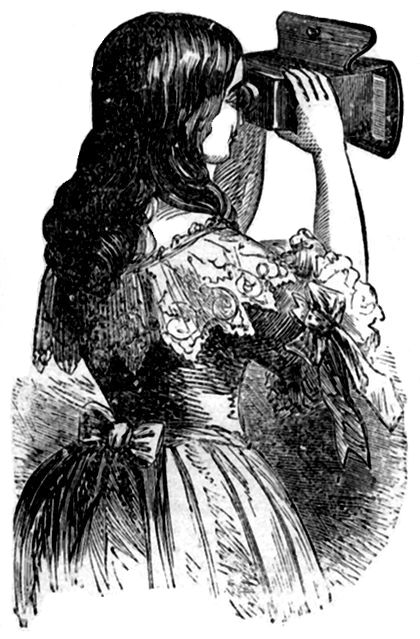
If we hold up a thin book between our two eyes, with its back towards us, and at the distance of about a foot, we shall see the back and the two sides of the book when both eyes are open; but if we shut the right eye, we shall see with the left eye only the back and left side of the book, and if we shut the left eye, we shall see only the back and the right side of it. Or, to use a more homely illustration, when we shut the left eye, we see only the right side of our nose with the right eye; and when we shut the right eye, we see only the left side of our nose with the left eye. And in general, when we look at any solid object whatever, the right eye sees parts of it towards the right hand not seen by the left eye, and the left eye sees part of it towards the left hand not seen by the right eye. Hence we arrive at the first and fundamental truth on which the theory and construction of the Stereoscope depend, viz.: 1, When we look with two eyes upon any solid body or object whose parts are at different distances from us, the picture of it which we see with the right eye, or the image of it which is formed on the retina of the right eye, is different from the picture of it which we see with the left eye, or from the image of it which is formed on the retina of the left eye.
This important fact was known to Euclid more than 2000 years ago, and was illustrated by him in the case of a sphere, the pictures of which as seen by each eye he proved to be dissimilar. Upwards of 1500 years ago, Galen described the different pictures formed on each eye in the vision of a column. Baptista Porta, in 1593, repeats the proposition of Euclid on the vision of a sphere with one and both eyes; and he quotes the experiments of Galen on the vision of a column with both eyes, and with each eye alternately. Leonardo da Vinci was well acquainted with the same facts; and Aguilonius, in 1613, wrote a whole book on the vision of solids (ta sterea) with one and both eyes, and explained the dissimilarity of the pictures thus seen by the observer.
Optical writers of more recent times, such as Dr. Smith of Cambridge, Mr. Harris, and Dr. Porterfield, were all acquainted with the dissimilarity of the pictures of solids as seen by each eye separately; and hence we see the extreme injustice of the claim made by Mr. Wheatstone to be the discoverer of this truth. In quoting the experiments of Leonardo da Vinci, Mr. Wheatstone maintains that he was not aware “that the object (a sphere) presented a different appearance to each eye;” and he adds, “he failed to observe this; and no subsequent writer, to my knowledge, has supplied the omission. The projection of two obviously dissimilar pictures on the two retinæ, when a single object is viewed, while the optic axes converge, must therefore be regarded as a new fact in the theory of vision.” This claim to a discovery made 2000 years ago by Euclid, and explained and illustrated by so many of his distinguished successors, is the more remarkable, as Mr. Wheatstone, though he may have never seen the writings of Euclid or Galen, makes repeated reference to the observations of Porta and Aguilonius, in which the discovery is distinctly described.
The second fundamental truth on which the theory and construction of the Stereoscope depend is: 2, When the two dissimilar pictures of any solid body, as seen by each eye separately, are superimposed, or laid the one above the other by the convergency of the axes of the two eyes, the object which these pictures represent is seen in relief, or as a solid body, with its different parts at different distances from the observer.
Although this truth is not distinctly stated either by Euclid or Galen, we can hardly suppose that they were ignorant of it, as it is a necessary result of their observations. Since we do see an object in true relief by both eyes, and since the picture of the object which we see is formed by the superposition of the one dissimilar picture above the other, the vision in relief is the necessary result of the combination of the pictures. They must have known it simply as a fact, though they did not know its cause.
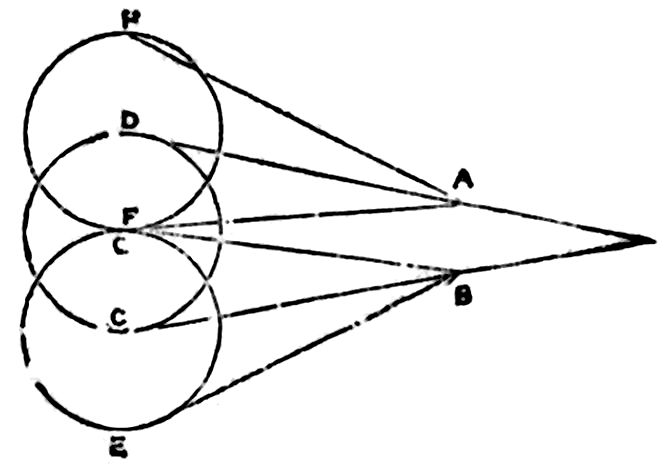
Baptista Porta and Aguilonius, however, were well acquainted with this second truth. In explaining the experiments of Galen on the dissimilarity of the pictures of an object as seen by each eye and by both, Porta employs the annexed diagram, which is much more distinct than that which is given by the Greek physician. “Let a,” he says, “be the pupil of the right eye, b that of the left, and d c the body to be seen. When we look at the body with both eyes, we see d c, while with the left eye we see e f, and with the right eye g h. But if it is seen with one eye, it will be seen otherwise; for when the left eye b is shut, the body c d, on the left side, will be seen in h g; but when the right eye a is shut, the body c d will be seen in f e; whereas when both eyes are opened at the same time it will be seen in c d.” Porta then proceeds to explain these results by quoting the passage from Galen in which he supposes the observer to repeat these experiments when he is looking at a solid column. In the preceding diagram we see not only the principle but the construction of the Ocular Stereoscope, or the method by which we combine the two pictures by looking at a point between them and the observer, or beyond the pictures. The two dissimilar pictures are represented by h e; the picture as seen by one eye by h g; the picture as seen by the other by e f; and the picture of the solid column in full relief by d c, as produced midway between the two dissimilar pictures h g and f e by their union, precisely as in the Stereoscope.
The important subject of which we are treating has been discussed by Aguilonius with singular ingenuity; and his observations are so interesting, that we shall give them in his own words. “When one object,” he says, “is seen with two eyes, the angles at the vertices of the optical pyramids (viz. h a f, g b e) are not always equal; (they are equal in the vision of a sphere and a cylinder;) for beside the direct view, in which the pyramids ought to be equal, into whatever directions both eyes are turned they receive pictures of the objects under unequal angles, the greater of which is that which is terminated at the nearer eye, and the lesser that which regards the remoter eye. This, I think, is perfectly evident; but I consider it as worthy of admiration, how it happens that bodies seen by both eyes are not all confused and shapeless, though we view them by the optical axes fixed on the bodies themselves. For greater bodies seen under greater angles appear lesser bodies under lesser angles. If, therefore, one and the same body which is in reality greater with one eye, is seen less on account of the inequality of the angles in which the pyramids are terminated, the body itself must assuredly be seen greater or less at the same time, and to the same person that views it; and therefore, since the images in each eye are dissimilar (minime sibi congruunt), the representation of the object must appear confused and disturbed (confusa ac perturbata) to the primary sense.” In order to understand this passage, we must state, as a well-known fact, that in binocular portraits the distance between the tip of the nose and the tip of the ear is greater in the one picture than in the other, and consequently the line joining these points subtends a greater angle in the one than in the other. When these two lines, therefore, are combined, Aguilonius concludes that the vision of the tip of the nose and the tip of the ear must be confused, as the ends of the lines cannot be united.
“This view of the subject,” he continues, “is certainly consistent with reason; but what is truly wonderful is, that it is not correct, for bodies are seen clearly and distinctly with both eyes when the optic axes are converged upon them. The reason of this, I think, is, that the bodies do not appear to be single, because the apparent images which are formed from each of them in separate eyes exactly coalesce (sibi mutuo exacte congruunt), but because the common sense imparts its aid equally to each eye, exerting its own power equally in the same manner as the eyes are converged by means of their optical axes. Whatever body, therefore, each eye sees with the eyes conjoined, the common sense makes a single notion, not composed of the two which belong to each eye, but belonging and accommodated to the imaginative faculty to which it (the common sense) assigns it.”
Now though the explanation here given of the distinct appearance of the solid composed of two dissimilar pictures is not correct, yet Aguilonius clearly asserts the second truth, that though the unequal lines and angles do not coalesce, yet the body is seen distinctly and in its true solidity, in consequence of the combination of the two pictures of it as seen by each eye.
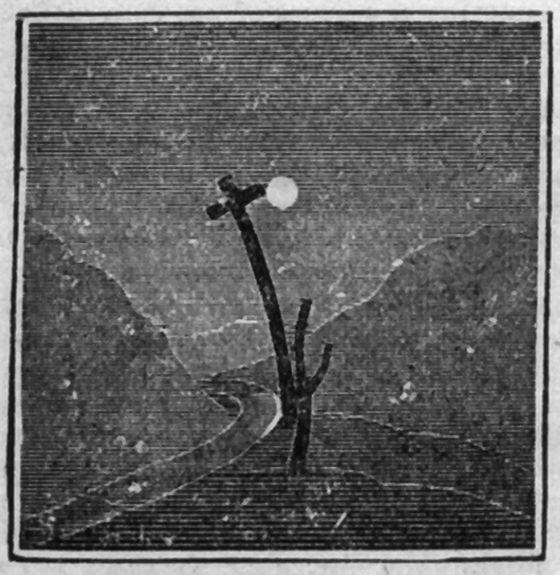
From these details it is manifest that the two fundamental truths on which the Stereoscope depends were well known to Aguilonius and others; and that nothing more was wanted than a method of forming two dissimilar pictures of objects, and a method of uniting them when formed.
Upwards of thirty years ago, Mr. Elliot, now a teacher of mathematics in Edinburgh, was led to study the subject of binocular vision, in consequence of having written an essay in 1823, for the Logic Class, “On the means by which we obtain our knowledge of distances by the eye.” From that time he was familiar with the idea that the relief of solid bodies when seen with both eyes was produced by the union of the two dissimilar pictures of them as seen by each eye, which he believed was known to every student of vision. During the year 1834, or previous to it, he had resolved to make an instrument for uniting two dissimilar pictures, or of constructing a stereoscope. But though he had invented the instrument, he delayed its construction till 1839, when he was asked to write a paper for the Polytechnic Society in Liverpool. The instrument was exhibited to Mr. Richard Adie, optician, and Mr. G. Hamilton, lecturer on chemistry; but owing to the difficulty of obtaining binocular pictures for it, he proceeded no further with his invention.
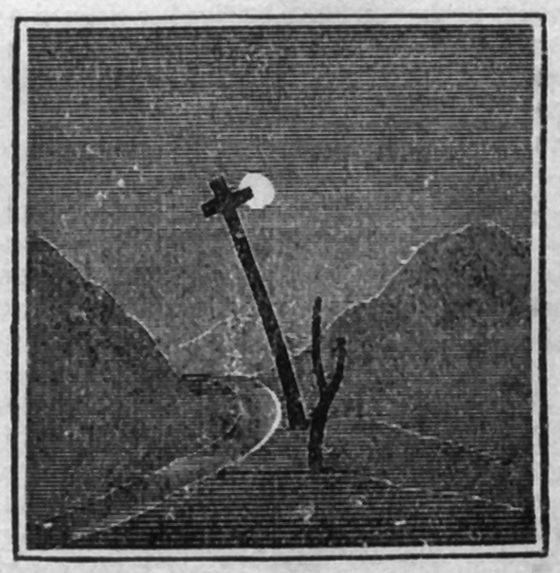
In order, however, to show the effect of the instrument to his friends, he constructed a rude picture of a landscape, as seen by each eye separately; and when these two pictures were placed in his instrument, the parts of the landscape appeared at different distances from the eye, or in their true relief. As this was undoubtedly the first landscape constructed for, and seen in relief through the Stereoscope, it possesses much interest; and we have given an accurate copy of the dissimilar pictures in the annexed diagram, as they were placed by Mr. Elliot, at the farther end of a box 18 inches long, 7 broad, and 4½ deep. In their present position they will appear in relief when united by the Stereoscope, or by converging the optic axes to a point at a proper distance beyond them. Had photography been in existence, to enable Mr. Elliot to obtain binocular pictures of landscapes and other objects, the application of the Stereoscope to natural scenery and to portraiture would not have been so long delayed.
In the month of August, 1838, Mr. Wheatstone exhibited an instrument, under the name of the Reflecting Stereoscope, to the British Association which met at Newcastle; and an account of it was published in the Philosophical Transactions for that year. The merit of this invention belongs exclusively to Mr. Wheatstone, and nobody has either directly or indirectly laid claim to it. Although it answers the purpose for which it was contrived, it is a clumsy and bulky apparatus, unnecessarily expensive, and now seldom seen. The binocular representations which it raised into relief were chiefly those of geometrical solids; but the idea of applying it to landscapes or portraits is never once mentioned in his paper. The theory of the instrument, as given by Mr. Wheatstone, was shown to be incorrect by the writer of this article, who first gave the true theory in the Edinburgh Transactions for 1843; and in the experiments which he made on the subject, he was led to the construction of several new stereoscopes, but particularly to the Lenticular Stereoscope now in universal use.
“The Reflecting Stereoscope of Mr. Wheatstone was at this time,” as the Abbé Moigno remarks, “almost completely forgotten.” Its merits had never been sufficiently understood; and even the Lenticular Stereoscope, after photography had supplied it with binocular portraits, excited a very limited interest. I offered it gratuitously to opticians in London and Birmingham; but it was not till the year 1850, when I took one to Paris, and showed it to the Abbé Moigno and M. Duboscq, that it was appreciated and brought into notice. Having executed a number of binocular pictures of statues and bas-reliefs, and portraits of celebrated individuals, M. Duboscq, to use the words of Abbé Moigno, “showed the wonderful effects of the instrument to natural philosophers and amateurs, who flocked to him in crowds, and from whom they elicited a spontaneous and unanimous cry of admiration.”
In the noble collection of philosophical instruments displayed by M. Duboscq in the Great Exhibition of 1851, he placed a Lenticular Stereoscope, with a set of binocular pictures in daguerreotype. The instrument attracted the particular attention of the Queen, and in a short time M. Duboscq received many orders for stereoscopes from England.
Such is a brief history of the Lenticular Stereoscope, and of its introduction into Paris and London. It is now in general use over the whole world, and it has been estimated that more than half a million of the Lenticular Stereoscopes have been sold. Photographers are employed in every part of the globe in taking binocular pictures for the instrument,—among the ruins of Pompeii and Herculaneum—on the glaciers and in the valleys of Switzerland—among the public monuments in the Old and New World—in the museums of ancient and modern life—and in the sacred precincts of the domestic circle.
POLICE. The objects of a police force are, first, the prevention of crime; second, its detection; third, the apprehension and punishment of offenders; and it is especially their duty to impress the minds of evil disposed persons with the conviction that their apprehension and punishment will be the sure consequence of the transgression of the law.
Prevention of Crime. When a breach of the peace is likely to take place, as when persons are making preparations to fight, even within a house, a constable may enter the house to prevent them, and take the parties into custody, and should the doors be closed, he may break them open upon refusal of admission. If a person threaten another with immediate personal violence, a constable may interfere; or if one draw a weapon upon another, attempting to strike, a constable may take him into custody; or if a person enter the house of another, although peaceably and lawfully, a constable may, at the request of the owner, having first requested him to go out, turn him out; but if persons be merely quarrelling or insulting each other, a constable has no right to take them into custody, but should be ready to prevent a breach of the peace. A constable may apprehend, and lodge in the station-house till taken before a magistrate, a person begging, or encouraging a child so to do; or lodging in any deserted or unoccupied building, or in the open air, not having any visible means of subsistence, and not giving a good account of himself or herself; a person wandering abroad, and endeavouring, by the exposure of wounds, or deformities, to obtain alms; or going about to procure charitable contributions of any kind, under any false or fraudulent pretence. A person playing, or betting in any street, highway, or other public place, at or with any table or instrument of gaming, at any game or pretended game of chance—a person having in his possession a picklock, crow, jack, bit, or other implement with intent feloniously to break into a building; or if armed with a gun or offensive weapon with intent to commit a felonious act—a person after sun-set, and before sun-rising carrying a bundle of goods suspected to be stolen.
A person drawing a truck, or carriage, rolling a cask, or wheel, or carrying a ladder or a placard upon the footway, affixing posting bills, blowing a horn, or using a noisy instrument, ringing a door bell, wilfully extinguishing the light of any lamp, flying a kite, sliding, or playing at any game on the footway, or committing any other offence whereby the public thoroughfare is obstructed, or an offence is committed to the annoyance of the passengers or neighbourhood, in view of a constable, may be taken into custody.
Persons charged with aggravated assaults may be apprehended without a warrant, although not in the view of a constable, if, by reason of the recent commission of the offence, a magistrate’s warrant for his apprehension could not have been obtained. Constables may apprehend offenders whose names and residences are unknown to them, as any street musician who shall have been required to depart from the neighbourhood of a house on account of the illness of any inmate, or for other reasonable cause.
It is the duty of the police to warn persons, and in case their warning is not immediately attended to, to summon persons committing, amongst others, the following offences:—Burning corks, hooping barrels, hewing stones, laying coals or other materials, or beating carpets in the streets or public thoroughfares, or throwing dirt or rubbish into the streets or river Thames, neglecting to sweep the footways opposite to or adjoining their houses, obstructing footways by projections, or leaving cellars and areas dangerously open. Persons so offending are liable to a penalty of forty shillings; and if, by the commission of any of the offences above enumerated, any person shall suffer any hurt or damage, a magistrate may order reasonable compensation to be made to the amount of ten pounds.
In cases of fire the police are to keep the ground and the streets in the immediate vicinity clear of obstructions, and to render every assistance possible in the removal of property, conformably with the wishes and suggestions of the proprietors; and if desired, articles of value may be conveyed to the nearest station-house.
Duties of the Police. They are to be civil and respectful to the public, particularly females needing their assistance; but are forbidden to enter into conversation with any person whomsoever, except on matters relating to their duty. They are not to refuse assistance for the protection of person and property near their own beats; and under no pretence whatever may any member of the police force take a gratuity from any person, or receive any penalty for lodging or supporting any information, without the express permission of the Commissioner.
In cases of robbery, they are not to relax their endeavours until the offender is brought to justice.
In the execution of their duty they are to be very particular not to use unnecessary violence, and must not use their staves because the party in custody is violent in behaviour or language; or use any language towards persons in their custody calculated to provoke or offend them. And it is the duty of the inspector to pay instant and particular attention to all complaints made against any individual of the police force, to enter the complaint in a book, and to request the complainant to sign the entry.
The inspector or station-sergeant must discharge, upon his recognizances, with or without sureties, when no magistrate is sitting, any person charged with an offence for which he is liable to be summarily convicted, or with having carelessly done any hurt or damage; or even a person charged with a felony or grave misdemeanor, in custody without a warrant, upon the refusal of the person making the charge to enter into a recognizance.
No person is to be permitted to smoke or drink in a station-house, or to remain there except while actually engaged in business.
All money or other property brought to the station-house is to be marked by the inspector or station-sergeant, and entered in a book, and, if taken from a prisoner, is not to be returned till the decision of the magistrate is known; but this is not to prevent any small sum being spent in refreshment.
BILLIARDS. This elegant sport may be said to combine the principles of bowls, golf, and some other games in which objects are impelled from the hand. Whether the game was invented in France or England is not clearly ascertained; but, as it is mentioned by Shakspeare, it is at least as old in this country as the sixteenth century.
Billiards is played with a table, certain kinds of rods, and balls. The table varies in size; that in most common use being twelve feet long, and six feet one inch and a half in width. Whatever be its dimensions, it requires to be perfectly level and smooth. It is ordinarily made of pieces of slate joined together; and these being brought to a dead level, the surface is covered with fine green cloth. All round is a ledge or cushion two inches high, and stuffed with India rubber. The table is furnished with six pockets, one at each of the four corners, and one on each side at the middle. The mouths of these pockets or purses are level with the surface, so as to allow the balls to glide easily into them.
The balls are of ivory, varying from an inch and a half to two inches in diameter. Two are white, and one is red. One of the white is distinguished by a spot. There are usually two players in the ordinary winning and losing game; he who owns the plain ball is called Plain, and he who owns the spotted ball is termed Spot. The red ball belongs to neither, but is aimed at by both.
The rods or bills used by the players are of two kinds, and different lengths, to suit different players. The ordinary kind of rod is called a cue. It is long and smooth, with one end thick and heavy (1), and the other tapered to a point; this is covered with a button of leather. The other kind of rod is termed a mace; it has a club-like extremity (2), and is much less frequently used. Almost all players employ cues of a length and weight to suit themselves.

In playing, the left hand is rested with the palm undermost on the table. The palm is hollowed, and the thumb, close to the forefinger, is raised up to form a bridge or rest for the cue. The hand should be at the distance of about six inches from the ball. The cue is lightly held in the right hand, the blow being struck with the small extremity. Thus held, in a free but firm manner, and resting on the channel between the forefinger and thumb, the cue is given a sharp run forward, so as to hit the ball in the required direction, and with that exact degree of force which will make it perform the desired feat. To prevent slipping, the point of the cue is generally chalked.
The table is laid out as follows for playing the winning and losing game. At the distance of about a foot from one end, in the centre of the table, is a small dot or mark in the cloth, on which the red ball is placed. At twenty-eight inches from the other, which we shall call the upper end of the table, a line is made across by a chalked string; then taking the centre of this line, a semicircle of twenty inches’ diameter is drawn from it, between the chalk-line and the upper end of the table. The space enclosed by this semicircle is called baulk.
In setting out in a game, the first stroke or lead is determined by lot. This is called stringing for the lead. Each player hits his ball from the string or line, and he who causes it to rebound from the bottom cushion and come back nearest to the upper cushion, has the lead and the choice of the balls.
The first player begins by striking his ball from baulk against the red ball, as already mentioned; and if he pockets the red ball, he scores three; if both, he scores six, and begins again. So long as he pockets or scores, the adversary does not get a stroke. If the player miss, the adversary takes his turn. Both now play alternately, hitting the balls where they chance to lie; but when one pockets his own ball, he starts afresh by striking from baulk. If the player strikes both the red and his adversary’s ball, it is termed a cannon, and scores two. The beginner will, however, derive more benefit by studying the rules, than from any description we can offer.
A person in attendance, called the marker, scores or keeps reckoning of the play. He does this by means of a marking-board, which has indicators and two rows of figures, one for Plain, and the other for Spot. Technically, when a point is gained, he scores one for Plain, or one for Spot.
Winning and Losing Game.
1. The game is twenty-one in number, though sometimes played twenty-four, fifty, sixty-three, one hundred, or more; but twenty-one is the regular game.
2. At the commencement, both persons string for the lead and choice of balls, except when any points are given; then the person receiving the odds plays off at the beginning of the match, and the winner of each game leads afterwards.
3. In stringing, the person who brings his ball nearest the cushion, in baulk, has the option of playing first or not, and choice of balls, except when his ball touches the other or goes into a pocket; in either of which cases the adversary has the option.
4. At the beginning of the game, the red ball is to be placed on the spot at the further end of the table, and replaced there on being put into a pocket, knocked off the table, or when the balls are broken after a foul stroke; but should any ball be on, or so near the spot, as to prevent the red being placed there without touching the other, in that case the red must be placed in the centre of the table.
5. The points of the game are scored as follows:—One point for a miss, two for a cannon, two for a white hazard, three for a red hazard, three for running a coo or knocking your own ball off the table without touching either of the others.
6. A white winning hazard is made when you play at the white ball and pocket it; a white losing hazard, when you pocket your own ball off the white.
7. A red winning hazard is when you pocket the red; a red losing hazard, when you pocket your own ball off the red.
8. A cannon is when your ball strikes the other two.
9. A coo is when your ball goes into a pocket, or jumps off the table without touching either of the others.
10. A four-stroke is made by playing at the white, making a cannon, and pocketing your own or adversary’s ball; or you pocket his and your own without the cannon; or by playing at the red, making a cannon, and pocketing your opponent’s ball.
11. A five-stroke is made by playing at the red, making a cannon, and pocketing your own or the red; or pocketing the red and your adversary’s ball without the cannon; or you pocket your own and adversary’s ball off the red; or you play at the white, make a cannon, and pocket the red; or you play at the white, and pocket your own and the red.
12. A six-stroke is made by playing at the red and pocketing it and your own; or striking the white first, making a cannon, and pocketing your own and adversary’s ball.
13. A seven-stroke is made by playing at the red, making a cannon, and pocketing your own and adversary’s ball; or by playing at the white first, making a cannon, and pocketing your own or adversary’s and the red; or by striking the white, and pocketing all the balls without a cannon.
14. An eight-stroke is made by playing at the red ball, making a cannon, and pocketing your own and the red; or if you strike the red and pocket all the balls without the cannon.
15. A nine-stroke is made when you cannon by striking the white first and pocketing all the balls.
16. A ten-stroke is made when you cannon by playing at the red first, and pocket all the balls. This is the greatest number that can be made.
17. If the striker, in making a cannon or hazard, should by accident touch either of the balls with his cue, hand, or otherwise, the adversary can, if he thinks proper, claim it as foul, and have the balls broken; in which case, the points made by such stroke are not scored, and the person claiming the foul stroke leads off.
18. Foul strokes are made as follows—namely, when the striker’s ball touches either of the others; touching any ball while rolling; moving another ball in any way while taking aim or in the act of striking; pushing the balls together when playing with the butt of the cue; playing with both feet off the floor: playing at a ball before it has done rolling; or by playing with the wrong ball; in this latter case, should a hazard or cannon be made, the adversary can have the balls broken and lead off; and should no score be made by such stroke, he can take his choice of balls and play.
19. In breaking the balls, you take them all off the table, place the red on the spot, and both parties play from the baulk.
20. If the balls have been changed, and it cannot be ascertained by whom, the game must be played out with them as they then are; or even if two strokes have been made before the mistake is discovered, it must still be played out in the same way.
21. Should the striker, in making a cannon or hazard, knock his own or either of the balls off the table, he cannot score the points made by such stroke, and the opponent plays, but the balls are not broken.
22. If a ball stops on the edge of a pocket, and afterwards falls in, either by shaking the room, table, or other accident, it must be replaced as near the original place as possible.
23. Should the striker, when in hand, play at a ball in baulk, his adversary has the option of scoring a miss, or having the balls replaced, and the stroke played again, or of breaking the balls.
24. If the striker’s ball touch another, he must play, and should he make a cannon or hazard, the adversary can claim it as foul, or he can allow points to be scored and the person to play on; but should the striker not score, it is at the option of the opponent to break them or not.
25. Should the marker, whilst marking for the players, by accident, touch either of the balls, while rolling or not, it must be placed as near as possible to the place it would have occupied.
26. If the last player should alter the direction of the balls while rolling, with cue, hand, or otherwise, the striker may place it where he thinks proper.
27. A line-ball is when either the white or red is exactly on the line of the baulk, in which case it cannot be played at by a person whose ball is in hand, it being considered in baulk.
28. If the striker’s ball is over the pocket, and he should, in the act of striking, miss it; but, in drawing his cue back, knock it into the pocket, he will lose three points, it being a coo.
29. If the red ball has been put into a pocket, it must not be placed on the spot till the other balls have done rolling; should there be a probability of either of them touching it again, as the stroke is not finished till the balls stop.
30. If the striker should touch his ball by accident when taking aim, it is not a stroke, and the ball is to be replaced; but should he touch it in the act of striking, then it is a stroke.
31. If either of the balls lodge on a cushion, it is off the table, and should a cannon or hazard be made, it does not score, and the ball must be placed on the spot, or played from the baulk, according to what ball it is, white or red.
32. Any person refusing to play the game out after he has played one stroke, loses it.
33. In a match of four, the game is thirty-one, and each person is at liberty to offer his partner advice.
34. All disputes in the game to be decided by the marker or majority of the company, but no person has a right to interfere until appealed to by one or both players.
35. It is a love-game when no hazard has been made by the loser.
36. All cramp-games are played sixteen up.
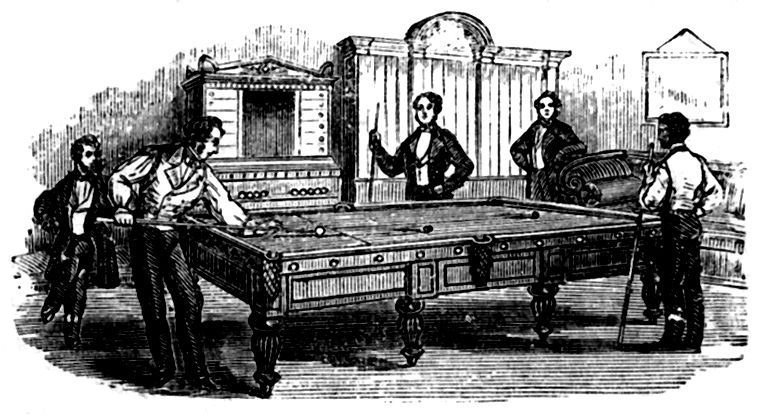
∵ We cannot bid farewell to our task, without being permitted to record the delight experienced, and the knowledge gained, in our researches for its due performance. The stores of useful information gathered together in this Volume, could never have been collected, had we not been privileged with access to the vast literary treasures in the British Museum. It was there that we were enabled to consult the highest authorities upon all the subjects contained in this work, and to condense a truth or “Fact” into a page of ours, that sometimes filled a volume. And this has been the chief labour of our undertaking; but we enjoy the satisfaction of knowing that we have carefully and conscientiously executed it. And, further, that the space of our book has been exclusively occupied by “Facts” of importance to “Everybody.”
Changes have been made silently to achieve consistency in spelling and punctuation.
While there appears to be some duplication of entries, these have been retained as in the original.
All of the cross-references in the original have been checked, and corrected as necessary.
[End of Facts for Everybody, by Robert Kemp Philp]